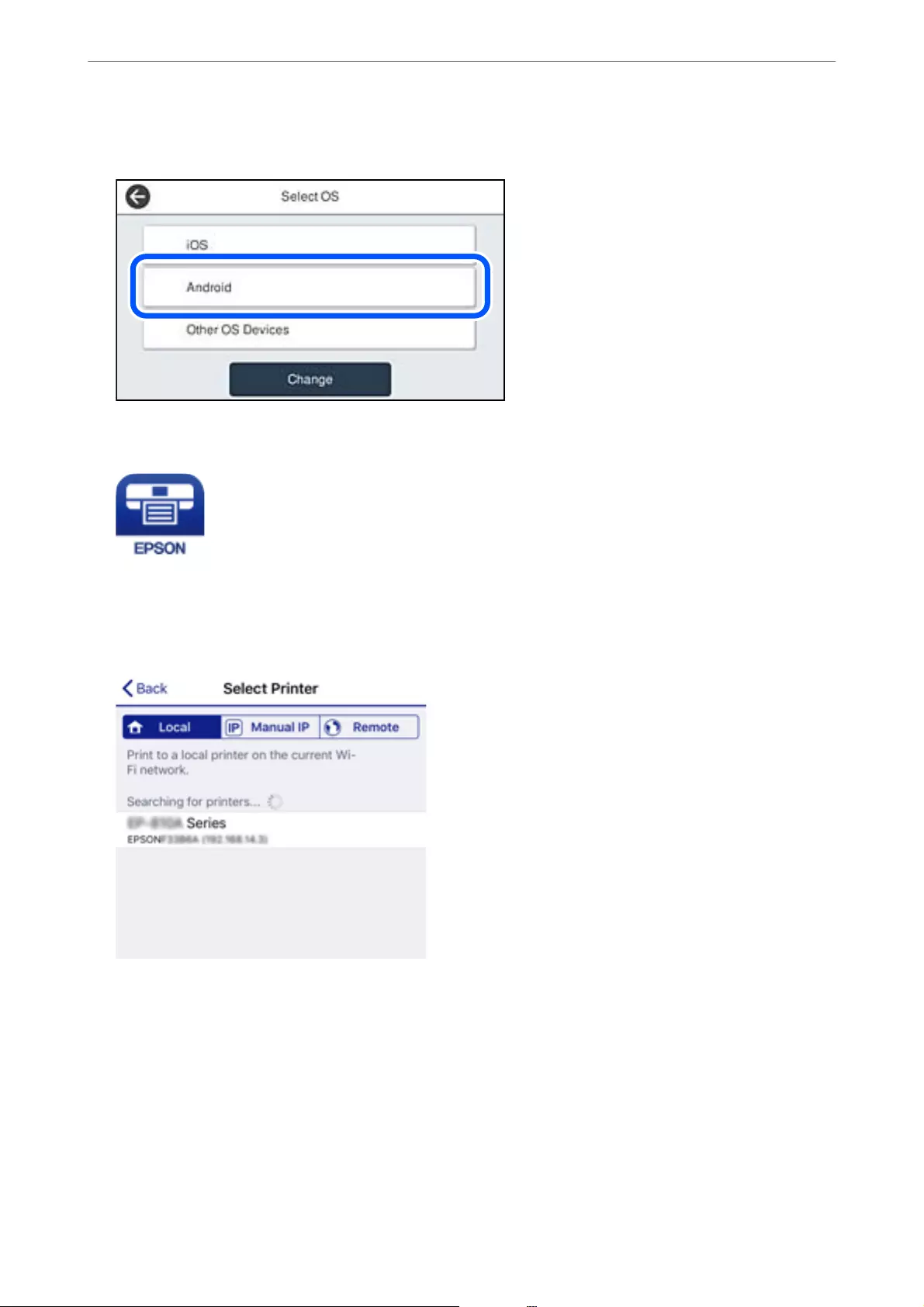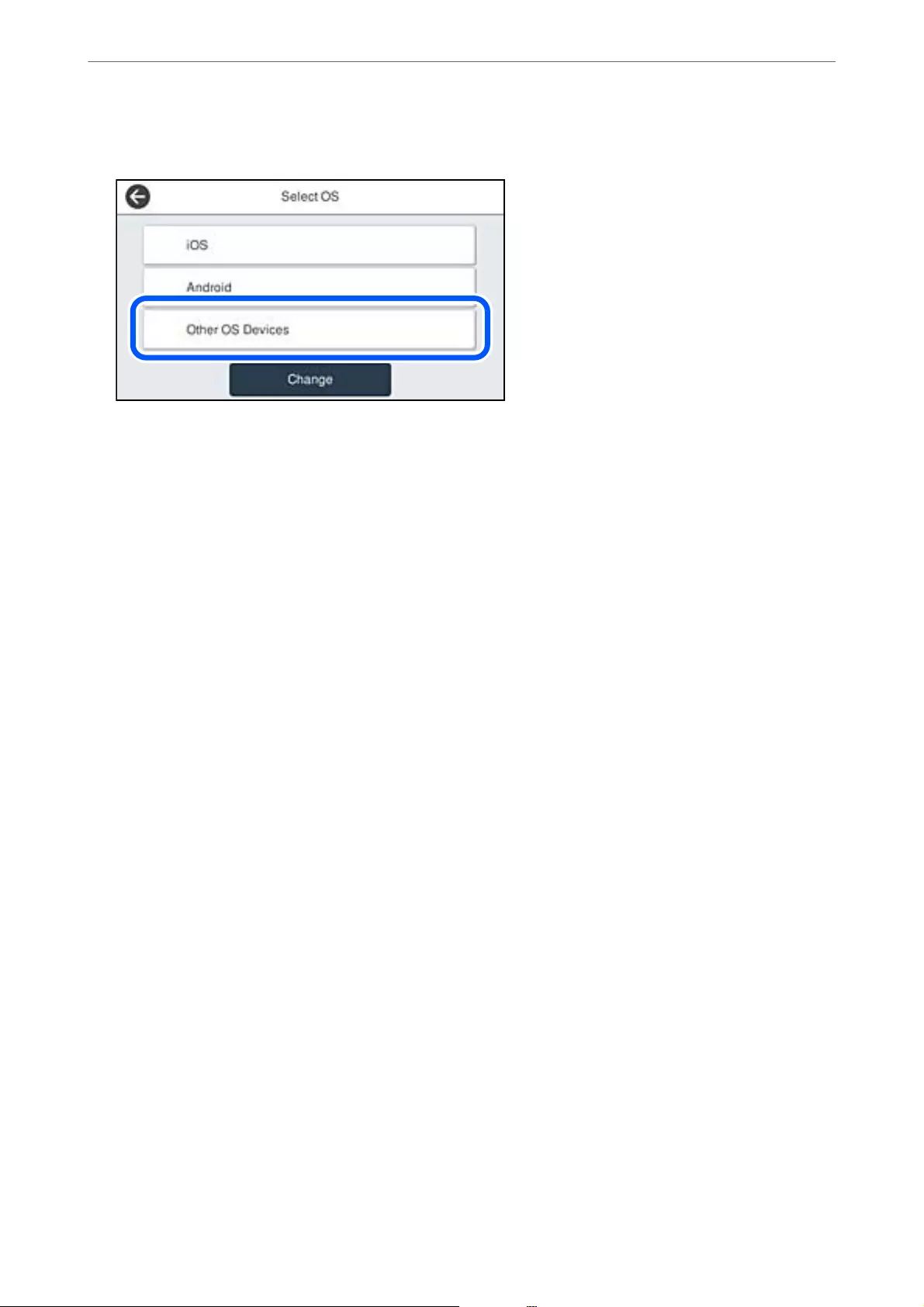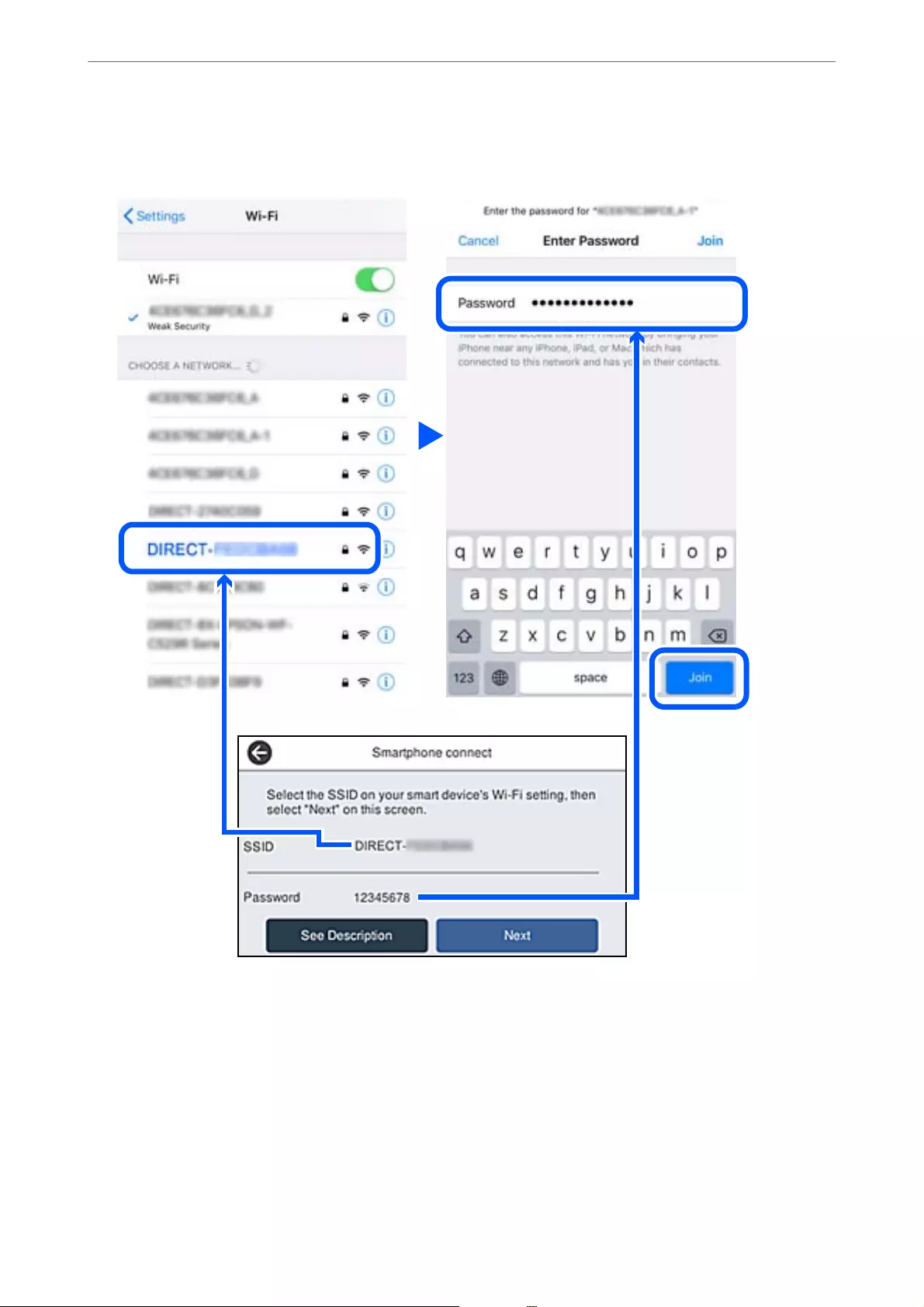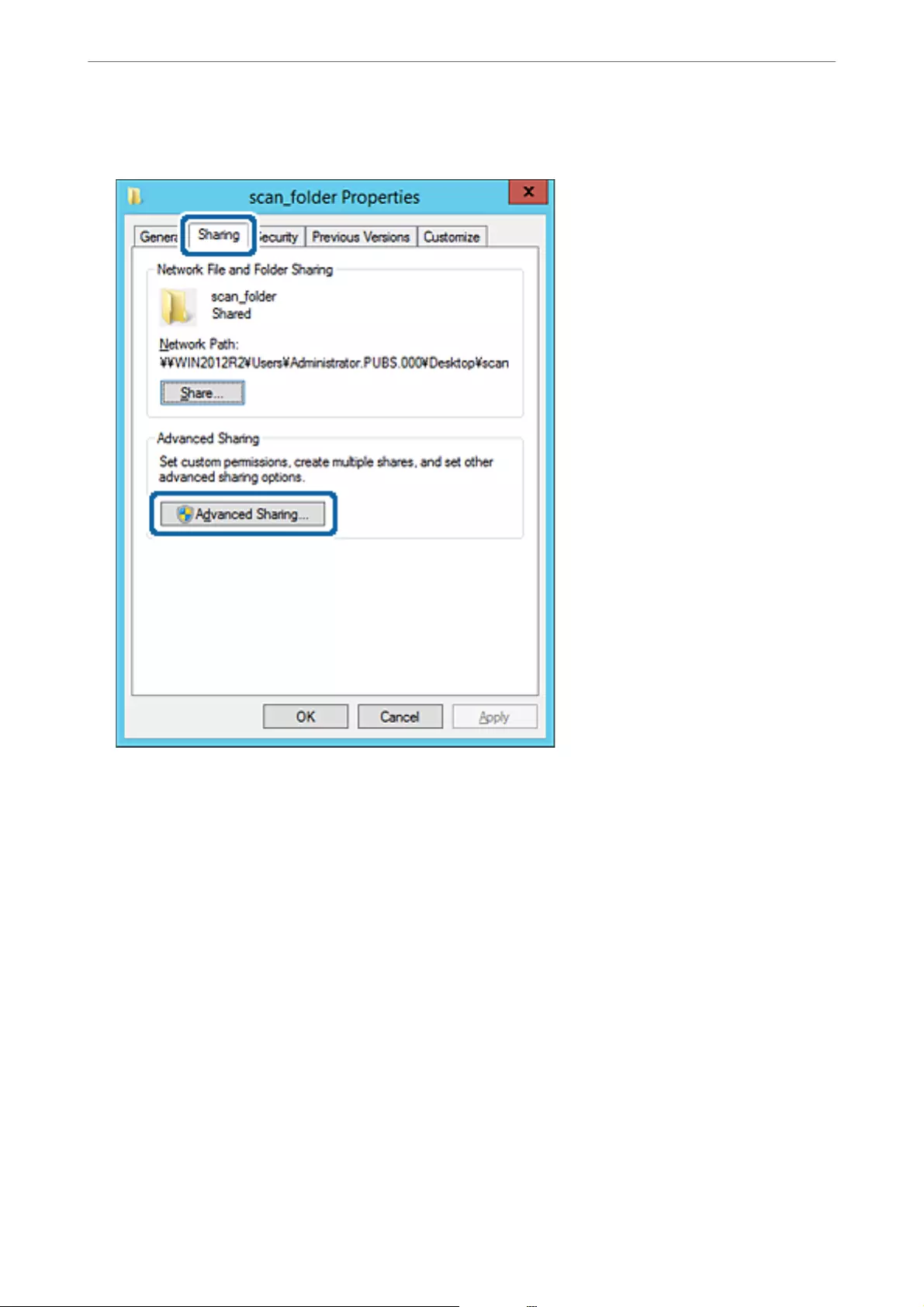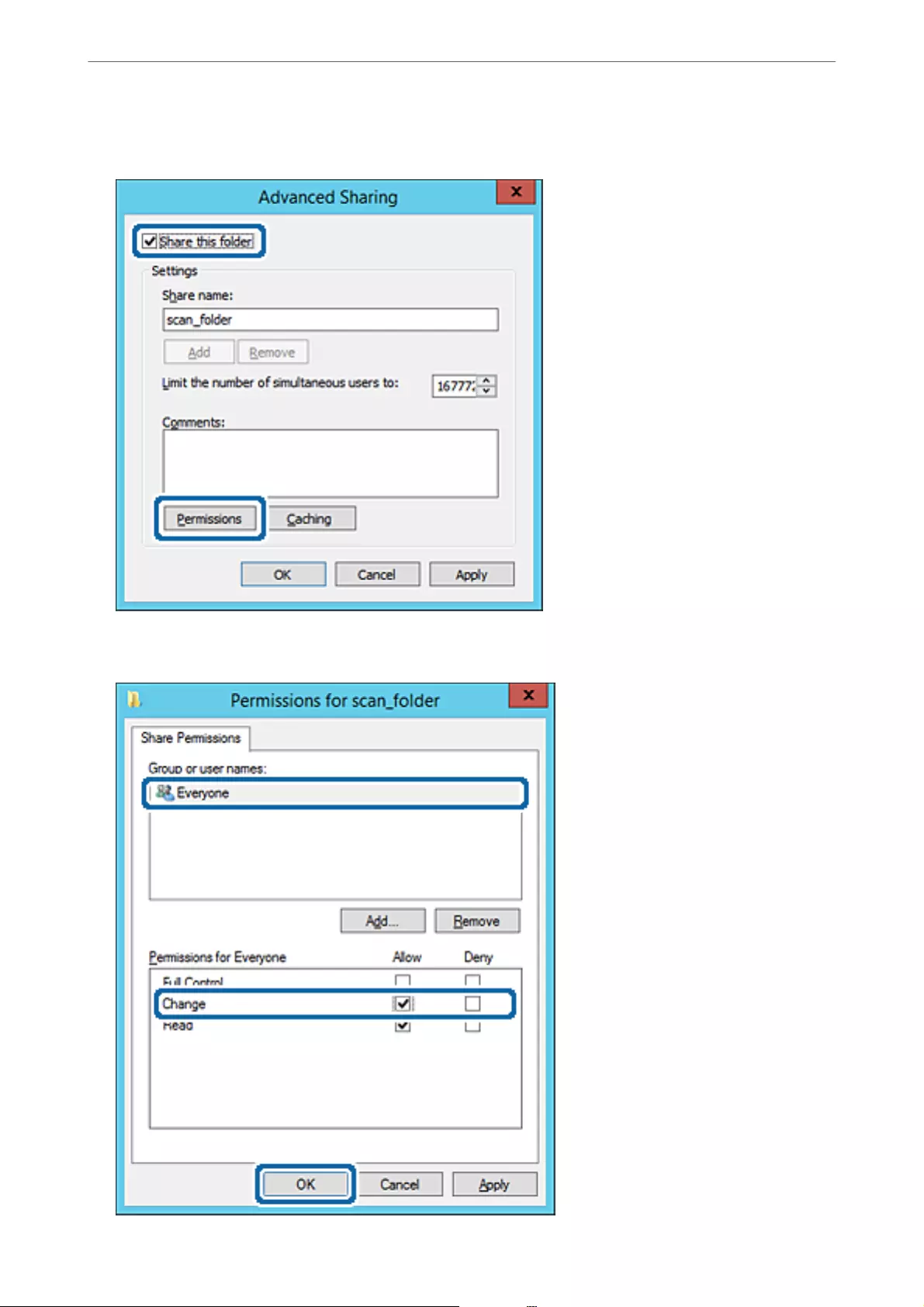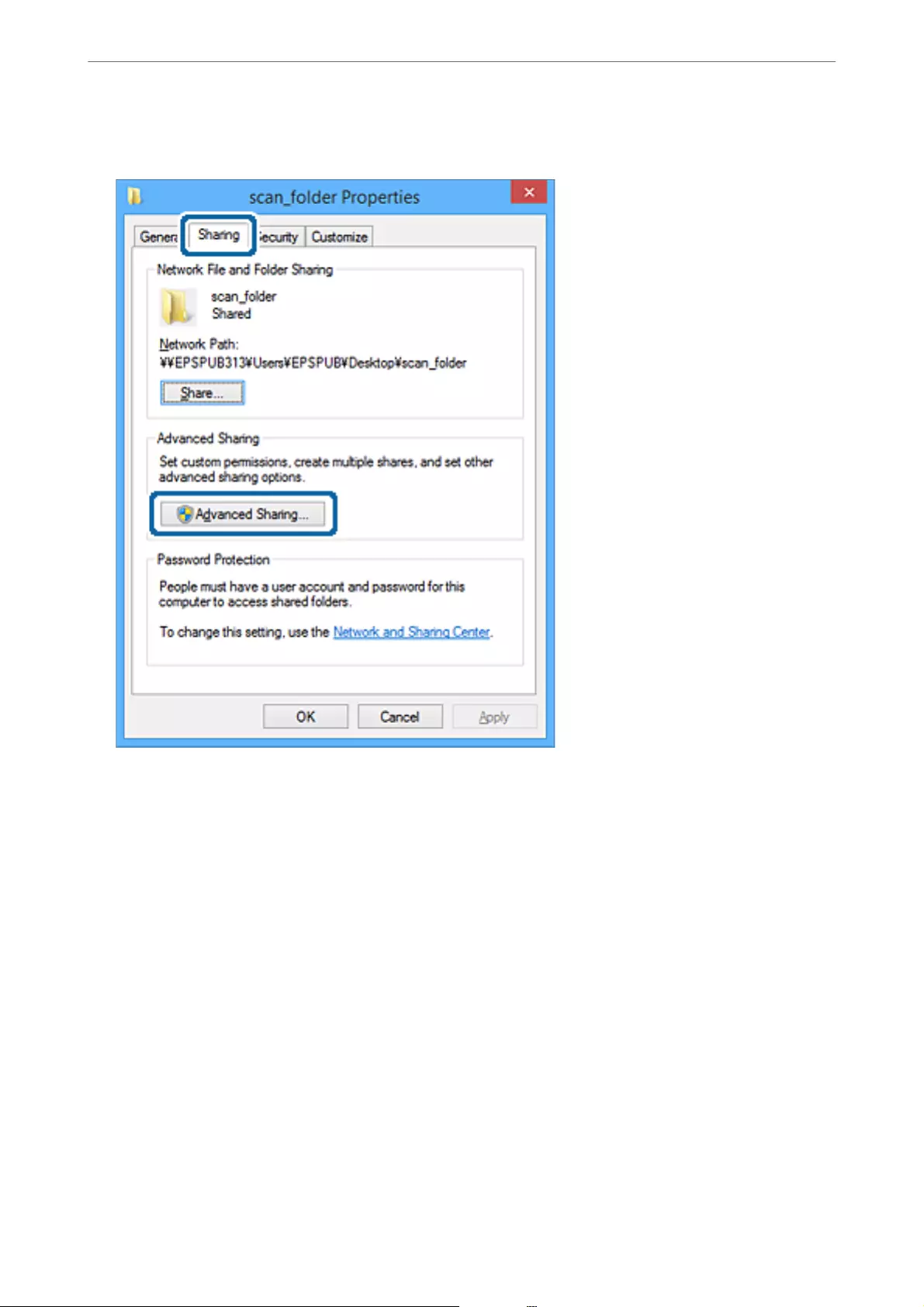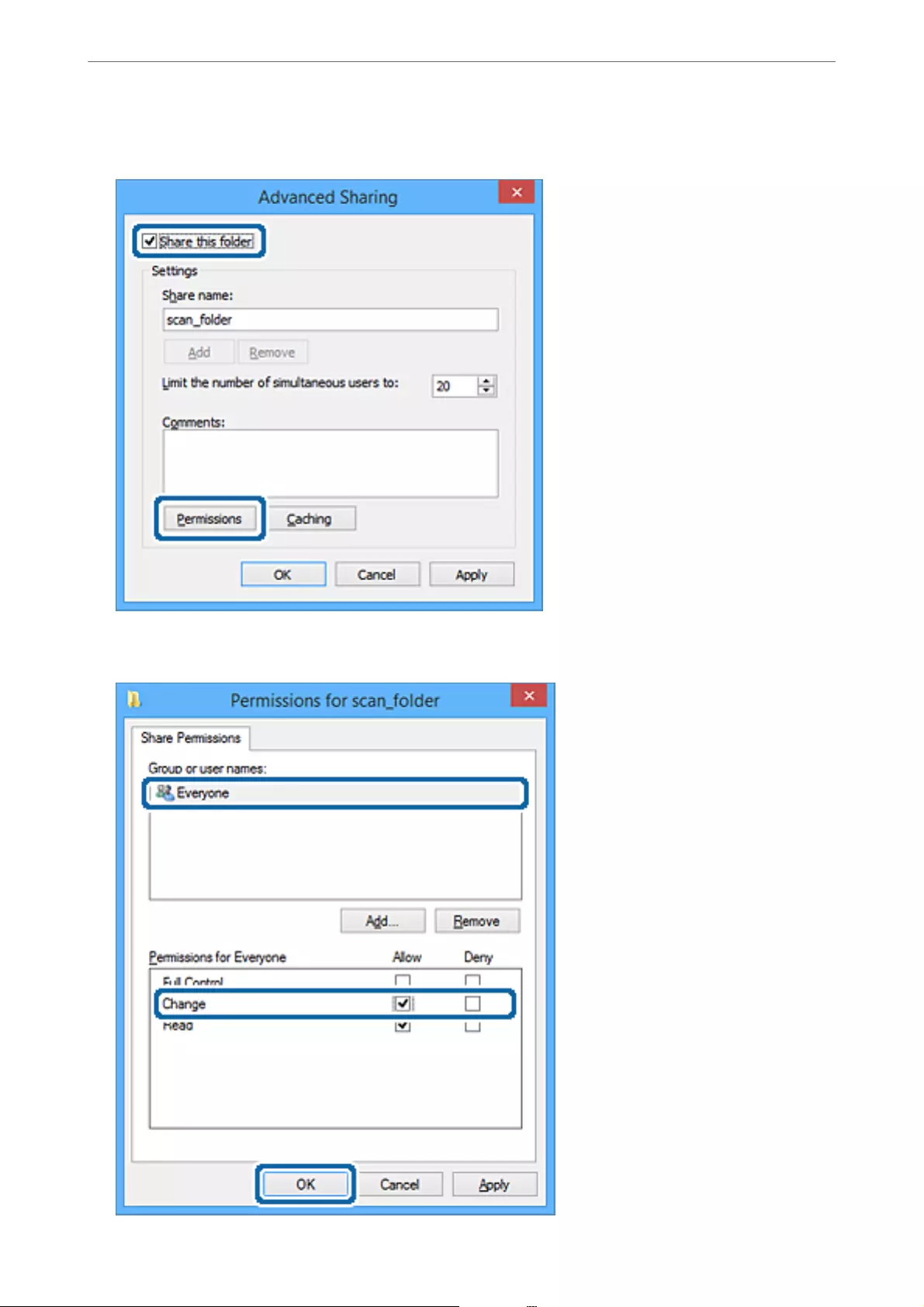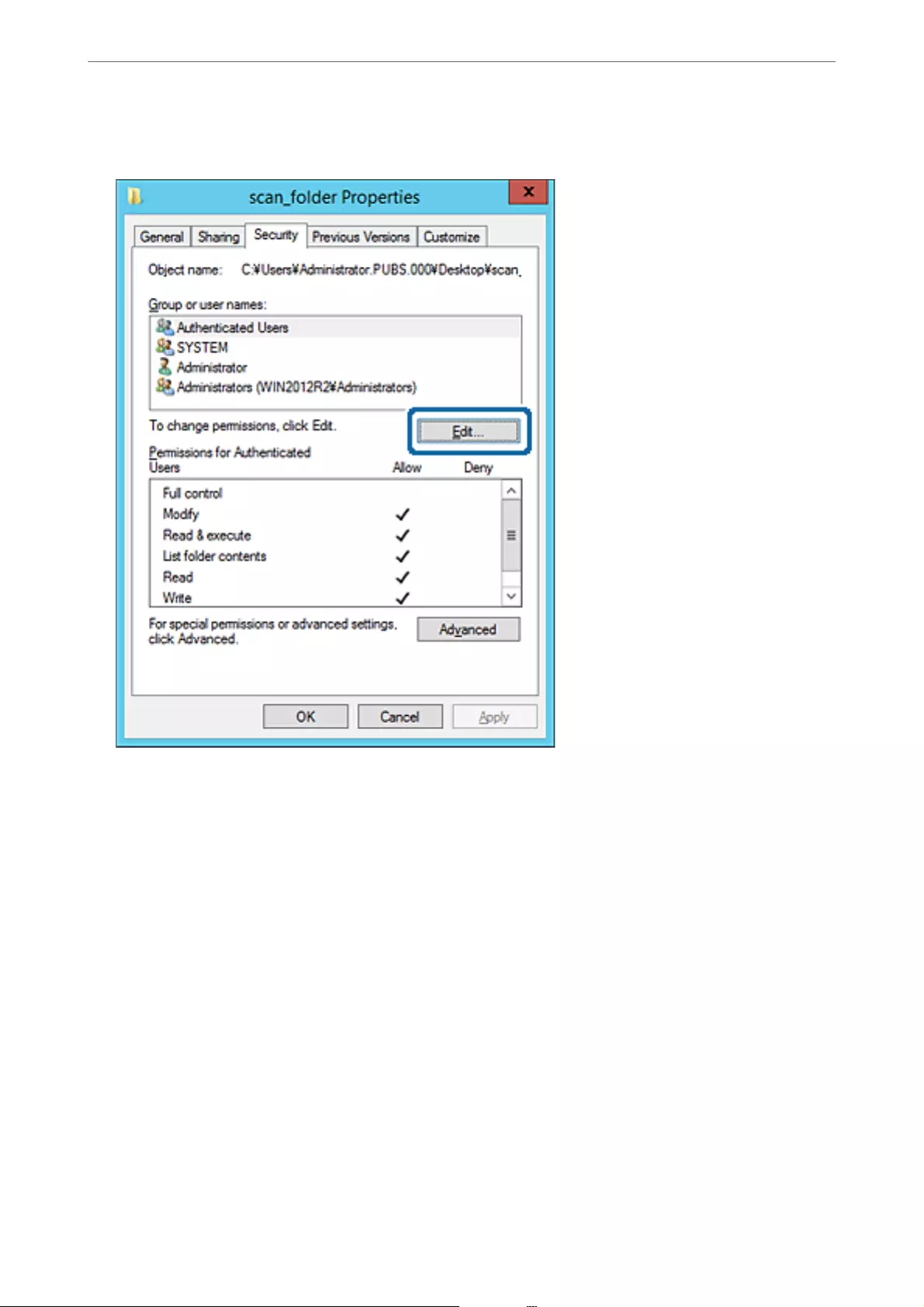Table of Contents
- Contents
- Guide to This Manual
- Important Instructions
- Part Names and Functions
- Guide to the Control Panel
- Loading Paper
- Placing Originals
- Inserting and Removing a Memory Device
- Printing
- Copying
- Scanning
- Faxing
- Maintaining the Printer
- Solving Problems
- Adding or Replacing the Computer or Devices
- Connecting to a Printer that has been Connected to the Network
- Re-setting the Network Connection
- Connecting a Smart Device and Printer Directly (Wi-Fi Direct)
- About Wi-Fi Direct
- Connecting to an iPhone, iPad or iPod touch using Wi-Fi Direct
- Connecting to Android Devices using Wi-Fi Direct
- Connecting to Devices other than iOS and Android using Wi-Fi Direct
- Disconnecting Wi-Fi Direct (Simple AP) Connection
- Changing the Wi-Fi Direct (Simple AP) Settings Such as the SSID
- Checking the Network Connection Status
- Product Information
- Paper Information
- Consumable Products Information
- Software Information
- Settings Menu List
- Product Specifications
- Printer Specifications
- Scanner Specifications
- ADF Specifications
- Fax Specifications
- Using Port for the Printer
- Interface Specifications
- Network Specifications
- Supported Third Party Services
- Memory Device Specifications
- Supported Data Specifications
- Dimensions
- Electrical Specifications
- Environmental Specifications
- Installation Location and Space
- System Requirements
- Regulatory Information
- Administrator Information
- Where to Get Help
Epson L6550 User Manual
Displayed below is the user manual for L6550 by Epson which is a product in the Multifunctionals category. This manual has pages.
Related Manuals

Contents
Guide to This Manual
Introduction to the Manuals...................7
Searching for Information....................7
Printing Only the Pages You Need.............. 8
About is Manual......................... 8
Marks and Symbols.......................8
Notes on Screenshots and Illustrations.........9
Operating System References................9
Trademarks..............................10
Copyright...............................10
Important Instructions
Safety Instructions.........................13
Safety Instructions for Ink................. 14
Printer Advisories and Warnings.............. 14
Advisories and Warnings for Setting Up the
Printer................................14
Advisories and Warnings for Using the Printer. . 15
Advisories and Warnings for Using the
Touchscreen........................... 15
Advisories and Warnings for Using the
Printer with a Wireless Connection...........15
Advisories and Warnings for Transporting or
Storing the Printer.......................16
Protecting Your Personal Information...........16
Part Names and Functions
Front...................................18
Inside..................................20
Rear................................... 21
Guide to the Control Panel
Control Panel............................ 23
Home Screen Conguration..................23
Guide to the Network Icon.................25
Menu Screen Conguration..................25
Job/Status Screen Conguration...............26
Entering Characters........................27
Viewing Animations....................... 27
Loading Paper
Paper Handling Precautions..................30
Paper Size and Type Settings..................30
List of Paper Type....................... 31
Loading Paper............................31
Loading Pre-punched Paper................32
Loading Long Papers.....................33
Placing Originals
Placing Originals..........................35
Originals that are not Supported by the ADF. . . . . . 36
Inserting and Removing a Memory
Device
Inserting an External USB Device..............38
Removing an External USB Device.............38
Sharing Data on a Memory Device.............39
Printing
Printing Documents........................41
Printing from a Computer - Windows.........41
Printing from a Computer - Mac OS..........64
Printing Documents from Smart Devices (iOS). . 72
Printing Documents from Smart Devices
(Android).............................74
Printing on Envelopes...................... 75
Printing on Envelopes from a Computer
(Windows)............................ 75
Printing on Envelopes from a Computer
(Mac OS)..............................75
Printing Photos...........................76
Printing JPEG Files from a Memory Device. . . . .76
Printing TIFF Files from a Memory Device. . . . . 77
Printing Web Pages........................ 78
Printing Web Pages from a Computer.........78
Printing Web Pages from Smart Devices.......78
Printing Using a Cloud Service................79
Registering to Epson Connect Service from
the Control Panel........................79
Copying
Available Copying Methods..................82
Copying Originals.......................82
Copying on 2-Sides...................... 82
Copying by Enlarging or Reducing...........83
Copying Multiple Originals onto One Sheet. . . . .84
Copying in Page Order....................85
2

Copying Originals Using Good Quality. . . . . . . . 85
Copying ID card........................86
Basic Menu Options for Copying.............. 86
Color Mode:........................... 86
Density:...............................86
Paper Setting:.......................... 87
Reduce/Enlarge:.........................87
Original Type:..........................87
2-Sided:...............................87
Advanced Menu Options for Copying...........88
Multi-Page:............................88
Original Size:...........................88
Finishing:............................. 88
Orientation (Original):....................88
Image Quality:..........................89
Binding Margin:.........................89
Reduce to Fit Paper:......................89
Remove Shadow:........................89
Remove Punch Holes:.................... 89
ID Card Copy:..........................89
Scanning
Available Scanning Methods..................91
Scanning Originals to a Network Folder.........91
Destination Menu Options for Scanning to a
Folder................................92
Scan Menu Options for Scanning to a Folder. . . . 93
Scanning Originals to an Email. . . . . . . . . . . . . . . .94
Recipient Menu Options for Scanning to an
Email................................ 95
Scan Menu Options for Scanning to an Email. . . 95
Scanning Originals to a Computer............. 97
Scanning Originals to a Memory Device.........98
Basic Menu Options for Scanning to a
Memory Device.........................98
Advanced Menu Options for Scanning to a
Memory Device.........................99
Scanning Originals to the Cloud..............100
Basic Menu Options for Scanning to the Cloud. 100
Advanced Menu Options for Scanning to the
Cloud............................... 101
Scanning Using WSD......................102
Setting Up a WSD Port...................102
Scanning Originals to a Smart Device..........104
Faxing
Before Using Fax Features...................106
Overview of this Printer's Fax Features.........106
Feature: Sending Faxes...................106
Feature: Receiving Faxes..................107
Feature: PC-FAX Send/Receive
(Windows/Mac OS).....................109
Features: Various Fax Reports..............109
Feature: Status or Logs for Fax Jobs..........109
Feature: Fax Box........................110
Feature: Security when Sending and
Receiving Faxes........................110
Features: Other Useful Features.............110
Sending Faxes Using the Printer..............111
Selecting Recipients.....................111
Various Ways of Sending Faxes.............112
Receiving Faxes on the Printer............... 119
Receiving Incoming Faxes.................119
Receiving Faxes by Making a Phone Call......120
Saving and Forwarding Received Faxes. . . . . . . 122
Viewing Received Faxes Saved in the Printer
on the LCD Screen......................123
Menu Options for Faxing...................124
Recipient.............................124
Fax Settings...........................125
More................................127
Menu Options for Fax Box..................128
Inbox/Condential......................128
Stored Documents:......................130
Polling Send/Board..................... 131
Checking the Status or Logs for Fax Jobs........135
Displaying Information when Received Faxes
are Unprocessed (Unread/Not Printed/Not
Saved/Not Forwarded)...................135
Checking Fax Jobs in Progress..............136
Checking the Fax Job History..............136
Reprinting Received Documents............137
Sending a Fax from a Computer..............137
Sending Documents Created Using an
Application (Windows).................. 137
Sending Documents Created Using an
Application (Mac OS)....................140
Receiving Faxes on a Computer...............141
Saving Incoming Faxes on a Computer.......142
Canceling the Feature that Saves Incoming
Faxes to the Computer...................142
Checking for New Faxes (Windows).........142
Checking for New Faxes (Mac OS).......... 144
Maintaining the Printer
Checking the Status of Consumables...........146
Improving Print, Copy, Scan, and Fax Quality. . . . 146
3

Adjusting the Print Quality................146
Checking and Cleaning the Print Head.......147
Running Power Cleaning.................148
Preventing nozzle clogging................150
Aligning the Print Head (Control Panel)......150
Cleaning the Paper Path for Ink Smears.......151
Cleaning the Scanner Glass................151
Cleaning the ADF...................... 152
Cleaning the Printer.......................154
Cleaning Spilled ink.......................155
Checking the Total Number of Pages Fed
rough the Printer.......................155
Checking the Total Number of Pages Fed
rough the Printer (Control Panel).........156
Saving Power............................156
Saving Power (Control Panel)..............156
Installing or Uninstalling Applications Separately. 156
Installing the Applications Separately........ 157
Adding the Printer (for Mac OS Only)........159
Uninstalling Applications.................159
Updating Applications and Firmware. . . . . . . . 161
Transporting and Storing the Printer...........163
Solving Problems
e Printer Does Not Work as Expected........170
e Printer Does Not Turn On or O........170
Power Turns O Automatically.............170
Paper Does Not Feed Properly. . . . . . . . . . . . . 170
Cannot Print..........................175
Cannot Start Scanning...................191
Cannot Send or Receive Faxes..............203
Error Code is Displayed on the Status Menu. . . 219
Cannot Operate the Printer as Expected. . . . . . 223
A Message is Displayed on the LCD Screen. . . . . . 227
Paper Gets Jammed.......................229
Preventing Paper Jams...................229
It is Time to Rell the Ink...................230
Ink Bottle Handling Precautions............230
Relling the Ink Tanks...................231
It is Time to Replace the Maintenance Box. . . . . . .235
Maintenance Box Handling Precautions. . . . . . 235
Replacing a Maintenance Box..............235
Printing, Copying, Scanning, and Faxing
Quality is Poor...........................237
Print Quality is Poor.....................237
Copy Quality is Poor.................... 246
Scanned Image Problems.................253
e Quality of the Sent Fax is Poor..........256
Received Fax Quality is Poor...............258
Cannot Solve Problem Aer Trying All Solutions. .258
Cannot Solve Printing or Copying Problems. . . 258
Adding or Replacing the Computer or
Devices
Connecting to a Printer that has been
Connected to the Network..................261
Using a Network Printer from a Second
Computer............................261
Using a Network Printer from a Smart Device. . 262
Re-setting the Network Connection........... 262
When Replacing the Wireless Router.........262
When Changing the Computer.............263
Changing the Connection Method to the
Computer............................264
Making Wi-Fi Settings from the Control Panel. .266
Connecting a Smart Device and Printer Directly
(Wi-Fi Direct)...........................268
About Wi-Fi Direct..................... 268
Connecting to an iPhone, iPad or iPod touch
using Wi-Fi Direct......................269
Connecting to Android Devices using Wi-Fi
Direct...............................272
Connecting to Devices other than iOS and
Android using Wi-Fi Direct...............274
Disconnecting Wi-Fi Direct (Simple AP)
Connection...........................278
Changing the Wi-Fi Direct (Simple AP)
Settings Such as the SSID.................278
Checking the Network Connection Status.......279
Checking the Network Connection Status
from the Control Panel...................279
Printing a Network Connection Report. . . . . . . 280
Printing a Network Status Sheet............ 286
Checking the Network of the Computer
(Windows only)........................286
Product Information
Paper Information........................289
Available Paper and Capacities.............289
Unavailable Paper Types..................294
Consumable Products Information............294
Ink Bottle Codes....................... 294
Maintenance Box Code...................295
Soware Information......................295
Soware for Printing.................... 295
Soware for Scanning....................299
4

Soware for Faxing..................... 299
Soware for Package Creation..............300
Soware for Making Settings or Managing
Devices..............................301
Soware for Updating................... 303
Settings Menu List........................304
General Settings........................304
Print Counter..........................324
Supply Status..........................324
Maintenance..........................325
Language.............................326
Printer Status/Print..................... 326
Contacts Manager......................327
User Settings..........................327
Product Specications..................... 327
Printer Specications....................327
Scanner Specications................... 329
ADF Specications......................329
Fax Specications.......................329
Using Port for the Printer.................330
Interface Specications...................332
Network Specications...................332
Supported ird Party Services.............335
Memory Device Specications............. 335
Supported Data Specications..............336
Dimensions...........................336
Electrical Specications.................. 337
Environmental Specications..............337
Installation Location and Space.............338
System Requirements....................338
Regulatory Information....................339
Standards and Approvals................. 339
Restrictions on Copying..................340
Administrator Information
Connecting the Printer to the Network.........343
Before Making Network Connection.........343
Connecting to the Network from the Control
Panel................................345
Settings to Use the Printer...................347
Using the Print Functions.................347
Setting Up AirPrint..................... 353
Conguring a Mail Server.................354
Setting a Shared Network Folder............358
Making Contacts Available................374
Preparing to Scan.......................385
Making Fax Features Available.............387
Making Basic Operation Settings for the Printer 402
Problems when Making Settings............405
Managing the Printer......................406
Introduction of Product Security Features. . . . . 406
Administrator Settings...................407
Restricting Available Features..............416
Disabling the External Interface............ 418
Monitoring a Remote Printer..............419
Backing Up the Settings..................421
Advanced Security Settings..................422
Security Settings and Prevention of Danger. . . . 422
Controlling Using Protocols...............424
Using a Digital Certicate.................428
SSL/TLS Communication with the Printer. . . . .433
Encrypted Communication Using IPsec/IP
Filtering..............................434
Connecting the Printer to an IEEE802.1X
Network............................. 446
Solving Problems for Advanced Security......449
Where to Get Help
Technical Support Web Site..................457
Contacting Epson Support..................457
Before Contacting Epson................. 457
Help for Users in Europe..................457
Help for Users in Australia................457
Help for Users in New Zealand.............458
Help for Users in Indonesia................459
Help for Users in Malaysia................ 460
Help for Users in the Philippines............461
Help for Users in Singapore............... 461
Help for Users in ailand................ 462
Help for Users in Vietnam................ 462
5

Guide to This Manual
Introduction to the Manuals...........................................7
Searching for Information.............................................7
Printing Only the Pages You Need.......................................8
About is Manual..................................................8
Trademarks...................................................... 10
Copyright........................................................10

Introduction to the Manuals
e following manuals are supplied with your Epson printer. As well as the manuals, check the various types of
help information available from the printer itself or from the Epson soware applications.
❏Important Safety Instructions (paper manual)
Provides you with instructions to ensure the safe use of this printer.
❏Start Here (paper manual)
Provides you with information on setting up the printer and installing the soware.
❏User's Guide (digital manual)
is manual. Provides overall information and instructions on using the printer, on network settings when
using the printer on a network, and on solving problems.
You can obtain the latest versions of the above manuals with the following methods.
❏Paper manual
Visit the Epson Europe support website at http://www.epson.eu/Support, or the Epson worldwide support
website at http://support.epson.net/.
❏Digital manual
is manual is available in PDF and HTML versions. You can view the HTML version from the epson.sn
support page. Start EPSON Soware Updater on your computer to view the PDF version. EPSON Soware
Updater checks for available updates of Epson soware applications and the digital manuals, and allows you to
download the latest ones.
http://epson.sn
Related Information
&“Application for Updating Soware and Firmware (EPSON Soware Updater)” on page 303
Searching for Information
e PDF manual allows you to search for information you are looking for by keyword, or jump directly to specic
ections using the bookmarks. is section explains how to use a PDF manual that has been opened in Adobe
Reader X on your computer.
Searching by keyword
Click Edit > Advanced Search. Enter the keyword (text) for information you want to nd in the search window,
and then click Search. Hits are displayed as a list. Click one of the displayed hits to jump to that page.
Guide to This Manual
>
Searching for Information
7

Jumping directly from bookmarks
Click a title to jump to that page. Click + or > to view the lower level titles in that section. To return to the previous
page, perform the following operation on your keyboard.
❏Windows: Hold down Alt. and then press ←.
❏Mac OS: Hold down the command key, and then press ←.
Printing Only the Pages You Need
You can extract and print only the pages you need. Click Print in the File menu, and then specify the pages you
want to print in Pages in Pages to Print.
❏To specify a series of pages, enter a hyphen between the start page and the end page.
Example: 20-25
❏To specify pages that are not in series, divide the pages with commas.
Example: 5, 10, 15
About This Manual
is section explains the meaning of marks and symbols, notes on descriptions, and operating system reference
information used in this manual.
Marks and Symbols
!
Caution:
Instructions that must be followed carefully to avoid bodily injury.
Guide to This Manual
>
About This Manual
>
Marks and Symbols
8

c
Important:
Instructions that must be observed to avoid damage to your equipment.
Note:
Provides complementary and reference information.
Related Information
&Links to related sections.
Notes on Screenshots and Illustrations
❏Screenshots of the printer driver are from Windows 10 or macOS High Sierra. e content displayed on the
screens varies depending on the model and situation.
❏Illustrations used in this manual are examples only. Although there may be slight dierences depending on
themodel, the method of operation is the same.
❏Some of the menu items on the LCD screen vary depending on the model and settings.
❏You can read the QR code using dedicated app.
Operating System References
Windows
In this manual, terms such as "Windows 10", "Windows 8.1", "Windows 8", "Windows 7", "Windows Vista",
"Windows XP", "Windows Server 2019", "Windows Server 2016", "Windows Server 2012 R2", "Windows Server
2012", "Windows Server 2008 R2", "Windows Server 2008", "Windows Server 2003 R2", and "Windows Server
2003" refer to the following operating systems. Additionally, "Windows" is used to refer to all versions.
❏Microso
®
Windows
®
10 operating system
❏Microso
®
Windows
®
8.1 operating system
❏Microso
®
Windows
®
8 operating system
❏Microso
®
Windows
®
7 operating system
❏Microso
®
Windows Vista
®
operating system
❏Microso
®
Windows
®
XP operating system
❏Microso
®
Windows
®
XP Professional x64 Edition operating system
❏Microso
®
Windows Server
®
2019 operating system
❏Microso
®
Windows Server
®
2016 operating system
❏Microso
®
Windows Server
®
2012 R2 operating system
❏Microso
®
Windows Server
®
2012 operating system
❏Microso
®
Windows Server
®
2008 R2 operating system
❏Microso
®
Windows Server
®
2008 operating system
❏Microso
®
Windows Server
®
2003 R2 operating system
❏Microso
®
Windows Server
®
2003 operating system
Guide to This Manual
>
About This Manual
>
Operating System References
9

Mac OS
In this manual, "Mac OS" is used to refer to macOS Catalina, macOS Mojave, macOS High Sierra, macOS Sierra,
OS X El Capitan, OS X Yosemite, OS X Mavericks, OS X Mountain Lion, Mac OS X v10.7.x, and Mac OS X v10.6.8.
Trademarks
❏EPSON
®
is a registered trademark, and EPSON EXCEED YOUR VISION or EXCEED YOUR VISION is a
trademark of Seiko Epson Corporation.
❏Epson Scan 2 soware is based in part on the work of the Independent JPEG Group.
❏libti
Copyright © 1988-1997 Sam Leer
Copyright © 1991-1997 Silicon Graphics, Inc.
Permission to use, copy, modify, distribute, and sell this soware and its documentation for any purpose is
hereby granted without fee, provided that (i) the above copyright notices and this permission notice appear in
all copies of the soware and related documentation, and (ii) the names of Sam Leer and Silicon Graphics
may not be used in any advertising or publicity relating to the soware without the specic, prior written
permission of Sam Leer and Silicon Graphics.
THE SOFTWARE IS PROVIDED "AS-IS" AND WITHOUT WARRANTY OF ANY KIND, EXPRESS,
IMPLIED OR OTHERWISE, INCLUDING WITHOUT LIMITATION, ANY WARRANTY OF
MERCHANTABILITY OR FITNESS FOR A PARTICULAR PURPOSE.
IN NO EVENT SHALL SAM LEFFLER OR SILICON GRAPHICS BE LIABLE FOR ANY SPECIAL,
INCIDENTAL, INDIRECT OR CONSEQUENTIAL DAMAGES OF ANY KIND, OR ANY DAMAGES
WHATSOEVER RESULTING FROM LOSS OF USE, DATA OR PROFITS, WHETHER OR NOT ADVISED
OF THE POSSIBILITY OF DAMAGE, AND ON ANY THEORY OF LIABILITY, ARISING OUT OF OR IN
CONNECTION WITH THE USE OR PERFORMANCE OF THIS SOFTWARE.
❏QR Code is a registered trademark of DENSO WAVE INCORPORATED in Japan and other countries.
❏Microso
®
, Windows
®
, Windows Server
®
, and Windows Vista
®
are registered trademarks of Microso
Corporation.
❏Apple, Mac, macOS, OS X, Bonjour, ColorSync, Safari, AirPrint, iPad, iPhone, iPod touch, and iTunes are
trademarks of Apple Inc., registered in the U.S. and other countries.
❏Use of the Works with Apple badge means that an accessory has been designed to work specically with the
technology identied in the badge and has been certied by the developer to meet Apple performance
standards.
❏Chrome, Google Play, and Android are trademarks of Google LLC.
❏Adobe and Adobe Reader are either registered trademarks or trademarks of Adobe Systems Incorporated in the
United States and/or other countries.
❏Firefox is a trademark of the Mozilla Foundation in the U.S. and other countries.
❏General Notice: Other product names used herein are for identication purposes only and may be trademarks
of their respective owners. Epson disclaims any and all rights in those marks.
Copyright
No part of this publication may be reproduced, stored in a retrieval system, or transmitted in any form or by any
means, electronic, mechanical, photocopying, recording, or otherwise, without the prior written permission of
Guide to This Manual
>
Copyright
10

Seiko Epson Corporation. No patent liability is assumed with respect to the use of the information contained
herein. Neither is any liability assumed for damages resulting from the use of the information herein. e
information contained herein is designed only for use with this Epson product. Epson is not responsible for any
use of this information as applied to other products.
Neither Seiko Epson Corporation nor its aliates shall be liable to the purchaser of this product or third parties for
damages, losses, costs, or expenses incurred by the purchaser or third parties as a result of accident, misuse, or
abuse of this product or unauthorized modications, repairs, or alterations to this product, or (excluding the U.S.)
failure to strictly comply with Seiko Epson Corporation's operating and maintenance instructions.
Seiko Epson Corporation and its aliates shall not be liable for any damages or problems arising from the use of
any options or any consumable products other than those designated as Original Epson Products or Epson
Approved Products by Seiko Epson Corporation.
Seiko Epson Corporation shall not be held liable for any damage resulting from electromagnetic interference that
occurs from the use of any interface cables other than those designated as Epson Approved Products by Seiko
Epson Corporation.
© 2019 Seiko Epson Corporation
e contents of this manual and the specications of this product are subject to change without notice.
Guide to This Manual
>
Copyright
11

Safety Instructions
Read and follow these instructions to ensure safe use of this printer. Make sure you keep this manual for future
reference. Also, be sure to follow all warnings and instructions marked on the printer.
❏Some of the symbols used on your printer are to ensure safety and proper use of the printer. Visit the following
Web site to learn the meaning of the symbols.
http://support.epson.net/symbols
❏Use only the power cord supplied with the printer and do not use the cord with any other equipment. Use of
other cords with this printer or the use of the supplied power cord with other equipment may result in re or
electric shock.
❏Be sure your AC power cord meets the relevant local safety standard.
❏Never disassemble, modify, or attempt to repair the power cord, plug, printer unit, scanner unit, or options by
yourself, except as specically explained in the printer's manuals.
❏Unplug the printer and refer servicing to qualied service personnel under the following conditions:
e power cord or plug is damaged; liquid has entered the printer; the printer has been dropped or the casing
damaged; the printer does not operate normally or exhibits a distinct change in performance. Do not adjust
controls that are not covered by the operating instructions.
❏Place the printer near a wall outlet where the plug can be easily unplugged.
❏Do not place or store the printer outdoors, near excessive dirt or dust, water, heat sources, or in locations
subject to shocks, vibrations, high temperature or humidity.
❏Take care not to spill liquid on the printer and not to handle the printer with wet hands.
❏Keep the printer at least 22 cm away from cardiac pacemakers. Radio waves from this printer may adversely
aect the operation of cardiac pacemakers.
❏If the LCD screen is damaged, contact your dealer. If the liquid crystal solution gets on your hands, wash them
thoroughly with soap and water. If the liquid crystal solution gets into your eyes, ush them immediately with
water. If discomfort or vision problems remain aer a thorough ushing, see a doctor immediately.
❏Avoid using a telephone during an electrical storm. ere may be a remote risk of electric shock from lightning.
❏Do not use a telephone to report a gas leak in the vicinity of the leak.
❏e printer is heavy and should not be lied or carried by less than two people. When liing the printer, two
people should assume the correct positions as shown below.
Important Instructions
>
Safety Instructions
13

Safety Instructions for Ink
❏Be careful not to touch any ink when you handle the ink tanks, ink tank caps, and opened ink bottles or ink
bottle caps.
❏If ink gets on your skin, wash the area thoroughly with soap and water.
❏If ink gets into your eyes, ush them immediately with water. If discomfort or vision problems continue aer
a thorough ushing, see a doctor immediately.
❏If ink gets into your mouth, see a doctor right away.
❏Do not disassemble the maintenance box; otherwise ink may get into your eyes or on your skin.
❏Do not shake an ink bottle too vigorously or subject it to strong impacts as this can cause ink to leak.
❏Keep ink bottles, the ink tank unit, and maintenance box out of the reach of children. Do not allow children to
drink from or handle the ink bottles and ink bottle cap.
Printer Advisories and Warnings
Read and follow these instructions to avoid damaging the printer or your property. Make sure you keep this
manual for future reference.
Advisories and Warnings for Setting Up the Printer
❏Do not block or cover the vents and openings in the printer.
❏Use only the type of power source indicated on the printer's label.
❏Avoid using outlets on the same circuit as photocopiers or air control systems that regularly switch on and o.
❏Avoid electrical outlets controlled by wall switches or automatic timers.
❏Keep the entire computer system away from potential sources of electromagnetic interference, such as
loudspeakers or the base units of cordless telephones.
❏e power-supply cords should be placed to avoid abrasions, cuts, fraying, crimping, and kinking. Do not place
objects on top of the power-supply cords and do not allow the power-supply cords to be stepped on or run over.
Be particularly careful to keep all the power-supply cords straight at the ends and the points where they enter
and leave the transformer.
❏If you use an extension cord with the printer, make sure that the total ampere rating of the devices plugged into
the extension cord does not exceed the cord's ampere rating. Also, make sure that the total ampere rating of all
devices plugged into the wall outlet does not exceed the wall outlet's ampere rating.
❏If you plan to use the printer in Germany, the building installation must be protected by a 10 or 16 amp circuit
breaker to provide adequate short-circuit protection and over-current protection for the printer.
❏When connecting the printer to a computer or other device with a cable, ensure the correct orientation of the
connectors. Each connector has only one correct orientation. Inserting a connector in the wrong orientation
may damage both devices connected by the cable.
❏Place the printer on a at, stable surface that extends beyond the base of the printer in all directions. e printer
will not operate properly if it is tilted at an angle.
❏Allow space above the printer so that you can fully raise the document cover.
❏Leave enough space in front of the printer for the paper to be fully ejected.
Important Instructions
>
Printer Advisories and Warnings
>
Advisories and Warnings for Setting Up the Printer
14

❏Avoid places subject to rapid changes in temperature and humidity. Also, keep the printer away from direct
sunlight, strong light, or heat sources.
Advisories and Warnings for Using the Printer
❏Do not insert objects through the slots in the printer.
❏Do not put your hand inside the printer during printing.
❏Do not touch the white at cable and ink tubes inside the printer.
❏Do not use aerosol products that contain ammable gases inside or around the printer. Doing so may cause re.
❏Do not move the print head by hand if not instructed to do so; otherwise, you may damage the printer.
❏Be careful not to trap your ngers when closing the scanner unit.
❏Do not press too hard on the scanner glass when placing the originals.
❏Always turn the printer o using the
P
button. Do not unplug the printer or turn o the power at the outlet
until the
P
light stops ashing.
❏If you are not going to use the printer for a long period, be sure to unplug the power cord from the electrical
outlet.
Advisories and Warnings for Using the Touchscreen
❏e LCD screen may contain a few small bright or dark spots, and because of its features it may have an uneven
brightness. ese are normal and do not indicate that it is damaged in any way.
❏Only use a dry, so cloth for cleaning. Do not use liquid or chemical cleaners.
❏e exterior cover of the touchscreen could break if it receives a heavy impact. Contact your dealer if the panel
surface chips or cracks, and do not touch or attempt to remove the broken pieces.
❏Press the touchscreen gently with your nger. Do not press force or operate with your nails.
❏Do not use sharp objects such as ball point pens or sharp pencils to perform operations.
❏Condensation inside the touchscreen due to abrupt changes in temperature or humidity may cause
performance to deteriorate.
Advisories and Warnings for Using the Printer with a Wireless
Connection
❏Radio waves from this printer may negatively aect the operation of medical electronic equipment, causing
them to malfunction. When using this printer inside medical facilities or near medical equipment, follow
directions from the authorized personnel representing the medical facilities, and follow all posted warnings and
directions on the medical equipment.
❏Radio waves from this printer may negatively aect the operation of automatically controlled devices such as
automatic doors or re alarms, and could lead to accidents due to malfunction. When using this printer near
automatically controlled devices, follow all posted warnings and directions on these devices.
Important Instructions
>
Printer Advisories and Warnings
>
Advisories and Warnings for Using the Printer with
…
15

Advisories and Warnings for Transporting or Storing the Printer
❏When storing or transporting the printer, avoid tilting it, placing it vertically, or turning it upside down;
otherwise ink may leak.
❏Before transporting the printer, make sure that the transportation lock is set to the locked (Transport) position
and that the print head is in the home (far right) position.
Protecting Your Personal Information
When you give the printer to someone else or dispose of it, erase all the personal information stored in the printer's
memory by selecting the menus on the control panel as described below.
Settings > General Settings > System Administration > Restore Default Settings > Clear All Data and Settings
Settings >General Settings > System Administration > Clear Internal Memory Data > Delete All Internal
Memory Jobs
Important Instructions
>
Protecting Your Personal Information
16

Front
AADF (Automatic Document Feeder) cover Open when removing jammed originals in the ADF.
BADF edge guide Feeds originals straight into the printer. Slide to the edge of the
originals.
CADF input tray Feeds originals automatically.
DADF document support Suppots originals larger than legal size paper.
EADF output tray Holds originals ejected from the ADF.
FPaper cassette1 Loads paper.
GPaper cassette2
APaper support Supports loaded paper.
Part Names and Functions
>
Front
18

BEdge guide Feeds the paper straight into the printer. Slide to the edges of the
paper.
CPaper tray Loads all paper types supported by the printer.
DOutput tray Holds the ejected paper. When you start printing, this tray is ejected
to t the paper size automatically. To store the tray, push it manually
or select on the control panel.
EEdge guide Feeds the paper straight into the printer. Slide to the edges of the
paper.
FPaper cassette Loads paper.
ADocument cover Blocks external light while scanning.
BScanner glass Place the originals. You can place the originals that are not fed from
the ADF such as envelopes or thick books.
CControl panel Allows you to make settings and perform operations on the printer.
Also displays the printer’s status.
DExternal interface USB port Connects memory devices.
EInk tank cover Open to rell the ink tank.
FInk tank Supplies ink to the print head.
GInk tank cap Open to rell the ink tank.
Part Names and Functions
>
Front
19

Inside
AMaintenance box cover Open when replacing the maintenance box. The maintenance box is
a container that collects a very small amount of surplus ink during
cleaning or printing.
BScanner unit Scans placed originals. Open to remove jammed paper. This unit
should usually be kept closed.
CPrint head Ink is ejected from the print head nozzles underneath.
DTransportation lock Stops ink supply. Set to the locked (Transport) position when
transporting the printer.
EInner cover Open to remove jammed paper.
Part Names and Functions
>
Inside
20

Guide to the Control Panel
Control Panel.....................................................23
Home Screen Conguration.......................................... 23
Menu Screen Conguration...........................................25
Job/Status Screen Conguration....................................... 26
Entering Characters................................................ 27
Viewing Animations................................................27

Control Panel
ATurns the printer on or o.
Unplug the power cord when the power light is o.
BDisplays the home screen.
CDisplays menus and messages. You can change the angle of the control panel.
When no operations are performed for a specic length of time, the printer enters sleep mode and the display
turns o. Tap anywhere on the touch screen to turn on the display. Depending on the current settings, pressing
the power button wakes the printer from sleep mode.
DDisplays the Help screen.
You can check solutions to problems from here.
EStores the output tray.
FTurns on when received documents that have not yet been read, printed, or saved, are stored in the printer's
memory.
Home Screen Conguration
Guide to the Control Panel
>
Home Screen Conguration
23

ADisplays the Printer Status screen.
You can check the approximate service life of the maintenance box.
BDisplays the network connection status. See the following for more details.
“Guide to the Network Icon” on page 25
CDisplays the Device Sound Settings screen.
You can set Mute and Quiet Mode. You can also access the Sounds menu from this screen. You
can also make this setting from the Settings menu.
Settings > General Settings > Basic Settings > Sounds
Indicates whether or not Quiet Mode is set for the printer. When this
feature is enabled, the noise made by printer operations is reduced, but
print speed may slow down. However, noises may not be reduced
depending on the selected paper type and print quality.
Indicates that Mute is set for the printer.
DSelect the icon to enter sleep mode. When the icon is grayed out, the printer cannot enter sleep
mode.
EIndicates that the user restriction feature is enabled. Select this icon to log in to the printer. You
need to select a user name and then enter a password. Contact your printer administrator for
login information.
When is displayed, a user with access permission has logged in. Select the icon to logout.
FDisplays the Fax Data Information screen. The number displayed indicates the number of faxes
that have not yet been read, printed, or saved.
GDisplays each menu.
❏Copy
Allows you to copy documents.
❏Scan
Allows you to scan documents and save them to a memory device or a computer.
❏Fax
Allows you to send faxes.
❏Presets
Allows you to register frequently used settings for copying, scanning, or faxing as a preset.
❏Memory Device
Allows you to print JPEG or TIFF data on a memory device such as a USB ash drive connected to the printer.
❏Fax Box
Allows you to store received documents, documents to be sent, or documents for polling faxes.
❏Condential Job
Allows you to print a password protected job sent from the printer driver.
❏Settings
Allows you to make settings related to maintenance, printer settings, and operations.
HJob/Status Displays on-going jobs that are standing by. Tap to display the type of jobs, arrival timer, user
names, and so on as a list. The number displayed indicates the number of jobs that are standing
by.
Guide to the Control Panel
>
Home Screen Conguration
24

IStops the current operation. The shape of this icon diers slightly except when displayed on the
home screen. The icon is displayed depending on the situation.
JScrolls the screen to the right.
Guide to the Network Icon
The printer is not connected to a wired (Ethernet) network or unset it.
The printer is connected to a wired (Ethernet) network.
The printer is not connected to a wireless (Wi-Fi) network.
The printer is searching for SSID, unset IP address, or having a problem with a wireless
(Wi-Fi) network.
The printer is connected to a wireless (Wi-Fi) network.
The number of bars indicates the signal strength of the connection. The more bars
there are, the stronger the connection.
The printer is not connected to a wireless (Wi-Fi) network in Wi-Fi Direct (Simple AP)
mode.
The printer is connected to a wireless (Wi-Fi) network in Wi-Fi Direct (Simple AP) mode.
Menu Screen Conguration
AReturns to the previous screen.
BSwitches the list of settings using the tabs. The Basic Settings tab displays frequently used items. The Advanced tab
displays other items that you can set as necessary.
Guide to the Control Panel
>
Menu Screen Conguration
25

C
Displays the list of setting items. When is displayed, you can view additional information by selecting the icon.
Make settings by selecting the item or adding a check mark. When you have changed an item from the user default
or the factory default, is displayed on the item.
Grayed out items are not available. Select the item to check why it is unavailable.
If any problems occur, is displayed on the item. Select the icon to check how to solve the problem.
DStarts operations using the current settings. Items vary depending on the menu.
Presets Displays the preset list. You can register current setting as a preset, or load registered presets.
Copies Displays the on-screen keypad allowing you to enter the number of copies.
Preview Displays a preview of the image before printing, copying, scanning, or sending faxes.
x
Starts printing, copying, scanning, or sending faxes.
Job/Status Screen Conguration
Select Job/Status on the home screen to display the Job/Status screen.You can check the status of the printer or the
jobs.
ASwitches the displayed lists.
BFilter the jobs by functional.
CWhen Active is selected, displays the list of ongoing jobs and jobs waiting to be processed.
When Log is selected, displays the job history.
You can cancel jobs or check the error code displayed in the history when the job has failed.
DIndicates the approximate service life of the maintenance box.
EDisplays any errors that have occurred in the printer. Select the error from the list to display the error message.
Related Information
&“Error Code is Displayed on the Status Menu” on page 219
Guide to the Control Panel
>
Job/Status Screen Conguration
26

Entering Characters
You can enter characters and symbols by using on-screen keyboard when you make network settings, and so on.
AIndicates the character count.
BMoves the cursor to the input position.
CSwitches between upper case and lower case or numbers and symbols.
DSwitches the character type.
: You can enter numbers and symbols.
: You can enter letters.
EEnters frequently used email domain addresses or URLs by simply selecting the item.
FEnters a space.
GEnters character.
HDeletes a character to the left.
Viewing Animations
You can view animations of operating instructions such as loading paper or removing jammed paper on the LCD
screen.
❏Select : Displays the help screen. Select How To and select the items that you want to view.
Guide to the Control Panel
>
Viewing Animations
27

Paper Handling Precautions
❏Read the instruction sheets supplied with the paper.
❏To achieve high-quality printouts with genuine Epson paper, use the paper in the environment stated on the
sheets supplied with the paper.
❏Fan and align the edges of the paper before loading. Do not fan or curl photo paper. Doing so may damage the
printable side.
❏If the paper is curled, atten it or curl it slightly in the opposite direction before loading. Printing on curled
paper may cause paper jams and smears on the printout.
❏Paper feed problems may occur frequently for manual 2-sided printing when printing on one side of pre-
printed paper. Reduce the number of sheets to half or less, or load one sheet of paper at a time if paper jams
continue.
❏Make sure you are using long-grain paper. If you are not sure what type of paper you are using, check the paper
packaging or contact the manufacturer to conrm the paper specications.
❏Fan and align the edges of the envelopes before loading. When the stacked envelopes are pued up with air,
press them down to atten them before loading.
Related Information
&“Unavailable Paper Types” on page 294
Paper Size and Type Settings
If you register the paper size and type on the screen displayed when you insert the paper cassette, the printer
informs you when the registered information and print settings dier. is prevents you from wasting paper and
Loading Paper
>
Paper Size and Type Settings
30

ink by making sure you are not printing on the wrong paper size or printing in the wrong color due to using
settings that do not match the paper type.
If displayed paper size and type dier from the loaded paper, select the item to change. If the settings match the
loaded paper, close the screen.
Note:
You can also display the paper size and paper type settings screen by selecting Settings > General Settings > Printer
Settings > Paper Source Settings > Paper Setting.
List of Paper Type
To obtain optimum printing results, select the paper type that suits the paper.
Media Name Media Type
Control Panel Printer Driver
Epson Business Paper
Epson Bright White Ink Jet Paper
Epson Bright White Paper
Plain paper Plain paper
Epson Ultra Glossy Photo Paper Ultra Glossy Epson Ultra Glossy
Epson Premium Glossy Photo Paper Prem. Glossy Epson Premium Glossy
Epson Premium Semigloss Photo
Paper
Prem. Semigloss Epson Premium Semigloss
Epson Photo Paper Glossy Glossy Photo Paper Glossy
Epson Matte Paper-Heavyweight Matte Epson Matte
Epson Photo Quality Ink Jet Paper
Epson Double-sided Photo Quality Ink
Jet Paper
Photo Quality Ink Jet Epson Photo Quality Ink Jet
Loading Paper
You can load paper or envelopes by referring to the animations displayed on the printer's LCD screen.
Loading Paper
>
Loading Paper
31

Select , and then select How To > Load paper. Select the paper type and paper source you want to use to display
the animations. Select Finish to close the animation screen.
Loading Pre-punched Paper
Load a single sheet of pre-punched paper in the paper tray.
Paper size: A4, B5, A5, Letter, Legal
❏Adjust the print position of your le to avoid printing over the holes.
❏Automatic 2-sided printing is not available for pre-punched paper.
Loading Paper
>
Loading Paper
>
Loading Pre-punched Paper
32

Loading Long Papers
❏Paper tray
Load long paper in the paper tray by allowing the leading edge of the paper to roll over. Select User-Dened as
the paper size setting.
❏Make sure the end of the paper is cut perpendicularly. A diagonal cut may cause paper feed problems.
❏Long paper cannot be held in the output tray. Prepare a box and so on to make sure that paper does not fall
on the oor.
❏Do not touch paper that is being fed or ejected. It could injure your hand or cause print quality to decline.
❏Paper cassette
Extend the paper cassette to load long paper. Select User-Dened as the paper size setting.
❏Make sure the end of the paper is cut perpendicularly. A diagonal cut may cause paper feed problems.
❏Do not touch paper that is being fed or ejected. It could injure your hand or cause print quality to decline.
Loading Paper
>
Loading Paper
>
Loading Long Papers
33

Placing Originals
You can place the originals by referring to the animations displayed on the printer's LCD screen.
Select , and then select How To > Place Originals. Select the method of placing originals that you want to view.
Select Finish to close the animation screen.
If you want to copy multiple originals, place all of the originals on the ADF.
When using the scanner glass
!
Caution:
Be careful not to trap your ngers when closing the document cover. Otherwise you may be injured.
c
Important:
❏When placing bulky originals such as books, prevent exterior light from shining directly onto the scanner glass.
❏Do not apply too much force to the scanner glass or the document cover. Otherwise, they may be damaged.
Note:
❏If there is any trash or dirt on the scanner glass, the scanning range may expand to include it, so the image of the original
may be displaced or reduced. Remove any trash and dirt on the scanner glass before scanning.
❏A range of 1.5 mm from the corner of the scanner glass is not scanned.
❏When originals are placed in the ADF and on the scanner glass, priority is given to the originals in the ADF.
❏If you leave the originals on the scanner glass for a long time, they may stick to the surface of the glass.
Placing Originals
>
Placing Originals
35

When using the ADF
c
Important:
❏Do not load originals above the line just under the triangle symbol inside the ADF edge guide.
❏Do not add originals while scanning.
Related Information
&“Originals that are not Supported by the ADF” on page 36
&“Scanner Specications” on page 329
&“ADF Specications” on page 329
Originals that are not Supported by the ADF
c
Important:
Do not feed photographs or valuable original artwork into the ADF. Misfeeding may wrinkle or damage the
original. Scan these documents on the scanner glass instead.
To prevent paper jams, avoid placing the following originals in the ADF. For these types, use the scanner glass.
❏Originals that are torn, folded, wrinkled, deteriorated, or curled
❏Originals with binder holes
❏Originals held together with tape, staples, paper clips etc.
❏Originals that have stickers or labels stuck to them
❏Originals that are cut irregularly or not right angled
❏Originals that are bound
❏OHPs, thermal transfer paper, or carbon backs
Placing Originals
>
Originals that are not Supported by the ADF
36

Inserting an External USB Device
Insert an external USB device into the external interface USB port.
Related Information
&“Memory Device Specications” on page 335
Removing an External USB Device
Remove the external USB device.
c
Important:
If you remove the external USB device while operating the printer, the data on the external USB device may be lost.
Inserting and Removing a Memory Device
>
Removing an External USB Device
38

Sharing Data on a Memory Device
From a computer, you can write or read data on a memory device such as a USB ash drive that has been
connected to the printer.
c
Important:
When sharing a memory device inserted in the printer between computers connected by USB or over a network,
write access is only allowed to the computers that are connected by the method you selected on the printer. To write
to the memory device, enter Settings > General Settings > Printer Settings > Memory Device Interface > File
Sharing on the control panel and then select a connection method.
Note:
It takes a while to recognize data from a computer if a large memory device, such as 2 TB HDD, is connected.
Windows
Select a memory device from Computer or My Computer. e data on the memory device is displayed.
Note:
If you connected the printer to the network without using the soware disc or Web Installer, map an external interface USB
port as a network drive. Open Run and enter a printer name \\XXXXX or a printer's IP address \\XXX.XXX.XXX.XXX to
Open:. Right-click a device icon displayed to assign the network. e network drive appears in Computer or My Computer.
Mac OS
Select a corresponding device icon. e data on the external storage device is displayed.
Note:
❏To remove a memory device, drag and drop the device icon to the trash icon. Otherwise, data on the shared drive may
not be displayed correctly when another memory device is inserted.
❏To access a memory device through the network, select Go > Connect to Server from the menu on the desktop. Enter a
printer name cifs://XXXXX or smb://XXXXX (Where "XXXXX" is the printer name) in the Server Address, and then
click Connect.
Related Information
&“Memory Device Specications” on page 335
Inserting and Removing a Memory Device
>
Sharing Data on a Memory Device
39

Printing
Printing Documents................................................41
Printing on Envelopes...............................................75
Printing Photos....................................................76
Printing Web Pages.................................................78
Printing Using a Cloud Service........................................ 79

Printing Documents
Printing from a Computer - Windows
If you cannot change some of the printer driver settings, they may have been restricted by the administrator.
Contact your printer administrator for assistance.
Printing Using Easy Settings
Note:
Operations may dier depending on the application. See the application's help for details.
1. Load paper in the printer.
“Loading Paper” on page 31
2. Open the le you want to print.
3. Select Print or Print Setup from the File menu.
4. Select your printer.
5. Select Preferences or Properties to access the printer driver window.
Printing
>
Printing Documents
>
Printing from a Computer - Windows
41

6. Change the settings as necessary.
See the menu options for the printer driver for details.
Note:
❏You can also see the online help for explanations of the setting items. Right-clicking an item displays Help.
❏When you select Print Preview, you can see a preview of your document before printing.
7. Click OK to close the printer driver window.
8. Click Print.
Note:
❏When you select Print Preview, a preview window is displayed. To change the settings, click Cancel, and then repeat
the procedure from step 2.
❏If you want to cancel printing, on your computer right-click on your printer in Devices and Printers, Printer, or in
Printers and Faxes. Click See what's printing, right-click on the job you want to cancel, and then select Cancel.
However, you cannot cancel a print job from the computer once it has been completely sent to the printer. In this
case, cancel the print job by using the printer's control panel.
Related Information
&“Available Paper and Capacities” on page 289
&“List of Paper Type” on page 31
&“Menu Options for the Printer Driver” on page 42
Menu Options for the Printer Driver
Open the print window in an application, select the printer, and then access the printer driver window.
Note:
Menus vary depending on the option you selected.
Main Tab
Printing Presets:
Add/Remove Presets:
You can add or remove your own presets for frequently used print settings. Select the preset you want
to use from the list.
Paper Source:
Select the paper source from which the paper is fed. Select Auto Select to automatically select the
paper source selected in the print settings on the printer.
Document Size:
Select the paper size on which you want to print. If you select User-Dened, enter the paper width
and height.
Borderless:
Enlarges the print data slightly more than the paper size so that no margins are printed around the
edges of the paper. Click Settings to select the amount of enlargement.
Printing
>
Printing Documents
>
Printing from a Computer - Windows
42

Orientation:
Select the orientation you want to use to print.
Paper Type:
Select the type of paper on which you print.
Quality:
Select the pint quality you want to use for printing. Available settings depend on the paper type you
select. Selecting High provides higher quality printing, but the printing speed may be slower.
Color:
Select whether to print in color or in monochrome.
2-Sided Printing:
Allows you to perform 2-sided printing.
Settings:
You can specify the binding edge and the binding margins. When printing multi-page
documents, you can select to print starting from either the front or the back side of the page.
Print Density:
Select the document type to adjust the print density. If the appropriate print density is selected,
you can prevent images from bleeding through to the reverse side. Select User Dened to
adjust the print density manually.
Multi-Page:
Allows you to print several pages on one sheet or perform poster printing. Click Layout Order to
specify the order in which pages are printed.
Copies:
Set the number of copies you want to print.
Collate:
Prints multi-page documents collated in order and sorted into sets.
Reverse Order:
Allows you to print from the last page so that the pages are stacked in the correct order aer
printing.
Quiet Mode:
Reduces the noise the printer makes. However, enabling this may reduce print speed.
Print Preview:
Displays a preview of your document before printing.
Job Arranger Lite:
Job Arranger Lite allows you to combine several les created by dierent applications and print them
as a single print job.
Printing
>
Printing Documents
>
Printing from a Computer - Windows
43

Show Settings/Hide Settings:
Displays a list of items currently set on the Main and More Options tabs. You can show or hide the
current setting list screen.
Restore Defaults:
Return all settings to their factory default values. e settings on the More Options tab are also reset
to their defaults.
Ink Levels:
Displays the approximate ink level.
More Options Tab
Printing Presets:
Add/Remove Presets:
You can add or remove your own presets for frequently used print settings. Select the preset you want
to use from the list.
Document Size:
Select the paper size on which you want to print.
Output Paper:
Select the paper size on which you want to print. If the Document Size diers from the Output
Paper, Reduce/Enlarge Document is selected automatically. You do not have to select it when
printing without reducing or enlarging the size of a document.
Reduce/Enlarge Document:
Allows you to reduce or enlarge the size of a document.
Fit to Page:
Automatically reduce or enlarge the document to t to the paper size selected in Output
Paper.
Zoom to:
Prints with a specic percentage.
Center:
Prints images in the center of the paper.
Color Correction:
Automatic:
Adjusts the tone of images automatically.
Custom:
Allows you to perform manual color correction. Clicking Advanced opens the Color
Correction screen where you can select a detailed method of color correction. Click Image
Options to enable Color Universal Print, Fix Red-Eye, and sharpen printing for thin lines.
Printing
>
Printing Documents
>
Printing from a Computer - Windows
44

Watermark Features:
Allows you to make settings for anti-copy patterns, watermarks, or headers and footers.
Add/Delete:
Allows you to add or remove any anti-copy patterns or watermarks that you want to use.
Settings:
Allows you to set the printing method for anti-copy patterns or watermarks.
Header/Footer:
You can print information such as a user name and printing date in headers or footers. You can
then set color, font, size, or style.
Condential Job:
Password-protect condential documents when printing. If you use this feature, the print data is
stored in the printer and can only be printed aer the password has been entered using the printer's
control panel. Click Settings to change the settings.
Additional Settings:
Rotate 180°:
Rotates pages 180 degrees before printing. Select this item when printing on paper such as
envelopes that are loaded in xed direction in the printer.
Bidirectional Printing:
Prints when the print head moves in both directions. e print speed is faster, but the quality
may decline.
Mirror Image:
Inverts the image so that it prints as it would appear in a mirror.
Show Settings/Hide Settings:
Displays a list of items currently set on the Main and More Options tabs. You can show or hide the
current setting list screen.
Restore Defaults:
Return all settings to their factory default values. e settings on the Main tab are also reset to their
defaults.
Maintenance Tab
Print Head Nozzle Check:
Prints a nozzle check pattern to check if the print head nozzles are clogged.
Printing
>
Printing Documents
>
Printing from a Computer - Windows
45

Print Head Cleaning:
Cleans the clogged nozzles in the print head. Because this feature uses some ink, clean the print head
only if some nozzles are clogged as shown in the illustration of the nozzle check pattern.
Power Cleaning:
Runs power cleaning to clean the clogged nozzles in the print head. Because this feature uses more
ink than head cleaning, run power cleaning only if most nozzles are clogged as shown in the
illustration of the nozzle check pattern.
Job Arranger Lite:
Opens the Job Arranger Lite window. Here you can open and edit previously saved data.
EPSON Status Monitor 3:
Opens the EPSON Status Monitor 3 window. Here you can conrm the status of the printer and the
consumables.
Monitoring Preferences:
Allows you to make settings for items on the EPSON Status Monitor 3 window.
Extended Settings:
Allows you to make a variety of settings. Right-click each item to view the Help for more details.
Print Queue:
Displays the jobs waiting to be printed. You can check, pause, or resume print jobs.
Printer and Option Information:
Displays the number of sheets of paper fed into the printer or the ADF.
Language:
Changes the language to be used on the printer driver window. To apply the settings, close the printer
driver, and then open it again.
Printing
>
Printing Documents
>
Printing from a Computer - Windows
46

Software Update:
Starts EPSON Soware Updater to check for the latest version of applications on the Internet.
Technical Support:
If the manual is installed on your computer, the manual is displayed. If it is not installed, you can
connect to the Epson Web site to check the manual and available technical support.
Adding Printing Presets for Easy Printing
If you create your own preset of frequently used print settings on the printer driver, you can print easily by
selecting the preset from the list.
1. On the printer driver's Main or More Options tab, set each item (such as Document Size and Paper Type).
2. Click Add/Remove Presets in Printing Presets.
3. Enter a Name and, if necessary, enter a comment.
4. Click Save.
Note:
To delete an added preset, click Add/Remove Presets, select the preset name you want to delete from the list, and then
delete it.
“Main Tab” on page 42
“More Options Tab” on page 44
5. Click Print.
e next time you want to print using the same settings, select the registered setting name from Printing Presets,
and click OK.
Related Information
&“Loading Paper” on page 31
&“Printing Using Easy Settings” on page 64
Printing on 2-Sides
You can use either of the following methods to print on both sides of the paper.
❏Automatic 2-sided printing
Printing
>
Printing Documents
>
Printing from a Computer - Windows
47

❏Manual 2-sided printing
When the printer has nished printing the rst side, ip the paper over to print on the other side.
Note:
❏is feature is not available for borderless printing.
❏If you do not use paper that is suitable for 2-sided printing, the print quality may decline and paper jams may occur.
“Paper for 2-Sided Printing” on page 293
❏Depending on the paper and the data, ink may bleed through to the other side of the paper.
❏You cannot perform manual 2-sided printing unless EPSON Status Monitor 3 is enabled. If EPSON Status Monitor 3 is
disabled, access the printer driver window, click Extended Settings on the Maintenance tab, and then select Enable
EPSON Status Monitor 3.
❏However, it may not be available when the printer is accessed over a network or is used as a shared printer.
1. On the printer driver's Main tab, select the method of 2-Sided Printing.
2. Click Settings, make the appropriate settings, and then click OK.
3. Click Print Density, make the appropriate settings, and then click OK.
When setting Print Density, you can adjust print density according to the document type.
Note:
❏is setting is not available when you select manual 2-sided printing.
❏Printing may be slow depending on the combination of options selected for Print Density in the Select Document
Type window and for Quality on the Main tab.
4. Set the other items on the Main and More Options tabs as necessary, and then click OK.
“Main Tab” on page 42
“More Options Tab” on page 44
5. Click Print.
For manual 2-sided printing, when the rst side has nished printing, a pop-up window is displayed on the
computer. Follow the on-screen instructions.
Related Information
&“Available Paper and Capacities” on page 289
&“Loading Paper” on page 31
Printing
>
Printing Documents
>
Printing from a Computer - Windows
48

&“Printing Using Easy Settings” on page 64
Printing a Booklet
You can also print a booklet that can be created by re-ordering the pages and folding the printout.
Note:
❏is feature is not available with borderless printing.
❏If you do not use paper that is suitable for 2-sided printing, the print quality may decline and paper jams may occur.
“Paper for 2-Sided Printing” on page 293
❏Depending on the paper and the data, ink may bleed through to the other side of the paper.
❏You cannot perform manual 2-sided printing unless EPSON Status Monitor 3 is enabled. If EPSON Status Monitor 3 is
disabled, access the printer driver window, click Extended Settings on the Maintenance tab, and then select Enable
EPSON Status Monitor 3.
❏However, it may not be available when the printer is accessed over a network or is used as a shared printer.
1. On the printer driver's Main tab, select the method of 2-Sided Printing.
2. Click Settings, and then select Booklet.
3. Click OK.
❏Center Binding: Use this method when printing a small number of pages that can be stacked and easily
folded in half.
❏Side Binding. Use this method when printing one sheet (four pages) at a time, folding each in half, and then
putting them together in one volume.
4. Click Print Density, make the appropriate settings, and then click OK.
When setting Print Density, you can adjust print density according to the document type.
Note:
Printing may be slow depending on the combination of options selected for Select Document Type in the Print Density
Adjustment window and for Quality on the Main tab.
5. Set the other items on the Main and More Options tabs as necessary, and then click OK.
“Main Tab” on page 42
Printing
>
Printing Documents
>
Printing from a Computer - Windows
49

“More Options Tab” on page 44
6. Click Print.
Related Information
&“Available Paper and Capacities” on page 289
&“Loading Paper” on page 31
&“Printing Using Easy Settings” on page 64
Printing Several Pages on One Sheet
You can print several pages of data on a single sheet of paper.
Note:
is feature is not available with borderless printing.
1. On the printer driver's Main tab, select 2-Up, 4-Up, 6-Up, 8-Up, 9-Up, or 16-Up as the Multi-Page setting.
2. Click Layout Order, make the appropriate settings, and then click OK.
3. Set the other items on the Main and More Options tabs as necessary, and then click OK.
“Main Tab” on page 42
“More Options Tab” on page 44
4. Click Print.
Related Information
&“Loading Paper” on page 31
&“Printing Using Easy Settings” on page 64
Printing
>
Printing Documents
>
Printing from a Computer - Windows
50

Printing to Fit the Paper Size
Select the paper size you loaded in the printer as the Destination Paper Size setting.
Note:
is feature is not available with borderless printing.
1. On the printer driver's More Options tab, make the following settings.
❏Document Size: Select the size of the paper you set in the application setting.
❏Output Paper: Select the paper size you loaded in the printer.
Fit to Page is automatically selected.
Note:
Click Center to print the reduced image in the middle of the paper.
2. Set the other items on the Main and More Options tabs as necessary, and then click OK.
“Main Tab” on page 42
“More Options Tab” on page 44
3. Click Print.
Related Information
&“Loading Paper” on page 31
&“Printing Using Easy Settings” on page 64
Printing
>
Printing Documents
>
Printing from a Computer - Windows
51

Printing a Reduced or Enlarged Document at any Magnication
You can reduce or enlarge the size of a document by a specic percentage.
1. On the printer driver's More Options tab, select the document size from the Document Size setting.
2. Select the paper size you want to print on from the Output Paper setting.
3. Select Reduce/Enlarge Document, Zoom to, and then enter a percentage.
4. Set the other items on the Main and More Options tabs as necessary, and then click OK.
“Main Tab” on page 42
“More Options Tab” on page 44
5. Click Print.
Related Information
&“Loading Paper” on page 31
&“Printing Using Easy Settings” on page 64
Printing One Image on Multiple Sheets for Enlargement (Creating a Poster)
is feature allows you to print one image on multiple sheets of paper. You can create a larger poster by taping
them together.
Printing
>
Printing Documents
>
Printing from a Computer - Windows
52

Note:
is feature is not available with borderless printing.
1. Select 2x1 Poster, 2x2 Poster, 3x3 Poster, or 4x4 Poster from Multi-Page on the Main tab.
2. Click Settings, make the appropriate settings, and then click OK.
Note:
Print Cutting Guides allows you to print a cutting guide.
3. Set the other items on the Main and More Options tabs as necessary, and then click OK.
“Main Tab” on page 42
“More Options Tab” on page 44
4. Click Print.
Related Information
&“Loading Paper” on page 31
&“Printing Using Easy Settings” on page 64
Making Posters Using Overlapping Alignment Marks
Here is an example of how to make a poster when 2x2 Poster is selected, and Overlapping Alignment Marks is
selected in Print Cutting Guides.
Printing
>
Printing Documents
>
Printing from a Computer - Windows
53

1. Prepare Sheet 1 and Sheet 2. Cut o the margins of Sheet 1 along the vertical blue line through the center of
the top and bottom cross marks.
2. Place the edge of Sheet 1 on top of Sheet 2 and align the cross marks, then temporarily tape the two sheets
together from the back.
Printing
>
Printing Documents
>
Printing from a Computer - Windows
54

3. Cut the taped sheets in two along the vertical red line through the alignment markers (this time, the line to the
le of the cross marks).
4. Tape the sheets together from the back.
5. Repeat steps 1 to 4 to tape Sheet 3 and Sheet 4 together.
Printing
>
Printing Documents
>
Printing from a Computer - Windows
55

6. Cut o the margins of Sheet 1 and Sheet 2 along the horizontal blue line through the center of the le and right
side cross marks.
7. Place the edge of Sheet 1 and Sheet 2 on top of Sheet 3 and Sheet 4 and align the cross marks, and then
temporarily tape them together from the back.
Printing
>
Printing Documents
>
Printing from a Computer - Windows
56

10. Cut o the remaining margins along the outer guide.
Printing with a Header and Footer
You can print information such as a user name and printing date in headers or footers.
1. On the printer driver's More Options tab, click Watermark Features, and then select Header/Footer.
2. Settings, and then select the items you want to print.
Printing
>
Printing Documents
>
Printing from a Computer - Windows
58

3. Set the other items on the Main and More Options tabs as necessary, and then click OK.
“Main Tab” on page 42
“More Options Tab” on page 44
4. Click Print.
Related Information
&“Loading Paper” on page 31
&“Printing Using Easy Settings” on page 64
Printing a Watermark
You can print a watermark such as "Condential" or an anti-copy pattern on your printouts. If you print with an
anti-copy pattern, the hidden letters appear when photocopied in order to distinguish the original from the copies.
Anti-Copy Pattern is available under the following conditions:
❏Paper Type: Plain paper, Copy paper, Letterhead, Recycled, Color, Preprinted, High Quality Plain Paper, or
ick paper
❏Borderless: Not selected
❏Quality: Standard
❏2-Sided Printing: O, Manual (Long-edge binding), or Manual (Short-edge binding)
❏Color Correction: Automatic
Note:
You can also add your own watermark or anti-copy pattern.
1. On the printer driver's More Options tab, click Watermark Features, and then select Anti-Copy Pattern or
Watermark.
2. Click Settings to change details such as the size, density, or position of the pattern or the mark.
3. Set the other items on the Main and More Options tabs as necessary, and then click OK.
“Main Tab” on page 42
“More Options Tab” on page 44
4. Click Print.
Related Information
&“Loading Paper” on page 31
&“Printing Using Easy Settings” on page 64
Printing
>
Printing Documents
>
Printing from a Computer - Windows
59

Printing Password-Protected Files
Yon can set a password for a print job so that it starts printing only aer entering the password on the printer's
control panel.
1. On the printer driver's More Options tab, select Condential Job, and then enter a password.
2. Set the other items on the Main and More Options tabs as necessary, and then click OK.
“Main Tab” on page 42
“More Options Tab” on page 44
3. Click Print.
4. To print the job, select Condential Job on the home screen of the printer's control panel. Select the job you
want to print, and then enter the password.
Related Information
&“Loading Paper” on page 31
&“Printing Using Easy Settings” on page 64
Printing Multiple Files Together
Job Arranger Lite allows you to combine several les created by dierent applications and print them as a single
print job. You can specify the print settings for combined les, such as multi-page layout, and 2-sided printing.
Printing
>
Printing Documents
>
Printing from a Computer - Windows
60

1. On the printer driver's Main tab, select Job Arranger Lite.
“Main Tab” on page 42
2. Click Print.
When you start printing, the Job Arranger Lite window is displayed.
3. With the Job Arranger Lite window opened, open the le that you want to combine with the current le, and
then repeat the above steps.
4. When you select a print job added to Print Project Lite in the Job Arranger Lite window, you can edit the page
layout.
5. Click Print from the File menu to start printing.
Note:
If you close the Job Arranger Lite window before adding all the print data to the Print Project, the print job you are
currently working on is canceled. Click Save from the File menu to save the current job. e extension of the saved les
is "ecl".
To open a Print Project, click Job Arranger Lite on the printer driver's Maintenance tab to open the Job Arranger Lite
window. Next, select Open from the File menu to select the le.
Related Information
&“Loading Paper” on page 31
&“Printing Using Easy Settings” on page 64
Printing Using the Color Universal Print Feature
You can enhance the visibility of texts and images in printouts.
Color Universal Print is only available when the following settings are selected.
❏Paper Type: Plain paper, Copy paper, Letterhead, Recycled paper, Colored paper, Preprinted paper, High quality
plain paper
❏Quality: Standard or a higher quality
❏Print Color:Color
❏Applications: Microso® Oce 2007 or later
❏Text Size: 96 pts or smaller
1. On the printer driver's More Options tab, click Image Options in the Color Correction setting.
2. Select an option from the Color Universal Print setting.
3. Enhancement Options to make further settings.
Printing
>
Printing Documents
>
Printing from a Computer - Windows
61

4. Set the other items on the Main and More Options tabs as necessary, and then click OK.
“Main Tab” on page 42
“More Options Tab” on page 44
5. Click Print.
Note:
❏Certain characters may be altered by patterns, such as "+" appearing as "±".
❏Application-specic patterns and underlines may alter content printed using these settings.
❏Print quality may decrease in photos and other images when using Color Universal Print settings.
❏Printing is slower when using Color Universal Print settings.
Related Information
&“Loading Paper” on page 31
&“Printing Using Easy Settings” on page 64
Adjusting the Print Color
You can adjust the colors used in the print job. ese adjustments are not applied to the original data.
PhotoEnhance produces sharper images and more vivid colors by automatically adjusting the contrast, saturation,
and brightness of the original image data.
Note:
PhotoEnhance adjusts the color by analyzing the location of the subject. erefore, if you have changed the location of the
subject by reducing, enlarging, cropping, or rotating the image, the color may change unexpectedly. Selecting the borderless
setting also changes the location of the subject resulting in changes in color. If the image is out of focus, the tone may be
unnatural. If the color is changed or becomes unnatural, print in a mode other than PhotoEnhance.
1. On the printer driver's More Options tab, select the method of color correction from the Color Correction
setting.
❏Automaticis setting automatically adjusts the tone to match the paper type and print quality settings.
❏If you select Custom and click Advanced, you can make your own settings.
2. Set the other items on the Main and More Options tabs as necessary, and then click OK.
“Main Tab” on page 42
“More Options Tab” on page 44
3. Click Print.
Printing
>
Printing Documents
>
Printing from a Computer - Windows
62

Related Information
&“Loading Paper” on page 31
&“Printing Using Easy Settings” on page 64
Printing to Emphasize Thin Lines
You can thicken thin lines that are too thin to print.
1. On the printer driver's More Options tab, click Image Options in the Color Correction setting.
2. Select Emphasize in Lines.
3. Set the other items on the Main and More Options tabs as necessary, and then click OK.
“Main Tab” on page 42
“More Options Tab” on page 44
4. Click Print.
Related Information
&“Loading Paper” on page 31
&“Printing Using Easy Settings” on page 64
Printing Clear Bar Codes
You can print a bar code clearly and make it easy to scan. Only enable this feature if the bar code you printed
cannot be scanned.
You can use this feature under the following conditions.
❏Paper Type: Plain paper, Copy paper, Letterhead, Recycled, Color, Preprinted, High Quality Plain Paper, ick
paper, Epson Photo Quality Ink Jet, Epson Matte, or Envelope
❏Quality: Standard
Printing
>
Printing Documents
>
Printing from a Computer - Windows
63

1. On the printer driver's Maintenance tab, click Extended Settings, and then select Barcode mode.
2. Set the other items on the Main and More Options tabs as necessary, and then click OK.
“Main Tab” on page 42
“More Options Tab” on page 44
3. Click Print.
Note:
Deblurring may not always be possible depending on the circumstances.
Related Information
&“Loading Paper” on page 31
&“Printing Using Easy Settings” on page 64
Printing from a Computer - Mac OS
Printing Using Easy Settings
Note:
Operations and screens dier depending on the application. See the application's help for details.
1. Load paper in the printer.
“Loading Paper” on page 31
2. Open the le you want to print.
3. Select Print from the File menu or another command to access the print dialog.
If necessary, click Show Details or
d
to expand the print window.
4. Select your printer.
Printing
>
Printing Documents
>
Printing from a Computer - Mac OS
64

5. Select Print Settings from the pop-up menu.
Note:
If the Print Settings menu is not displayed on macOS High Sierra, macOS Sierra, OS X El Capitan, OS X Yosemite, OS
X Mavericks, OS X Mountain Lion, the Epson printer driver has not been installed correctly. Enable it from the
following menu. macOS Catalina and macOS Mojave cannot access Print Settings in applications made by Apple such
as TextEdit.
Select System Preferences from the Apple menu > Printers & Scanners (or Print & Scan, Print & Fax), remove the
printer, and then add the printer again. See the following to add a printer.
“Adding the Printer (for Mac OS Only)” on page 159
6. Change the settings as necessary.
See the menu options for the printer driver for details.
7. Click Print.
Note:
If you want to cancel printing, on your computer click the printer icon in the Dock. Select the job you want to cancel,
and then do one of the following. However, you cannot cancel a print job from the computer once it has been completely
sent to the printer. In this case, cancel the print job by using the printer's control panel.
❏OS X Mountain Lion or later
Click next to the progress meter.
❏Mac OS X v10.6.8 to v10.7.x
Click Delete.
Printing
>
Printing Documents
>
Printing from a Computer - Mac OS
65

Related Information
&“Available Paper and Capacities” on page 289
&“List of Paper Type” on page 31
&“Menu Options for Print Settings” on page 67
Menu Options for the Printer Driver
Open the print window in an application, select the printer, and then access the printer driver window.
Note:
Menus vary depending on the option you selected.
Menu Options for Layout
Pages per Sheet:
Select the number of pages to be printed on one sheet.
Layout Direction:
Specify the order in which the pages will be printed.
Border:
Prints a border around the pages.
Reverse page orientation:
Rotates pages 180 degrees before printing. Select this item when printing on paper such as envelopes
that are loaded in xed direction in the printer.
Flip horizontally:
Inverts an image to print as it would appear in a mirror.
Menu Options for Color Matching
ColorSync/EPSON Color Controls:
Select the method for color adjustment. ese options adjusts colors between the printer and the
computer display to minimize the dierence in color.
Menu Options for Paper Handling
Collate pages:
Prints multi-page documents collated in order and sorted into sets.
Pages to Print:
Select to print only odd pages or even pages.
Page Order:
Select to print from the top or the last page.
Printing
>
Printing Documents
>
Printing from a Computer - Mac OS
66

Scale to t paper size:
Prints to t to the paper size you loaded.
❏Destination Paper Size:
Select the paper size to print on.
❏Scale down only:
Select when reducing the size of the document.
Menu Options for Cover Page
Print Cover Page:
Select whether or not to print a cover page. When you want to add a back cover, select Aer document.
Cover Page Type:
Select the contents of the cover page.
Menu Options for Print Settings
Paper Source:
Select the paper source from which the paper is fed. Select Auto Select to automatically select the paper
source selected in the print settings on the printer.
Media Type:
Select the type of paper on which you print.
Print Quality:
Select the pint quality you want to use for printing. e options vary depending on the paper type.
Borderless:
is checkbox is selected when you select a borderless paper size.
In borderless printing, the print data is enlarged slightly more than the paper size so that no margins
are printed around the edges of the paper.
Expansion: Select the amount of enlargement.
Grayscale:
Select when you want to print in black or shades of gray.
Mirror Image:
Inverts the image so that it prints as it would appear in a mirror.
Menu Options for Color Options
Manual Settings:
Adjusts the color manually. In Advanced Settings, you can select detailed settings.
Printing
>
Printing Documents
>
Printing from a Computer - Mac OS
67

PhotoEnhance:
Produces sharper images and more vivid colors by automatically adjusting the contrast, saturation, and
brightness of the original image data.
O (No Color Adjustment):
Print without enhancing or adjusting the color in any way.
Menu Options for Two-sided Printing Settings
Two-sided Printing:
Prints on both sides of the paper.
Adding Printing Presets for Easy Printing
If you create your own preset of frequently used print settings on the printer driver, you can print easily by
selecting the preset from the list.
1. Set each item such as Print Settings and Layout (Paper Size, Media Type, and so on).
2. Click Presets to save the current settings as a preset.
3. Click OK.
Note:
To delete an added preset, click Presets > Show Presets, select the preset name you want to delete from the list, and then
delete it.
4. Click Print.
e next time you want to print using the same settings, select the registered preset name from the Presets.
Related Information
&“Loading Paper” on page 31
&“Printing Using Easy Settings” on page 64
Printing
>
Printing Documents
>
Printing from a Computer - Mac OS
68

Printing on 2-Sides
You can print on both sides of the paper.
Note:
❏is feature is not available with borderless printing.
❏If you do not use paper that is suitable for 2-sided printing, the print quality may decline and paper jams may occur.
“Paper for 2-Sided Printing” on page 293
❏Depending on the paper and the data, ink may bleed through to the other side of the paper.
1. Select Two-sided Printing Settings from the pop-up menu.
2. Select the bindings in Two-sided Printing.
3. Select the type of original in Document Type.
Note:
❏Printing may be slow depending on the Document Type setting.
❏If you are printing high-density data such as photos or graphs, select Tex t & P hoto s or Te xt & Gr aphic s as the
Document Type setting. If scung occurs or the image bleeds through to the reverse side, adjust the print density
and ink drying time by clicking the arrow mark next to Adjustments.
4. Set the other items as necessary.
5. Click Print.
Related Information
&“Available Paper and Capacities” on page 289
&“Loading Paper” on page 31
&“Printing Using Easy Settings” on page 64
Printing
>
Printing Documents
>
Printing from a Computer - Mac OS
69

Printing Several Pages on One Sheet
You can print several pages of data on a single sheet of paper.
1. Select Layout from the pop-up menu.
2. Set the number of pages in Pages per Sheet, the Layout Direction (page order), and Border.
“Menu Options for Layout” on page 66
3. Set the other items as necessary.
4. Click Print.
Related Information
&“Loading Paper” on page 31
&“Printing Using Easy Settings” on page 64
Printing to Fit the Paper Size
Select the paper size you loaded in the printer as the Destination Paper Size setting.
Printing
>
Printing Documents
>
Printing from a Computer - Mac OS
70

1. Select the size of the paper you set in the application as the Paper Size setting.
2. Select Paper Handling from the pop-up menu.
3. Select Scale to t paper size.
4. Select the paper size you loaded in the printer as the Destination Paper Size setting.
5. Set the other items as necessary.
6. Click Print.
Related Information
&“Loading Paper” on page 31
&“Printing Using Easy Settings” on page 64
Printing a Reduced or Enlarged Document at any Magnication
You can reduce or enlarge the size of a document by a specic percentage.
1. Select Print from the File menu or another command to access the print dialog.
2. Select Page Setup from the File menu of the application.
3. Select Printer, Paper Size, enter percentage in Scale, and then click OK.
Note:
Select the paper size you set in the application as the Paper Size setting.
4. Set the other items as necessary.
5. Click Print.
Related Information
&“Loading Paper” on page 31
Printing
>
Printing Documents
>
Printing from a Computer - Mac OS
71

&“Printing Using Easy Settings” on page 64
Adjusting the Print Color
You can adjust the colors used in the print job. ese adjustments are not applied to the original data.
PhotoEnhance produces sharper images and more vivid colors by automatically adjusting the contrast, saturation,
and brightness of the original image data.
Note:
PhotoEnhance adjusts the color by analyzing the location of the subject. erefore, if you have changed the location of the
subject by reducing, enlarging, cropping, or rotating the image, the color may change unexpectedly. Selecting the borderless
setting also changes the location of the subject resulting in changes in color. If the image is out of focus, the tone may be
unnatural. If the color is changed or becomes unnatural, print in a mode other than PhotoEnhance.
1. Select Color Matching from the pop-up menu, and then select EPSON Color Controls.
2. Select Color Options from the pop-up menu, and then select one of the available options.
3. Click the arrow next to Advanced Settings and make the appropriate settings.
4. Set the other items as necessary.
5. Click Print.
Related Information
&“Loading Paper” on page 31
&“Printing Using Easy Settings” on page 64
Printing Documents from Smart Devices (iOS)
You can print documents from a smart device such as a smartphone or tablet.
Printing Documents Using Epson iPrint
Note:
Operations may dier depending on the device.
Printing
>
Printing Documents
>
Printing Documents from Smart Devices (iOS)
72

1. Set up your printer for wireless printing.
2. If Epson iPrint is not installed, install it.
“Installing Epson iPrint” on page 298
3. Connect your smart device to the wireless router.
4. Start Epson iPrint.
5. Tap Document on the home screen.
6. Tap the location of the document you want to print.
7. Select the document, and then tap Next.
8. Tap Print.
Printing Documents Using AirPrint
AirPrint enables instant wireless printing from iPhone, iPad, iPod touch, and Mac without the need to install
drivers or download soware.
Note:
If you disabled paper conguration messages on your printer control panel, you cannot use AirPrint. See the link below to
enable the messages, if necessary.
1. Set up your printer for wireless printing. See the link below.
http://epson.sn
2. Connect your Apple device to the same wireless network that your printer is using.
3. Print from your device to your printer.
Note:
For details, see the AirPrint page on the Apple website.
Related Information
&“Cannot Print Even ough a Connection has been Established (iOS)” on page 190
Printing
>
Printing Documents
>
Printing Documents from Smart Devices (iOS)
73

Printing Documents from Smart Devices (Android)
You can print documents from a smart device such as a smartphone or tablet.
Printing Documents Using Epson iPrint
Note:
Operations may dier depending on the device.
1. Set up your printer for wireless printing.
2. If Epson iPrint is not installed, install it.
“Installing Epson iPrint” on page 298
3. Connect your smart device to the wireless router.
4. Start Epson iPrint.
5. Tap Document on the home screen.
6. Tap the location of the document you want to print.
7. Select the document, and then tap Next.
8. Tap Print.
Printing Documents Using Epson Print Enabler
You can wirelessly print your documents, emails, photos, and web pages right from your Android phone or tablet
(Android v4.4 or later). With a few taps, your Android device will discover an Epson printer that is connected to
the same wireless network.
Note:
Operations may dier depending on the device.
1. Set up your printer for wireless printing.
2. On your Android device, install the Epson Print Enabler plug-in from Google Play.
3. Connect your Android device to the same wireless network as your printer.
4. Go to Settings on your Android device, select Printing, and then enable Epson Print Enabler.
Printing
>
Printing Documents
>
Printing Documents from Smart Devices (Android)
74

5. From an Android application such as Chrome, tap the menu icon and print whatever is on the screen.
Note:
If you do not see your printer, tap All Printers and select your printer.
Printing on Envelopes
Printing on Envelopes from a Computer (Windows)
1. Load envelopes in the printer.
“Loading Paper” on page 31
2. Open the le you want to print.
3. Access the printer driver window.
4. Select the envelope size from Document Size on the Main tab, and then select Envelope from Paper Type.
5. Set the other items on the Main and More Options tabs as necessary, and then click OK.
6. Click Print.
Printing on Envelopes from a Computer (Mac OS)
1. Load envelopes in the printer.
“Loading Paper” on page 31
2. Open the le you want to print.
3. Select Print from the File menu or another command to access the print dialog.
4. Select the size as the Paper Size setting.
5. Select Print Settings from the pop-up menu.
6. Select Envelope as the Media Type setting.
7. Set the other items as necessary.
8. Click Print.
Printing
>
Printing on Envelopes
>
Printing on Envelopes from a Computer (Mac OS)
75

Printing Photos
Printing JPEG Files from a Memory Device
You can print JPEG les from a memory device connected to the printer.
1. Connect the memory device to the printer's external interface USB port.
“Inserting an External USB Device” on page 38
2. Select Memory Device on the home screen.
3. Select JPEG.
4. Select the le, and then proceed to the next screen.
5. Tap
x
.
JPEG Settings
(Options) :
Make settings for ordering, selecting, and deselecting image data.
Basic Settings:
❏Paper Setting
Specify the paper source settings which you want to print on.
❏Color Mode
Select a color setting whether you normally print in B&W or Color.
Advanced:
❏Layout
Select how to layout the JPEG les. 1-up is for printing one le per sheet with margins around the
edges. Borderless is for printing one le per sheet without margins around the edges. e image is
enlarged a little to remove borders from the edges of the paper. 20-up is for printing 20 les on one
sheet. Index is for making index printing with information.
❏Fit Frame
Select On to crop the image to t into the selected print layout automatically. If the aspect ratio of
the image data and the paper size is dierent, the image is automatically enlarged or reduced so that
the short sides match the short sides of the paper. e long side of the image is cropped if it extends
beyond the long side of the paper. is feature may not work for panorama photos.
❏Quality
Select Best for higher quality printing, but the printing speed may be slower.
❏Date
Select the format of the date the photo was taken or saved. e date is not printed for some layouts.
Printing
>
Printing Photos
>
Printing JPEG Files from a Memory Device
76

❏Fix Photo
Select this mode to improve the brightness, contrast, and saturation of the photo automatically. To
turn o automatic improvement, select Enhance O.
❏Fix Red-Eye
Select On to automatically x the red-eye eect in photos. Corrections are not applied to the
original le, only to the printouts. Depending on the type of photo, parts of the image other than the
eyes may be corrected.
Printing TIFF Files from a Memory Device
You can print TIFF les from a memory device connected to the printer.
1. Connect the memory device to the printer's external interface USB port.
“Inserting an External USB Device” on page 38
2. Select Memory Device on the home screen.
3. Select TIFF.
4. Select the le, and then proceed to the next screen.
5. Tap
x
.
TIFF Settings
You can make print settings for TIFF format les in you memory devices.
(Display order) :
Changes the order of the les.
Basic Settings:
❏Paper Setting
Specify the paper source settings which you want to print on.
❏Color Mode
Select a color setting whether you normally print in B&W or Color.
Advanced:
❏Layout
Select how to layout the Multi-TIFF le. 1-up is for printing one page per sheet with margins around
the edges. Borderless is for printing one page per sheet without margins around the edges. e
image is enlarged a little to remove borders from the edges of the paper. 20-up is for printing 20
pages on one sheet. Index is for making index printing with information.
Printing
>
Printing Photos
>
Printing TIFF Files from a Memory Device
77

❏Fit Frame
Select On to crop the photo to t into the selected photo layout automatically. If the aspect ratio of
the image data and the paper size is dierent, the image is automatically enlarged or reduced so that
the short sides match the short sides of the paper. e long side of the image is cropped if it extends
beyond the long side of the paper. is feature may not work for panorama photos.
❏Quality
Select Best for higher quality printing, but the printing speed may be slower.
❏Print Order
Select the order for printing multi-page TIFF les.
❏Date
Select the format of the date the photo was taken or saved. e date is not printed for some layouts.
Printing Web Pages
Printing Web Pages from a Computer
Epson Photo+ allows you to display web pages, crop the specied area, and then edit and print them. See the
application’s help for details.
Printing Web Pages from Smart Devices
Note:
Operations may dier depending on the device.
1. Set up your printer for wireless printing.
2. If Epson iPrint is not installed, install it.
“Installing Epson iPrint” on page 298
3. Connect your smart device to the wireless router.
4. Open the web page you want to print in your web browser app.
5. Tap Share from the menu of the web browser application.
6. Select iPrint.
7. Tap Print.
Printing
>
Printing Web Pages
>
Printing Web Pages from Smart Devices
78

Printing Using a Cloud Service
By using Epson Connect service available on the Internet, you can print from your smart phone, tablet PC, or
laptop, anytime and practically anywhere. To use this service, you need to register the user and the printer in
Epson Connect.
e features available on the Internet are as follows.
❏Email Print
When you send an email with attachments such as documents or images to an email address assigned to the
printer, you can print that email and the attachments from remote locations such as your home or oce printer.
❏Epson iPrint
is Application is for iOS and Android, and allows you to print or scan from a smart phone or tablet. You can
print documents, images, and web sites by sending them directly to a printer on the same wireless LAN.
❏Remote Print Driver
is is a shared driver supported by Remote Print Driver. When printing using a printer in a remote location,
you can print by changing the printer on the usual applications window.
See the Epson Connect web portal for details on how to setup or print.
https://www.epsonconnect.com/
http://www.epsonconnect.eu (Europe only)
Registering to Epson Connect Service from the Control Panel
Follow the steps below to register the printer.
1. Select Settings on the control panel.
Printing
>
Printing Using a Cloud Service
>
Registering to Epson Connect Service from the Control Panel
79

Available Copying Methods
Place the originals on the scanner glass or the ADF, and then select the Copy menu on the home screen.
Copying Originals
You can copy the originals of xed size or custom size by color or monochrome.
1. Place the originals.
“Placing Originals” on page 35
2. Select Copy on the home screen.
3. Select the Basic Settings tab, and then select B&W or Color.
4. Tap
x
.
Copying on 2-Sides
Copy multiple originals on both sides of the paper.
Copying
>
Available Copying Methods
>
Copying on 2-Sides
82

1. Place all originals face up in the ADF.
c
Important:
If you want to copy originals that are not supported by the ADF, use the scanner glass.
“Originals that are not Supported by the ADF” on page 36
Note:
You can also place the originals on the scanner glass.
“Placing Originals” on page 35
2. Select Copy on the home screen.
3. Select the Basic Settings tab, select 2-Sided, and then select 2→2-Sided or 1→2-Sided
4. Specify other settings such as the original orientation and the binding position.
5. Tap
x
.
Copying by Enlarging or Reducing
You can copy originals at a specied magnication.
1. Place the originals.
“Placing Originals” on page 35
2. Select Copy on the home screen.
3. Select the Basic Settings tab, and then select Reduce/Enlarge.
4. Specify the amount of enlargement or reduction.
5. Tap
x
.
Copying
>
Available Copying Methods
>
Copying by Enlarging or Reducing
83

Copying Multiple Originals onto One Sheet
You can copy the multiple originals onto a single sheet.
1. Place all originals face up in the ADF.
Place them in the direction shown in the illustration.
❏Readable Direction
❏Le Direction
c
Important:
If you want to copy originals that are not supported by the ADF, use the scanner glass.
“Originals that are not Supported by the ADF” on page 36
Note:
You can also place the originals on the scanner glass.
“Placing Originals” on page 35
2. Select Copy on the home screen.
3. Select the Advanced tab, select Multi-Page, and then select 2-up or 4-up.
4. Specify the layout order and the original orientation.
5. Tap
x
.
Copying
>
Available Copying Methods
>
Copying Multiple Originals onto One Sheet
84

Copying in Page Order
When making multiple copies of a multi-page document, you can discharge one copy at a time in page order.
1. Place the originals.
“Placing Originals” on page 35
2. Select Copy on the home screen.
3. Select the Advanced tab, and then select Finishing > Collate (Page Order).
4. Tap
x
.
Copying Originals Using Good Quality
You can copy originals without shadows and punched holes.
1. Place the originals.
“Placing Originals” on page 35
2. Select Copy on the home screen.
3. Select the Advanced tab, and then enable Remove Shadow or Remove Punch Holes or adjust the image
quality in Image Quality.
4. Tap
x
.
Copying
>
Available Copying Methods
>
Copying Originals Using Good Quality
85

Copying ID card
Scans both sides of an ID card and copies onto one side of a paper.
1. Place the originals.
“Placing Originals” on page 35
2. Select Copy on the home screen.
3. Select the Advanced tab, select ID Card Copy, and then enable the setting.
4. Specify the Orientation (Original).
5. Tap
x
.
Basic Menu Options for Copying
Note:
e items may not be available depending on other settings you made.
Color Mode:
Select whether to copy in color or in monochrome.
❏B&W
Copies the original in black and white (monochrome).
❏Color
Copies the original in color.
Density:
Increase the level of density when the copying results are faint. Decrease the level of density when ink
smears.
Copying
>
Basic Menu Options for Copying
86

Paper Setting:
Select the paper source that you want to use. When Auto is selected, a suitable size is fed
automatically depending on the auto detected original size and the specied magnication ratio.
Reduce/Enlarge:
Congures the magnication ratio of the enlargement or reduction. Tap the value and specify the
magnication used to enlarge or reduce the original within a range of 25 to 400%.
❏Auto
Detects the scan area and automatically enlarges or reduces the original to t to the paper size you
selected. When there are white margins around the original, the white margins from the corner
mark ( ) of the scanner glass are detected as the scan area, but the margins at the opposite side
may be cropped.
❏Reduce to Fit Paper
Copies the scanned image at a smaller size than the Reduce/Enlarge value to t within the paper
size. If the Reduce/Enlarge value is larger than the paper size, data may be printed beyond the
edges of the paper.
❏Actual Size
Copies at 100 % magnication.
❏A4→A5 and others
Automatically enlarges or reduces the original to t to a specic paper size.
Original Type:
Select the type of your original. Copies in optimal quality to match the type of original.
2-Sided:
Select 2-sided layout.
❏1→1-Sided
Copies one side of an original onto a single side of paper.
❏2→2-Sided
Copies both sides of a double-sided original onto both sides of a single sheet of paper. Select the
orientation of your original and the binding position of the original and the paper.
❏1→2-Sided
Copies two single-sided originals onto both sides of a single sheet of paper. Select the orientation
of your original and the binding position of the paper.
Copying
>
Basic Menu Options for Copying
87

❏2→1-Sided
Copies both sides of a double-sided original onto one side of two sheets of paper. Select the
orientation of your original and the binding position of the original.
Advanced Menu Options for Copying
Note:
e items may not be available depending on other settings you made.
Multi-Page:
Select the copy layout.
❏Single Page
Copies a single-sided original onto a single sheet.
❏2-up
Copies two single-sided originals onto a single sheet in 2-up layout. Select the layout order and the
orientation of your original.
❏4-up
Copies four single-sided originals onto a single sheet in 4-up layout. Select the layout order and
the orientation of your original.
Original Size:
Select the size of your original. When copying non-standard size originals, select the size closest to
your original.
Finishing:
Select how to eject the paper for multiple copies of multiple originals.
❏Group (Same Pages)
Copies the originals by page as a group.
❏Collate (Page Order)
Copies the originals collated in order and sorted into sets.
Orientation (Original):
Select the orientation of your original.
Copying
>
Advanced Menu Options for Copying
88

Image Quality:
Adjust image settings.
❏Contrast
Adjust the dierence between the bright and dark parts.
❏Saturation
Adjust the vividness of the colors.
❏Red Balance, Green Balance, Blue Balance
Adjust the density for each color.
❏Sharpness
Adjust the outline of the image.
❏Hue Regulation
Adjust the color tone of the skin. Tap + to make it cold (increase green) and tap - to make it warm
(increase red).
❏Remove Background
Adjust the density of the background color. Tap + to make it bright (white) and tap - to make it
dark (black).
Binding Margin:
Select such as the binding position, margin, and orientation of your original.
Reduce to Fit Paper:
Copies the scanned image at a smaller size than the Reduce/Enlarge value to t within the paper size.
If the Reduce/Enlarge value is larger than the paper size, data may be printed beyond the edges of the
paper.
Remove Shadow:
Removes shadows that appear around copies when copying thick paper or that appear in the center of
copies when copying a booklet.
Remove Punch Holes:
Removes the binding holes when copying.
ID Card Copy:
Scans both sides of an ID card and copies onto one side of a paper.
Copying
>
Advanced Menu Options for Copying
89

Scanning
Available Scanning Methods..........................................91
Scanning Originals to a Network Folder..................................91
Scanning Originals to an Email........................................94
Scanning Originals to a Computer......................................97
Scanning Originals to a Memory Device..................................98
Scanning Originals to the Cloud...................................... 100
Scanning Using WSD.............................................. 102
Scanning Originals to a Smart Device...................................104

Available Scanning Methods
You can use any of the following methods to scan using this printer.
Scanning to a Network Folder
You can save the scanned image to a pre-congured folder on a network.
“Scanning Originals to a Network Folder” on page 91
Scanning to an Email
You can send scanned image les by email directly from the printer through a pre-congured email
server.
“Scanning Originals to an Email” on page 94
Scanning to a Computer
You can save the scanned image to a computer connected to the printer.
“Scanning Originals to a Computer” on page 97
Scanning to a Memory Device
You can save scanned images directly to a memory device inserted into the printer.
“Scanning Originals to a Memory Device” on page 98
Sending to a Cloud Service
You can send scanned images from the printer's control panel to cloud services that have been
registered in advance.
“Scanning Originals to the Cloud” on page 100
Scanning Using WSD
You can save the scanned image to a computer connected to the printer, using WSD feature.
“Scanning Using WSD” on page 102
Scanning Directly from Smart Devices
You can save scanned images directly to a smart device such as a smart phone or tablet by using the
Epson iPrint application on the smart device.
“Scanning Originals to a Smart Device” on page 104
Scanning Originals to a Network Folder
Check the following before scanning.
❏Make sure that a network folder is prepared. See the following when creating a shared folder on a network.
“Creating the Shared Folder” on page 358
❏Register a network folder path in your contacts in advance to easily specify the folder.
“Making Contacts Available” on page 374
Scanning
>
Scanning Originals to a Network Folder
91

Note:
Make sure the printer's Date/Time and Time Dierence settings are correct. Access the menus from Settings > General
Settings > Basic Settings > Date/Time Settings.
1. Place the originals.
“Placing Originals” on page 35
2. Select Scan > Network Folder/FTP on the control panel.
3. Specify the destination.
“Destination Menu Options for Scanning to a Folder” on page 92
Note:
You can print the history of the folder in which documents are saved, by selecting .
4. Select Scan Settings, and then check settings such as the save format, and change them if necessary.
“Scan Menu Options for Scanning to a Folder” on page 93
Note:
Select to save your settings as a preset.
5. Tap
x
.
Destination Menu Options for Scanning to a Folder
Keyboard:
Open the Edit Location screen. Enter the folder path and set each item on the screen.
Edit Location:
Enter the folder path and set each item on the screen.
❏Communication Mode:
Select the communication mode for the folder.
❏Location (Required):
Enter a folder path in which to save the scanned image.
❏User Name:
Enter a user name to log on to the specied folder.
❏Password:
Enter a password corresponding to the user name.
❏Connection Mode:
Select the connection mode for the folder.
❏Port Number:
Enter a port number for the folder.
Contacts:
Select a destination from the contacts list.
Scanning
>
Scanning Originals to a Network Folder
>
Destination Menu Options for Scanning to a Folder
92

You can search for a contact from the contacts list. Enter the search keyword into the box at the top of
the screen.
Scan Menu Options for Scanning to a Folder
Note:
e items may not be available depending on other settings you made.
Color Mode:
Select whether to scan in color or in monochrome.
File Format:
Select the format in which to save the scanned image.
❏Compression Ratio:
Select how much to compress the scanned image.
❏PDF Settings:
When you have selected PDF as the save format setting, use these settings to protect PDF les.
To create a PDF le that requires a password when opening, set Document Open Password. To
create a PDF le that requires a password when printing or editing, set Permissions Password.
Resolution:
Select the scanning resolution.
2-Sided:
Scan both sides of the original.
❏Orientation (Original):
Select the orientation of the original.
❏Binding(Original):
Select the binding direction of the original.
Scan Area:
Select the scan area. To crop the white space around the text or image when scanning, select Auto
Cropping. To scan at the maximum area of the scanner glass, select Max Area.
❏Orientation (Original):
Select the orientation of the original.
Original Type:
Select the type of your original.
Orientation (Original):
Select the orientation of the original.
Density:
Select the contrast of the scanned image.
Scanning
>
Scanning Originals to a Network Folder
>
Scan Menu Options for Scanning to a Folder
93

Remove Shadow:
Remove the shadows of the original that appear in the scanned image.
❏Frame:
Remove the shadows at the edge of the original.
❏Center:
Remove the shadows of the binding margin of the booklet.
Remove Punch Holes:
Remove the punch holes that appear in the scanned image. You can specify the area to erase the
punch holes by entering a value in the box on the right.
❏Erasing Position:
Select the position to remove the punch holes.
❏Orientation (Original):
Select the orientation of the original.
File Name:
❏Filename Prex:
Enter a prex for the name of the images in alphanumeric characters and symbols.
❏Add Date:
Add the date to the le name.
❏Add Time:
Add the time to the le name.
Scanning Originals to an Email
You need to setup the following before scanning.
❏Congure the email server.
“Conguring a Mail Server” on page 354
❏Register an email address in your contacts in advance so that you can easily specify the address by selecting it
from your contacts.
❏Make sure the printer's Date/Time and Time Dierence settings are correct. Access the menus from Settings >
General Settings > Basic Settings > Date/Time Settings.
1. Place the originals.
“Placing Originals” on page 35
2. Select Scan > Email on the control panel.
3. Specify the recipient.
“Recipient Menu Options for Scanning to an Email” on page 95
Scanning
>
Scanning Originals to an Email
94

Note:
❏e number of recipients you selected is displayed on the right of the screen. You can send emails to up to 10
addresses and groups.
If groups is included in recipients, you can select up to 200 individual addresses in total, taking addresses in the
groups into account.
❏Select the address box at the top of the screen to display the list of selected addresses.
❏Select to display or print the sending history, or change the email server settings.
4. Select Scan Settings, and then check settings such as the save format, and change them if necessary.
“Scan Menu Options for Scanning to an Email” on page 95
Note:
Select to save your settings as a preset.
5. Tap
x
.
Recipient Menu Options for Scanning to an Email
Keyboard:
Enter the email address manually.
Contacts:
Select a destination from the contacts list.
You can search for a contact from the contacts list. Enter the search keyword into the box at the top of
the screen.
History:
Select the address from the history list.
Scan Menu Options for Scanning to an Email
Note:
e items may not be available depending on other settings you made.
Color Mode:
Select whether to scan in color or in monochrome.
File Format:
Select the format in which to save the scanned image.
❏Compression Ratio:
Select how much to compress the scanned image.
❏PDF Settings:
When you have selected PDF as the save format setting, use these settings to protect PDF les.
To create a PDF le that requires a password when opening, set Document Open Password. To
create a PDF le that requires a password when printing or editing, set Permissions Password.
Scanning
>
Scanning Originals to an Email
>
Scan Menu Options for Scanning to an Email
95

Resolution:
Select the scanning resolution.
2-Sided:
Scan both sides of the original.
❏Orientation (Original):
Select the orientation of the original.
❏Binding(Original):
Select the binding direction of the original.
Scan Area:
Select the scan area. To crop the white space around the text or image when scanning, select Auto
Cropping. To scan at the maximum area of the scanner glass, select Max Area.
❏Orientation (Original):
Select the orientation of the original.
Original Type:
Select the type of your original.
Orientation (Original):
Select the orientation of the original.
Density:
Select the contrast of the scanned image.
Remove Shadow:
Remove the shadows of the original that appear in the scanned image.
❏Frame:
Remove the shadows at the edge of the original.
❏Center:
Remove the shadows of the binding margin of the booklet.
Remove Punch Holes:
Remove the punch holes that appear in the scanned image. You can specify the area to erase the
punch holes by entering a value in the box on the right.
❏Erasing Position:
Select the position to remove the punch holes.
❏Orientation (Original):
Select the orientation of the original.
Subject:
Enter a subject for the email in alphanumeric characters and symbols.
Attached File Max Size:
Select the maximum le size that can be attached to the email.
Scanning
>
Scanning Originals to an Email
>
Scan Menu Options for Scanning to an Email
96

File Name:
❏Filename Prex:
Enter a prex for the name of the images in alphanumeric characters and symbols.
❏Add Date:
Add the date to the le name.
❏Add Time:
Add the time to the le name.
Scanning Originals to a Computer
Note:
To use this feature, make sure the following applications are installed on your computer.
❏Epson ScanSmart (Windows 7 or later, or OS X El Capitan or later)
❏Epson Event Manager (Windows Vista/Windows XP, or OS X Yosemite/OS X Mavericks/OS X Mountain Lion/Mac OS
X v10.7.x/Mac OS X v10.6.8)
❏Epson Scan 2 (application required to use the scanner feature)
See the following to check for installed applications.
Windows 10: Click on the start button, and then select Windows System-Control Panel-Programs-Programs and
Features.
Windows 8.1/Windows 8: Select Desktop-Settings-Control Panel-Programs-Programs and Features.
Windows 7/Windowes Vista: Click the start button, and then select Control Panel-Programs-Programs and Features.
Windows XP: Click the start button, and then select Control Panel-Add or Remove Programs.
Mac OS: Select Go > Applications > Epson Soware.
1. Place the originals.
“Placing Originals” on page 35
2. Select Scan > Computer on the control panel.
3. Select a computer on which to save the scanned images.
4. Make the scan settings.
❏Select action: Select saving method.
When using Windows 7 or later, or OS X El Capitan or later: Select Preview on Computer to preview the
scanned image on your computer before saving images.
❏2-Sided: Scan both sides of the original.
5. Tap
x
.
When using Windows 7 or later, or OS X El Capitan or later: Epson ScanSmart automatically starts on your
computer, and scanning starts.
Scanning
>
Scanning Originals to a Computer
97

Note:
❏See the Epson ScanSmart help for detailed operation information for the soware. Click Help on the Epson
ScanSmart screen to open the help.
❏You can not only start scanning from the printer but also from your computer by using Epson ScanSmart.
Scanning Originals to a Memory Device
1. Place the originals.
“Placing Originals” on page 35
2. Insert a memory device into the printer.
“Inserting an External USB Device” on page 38
3. Select Scan > Memory Device on the control panel.
4. Make the scan settings.
“Basic Menu Options for Scanning to a Memory Device” on page 98
“Advanced Menu Options for Scanning to a Memory Device” on page 99
Note:
Select to save your settings as a preset.
5. Tap
x
.
Basic Menu Options for Scanning to a Memory Device
Note:
e items may not be available depending on other settings you made.
B&W/Color
Select whether to scan in monochrome or in color.
File Format:
Select the format in which to save the scanned image.
❏Compression Ratio:
Select how much to compress the scanned image.
❏PDF Settings:
When you have selected PDF as the save format setting, use these settings to protect PDF les.
To create a PDF le that requires a password when opening, set Document Open Password. To
create a PDF le that requires a password when printing or editing, set Permissions Password.
Resolution:
Select the scanning resolution.
Scanning
>
Scanning Originals to a Memory Device
>
Basic Menu Options for Scanning to a Memory Device
98

2-Sided:
Scan both sides of the original.
❏Orientation (Original):
Select the orientation of the original.
❏Binding(Original):
Select the binding direction of the original.
Scan Area:
Select the scan area. To crop the white space around the text or image when scanning, select Auto
Cropping. To scan at the maximum area of the scanner glass, select Max Area.
❏Orientation (Original):
Select the orientation of the original.
Original Type:
Select the type of your original.
Advanced Menu Options for Scanning to a Memory Device
Note:
e items may not be available depending on other settings you made.
Orientation (Original):
Select the orientation of the original.
Density:
Select the contrast of the scanned image.
Remove Shadow:
Remove the shadows of the original that appear in the scanned image.
❏Frame:
Remove the shadows at the edge of the original.
❏Center:
Remove the shadows of the binding margin of the booklet.
Remove Punch Holes:
Remove the punch holes that appear in the scanned image. You can specify the area to erase the
punch holes by entering a value in the box on the right.
❏Erasing Position:
Select the position to remove the punch holes.
❏Orientation (Original):
Select the orientation of the original.
Scanning
>
Scanning Originals to a Memory Device
>
Advanced Menu Options for Scanning to a Memory Device
99

File Name:
❏Filename Prex:
Enter a prex for the name of the images in alphanumeric characters and symbols.
❏Add Date:
Add the date to the le name.
❏Add Time:
Add the time to the le name.
Scanning Originals to the Cloud
Before using this feature, make settings using Epson Connect. See the following Epson Connect portal website for
details.
https://www.epsonconnect.com/
http://www.epsonconnect.eu (Europe only)
1. Place the originals.
“Placing Originals” on page 35
2. Select Scan > Cloud on the control panel.
3. Select on the top of the screen, and then select a destination.
4. Make the scan settings.
“Basic Menu Options for Scanning to the Cloud” on page 100
“Advanced Menu Options for Scanning to the Cloud” on page 101
Note:
Select to save your settings as a preset.
5. Tap
x
.
Basic Menu Options for Scanning to the Cloud
Note:
e items may not be available depending on other settings you made.
B&W/Color
Select whether to scan in monochrome or in color.
File Format:
Select the format in which to save the scanned image.
2-Sided:
Scan both sides of the original.
Scanning
>
Scanning Originals to the Cloud
>
Basic Menu Options for Scanning to the Cloud
100

❏Orientation (Original):
Select the orientation of the original.
❏Binding(Original):
Select the binding direction of the original.
Scan Area:
Select the scan area. To crop the white space around the text or image when scanning, select Auto
Cropping. To scan at the maximum area of the scanner glass, select Max Area.
❏Orientation (Original):
Select the orientation of the original.
Advanced Menu Options for Scanning to the Cloud
Note:
e items may not be available depending on other settings you made.
Original Type:
Select the type of your original.
Orientation (Original):
Select the orientation of the original.
Density:
Select the contrast of the scanned image.
Remove Shadow:
Remove the shadows of the original that appear in the scanned image.
❏Frame:
Remove the shadows at the edge of the original.
❏Center:
Remove the shadows of the binding margin of the booklet.
Remove Punch Holes:
Remove the punch holes that appear in the scanned image. You can specify the area to erase the
punch holes by entering a value in the box on the right.
❏Erasing Position:
Select the position to remove the punch holes.
❏Orientation (Original):
Select the orientation of the original.
Scanning
>
Scanning Originals to the Cloud
>
Advanced Menu Options for Scanning to the Cloud
101

Scanning Using WSD
Note:
❏is feature is only available for computers running Windows 10/Windows 8.1/Windows 8/Windows 7/Windows Vista.
❏If you are using Windows 7/Windows Vista, you need to setup your computer in advance using this feature.
“Setting Up a WSD Port” on page 102
1. Place the originals.
“Placing Originals” on page 35
2. Select Scan > WSD on the control panel.
3. Select a computer.
4. Tap
x
.
Setting Up a WSD Port
is section explains how to set up a WSD port for Windows 7/Windows Vista.
Note:
For Windows 10/Windows 8.1/Windows 8, the WSD port is set up automatically.
e following is necessary to set up a WSD port.
❏e printer and the computer are connected to the network.
❏e printer driver is installed on the computer.
1. Turn the printer on.
2. Click start, and then click Network on the computer.
3. Right-click the printer, and then click Install.
Click Continue when the User Account Control screen is displayed.
Scanning
>
Scanning Using WSD
>
Setting Up a WSD Port
102

Click Uninstall and start again if the Uninstall screen is displayed.
Note:
e printer name you set on the network and model name (EPSON XXXXXX (XX-XXXX)) are displayed on the
network screen. You can check the printer's name set on the network from the printer's control panel or by printing a
network status sheet.
4. Click Your device is ready to use.
5. Check the message, and then click Close.
6. Open the Devices and Printers screen.
❏Windows 7
Click start > Control Panel > Hardware and Sound (or Hardware) > Devices and Printers.
Scanning
>
Scanning Using WSD
>
Setting Up a WSD Port
103

❏Windows Vista
Click start > Control Panel > Hardware and Sound > Printers.
7. Check that an icon with the printer's name on the network is displayed.
Select the printer name when using with WSD.
Scanning Originals to a Smart Device
Note:
❏Before scanning, install Epson iPrint on your smart device.
❏Epson iPrint screens are subject to change without notice.
❏Epson iPrint contents may vary depending on the product.
1. Place the originals.
“Placing Originals” on page 35
2. Start Epson iPrint.
3. Tap Scan on the home screen.
4. Tap Scan.
Note:
You can set the scan settings. Tap the icon at the top-right of the screen.
Scanning starts.
5. Check the scanned image, and then select the saving method.
❏ : Displays the screen where you can save the scanned images.
❏ : Displays the screen where you can send scanned images by email.
❏ : Displays the screen where you can print scanned images.
6. Finally, follow the on-screen instructions.
Scanning
>
Scanning Originals to a Smart Device
104

Faxing
Before Using Fax Features...........................................106
Overview of this Printer's Fax Features..................................106
Sending Faxes Using the Printer.......................................111
Receiving Faxes on the Printer........................................119
Menu Options for Faxing............................................124
Menu Options for Fax Box...........................................128
Checking the Status or Logs for Fax Jobs.................................135
Sending a Fax from a Computer.......................................137
Receiving Faxes on a Computer.......................................141

Before Using Fax Features
Check the following before you start using the fax features.
❏e printer and the phone line, and (if necessary) the phone machine are connected correctly
❏Fax basic settings (Fax Setting Wizard) is complete
❏Other necessary Fax Settings are complete
See "Related Information" below to make settings.
Related Information
&“Connecting the Printer to a Phone Line” on page 387
&“Making the Printer Ready to Send and Receive Faxes” on page 390
&“Making Settings for the Printer's Fax Features According to Use” on page 392
&“Basic Settings” on page 311
&“Send Settings” on page 313
&“Making Fax Features Available” on page 387
&“Setting a Shared Network Folder” on page 358
&“Conguring a Mail Server” on page 354
&“Making Contacts Available” on page 374
&“User Settings” on page 327
Overview of this Printer's Fax Features
Feature: Sending Faxes
“Before Using Fax Features” on page 106
Sending Methods
❏Sending automatically
When you scan an original by tapping
x
(Send), the printer dials the recipients and sends the fax.
“Sending Faxes Using the Printer” on page 111
❏Sending manually
When you perform a manual check on the line connection by dialing the recipient, tap
x
(Send) to start
sending a fax directly.
“Sending Faxes Manually Aer Conrming the Recipient's Status” on page 113
“Sending Faxes Dialing from the External Phone Device” on page 113
Recipient Designation when Sending a Fax
You can enter recipients using Keypad, Contacts, and Recent.
“Recipient” on page 124
“Making Contacts Available” on page 374
Faxing
>
Overview of this Printer's Fax Features
>
Feature: Sending Faxes
106

Scan Settings when Sending a Fax
You c a n s ele ct it e ms such as Resolution or Original Size (Glass) when sending faxes.
“Scan Settings:” on page 125
Using Fax Send Settings when Sending a Fax
You can use Fax Send Settings such as Direct Send (to send a large document stably) or Backup when normal
sending fails. If you make settings to back up sent faxes when sending a fax but the backup fails, the printer can
send an email notication automatically when the backup is performed.
“Fax Send Settings:” on page 125
“Backup Error Report:” on page 320
“Conguring a Mail Server” on page 354
Reports on Sent Result
You can get various reports on sent results.
“Features: Various Fax Reports” on page 109
Secure Send
You can send faxes securely.
“Feature: Security when Sending and Receiving Faxes” on page 110
Other Sending Related Features
ere are other useful features related to sending faxes.
“Quick Operation Button 1, Quick Operation Button 2, Quick Operation Button 3:” on page 311
“Quick Operation Button:” on page 125
Feature: Receiving Faxes
“Before Using Fax Features” on page 106
Receive Mode
There are two options in Receive Mode for receiving incoming faxes.
❏Manual
Mainly for phoning, but also for faxing
“Usage of Manual Mode” on page 119
❏Auto
- Only for faxing (external phone device is not required)
- Mainly for faxing, and sometimes phoning
“Usage of Auto Mode” on page 120
Receiving Faxes by Operating a Connected Phone
You can receive faxes by only operating an external phone device.
Faxing
>
Overview of this Printer's Fax Features
>
Feature: Receiving Faxes
107

“Basic Settings” on page 311
“Making Settings When You Connect a Phone Device” on page 393
Destinations of Received Faxes
❏Output without conditions: Received faxes are printed unconditionally by default. You can set up destinations
for received faxes to the inbox, a computer, an external memory, emails, folders, or other faxes. If you save in the
inbox, you can check the contents on the screen.
“Unconditional Save/Forward:” on page 314
“Inbox settings:” on page 318
“Viewing Received Faxes Saved in the Printer on the LCD Screen” on page 123
❏Output when conditions match: You can set up destinations for received faxes to the inbox or a condential box,
an external memory, an email, a folder, or another fax when specic conditions are met. If you save in the inbox
or a condential box, you can check the contents on the screen.
“Conditional Save/Forward:” on page 315
“Conditional Save/Forward list:” on page 127
Output Various Reports
Receiving related reports is also supported.
“Features: Various Fax Reports” on page 109
Security when Receiving Faxes
Faxes can be received securely.
“Feature: Security when Sending and Receiving Faxes” on page 110
Faxing
>
Overview of this Printer's Fax Features
>
Feature: Receiving Faxes
108

Feature: PC-FAX Send/Receive (Windows/Mac OS)
PC-FAX Send
You can send faxes from a computer.
“PC to FAX Function:” on page 313
“Soware for Faxing” on page 299
“Sending a Fax from a Computer” on page 137
PC-FAX Receive
You can receive faxes on a computer.
“Making Settings to Send and Receive Faxes on a Computer” on page 401
“Soware for Faxing” on page 299
“Receiving Faxes on a Computer” on page 141
Features: Various Fax Reports
You can check the status of sent and received faxes in a report.
“Report Settings” on page 320
“Fax Send Settings:” on page 125
“Transmission Log:” on page 127
“Fax Report:” on page 127
Feature: Status or Logs for Fax Jobs
Faxing
>
Overview of this Printer's Fax Features
>
Feature: Status or Logs for Fax Jobs
109

You can check the fax jobs in progress or check the job history.
“Checking the Status or Logs for Fax Jobs” on page 135
Feature: Fax Box
Inbox and condential boxes
“Inbox/Condential” on page 128
Stored Documents Box
“Stored Documents:” on page 130
Polling Send/Board Box
“Polling Send/Board” on page 131
Security for Fax Box feature
You can s e t a p a s s w ord for each b ox.
“Feature: Security when Sending and Receiving Faxes” on page 110
Feature: Security when Sending and Receiving Faxes
You can use many security features such as Direct Dialing Restrictions to prevent sending to the wrong
destination, or Backup Data Auto Clear to prevent information leakage. You can set a password for each fax box
in the printer.
“Security Settings” on page 321
“Inbox Password Settings:” on page 318
“Menu Options for Fax Box” on page 128
Features: Other Useful Features
Blocking Junk Faxes
“Rejection Fax:” on page 312
Faxing
>
Overview of this Printer's Fax Features
>
Features: Other Useful Features
110

Receiving Faxes After Dialing
“Receiving Faxes by Making a Phone Call” on page 120
“Polling Receive:” on page 127
Regarding Sending Faxes
“Quick Operation Button 1, Quick Operation Button 2, Quick Operation Button 3:” on page 311
“Quick Operation Button:” on page 125
Sending Faxes Using the Printer
You can send faxes by entering fax numbers for recipients on the control panel.
Note:
❏When sending a fax in monochrome, you can preview the scanned image on the LCD screen before sending.
❏You can reserve up to 50 monochrome fax jobs even while the phone line is in use for a voice call, sending another fax, or
receiving a fax. You can check or cancel reserved fax jobs from Job/Status on the home screen.
1. Place the originals.
“Placing Originals” on page 35
You can send up to 100 pages in one transmission; however depending on the remaining amount of memory,
you may not be able to send faxes even with less than 100 pages.
2. Select Fax on the home screen.
3. Specify the recipient.
“Selecting Recipients” on page 111
4. Select the Fax Settings tab, and then make settings as necessary.
“Fax Settings” on page 125
5. Tap
x
to send the fax .
Note:
❏If the fax number is busy or there is some problem, the printer automatically redials aer one minute.
❏To cancel sending, tap
y
.
❏It takes longer to send a fax in color because the printer performs scanning and sending simultaneously. While the
printer is sending a fax in color, you cannot use the other features.
Related Information
&“Fax Settings” on page 125
&“Checking Fax Jobs in Progress” on page 136
Selecting Recipients
You can specify recipients on the Recipient tab to send the fax using the following methods.
Faxing
>
Sending Faxes Using the Printer
>
Selecting Recipients
111

Entering Fax Number Manually
Select Keypad, enter a fax number on the screen displayed, and then tap OK.
- To add a pause (pause for three seconds during dialing), enter a hyphen(-).
- If you have set an external access code in Line Type, enter "#" (hash) instead of the actual external access code at
the beginning of the fax number.
Note:
If you cannot manually enter a fax number, Direct Dialing Restrictions in Security Settings is set to On. Select fax
recipients from the contacts list or the sent fax history.
Selecting recipients from the contacts list
Select Contacts and select recipients you want to send. If the recipient you want to send to has not been registered
in Contacts yet, tap to register it.
Selecting recipients from the sent fax history
Select Recent, and then select a recipient.
Selecting recipients from the list on the Recipient tab
Select a recipient from the list registered in Settings > Contacts Manager > Frequent.
Note:
To delete recipients you entered, display the list of recipients by tapping on the eld of a fax number or the number of
recipients on the LCD screen, select the recipient from the list, and then select Remove.
Related Information
&“Making Contacts Available” on page 374
&“Recipient” on page 124
Various Ways of Sending Faxes
Sending the Fax after Checking the Scanned Image
You can preview the scanned image on the LCD screen before sending the fax. (Monochrome faxes only)
1. Place the originals.
“Placing Originals” on page 35
2. Select Fax on the home screen.
3. Specify the recipient.
“Selecting Recipients” on page 111
4. Select the Fax Settings tab, and then make settings as necessary.
“Fax Settings” on page 125
Faxing
>
Sending Faxes Using the Printer
>
Various Ways of Sending Faxes
112

5. Tap on the fax top screen to scan, check the scanned document image.
6. Select Start Sending. Otherwise, select Cancel
- : Moves the screen in the direction of the arrows.
- : Reduces or enlarges.
- : Moves to the previous or the next page.
Note:
❏When Direct Send is enabled, you cannot preview.
❏When the preview screen is le untouched for the time set in Settings > General Settings > Fax Settings > Send
Settings > Fax Preview Display Time, the fax is sent automatically.
❏e image quality of a sent fax may be dierent from what you previewed depending on the capability of the
recipient machine.
Sending Faxes Manually After Conrming the Recipient's Status
You can send a fax while listening to sounds or voices through the printer's speaker while dialing, communicating,
and transmitting.
1. Select Fax on the home screen.
2. Make necessary settings on the Fax Settings tab.
3. On the Recipient tab, tap and then specify the recipient.
Note:
You can adjust the sound volume of the speaker.
4. When you hear a fax tone, select Send/Receive at the upper right corner of the LCD screen, and then select
Send.
Note:
When receiving a fax from a fax information service, and you hear the audio guidance, follow the guidance to make the
printer operations.
5. Tap
x
to send the fax.
Related Information
&“Fax Settings” on page 125
Sending Faxes Dialing from the External Phone Device
You can send a fax by dialing using the connected telephone when you want to talk over the phone before sending
a fax, or when the recipient's fax machine does not switch to the fax automatically.
1. Pick up the handset of the connected telephone, and then dial the recipient's fax number using the phone.
Note:
When the recipient answers the phone, you can talk with the recipient.
Faxing
>
Sending Faxes Using the Printer
>
Various Ways of Sending Faxes
113

2. Select Fax on the home screen.
3. Make necessary settings on theFax Settings.
“Fax Settings” on page 125
4. When you hear a fax tone, tap
x
, and then hang up the handset.
Note:
When a number is dialed using the connected telephone, it takes longer to send a fax because the printer performs
scanning and sending simultaneously. While sending the fax, you cannot use the other features.
Related Information
&“Fax Settings” on page 125
Sending Faxes on Demand (Using Polling Send/Bulletin Board Box)
If you store a monochrome document in the printer in advance, the stored document can be sent upon request
from another fax machine that has a polling receive feature. ere is one Polling Send box and 10 bulletin board
boxes in the printer for this feature. In each box, you can store one document with up to 100 pages. To use a
bulletin board box, the one box to store a document must be registered beforehand, and the fax machine of the
recipient must support the subaddress/password feature.
Related Information
&“Setting the Polling Send Box” on page 114
&“Registering a Bulletin Board Box” on page 115
&“Storing a Document in the Polling Send/Bulletin Board Box” on page 115
Setting the Polling Send Box
You can store a document in the Polling Send Box without registering. Make the following settings as necessary.
1. Select Fax Box > Polling Send/Board from the home screen.
2. Select Polling Send, tap , and then select Settings.
Note:
If a password entry screen is displayed, enter the password.
3. Make the appropriate settings, such as Notify Send Result.
Note:
If you set a password in Box Open Password, you will be asked to enter the password from the next time you open the
box.
4. Select OK to apply the settings.
Related Information
&“Polling Send:” on page 131
Faxing
>
Sending Faxes Using the Printer
>
Various Ways of Sending Faxes
114

Registering a Bulletin Board Box
You must register a bulletin board box for storing a document beforehand. Follow the steps below to register the
box.
1. Select Fax Box > Polling Send/Board from the home screen.
2. Select one of the boxes named Unregistered Bulletin Board.
Note:
If a password entry screen is displayed, enter the password.
3. Make settings for the items on the screen.
❏Enter a name in Name (Required)
❏Enter a subaddress in Subaddress(SEP)
❏Enter a password in Password(PWD)
4. Make the appropriate settings such as Notify Send Result.
Note:
If you set a password in Box Open Password, you will be asked to enter the password from the next time you open the
box.
5. Select OK to apply the settings.
To display the screen for changing settings or deleting registered boxes, select the box you want to change/delete,
and then tap .
Related Information
&“Unregistered Bulletin Board:” on page 132
Storing a Document in the Polling Send/Bulletin Board Box
1. Select Fax Box on the home screen, and then select Polling Send/Board.
2. Select Polling Send or one of the bulletin board boxes that have already been registered.
If the password entry screen is displayed, enter the password to open the box.
3. Tap Add Document.
4. On the fax top screen that is displayed, check the fax settings, and then tap
x
to scan and store the document.
To check the document you stored, select Fax Box > Polling Send/Board, select the box containing the document
you want to check, and then tap Check Document. On the screen that is displayed, you can view, print or delete
the scanned document.
Related Information
&“Each Registered Bulletin Board” on page 133
Faxing
>
Sending Faxes Using the Printer
>
Various Ways of Sending Faxes
115

Sending Many Pages of a Monochrome Document (Direct Send)
When sending a fax in monochrome, the scanned document is temporarily stored in the printer's memory.
erefore, sending a lot of pages may cause the printer to run out of memory and stop sending the fax. You can
avoid this by enabling the Direct Send feature, however, it takes longer to send the fax because the printer
performs scanning and sending simultaneously. You can use this feature when there is only one recipient.
Accessing the Menu
You can nd the menu on the printer's control panel below.
Fax > Fax Settings > Direct Send.
Sending a Fax Preferentially (Priority Send)
You can send an urgent document ahead of the other faxes waiting to be sent.
Note:
You cannot send your document preferentially while one of the following is in progress because the printer cannot accept
another fax.
❏Sending a monochrome fax with Direct Send enabled
❏Sending a color fax
❏Sending a fax using a connected telephone
❏Sending a fax sent from the computer (except when sending from memory)
Accessing the Menu
You c a n nd the menu on the printer's control panel below.
Fax > Fax SettingsPriority Send.
Related Information
&“Checking the Status or Logs for Fax Jobs” on page 135
Sending Faxes in Monochrome at Specied Time of the Day (Send Fax Later)
You can set to send a fax at a specied time. Only monochrome faxes can be sent when the time to send is
specied.
Accessing the Menu
You can nd the menu on the printer's control panel below.
Fax > Fax Settings
Enable Send Fax Later, and then specify the time of day to send the fax.
Note:
To cancel the fax while the printer is waiting for the specied time to arrive, cancel it from Job/Status on the home screen.
Related Information
&“Checking the Status or Logs for Fax Jobs” on page 135
Faxing
>
Sending Faxes Using the Printer
>
Various Ways of Sending Faxes
116

Sending Dierent Size Documents Using ADF (Continuous Scan(ADF))
Sending faxes by placing originals one by one, or by placing originals by size, you can send them as one document
at their original sizes.
If you place dierent sized originals in the ADF, all of the originals are sent at the largest size among them. To send
originals at their original sizes, do not place originals with mixed sizes.
1. Place the rst batch of originals at the same size.
2. Select Fax on the home screen.
3. Specify the recipient.
4. Select the Fax Settings tab, and then tap Continuous Scan(ADF) to set this to On.
You can also make settings such as the resolution and the sending method as necessary.
5. Tap
x
(Send).
6. When scanning the rst set of originals is complete and a message is displayed on the control panel asking you
to scan the next set of originals, set the next originals, and then select Start Scanning.
Note:
If you leave the printer untouched for the time set in Wait Time for Next Original aer you have been prompted to set
the next originals, the printer stops storing and starts sending the document.
Sending a Fax with a Subaddress(SUB) and Password(SID)
You can send faxes to the condential boxes or the relay boxes in the recipient's fax machine when the recipient's
fax machine has the feature to receive condential faxes or relay faxes. e recipients can receive them securely, or
can forward them to specied fax destinations.
1. Place the originals.
2. Select Fax on the home screen.
3. Select Contacts and select a recipient with a registered subaddress and password.
You can also select the recipient from Recent if it was sent with a subaddress and password.
4. Select the Fax Settings tab, and then make settings such as the resolution and the sending method as
necessary.
5. Send the fax.
Related Information
&“Making Contacts Available” on page 374
Faxing
>
Sending Faxes Using the Printer
>
Various Ways of Sending Faxes
117

Sending the Same Documents Multiple Times
Related Information
&“Storing a Fax Without Specifying a Recipient (Store Fax Data)” on page 118
&“Sending Faxes Using the Stored Document Feature” on page 118
Storing a Fax Without Specifying a Recipient (Store Fax Data)
Since you can send faxes using documents stored in the printer, you can save the time spent scanning documents
when you need to send the same document frequently. You can store up to 100 pages of a single document in
monochrome. You can store 10 documents in the printer's stored documents box.
Note:
Saving 10 documents may not be possible depending on the usage conditions such as the le size of stored documents.
1. Place the originals.
2. Select Fax Box on the home screen.
3. Select Stored Documents, tap (Box Menu), and then select Store Fax Data.
4. In the Fax Settings tab that is displayed, make settings such as the resolution as necessary.
5. Tap
x
to store the document.
Aer storing a document is complete, you can preview the scanned image by selecting Fax Box > Stored
Documents and then tapping the box for the document, or you can delete it by tapping on the right of the box
for the document.
Related Information
&“Stored Documents:” on page 130
Sending Faxes Using the Stored Document Feature
1. Select Fax Box on the home screen, and then select Stored Documents.
2. Select the document you want to send, check the content of the document, and then select Start Sending.
When the message Delete this document aer sending? is displayed, select Ye s or No.
3. Specify the recipient.
4. Select the Fax Settings tab, and then make settings such as the sending method as necessary.
5. Tap
x
to send the fax.
Related Information
&“Stored Documents:” on page 130
&“Checking the Status or Logs for Fax Jobs” on page 135
Faxing
>
Sending Faxes Using the Printer
>
Various Ways of Sending Faxes
118

Receiving Faxes on the Printer
If the printer is connected to the phone line and basic settings have been completed using the Fax Setting Wizard,
you can receive faxes.
ere are two ways of receiving faxes.
❏Receiving an incoming fax
❏Receiving a fax by making a call (Polling Receive)
Received faxes are printed in the printer's initial settings.
You can save received faxes, check them on the printer screen, and forward them.
To check the status of the fax settings, you can print a Fax Settings List by selecting Fax > (More) > Fax Report
> Fax Settings List.
Related Information
&“More” on page 127
Receiving Incoming Faxes
ere are two options in Receive Mode.
Related Information
&“Usage of Manual Mode” on page 119
&“Usage of Auto Mode” on page 120
Usage of Manual Mode
is mode is mainly for making phone calls, but is also for faxing.
Receiving Faxes
When the telephone rings, you can answer the ringing manually by picking up the handset.
❏When you hear a fax signal (baud):
Select Fax on the printer's home screen, select Send/Receive > Receive, and then tap
x
. Next, hang up the
handset.
❏If the ringing is for a voice call:
You can answer the phone as normal.
Faxing
>
Receiving Faxes on the Printer
>
Receiving Incoming Faxes
119

Receiving Faxes Using only the Connected Telephone
When Remote Receive is set, you can receive faxes by simply entering the Start Code.
When the telephone rings, pick up the handset. When you hear a fax tone (baud), dial the two digit Start Code,
and then hang up the handset. If you do not know the start code, ask the administrator.
Usage of Auto Mode
is mode allows you to use the line for the following uses.
❏Using the line for faxing only (external telephone is not necessary)
❏Using the line for faxing mainly, and sometimes phoning
Receiving Faxes Without an External Phone Device
e printer automatically switches to receive faxes when the number of rings you set in Rings to Answer is
complete.
Receiving Faxes With an External Phone Device
A printer with an external phone device works as follows.
❏When the answering machine answers within the number of rings set in Rings to Answer:
- If the ringing is for a fax: e printer automatically switches to receive faxes.
- If the ringing is for a voice call; e answering machine can receive voice calls and record voice messages.
❏When you pick up the handset within the number of rings set in Rings to Answer:
- If the ringing is for a fax: You can receive the fax using the same steps as for Manual. Select Fax on the home
screen, and then select Send/Receive > Receive. Next, tap
x
, and then hang up the handset.
- If the ringing is for a voice call: You can answer the phone as normal.
❏When the ringing stops and the printer automatically switches to receive faxes:
- If the ringing is for a fax: e printer starts receiving faxes.
- If the ringing is for a voice call: You cannot answer the phone. Ask the person to call you back.
Note:
Set the number of rings to answer for the answering machine to a lower number than the number set in Rings to Answer.
Otherwise, the answering machine cannot receive voice calls to record voice messages. For details on setting up the answering
machine, see the manual supplied with the answering machine.
Receiving Faxes by Making a Phone Call
You can receive a fax stored on another fax machine by dialing the fax number.
Related Information
&“Receiving Faxes Aer Conrming the Sender's Status” on page 121
&“Receiving Faxes by Polling (Polling Receive)” on page 121
&“Receiving Faxes from a Board with a Subaddress (SEP) and Password (PWD) (Polling Receive)” on page 122
Faxing
>
Receiving Faxes on the Printer
>
Receiving Faxes by Making a Phone Call
120

Receiving Faxes After Conrming the Sender's Status
You can receive a fax while listening to sounds or voices through the printer's speaker while dialing,
communicating, and transmitting. You can use this feature when you want to receive a fax from a fax information
service by following an audio guide.
1. Select Fax on the home screen.
2. Tap , and then specify the sender.
Note:
You can adjust the sound volume of the speaker.
3. Wait until the sender answers your call. When you hear a fax tone, select Send/Receive at the upper right
corner of the LCD screen, and then select Receive.
Note:
When receiving a fax from a fax information service, and you hear the audio guidance, follow the guidance to make the
printer operations.
4. Tap
x
.
Receiving Faxes by Polling (Polling Receive)
You can receive a fax stored on another fax machine by dialing the fax number. Use this feature to receive a
document from a fax information service.
Note:
❏If the fax information service has an audio guidance feature that you need to follow to receive a document, you cannot
use this feature.
❏To receive a document from a fax information service that uses audio guidance, just dial the fax number using the On
Hook feature or the connected telephone, and operate the phone and the printer following the audio guidance.
1. Select Fax on the home screen.
2. Tap (More).
3. Select Extended Fax.
4. Tap the Polling Receive box to set this to On.
5. Tap Close, and then tap Close again.
6. Enter the fax number.
Note:
If you cannot manually enter a fax number, Direct Dialing Restrictions in Security Settings is set to On. Select fax
recipients from the contacts list or the sent fax history.
7. Tap
x
.
Related Information
&“Polling Receive:” on page 127
Faxing
>
Receiving Faxes on the Printer
>
Receiving Faxes by Making a Phone Call
121

Receiving Faxes from a Board with a Subaddress (SEP) and Password (PWD)
(Polling Receive)
By dialing to a sender, you can receive faxes from a board stored on sender's fax machine with a subaddress (SEP)
and password (PWD) feature. To use this feature, register the contact with the subaddress (SEP) and password
(PWD) in the contacts list in advance.
1. Select Fax on the home screen.
2. Select (More).
3. Select Extended Fax.
4. Tap Polling Receive to set this to On.
5. Tap Close, and then tap Close again.
6. Select Contacts, and then select the contact with the registered subaddress (SEP) and password (PWD) to
match the destination board.
7. Tap
x
.
Related Information
&“Making Contacts Available” on page 374
&“Making Contacts Available” on page 374
&“Sending Faxes Dialing from the External Phone Device” on page 113
&“Receiving Faxes Aer Conrming the Sender's Status” on page 121
&“More” on page 127
Saving and Forwarding Received Faxes
Summary of the Features
If your organization has a printer administrator, contact your administrator to check the status of the printer
settings.
Saving Received Faxes in the Printer
e received faxes can be saved in the printer, and you can view them on the printer's screen. You can print only
the faxes you want to print or delete unnecessary faxes.
Saving and/or Forwarding Received Faxes to Destinations Other than the Printer
e following can be set as destinations.
❏Computer (PC-FAX reception)
❏External memory device
❏Email address
Faxing
>
Receiving Faxes on the Printer
>
Saving and Forwarding Received Faxes
122

❏Shared folder on a network
❏Another fax machine
Note:
❏e fax data is saved as PDF format.
❏Color documents cannot be forwarded to another fax machine. ey are processed as documents that failed to be
forwarded.
Sorting Received Faxes by Conditions such as Subaddress and Password
You can sort and save received faxes to your Inbox or bulletin board boxes. You can also forward received faxes to
destinations other than the printer.
❏Email address
❏Shared folder on a network
❏Another fax machine
Note:
❏e fax data is saved as PDF format.
❏Color documents cannot be forwarded to another fax machine. ey are processed as documents that failed to be
forwarded.
❏You can print the save/forward conditions set in the printer. Select Fax on the home screen, and then select (More) >
Fax Report > Conditional Save/Forward list.
❏If your organization has a printer administrator, contact the administrator to set or change the save/forward conditions.
For the administrator, see "Related Information" below to check or change settings.
Related Information
&“Making Settings to Save and Forward Received Faxes” on page 394
&“Making Settings to Save and Forward Received Faxes with Specic Conditions” on page 397
&“More” on page 127
&“Viewing Received Faxes Saved in the Printer on the LCD Screen” on page 123
Viewing Received Faxes Saved in the Printer on the LCD Screen
If you set up to save received faxes in the printer, you can view the contents and print as necessary.
“Making Saving Settings to Receive Faxes” on page 394
“Unconditional Save/Forward:” on page 314
“Making Saving Settings to Receive Faxes with Specic Conditions” on page 397
“Save to Fax Box:” on page 316
1. Select Fax Box on the home screen.
Note:
When there are received faxes that have not been read, the number of unread documents is displayed on the on the
home screen.
2. Select Inbox/Condential.
Faxing
>
Receiving Faxes on the Printer
>
Viewing Received Faxes Saved in the Printer on the LCD Screen
123

3. Select the inbox or the condential box you want to view.
4. If the inbox, or the condential box has been password protected, enter the inbox password, the condential
box password, or the administrator password.
5. Select the fax you want to view from the list.
e contents of the fax are displayed.
❏: Rotates the image to the right by 90 degrees.
❏: Moves the screen in the direction of the arrows.
❏: Reduces or enlarges.
❏: Moves to the previous or the next page.
❏ : Displays menus such as save and forward.
❏To hide the operation icons, tap anywhere on the preview screen except for the icons. Tap again to display
the icons.
6. Select whether to print or delete the document you have viewed, and then follow the on-screen instructions.
c
Important:
If the printer runs out of memory, receiving and sending faxes is disabled. Delete documents that you have
already read or printed.
Related Information
&“Inbox/Condential” on page 128
Menu Options for Faxing
Recipient
Select the menus on the control panel as described below.
Fax > Recipient
Keypad:
Manually enter a fax number.
Contacts:
Select a recipient from the contacts list. You can also add or edit a contact.
Recent:
Select a recipient from the sent fax history. You can also add the recipient to the contacts list.
Faxing
>
Menu Options for Faxing
>
Recipient
124

Fax Settings
Select the menus on the control panel as described below.
Fax > Fax Settings
Quick Operation Button:
Assigning up to three frequently used items such as Transmission Log and Original Type in
Settings > General Settings > Fax Settings > Quick Operation Button, displays the items at the top
of the Fax Settings tab.
Scan Settings:
Resolution:
Select the resolution of the outgoing fax. If you select a higher resolution, the data size
becomes larger and it takes time to send the fax.
Density:
Sets the density of the outgoing fax. + makes the density darker, and - makes it lighter.
Original Type:
Select the type of your original.
Remove Background:
Detects the paper color (background color) of the original document, and removes or lightens
the color. Depending on the darkness and vividness of the color, it may not be removed or
lightened
Sharpness:
Enhances or defocuses the outline of the image. + enhances the sharpness, and - defocuses the
sharpness.
ADF 2-Sided:
Scans both sides of originals placed in the ADF and sends a monochrome fax.
Continuous Scan(ADF):
Sending faxes by placing originals one by one, or by placing originals by size, you can send
them as one document at their original sizes. See the related information below on this topic.
Original Size (Glass):
Select the size and orientation of the original you placed on the scanner glass.
Color Mode:
Select whether to scan in color or in monochrome.
Fax Send Settings:
Direct Send:
Sends a monochrome fax while scanning the originals. Since scanned originals are not stored
temporarily in the printer's memory even when sending a large volume of pages, you can avoid
Faxing
>
Menu Options for Faxing
>
Fax Settings
125

printer errors due to a lack of memory. Note that sending using this feature takes longer than
not using this feature. See the related information below on this topic.
You cannot use this feature when:
❏Sending a fax using the ADF 2-Sided option
❏Sending a fax to multiple recipients
Priority Send:
Sends the current fax before other faxes waiting to be sent. See the related information below
on this topic.
Send Fax Later:
Sends a fax at a time you specied. Only a monochrome fax is available when using this
option. See the related information below on this topic.
Add Sender Information:
❏Add Sender Information
Select the position where you want to include the header information (sender name and fax
number) in the outgoing fax, or not to include the information.
- O: Sends a fax with no header information.
- Outside of Image: Sends a fax with header information in the top white margin of the fax.
is keeps the header from overlapping with the scanned image, however, the fax received
by the recipient may be printed across two sheets depending on the size of the originals.
- Inside of Image: Sends a fax with header information approximately 7 mm lower than the
top of the scanned image. e header may overlap with the image, however, the fax received
by the recipient will not be split into two documents.
❏Fax Header
Select the header for the recipient. To use this feature, you should register multiple headers
in advance.
❏Additional Information
Select the information you want to add. You can select one from You r Ph one Nu mb er and
Destination List.
Notify Send Result:
Sends a notication aer you send a fax.
Transmission Report:
Prints a transmission report aer you send the fax.
Print on Error prints a report only when an error occurs.
When Attach Fax image to report has been set in Settings > General Settings > Fax Settings
> Report Settings, faxes with errors are also printed with the report.
Backup:
Saves a backup of the sent fax that is scanned and saved to the printer's memory automatically.
e backup feature is available when:
❏Sending a fax in monochrome
❏Sending a fax using the Send Fax Later feature
Faxing
>
Menu Options for Faxing
>
Fax Settings
126

❏Sending a fax using the Batch Send feature
❏Sending a fax using the Store Fax Data feature
Related Information
&“Sending Dierent Size Documents Using ADF (Continuous Scan(ADF))” on page 117
&“Sending Many Pages of a Monochrome Document (Direct Send)” on page 116
&“Sending a Fax Preferentially (Priority Send)” on page 116
&“Sending Faxes in Monochrome at Specied Time of the Day (Send Fax Later)” on page 116
More
Selecting in Fax on the home screen displays the More menu.
Transmission Log:
You can check the history of sent or received fax jobs.
Note that you can also check the history of sent or received fax jobs from Job/Status.
Fax Report:
Last Transmission:
Prints a report for the previous fax that was sent or received through polling.
Fax Log:
Prints a transmission report. You can set to print this report automatically using the following
menu.
Settings > General Settings > Fax Settings > Report Settings > Fax Log Auto Print
Stored Fax Documents:
Prints a list of fax documents stored in the printer’s memory, such as unnished jobs.
Fax Settings List:
Prints the current fax settings.
Conditional Save/Forward list:
Prints the Conditional Save/Forward List.
Protocol Trace:
Prints a detailed report for the previous fax that was sent or received.
Extended Fax:
Polling Receive:
When this is set to On and you call the sender's fax number, you can receive documents from
the sender's fax machine. See the related information below for details on how to receive faxes
using Polling Receive.
When you leave the Fax menu, the setting returns to O (default).
Faxing
>
Menu Options for Faxing
>
More
127

Polling Send/Board:
When this is set to On by selecting the polling send box or a bulletin board box, you can scan
and store documents to the box you selected by tapping x on the Fax Settings tab.
You can store one document to the polling send box. You can store up to 10 documents to up
to 10 bulletin boards in the printer, but you must register them from Fax Box before storing
documents. See the related information below for details on how to register a bulletin board
box.
When you leave the Fax menu, the setting returns to O (default).
Store Fax Data:
When this is set to On, and you tap x on the Fax Settings tab, you can scan and store
documents to the Stored Documents box. You can store up to 10 documents.
You can also scan and save documents to the Stored Documents box from Fax Box. See the
related information below for details on how to store documents from Fax Box
When you leave the Fax menu, the setting returns to O (default).
Fax Box:
Accesses the Fax Box on the home screen.
Fax Settings:
Accesses Settings > General Settings > Fax Settings. Access the setting menu as an administrator.
Related Information
&“Receiving Faxes by Polling (Polling Receive)” on page 121
&“Setting the Polling Send Box” on page 114
&“Registering a Bulletin Board Box” on page 115
&“Storing a Document in the Polling Send/Bulletin Board Box” on page 115
&“Polling Send/Board” on page 131
&“Storing a Fax Without Specifying a Recipient (Store Fax Data)” on page 118
&“Stored Documents:” on page 130
&“Checking the Status or Logs for Fax Jobs” on page 135
&“Checking the Fax Job History” on page 136
Menu Options for Fax Box
Inbox/Condential
You c a n n d Inbox/Condential in Fax Box on the home screen.
Inbox and Condential Boxes
Inbox and condential boxes are in Fax Box > Inbox/Condential.
You can save up to 100 documents in the inbox and the condential box in total.
Faxing
>
Menu Options for Fax Box
>
Inbox/Condential
128

You can use one Inbox and register up to 10 condential boxes. e box name is displayed on the
box. Condential XX is the default name for each condential box.
Inbox and Condential Boxes
Displays the received faxes list by date received, sender name, and pages.
Tapping one of the faxes from the list opens the preview screen, and you can check the
contents of the fax. You can print or delete the fax while you are previewing.
preview screen
❏: Reduces or enlarges.
❏: Rotates the image to the right by 90 degrees.
❏: Moves the screen in the direction of the arrows.
❏: Moves to the previous or the next page.
To hide the operation icons, tap anywhere on the preview screen except for the icons.
Tap again to display the icons.
(Preview menu)
❏Save to Memory Device
❏Forward(Email)
❏Forward(Network Folder)
❏Send Fax
❏Details
When the message Delete When Complete is displayed, select On to delete faxes aer
completing processes such as Save to Memory Device or Forward(Email).
(Box Menu)
Print All:
is is displayed only when there are stored faxes in the box. Prints all faxes in the box.
Selecting On in Delete When Complete deletes all faxes when printing is complete.
Save All to Memory Device:
is is displayed only when there are stored faxes in the box. Saves all faxes to external
memory devices in the box. Selecting On in Delete When Complete deletes all
documents when saving is complete.
Delete All:
is is displayed only when there are stored faxes in the box. Deletes all faxes in the box.
Settings:
e following items are displayed when you select Inbox > Box Menu > Settings.
❏Options when memory is full: Select one option to print or to decline incoming faxes
aer the Inbox is full.
Faxing
>
Menu Options for Fax Box
>
Inbox/Condential
129

❏Inbox Password Settings: You can set a password or change it.
e following items are displayed when you select a condential box and select Box
Menu > Settings.
❏Name: Enter a name for the condential box.
❏Box Open Password: You can set a password or change it.
Delete Box:
is item is displayed only when you select a condential box and select Box Menu.
Clears the current settings for Condential Boxes and deletes all stored documents.
Related Information
&“Checking the Fax Job History” on page 136
Stored Documents:
You c a n n d Stored Documents in Fax Box on the home screen.
You can store up to 100 pages of a single document in monochrome, and up to 10 documents in the box. is
allows you to save time spent scanning documents when you need to send the same document frequently.
Note:
You may not be able to save 10 documents depending on the usage conditions such as the size of saved documents.
Stored Documents Box
Displays the stored documents list with stored dates and pages.
Tapping one of the stored documents from the list displays the preview screen. Tap Start Sending to
go to the fax sending screen, or tap Delete to delete the document while you are previewing.
preview screen
❏: Reduces or enlarges.
❏: Rotates the image to the right by 90 degrees.
❏: Moves the screen in the direction of the arrows.
❏: Moves to the previous or the next page.
To hide the operation icons, tap anywhere on the preview screen except for the icons. Tap
again to display the icons.
(Preview menu)
❏Save to Memory Device
❏Forward(Email)
❏Forward(Network Folder)
❏Print
When the message Delete When Complete is displayed, select On to delete faxes aer
completing processes such as Save to Memory Device or Forward(Email).
Faxing
>
Menu Options for Fax Box
>
Stored Documents:
130

(Box Menu)
Store Fax Data:
Displays the screen for the Fax > Fax Settings tab. Tapping x on the screen starts scanning
documents to store to the Stored Documents Box.
Print All:
is is displayed only when there are stored faxes in the box. Prints all faxes in the box.
Selecting On in Delete When Complete deletes all faxes when printing is complete.
Save All to Memory Device:
is is displayed only when there are stored faxes in the box. Saves all faxes to external
memory devices in the box. Selecting On in Delete When Complete deletes all documents
when saving is complete.
Delete All:
is is displayed only when there are stored faxes in the box. Deletes all faxes in the box.
Settings:
Box Open Password: You can set a password or change it.
Related Information
&“Sending the Same Documents Multiple Times” on page 118
&“Checking the Fax Job History” on page 136
Polling Send/Board
You c a n n d Polling Send/Board in Fax Box on the home screen.
ere is a Polling Send Box and 10 bulletin boards. You can store up to 100 pages of a single document in
monochrome, and one document in each box.
Related Information
&“Sending Faxes on Demand (Using Polling Send/Bulletin Board Box)” on page 114
Polling Send:
You c a n n d Polling Send in Fax Box > Polling Send/Board.
Polling Send Box:
Displays the setting items and values in Settings in (Menu).
Add Document:
Displays the screen for the Fax > Fax Settings tab. Tapping
x
on the screen starts scanning
documents to store them in the box.
When a document is in the box, Check Document is displayed instead.
Faxing
>
Menu Options for Fax Box
>
Polling Send/Board
131

Check Document:
Displays the preview screen when a document is in the box. You can print or delete the document
while you are previewing.
preview screen
❏: Reduces or enlarges.
❏: Rotates the image to the right by 90 degrees.
❏: Moves the screen in the direction of the arrows.
❏: Moves to the previous or the next page.
To hide the operation icons, tap anywhere on the preview screen except for the icons. Tap
again to display the icons.
(Preview menu)
❏Save to Memory Device
❏Forward(Email)
❏Forward(Network Folder)
❏Send Fax
When the message Delete When Complete is displayed, select On to delete faxes aer
completing processes such as Save to Memory Device or Forward(Email).
(Menu)
Delete Document:
is item is displayed only when there is a stored document in the box. Deletes the document
stored in the box.
Settings:
❏Box Open Password: You can set a password or change it.
❏Delete Document Aer Sending: Setting this to On deletes the document in the box when
the next request from a recipient to send the document (Polling Send) is completed.
❏Notify Send Result: When Email Notications is set to On, the printer sends a notication
to the destination specied in Recipient when a request to send the document (Polling
Send) is completed.
Related Information
&“Checking the Fax Job History” on page 136
Unregistered Bulletin Board:
You c a n n d Unregistered Bulletin Board in Fax Box > Polling Send/Board. Select one of the Unregistered
Bulletin Board boxes. Aer registering a board, the registered name is displayed on the box instead of
Unregistered Bulletin Board.
You can register up to 10 bulletin boards.
Faxing
>
Menu Options for Fax Box
>
Polling Send/Board
132

Bulletin Board Box Settings:
Name (Required):
Enter a name for the bulletin board box.
Subaddress(SEP):
Make or change the conditions for a recipient to receive the fax.
Password(PWD):
Make or change the conditions for a recipient to receive the fax.
Box Open Password:
Set or change the password used to open the box.
Delete Document After Sending:
Setting this to On deletes the document in the box when the next request from a recipient to
send the document (Polling Send) is completed.
Notify Send Result:
When Email Notications is set to On, the printer sends a notication to the Recipient when
a request to send the document (Polling Send) is completed.
Related Information
&“Each Registered Bulletin Board” on page 133
Each Registered Bulletin Board
You can nd bulletin boards in Fax Box > Polling Send/Board. Select the box for which the registered name is
displayed. e name displayed on the box is the name registered in Unregistered Bulletin Board.
You can register up to 10 bulletin boards.
(Registered Bulletin Board Name)
Displays the setting values of the items in Settings in (Menu).
Add Document:
Displays the screen for the Fax > Fax Settings tab. Tapping
x
on the screen starts scanning
documents to store them in the box.
When a document is in the box, Check Document is displayed instead.
Check Document:
Displays the preview screen when a document is in the box. You can print or delete the document
while you are previewing.
preview screen
❏: Reduces or enlarges.
Faxing
>
Menu Options for Fax Box
>
Polling Send/Board
133

❏: Rotates the image to the right by 90 degrees.
❏: Moves the screen in the direction of the arrows.
❏: Moves to the previous or the next page.
To hide the operation icons, tap anywhere on the preview screen except for the icons. Tap
again to display the icons.
(Preview menu)
❏Save to Memory Device
❏Forward(Email)
❏Forward(Network Folder)
❏Send Fax
When the message Delete When Complete is displayed, select On to delete faxes aer
completing processes such as Save to Memory Device or Forward(Email).
(Menu)
Delete Document:
is item is displayed only when there is a stored document in the box. Deletes the document
stored in the box.
Settings:
❏Box Open Password: You can set a password or change it.
❏Delete Document Aer Sending: Setting this to On deletes the document in the box when
the next request from a recipient to send the document (Polling Send) is completed.
❏Notify Send Result: When Email Notications is set to On, the printer sends a notication
to the destination specied in Recipient when a request to send the document (Polling
Send) is completed.
Delete Box:
is item is displayed only when you select a condential box and select Box Menu. Clears the
current settings for Condential Boxes and deletes all stored documents.
Related Information
&“Unregistered Bulletin Board:” on page 132
&“Checking the Fax Job History” on page 136
Faxing
>
Menu Options for Fax Box
>
Polling Send/Board
134

Checking the Status or Logs for Fax Jobs
Displaying Information when Received Faxes are Unprocessed
(Unread/Not Printed/Not Saved/Not Forwarded)
When there are unprocessed received documents, the number of unprocessed jobs is displayed on the on the
home screen. See the table below for a denition of the "unprocessed".
c
Important:
When the inbox is full, receiving faxes is disabled. You should delete the documents from the inbox once they have
been checked.
Received Fax Save/Forward
Setting
Unprocessed Status
Printing
*1
There are received documents waiting to be printed or printing is in progress.
Saving in the inbox or the
condential box
There are unread received documents in the inbox or the condential box.
Saving in an external memory
device
There are received documents that have not been saved in the device because there is
no device containing a folder specically created to save received documents connected
to the printer or for other reasons.
Saving on a computer There are received documents that have not been saved on the computer because the
computer is in sleep mode or for other reasons.
Forwarding There are received documents that have not been forwarded or failed to be forwarded
*2
.
*1 : When you have not set any of the fax save/forward settings, or when you have set to print received documents while
saving them to an external memory device or a computer.
*2 : When you have set to save documents that could not be forwarded in the inbox, there are unread documents that failed to
be forwarded in the inbox. When you have set to print documents that failed to be forwarded, printing is not complete.
Note:
If you are using more than one of the fax save/forward settings, the number of unprocessed jobs may be displayed as "2" or
"3" even if only one fax has been received. For example, if you have set to save faxes in the inbox and on a computer and one
fax is received, the number of unprocessed jobs is displayed as "2" if the fax has not been saved to the inbox and on a
computer.
Faxing
>
Checking the Status or Logs for Fax Jobs
>
Displaying Information when Received Faxes are Unprocessed (Unr
…
135

Related Information
&“Viewing Received Faxes Saved in the Printer on the LCD Screen” on page 123
&“Checking Fax Jobs in Progress” on page 136
Checking Fax Jobs in Progress
You can display the screen to check fax jobs for which processing is incomplete. e following jobs are displayed
on the check screen. From this screen, you can also print documents that have not yet been printed, or you can
resend documents that have failed to send.
❏Received fax jobs below
❏Not printed yet (When the jobs are set to be printed)
❏Not saved yet (When the jobs are set to be saved)
❏Not forwarded yet (When the jobs are set to be forwarded)
❏Outgoing fax jobs that have failed to be sent (If you have enabled Save Failure Data)
Follow the steps below to display the check screen.
1. Tap Job/Status on the home screen.
2. Tap the Job Status tab, and then tap Active.
3. Select the job you want to check.
Related Information
&“Displaying Information when Received Faxes are Unprocessed (Unread/Not Printed/Not Saved/Not
Forwarded)” on page 135
Checking the Fax Job History
You can check the history of sent or received fax jobs, such as the date, time and result for each job.
1. Tap Job/Status on the home screen.
2. Select Log on the Job Status tab.
3. Tap
d
on the right, and then select Send or Receive.
e log for sent or received fax jobs is displayed in reverse chronological order. Tap a job you want to check to
display the details.
You can also check the fax history by printing Fax Log by selecting Fax > (More) > Fax Report > Fax Log.
Related Information
&“More” on page 127
Faxing
>
Checking the Status or Logs for Fax Jobs
>
Checking the Fax Job History
136

Reprinting Received Documents
You can reprint received documents from the logs of printed fax jobs.
Note that the printed received documents are deleted in chronological order when the printer runs out of memory.
1. Tap Job/Status on the home screen.
2. Select Log on the Job Status tab.
3. Tap
d
on the right, and then select Print.
e history of sent or received fax jobs is displayed in reverse chronological order.
4. Select a job with from the history list.
Check the date, time, and result to determine if it is the document you want print.
5. Tap Print Again to print the document.
Sending a Fax from a Computer
You can send faxes from the computer by using the FAX Utility and PC-FAX driver.
Note:
❏Check if the FAX Utility and the printer's PC-FAX driver has been installed before using this feature.
“Application for Conguring Fax Operations and Sending Faxes (FAX Utility)” on page 299
“Application for Sending Faxes (PC-FAX Driver)” on page 300
❏If the FAX Utility is not installed, install the FAX Utility using the EPSON Soware Updater (application for updating
soware).
Related Information
&“Enabling Sending Faxes from a Computer” on page 401
Sending Documents Created Using an Application (Windows)
By selecting a printer fax from the Print menu of an application like Microso Word or Excel, you can directly
transmit data such as documents, drawings, and tables you have created, with a cover sheet.
Note:
e following explanation uses Microso Word as an example. e actual operation may dier depending on the application
you use. For details, see the application’s help.
1. Using an application, create a document to transmit by fax.
2. Click Print from the File menu.
e application’s Print window appears.
Faxing
>
Sending a Fax from a Computer
>
Sending Documents Created Using an Application (Windows)
137

3. Select XXXXX (FAX) (where XXXXX is your printer name) in Printer, and then check the settings for fax
sending.
❏Specify 1 in Number of copies. Fax may not be transmitted correctly if you specify 2 or more.
❏You can send up to 100 pages in one fax transmission.
4. Click Printer Properties or Properties if you want to specify Paper Size, Orientation, Color, Image Quality,
or Character Density.
For details, see the PC-FAX driver help.
5. Click Print.
Note:
When Using FAX Utility for the rst time, a window for registering your information is displayed. Enter the necessary
information, and then click OK.
Recipient Settings screen of FAX Utility is displayed.
6. When you want to send other documents in the same fax transmission, select Add documents to send
checkbox.
e screen for adding documents is displayed when you click Next in step 10.
7. Select Attach a cover sheet checkbox if necessary.
8. Specify a recipient.
❏Selecting a recipient (name, fax number and so on) from PC-FAX Phone Book:
If the recipient is saved in the phone book, do the steps below.
A
Click the PC-FAX Phone Book tab.
B
Select the recipient from the list and click Add.
❏Selecting a recipient (name, fax number and so on) from the contacts on the printer:
If the recipient is saved in the contacts on the printer, do the steps below.
A
Click the Contacts on Printer tab.
B
Select contacts from the list and click Add to proceed to Add to Recipient window.
C
Select the contacts from the list displayed, and then click Edit.
D
Add the personal data such as Company/Corp. and Title as necessary, and then click OK to return to
the Add to Recipient window.
E
As necessary, select the checkbox of Register in the PC-FAX Phone Book to save the contacts to PC-
FAX Phone Book.
F
Click OK.
Faxing
>
Sending a Fax from a Computer
>
Sending Documents Created Using an Application (Windows)
138

❏Specifying a recipient (name, fax number and so on) directly:
Do the steps below.
A
Click the Manual Dial tab.
B
Enter the necessary information.
C
Click Add.
Furthermore, by clicking Save to Phone Book, you can save the recipient in the list under the PC-FAX
Phone Book tab.
Note:
❏If your printer's Line Type is set to PBX and the access code has been set to use # (hash) instead of entering the exact
prex code, enter # (hash). For details, see Line Type in Basic Settings from related information link below.
❏If you have selected Enter fax number twice in the Optional Settings on the FAX Utility main screen, you need to
enter the same number again when you click Add or Next.
e recipient is added to the Recipient List displayed in the upper part of the window.
9. Click Next.
❏When you have selected Add documents to send checkbox, follow the steps below to add documents in the
Document Merging window.
A
Open a document you want to add, and then select the same printer (fax name) in the Print window.
e document is added to the Document List to Merge list.
B
Click Preview to check the merged document.
C
Click Next.
Note:
e Image Quality and Color settings you have selected for the rst document are applied to other documents.
❏When you have selected Attach a cover sheet checkbox, specify the content of the cover sheet in the Cover
Sheet Settings window.
A
Select a cover sheet from samples in the Cover Sheet list. Note that there is no function to create an
original cover sheet or to add an original cover sheet to the list.
B
Enter the Subject and Message.
C
Click Next.
Note:
Set the following as necessary in Cover Sheet Settings.
❏Click Cover Sheet Formatting if you want to change the order of the items on the cover sheet. You can select the
cover sheet size in Paper Size. You can also select a cover sheet at a dierent size to the document being transmitted.
❏Click Font if you want to change the font used for the text on the cover sheet.
❏Click Sender Settings if you want to change the sender information.
❏Click Detailed Preview if you want to check the cover sheet with the subject and the message you entered.
10. Check the transmission content and click Send.
Make sure the name and fax number of the recipient are correct before transmitting. Click Preview to preview
the cover sheet and document to transmit.
Once transmission starts, a window displaying the transmission status appears.
Faxing
>
Sending a Fax from a Computer
>
Sending Documents Created Using an Application (Windows)
139

Note:
❏To stop transmitting, select the data, and click Cancel . You can also cancel using the printer's control panel.
❏If an error occurs during transmission, the Communication error window appears. Check the error information
and retransmit.
❏e Fax Status Monitor screen (the screen mentioned above where you can check the transmission status) is not
displayed if Display Fax Status Monitor During Transmission is not selected in the Optional Settings screen of the
FAX Utility main screen.
Related Information
&“Basic Settings” on page 311
Sending Documents Created Using an Application (Mac OS)
By selecting a fax-capable printer from the Print menu of a commercially available application, you can send data
such as documents, drawings, and tables, you have created.
Note:
e following explanation uses Text Edit, a standard Mac OS application as an example.
1. Create the document you want to send by fax in an application.
2. Click Print from the File menu.
e application’s Print window is displayed.
3. Select your printer (fax name) in Name, click
d
to display the detailed settings, check the print settings, and
then click OK.
4. Make settings for each item.
❏Specify 1 in Number of copies. Even if you specify 2 or more, only 1 copy is sent.
❏You can send up to 100 pages in one fax transmission.
Note:
e page size of documents you can send is the same as the paper size you can fax from the printer.
5. Select Fax Settings from the popup menu, and then make settings for each item.
See the PC-FAX driver's help for explanations on each setting item.
Click at the bottom le of the window to open the PC-FAX driver's help.
Faxing
>
Sending a Fax from a Computer
>
Sending Documents Created Using an Application (Mac OS)
140

6. Select the Recipient Settings menu, and then specify the recipient.
❏Specifying a recipient (name, fax number, and so on) directly:
Click the Add item, enter the necessary information, and then click . e recipient is added to the
Recipient List displayed in the upper part of the window.
If you have selected "Enter fax number twice" in the PC-FAX driver settings, you need to enter the same
number again when you click .
If your fax connection line requires a prex code, enter External Access Prex.
Note:
If your printer's Line Type is set to PBX and the access code has been set to use # (hash) instead of entering the exact
prex code, enter # (hash). For details, see Line Type in Basic Settings from Related Information link below.
❏Selecting a recipient (name, fax number, and so on) from the phone book:
If the recipient is saved in the phone book, click . Select the recipient from the list, and then click Add
> OK.
If your fax connection line requires a prex code, enter External Access Prex.
Note:
If your printer's Line Type is set to PBX and the access code has been set to use # (hash) instead of entering the exact
prex code, enter # (hash). For details, see Line Type in Basic Settings from Related Information link below.
7. Check the recipient settings, and then click Fax.
Sending starts.
Make sure the name and fax number of the recipient are correct before transmitting.
Note:
❏If you click the printer icon in Dock, the transmission status check screen is displayed. To stop sending, click the data,
and then click Delete.
❏If an error occurs during transmission, the Sending failed message is displayed. Check the transmission records on
the Fax Transmission Record screen.
❏Mixed paper size documents may not be sent correctly.
Receiving Faxes on a Computer
You can receive faxes and save them as PDF les to the computer connected to the printer. e FAX Utility comes
with features including how to specify a folder to save the faxes.
Note:
❏Check if the FAX Utility and the printer's PC-FAX driver have been installed and the FAX Utility settings have been
made before using this feature.
“Application for Conguring Fax Operations and Sending Faxes (FAX Utility)” on page 299
“Application for Sending Faxes (PC-FAX Driver)” on page 300
❏If the FAX Utility is not installed, install the FAX Utility using the EPSON Soware Updater (application for updating
soware).
Faxing
>
Receiving Faxes on a Computer
141

c
Important:
❏To receive faxes on a computer, the Receive Mode on the printer's control panel must be set to Auto. Contact
your administrator for information on the printer settings status.
❏e computer set to receive faxes should always be on. Received documents are saved in the printer's memory
temporarily before the documents are saved on the computer. If you turn o the computer, the printer's memory
might become full as it cannot send the documents to the computer.
❏e number of documents that have been temporarily saved to the printer’s memory are displayed on the on
the home screen.
❏To read the received faxes, you need to install a PDF viewer such as Adobe Reader in the computer.
Related Information
&“Receiving Incoming Faxes” on page 119
Saving Incoming Faxes on a Computer
You can make settings to save incoming faxes on a computer by using the FAX Utility. Install the FAX Utility on
the computer in advance.
For details, see Basic Operations in the FAX Utility help (displayed on the main window). If the password entry
screen is displayed on the computer screen while you are making settings, enter the password. If you do not know
the password, contact your administrator.
Note:
You can receive faxes on a computer and print from the printer at the same time. Contact your administrator for details on
the printer settings status.
Canceling the Feature that Saves Incoming Faxes to the Computer
You can cancel saving faxes to the computer by using the FAX Utility.
For details, see Basic Operations in the FAX Utility help (displayed on the main window).
Note:
❏If there are any faxes that have not been saved to the computer, you cannot cancel the feature that saves faxes on the
computer.
❏You cannot change settings that have been locked by your administrator.
❏You can also change the settings on the printer. Contact your administrator for information on canceling settings to save
received faxes on the computer.
Related Information
&“Making Save to Computer Setting not to Receive Faxes” on page 402
&“Application for Conguring Fax Operations and Sending Faxes (FAX Utility)” on page 299
Checking for New Faxes (Windows)
By setting up a computer to save faxes received by the printer, you can check the processing status of received faxes,
and whether or not there are any new faxes using the fax icon on the Windows task bar. By setting up the computer
Faxing
>
Receiving Faxes on a Computer
>
Checking for New Faxes (Windows)
142

to display a notication when new faxes are received, a notication screen pops up near the Windows system tray,
and you can check the new faxes.
Note:
❏Received fax data saved to the computer is removed from the printer's memory.
❏You need Adobe Reader to view the received faxes saved as PDF les.
Using the Fax Icon on the Task Bar (Windows)
You can check for new faxes and the operation status by using the fax icon displayed on the Windows taskbar.
1. Check the icon.
❏: Standing by.
❏: Checking for new faxes.
❏: Importing new faxes is complete.
2. Right-click the icon, and then click View Receiving Fax Record.
e Receiving Fax Record screen is displayed.
3. Check the date and the sender in the list, and then open the received le as a PDF.
Note:
❏Received faxes are automatically renamed using the following naming format.
YYYYMMDDHHMMSS_xxxxxxxxxx_nnnnn (Year/Month/Day/Hour/Minute/Second_sender’s number)
❏You can also open the received fax folder directly when you right-click the icon. For details, see Optional Settings in
the FAX Utility and its help (displayed on the main window).
While the fax icon indicates that it is standing by, you can check for new faxes instantly by selecting Check new
faxes now.
Using the Notication Window (Windows)
When you set to notify you the new faxes exist, a notication window is displayed near the task bar for each the
fax.
1. Check the notication screen displayed on your computer screen.
Note:
e notication screen disappears if no operation is performed for a given length of time. You can change the
notication settings such as the display time.
2. Click anywhere in the notication screen, except for the button.
e Receiving Fax Record screen is displayed.
Faxing
>
Receiving Faxes on a Computer
>
Checking for New Faxes (Windows)
143

3. Check the date and the sender in the list, and then open the received le as a PDF.
Note:
❏Received faxes are automatically renamed using the following naming format.
YYYYMMDDHHMMSS_xxxxxxxxxx_nnnnn (Year/Month/Day/Hour/Minute/Second_sender’s number)
❏You can also open the received fax folder directly when you right-click the icon. For details, see Optional Settings in
the FAX Utility and its help (displayed on the main window).
Checking for New Faxes (Mac OS)
You can check for new faxes using one of the following methods. is is available only on computers set to "Save"
(save faxes on this computer).
❏Open the received fax folder (specied in Received Fax Output Settings.)
❏Open the Fax Receive Monitor and click Check new faxes now.
❏Notication that new faxes have been received
Select the Notify me of new faxes via a dock icon in the Fax Receive Monitor > Preferences in the FAX Utility,
the fax receive monitor icon on the Dock jumps to notify you that new faxes have arrived.
Open the Received Fax Folder from Received Fax Monitor (Mac OS)
You can open the save folder from the computer specied to receive faxes when selecting "Save" (save faxes on
this computer).
1. Click the received fax monitor icon on the Dock to open Fax Receive Monitor.
2. Select the printer and click Open folder, or double click the printer name.
3. Check the date and the sender in the le name, and then open the PDF le.
Note:
Received faxes are automatically renamed using the following naming format.
YYYYMMDDHHMMSS_xxxxxxxxxx_nnnnn (Year/Month/Day/Hour/Minute/Second_sender's number)
Information sent from the sender is displayed as the sender's number. is number may not be displayed depending on
the sender.
Faxing
>
Receiving Faxes on a Computer
>
Checking for New Faxes (Mac OS)
144

Maintaining the Printer
Checking the Status of Consumables................................... 146
Improving Print, Copy, Scan, and Fax Quality.............................146
Cleaning the Printer...............................................154
Cleaning Spilled ink............................................... 155
Checking the Total Number of Pages Fed rough the Printer.................155
Saving Power.................................................... 156
Installing or Uninstalling Applications Separately..........................156
Transporting and Storing the Printer...................................163

Checking the Status of Consumables
You can check the approximate service life of the maintenance box from the control panel. tap Job/Status on the
home screen, and then select Printer Status.
You can check the approximate ink levels and the approximate service life of the maintenance box from the
computer. See the related information link below for details.
To conrm the actual ink remaining, visually check the ink levels in all of the printer's tanks.
Related Information
&“Maintenance Tab” on page 45
&“Guide to Mac OS Printer Driver” on page 297
&“It is Time to Rell the Ink” on page 230
&“It is Time to Replace the Maintenance Box” on page 235
Improving Print, Copy, Scan, and Fax Quality
Adjusting the Print Quality
If you notice a misaligned vertical lines, blurred images, or horizontal banding, adjust the print quality.
1. Load A4-size plain paper in the printer.
2. Select Settings on the home screen.
3. Select Maintenance > Print Quality Adjustment.
4. Follow the on-screen instructions to check the printer to improve print quality.
If a message is displayed recommending that you clean the print head, perform print head cleaning.
5. Follow the on-screen instructions to print the patterns for print head alignment, and then align the print head.
❏is pattern allows you to perform alignment if vertical ruled lines appear misaligned or your printouts
look blurry.
Find and enter the number for the pattern that has the least misaligned vertical line.
Maintaining the Printer
>
Improving Print, Copy, Scan, and Fax Quality
>
Adjusting the Print Quality
146

❏is pattern allows you to perform alignment if you see horizontal banding at regular intervals.
Find and enter the number for the least separated and overlapping pattern.
Checking and Cleaning the Print Head
If the nozzles are clogged, the printouts become faint, there is visible banding, or unexpected colors appear. If the
nozzles are severely clogged, a blank sheet will be printed. When print quality has declined, rst use the nozzle
check feature to check if the nozzles are clogged. If the nozzles are clogged, clean the print head.
c
Important:
❏Do not open the scanner unit or turn o the printer during head cleaning. If the head cleaning is incomplete, you
may not be able to print.
❏Head cleaning consumes ink and should not be performed more than necessary.
❏When ink is low, you may not be able to clean the print head.
❏If print quality has not improved aer repeating nozzle check and head cleaning 3 times, wait for at least 12
hours without printing, and then run the nozzle check again and repeat the head cleaning if necessary. We
recommend turning o the printer by using the
P
button. If print quality has still not improved, run Power
Cleaning.
❏To prevent the print head from drying out, do not unplug the printer while the power is on.
Checking and Cleaning the Print Head (Control Panel)
1. Select Settings on the home screen.
2. Select Maintenance > Print Head Nozzle Check.
3. Follow the on-screen instructions to print the nozzle check pattern.
Maintaining the Printer
>
Improving Print, Copy, Scan, and Fax Quality
>
Checking and Cleaning the Print Head
147

4. Check the printed pattern to see if the print head nozzles are clogged.
❏A:
All lines are printed. Select . No further steps are needed.
❏B or close to B
Some nozzles are clogged. Select , and then select Print Head Cleaning on the next screen.
❏C or close to C
If most lines are missing or not printed, this indicates most nozzles are clogged. Run Power Cleaning. For
details, see "Related information" below.
5. When Print Head Cleaning is nished, print the nozzle check pattern again. Repeat cleaning and printing the
pattern until all lines are printed completely.
c
Important:
If print quality has not improved aer repeating nozzle check and head cleaning 3 times, wait for at least 12 hours
without printing, and then run the nozzle check again and repeat the head cleaning if necessary. We recommend
turning o the printer by using the
P
button. If print quality has still not improved, run Power Cleaning.
Related Information
&“Application for Printing from a Computer (Windows Printer Driver)” on page 295
&“Running Power Cleaning (Windows)” on page 149
&“Running Power Cleaning (Mac OS)” on page 150
Running Power Cleaning
e Power Cleaning feature may improve print quality in the following cases.
❏When most nozzles are clogged.
❏When you have performed a nozzle check and head cleaning 3 times and waited for at least 12 hours without
printing, but print quality still did not improve.
Before running this feature, use the nozzle check feature to check if the nozzles are clogged, read the following
instructions, and then run Power Cleaning.
Maintaining the Printer
>
Improving Print, Copy, Scan, and Fax Quality
>
Running Power Cleaning
148

c
Important:
Make sure that there is enough ink in the ink tanks.
Visually check all ink tanks are at least a third full. Low ink levels during Power Cleaning could damage the
product.
c
Important:
An interval of 12 hours is required between each Power Cleaning.
Normally, a single Power Cleaning should resolve the print quality issue within 12 hours. erefore, to avoid
unnecessary ink usage, you must wait 12 hours before you try it again.
c
Important:
Maintenance box replacement may be required.
Ink will be deposited to the maintenance box. If it becomes full, you must prepare and install a replacement
maintenance box to continue printing.
Note:
When the ink levels or the free space in the maintenance box are insucient for Power Cleaning, you cannot run this
feature. Even in this case, the levels and the free space for printing may remain.
Related Information
&“Checking and Cleaning the Print Head” on page 147
Running Power Cleaning (Windows)
1. Access the printer driver window.
2. Click Power Cleaning on the Maintenance tab.
3. Follow the on-screen instructions.
Note:
If you cannot run this feature, solve the problems that are displayed on the printer's control panel. Next, follow this
procedure from step 1 to run this feature again.
c
Important:
If print quality has not improved aer running Power Cleaning, wait for at least 12 hours without printing, and
then print the nozzle check pattern again. Run Print Head Cleaning or Power Cleaning again depending on the
printed pattern. If quality still does not improve, contact Epson support.
Related Information
&“Running Power Cleaning” on page 148
&“Application for Printing from a Computer (Windows Printer Driver)” on page 295
Maintaining the Printer
>
Improving Print, Copy, Scan, and Fax Quality
>
Running Power Cleaning
149

Running Power Cleaning (Mac OS)
1. Select System Preferences from the Apple menu > Printers & Scanners (or Print & Scan, Print & Fax) and
then select the printer.
2. Click Options & Supplies > Utility > Open Printer Utility.
3. Click Power Cleaning.
4. Follow the on-screen instructions.
Note:
If you cannot run this feature, solve the problems that are displayed on the printer's control panel. Next, follow this
procedure from step 1 to run this feature again.
c
Important:
If print quality has not improved aer running Power Cleaning, wait for at least 12 hours without printing, and
then print the nozzle check pattern again. Run Print Head Cleaning or Power Cleaning again depending on the
printed pattern. If quality still does not improve, contact Epson support.
Related Information
&“Running Power Cleaning” on page 148
Preventing nozzle clogging
Always use the power button when turning the printer on and o.
Check that the power light is o before you disconnect the power cord.
e ink itself can dry out if it is not covered. Just like placing a cap on a fountain pen or an oil pen to prevent it
from drying, make sure the print head is capped properly to prevent the ink from drying.
When the power cord is unplugged or a power outage occurs while the printer is in operation, the print head may
not be capped properly. If the print head is le as it is, it will dry out causing nozzles (ink outlets) to clog.
In these cases, turn the printer on and o again as soon as possible to cap the print head.
Aligning the Print Head (Control Panel)
1. Load A4-size plain paper in the printer.
“Loading Paper” on page 31
2. Select Maintenance on the home screen.
3. Select Print Head Alignment.
4. Select one of the alignment menus, and then follow the on-screen instructions to print an alignment pattern.
❏Ruled Line Alignment: Select this if your printouts look blurry or vertical ruled lines appear misaligned.
❏Horizontal Alignment: Select this if you see horizontal banding at regular intervals.
Maintaining the Printer
>
Improving Print, Copy, Scan, and Fax Quality
>
Aligning the Print Head (Control Panel)
150

5. Follow the on-screen instructions.
Cleaning the Paper Path for Ink Smears
When the printouts are smeared or scued, clean the roller inside.
c
Important:
Do not use tissue paper to clean the inside of the printer. e print head nozzles may be clogged with lint.
1. Select Settings on the home screen.
2. Select Maintenance > Paper Guide Cleaning.
3. Select the paper source, load A4-size plain paper in the paper source you selected, and then follow the on-
screen instructions to clean the paper path.
“Loading Paper” on page 31
Note:
Repeat this procedure until the paper is not smeared with ink. If the printouts are still smeared or scued, clean the
other paper sources.
Cleaning the Scanner Glass
When the copies or scanned images are smeared, clean the scanner glass.
!
Caution:
Be careful not to trap your hand or ngers when opening or closing the document cover. Otherwise you may be
injured.
c
Important:
Never use alcohol or thinner to clean the printer. ese chemicals can damage the printer.
Maintaining the Printer
>
Improving Print, Copy, Scan, and Fax Quality
>
Cleaning the Scanner Glass
151

1. Open the document cover.
2. Use a so, dry, clean cloth to clean the surface of the scanner glass.
c
Important:
❏If the glass surface is stained with grease or some other hard-to-remove material, use a small amount of
glass cleaner and a so cloth to remove it. Wipe o all remaining liquid.
❏Do not press the glass surface too hard.
❏Be careful not to scratch or damage the surface of the glass. A damaged glass surface can decrease the scan
quality.
Cleaning the ADF
When the copied or scanned images from the ADF are smeared or the originals do not feed in the ADF correctly,
clean the ADF.
c
Important:
Never use alcohol or thinner to clean the printer. ese chemicals can damage the printer.
1. Open the ADF cover.
Maintaining the Printer
>
Improving Print, Copy, Scan, and Fax Quality
>
Cleaning the ADF
152

2. Use a so, moist cloth to clean the roller and the interior of the ADF.
c
Important:
❏Using a dry cloth may damage the surface of the roller.
❏Use the ADF aer the roller has dried.
3. Close the ADF cover, and then open the document cover.
Maintaining the Printer
>
Improving Print, Copy, Scan, and Fax Quality
>
Cleaning the ADF
153

4. Clean the part that is shown in the illustration.
c
Important:
❏If the glass surface is stained with grease or some other hard-to-remove material, use a small amount of
glass cleaner and a so cloth to remove it. Wipe o all remaining liquid.
❏Do not press the glass surface too hard.
❏Be careful not to scratch or damage the surface of the glass. A damaged glass surface can decrease the scan
quality.
Cleaning the Printer
If the printer’s outer case is dirty or dusty, turn o the printer and clean it with a so, clean, and moist cloth. If you
cannot remove the dirt, try cleaning with a so, clean, and moist cloth moistened with a mild detergent.
Maintaining the Printer
>
Cleaning the Printer
154

c
Important:
❏Be careful not to get water onto the printer mechanism or any electrical components. Otherwise, the printer
could be damaged.
❏Never use alcohol or paint thinner to clean the printer cover. ese chemicals can damage the components and
the case.
❏Do not touch the white at cable, translucent lm, and ink tubes inside the printer. Doing so may cause a
malfunction.
Cleaning Spilled ink
If ink has been spilled, clean it up in the following ways.
❏If ink adheres to the area around the tank, wipe it o using a napless, clean cloth or cotton swab.
❏If ink spills on the desk or oor, wipe it o immediately. When ink is dried, it will be dicult to remove the
smear. To prevent the smear from spreading, blot the ink with a dry cloth, and then wipe it with a moist cloth.
❏If ink gets on your hands, wash them with water and soap.
Checking the Total Number of Pages Fed Through the
Printer
You can check the total number of pages fed through the printer.
Related Information
&“Application for Printing from a Computer (Windows Printer Driver)” on page 295
Maintaining the Printer
>
Checking the Total Number of Pages Fed Through the Printer
155

&“Maintenance Tab” on page 45
&“Guide to Mac OS Printer Driver” on page 297
Checking the Total Number of Pages Fed Through the Printer
(Control Panel)
e information is printed together with the nozzle check pattern.
1. Select Settings on the home screen.
2. Select Maintenance > Print Head Nozzle Check.
3. Follow the on-screen instructions to print the nozzle check pattern.
Saving Power
e printer enters sleep mode or turns o automatically if no operations are performed for a set period. You can
adjust the time before power management is applied. Any increase will aect the product's energy eciency. Please
consider the environment before making any change.
Depending on the location of purchase, the printer may have a feature that turns it o automatically if it is not
connected to the network for 30 minutes.
Saving Power (Control Panel)
1. Select Settings on the home screen.
2. Select General Settings > Basic Settings.
3. Do one of the following.
Note:
Your produc t may have the Power O Settings or Power O Timer feature depending on the location of purchase.
❏Select Sleep Timer or Power O Settings > Power O If Inactive or Power O If Disconnected, and then
make settings.
❏Select Sleep Timer or Power O Timer, and then make settings.
Installing or Uninstalling Applications Separately
Connect your computer to the network and install the latest version of applications from the website. Log in to
your computer as an administrator. Enter the administrator password if the computer prompts you.
Maintaining the Printer
>
Installing or Uninstalling Applications Separately
156

Installing the Applications Separately
Note:
When reinstalling an application, you need to uninstall it rst.
1. Make sure the printer and the computer are available for communication, and the printer is connected to the
Internet.
2. Start EPSON Soware Updater.
e screenshot is an example on Windows.
3. For Windows, select your printer, and then click to check for the latest available applications.
4. Select the items you want to install or update, and then click the install button.
c
Important:
Do not turn o or unplug the printer until the update is complete. Doing so may result in malfunction of the
printer.
Note:
❏You can download the latest applications from the Epson website.
http://www.epson.com
❏If you use Windows Server operating systems, you cannot use Epson Soware Updater. Download the latest
applications from the Epson website.
Related Information
&“Application for Updating Soware and Firmware (EPSON Soware Updater)” on page 303
&“Uninstalling Applications” on page 159
Maintaining the Printer
>
Installing or Uninstalling Applications Separately
>
Installing the Applications Separ
…
157

Checking if a genuine Epson printer driver is installed - Windows
You can check if a genuine Epson printer driver is installed on your computer by using one of the following
methods.
Select Control Panel > View devices and printers (Printers, Printers and Faxes), and then do the following to
open the print server properties window.
❏Windows Windows 10/Windows 8.1/Windows 8/Windows 7/Windows Server 2019/Windows Server 2016/
Windows Server 2012 R2/Windows Server 2012/Windows Server 2008 R2
Click the printer icon, and then click Print server properties at the top of the window.
❏Windows Vista/Windows Server 2008
Right-click on the Printers folder, and then click Run as administrator > Server Properties.
❏Windows XP/Windows Server 2003 R2/Windows Server 2003
From the File menu, select Server Properties.
Click the Driver tab. If your printer name is displayed in the list, a genuine Epson printer driver is installed on
your computer.
Related Information
&“Installing the Applications Separately” on page 157
Checking if a genuine Epson printer driver is installed - Mac OS
You can check if a genuine Epson printer driver is installed on your computer by using one of the following
methods.
Maintaining the Printer
>
Installing or Uninstalling Applications Separately
>
Installing the Applications Separ
…
158

Select System Preferences from the Apple menu > Printers & Scanners (or Print & Scan, Print & Fax), and then
select the printer. Click Options & Supplies, and if the Options tab and Utility tab are displayed on the window, a
genuine Epson printer driver is installed on your computer.
Related Information
&“Installing the Applications Separately” on page 157
Adding the Printer (for Mac OS Only)
1. Select System Preferences from the Apple menu > Printers & Scanners (or Print & Scan, Print & Fax).
2. Click +, and then select Add Other Printer or Scanner.
3. Select your printer, and then select your printer from the Use.
4. Click Add.
Note:
If your printer is not listed, check that it is correctly connected to the computer and that the printer is on.
Uninstalling Applications
Log in to your computer as an administrator. Enter the administrator password if the computer prompts you.
Uninstalling Applications - Windows
1. Press the
P
button to turn o the printer.
2. Quit all running applications.
Maintaining the Printer
>
Installing or Uninstalling Applications Separately
>
Uninstalling Applications
159

3. Open Control Panel:
❏Windows 10/Windows Server 2019/Windows Server 2016
Click on the start button, and then select Windows System > Control Panel.
❏Windows 8.1/Windows 8/Windows Server 2012 R2/Windows Server 2012
Select Desktop > Settings > Control Panel.
❏Windows 7/Windows Vista/Windows XP/Windows Server 2008 R2/Windows Server 2008/Windows Server
2003 R2/Windows Server 2003
Click the start button and select Control Panel.
4. Open Uninstall a program (or Add or Remove Programs):
❏Windows 10/Windows 8.1/Windows 8/Windows 7/Windows Vista/Windows Server 2019/Windows Server
2016/Windows Server 2012 R2/Windows Server 2012/Windows Server 2008 R2/Windows Server 2008
Select Uninstall a program in Programs.
❏Windows XP/Windows Server 2003 R2/Windows Server 2003
Click Add or Remove Programs.
5. Select the application you want to uninstall.
You cannot uninstall the printer driver if there is any print jobs. Delete or wait to be printed the jobs before
uninstalling.
6. Uninstall the applications:
❏Windows 10/Windows 8.1/Windows 8/Windows 7/Windows Vista/Windows Server 2019/Windows Server
2016/Windows Server 2012 R2/Windows Server 2012/Windows Server 2008 R2/Windows Server 2008
Click Uninstall/Change or Uninstall.
❏Windows XP/Windows Server 2003 R2/Windows Server 2003
Click Change/Remove or Remove.
Note:
If the User Account Control window is displayed, click Continue.
7. Follow the on-screen instructions.
Uninstalling Applications - Mac OS
1. Download the Uninstaller using EPSON Soware Updater.
Once you have downloaded the Uninstaller, you do not need to download it again each time you uninstall the
application.
2. Press the
P
button to turn o the printer.
3. To uninstall the printer driver or PC-FAX driver, select System Preferences from the Apple menu > Printers &
Scanners (or Print & Scan, Print & Fax), and then remove the printer from the enabled printers list.
4. Quit all running applications.
5. Select Go > Applications > Epson Soware > Uninstaller.
Maintaining the Printer
>
Installing or Uninstalling Applications Separately
>
Uninstalling Applications
160

6. Select the application you want to uninstall, and then click Uninstall.
c
Important:
e Uninstaller removes all drivers for Epson inkjet printers on the computer. If you use multiple Epson inkjet
printers and you only want to delete some drivers, delete all of them rst, and then install the necessary printer
driver again.
Note:
If you cannot nd the application you want to uninstall in the application list, you cannot uninstall using the
Uninstaller. In this situation, select Go > Applications > Epson Soware, select the application you want to uninstall,
and then drag it to the trash icon.
Related Information
&“Application for Updating Soware and Firmware (EPSON Soware Updater)” on page 303
Updating Applications and Firmware
You may be able to clear certain problems and improve or add functions by updating the applications and the
rmware. Make sure you use the latest version of the applications and rmware.
1. Make sure that the printer and the computer are connected, and the computer is connected to the internet.
2. Start EPSON Soware Updater, and update the applications or the rmware.
c
Important:
Do not turn o the computer or the printer until the update is complete; otherwise, the printer may
malfunction.
Note:
If you cannot nd the application you want to update in the list, you cannot update using the EPSON Soware Updater.
Check for the latest versions of the applications from your local Epson website.
http://www.epson.com
Related Information
&“Application for Updating Soware and Firmware (EPSON Soware Updater)” on page 303
Updating the Printer's Firmware using the Control Panel
If the printer can be connected to the Internet, you can update the printer's rmware using the control panel. You
can also set the printer to regularly check for rmware updates and notify you if any are available.
1. Select Settings on the home screen.
2. Select General Settings > System Administration > Firmware Update > Update.
Note:
Select Notication > On to set the printer to regularly check for available rmware updates.
Maintaining the Printer
>
Installing or Uninstalling Applications Separately
>
Updating Applications and Firm
…
161

3. Check the message displayed on the screen and tap Start Checking to start searching for available updates.
4. If a message is displayed on the LCD screen informing you that a rmware update is available, follow the on-
screen instructions to start the update.
c
Important:
❏Do not turn o or unplug the printer until the update is complete; otherwise, the printer may malfunction.
❏If the rmware update is not completed or is unsuccessful, the printer does not start up normally and
"Recovery Mode" is displayed on the LCD screen the next time the printer is turned on. In this situation, you
need to update the rmware again using a computer. Connect the printer to the computer with a USB cable.
While "Recovery Mode" is displayed on the printer, you cannot update the rmware over a network
connection. On the computer, access your local Epson website, and then download the latest printer
rmware. See the instructions on the website for the next steps.
Related Information
&“System Administration” on page 322
Updating Firmware Using Web Cong
When the printer can connect to the Internet, you can update the rmware from Web Cong.
1. Access Web Cong and select the Device Management tab > Firmware Update.
2. Click Start, and then follow the on-screen instructions.
e rmware conrmation starts, and the rmware information is displayed if the updated rmware exists.
Note:
You can also update the rmware using Epson Device Admin. You can visually conrm the rmware information on the
device list. It is useful when you want to update multiple devices' rmware. See the Epson Device Admin guide or help for
more details.
Related Information
&“Application for Conguring Printer Operations (Web Cong)” on page 301
Updating Firmware without Connecting to the Internet
You can download the device's rmware from Epson website on the computer, and then connect the device and the
computer by USB cable to update the rmware. If you cannot update over the network, try this method.
1. Access Epson website and download the rmware.
2. Connect the computer that contains the downloaded rmware to the printer by USB cable.
3. Double-click the downloaded .exe le.
Epson Firmware Updater starts.
4. Follow the on-screen instructions.
Maintaining the Printer
>
Installing or Uninstalling Applications Separately
>
Updating Applications and Firm
…
162

Transporting and Storing the Printer
When you need to store the printer or transport it when moving or for repairs, follow the steps below to pack the
printer.
1. Turn o the printer by pressing the
P
button.
2. Make sure the power light turns o, and then unplug the power cord.
c
Important:
Unplug the power cord when the power light is o. Otherwise, the print head does not return to the home
position causing the ink to dry, and printing may become impossible.
3. Disconnect all cables such as the power cord and USB cable.
4. Make sure there is no external USB device inserted.
5. Remove all of the paper from the printer.
6. Make sure there are no originals on the printer.
7. Open the scanner unit with the document cover closed.
!
Caution:
Be careful not to trap your hand or ngers when opening or closing the scanner unit. Otherwise you may be
injured.
8. Set the transportation lock to the locked (Transport) position.
e transportation lock stops ink supply to prevent ink leakage when transporting and storing.
Maintaining the Printer
>
Transporting and Storing the Printer
163

c
Important:
❏When carrying the printer, li it using a stable position. Liing the printer using an unstable position may result
in injury.
❏Because this printer is heavy, it should always be carried by two or more people when unpacking and
transporting.
❏When liing the printer, place your hands in the positions shown below. If you li the printer holding other
positions, the printer may fall or you may trap your ngers when placing the printer.
❏When carrying the printer, do not tilt it more than 10 degrees; otherwise the printer may fall.
❏When storing or transporting the printer, place the printer in the plastic bag and fold it closed. Avoid tilting the
printer, placing it vertically, or turning it upside down; otherwise ink may leak.
Maintaining the Printer
>
Transporting and Storing the Printer
167

c
Important:
❏When storing or transporting an ink bottle, do not tilt the bottle and do not subject it to impacts or temperature
changes. Otherwise, ink may leak even if the cap on the ink bottle is tightened securely. Be sure to keep the ink
bottle upright when tightening the cap, and take precautions to prevent ink from leaking when transporting the
bottle, for example, putting the bottle in a bag.
❏Do not put opened ink bottles in the box with printer.
e next time you use the printer, make sure you remove the tape securing the print head and set the
transportation lock to the unlocked (Print) position. If print quality has declined the next time you print, clean and
align the print head.
Related Information
&“Checking and Cleaning the Print Head” on page 147
&“Aligning the Print Head (Control Panel)” on page 150
Maintaining the Printer
>
Transporting and Storing the Printer
168

Solving Problems
e Printer Does Not Work as Expected.................................170
A Message is Displayed on the LCD Screen...............................227
Paper Gets Jammed................................................229
It is Time to Rell the Ink........................................... 230
It is Time to Replace the Maintenance Box...............................235
Printing, Copying, Scanning, and Faxing Quality is Poor.....................237
Cannot Solve Problem Aer Trying All Solutions..........................258

The Printer Does Not Work as Expected
The Printer Does Not Turn On or O
Power Does Not Turn On
e following causes can be considered.
The power cord is not plugged in properly to the electrical outlet.
Solutions
Make sure the power cord is securely plugged in.
The
P
button was not pressed for long enough.
Solutions
Hold down the
P
button for a little longer.
Power Does Not Turn O
The
P
button was not pressed for long enough.
Solutions
Hold down the
P
button for a little longer. If you still cannot turn o the printer, unplug the power cord.
To prevent the print head from drying out, turn the printer back on and turn it o by pressing the
P
button.
Power Turns O Automatically
The Power O Settings or Power O Timer feature is enabled.
Solutions
❏Select Settings > General Settings > Basic Settings > Power O Settings, and then disable the Power
O If Inactive and Power O If Disconnected settings.
❏Select Settings > General Settings > Basic Settings, and then disable the Power O Timer Setting.
Note:
Your product may have the Power O Settings or Power O Timer feature depending on the location of purchase.
Paper Does Not Feed Properly
No Paper Feeds
e following causes can be considered.
Solving Problems
>
The Printer Does Not Work as Expected
>
Paper Does Not Feed Properly
170

The installation location is inappropriate.
Solutions
Place the printer on a at surface and operate in the recommended environmental conditions.
&“Environmental Specications” on page 337
Unsupported paper is being used.
Solutions
Use paper supported by this printer.
&“Available Paper and Capacities” on page 289
&“Unavailable Paper Types” on page 294
Paper handling is inappropriate.
Solutions
Follow paper handling precautions.
&“Paper Handling Precautions” on page 30
Too many sheets are loaded in the printer.
Solutions
Do not load more than the maximum number of sheets specied for the paper.
&“Available Paper and Capacities” on page 289
The paper settings on the printer are incorrect.
Solutions
Make sure the paper size and paper type settings match the actual paper size and paper type loaded in the
printer.
&“Paper Size and Type Settings” on page 30
Paper Feeds at a Slant
e following causes can be considered.
The installation location is inappropriate.
Solutions
Place the printer on a at surface and operate in the recommended environmental conditions.
&“Environmental Specications” on page 337
Unsupported paper is being used.
Solutions
Use paper supported by this printer.
&“Available Paper and Capacities” on page 289
Solving Problems
>
The Printer Does Not Work as Expected
>
Paper Does Not Feed Properly
171

&“Unavailable Paper Types” on page 294
Paper handling is inappropriate.
Solutions
Follow paper handling precautions.
&“Paper Handling Precautions” on page 30
The paper is loaded incorrectly.
Solutions
Load paper in the correct direction, and slide the edge guide against the edge of the paper.
&“Loading Paper” on page 31
Too many sheets are loaded in the printer.
Solutions
Do not load more than the maximum number of sheets specied for the paper.
&“Available Paper and Capacities” on page 289
The paper settings on the printer are incorrect.
Solutions
Make sure the paper size and paper type settings match the actual paper size and paper type loaded in the
printer.
&“Paper Size and Type Settings” on page 30
Several Sheets of Paper are Fed at a Time
e following causes can be considered.
The installation location is inappropriate.
Solutions
Place the printer on a at surface and operate in the recommended environmental conditions.
&“Environmental Specications” on page 337
Unsupported paper is being used.
Solutions
Use paper supported by this printer.
&“Available Paper and Capacities” on page 289
&“Unavailable Paper Types” on page 294
Solving Problems
>
The Printer Does Not Work as Expected
>
Paper Does Not Feed Properly
172

Paper handling is inappropriate.
Solutions
Follow paper handling precautions.
&“Paper Handling Precautions” on page 30
The paper is moist or damp.
Solutions
Load new paper.
Static electricity is causing sheets of paper to stick to each other.
Solutions
Fan the paper before loading. If the paper still does not feed, load one sheet of paper at a time.
Too many sheets are loaded in the printer.
Solutions
Do not load more than the maximum number of sheets specied for the paper.
&“Available Paper and Capacities” on page 289
The paper settings on the printer are incorrect.
Solutions
Make sure the paper size and paper type settings match the actual paper size and paper type loaded in the
printer.
&“Paper Size and Type Settings” on page 30
Multiple sheets of paper feed at the same time during manual 2-sided printing.
Solutions
Remove any paper that is loaded in the paper source before you reload the paper.
Paper Out Error Occurs
Paper is not loaded in the center of the paper tray.
Solutions
When a paper out error occurs although paper is loaded in the paper tray, reload paper in the center of
the paper tray.
Original Does Not Feed in the ADF
e following causes can be considered.
Solving Problems
>
The Printer Does Not Work as Expected
>
Paper Does Not Feed Properly
173

Originals that are not supported by the ADF are being used.
Solutions
Use originals supported by the ADF.
&“ADF Specications” on page 329
The originals are loaded incorrectly.
Solutions
Load originals in the correct direction, and slide the ADF edge guides against the edges of the originals.
Too many originals are loaded in the ADF.
Solutions
Do not load originals above the line indicated by the triangle symbol on the ADF.
The original slips when paper dust adheres to the roller.
Solutions
Clean the inside of the ADF.
&“Cleaning the ADF” on page 152
Originals are not detected.
Solutions
On the screen for copy or scan, or fax, check that the ADF icon is on. If it is o, place the originals again.
Solving Problems
>
The Printer Does Not Work as Expected
>
Paper Does Not Feed Properly
174

Cannot Print
Cannot Print from Windows
Make sure the computer and the printer are connected correctly.
e cause and solution to the problem dier depending on whether or not they are connected.
Checking the Connection Status
Use Epson Printer Connection Checker to check the connection status for the computer and the printer. You may
be able to solve the problem depending on the results of the check.
1. Double-click the Epson Printer Connection Checker icon on the desktop.
Epson Printer Connection Checker starts.
If there is no icon on the desktop, follow the methods below to start Epson Printer Connection Checker.
❏Windows 10
Click the start button, and then select Epson Soware > Epson Printer Connection Checker.
❏Windows 8.1/Windows 8
Enter the application name in the search charm, and then select the displayed icon.
❏Windows 7
Click the start button, and then select All Programs > Epson Soware > Epson Printer Connection
Checker.
2. Follow the on-screen instructions to check.
Note:
If the printer name is not displayed, install a genuine Epson printer driver.
“Checking if a genuine Epson printer driver is installed - Windows” on page 158
When you have identied the problem, follow the solution displayed on the screen.
When you cannot solve the problem, check the following according to your situation.
❏e printer is not recognized over a network connection
“Cannot connect to a Network” on page 175
❏e printer is not recognized using a USB connection
“e Printer Cannot Connect by USB (Windows)” on page 178
❏e printer is recognized, but printing cannot be performed.
“Cannot Print Even ough a Connection has been Established (Windows)” on page 178
Cannot connect to a Network
e problem could be one of the following issues.
Solving Problems
>
The Printer Does Not Work as Expected
>
Cannot Print
175

Something is wrong with the network devices for Wi-Fi connection.
Solutions
Turn o the devices you want to connect to the network. Wait for about 10 seconds, and then turn on the
devices in the following order; wireless router, computer or smart device, and then printer. Move the
printer and computer or smart device closer to the wireless router to help with radio wave
communication, and then try to make network settings again.
Devices cannot receive signals from the wireless router because they are too far apart.
Solutions
Aer moving the computer or the smart device and the printer closer to the wireless router, turn o the
wireless router, and then turn it back on.
When changing the wireless router, the settings do not match the new router.
Solutions
Make the connection settings again so that they match the new wireless router.
&“When Replacing the Wireless Router” on page 262
The SSIDs connected from the computer or smart device and computer are dierent.
Solutions
When you are using multiple wireless routers at the same time or the wireless router has multiple SSIDs
and devices are connected to dierent SSIDs, you cannot connect to the wireless router.
Connect the computer or smart device to the same SSID as the printer.
Solving Problems
>
The Printer Does Not Work as Expected
>
Cannot Print
176

A privacy separator on the wireless router is available.
Solutions
Most wireless routers have a privacy separator feature that blocks communication between connected
devices. If you cannot communicate between the printer and the computer or smart device even if they
are connected to the same network, disable the privacy separator on the wireless router. See the manual
provided with the wireless router for details.
The IP address is incorrectly assigned.
Solutions
If the IP address assigned to the printer is 169.254.XXX.XXX, and the subnet mask is 255.255.0.0, the IP
address may not be assigned correctly.
Select Settings > General Settings > Network Settings > Advanced on the printer’s control panel, and
then check the IP address and the subnet mask assigned to the printer.
Restart the wireless router or reset the network settings for the printer.
&“Re-setting the Network Connection” on page 262
There is a problem with the network settings on the computer.
Solutions
Try accessing any website from your computer to make sure that your computer's network settings are
correct. If you cannot access any website, there is a problem on the computer.
Check the network connection of the computer. See the documentation provided with the computer for
details.
The printer has been connected by Ethernet using devices that support IEEE802.3az (Energy
Ecient Ethernet).
Solutions
When you connect the printer by Ethernet using devices that support IEEE802.3az (Energy Ecient
Ethernet), the following problems may occur depending on the hub or router that you are using.
❏Connection becomes unstable, the printer is connected and disconnected again and again.
❏Cannot connect to the printer.
❏e communication speed becomes slow.
Follow the steps below to disable IEEE802.3az for the printer and then connect.
1. Remove the Ethernet cable connected to the computer and the printer.
2. When IEEE802.3az for the computer is enabled, disable it.
See the documentation provided with the computer for details.
3. Connect the computer and the printer with an Ethernet cable directly.
4. On the printer, print a network connection report.
“Printing a Network Connection Report” on page 280
5. Check the printer's IP address on the network connection report.
Solving Problems
>
The Printer Does Not Work as Expected
>
Cannot Print
177

6. On the computer, access Web Cong.
Launch a Web browser, and then enter the printer's IP address.
“Running Web Cong on a Web Browser” on page 301
7. Select the Network Settings tab > Wired LAN.
8. Select OFF for IEEE 802.3az.
9. Click Next.
10. Click OK.
11. Remove the Ethernet cable connected to the computer and the printer.
12. If you disabled IEEE802.3az for the computer in step 2, enable it.
13. Connect the Ethernet cables that you removed in step 1 to the computer and the printer.
If the problem still occurs, devices other than the printer may be causing the problem.
The Printer Cannot Connect by USB (Windows)
e following causes can be considered.
The USB cable is not plugged into the electrical outlet correctly.
Solutions
Connect the USB cable securely to the printer and the computer.
There is a problem with the USB hub.
Solutions
If you are using a USB hub, try to connect the printer directly to the computer.
There is a problem with the USB cable or the USB inlet.
Solutions
If the USB cable cannot be recognized, change the port, or change the USB cable.
Cannot Print Even Though a Connection has been Established (Windows)
e following causes can be considered.
There is a problem with the software or data.
Solutions
❏Make sure that a genuine Epson printer driver (EPSON XXXXX) is installed. If a genuine Epson
printer driver is not installed, the available functions are limited. We recommend using a genuine
Epson printer driver.
❏If you are printing a large data size image, the computer may run out of memory. Print the image at a
lower resolution or a smaller size.
Solving Problems
>
The Printer Does Not Work as Expected
>
Cannot Print
178

❏If you have tried all of the solutions and have not solved the problem, try uninstalling and then
reinstalling the printer driver.
❏You may be able to clear the problem by updating the soware to the latest version. To check the
soware status, use the soware update tool.
&“Checking if a genuine Epson printer driver is installed - Windows” on page 158
&“Checking if a genuine Epson printer driver is installed - Mac OS” on page 158
&“Installing or Uninstalling Applications Separately” on page 156
&“Updating Applications and Firmware” on page 161
There is a problem with the printer's status.
Solutions
Click EPSON Status Monitor 3 on the printer driver's Maintenance tab, and then check the printer
status. If EPSON Status Monitor 3 is disabled, click Extended Settings on the Maintenance tab, and
then select Enable EPSON Status Monitor 3.
There is still a job waiting to be printed.
Solutions
Click Print Queue on the printer driver's Maintenance tab. If unnecessary data remains, select Cancel all
documents from the Printer menu.
The printer is pending or oine.
Solutions
Click Print Queue on the printer driver's Maintenance tab.
If the printer is oine or pending, clear the oine or pending setting from the Printer menu.
Solving Problems
>
The Printer Does Not Work as Expected
>
Cannot Print
179

The printer is not selected as the default printer.
Solutions
Right-click the printer icon in Control Panel > View devices and printers (or Printers, Printers and
Faxes) and click Set as default printer.
Note:
If there are multiple printer icons, see the following to select the correct printer.
Example)
USB connection: EPSON XXXX Series
Network connection: EPSON XXXX Series (network)
If you install the printer driver multiple times, copies of the printer driver may be created. If copies such
as "EPSON XXXX Series (copy 1)" are created, right-click the copied driver icon, and then click Remove
Device.
The printer port is not set correctly.
Solutions
Click Print Queue on the printer driver's Maintenance tab.
Make sure the printer port is set correctly as shown below in Property > Port from the Printer menu.
USB connection: USBXXX, Network connection: EpsonNet Print Port
Suddenly the Printer Cannot Print over a Network Connection
e problem could be one of the following issues.
The network environment has been changed.
Solutions
When you have changed the network environment, such as the wireless router or provider, try making
network settings for the printer again.
Connect the computer or smart device to the same SSID as the printer.
&“Re-setting the Network Connection” on page 262
Something is wrong with the network devices for Wi-Fi connection.
Solutions
Turn o the devices you want to connect to the network. Wait for about 10 seconds, and then turn on the
devices in the following order; wireless router, computer or smart device, and then printer. Move the
Solving Problems
>
The Printer Does Not Work as Expected
>
Cannot Print
180

printer and computer or smart device closer to the wireless router to help with radio wave
communication, and then try to make network settings again.
The printer is not connected to the network.
Solutions
Select Settings > General Settings > Network Settings > Connection Check, and then print the network
connection report. If the report shows that the network connection failed, check the network connection
report and then follow the printed solutions.
&“Printing a Network Connection Report” on page 280
There is a problem with the network settings on the computer.
Solutions
Try accessing any website from your computer to make sure that your computer's network settings are
correct. If you cannot access any website, there is a problem on the computer.
Check the network connection of the computer. See the documentation provided with the computer for
details.
There is still a job waiting to be printed.
Solutions
Click Print Queue on the printer driver's Maintenance tab. If unnecessary data remains, select Cancel all
documents from the Printer menu.
Solving Problems
>
The Printer Does Not Work as Expected
>
Cannot Print
181

The printer is pending or oine.
Solutions
Click Print Queue on the printer driver's Maintenance tab.
If the printer is oine or pending, clear the oine or pending setting from the Printer menu.
The printer is not selected as the default printer.
Solutions
Right-click the printer icon in Control Panel > View devices and printers (or Printers, Printers and
Faxes) and click Set as default printer.
Note:
If there are multiple printer icons, see the following to select the correct printer.
Example)
USB connection: EPSON XXXX Series
Network connection: EPSON XXXX Series (network)
If you install the printer driver multiple times, copies of the printer driver may be created. If copies such
as "EPSON XXXX Series (copy 1)" are created, right-click the copied driver icon, and then click Remove
Device.
The printer port is not set correctly.
Solutions
Click Print Queue on the printer driver's Maintenance tab.
Make sure the printer port is set correctly as shown below in Property > Port from the Printer menu.
USB connection: USBXXX, Network connection: EpsonNet Print Port
Cannot Print from Mac OS
Make sure the computer and the printer are connected correctly.
e cause and solution to the problem dier depending on whether or not they are connected.
Checking the Connection Status
Use EPSON Status Monitor to check the connection status for the computer and the printer.
1. Select System Preferences from the Apple menu > Printers & Scanners (or Print & Scan, Print & Fax), and
then select the printer.
2. Click Options & Supplies > Utility > Open Printer Utility.
Solving Problems
>
The Printer Does Not Work as Expected
>
Cannot Print
182

3. Click EPSON Status Monitor.
When the remaining ink levels are displayed, a connection has been successfully established between the computer
and the printer.
Check the following if a connection has not been established.
❏e printer is not recognized over a network connection
“Cannot connect to a Network” on page 183
❏e printer is not recognized using a USB connection
“e Printer Cannot Connect by USB (Mac OS)” on page 186
Check the following if a connection has been established.
❏e printer is recognized, but printing cannot be performed.
“Cannot Print Even ough a Connection has been Established (Mac OS)” on page 186
Cannot connect to a Network
e problem could be one of the following issues.
Something is wrong with the network devices for Wi-Fi connection.
Solutions
Turn o the devices you want to connect to the network. Wait for about 10 seconds, and then turn on the
devices in the following order; wireless router, computer or smart device, and then printer. Move the
printer and computer or smart device closer to the wireless router to help with radio wave
communication, and then try to make network settings again.
Devices cannot receive signals from the wireless router because they are too far apart.
Solutions
Aer moving the computer or the smart device and the printer closer to the wireless router, turn o the
wireless router, and then turn it back on.
When changing the wireless router, the settings do not match the new router.
Solutions
Make the connection settings again so that they match the new wireless router.
&“When Replacing the Wireless Router” on page 262
Solving Problems
>
The Printer Does Not Work as Expected
>
Cannot Print
183

The SSIDs connected from the computer or smart device and computer are dierent.
Solutions
When you are using multiple wireless routers at the same time or the wireless router has multiple SSIDs
and devices are connected to dierent SSIDs, you cannot connect to the wireless router.
Connect the computer or smart device to the same SSID as the printer.
A privacy separator on the wireless router is available.
Solutions
Most wireless routers have a privacy separator feature that blocks communication between connected
devices. If you cannot communicate between the printer and the computer or smart device even if they
are connected to the same network, disable the privacy separator on the wireless router. See the manual
provided with the wireless router for details.
The IP address is incorrectly assigned.
Solutions
If the IP address assigned to the printer is 169.254.XXX.XXX, and the subnet mask is 255.255.0.0, the IP
address may not be assigned correctly.
Select Settings > General Settings > Network Settings > Advanced on the printer’s control panel, and
then check the IP address and the subnet mask assigned to the printer.
Restart the wireless router or reset the network settings for the printer.
&“Re-setting the Network Connection” on page 262
There is a problem with the network settings on the computer.
Solutions
Try accessing any website from your computer to make sure that your computer's network settings are
correct. If you cannot access any website, there is a problem on the computer.
Check the network connection of the computer. See the documentation provided with the computer for
details.
Solving Problems
>
The Printer Does Not Work as Expected
>
Cannot Print
184

The device connected to the USB 3.0 port causes radio frequency interference.
Solutions
When you connect a device to the USB 3.0 port on a Mac, radio frequency interference may occur. Try
the following if you cannot connect to wireless LAN (Wi-Fi) or if operations become unstable.
❏Place the device that is connected to the USB 3.0 port further away from the computer.
❏Connect to the SSID for the 5 GHz range.
See the following to connect the printer to the SSID.
&“Making Wi-Fi Settings by Entering the SSID and Password” on page 266
The printer has been connected by Ethernet using devices that support IEEE802.3az (Energy
Ecient Ethernet).
Solutions
When you connect the printer by Ethernet using devices that support IEEE802.3az (Energy Ecient
Ethernet), the following problems may occur depending on the hub or router that you are using.
❏Connection becomes unstable, the printer is connected and disconnected again and again.
❏Cannot connect to the printer.
❏e communication speed becomes slow.
Follow the steps below to disable IEEE802.3az for the printer and then connect.
1. Remove the Ethernet cable connected to the computer and the printer.
2. When IEEE802.3az for the computer is enabled, disable it.
See the documentation provided with the computer for details.
3. Connect the computer and the printer with an Ethernet cable directly.
4. On the printer, print a network connection report.
“Printing a Network Connection Report” on page 280
5. Check the printer's IP address on the network connection report.
6. On the computer, access Web Cong.
Launch a Web browser, and then enter the printer's IP address.
“Running Web Cong on a Web Browser” on page 301
7. Select the Network Settings tab > Wired LAN.
8. Select OFF for IEEE 802.3az.
9. Click Next.
10. Click OK.
11. Remove the Ethernet cable connected to the computer and the printer.
Solving Problems
>
The Printer Does Not Work as Expected
>
Cannot Print
185

12. If you disabled IEEE802.3az for the computer in step 2, enable it.
13. Connect the Ethernet cables that you removed in step 1 to the computer and the printer.
If the problem still occurs, devices other than the printer may be causing the problem.
The Printer Cannot Connect by USB (Mac OS)
e following causes can be considered.
The USB cable is not plugged into the electrical outlet correctly.
Solutions
Connect the USB cable securely to the printer and the computer.
There is a problem with the USB hub.
Solutions
If you are using a USB hub, try to connect the printer directly to the computer.
There is a problem with the USB cable or the USB inlet.
Solutions
If the USB cable cannot be recognized, change the port, or change the USB cable.
Cannot Print Even Though a Connection has been Established (Mac OS)
e following causes can be considered.
There is a problem with the software or data.
Solutions
❏Make sure that a genuine Epson printer driver (EPSON XXXXX) is installed. If a genuine Epson
printer driver is not installed, the available functions are limited. We recommend using a genuine
Epson printer driver.
❏If you are printing a large data size image, the computer may run out of memory. Print the image at a
lower resolution or a smaller size.
❏If you have tried all of the solutions and have not solved the problem, try uninstalling and then
reinstalling the printer driver.
❏You may be able to clear the problem by updating the soware to the latest version. To check the
soware status, use the soware update tool.
&“Checking if a genuine Epson printer driver is installed - Windows” on page 158
&“Checking if a genuine Epson printer driver is installed - Mac OS” on page 158
&“Installing or Uninstalling Applications Separately” on page 156
&“Updating Applications and Firmware” on page 161
There is a problem with the status of the printer.
Solutions
Make sure the printer status is not Pause.
Solving Problems
>
The Printer Does Not Work as Expected
>
Cannot Print
186

Select System Preferences from the Apple menu > Printers & Scanners (or Print & Scan, Print & Fax),
and then double-click the printer. If the printer is paused, click Resume.
User feature restrictions are enabled for the printer.
Solutions
e printer may not print when the user feature restriction is enabled. Contact your printer
administrator.
Suddenly the Printer Cannot Print over a Network Connection
e problem could be one of the following issues.
The network environment has been changed.
Solutions
When you have changed the network environment, such as the wireless router or provider, try making
network settings for the printer again.
Connect the computer or smart device to the same SSID as the printer.
&“Re-setting the Network Connection” on page 262
Something is wrong with the network devices for Wi-Fi connection.
Solutions
Turn o the devices you want to connect to the network. Wait for about 10 seconds, and then turn on the
devices in the following order; wireless router, computer or smart device, and then printer. Move the
printer and computer or smart device closer to the wireless router to help with radio wave
communication, and then try to make network settings again.
The printer is not connected to the network.
Solutions
Select Settings > General Settings > Network Settings > Connection Check, and then print the network
connection report. If the report shows that the network connection failed, check the network connection
report and then follow the printed solutions.
&“Printing a Network Connection Report” on page 280
Solving Problems
>
The Printer Does Not Work as Expected
>
Cannot Print
187

There is a problem with the network settings on the computer.
Solutions
Try accessing any website from your computer to make sure that your computer's network settings are
correct. If you cannot access any website, there is a problem on the computer.
Check the network connection of the computer. See the documentation provided with the computer for
details.
Cannot Print from Smart Device
Make sure the smart device and the printer are connected correctly.
e cause and solution to the problem dier depending on whether or not they are connected.
Checking the Connection Status
Use Epson iPrint to check the connection status for the smart device and the printer.
See the following to install Epson iPrint if it is not already installed.
“Application for Printing Easily from a Smart Device (Epson iPrint)” on page 298
1. On the smart device, start Epson iPrint.
2. Check that the printer name is displayed on the home screen.
When the printer name is displayed, a connection has been successfully established between the smart device
and the printer.
If the following are displayed, a connection has not been established between the smart device and the printer.
❏Printer is not selected.
❏Communication error.
Check the following if a connection has not been established.
❏e printer is not recognized over a network connection
“Cannot connect to a Network” on page 188
Check the following if a connection has been established.
❏e printer is recognized, but printing cannot be performed.
“Cannot Print Even ough a Connection has been Established (iOS)” on page 190
Cannot connect to a Network
e problem could be one of the following issues.
Something is wrong with the network devices for Wi-Fi connection.
Solutions
Turn o the devices you want to connect to the network. Wait for about 10 seconds, and then turn on the
devices in the following order; wireless router, computer or smart device, and then printer. Move the
Solving Problems
>
The Printer Does Not Work as Expected
>
Cannot Print
188

printer and computer or smart device closer to the wireless router to help with radio wave
communication, and then try to make network settings again.
Devices cannot receive signals from the wireless router because they are too far apart.
Solutions
Aer moving the computer or the smart device and the printer closer to the wireless router, turn o the
wireless router, and then turn it back on.
When changing the wireless router, the settings do not match the new router.
Solutions
Make the connection settings again so that they match the new wireless router.
&“When Replacing the Wireless Router” on page 262
The SSIDs connected from the computer or smart device and computer are dierent.
Solutions
When you are using multiple wireless routers at the same time or the wireless router has multiple SSIDs
and devices are connected to dierent SSIDs, you cannot connect to the wireless router.
Connect the computer or smart device to the same SSID as the printer.
A privacy separator on the wireless router is available.
Solutions
Most wireless routers have a privacy separator feature that blocks communication between connected
devices. If you cannot communicate between the printer and the computer or smart device even if they
Solving Problems
>
The Printer Does Not Work as Expected
>
Cannot Print
189

are connected to the same network, disable the privacy separator on the wireless router. See the manual
provided with the wireless router for details.
The IP address is incorrectly assigned.
Solutions
If the IP address assigned to the printer is 169.254.XXX.XXX, and the subnet mask is 255.255.0.0, the IP
address may not be assigned correctly.
Select Settings > General Settings > Network Settings > Advanced on the printer’s control panel, and
then check the IP address and the subnet mask assigned to the printer.
Restart the wireless router or reset the network settings for the printer.
&“Re-setting the Network Connection” on page 262
There is a problem with the network settings on the smart device.
Solutions
Try accessing any website from your smart device to make sure that your smart device's network settings
are correct. If you cannot access any website, there is a problem on the smart device.
Check the network connection of the computer. See the documentation provided with the smart device
for details.
Cannot Print Even Though a Connection has been Established (iOS)
e following causes can be considered.
Paper Setup Auto Display is disabled.
Solutions
Enable Paper Setup Auto Display in the following menu.
Settings > General Settings > Printer Settings > Paper Source Settings > Paper Setup Auto Display
AirPrint is disabled.
Solutions
Enable the AirPrint setting on Web Cong.
&“Application for Conguring Printer Operations (Web Cong)” on page 301
Suddenly the Printer Cannot Print over a Network Connection
e problem could be one of the following issues.
The network environment has been changed.
Solutions
When you have changed the network environment, such as the wireless router or provider, try making
network settings for the printer again.
Connect the computer or smart device to the same SSID as the printer.
&“Re-setting the Network Connection” on page 262
Solving Problems
>
The Printer Does Not Work as Expected
>
Cannot Print
190

Something is wrong with the network devices for Wi-Fi connection.
Solutions
Turn o the devices you want to connect to the network. Wait for about 10 seconds, and then turn on the
devices in the following order; wireless router, computer or smart device, and then printer. Move the
printer and computer or smart device closer to the wireless router to help with radio wave
communication, and then try to make network settings again.
The printer is not connected to the network.
Solutions
Select Settings > General Settings > Network Settings > Connection Check, and then print the network
connection report. If the report shows that the network connection failed, check the network connection
report and then follow the printed solutions.
&“Printing a Network Connection Report” on page 280
There is a problem with the network settings on the smart device.
Solutions
Try accessing any website from your smart device to make sure that your smart device's network settings
are correct. If you cannot access any website, there is a problem on the smart device.
Check the network connection of the computer. See the documentation provided with the smart device
for details.
Cannot Start Scanning
Cannot Start Scanning from Windows
Make sure the computer and the printer are connected correctly.
e cause and solution to the problem dier depending on whether or not they are connected.
Checking the Connection Status
Use Epson Printer Connection Checker to check the connection status for the computer and the printer. You may
be able to solve the problem depending on the results of the check.
1. Double-click the Epson Printer Connection Checker icon on the desktop.
Epson Printer Connection Checker starts.
Solving Problems
>
The Printer Does Not Work as Expected
>
Cannot Start Scanning
191
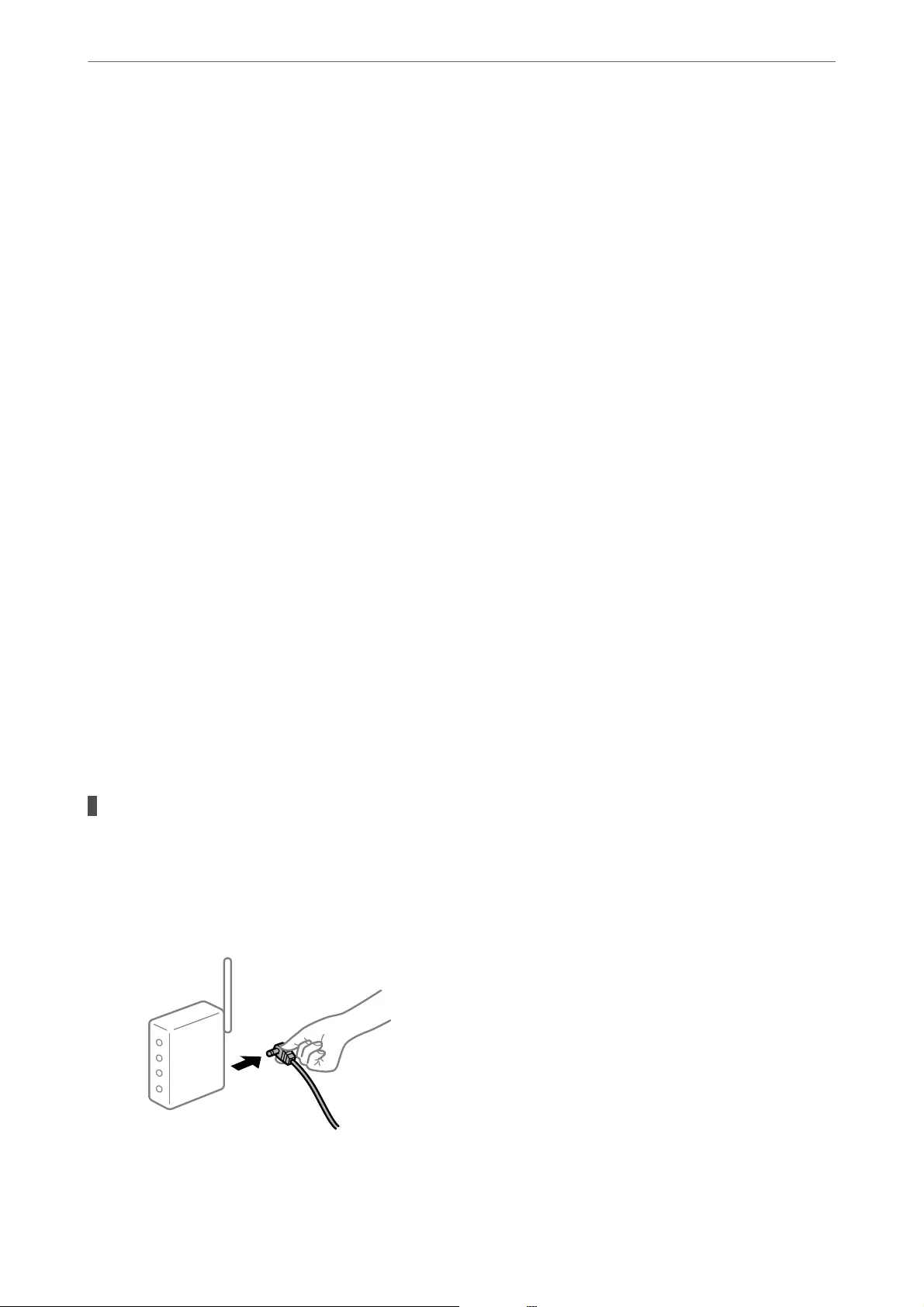
If there is no icon on the desktop, follow the methods below to start Epson Printer Connection Checker.
❏Windows 10
Click the start button, and then select Epson Soware > Epson Printer Connection Checker.
❏Windows 8.1/Windows 8
Enter the application name in the search charm, and then select the displayed icon.
❏Windows 7
Click the start button, and then select All Programs > Epson Soware > Epson Printer Connection
Checker.
2. Follow the on-screen instructions to check.
Note:
If the printer name is not displayed, install a genuine Epson printer driver.
“Checking if a genuine Epson printer driver is installed - Windows” on page 158
When you have identied the problem, follow the solution displayed on the screen.
When you cannot solve the problem, check the following according to your situation.
❏e printer is not recognized over a network connection
“Cannot connect to a Network” on page 192
❏e printer is not recognized using a USB connection
“e Printer Cannot Connect by USB (Windows)” on page 178
❏e printer is recognized, but scanning cannot be performed.
“Cannot Scan Even ough a Connection has been Correctly Established (Windows)” on page 195
Cannot connect to a Network
e problem could be one of the following issues.
Something is wrong with the network devices for Wi-Fi connection.
Solutions
Turn o the devices you want to connect to the network. Wait for about 10 seconds, and then turn on the
devices in the following order; wireless router, computer or smart device, and then printer. Move the
printer and computer or smart device closer to the wireless router to help with radio wave
communication, and then try to make network settings again.
Solving Problems
>
The Printer Does Not Work as Expected
>
Cannot Start Scanning
192
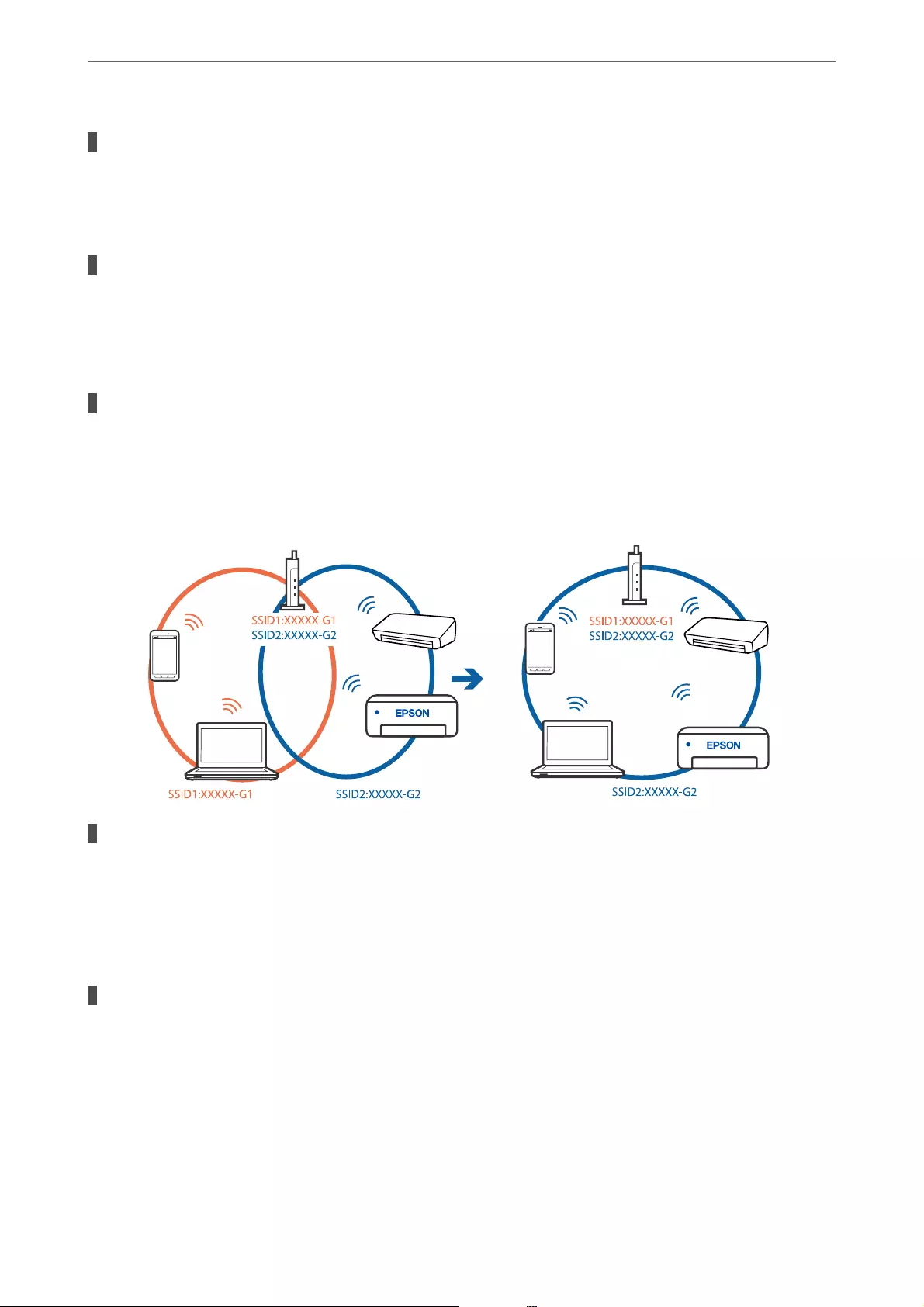
Devices cannot receive signals from the wireless router because they are too far apart.
Solutions
Aer moving the computer or the smart device and the printer closer to the wireless router, turn o the
wireless router, and then turn it back on.
When changing the wireless router, the settings do not match the new router.
Solutions
Make the connection settings again so that they match the new wireless router.
&“When Replacing the Wireless Router” on page 262
The SSIDs connected from the computer or smart device and computer are dierent.
Solutions
When you are using multiple wireless routers at the same time or the wireless router has multiple SSIDs
and devices are connected to dierent SSIDs, you cannot connect to the wireless router.
Connect the computer or smart device to the same SSID as the printer.
A privacy separator on the wireless router is available.
Solutions
Most wireless routers have a privacy separator feature that blocks communication between connected
devices. If you cannot communicate between the printer and the computer or smart device even if they
are connected to the same network, disable the privacy separator on the wireless router. See the manual
provided with the wireless router for details.
The IP address is incorrectly assigned.
Solutions
If the IP address assigned to the printer is 169.254.XXX.XXX, and the subnet mask is 255.255.0.0, the IP
address may not be assigned correctly.
Select Settings > General Settings > Network Settings > Advanced on the printer’s control panel, and
then check the IP address and the subnet mask assigned to the printer.
Restart the wireless router or reset the network settings for the printer.
&“Re-setting the Network Connection” on page 262
Solving Problems
>
The Printer Does Not Work as Expected
>
Cannot Start Scanning
193
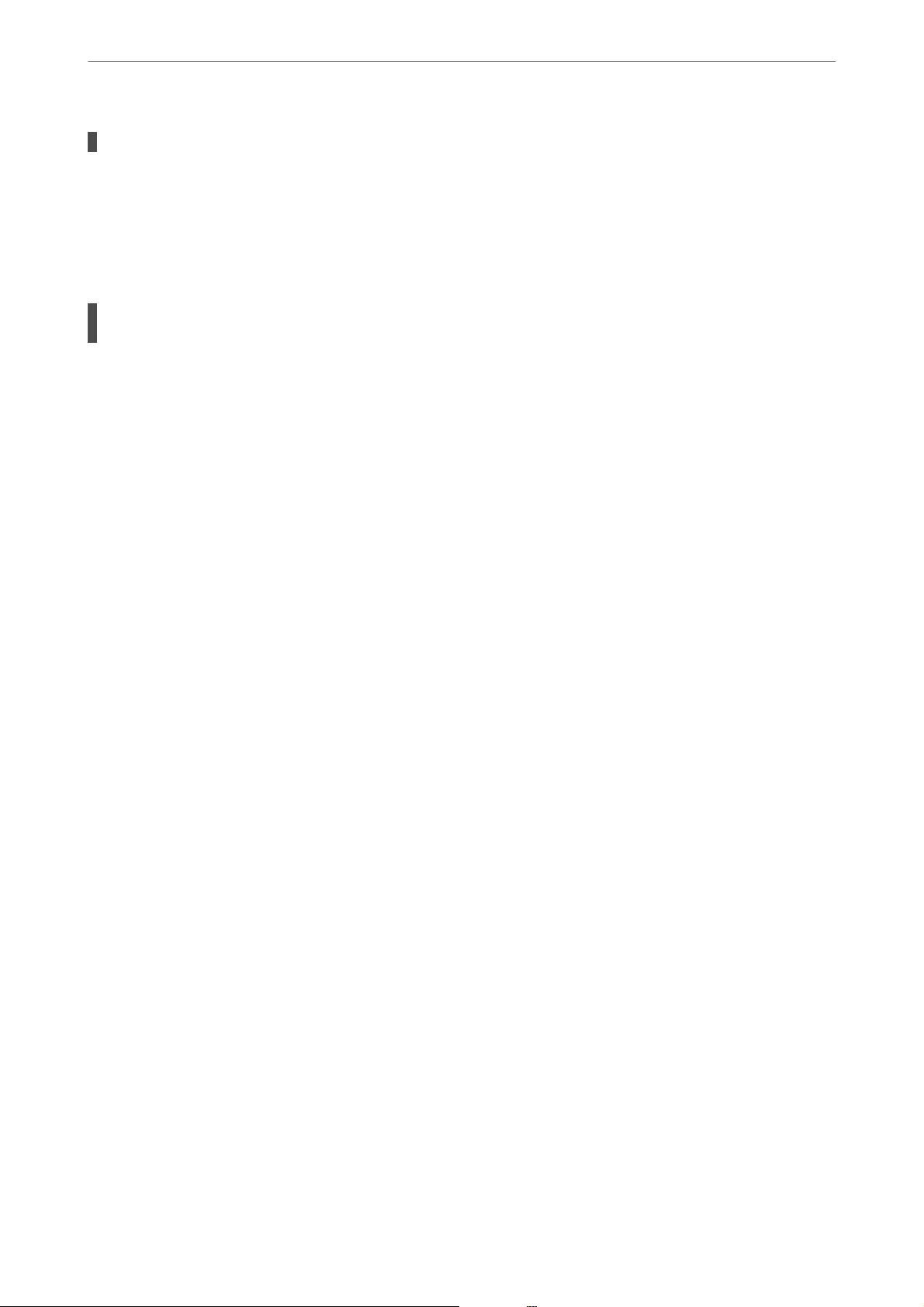
There is a problem with the network settings on the computer.
Solutions
Try accessing any website from your computer to make sure that your computer's network settings are
correct. If you cannot access any website, there is a problem on the computer.
Check the network connection of the computer. See the documentation provided with the computer for
details.
The printer has been connected by Ethernet using devices that support IEEE802.3az (Energy
Ecient Ethernet).
Solutions
When you connect the printer by Ethernet using devices that support IEEE802.3az (Energy Ecient
Ethernet), the following problems may occur depending on the hub or router that you are using.
❏Connection becomes unstable, the printer is connected and disconnected again and again.
❏Cannot connect to the printer.
❏e communication speed becomes slow.
Follow the steps below to disable IEEE802.3az for the printer and then connect.
1. Remove the Ethernet cable connected to the computer and the printer.
2. When IEEE802.3az for the computer is enabled, disable it.
See the documentation provided with the computer for details.
3. Connect the computer and the printer with an Ethernet cable directly.
4. On the printer, print a network connection report.
“Printing a Network Connection Report” on page 280
5. Check the printer's IP address on the network connection report.
6. On the computer, access Web Cong.
Launch a Web browser, and then enter the printer's IP address.
“Running Web Cong on a Web Browser” on page 301
7. Select the Network Settings tab > Wired LAN.
8. Select OFF for IEEE 802.3az.
9. Click Next.
10. Click OK.
11. Remove the Ethernet cable connected to the computer and the printer.
12. If you disabled IEEE802.3az for the computer in step 2, enable it.
13. Connect the Ethernet cables that you removed in step 1 to the computer and the printer.
Solving Problems
>
The Printer Does Not Work as Expected
>
Cannot Start Scanning
194

If the problem still occurs, devices other than the printer may be causing the problem.
The Printer Cannot Connect by USB (Windows)
e following causes can be considered.
The USB cable is not plugged into the electrical outlet correctly.
Connect the USB cable securely to the printer and the computer.
There is a problem with the USB hub.
If you are using a USB hub, try to connect the printer directly to the computer.
There is a problem with the USB cable or the USB inlet.
If the USB cable cannot be recognized, change the port, or change the USB cable.
Cannot Scan Even Though a Connection has been Correctly Established (Windows)
Scanning at a high resolution over a network.
Try scanning at a lower resolution.
Cannot Start Scanning from Mac OS
Make sure the computer and the printer are connected correctly.
e cause and solution to the problem dier depending on whether or not they are connected.
Checking the Connection Status
Use EPSON Status Monitor to check the connection status for the computer and the printer.
1. Select System Preferences from the Apple menu > Printers & Scanners (or Print & Scan, Print & Fax), and
then select the printer.
2. Click Options & Supplies > Utility > Open Printer Utility.
3. Click EPSON Status Monitor.
When the remaining ink levels are displayed, a connection has been successfully established between the computer
and the printer.
Check the following if a connection has not been established.
❏e printer is not recognized over a network connection
“Cannot connect to a Network” on page 196
Solving Problems
>
The Printer Does Not Work as Expected
>
Cannot Start Scanning
195
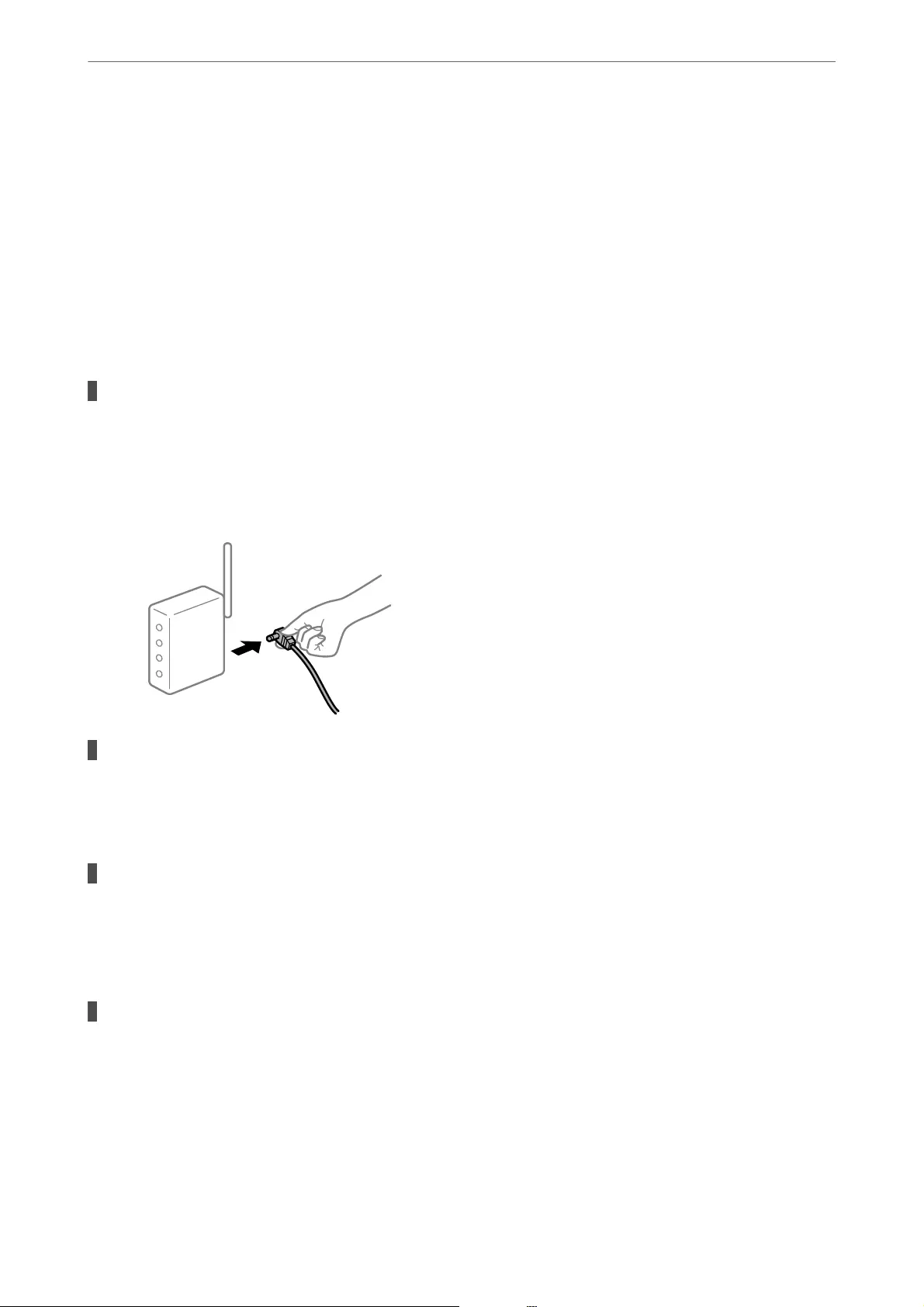
❏e printer is not recognized using a USB connection
“e Printer Cannot Connect by USB (Mac OS)” on page 186
Check the following if a connection has been established.
❏e printer is recognized, but scanning cannot be performed.
“Cannot Scan Even ough a Connection has been Correctly Established (Mac OS)” on page 199
Cannot connect to a Network
e problem could be one of the following issues.
Something is wrong with the network devices for Wi-Fi connection.
Solutions
Turn o the devices you want to connect to the network. Wait for about 10 seconds, and then turn on the
devices in the following order; wireless router, computer or smart device, and then printer. Move the
printer and computer or smart device closer to the wireless router to help with radio wave
communication, and then try to make network settings again.
Devices cannot receive signals from the wireless router because they are too far apart.
Solutions
Aer moving the computer or the smart device and the printer closer to the wireless router, turn o the
wireless router, and then turn it back on.
When changing the wireless router, the settings do not match the new router.
Solutions
Make the connection settings again so that they match the new wireless router.
&“When Replacing the Wireless Router” on page 262
The SSIDs connected from the computer or smart device and computer are dierent.
Solutions
When you are using multiple wireless routers at the same time or the wireless router has multiple SSIDs
and devices are connected to dierent SSIDs, you cannot connect to the wireless router.
Solving Problems
>
The Printer Does Not Work as Expected
>
Cannot Start Scanning
196
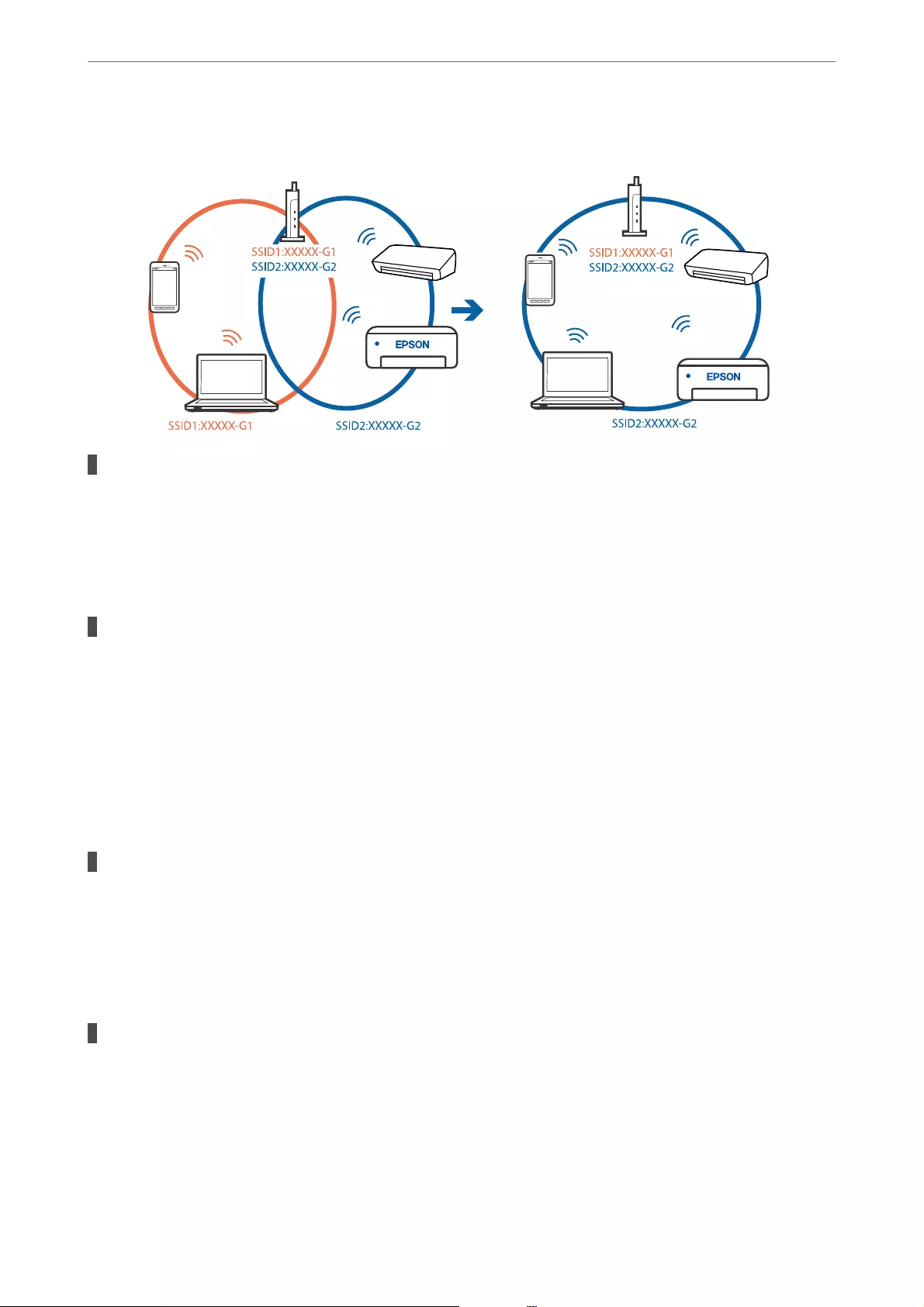
Connect the computer or smart device to the same SSID as the printer.
A privacy separator on the wireless router is available.
Solutions
Most wireless routers have a privacy separator feature that blocks communication between connected
devices. If you cannot communicate between the printer and the computer or smart device even if they
are connected to the same network, disable the privacy separator on the wireless router. See the manual
provided with the wireless router for details.
The IP address is incorrectly assigned.
Solutions
If the IP address assigned to the printer is 169.254.XXX.XXX, and the subnet mask is 255.255.0.0, the IP
address may not be assigned correctly.
Select Settings > General Settings > Network Settings > Advanced on the printer’s control panel, and
then check the IP address and the subnet mask assigned to the printer.
Restart the wireless router or reset the network settings for the printer.
&“Re-setting the Network Connection” on page 262
There is a problem with the network settings on the computer.
Solutions
Try accessing any website from your computer to make sure that your computer's network settings are
correct. If you cannot access any website, there is a problem on the computer.
Check the network connection of the computer. See the documentation provided with the computer for
details.
The device connected to the USB 3.0 port causes radio frequency interference.
Solutions
When you connect a device to the USB 3.0 port on a Mac, radio frequency interference may occur. Try
the following if you cannot connect to wireless LAN (Wi-Fi) or if operations become unstable.
❏Place the device that is connected to the USB 3.0 port further away from the computer.
❏Connect to the SSID for the 5 GHz range.
Solving Problems
>
The Printer Does Not Work as Expected
>
Cannot Start Scanning
197
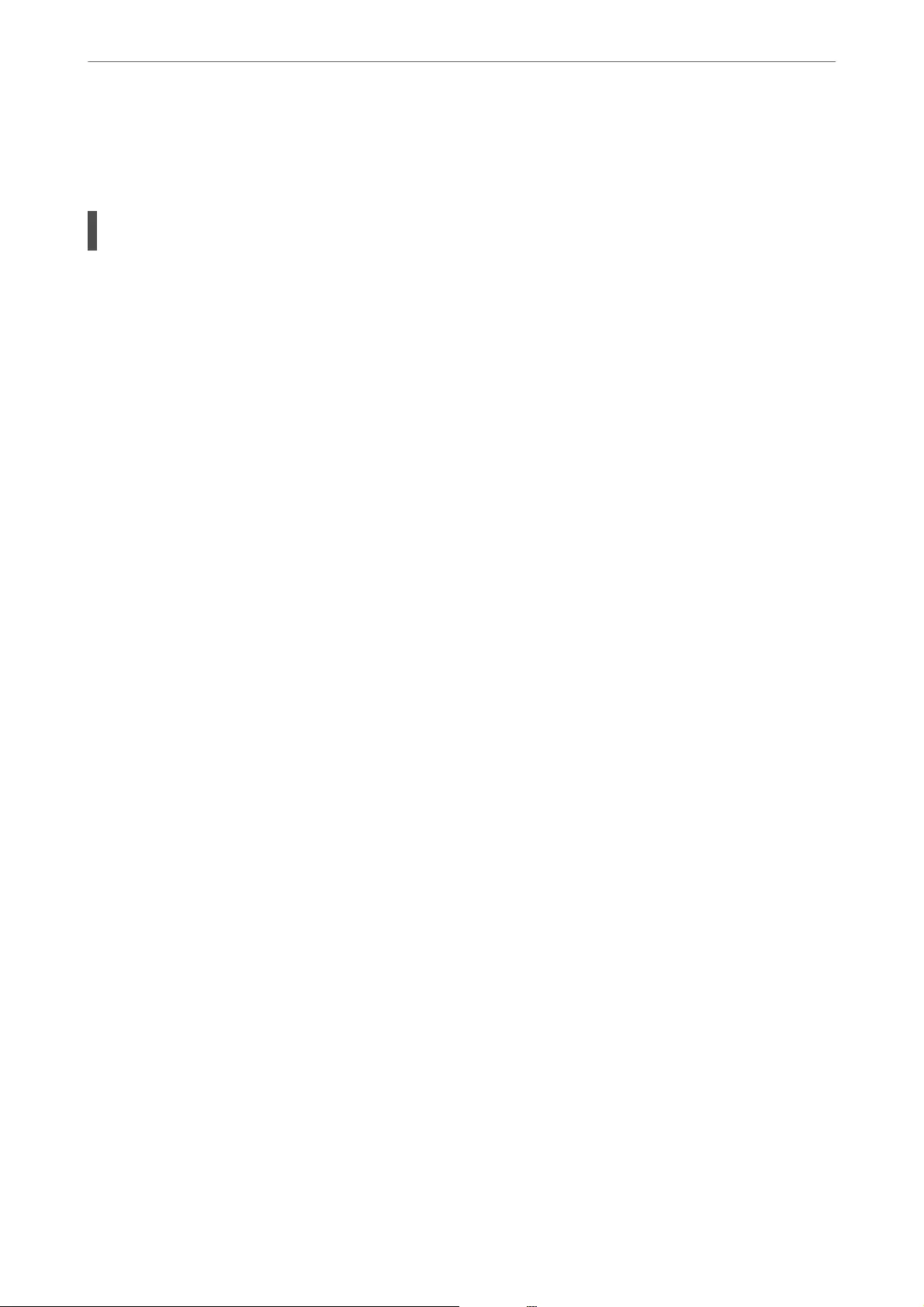
See the following to connect the printer to the SSID.
&“Making Wi-Fi Settings by Entering the SSID and Password” on page 266
The printer has been connected by Ethernet using devices that support IEEE802.3az (Energy
Ecient Ethernet).
Solutions
When you connect the printer by Ethernet using devices that support IEEE802.3az (Energy Ecient
Ethernet), the following problems may occur depending on the hub or router that you are using.
❏Connection becomes unstable, the printer is connected and disconnected again and again.
❏Cannot connect to the printer.
❏e communication speed becomes slow.
Follow the steps below to disable IEEE802.3az for the printer and then connect.
1. Remove the Ethernet cable connected to the computer and the printer.
2. When IEEE802.3az for the computer is enabled, disable it.
See the documentation provided with the computer for details.
3. Connect the computer and the printer with an Ethernet cable directly.
4. On the printer, print a network connection report.
“Printing a Network Connection Report” on page 280
5. Check the printer's IP address on the network connection report.
6. On the computer, access Web Cong.
Launch a Web browser, and then enter the printer's IP address.
“Running Web Cong on a Web Browser” on page 301
7. Select the Network Settings tab > Wired LAN.
8. Select OFF for IEEE 802.3az.
9. Click Next.
10. Click OK.
11. Remove the Ethernet cable connected to the computer and the printer.
12. If you disabled IEEE802.3az for the computer in step 2, enable it.
13. Connect the Ethernet cables that you removed in step 1 to the computer and the printer.
If the problem still occurs, devices other than the printer may be causing the problem.
Solving Problems
>
The Printer Does Not Work as Expected
>
Cannot Start Scanning
198

The Printer Cannot Connect by USB (Mac OS)
e following causes can be considered.
The USB cable is not plugged into the electrical outlet correctly.
Connect the USB cable securely to the printer and the computer.
There is a problem with the USB hub.
If you are using a USB hub, try to connect the printer directly to the computer.
There is a problem with the USB cable or the USB inlet.
If the USB cable cannot be recognized, change the port, or change the USB cable.
Cannot Scan Even Though a Connection has been Correctly Established (Mac OS)
Scanning at a high resolution over a network.
Try scanning at a lower resolution.
Cannot Start Scanning from Smart Device
Make sure the smart device and the printer are connected correctly.
e cause and solution to the problem dier depending on whether or not they are connected.
Checking the Connection Status
Use Epson iPrint to check the connection status for the smart device and the printer.
See the following to install Epson iPrint if it is not already installed.
“Application for Printing Easily from a Smart Device (Epson iPrint)” on page 298
1. On the smart device, start Epson iPrint.
2. Check that the printer name is displayed on the home screen.
When the printer name is displayed, a connection has been successfully established between the smart device
and the printer.
If the following are displayed, a connection has not been established between the smart device and the printer.
❏Printer is not selected.
❏Communication error.
Check the following if a connection has not been established.
❏e printer is not recognized over a network connection
“Cannot connect to a Network” on page 200
Solving Problems
>
The Printer Does Not Work as Expected
>
Cannot Start Scanning
199
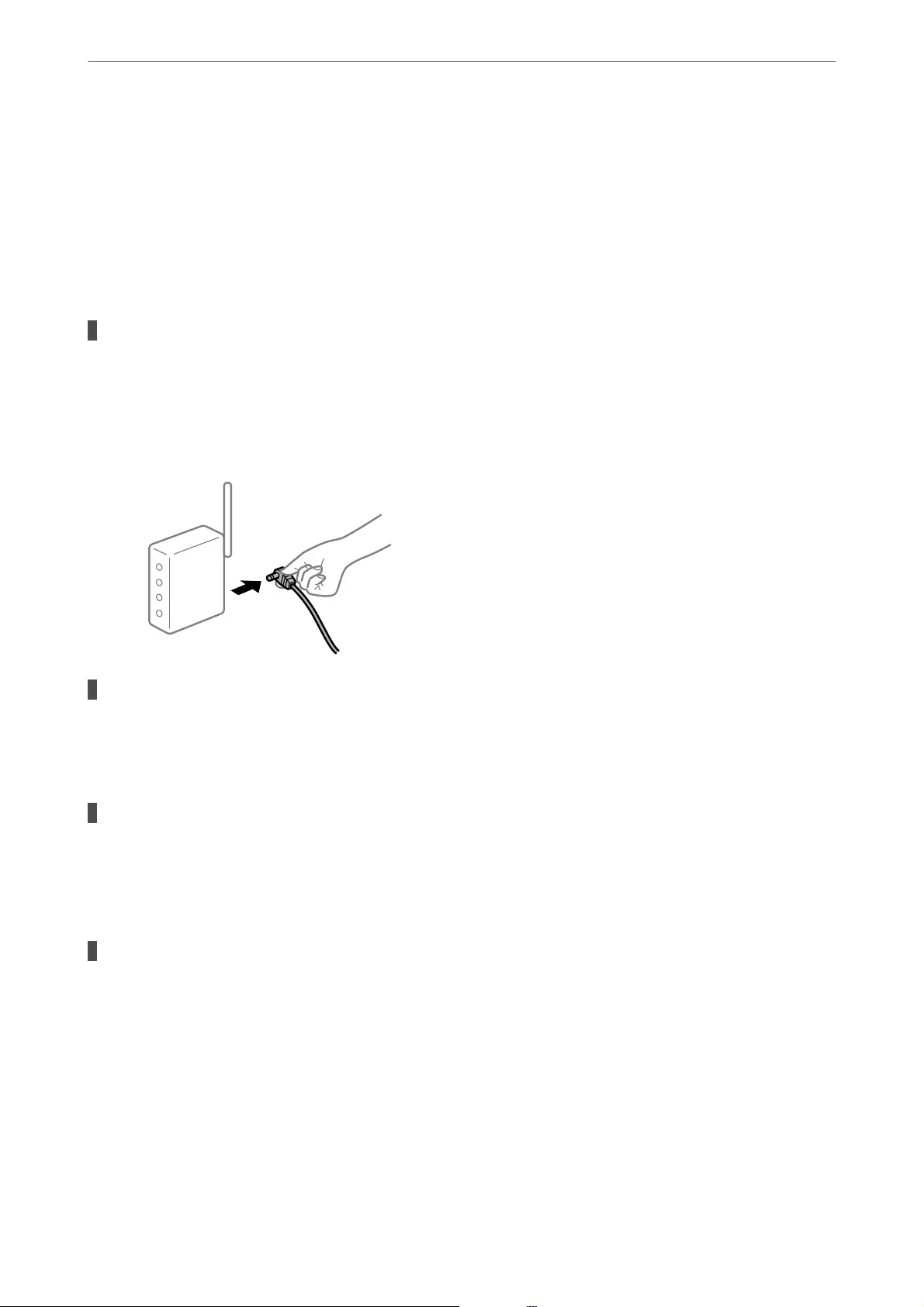
Check the following if a connection has been established.
❏e printer is recognized, but scanning cannot be performed.
“Cannot Print Even ough a Connection has been Established (iOS)” on page 190
Cannot connect to a Network
e problem could be one of the following issues.
Something is wrong with the network devices for Wi-Fi connection.
Solutions
Turn o the devices you want to connect to the network. Wait for about 10 seconds, and then turn on the
devices in the following order; wireless router, computer or smart device, and then printer. Move the
printer and computer or smart device closer to the wireless router to help with radio wave
communication, and then try to make network settings again.
Devices cannot receive signals from the wireless router because they are too far apart.
Solutions
Aer moving the computer or the smart device and the printer closer to the wireless router, turn o the
wireless router, and then turn it back on.
When changing the wireless router, the settings do not match the new router.
Solutions
Make the connection settings again so that they match the new wireless router.
&“When Replacing the Wireless Router” on page 262
The SSIDs connected from the computer or smart device and computer are dierent.
Solutions
When you are using multiple wireless routers at the same time or the wireless router has multiple SSIDs
and devices are connected to dierent SSIDs, you cannot connect to the wireless router.
Solving Problems
>
The Printer Does Not Work as Expected
>
Cannot Start Scanning
200
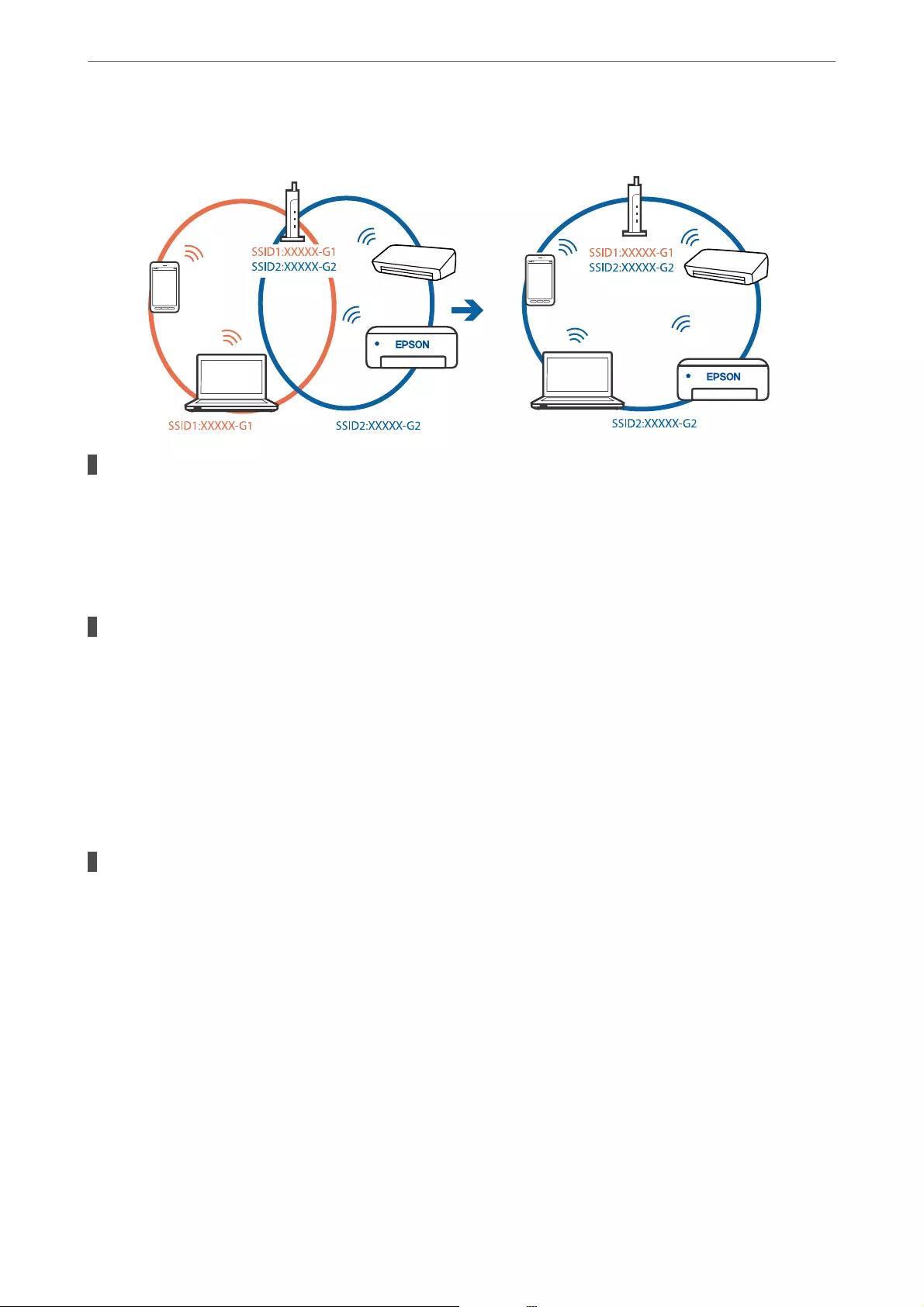
Connect the computer or smart device to the same SSID as the printer.
A privacy separator on the wireless router is available.
Solutions
Most wireless routers have a privacy separator feature that blocks communication between connected
devices. If you cannot communicate between the printer and the computer or smart device even if they
are connected to the same network, disable the privacy separator on the wireless router. See the manual
provided with the wireless router for details.
The IP address is incorrectly assigned.
Solutions
If the IP address assigned to the printer is 169.254.XXX.XXX, and the subnet mask is 255.255.0.0, the IP
address may not be assigned correctly.
Select Settings > General Settings > Network Settings > Advanced on the printer’s control panel, and
then check the IP address and the subnet mask assigned to the printer.
Restart the wireless router or reset the network settings for the printer.
&“Re-setting the Network Connection” on page 262
There is a problem with the network settings on the smart device.
Solutions
Try accessing any website from your smart device to make sure that your smart device's network settings
are correct. If you cannot access any website, there is a problem on the smart device.
Check the network connection of the computer. See the documentation provided with the smart device
for details.
Cannot Save Scanned Images to the Shared Folder
Messages are Displayed on the Control Panel
When error messages are displayed on the control panel, check the message itself or the following list to solve the
problems.
Solving Problems
>
The Printer Does Not Work as Expected
>
Cannot Start Scanning
201
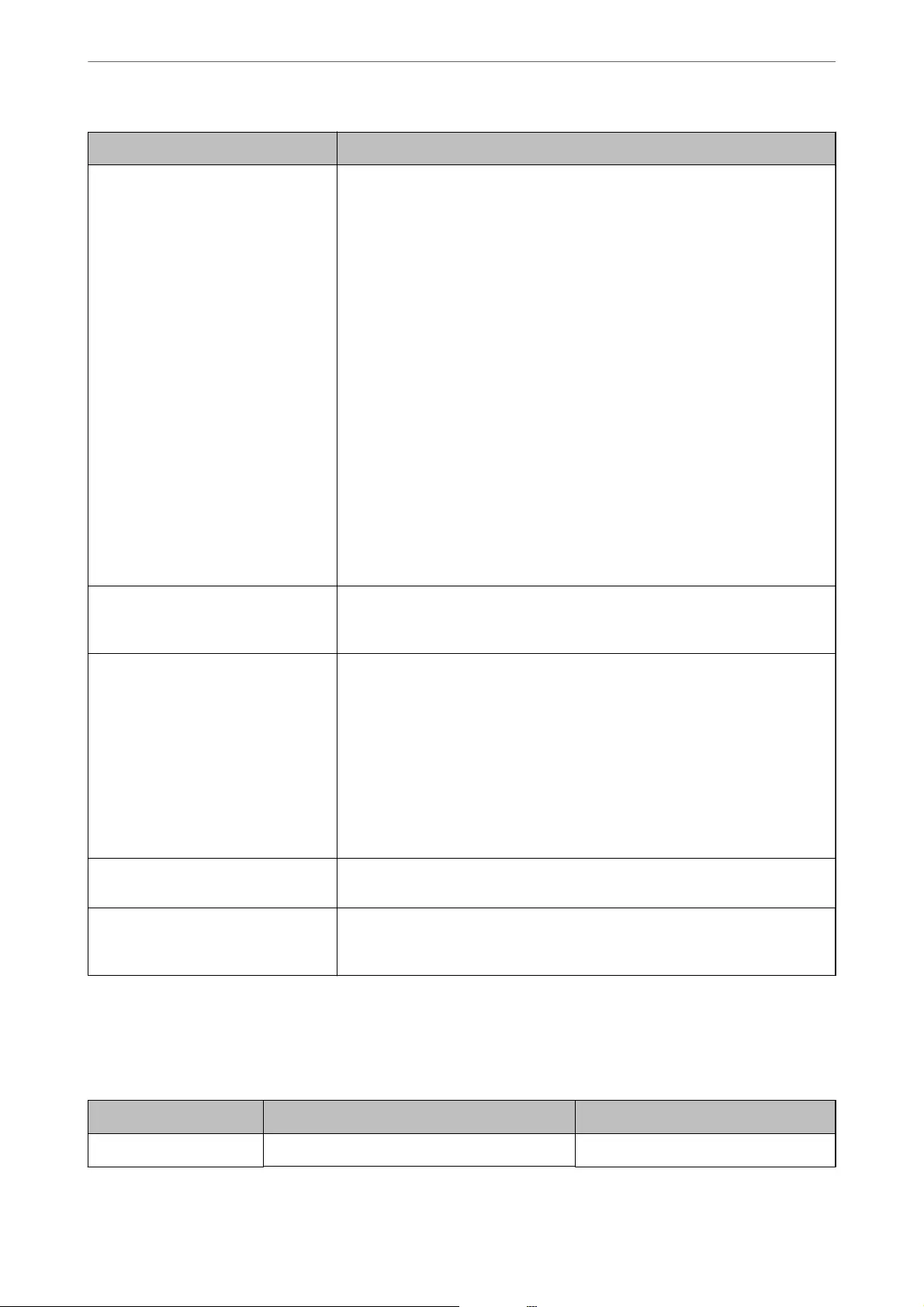
Messages Solutions
DNS error. Check DNS settings. Cannnot connect to the computer. Check the following.
❏Make sure that the address in the contacts list on the printer and the address
of the shared folder are the same.
❏If the IP address of the computer is static and is set manually, change the
computer name in the network path to the IP address.
Example: \\EPSON02\SCAN to \\192.168.xxx.xxx\SCAN
❏Make sure that the computer is turned on and does not sleep. If the computer
sleeps, you cannot save scanned images to the shared folder.
❏Temporarily disable the computer's Firewall and security software. If this clears
the error, check the settings in the security software.
❏If Public network is selected as the network place, you cannot save the
scanned images to the shared folder. Set the forward settings for each port.
❏If you are using a laptop computer and the IP address is set as DHCP, the IP
address may change when reconnecting to the network. Obtain the IP address
again.
❏Make sure the DNS setting is correct. Contact your network administrator
about the DNS settings.
❏The computer name and the IP address may dier when the management
table of the DNS server is not updated. Contact your DNS server administrator.
Authentication error. Check the
authentication method, authenticated
account, and authenticated password.
Make sure the user name and the password are correct on the computer and the
contacts on the printer. Also, make sure that the password has not expired.
Communication error. Check the Wi-Fi/
network connection.
Cannot communicate with a network folder that is registered on the contacts list.
Check the following.
❏Make sure that Use Microsoft network sharing is enabled on the Web Cong.
Select Network > MS Network on the Web Cong.
❏Make sure that the address in the contacts list on the printer and the address
of the shared folder are the same.
❏Access rights for the user in the contacts list should be added on the Sharing
tab and the Security tab of the shared folder's properties. Also, the
permissions for the user should be set to "allowed".
The le name is already in use. Rename
the le and scan again.
Change the le name settings. Otherwise, move or delete the les, or change the
le name on the shared folder.
Scanned le(s) are too large. Only XX
page(s) have been sent. Check if the
destination has enough space.
There is not enough disk space on the computer. Increase the free space on the
computer.
Checking the Point where the Error Occurred
When saving scanned images to the shared folder, saving process proceeds as following. You can then check the
point where the error occurred.
Items Operation Error Messages
Connecting Connect to the computer from the printer. DNS error. Check DNS settings.
Solving Problems
>
The Printer Does Not Work as Expected
>
Cannot Start Scanning
202
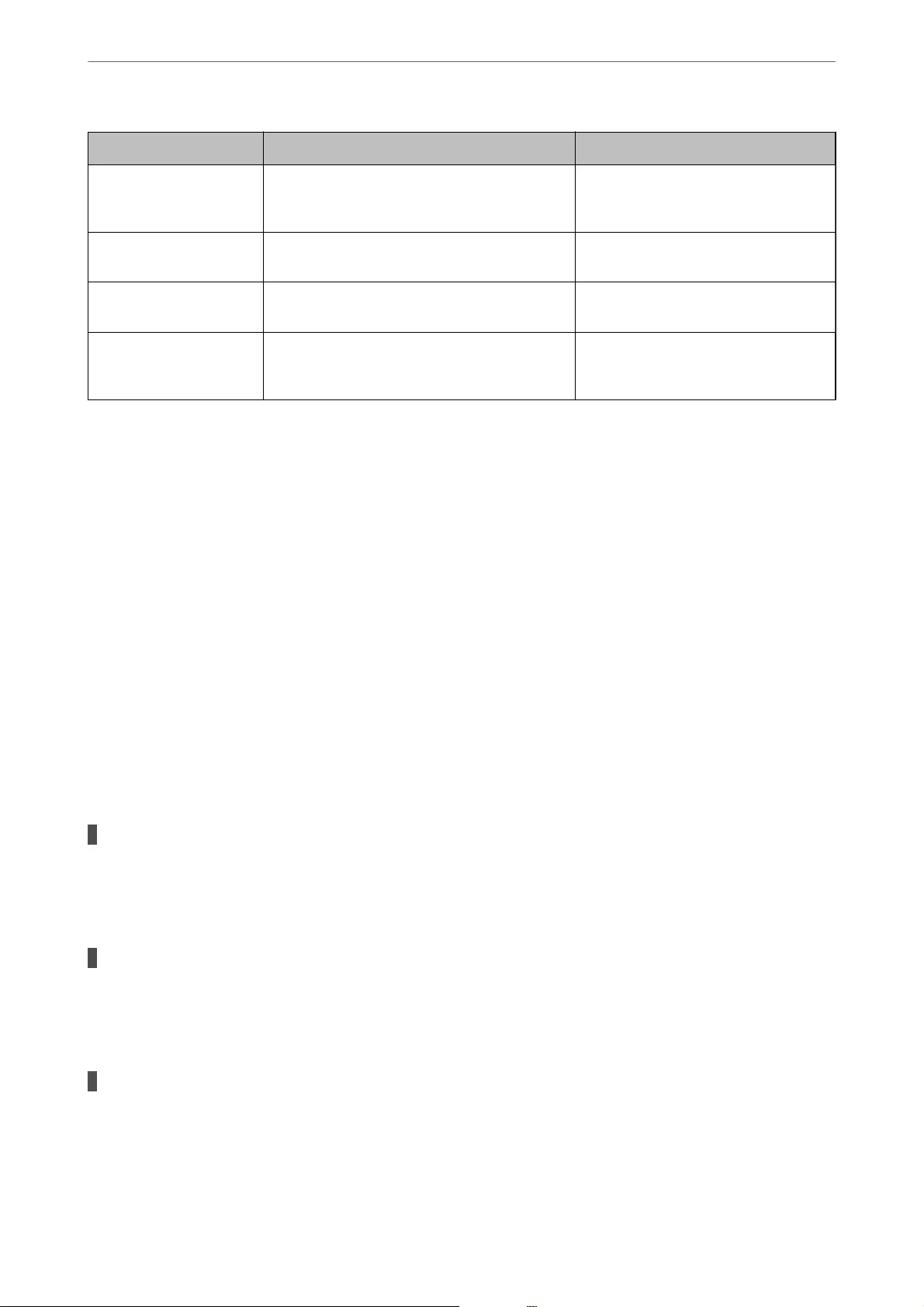
Items Operation Error Messages
Logging on to the
computer
Log on to the computer with the user name and
the password.
Authentication error. Check the
authentication method, authenticated
account, and authenticated password.
Checking the folder to
save
Check the network path of the shared folder. Communication error. Check the Wi-Fi/
network connection.
Checking the le name Check if there is a le with the same name as the
le you want to save in the folder.
The le name is already in use. Rename
the le and scan again.
Writing the le Write a new le. Scanned le(s) are too large. Only XX
page(s) have been sent. Check if the
destination has enough space.
Saving the Scanned Images Takes a Long Time
It takes a long time for the name resolution to correspond to the "Domain Name" and the "IP Address".
Check the following points.
❏Make sure the DNS setting is correct.
❏Make sure each DNS setting is correct when checking the Web Cong.
❏Make sure the DNS domain name is correct.
Cannot Send or Receive Faxes
Cannot Send or Receive Faxes
e following causes can be considered.
There are some problems in telephone wall jack.
Solutions
Check that the telephone wall jack works by connecting a phone to it and testing it. If you cannot make or
receive calls, contact your telecommunication company.
There are some problems in connecting to the telephone line.
Solutions
Select Settings > General Settings > Fax Settings > Check Fax Connection on the control panel to run
the automatic fax connection check. Try the solutions printed on the report.
Communication error occurs.
Solutions
Select Slow(9,600bps) in Settings > General Settings > Fax Settings > Basic Settings > Fax Speed on
the control panel.
Solving Problems
>
The Printer Does Not Work as Expected
>
Cannot Send or Receive Faxes
203
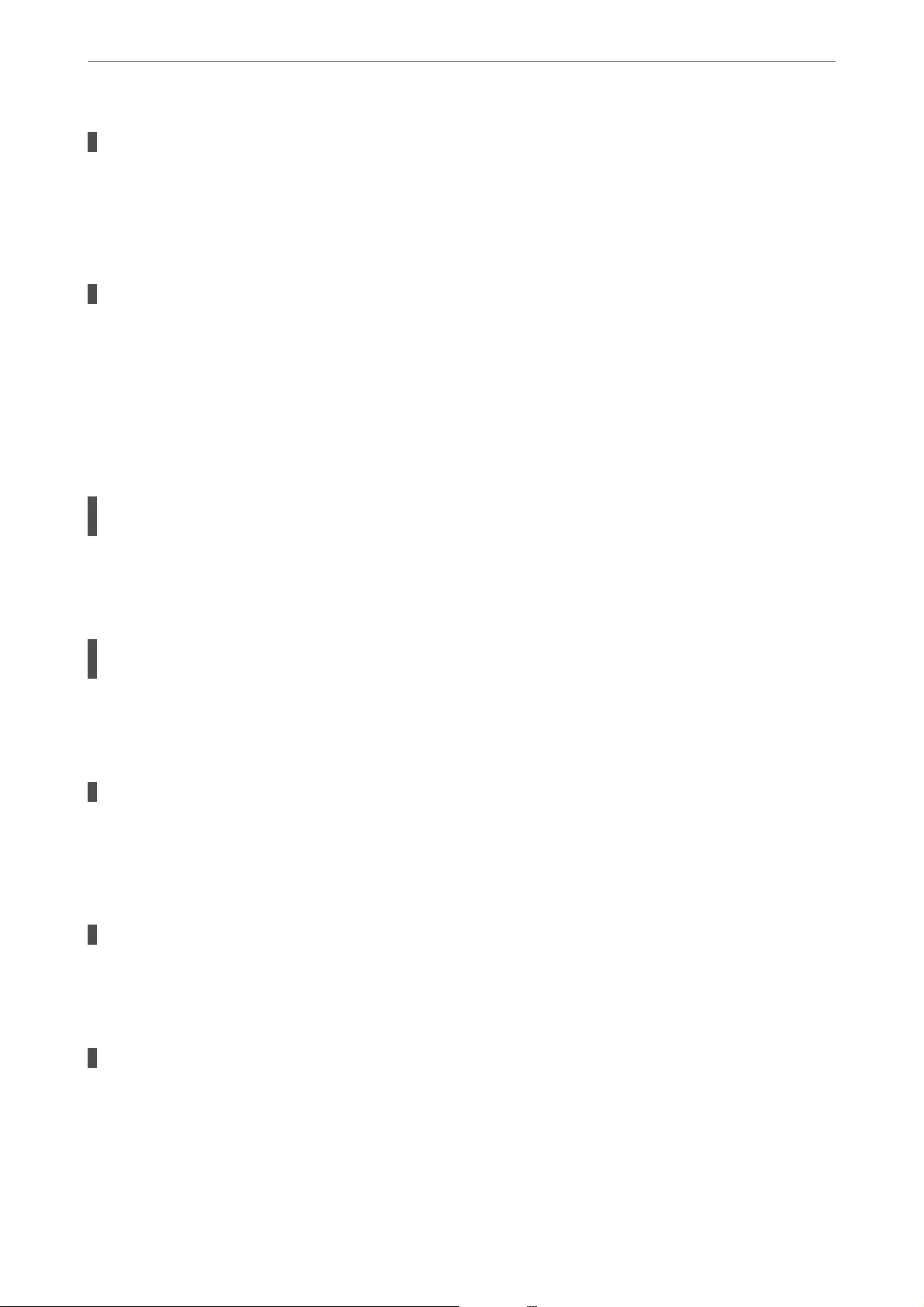
Connected to a DSL phone line without DSL lter.
Solutions
To connect to a DSL phone line, you need to use a DSL modem equipped with a built-in DSL lter, or
install a separate DSL lter to the line. Contact your DSL provider.
“Connecting to DSL or ISDN” on page 388
There are some problems in the DSL lter when you connect to a DSL phone line.
Solutions
If you can not send or receive fax, connect the printer directly to a telephone wall jack to see if the printer
can send a fax. If it works, the problem may be caused by the DSL lter. Contact your DSL provider.
Cannot Send Faxes
e following causes can be considered.
The connection line is set to PSTN in a facility where a private branch exchange (PBX) is
being used.
Solutions
Select PBX in Settings > General Settings > Fax Settings > Basic Settings > Line Type on the control
panel.
Sending faxes without entering an access code in an environment in which a PBX is
installed.
Solutions
If your phone system requires an external access code to get an outside line, register the access code to the
printer, and enter # (hash) at the beginning of a fax number when sending.
The header information for outgoing faxes is not registered.
Solutions
Select Settings > General Settings > Fax Settings > Basic Settings > Header and set up the header
information. Some fax machines automatically reject incoming faxes that do not include header
information.
Your caller ID is blocked.
Solutions
Contact your telecommunication company to unblock your caller ID. Some phones or fax machines
automatically reject anonymous calls.
The recipient's fax number is wrong.
Solutions
Check that the recipient's number registered in your contacts list or that you entered directly using the
keypad is correct. Or, check with the recipient that the fax number is correct.
Solving Problems
>
The Printer Does Not Work as Expected
>
Cannot Send or Receive Faxes
204
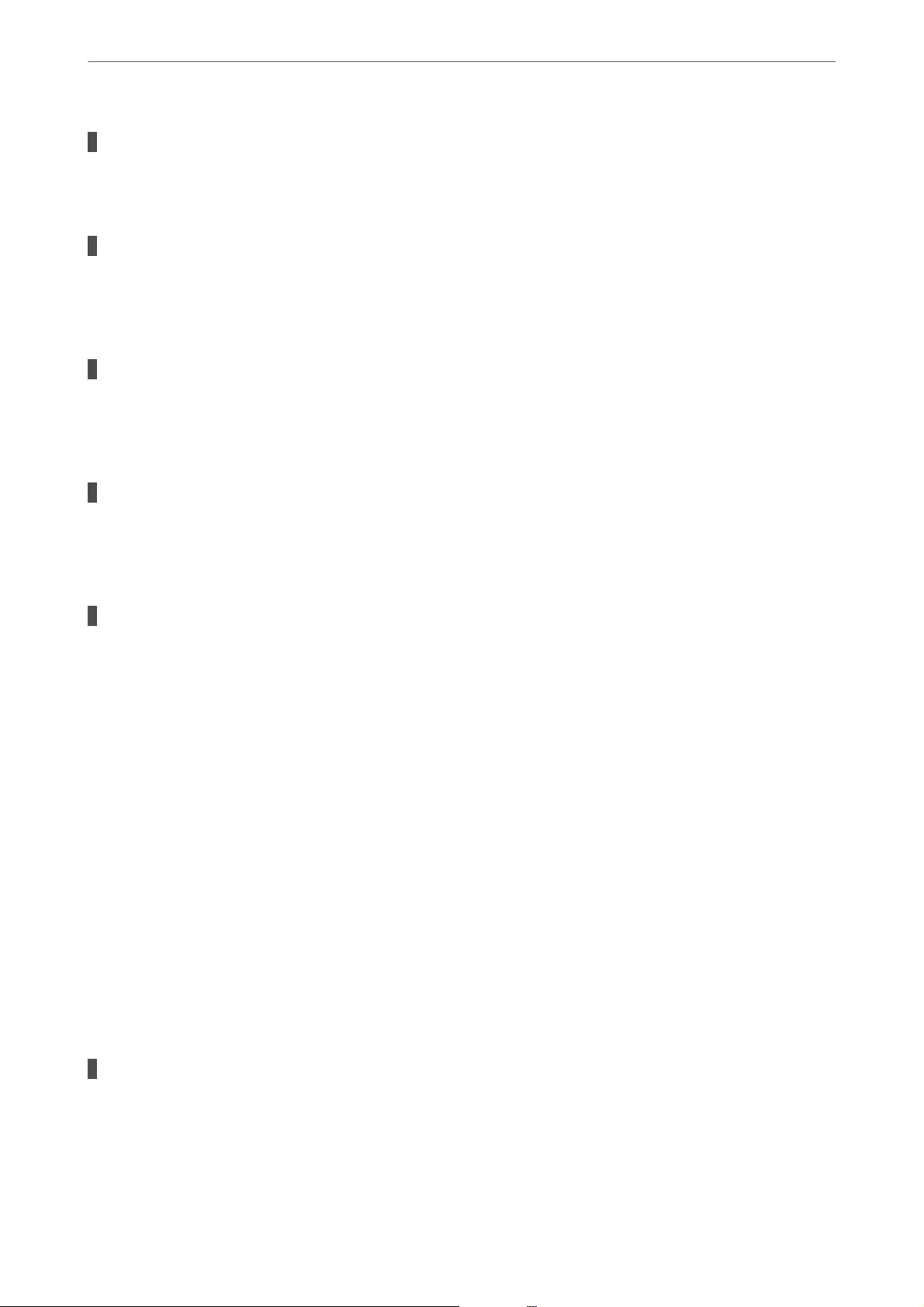
The recipient's fax machine is not ready to receive faxes.
Solutions
Ask the recipient if the recipient's fax machine is ready to receive a fax.
Sending a fax accidently using the subaddress feature.
Solutions
Check if you accidentally sent a fax using the subaddress feature. If you select a recipient with a
subaddress from the contact list, the fax may be sent using the subaddress feature.
The recipient's fax machine is not capable of receiving faxes using the subaddress feature.
Solutions
When sending faxes using the subaddress feature, ask the recipient if their fax machine is capable of
receiving faxes using the subaddress feature.
The subaddress and password are wrong.
Solutions
When sending faxes using the subaddress feature, check that the subaddress and password are correct.
Check with the recipient that the subaddress and password match.
The data being sent is too large.
Solutions
You can send faxes at a smaller data size using one of the following methods.
❏When you send the fax in monochrome, enable Direct Send in Fax > Fax Settings > Fax Send
Settings.
“Sending Many Pages of a Monochrome Document (Direct Send)” on page 116
❏Using the connected phone
“Sending Faxes Dialing from the External Phone Device” on page 113
❏Using On Hook
“Sending Faxes Manually Aer Conrming the Recipient's Status” on page 113
❏Separating the originals
Cannot Receive Faxes
e following causes can be considered.
We also recommend checking the printer status in Job/Status, such as whether or not the printer is currently
receiving the fax.
Subscribing to a call forwarding service.
Solutions
If you have subscribed to a call forwarding service, the printer may not be able to receive faxes. Contact
the service provider.
Solving Problems
>
The Printer Does Not Work as Expected
>
Cannot Send or Receive Faxes
205
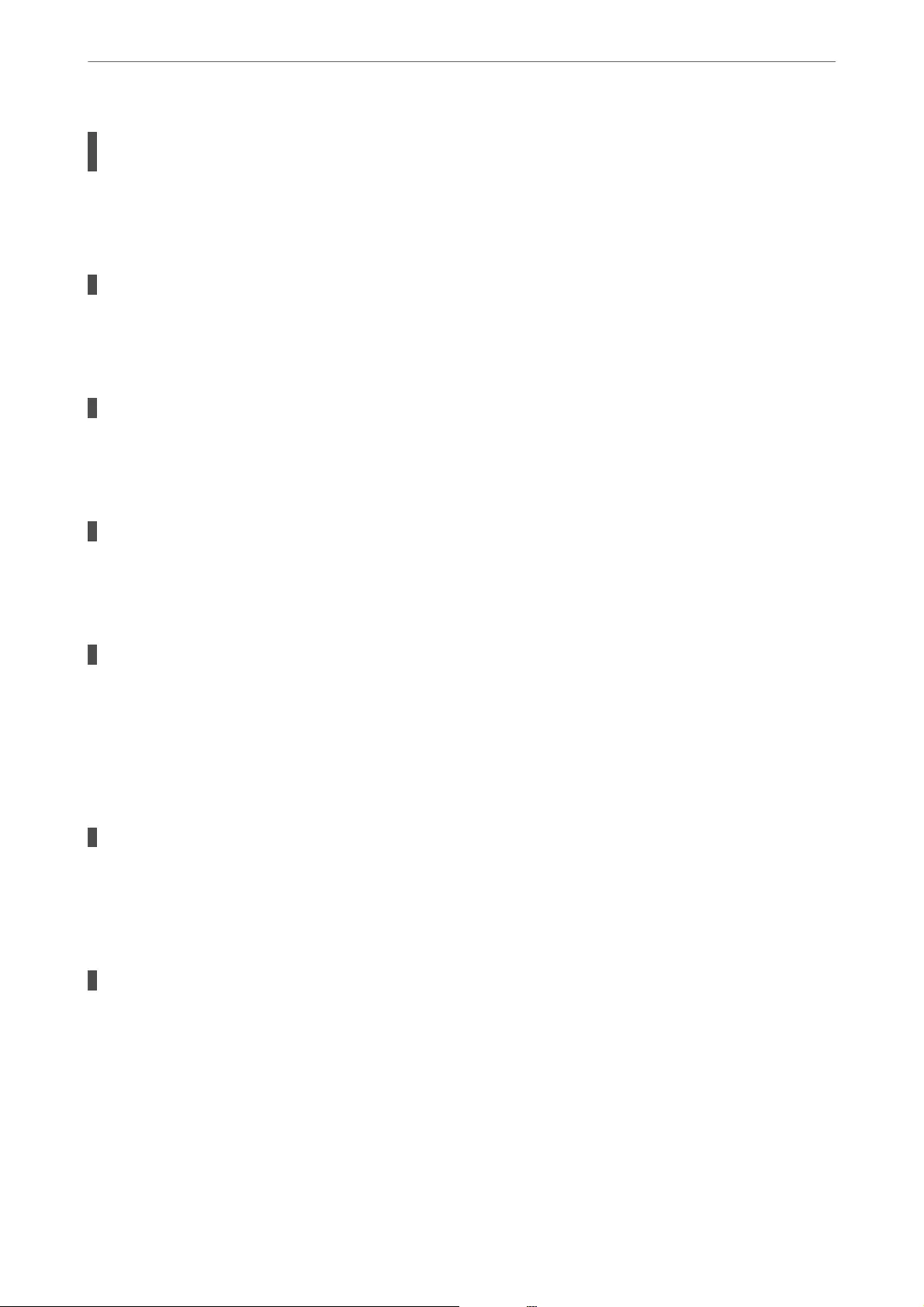
The Receive Mode is set to Manual while an external phone device is connected to the
printer.
Solutions
If an external phone device is connected to the printer and is sharing a phone line with the printer, select
Settings >General Settings > Fax Settings > Basic Settings, and then set Receive Mode to Auto.
The available memory of the inbox and the condential box is not enough.
Solutions
100 received documents have been saved in the inbox and the condential box in total. Delete the
unnecessary documents.
The computer that will save the received faxes is not turned on.
Solutions
When you have made settings to save received faxes to a computer, turn on the computer. e received
fax is deleted once it has been saved to the computer.
The subaddress and password are wrong.
Solutions
When receiving faxes using the subaddress feature, check that the subaddress and password are correct.
Check with the sender that the subaddress and password match.
The sender's fax number has been registered to the Rejection Number List.
Solutions
Make sure that the sender's number can be deleted from the Rejection Number List before deleting it.
Delete it from Settings > General Settings > Fax Settings > Basic Settings > Rejection Fax > Edit
Blocked Number list. Or disable the Rejection Number List in Settings > General Settings > Fax
Settings > Basic Settings > Rejection Fax > Rejection Fax. Faxes sent from numbers that have not been
registered to this list are blocked when this setting is enabled.
The sender's fax number has not been registered in the contacts list.
Solutions
Register the sender's fax number to contact list. Or disable Unregistered Contacts in Settings > General
Settings > Fax Settings > Basic Settings > Rejection Fax > Rejection Fax. Faxes sent from numbers that
have not been registered to this list are blocked.
The sender has sent the fax without header information.
Solutions
Ask the sender if header information is setup on their fax machine. Or, disable Fax Header Blank in
Settings > General Settings > Fax Settings > Basic Settings > Rejection Fax > Rejection Fax. Faxes that
do not include header information are blocked when this setting is enabled.
Cannot Send Faxes to a Specic Recipient
e following causes can be considered.
Solving Problems
>
The Printer Does Not Work as Expected
>
Cannot Send or Receive Faxes
206
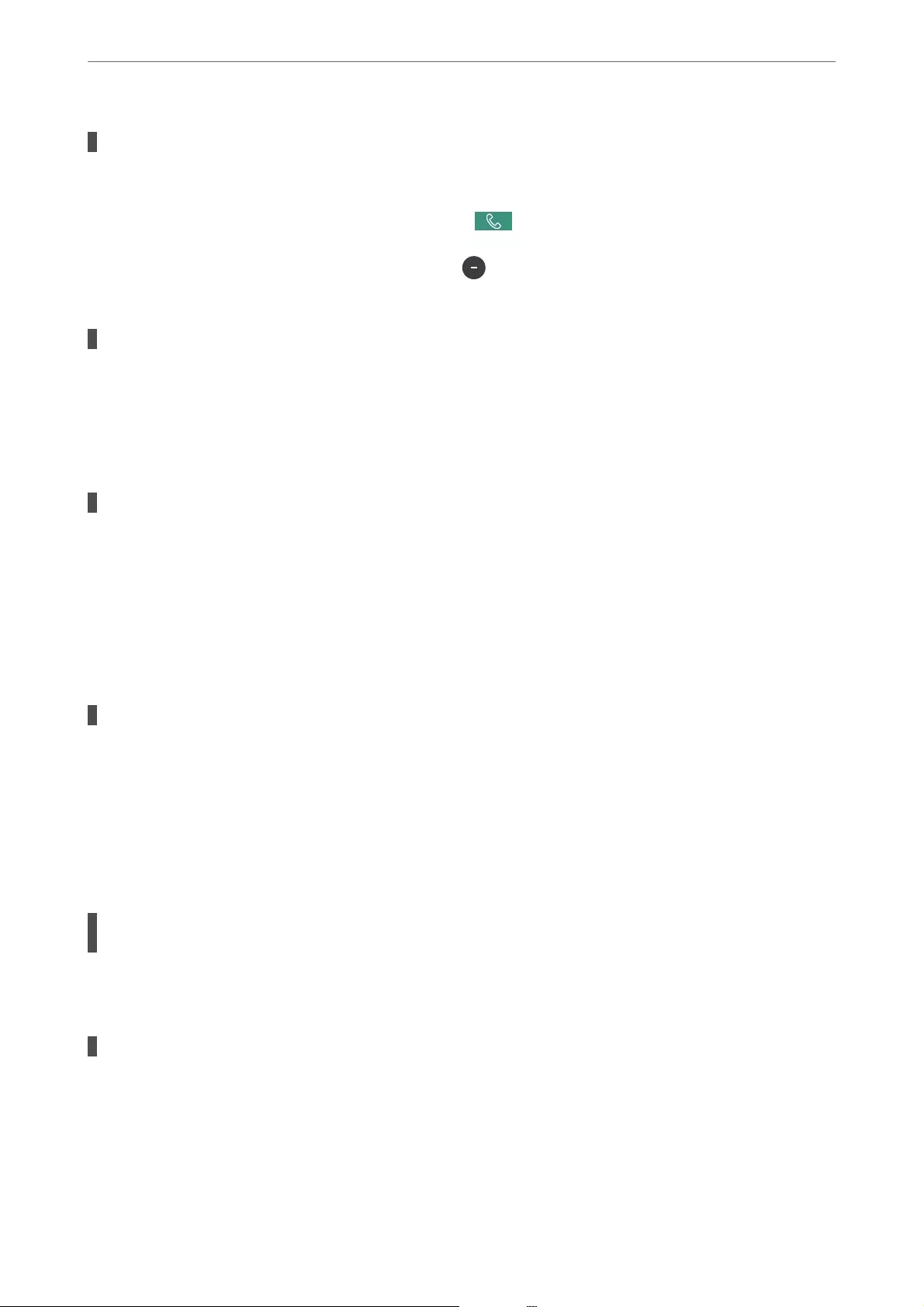
The recipient's machine takes a long time to answer.
Solutions
If the recipient machine does not pick up your call within 50 seconds aer the printer has nished
dialing, the call ends with an error. Dial using the (On Hook) feature or using a connected
telephone to check how long it takes before you hear a fax tone. If it takes more than 50 seconds, add
pauses aer the fax number to send the fax. Tap to enter the pause. A hyphen is entered as the pause
mark. One pause is about three seconds. Add multiple pauses as needed.
The Fax Speed setting registered in the contact list is wrong.
Solutions
Select the recipient from the contact list, and then select Edit > Fax Speed > Slow(9,600bps).
Cannot Send Faxes at a Specied Time
The printer's date and time is wrong.
Solutions
Select Settings > General Settings > Basic Settings > Date/Time Settings, and then set the correct date
and time.
Faxes Are Sent at the Wrong Size
e following causes can be considered.
The originals are not placed correctly.
Solutions
❏Make sure the original is placed correctly against the alignment marks.
❏If the edge of the scanned image is missing, move the original slightly away from the edge of the
scanner glass. You cannot scan the area within approximately 1.5 mm (0.06 in.) from the edge of the
scanner glass.
&“Placing Originals” on page 35
If the printer is placed in a location near a light source or subjected to direct sunlight, the
original size may not be detected correctly.
Solutions
Select the original size manually, and then try again.
There is dust or dirt on the scanner glass or document mat.
Solutions
When scanning from the control panel and selecting the auto scan area cropping function, remove any
trash or dirt from the scanner glass and document mat. If there is any trash or dirt around the original,
the scanning range expands to include it.
&“Cleaning the Scanner Glass” on page 151
&“Cleaning the Scanner Glass” on page 151
Solving Problems
>
The Printer Does Not Work as Expected
>
Cannot Send or Receive Faxes
207
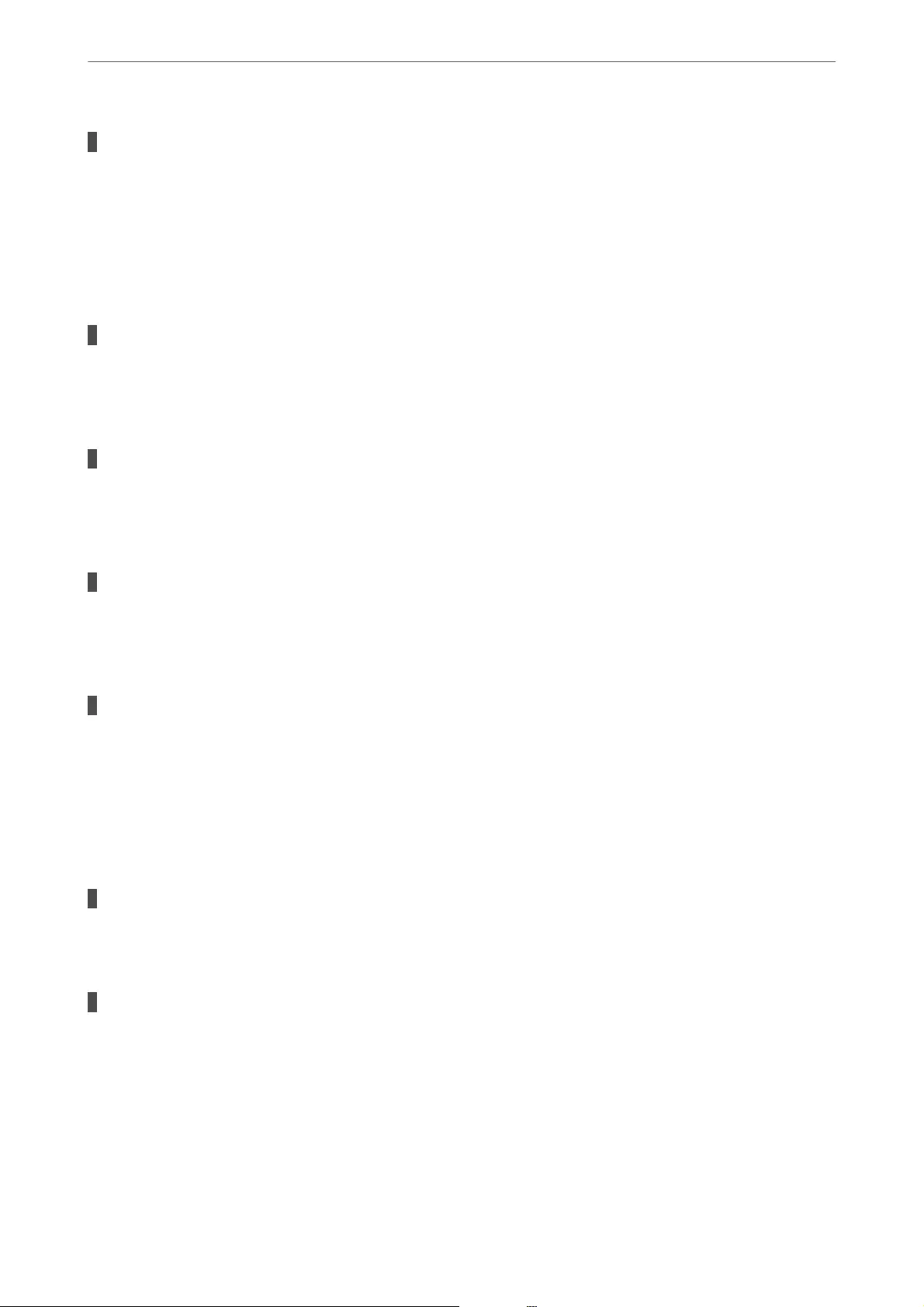
Original is too thin to detect the size automatically.
Solutions
Select the original size manually, and then try again.
Cannot Save Received Faxes to a Memory Device
e following causes can be considered.
The setting for saving received faxes to external memory is disabled.
Solutions
Select Settings > General Settings > Fax Settings > Receive Settings, and then enable Save to Memory
Device in each menu.
A memory device is not connected to the printer.
Solutions
Connect a memory device, in which you have created a folder to save faxes, to the printer. Once the faxes
are saved in the device, they are deleted from the printer's memory.
There is not enough free space in the device.
Solutions
Delete unnecessary data from the device to increase the amount of free space. Or, connect another device
that has enough free space.
The memory device is write protected.
Solutions
Check if the device is write protected.
Received Faxes Are Not Printed
e following causes can be considered.
An error has occurred in the printer such as a paper jam.
Solutions
Clear the printer error, and then ask the sender to resend the fax.
Printing received faxes is disabled under the current settings.
Solutions
Make settings to print received faxes in Settings > General Settings > Fax Settings > Receive Settings >
Save/Forward Settings.
Cannot Send and Receive Faxes (Windows)
Make sure the computer and the printer are connected correctly. e cause and solution to the problem dier
depending on whether or not they are connected.
Solving Problems
>
The Printer Does Not Work as Expected
>
Cannot Send or Receive Faxes
208
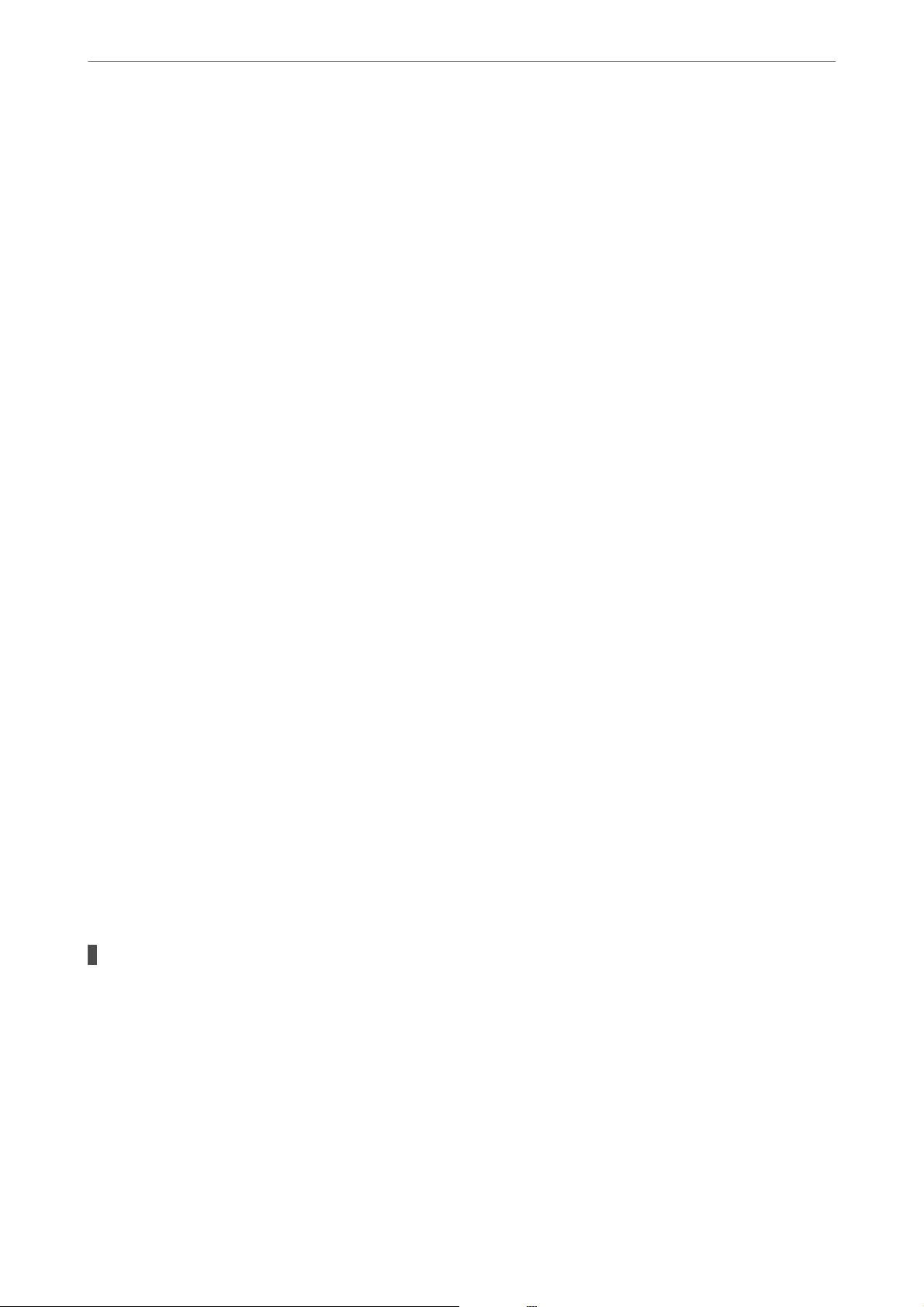
Checking the Connection Status
Use Epson Printer Connection Checker to check the connection status for the computer and the printer. You may
be able to solve the problem depending on the results of the check.
1. Double-click the Epson Printer Connection Checker icon on the desktop.
Epson Printer Connection Checker starts.
If there is no icon on the desktop, follow the methods below to start Epson Printer Connection Checker.
❏Windows 10
Click the start button, and then select Epson Soware > Epson Printer Connection Checker.
❏Windows 8.1/Windows 8
Enter the application name in the search charm, and then select the displayed icon.
❏Windows 7
Click the start button, and then select All Programs > Epson Soware > Epson Printer Connection
Checker.
2. Follow the on-screen instructions to check.
Note:
If the printer name is not displayed, install a genuine Epson printer driver.
“Checking if a genuine Epson printer driver is installed - Windows” on page 158
When you have identied the problem, follow the solution displayed on the screen.
When you cannot solve the problem, check the following according to your situation.
❏e printer is not recognized over a network connection
“Cannot connect to a Network” on page 175
❏e printer is not recognized using a USB connection
“e Printer Cannot Connect by USB (Windows)” on page 178
❏e printer is recognized, but printing cannot be performed.
“Cannot Print Even ough a Connection has been Established (Windows)” on page 178
Cannot connect to a Network
e problem could be one of the following issues.
Something is wrong with the network devices for Wi-Fi connection.
Solutions
Turn o the devices you want to connect to the network. Wait for about 10 seconds, and then turn on the
devices in the following order; wireless router, computer or smart device, and then printer. Move the
Solving Problems
>
The Printer Does Not Work as Expected
>
Cannot Send or Receive Faxes
209
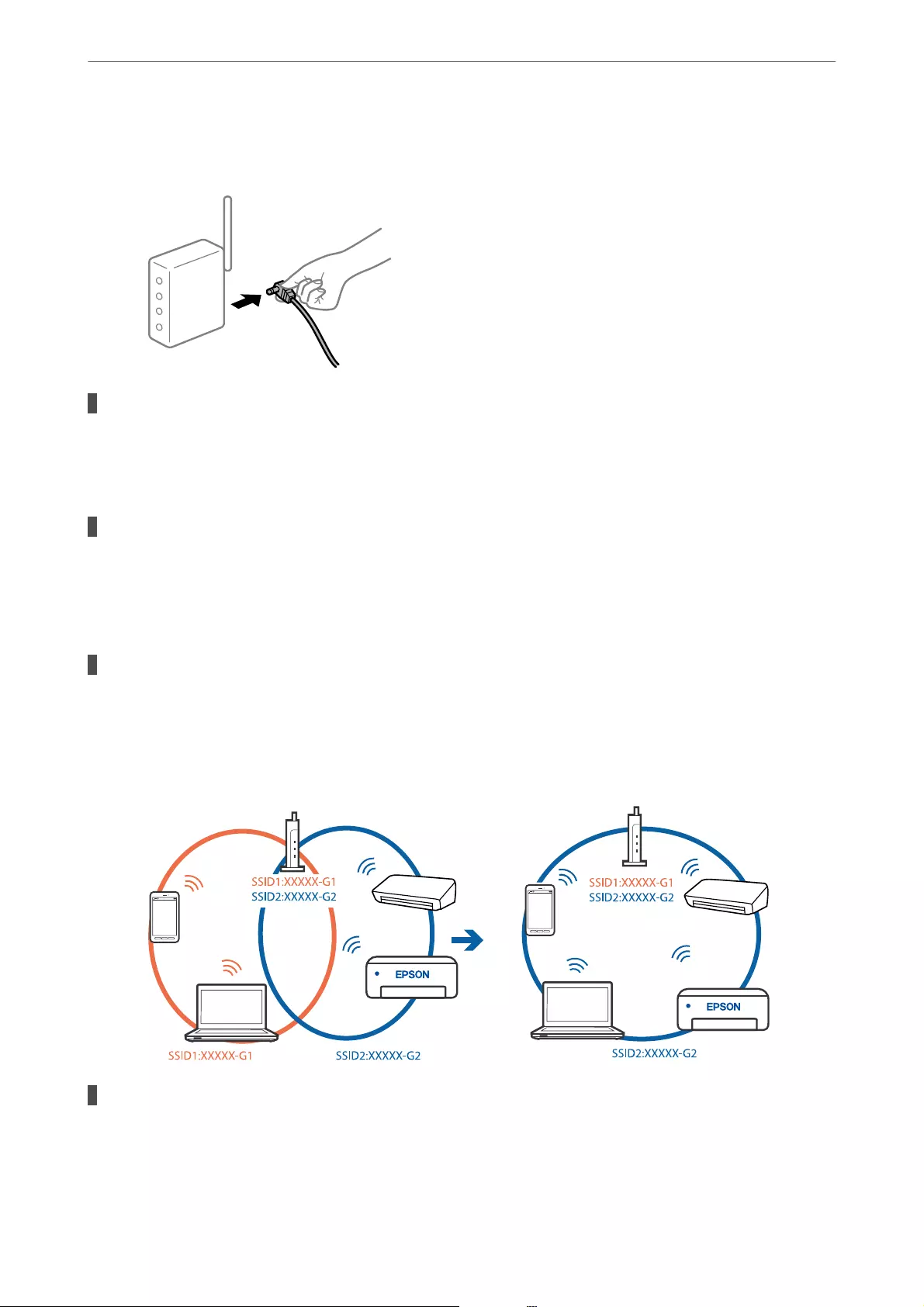
printer and computer or smart device closer to the wireless router to help with radio wave
communication, and then try to make network settings again.
Devices cannot receive signals from the wireless router because they are too far apart.
Solutions
Aer moving the computer or the smart device and the printer closer to the wireless router, turn o the
wireless router, and then turn it back on.
When changing the wireless router, the settings do not match the new router.
Solutions
Make the connection settings again so that they match the new wireless router.
&“When Replacing the Wireless Router” on page 262
The SSIDs connected from the computer or smart device and computer are dierent.
Solutions
When you are using multiple wireless routers at the same time or the wireless router has multiple SSIDs
and devices are connected to dierent SSIDs, you cannot connect to the wireless router.
Connect the computer or smart device to the same SSID as the printer.
A privacy separator on the wireless router is available.
Solutions
Most wireless routers have a privacy separator feature that blocks communication between connected
devices. If you cannot communicate between the printer and the computer or smart device even if they
Solving Problems
>
The Printer Does Not Work as Expected
>
Cannot Send or Receive Faxes
210
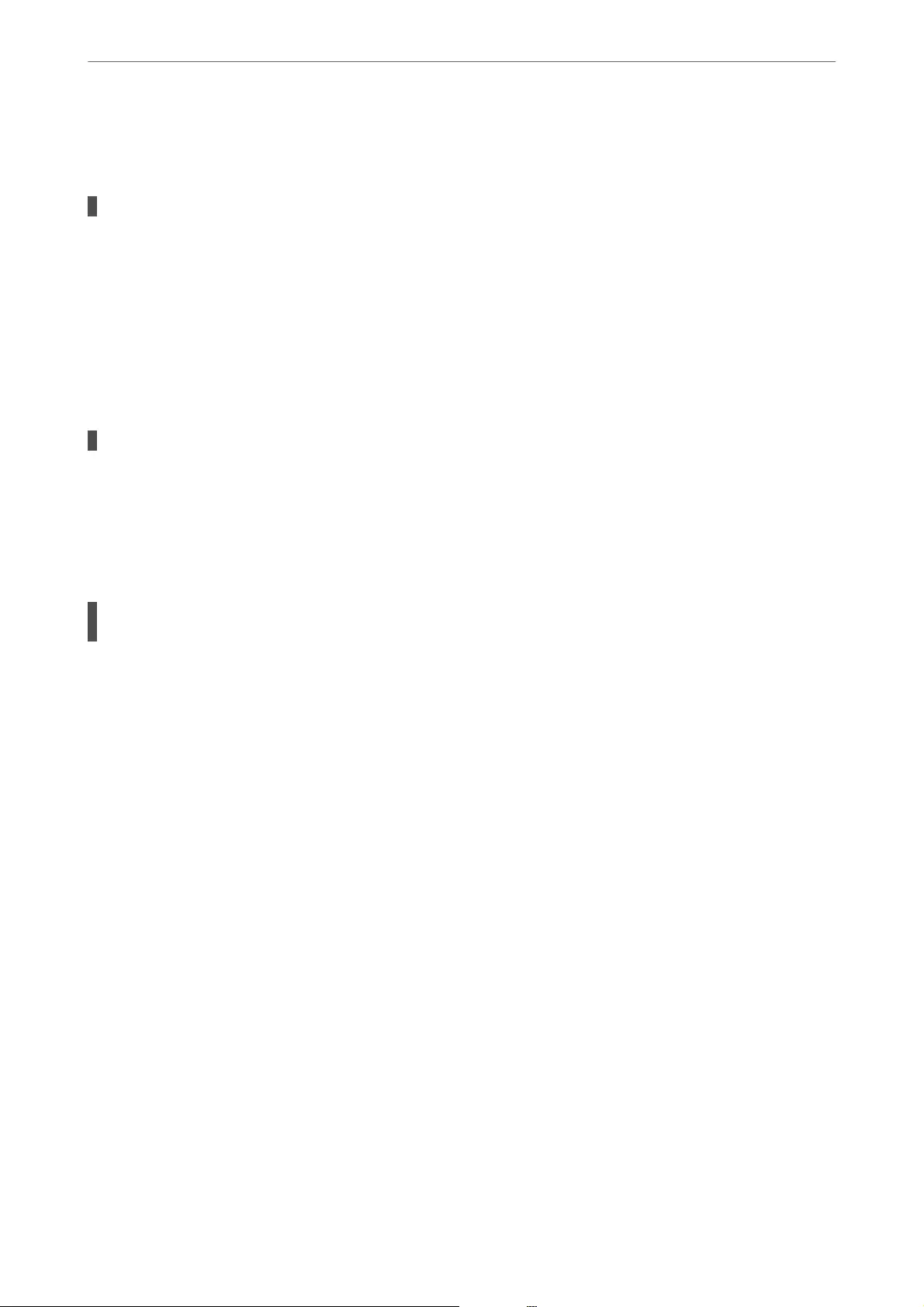
are connected to the same network, disable the privacy separator on the wireless router. See the manual
provided with the wireless router for details.
The IP address is incorrectly assigned.
Solutions
If the IP address assigned to the printer is 169.254.XXX.XXX, and the subnet mask is 255.255.0.0, the IP
address may not be assigned correctly.
Select Settings > General Settings > Network Settings > Advanced on the printer’s control panel, and
then check the IP address and the subnet mask assigned to the printer.
Restart the wireless router or reset the network settings for the printer.
&“Re-setting the Network Connection” on page 262
There is a problem with the network settings on the computer.
Solutions
Try accessing any website from your computer to make sure that your computer's network settings are
correct. If you cannot access any website, there is a problem on the computer.
Check the network connection of the computer. See the documentation provided with the computer for
details.
The printer has been connected by Ethernet using devices that support IEEE802.3az (Energy
Ecient Ethernet).
Solutions
When you connect the printer by Ethernet using devices that support IEEE802.3az (Energy Ecient
Ethernet), the following problems may occur depending on the hub or router that you are using.
❏Connection becomes unstable, the printer is connected and disconnected again and again.
❏Cannot connect to the printer.
❏e communication speed becomes slow.
Follow the steps below to disable IEEE802.3az for the printer and then connect.
1. Remove the Ethernet cable connected to the computer and the printer.
2. When IEEE802.3az for the computer is enabled, disable it.
See the documentation provided with the computer for details.
3. Connect the computer and the printer with an Ethernet cable directly.
4. On the printer, print a network connection report.
“Printing a Network Connection Report” on page 280
5. Check the printer's IP address on the network connection report.
6. On the computer, access Web Cong.
Launch a Web browser, and then enter the printer's IP address.
“Running Web Cong on a Web Browser” on page 301
Solving Problems
>
The Printer Does Not Work as Expected
>
Cannot Send or Receive Faxes
211
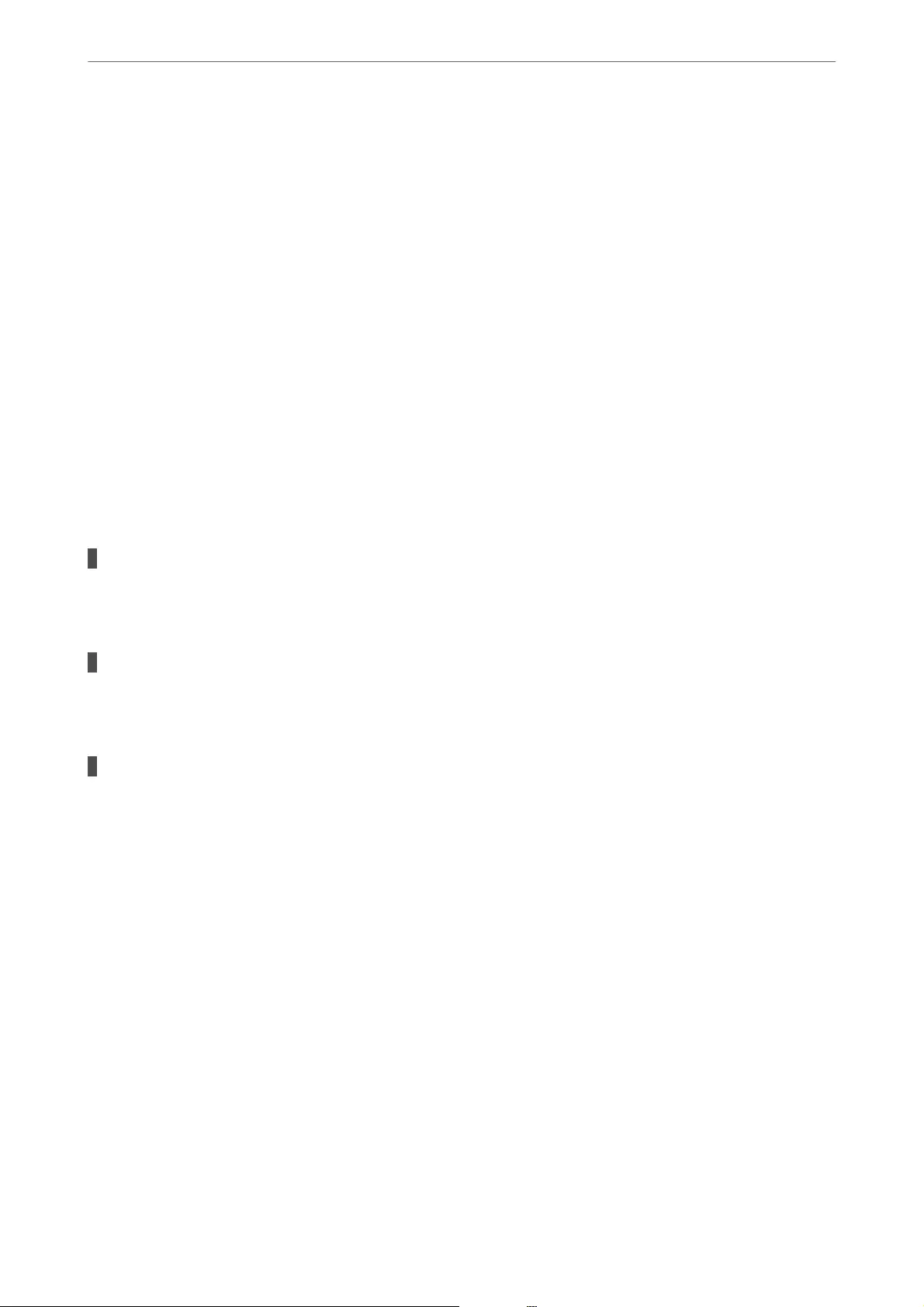
7. Select the Network Settings tab > Wired LAN.
8. Select OFF for IEEE 802.3az.
9. Click Next.
10. Click OK.
11. Remove the Ethernet cable connected to the computer and the printer.
12. If you disabled IEEE802.3az for the computer in step 2, enable it.
13. Connect the Ethernet cables that you removed in step 1 to the computer and the printer.
If the problem still occurs, devices other than the printer may be causing the problem.
The Printer Cannot Connect by USB (Windows)
e following causes can be considered.
The USB cable is not plugged into the electrical outlet correctly.
Solutions
Connect the USB cable securely to the printer and the computer.
There is a problem with the USB hub.
Solutions
If you are using a USB hub, try to connect the printer directly to the computer.
There is a problem with the USB cable or the USB inlet.
Solutions
If the USB cable cannot be recognized, change the port, or change the USB cable.
Solving Problems
>
The Printer Does Not Work as Expected
>
Cannot Send or Receive Faxes
212
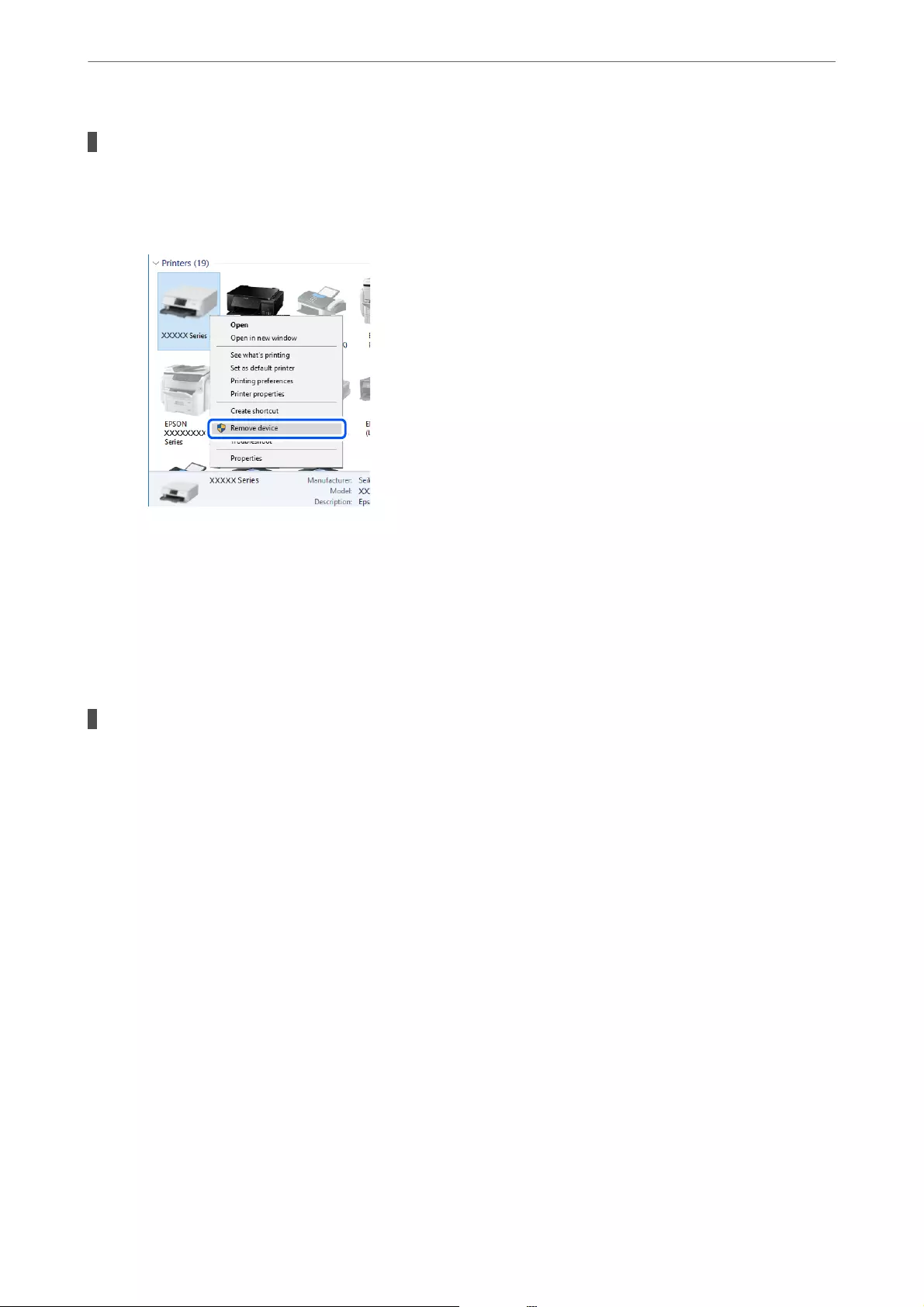
You need to recongure the USB connection.
Solutions
Disconnect the USB cable from the computer. Right-click on the printer icon displayed on the computer,
and then select Remove Device. Next, connect the USB cable to the computer.
If you cannot use a USB cable, reset the USB connection by following the steps for changing the method
of connecting to a computer. See the related information link below for details.
&“Making Settings for Connecting to the Computer” on page 262
Cannot Send or Receive Faxes Even Though a Connection has been Correctly
Established (Windows)
The software is not installed.
Solutions
Make sure that the PC-FAX driver have been installed on the computer. e PC-FAX driver is installed
with FAX Utility. Follow the steps below to check if it is installed.
Make sure the printer (fax) is displayed in Devices and Printers, Printer, or Printers and Other
Hardware. e printer (fax) is displayed as "EPSON XXXXX (FAX)". If the printer (fax) is not displayed,
uninstall and then re-install the FAX Utility. See the following to access Devices and Printers, Printer, or
Printers and Other Hardware.
❏Windows 10
Click on the start button, and then select Windows System > Control Panel > View devices and
printers in Hardware and Sound.
❏Windows 8.1/Windows 8
Select Desktop > Settings > Control Panel > View devices and printers in Hardware and Sound or
Hardware.
❏Windows 7
Click the start button, and select Control Panel > View devices and printers in Hardware and Sound
or Hardware.
❏Windows Vista
Click the start button, and select Control Panel > Printers in Hardware and Sound.
Solving Problems
>
The Printer Does Not Work as Expected
>
Cannot Send or Receive Faxes
213
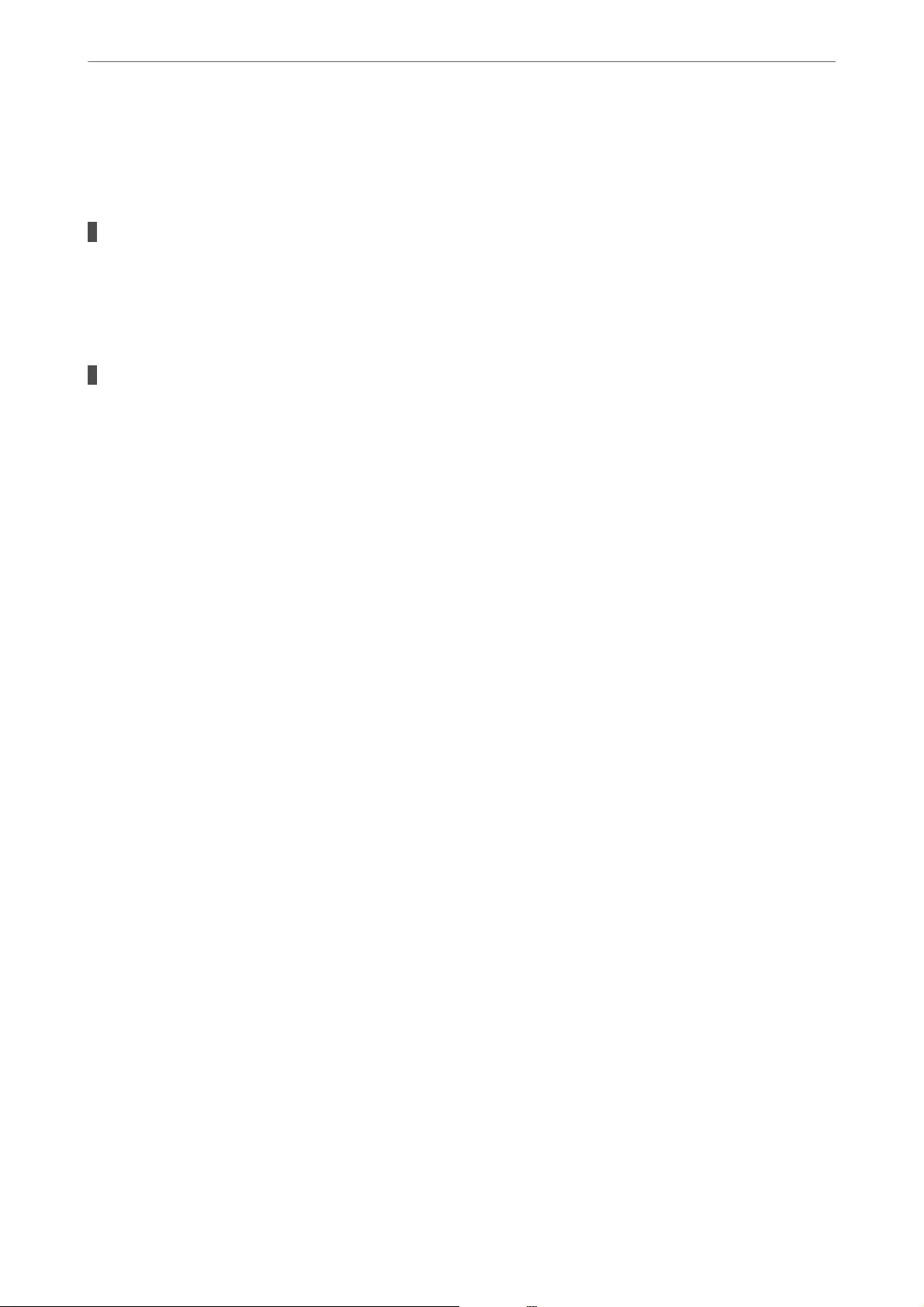
❏Windows XP
Click the start button, and select Settings > Control Panel > Printers and Other Hardware > Printers
and Faxes.
User authentication failed when a fax is sent from a computer.
Solutions
Set the user name and password in the printer driver. When sending a fax from a computer when the
security function that restrict users from using the printer's fax function is set, user authentication is
performed with the user name and password set in the printer driver.
There are some problems with fax connection and fax settings.
Solutions
Try the resolutions for fax connection and fax settings.
Cannot Send and Receive Faxes (Mac OS)
Make sure the computer and the printer are connected correctly. e cause and solution to the problem dier
depending on whether or not they are connected.
Checking the Connection Status
Use EPSON Status Monitor to check the connection status for the computer and the printer.
1. Select System Preferences from the Apple menu > Printers & Scanners (or Print & Scan, Print & Fax), and
then select the printer.
2. Click Options & Supplies > Utility > Open Printer Utility.
3. Click EPSON Status Monitor.
When the remaining ink levels are displayed, a connection has been successfully established between the computer
and the printer.
Check the following if a connection has not been established.
❏e printer is not recognized over a network connection
“Cannot connect to a Network” on page 183
❏e printer is not recognized using a USB connection
“e Printer Cannot Connect by USB (Mac OS)” on page 186
Check the following if a connection has been established.
❏e printer is recognized, but printing cannot be performed.
“Cannot Print Even ough a Connection has been Established (Mac OS)” on page 186
Cannot connect to a Network
e problem could be one of the following issues.
Solving Problems
>
The Printer Does Not Work as Expected
>
Cannot Send or Receive Faxes
214
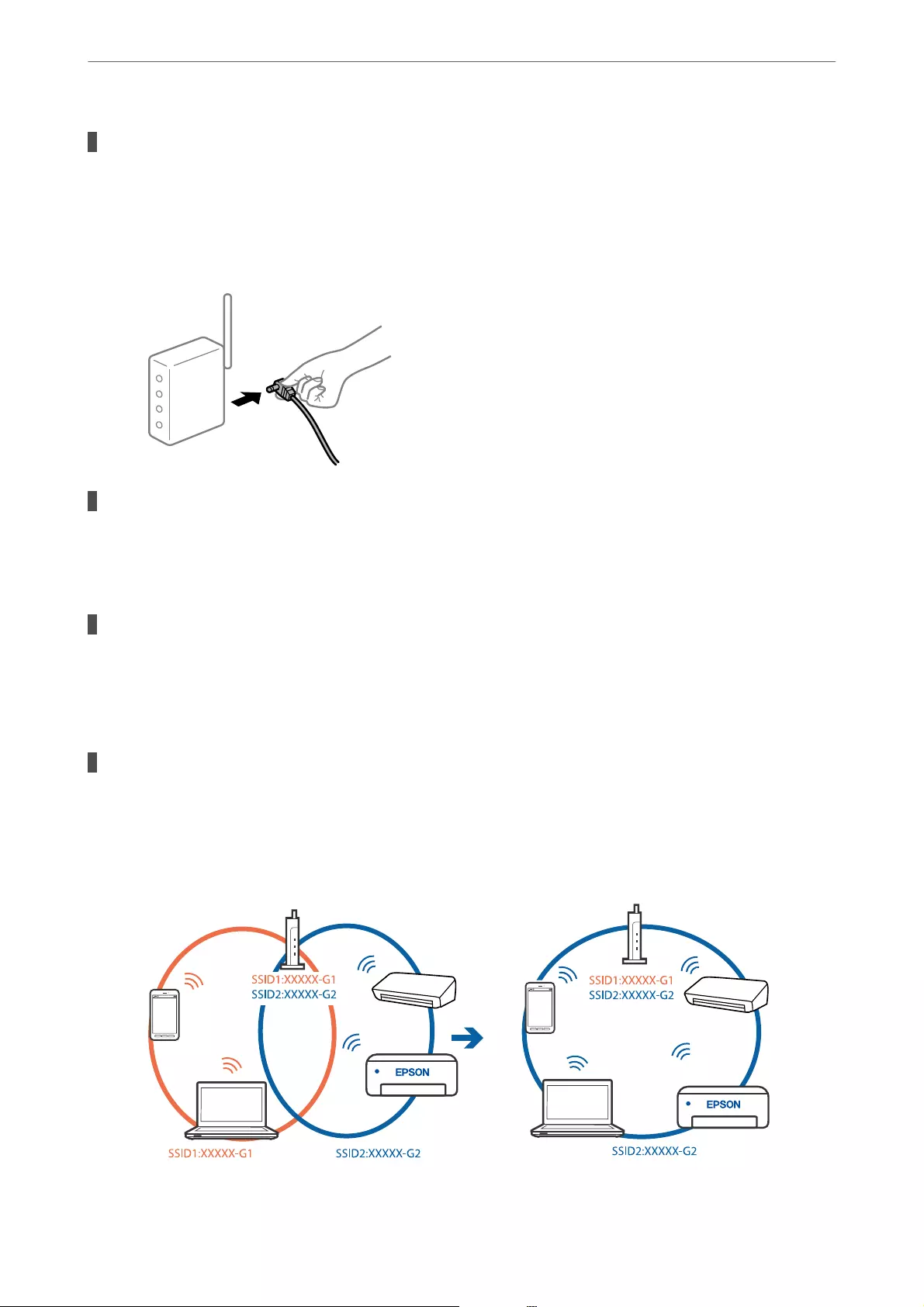
Something is wrong with the network devices for Wi-Fi connection.
Solutions
Turn o the devices you want to connect to the network. Wait for about 10 seconds, and then turn on the
devices in the following order; wireless router, computer or smart device, and then printer. Move the
printer and computer or smart device closer to the wireless router to help with radio wave
communication, and then try to make network settings again.
Devices cannot receive signals from the wireless router because they are too far apart.
Solutions
Aer moving the computer or the smart device and the printer closer to the wireless router, turn o the
wireless router, and then turn it back on.
When changing the wireless router, the settings do not match the new router.
Solutions
Make the connection settings again so that they match the new wireless router.
&“When Replacing the Wireless Router” on page 262
The SSIDs connected from the computer or smart device and computer are dierent.
Solutions
When you are using multiple wireless routers at the same time or the wireless router has multiple SSIDs
and devices are connected to dierent SSIDs, you cannot connect to the wireless router.
Connect the computer or smart device to the same SSID as the printer.
Solving Problems
>
The Printer Does Not Work as Expected
>
Cannot Send or Receive Faxes
215
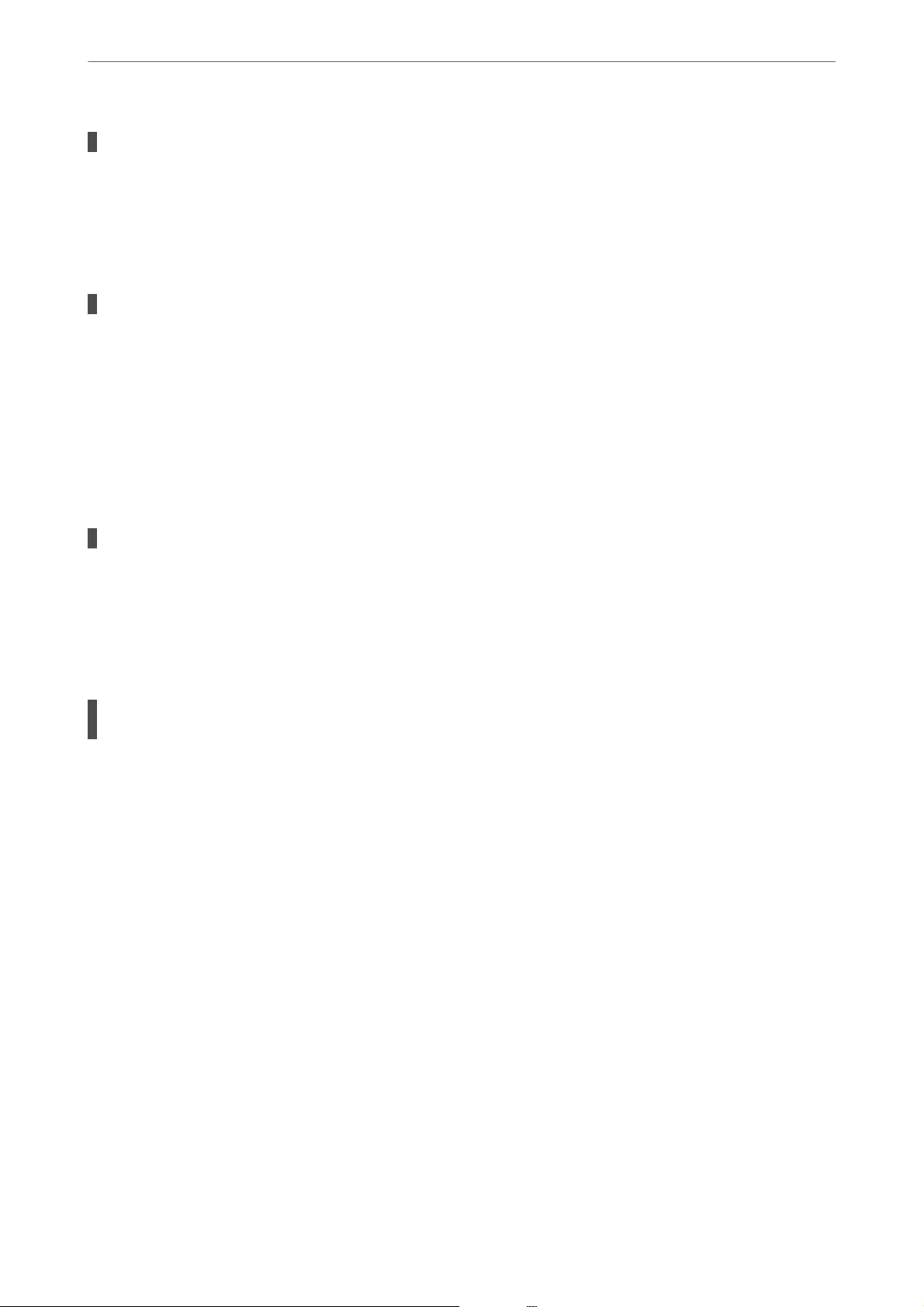
A privacy separator on the wireless router is available.
Solutions
Most wireless routers have a privacy separator feature that blocks communication between connected
devices. If you cannot communicate between the printer and the computer or smart device even if they
are connected to the same network, disable the privacy separator on the wireless router. See the manual
provided with the wireless router for details.
The IP address is incorrectly assigned.
Solutions
If the IP address assigned to the printer is 169.254.XXX.XXX, and the subnet mask is 255.255.0.0, the IP
address may not be assigned correctly.
Select Settings > General Settings > Network Settings > Advanced on the printer’s control panel, and
then check the IP address and the subnet mask assigned to the printer.
Restart the wireless router or reset the network settings for the printer.
&“Re-setting the Network Connection” on page 262
There is a problem with the network settings on the computer.
Solutions
Try accessing any website from your computer to make sure that your computer's network settings are
correct. If you cannot access any website, there is a problem on the computer.
Check the network connection of the computer. See the documentation provided with the computer for
details.
The printer has been connected by Ethernet using devices that support IEEE802.3az (Energy
Ecient Ethernet).
Solutions
When you connect the printer by Ethernet using devices that support IEEE802.3az (Energy Ecient
Ethernet), the following problems may occur depending on the hub or router that you are using.
❏Connection becomes unstable, the printer is connected and disconnected again and again.
❏Cannot connect to the printer.
❏e communication speed becomes slow.
Follow the steps below to disable IEEE802.3az for the printer and then connect.
1. Remove the Ethernet cable connected to the computer and the printer.
2. When IEEE802.3az for the computer is enabled, disable it.
See the documentation provided with the computer for details.
3. Connect the computer and the printer with an Ethernet cable directly.
4. On the printer, print a network connection report.
“Printing a Network Connection Report” on page 280
5. Check the printer's IP address on the network connection report.
Solving Problems
>
The Printer Does Not Work as Expected
>
Cannot Send or Receive Faxes
216
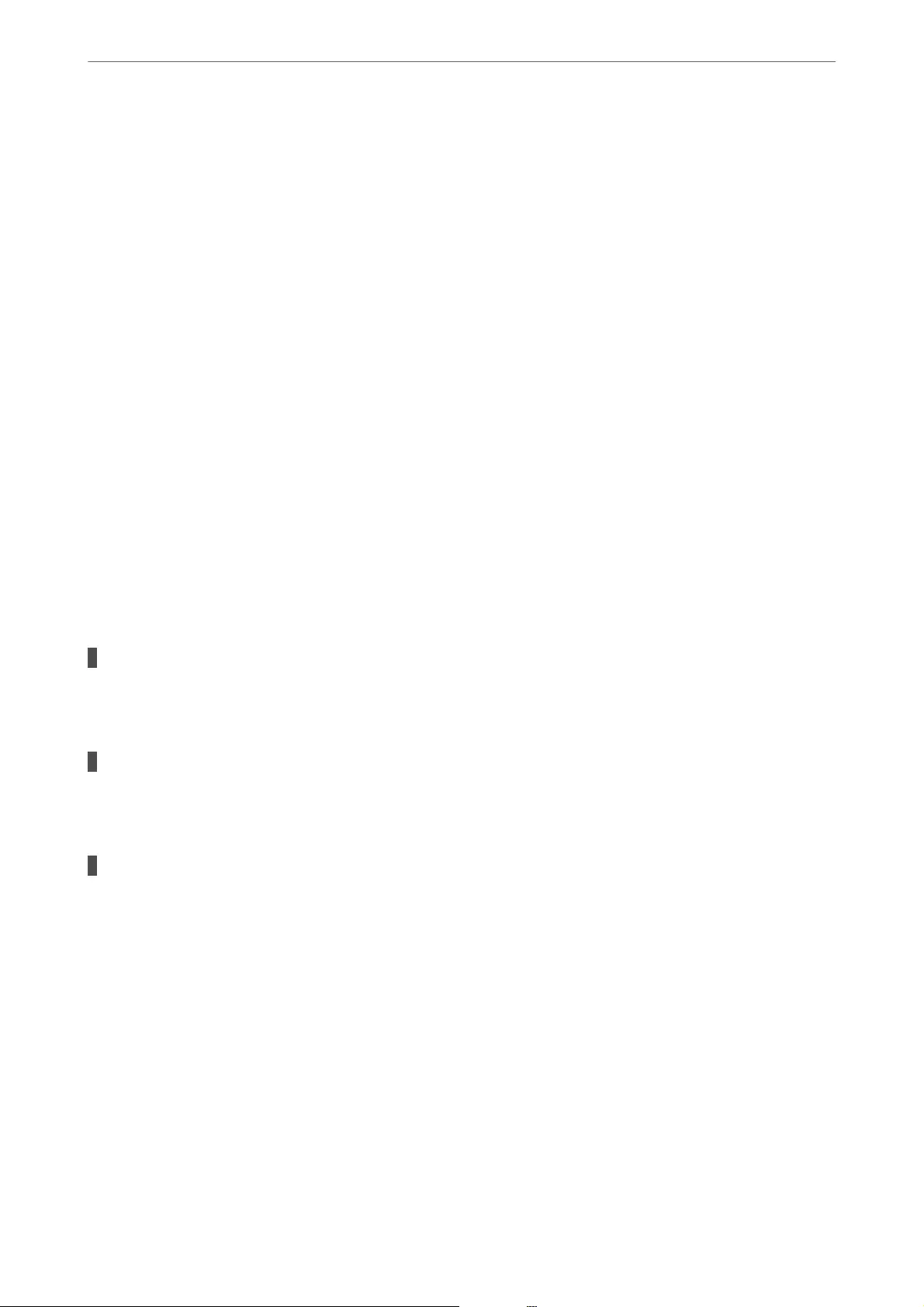
6. On the computer, access Web Cong.
Launch a Web browser, and then enter the printer's IP address.
“Running Web Cong on a Web Browser” on page 301
7. Select the Network Settings tab > Wired LAN.
8. Select OFF for IEEE 802.3az.
9. Click Next.
10. Click OK.
11. Remove the Ethernet cable connected to the computer and the printer.
12. If you disabled IEEE802.3az for the computer in step 2, enable it.
13. Connect the Ethernet cables that you removed in step 1 to the computer and the printer.
If the problem still occurs, devices other than the printer may be causing the problem.
The Printer Cannot Connect by USB (Mac OS)
e following causes can be considered.
The USB cable is not plugged into the electrical outlet correctly.
Solutions
Connect the USB cable securely to the printer and the computer.
There is a problem with the USB hub.
Solutions
If you are using a USB hub, try to connect the printer directly to the computer.
There is a problem with the USB cable or the USB inlet.
Solutions
If the USB cable cannot be recognized, change the port, or change the USB cable.
Solving Problems
>
The Printer Does Not Work as Expected
>
Cannot Send or Receive Faxes
217
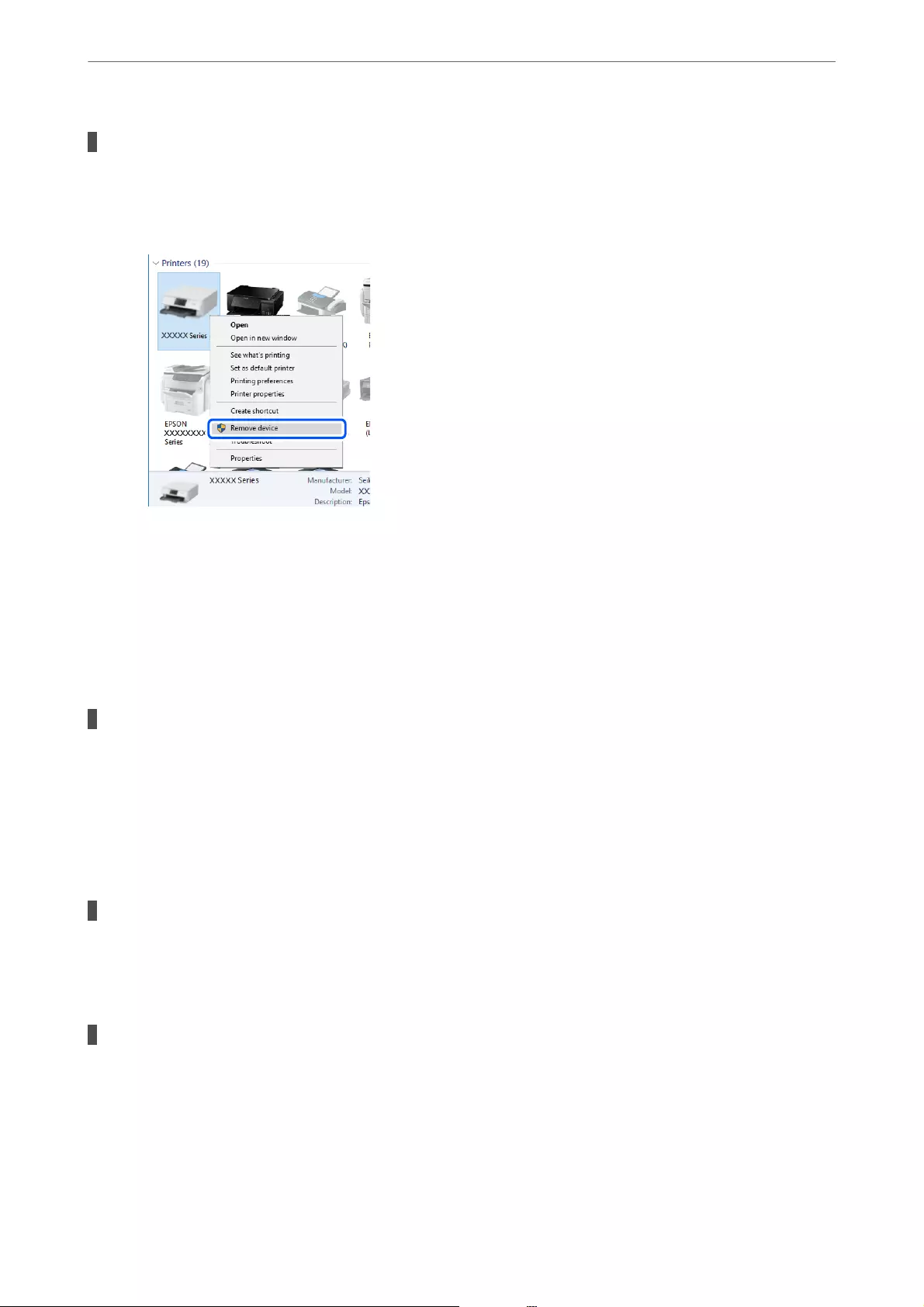
You need to recongure the USB connection.
Solutions
Disconnect the USB cable from the computer. Right-click on the printer icon displayed on the computer,
and then select Remove Device. Next, connect the USB cable to the computer.
If you cannot use a USB cable, reset the USB connection by following the steps for changing the method
of connecting to a computer. See the related information link below for details.
&“Making Settings for Connecting to the Computer” on page 262
Cannot Send or Receive Even Though a Connection has been Correctly Established
(Mac OS)
The software is not installed.
Solutions
Make sure that the PC-FAX driver have been installed on the computer. e PC-FAX driver is installed
with FAX Utility. Follow the steps below to check if it is installed.
Select System Preferences from the Apple menu > Printers & Scanners (or Print & Scan, Print & Fax),
and then make sure the printer (fax) is displayed. e printer (fax) is displayed as "FAX XXXX (USB)" or
"FAX XXXX (IP)". If the printer (fax) is not displayed, click [+] and then register the printer (fax).
PC-FAX driver is paused.
Solutions
Select System Preferences from the Apple menu > Printers & Scanners (or Print & Scan, Print & Fax),
and then double-click the printer (fax). If the printer is paused, click Resume (or Resume Printer).
User authentication failed when a fax is sent from a computer.
Solutions
Set the user name and password in the printer driver. When sending a fax from a computer when the
security function that restrict users from using the printer's fax function is set, user authentication is
performed with the user name and password set in the printer driver.
Solving Problems
>
The Printer Does Not Work as Expected
>
Cannot Send or Receive Faxes
218
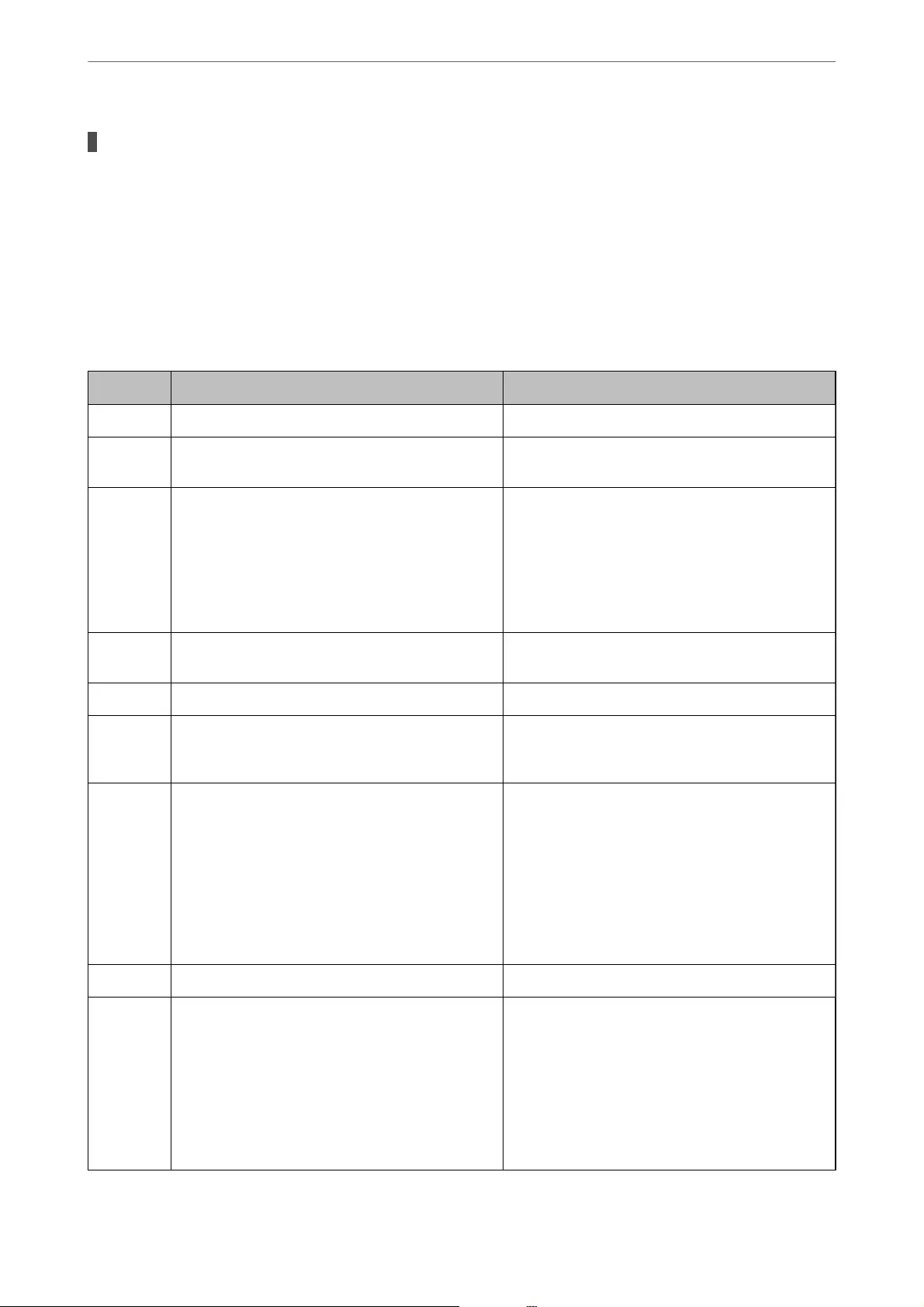
There are some problems with fax connection and fax settings.
Solutions
Try the resolutions for fax connection and fax settings.
Error Code is Displayed on the Status Menu
If a job does not complete successfully, check the error code displayed on the history of each job. You can check the
error code by selecting Job/Status, and then selecting Job Status. See the following table to nd the problem and
its solution.
Code Problem Solution
001 The product was turned o by a power failure. -
106 Cannot print from the computer due to the access
control settings.
Contact your printer administrator.
107 User authentication failed. The job has been
canceled.
❏Make sure that the user name and password are
correct.
❏Select Settings > General Settings > System
Administration > Security Settings > Access
Control. Enable the user restriction function, and
then allow the job without an authentication
information.
108 Condential job data was deleted when the printer
was turned o.
-
109 The received fax was already deleted. -
110 The job was printed on one side only because the
paper loaded does not support double sided
printing.
If you want to perform 2-sided printing, load paper
that supports 2-sided printing.
201 The memory is full. ❏Print received faxes from Job Status in Job/
Status .
❏Delete received faxes saved in the inbox from Job
Status in Job/Status.
❏If you are sending a monochrome fax to a single
destination, you can send it by using Direct Send.
❏Divide your originals in two or more to send them
in several batches.
202 The line was disconnected by the recipient machine. Wait for a while and then try again.
203 The product cannot detect the dial tone. ❏Make sure that the phone cable is connected
correctly and the phone line is working.
❏When the printer is connected to the PBX or the
terminal adapter, change the Line Type setting to
PBX.
❏Select Settings > General Settings > Fax
Settings > Basic Settings > Dial Tone
Detection, and then disable the dial tone setting.
Solving Problems
>
The Printer Does Not Work as Expected
>
Error Code is Displayed on the Status Menu
219
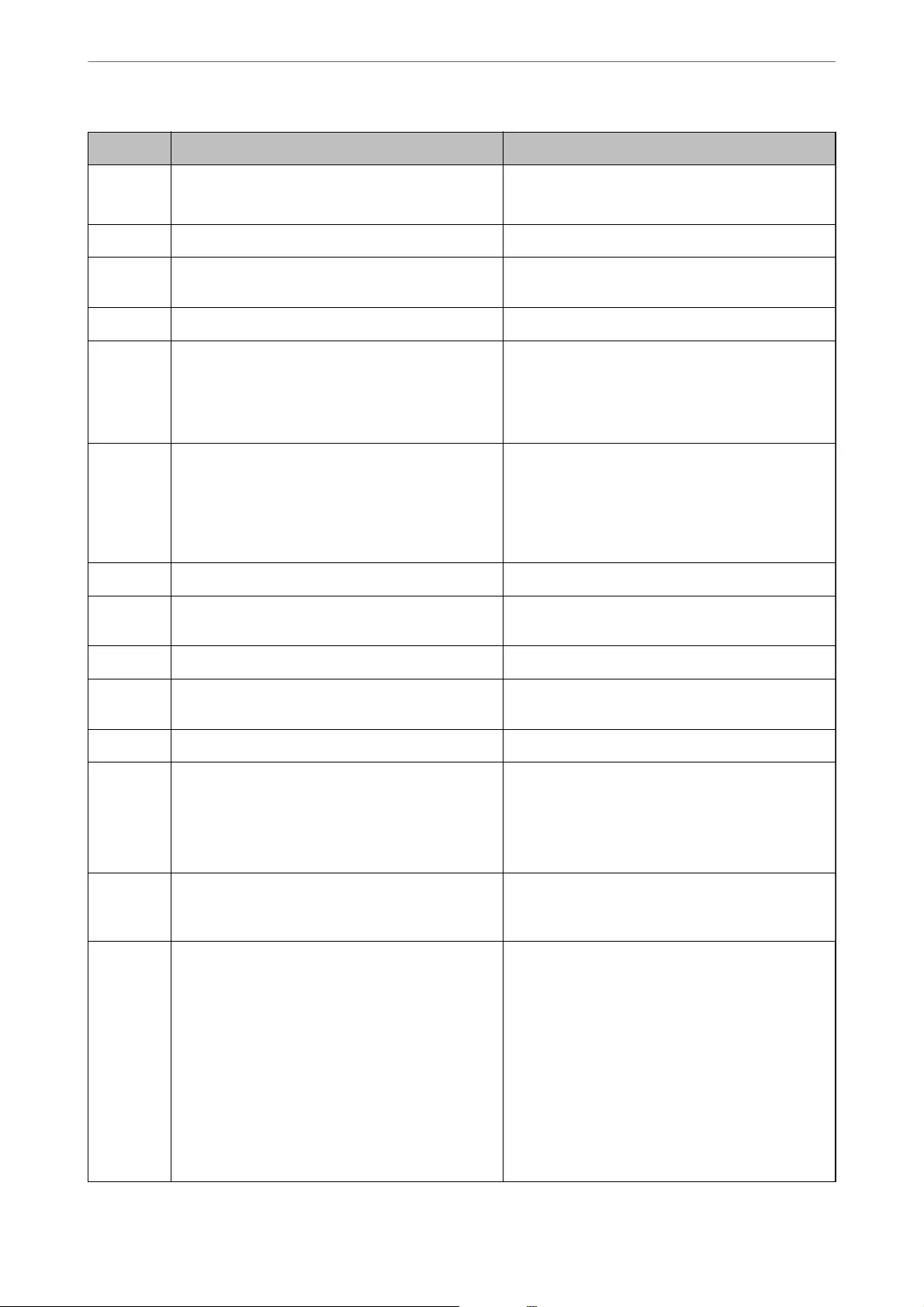
Code Problem Solution
204 The recipient machine is busy. ❏Wait for a while and then try again.
❏Check the recipient's fax number.
205 The recipient machine does not answer. Wait for a while and then try again.
206 The phone cable is incorrectly connected to the LINE
and EXT. port of the product.
Check the connection of the LINE port and the EXT.
port of the printer.
207 The product is not connected to the phone line. Connect the phone cable to the phone line.
208 The fax could not be sent to some of the specied
recipients.
Print a Fax Log or Last Transmission report for
previous faxes from Fax Report in the Fax mode to
check the failed destination. When the Save Failure
Data setting is enabled, you can resend a fax from
Job Status in Job/Status.
301 There is not enough storage space available to save
the data in the memory device.
❏Increase the storage space in the memory device.
❏Reduce the number of documents.
❏Lower the scanning resolution or increase the
compression ratio to reduce the size of the
scanned image.
302 The memory device is write-protected. Disable write protection on the memory device.
303 No folder has been created to save the scanned
image.
Insert another memory device.
304 The memory device has been removed. Reinsert the memory device.
305 An error occurred while saving the data to the
memory device.
If the external device is accessed from a computer,
wait for a while and then try again.
306 The memory is full. Wait until other ongoing jobs are nished.
311 A DNS error has occurred. ❏Select Settings > General Settings > Network
Settings > Advanced > TCP/IP, and then check
the DNS settings.
❏Check the DNS settings for the server, the
computer, or the access point.
312 An authentication error has occurred. Select Settings > General Settings > Network
Settings > Advanced > Email Server > Server
Settings, and then check the server settings.
313 A communication error has occurred. ❏Print a network connection report to check if the
printer is connected to the network.
❏Select Settings > General Settings > Network
Settings > Advanced > Email Server > Server
Settings to check the email server settings. You
can check the cause of the error by running
connection check.
❏The authentication method of the settings and
the email server may not match. When you select
O as the authentication method, make sure the
authentication method of the email server is set
to None.
Solving Problems
>
The Printer Does Not Work as Expected
>
Error Code is Displayed on the Status Menu
220
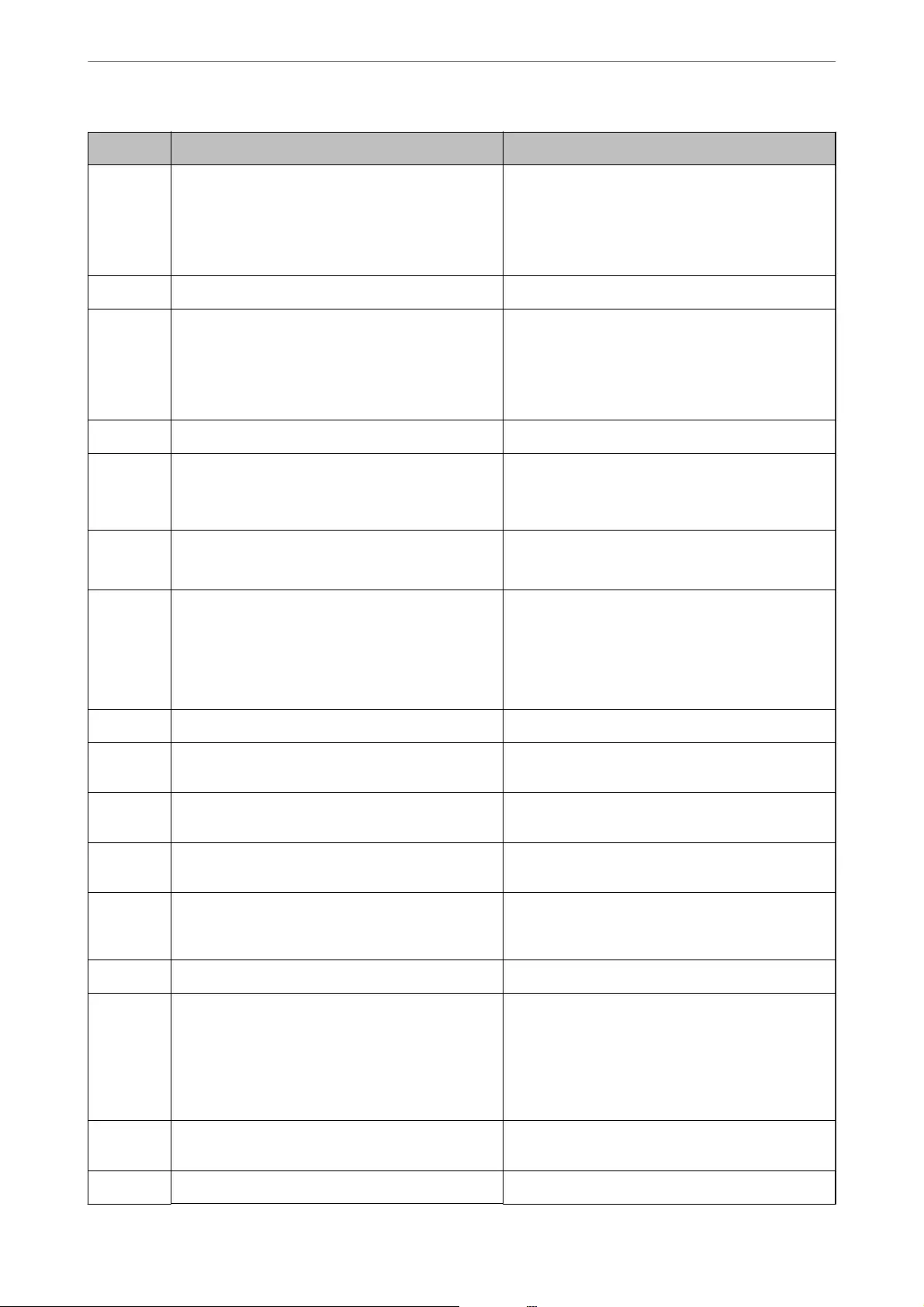
Code Problem Solution
314 The data size exceeds the maximum size for attached
les.
❏Increase the Attached File Max Size setting in
the scan settings.
❏Lower the scanning resolution or increase the
compression ratio to reduce the size of the
scanned image.
315 The memory is full. Retry after other ongoing jobs are nished.
321 A DNS error has occurred. ❏Select Settings > General Settings > Network
Settings > Advanced > TCP/IP, and then check
the DNS settings.
❏Check the DNS settings for the server, the
computer, or the access point.
322 An authentication error has occurred. Check the Location settings.
323 A communication error has occurred. ❏Check the Location settings.
❏Print a network connection report to check if the
printer is connected to the network.
324 A le with the same name already exists in the
specied folder.
❏Delete the le with the same name.
❏Change the le name prex in File Settings.
325
326
There is not enough storage space available in the
specied folder.
❏Increase the storage space in the specied folder.
❏Reduce the number of documents.
❏Lower the scanning resolution or increase the
compression ratio to reduce the size of the
scanned image.
327 The memory is full. Wait until other ongoing jobs are nished.
328 The destination was wrong or the destination does
not exist.
Check the Location settings.
331 A communication error occurred while acquiring the
destination list.
Print a network connection report to check if the
printer is connected to the network.
332 There is not enough storage space available to save
the scanned image in the destination storage.
Reduce the number of documents.
333 The destination could not be found because the
destination information was uploaded to the server
before sending the scanned image.
Select the destination again.
334 An error occurred while sending the scanned image. -
341 A communication error has occurred. ❏Check the connections for the printer and the
computer. If you are connecting over a network,
print a network connection report to check if the
printer is connected to the network.
❏Make sure that Epson Event Manager is installed
on the computer.
401 There is not enough storage space available to save
the data in the memory device.
Increase the storage space in the memory device.
402 The memory device is write-protected. Disable write protection on the memory device.
Solving Problems
>
The Printer Does Not Work as Expected
>
Error Code is Displayed on the Status Menu
221
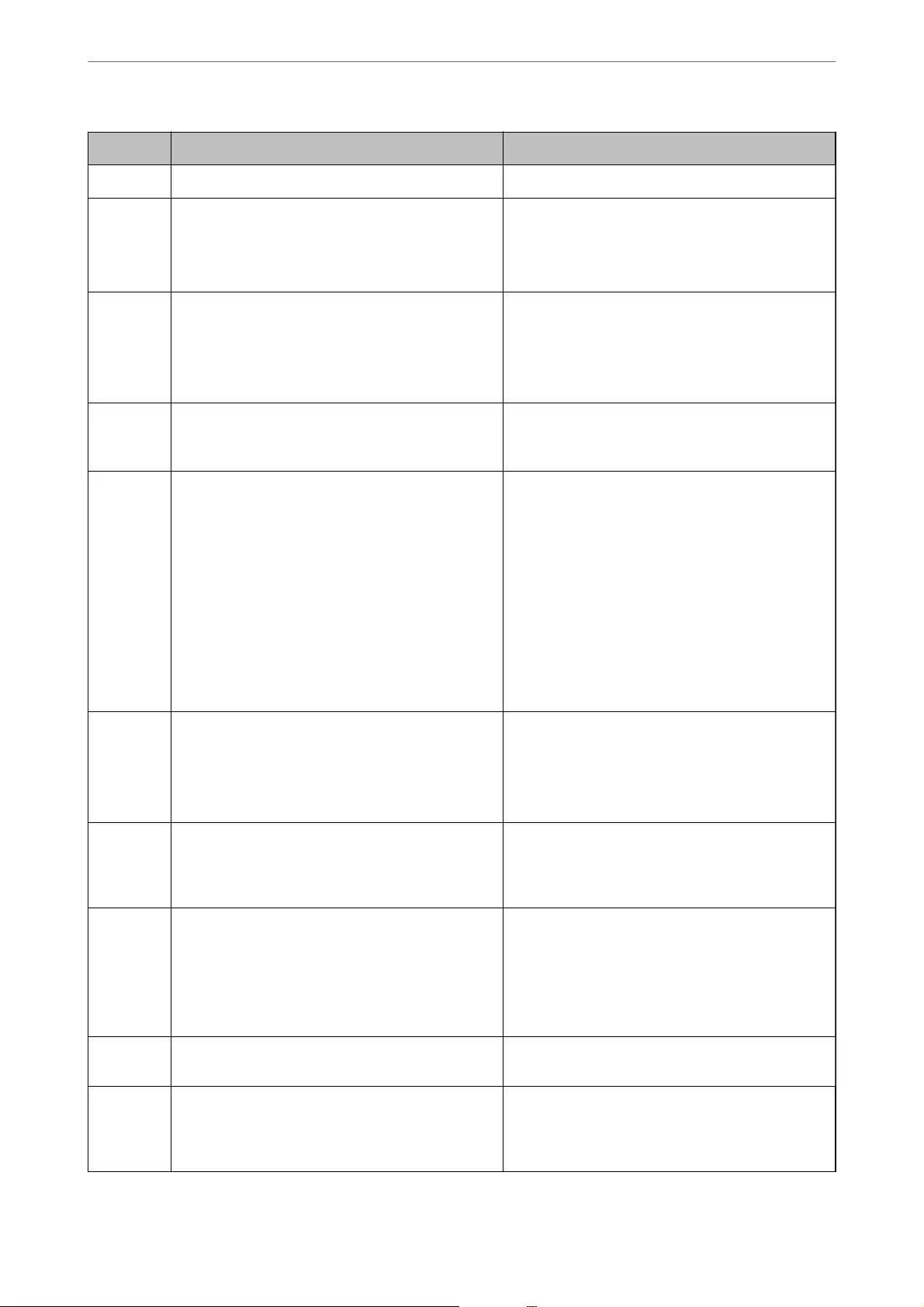
Code Problem Solution
404 The memory device has been removed. Reinsert the memory device.
405 An error occurred while saving the data to the
memory device.
❏Reinsert the memory device.
❏Use a dierent memory device on which you have
created a folder using the Create a folder to save
fax data function.
411 A DNS error has occurred. ❏Select Settings > General Settings > Network
Settings > Advanced > TCP/IP, and then check
the DNS settings.
❏Check the DNS settings for the server, the
computer, or the access point.
412 An authentication error has occurred. Select Settings > General Settings > Network
Settings > Advanced > Email Server > Server
Settings, and then check the server settings.
413 A communication error has occurred. ❏Select Settings > General Settings > Network
Settings > Advanced > Email Server > Server
Settings to check the email server settings. You
can check the cause of the error by running
connection check.
❏The authentication method of the settings and
the email server may not match. When you select
O as the authentication method, make sure the
authentication method of the email server is set
to None.
❏Print a network connection report to check if the
printer is connected to the network.
421 A DNS error has occurred. ❏Select Settings > General Settings > Network
Settings > Advanced > TCP/IP, and then check
the DNS settings.
❏Check the DNS settings for the server, the
computer, or the access point.
422 An authentication error has occurred. Select Settings > General Settings > Fax Settings >
Receive Settings > Save/Forward Settings, and
then check the settings of the folder selected in
Save/Forward Destination.
423 A communication error has occurred. ❏Print a network connection report to check if the
printer is connected to the network.
❏Select Settings > General Settings > Fax
Settings > Receive Settings > Save/Forward
Settings, and then check the settings of the
folder selected in Save/Forward Destination.
425 There is not enough storage space available in the
forwarding destination folder.
Increase the storage space in the forwarding
destination folder.
428 The destination was wrong or the destination does
not exist.
Select Settings > General Settings > Fax Settings >
Receive Settings > Save/Forward Settings, and
then check the settings of the folder selected in
Save/Forward Destination.
Solving Problems
>
The Printer Does Not Work as Expected
>
Error Code is Displayed on the Status Menu
222
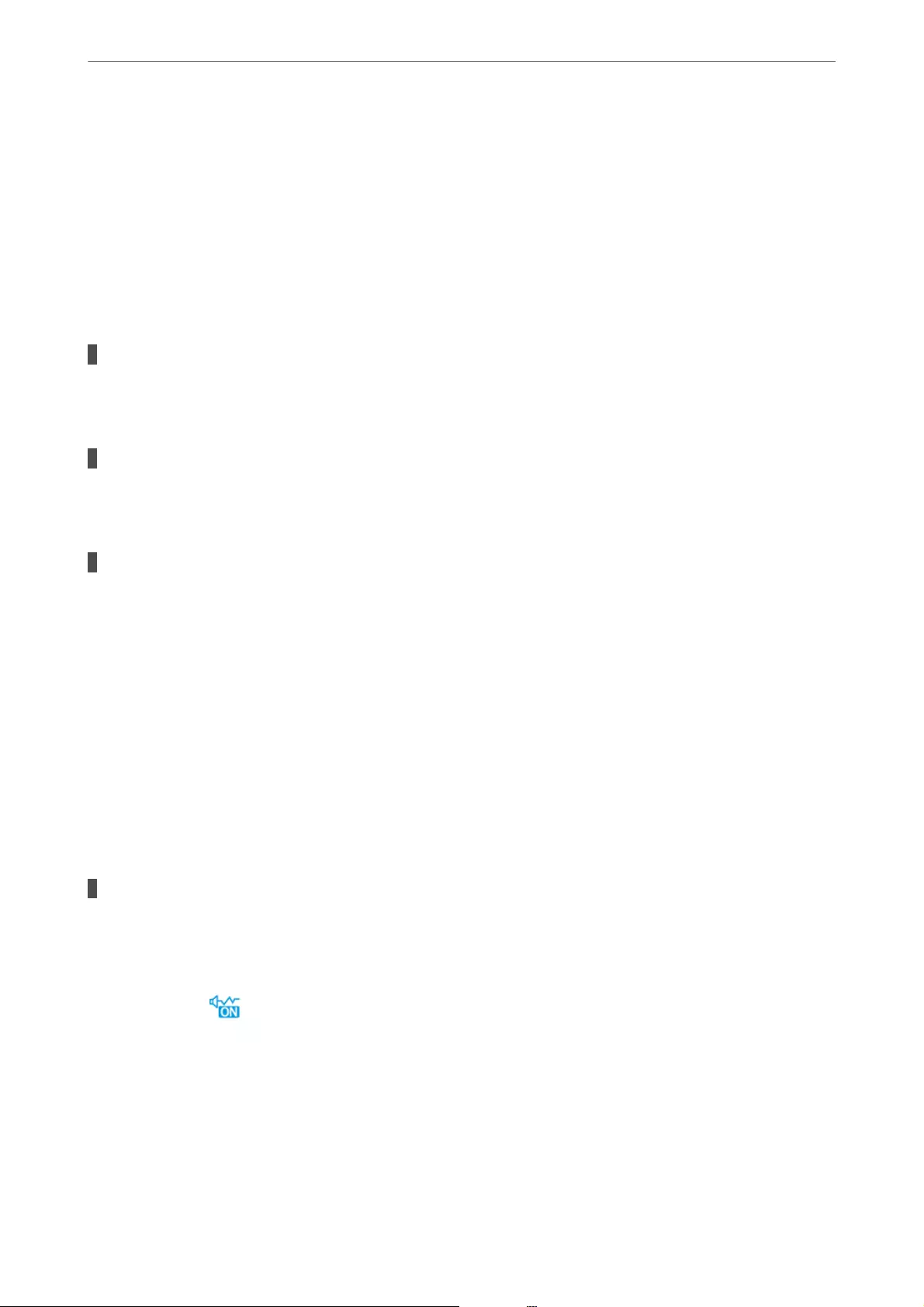
Cannot Operate the Printer as Expected
Operations are Slow
Printing Is Too Slow
e following causes can be considered.
Unnecessary applications are running.
Solutions
Close any unnecessary applications on your computer or smart device.
The print quality is set to high.
Solutions
Lower the quality setting.
Bidirectional printing is disabled.
Solutions
Enable the bidirectional (or high speed) setting. When this setting is enabled, the print head prints while
moving in both directions, and the printing speed increases.
❏Control panel
Select Settings > General Settings > Printer Settings, and then enable Bidirectional.
❏Windows
Select Bidirectional Printing on the printer driver's More Options tab.
❏Mac OS
Select System Preferences from the Apple menu > Printers & Scanners (or Print & Scan, Print
&Fax), and then select the printer. Click Options & Supplies > Options (or Driver). Select On as the
Bidirectional Printing setting.
Quiet Mode is enabled.
Solutions
Disable Quiet Mode. e printing speed slows down when the printer is running in Quiet Mode.
❏Control panel
Select on the home screen, and then select O.
❏Windows
Select O as the Quiet Mode setting on the printer driver's Main tab.
❏Mac OS
Select System Preferences from the Apple menu > Printers & Scanners (or Print & Scan, Print &
Fax), and then select the printer. Click Options & Supplies > Options (or Driver). Select O as the
Quiet Mode setting.
Solving Problems
>
The Printer Does Not Work as Expected
>
Cannot Operate the Printer as Expected
223
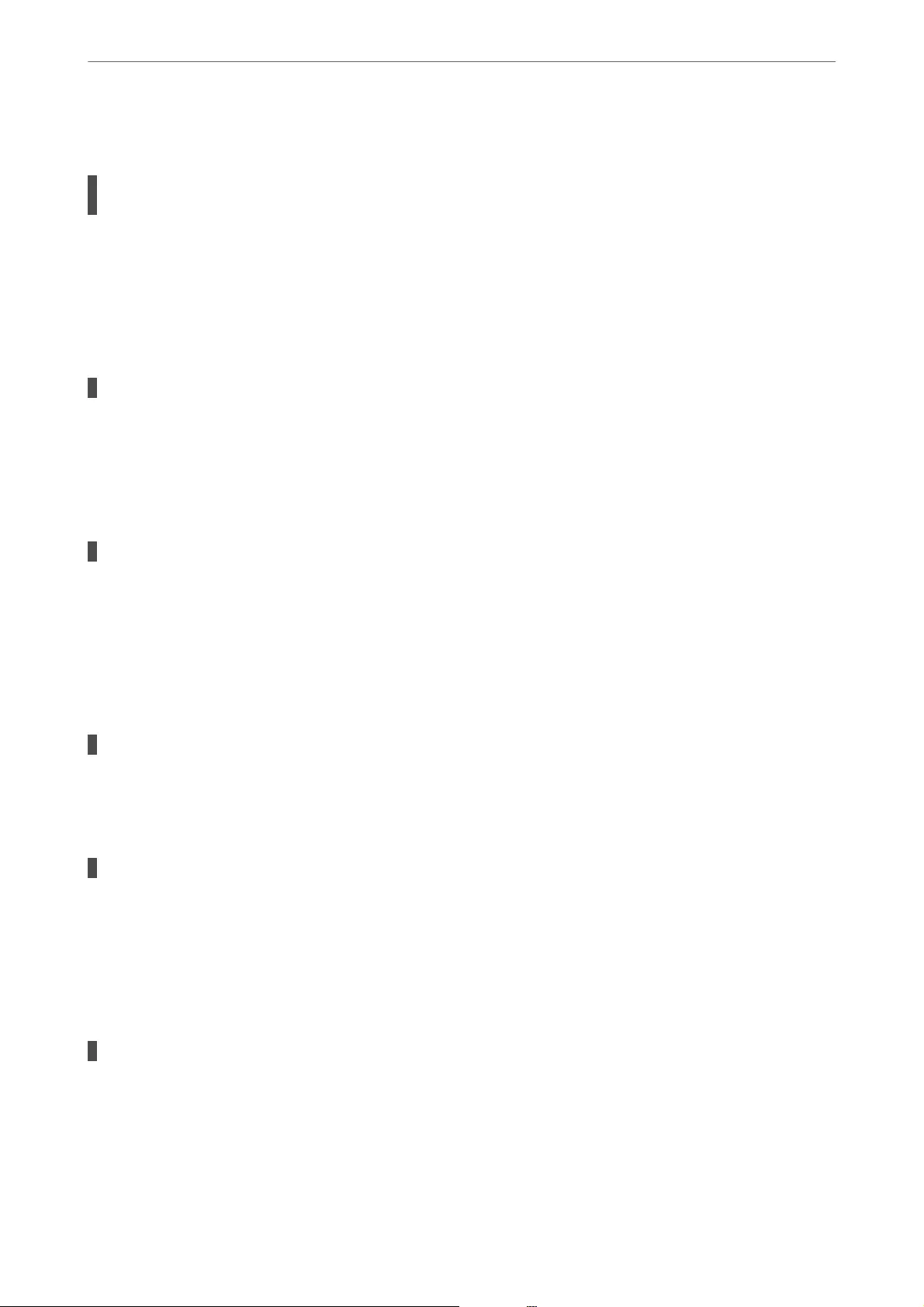
Printing Slows Down Dramatically During Continuous Printing
The function that prevents the printer mechanism from overheating and being damaged is
operating.
Solutions
You can continue printing. To return to normal printing speed, leave the printer idle for at least 30
minutes. Printing speed does not return to normal if the power is o.
Scanning Speed Is Slow
Scanning at a high resolution.
Solutions
Try scanning at a lower resolution.
LCD Screen Gets Dark
The printer is in sleep mode.
Solutions
Tap anywhere on the LCD screen to return it to its former state.
Touch Screen Does Not Respond
e following causes can be considered.
A protective sheet has been stuck on the touch screen.
Solutions
If you stick a protective sheet on the touch screen, the optical touch screen may not respond. Remove the
sheet.
The screen is smeared.
Solutions
Turn o the printer, and then wipe the screen using a so, dry cloth. If the screen is smeared, it may not
respond.
Cannot Operate from the Control Panel
When the user feature restriction is enabled, a user ID and password are required to print.
Solutions
If you do not know the password, contact your printer administrator.
Solving Problems
>
The Printer Does Not Work as Expected
>
Cannot Operate the Printer as Expected
224
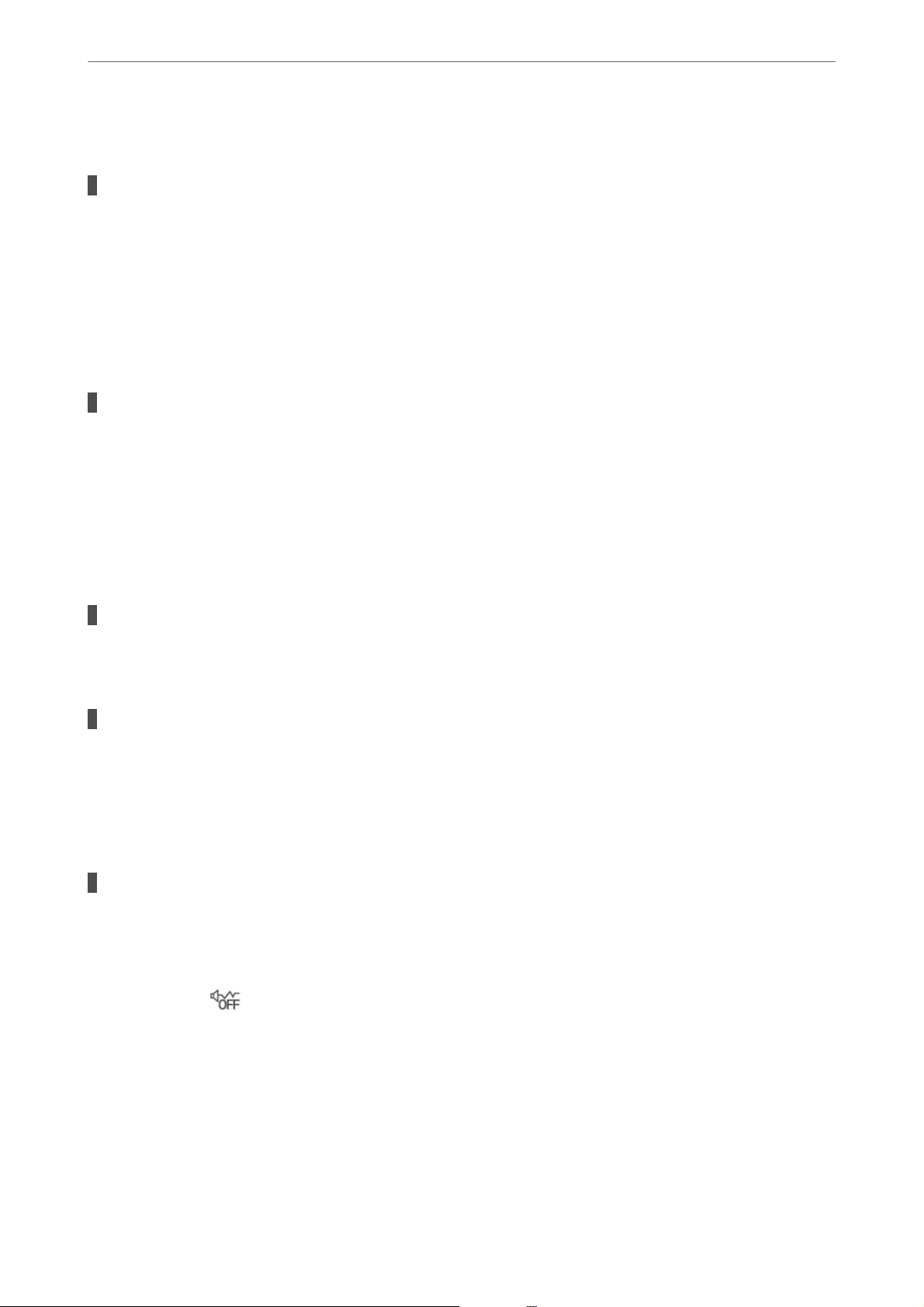
"x" is Displayed on the Screen and you Cannot Select Photos
The image le is not supported.
Solutions
"x" is displayed on the LCD screen when the image le is not supported by the product. Use les
supported by the product.
&“Supported Data Specications” on page 336
Memory Device Is not Recognized
The memory device is set to disabled.
Solutions
On the control panel, select Settings > General Settings > Printer Settings > Memory Device Interface,
and the enable the memory device.
Cannot Save Data to a Memory Device
e following causes can be considered.
The memory device is write-protected.
Solutions
Disable write protection on the memory device.
There is not enough free space on the memory device.
Solutions
Delete unnesesary data or insert another memory device.
Operation Sounds Are Loud
Quiet Mode is disabled.
Solutions
If operations sounds are too loud, enable Quiet Mode. Enabling this feature may reduce printing speed.
❏Control panel
Select on the home screen, and then enable Quiet Mode.
❏Windows printer driver
Enable Quiet Mode on the Main tab.
❏Mac OS printer driver
Select System Preferences from the Apple menu > Printers & Scanners (or Print & Scan, Print &
Fax), and then select the printer. Click Options & Supplies > Options (or Driver). Select On as the
Quiet Mode setting.
Solving Problems
>
The Printer Does Not Work as Expected
>
Cannot Operate the Printer as Expected
225
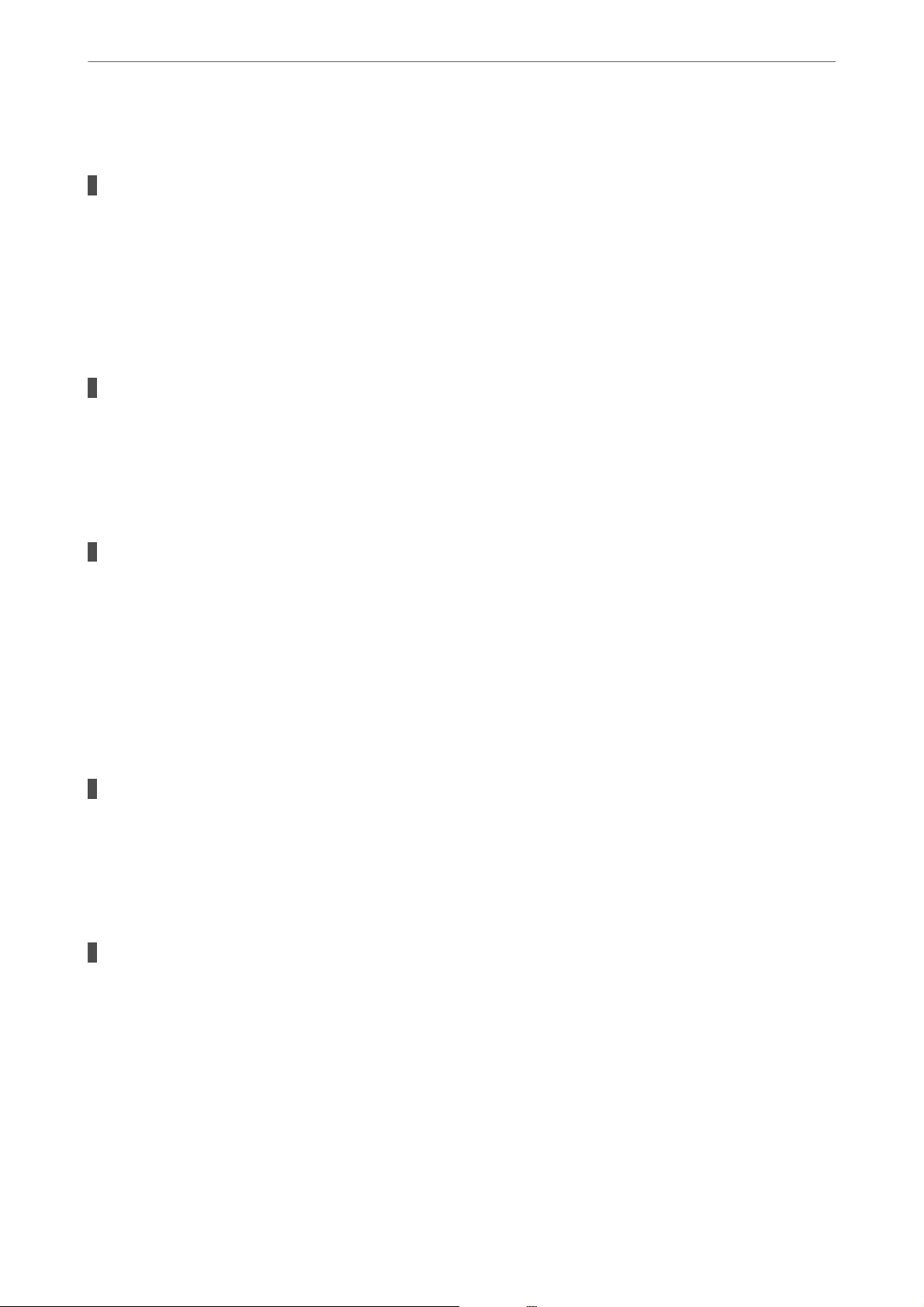
The Date and Time Are Incorrect
Error occurred in power supply.
Solutions
Aer a power failure caused by a lightning strike or if the power is le o for a long time, the clock may
show the wrong time. Set the date and the time correctly in Settings > General Settings > Basic Settings
> Date/Time Settings on the control panel.
The Root Certicate Needs to be Updated
The root certicate has expired.
Solutions
Run Web Cong, and then update the root certicate.
Cannot Cancel Printing from a Computer Running Mac OS X v10.6.8
There is a problem with your AirPrint setup.
Solutions
Run Web Cong, and then select Port9100 as the Top Priority Protocol setting in AirPrint Setup. Select
System Preferences from the Apple menu > Printers & Scanners (or Print & Scan, Print & Fax), remove
the printer, and then add the printer again.
&“Application for Conguring Printer Operations (Web Cong)” on page 301
Forgot Your Password
You need help from service personnel.
Solutions
If you forget the administrator's password, contact Epson support.
Copies are Made or Faxes are Sent Unintentionally
Foreign objects are touching the optical touch panel.
Solutions
Select Settings > General Settings > Basic Settings > Wake from Sle ep, and then turn o Wake with
LCD Screen Touch. e printer will not return from sleep mode (power saving) until you press the
P
button.
Solving Problems
>
The Printer Does Not Work as Expected
>
Cannot Operate the Printer as Expected
226
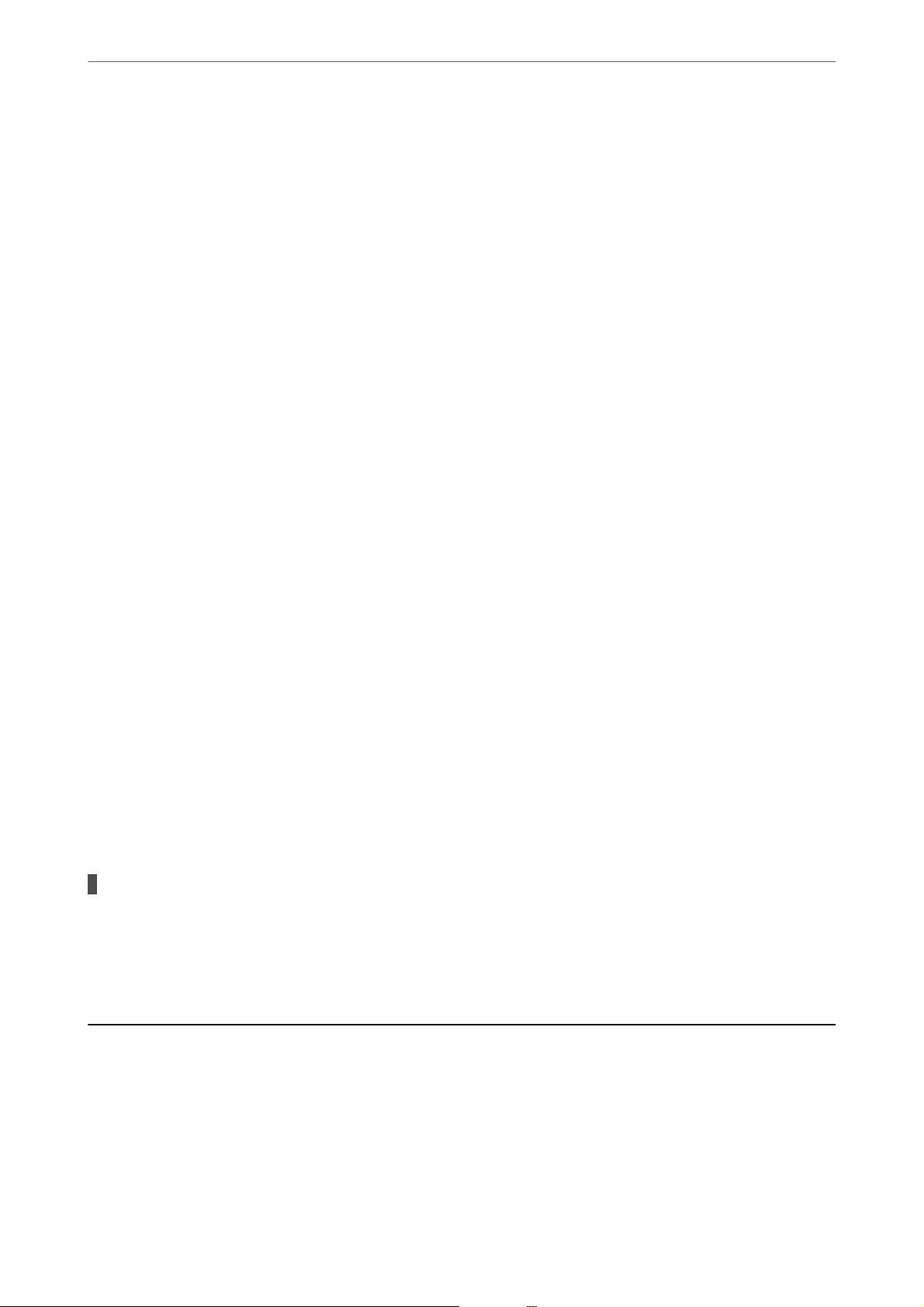
Sender's Fax Number Not Displayed
The sender's fax number is not set to the sender's machine.
e sender may not have set the fax number. Contact the sender.
Sender's Fax Number Displayed on Received Faxes is Wrong
The sender's fax number set to the sender's machine is wrong.
e sender may have set the fax number incorrectly. Contact the sender.
Cannot Make Calls on the Connected Telephone
The phone cable is not connected correctly.
Connect the telephone to the EXT. port on the printer, and pick up the receiver. If you cannot hear a dial tone
through the receiver, connect the phone cable correctly.
Answering Machine Cannot Answer Voice Calls
The printer's Rings to Answer setting is set to less than the number of rings for your answering
machine.
Select Slow(9,600bps) in Settings > General Settings > Fax Settings > Basic Settings > Rings to Answer, and
then set to a number higher than the number of rings for your answering machine.
A Lot of Junk Faxes Have Been Received
The printer's feature to block junk faxes has not been set up.
Solutions
Make Rejection Fax settings in Settings > General Settings > Fax Settings > Basic Settings.
“Making Settings for Blocking Junk Faxes” on page 401
A Message is Displayed on the LCD Screen
If an error message is displayed on the LCD screen, follow the on-screen instructions or the solutions below to
solve the problem.
Solving Problems
>
A Message is Displayed on the LCD Screen
227
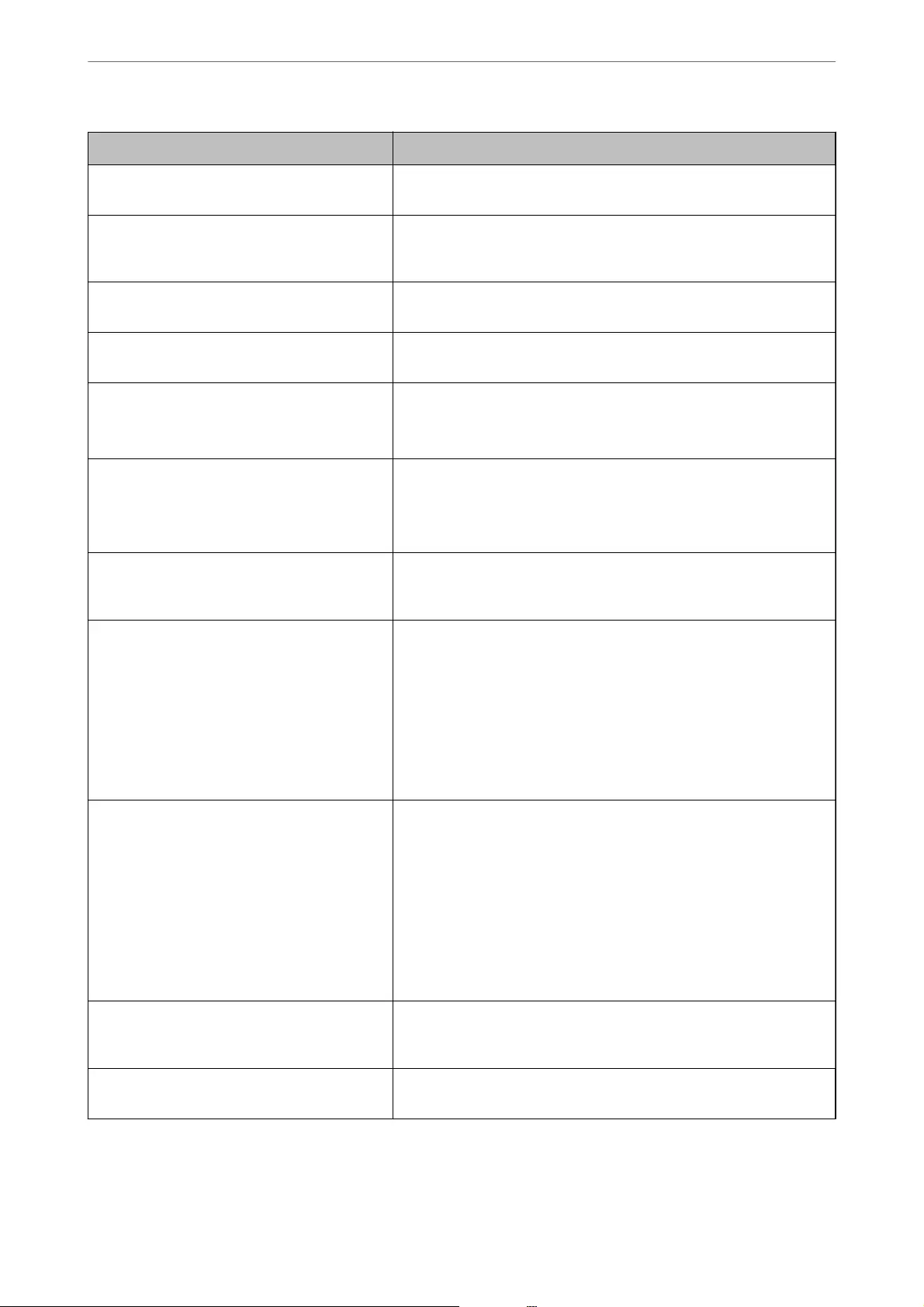
Error Messages Solutions
Printer error. Turn the power o and on again. If
the problem persists, contact Epson Support.
Remove any paper or protective material in the printer. If the error
message is still displayed, contact Epson support.
Printer error. Contact Epson Support. Non-
printing features are available.
The printer may be damaged. Contact Epson support or an authorised
Epson service provider to request repairs. However, non-printing
features such as scanning are available.
Printer error. For details, see your
documentation.
The printer may be damaged. Contact Epson support or an authorised
Epson service provider to request repairs.
Paper out in XX. Load paper. Paper Size: XX/
Paper Type: XX
Load paper in the displayed paper source, and if you load paper in the
paper cassette, insert it all the way.
The printer's borderless printing ink pad is
nearing the end of its service life. It is not a user-
replaceable part. Please contact Epson support.
Contact Epson or an authorised Epson service provider to replace the
borderless printing ink pad*. It is not a user-serviceable part.
Tap OK to resume printing.
The printer's borderless printing ink pad has
reached the end of its service life. It is not a user-
replaceable part. Please contact Epson support.
Contact Epson or an authorised Epson service provider to replace the
borderless printing ink pad*. It is not a user-serviceable part.
Borderless printing is not available, but printing with a border is
available.
Paper Setup Auto Display is set to O. Some
features may not be available. For details, see
your documentation.
If Paper Setup Auto Display is disabled, you cannot use AirPrint.
No dial tone is detected. This problem might be resolved by selecting Settings > General
Settings > Fax Settings > Basic Settings > Line Type and then
selecting PBX. If your phone system requires an external access code to
get an outside line, set the access code after selecting PBX. Use # (hash)
instead of the actual access code when entering an outside fax number.
This makes connection more secure.
If the error message is still displayed, set the Dial Tone Detection
settings to disabled. However, disabling this feature may drop the rst
digit of a fax number and send the fax to the wrong number.
Failed to receive faxes because the fax data
capacity is full. Touch the Job/Status at the
bottom of the Home Screen for details.
Received faxes may accumulate without being processed due to the
following reasons.
❏Cannot print because a printer error has occurred.
Clear the printer error. To check the details and solutions to the error,
select Job/Status and then select Printer Status.
❏Cannot save in the computer or the memory device.
To check whether or not received faxes have been saved, select Job/
Status and then select Job Status. To save received faxes, turn on
the computer or connect a memory device to the printer.
The combination of the IP address and the
subnet mask is invalid. See your documentation
for more details.
Enter the correct IP address or default gateway. Contact the person who
setup the network for assistance.
To use cloud services, update the root certicate
from the Epson Web Cong utility.
Run Web Cong, and then update the root certicate.
Solving Problems
>
A Message is Displayed on the LCD Screen
228
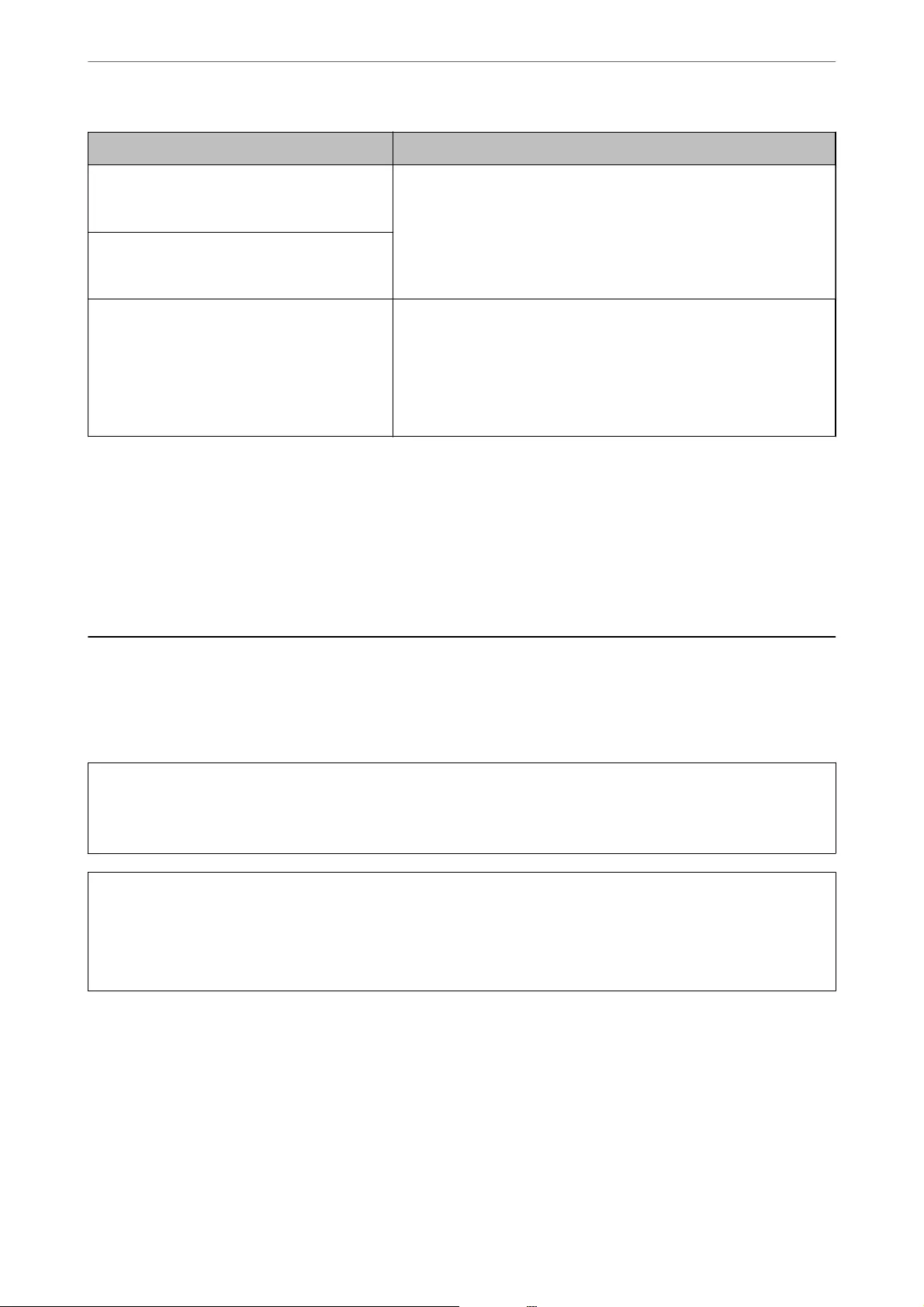
Error Messages Solutions
Check that the printer driver is installed on the
computer and that the port settings for the
printer are correct.
Make sure the printer port is selected correctly in Property > Port from
the Printer menu as follows.
Select "USBXXX" for a USB connection, or "EpsonNet Print Port" for a
network connection.
Check that the printer driver is installed on the
computer and that the port settings for the
printer are correct.
Recovery Mode
Update Firmware
The printer has started in recovery mode because the rmware update
failed. Follow the steps below to try to update the rmware again.
1. Connect the computer and the printer with a USB cable. (During
recovery mode, you cannot update the rmware over a network
connection.)
2. Visit your local Epson website for further instructions.
*In some print cycles a very small amount of surplus ink may be collected in the borderless printing ink pad. To
prevent ink leakage from the pad, the product is designed to stop borderless printing when the pad has reached its
limit. Whether and how oen this is required will vary according to the number of pages you print using the
borderless print option. e need for replacement of the pad does not mean that your printer has ceased to operate
in accordance with its specications. e printer will advise you when the pad requires replacing and this can only
be performed by an authorised Epson Service provider. e Epson warranty does not cover the cost of this
replacement.
Paper Gets Jammed
Check the error displayed on the control panel and follow the instructions to remove the jammed paper including
any torn pieces. e LCD screen displays an animation that shows you how to remove jammed paper. Next, select
OK to clear the error.
!
Caution:
Never touch the buttons on the control panel while your hand is inside the printer. If the printer starts operating, it
could cause an injury. Be careful not to touch the protruding parts to avoid injury.
c
Important:
❏Remove the jammed paper carefully. Removing the paper vigorously may cause damage to the printer.
❏When removing jammed paper, avoid tilting the printer, placing it vertically, or turning it upside down;
otherwise ink may leak.
Preventing Paper Jams
Check the following if paper jams occur frequently.
❏Place the printer on a at surface and operate in the recommended environmental conditions.
“Environmental Specications” on page 337
❏Use the paper supported by this printer.
“Available Paper and Capacities” on page 289
Solving Problems
>
Paper Gets Jammed
>
Preventing Paper Jams
229
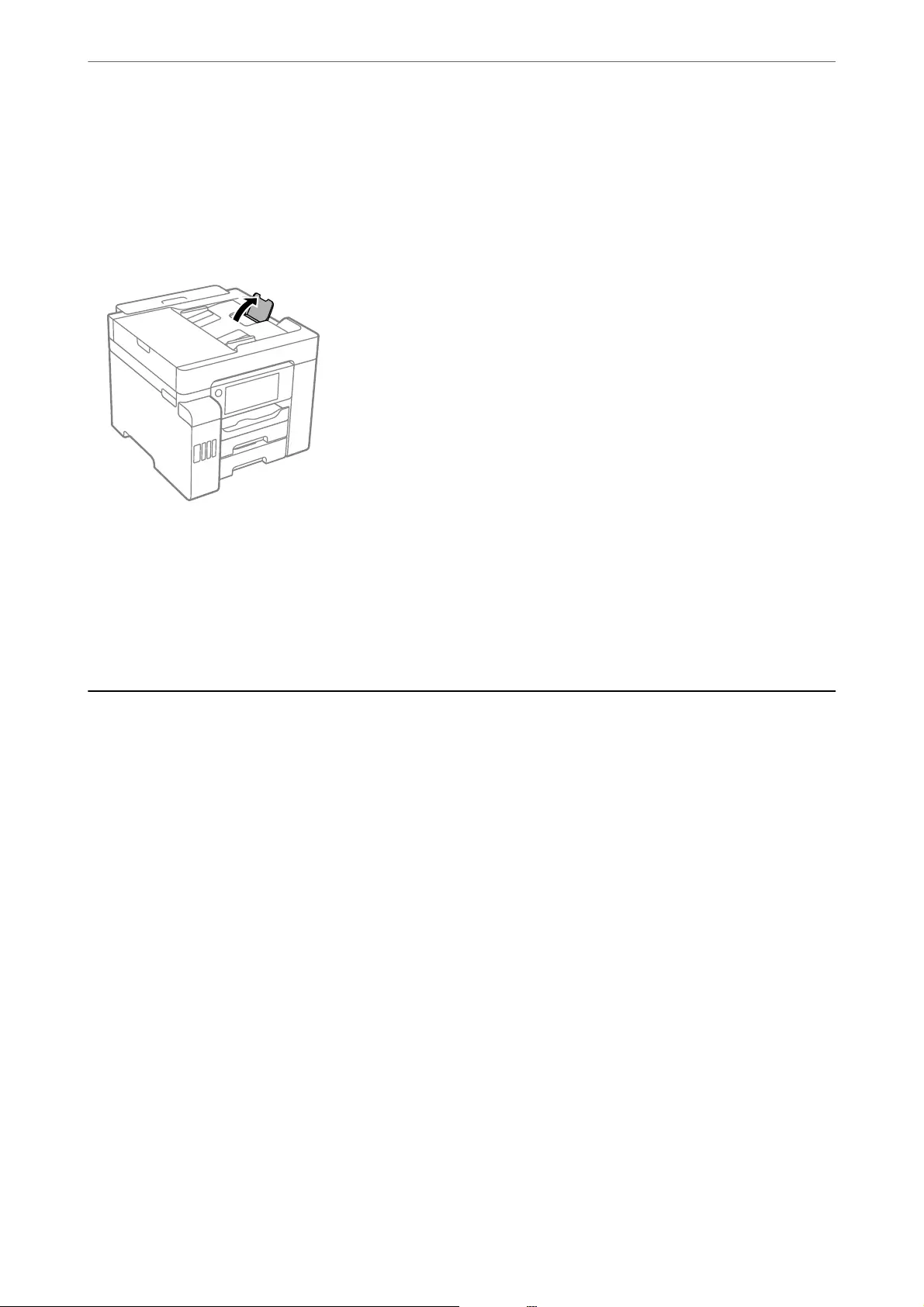
❏Follow paper handling precautions.
“Paper Handling Precautions” on page 30
❏Load paper in the correct direction, and slide the edge guide against the edge of the paper.
“Loading Paper” on page 31
❏Raise the ADF document support.
❏Do not load more than the maximum number of sheets specied for paper.
❏Load one sheet of paper at a time if you have loaded several sheets of paper.
❏Make sure the paper size and paper type settings match the actual paper size and paper type loaded in the
printer.
“List of Paper Type” on page 31
It is Time to Rell the Ink
Ink Bottle Handling Precautions
Read the following instructions before relling ink.
Storing precautions for ink
❏Keep the ink bottles out of direct sunlight.
❏Do not store the ink bottles in high or freezing temperatures.
❏Aer bringing an ink bottle inside from a cold storage site, allow it to warm up at room temperature for at least
three hours before using it.
❏Once you open an ink bottle, we recommend using it as soon as possible.
❏Epson recommends using the ink bottle before the date printed on the package.
❏Do not open the ink bottle package until you are ready to ll the ink tank. e ink bottle is vacuum packed to
maintain its reliability. If you leave an ink bottle unpacked for a long time before using it, normal printing may
not be possible.
❏When storing or transporting an ink bottle, do not tilt the bottle and do not subject it to impacts or temperature
changes. Otherwise, ink may leak even if the cap on the ink bottle is tightened securely. Be sure to keep the ink
bottle upright when tightening the cap, and take precautions to prevent ink from leaking when transporting the
bottle, for example, putting the bottle in a bag.
Solving Problems
>
It is Time to Rell the Ink
>
Ink Bottle Handling Precautions
230
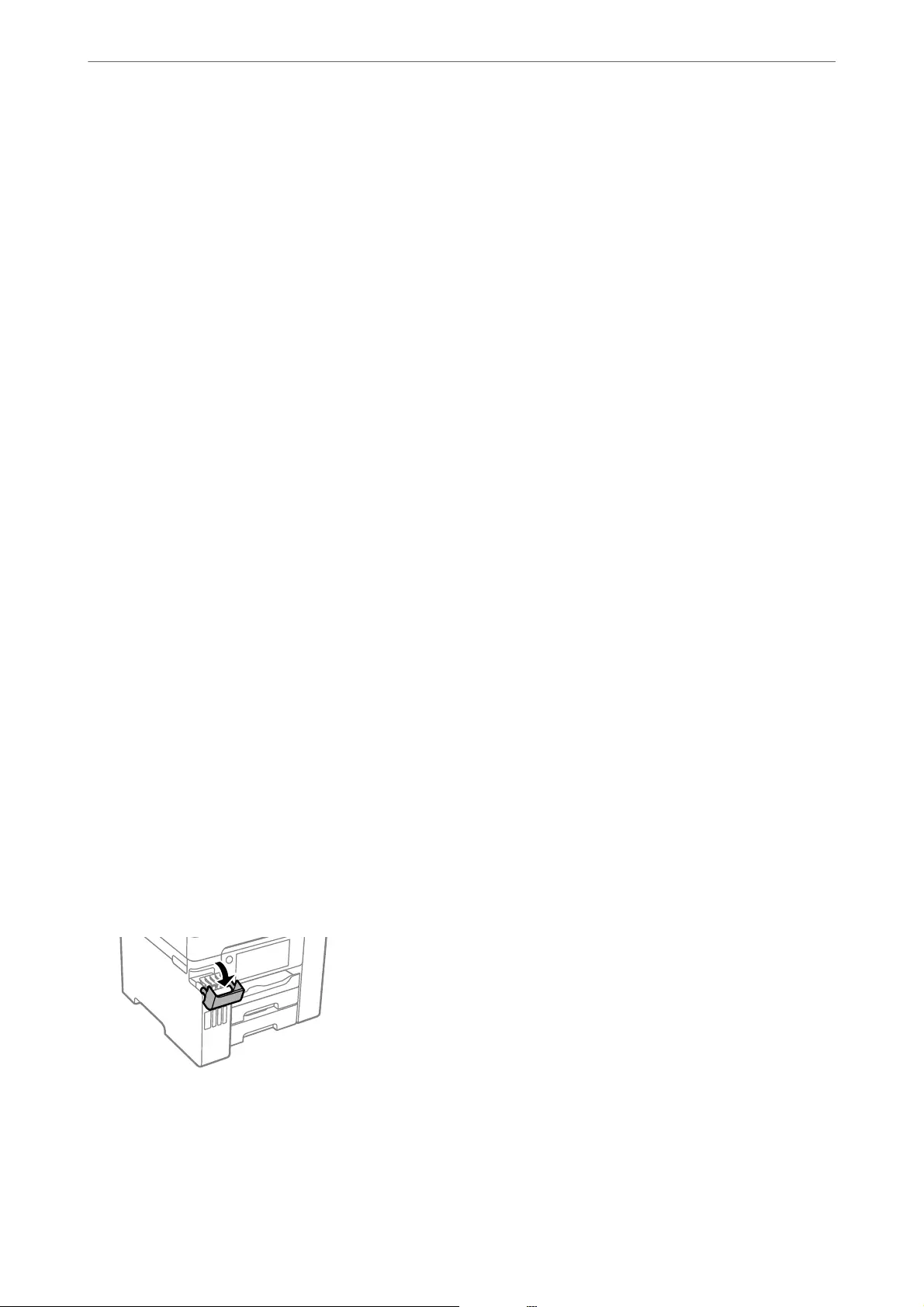
Handling precautions for relling ink
❏e ink for this printer must be handled carefully. Ink may splatter when the ink tanks are being lled or relled
with ink. If ink gets on your clothes or belongings, it may not come o.
❏Use ink bottles with the correct part code for this printer.
❏Do not shake too vigorously or squeeze the ink bottles.
❏For optimum print results do not maintain low ink levels for extended periods of time.
❏To obtain optimum printing results, rell the ink tanks to the upper line at least once every year.
❏To ensure you receive premium print quality and to help protect your print head, a variable ink safety reserve
remains in the ink tank when your printer indicates to rell ink. e yields quoted for you do not include this
reserve.
Ink consumption
❏To maintain optimum print head performance, some ink is consumed from all ink tanks during maintenance
operations such as print head cleaning. Ink may also be consumed when you turn the printer on.
❏When printing in monochrome or grayscale, color inks instead of black ink may be used depending on the
paper type or print quality settings. is is because a mixture of color inks is used to create black.
❏e ink in the ink bottles supplied with your printer is partly used during initial setup. In order to produce high
quality printouts, the print head in your printer will be fully charged with ink. is one-o process consumes a
quantity of ink and therefore these bottles may print fewer pages compared to subsequent ink bottles.
❏Quoted yields may vary depending on the images that you are printing, the paper type that you are using, the
frequency of your prints and environmental conditions such as temperature.
Relling the Ink Tanks
Ink can be relled at any time.
1. Select Settings on the home screen.
2. Select Maintenance > Fill Ink.
3. Read the usage precautions for lling ink on LCD screen, and then tap Proceed.
4. Open the ink tank cover.
Solving Problems
>
It is Time to Rell the Ink
>
Relling the Ink Tanks
231
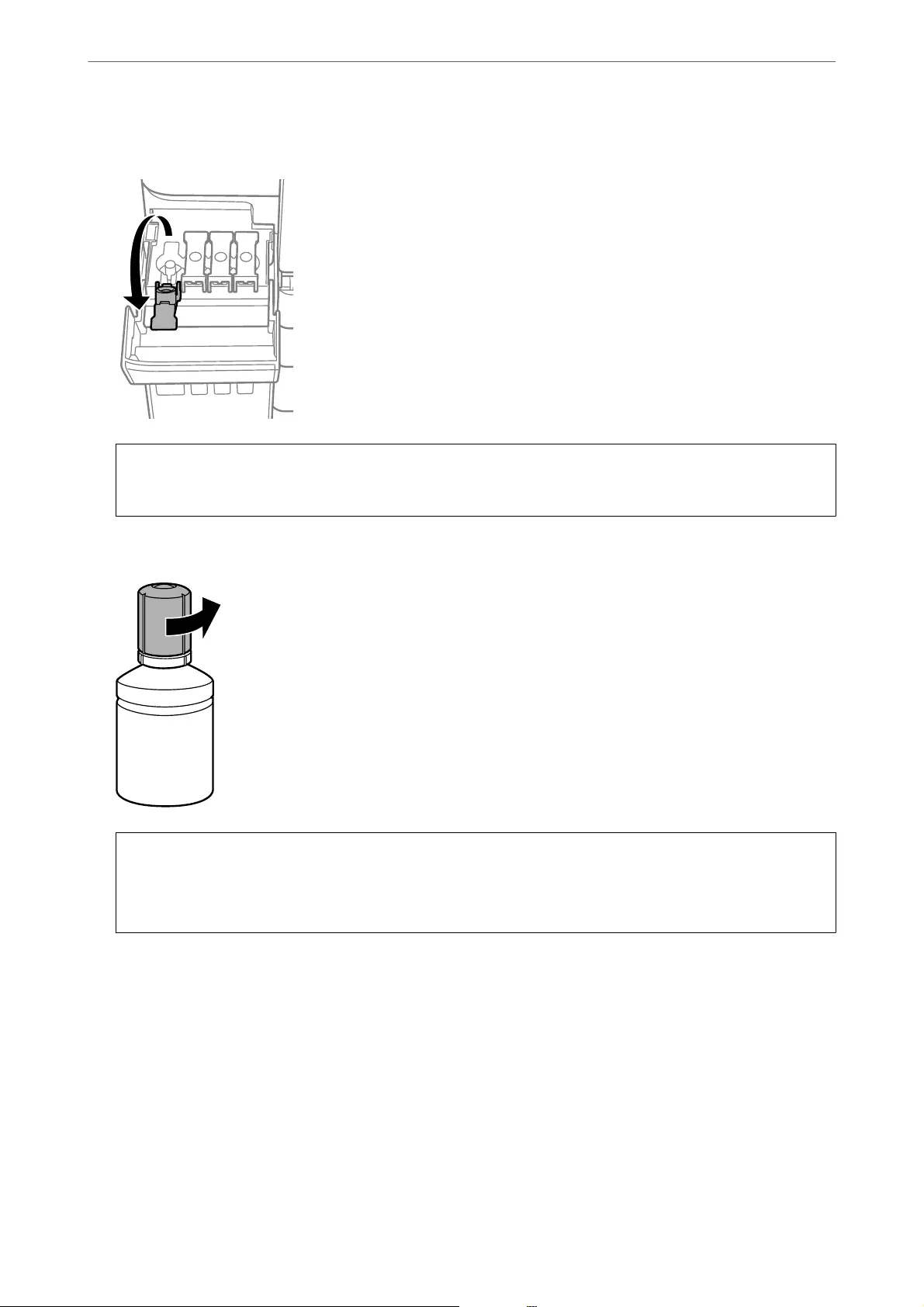
5. Open the ink tank cap.
c
Important:
Make sure that the color of the ink tank matches the ink color that you want to rell.
6. While holding the ink bottle upright, turn the cap slowly to remove it.
c
Important:
❏Epson recommends the use of genuine Epson ink bottles.
❏Be careful not to spill any ink.
Solving Problems
>
It is Time to Rell the Ink
>
Relling the Ink Tanks
232
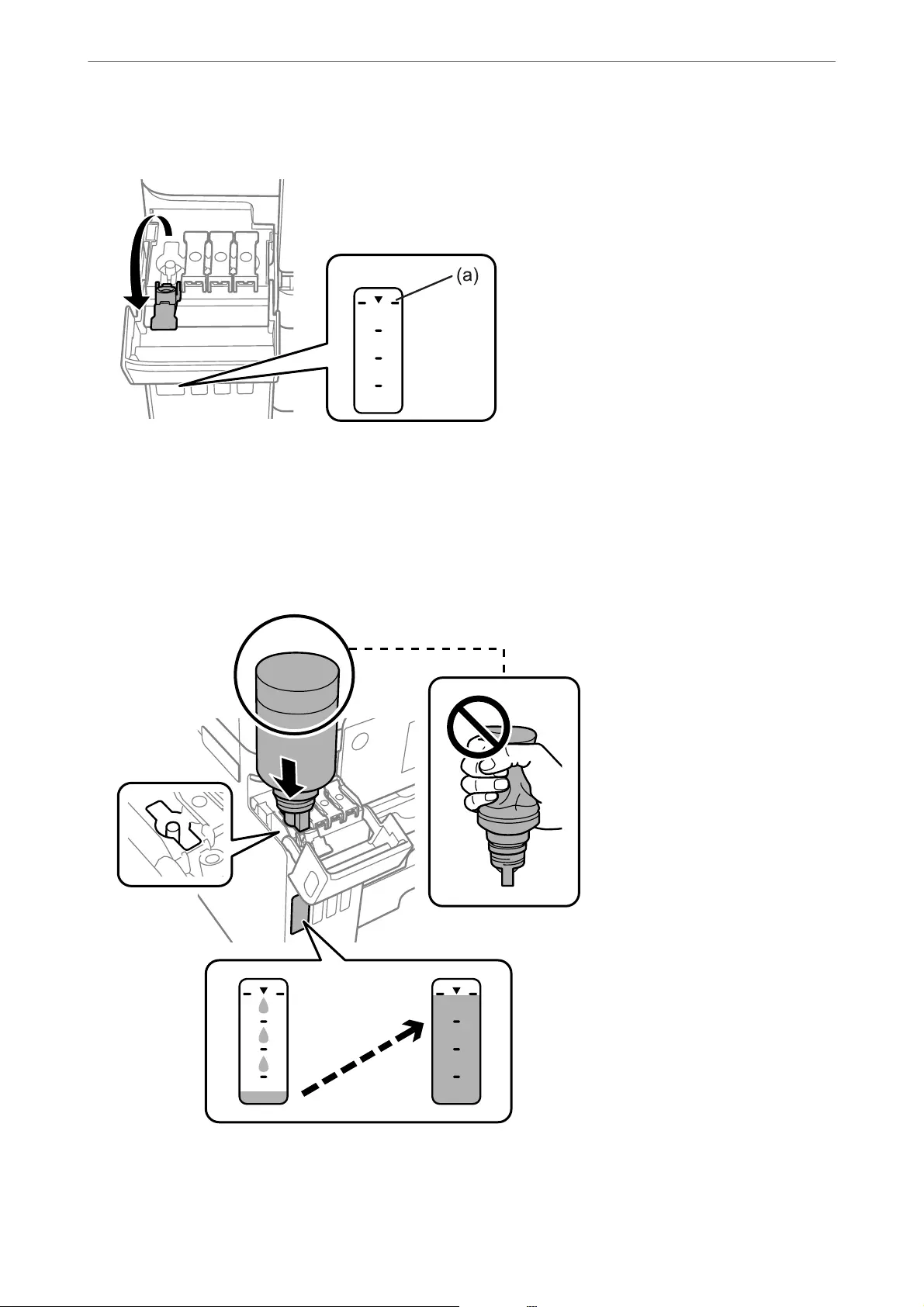
7. Check the upper line (a) in the ink tank.
8. Align the top of the ink bottle with the lling port, and then insert it straight into the port to ll ink to the
upper line.
When you insert the ink bottle into the lling port for the correct color, ink starts pouring and the ow stops
automatically when the ink reaches the upper line.
If the ink does not start owing into the tank, remove the ink bottle and reinsert it. However, do not reinsert
the ink bottle when the ink has reached the upper line; otherwise ink may leak.
Solving Problems
>
It is Time to Rell the Ink
>
Relling the Ink Tanks
233
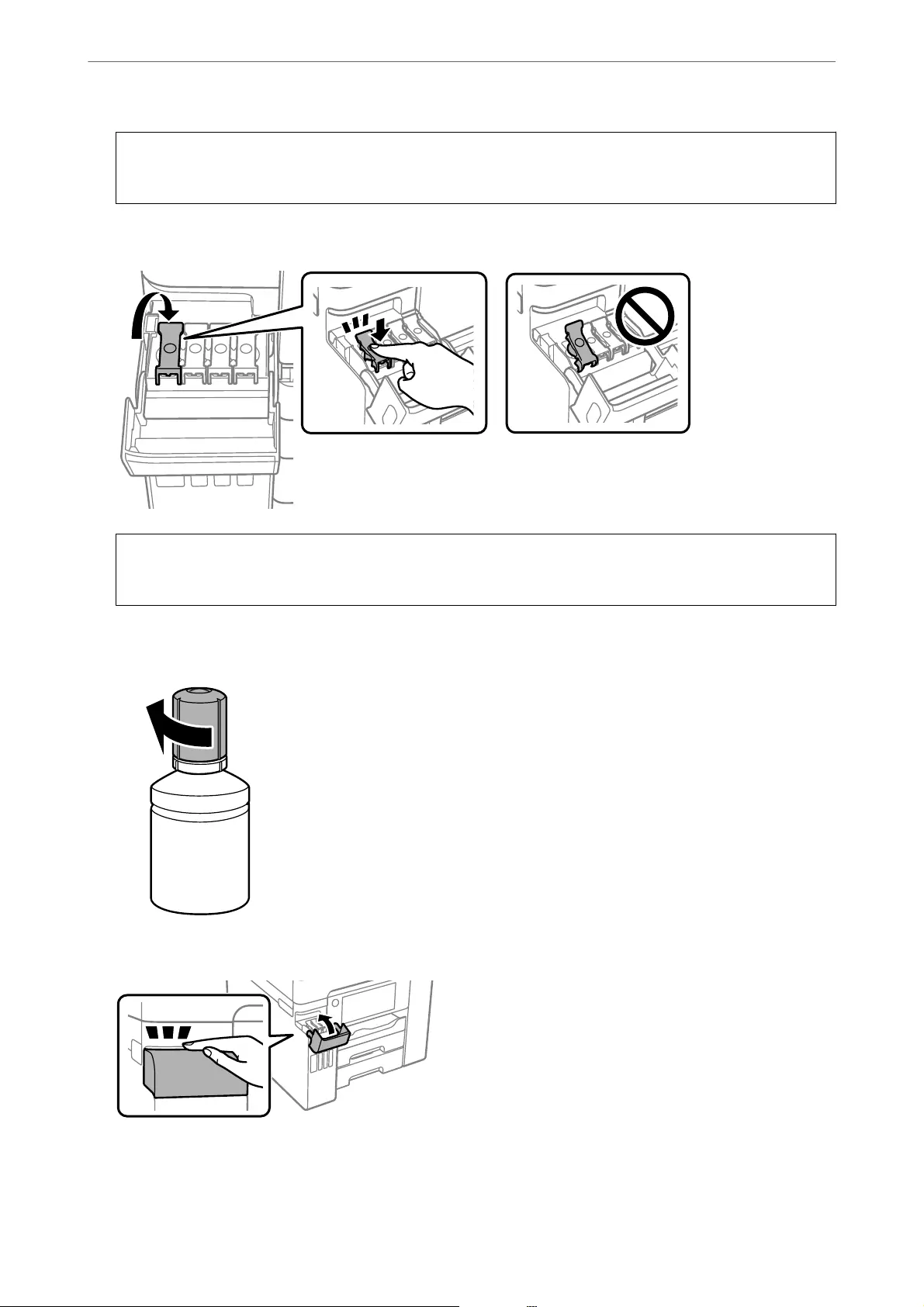
c
Important:
Do not allow the top of the ink bottle to hit against any objects aer removing its cap; otherwise ink may spill.
9. When you have nished relling the ink, remove the ink bottle, and then close the ink tank cap securely.
c
Important:
Do not leave the ink bottle inserted; otherwise the bottle may be damaged or ink may leak.
Note:
If any ink remains in the ink bottle, tighten the cap and store the bottle upright for later use.
10. Close the ink tank cover rmly.
11. Follow the on-screen instructions to set the ink level of the color of the ink you relled.
Solving Problems
>
It is Time to Rell the Ink
>
Relling the Ink Tanks
234
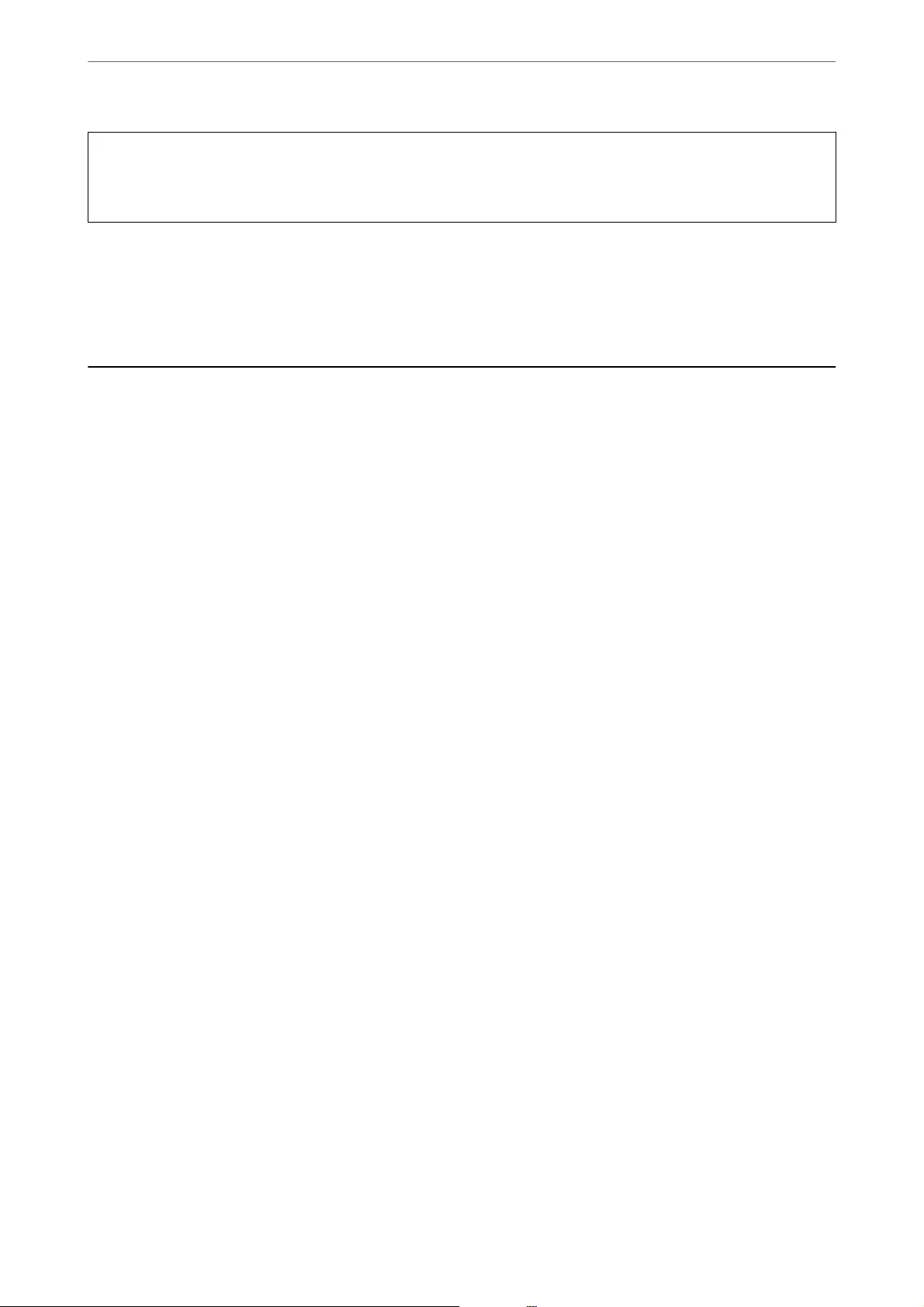
c
Important:
Even if you do not rell ink up to the upper line on the ink tank, you can continue using the printer. To keep your
printer operating at its best, however, ll ink tank up to the upper line and reset the ink level immediately.
Related Information
&“Ink Bottle Codes” on page 294
&“Ink Bottle Handling Precautions” on page 230
It is Time to Replace the Maintenance Box
Maintenance Box Handling Precautions
Read the following instructions before replacing the maintenance box.
❏Do not touch the green chip on the side of the maintenance box. Doing so may prevent normal operation and
printing.
❏Do not replace the maintenance box during printing; otherwise, ink may leak.
❏Do not remove the maintenance box or open its cover except when replacing the maintenance box; otherwise
ink may leak.
❏Do not reuse a maintenance box which has been removed and le detached for a long period. Ink inside the box
will have solidied and no more ink can be absorbed.
❏Do not tilt the used maintenance box until aer it is sealed in the plastic bag; otherwise ink may leak.
❏Do not store the maintenance box in high or freezing temperatures.
❏Keep the maintenance box out of direct sunlight.
❏Do not drop the maintenance box or subject it to strong shocks.
❏Do not touch the openings in the maintenance box as you may get smeared with ink.
Replacing a Maintenance Box
In some print cycles a very small amount of surplus ink may be collected in the maintenance box. To prevent ink
leakage from the maintenance box, the printer is designed to stop printing when the absorbing capacity of the
maintenance box has reached its limit. Whether and how oen this is required will vary according to the number
of pages you print, the type of material that you print and the number of cleaning cycles that the printer performs.
When a message is displayed prompting you to replace the maintenance box, refer to the animations displayed on
the control panel. e need for replacement of the box does not mean that your printer has ceased to operate in
Solving Problems
>
It is Time to Replace the Maintenance Box
>
Replacing a Maintenance Box
235
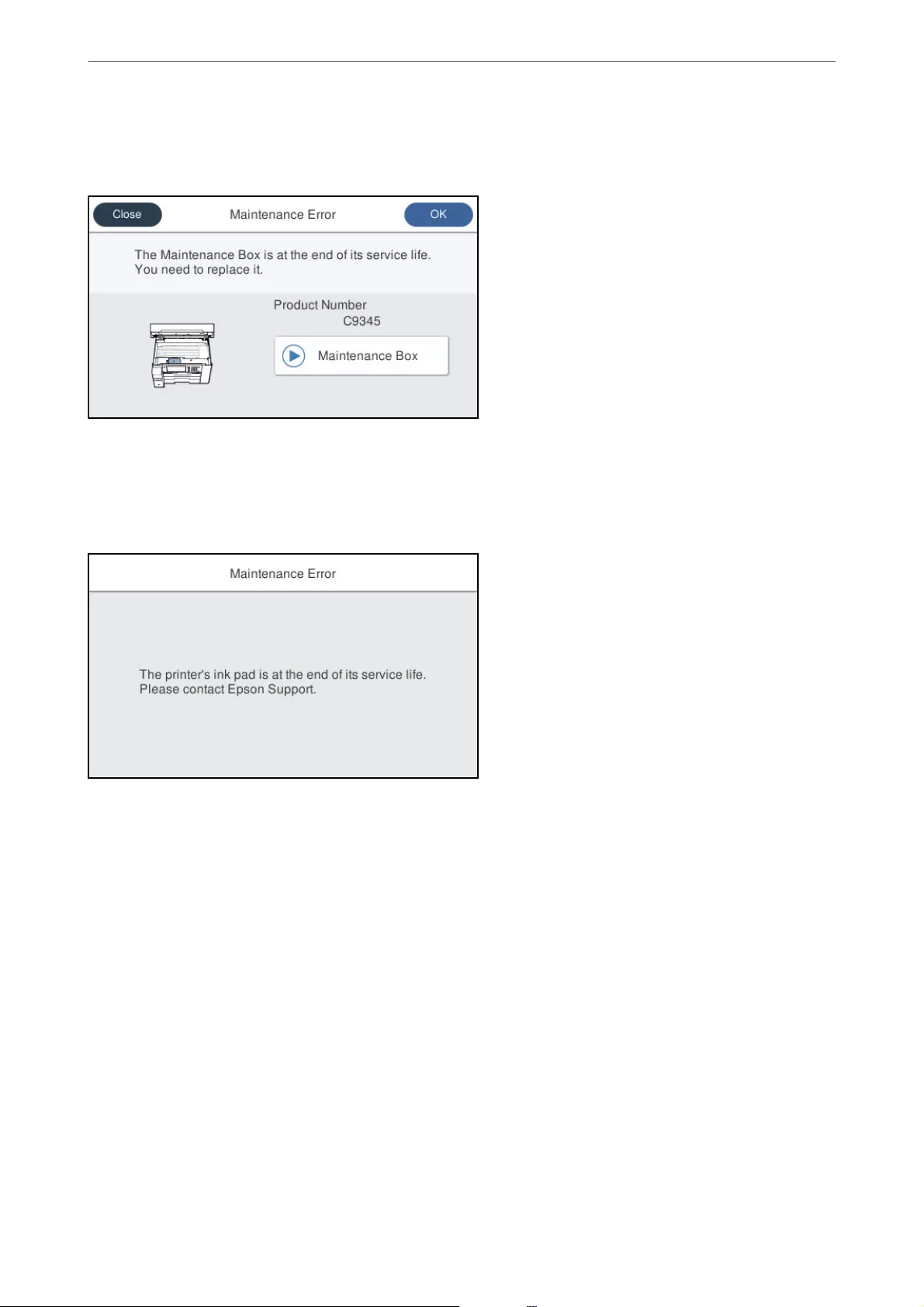
accordance with its specications. e Epson warranty does not cover the cost of this replacement. It is a user-
serviceable part.
Note:
❏When the maintenance box is full, you cannot print and clean the print head until it is replaced to avoid ink leakage.
However, you can perform operations that do not use ink such as scanning.
❏When the following screen is displayed, the part cannot be replaced by users. Contact Epson support.
Related Information
&“Maintenance Box Code” on page 295
&“Maintenance Box Handling Precautions” on page 235
Solving Problems
>
It is Time to Replace the Maintenance Box
>
Replacing a Maintenance Box
236
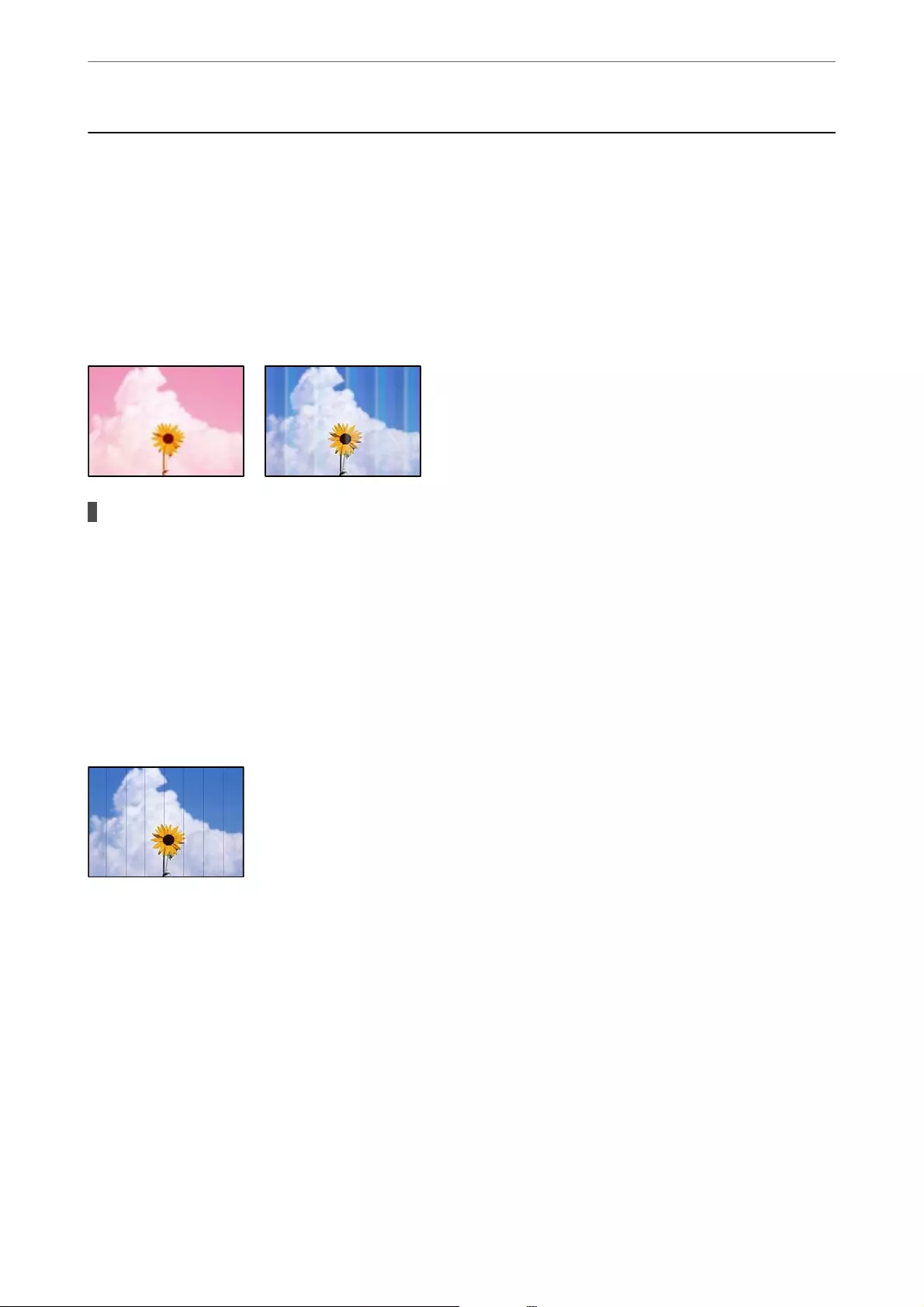
Printing, Copying, Scanning, and Faxing Quality is
Poor
Print Quality is Poor
Color Missing, Banding, or Unexpected Colors Appear in Printout
The print head nozzles may be clogged.
Solutions
Perform a nozzle check using the Print Quality Adjustment feature to see if the print head nozzles are
clogged. Perform a nozzle check, and then clean the print head if any of the print head nozzles are
clogged. If you have not used the printer for a long time, the print head nozzles may be clogged and ink
drops may not be discharged.
&“Adjusting the Print Quality” on page 146
Colored Banding Appears at Intervals of Approximately 1.1 cm or 3.3 cm
e following causes can be considered.
The paper type setting does not match the paper loaded.
Select the appropriate paper type setting for the type of paper loaded in the printer.
Related Information
&“List of Paper Type” on page 31
The print quality is set to low.
When printing on plain paper, print using a higher quality setting.
Solving Problems
>
Printing, Copying, Scanning, and Faxing Quality is Poor
>
Print Quality is Poor
237
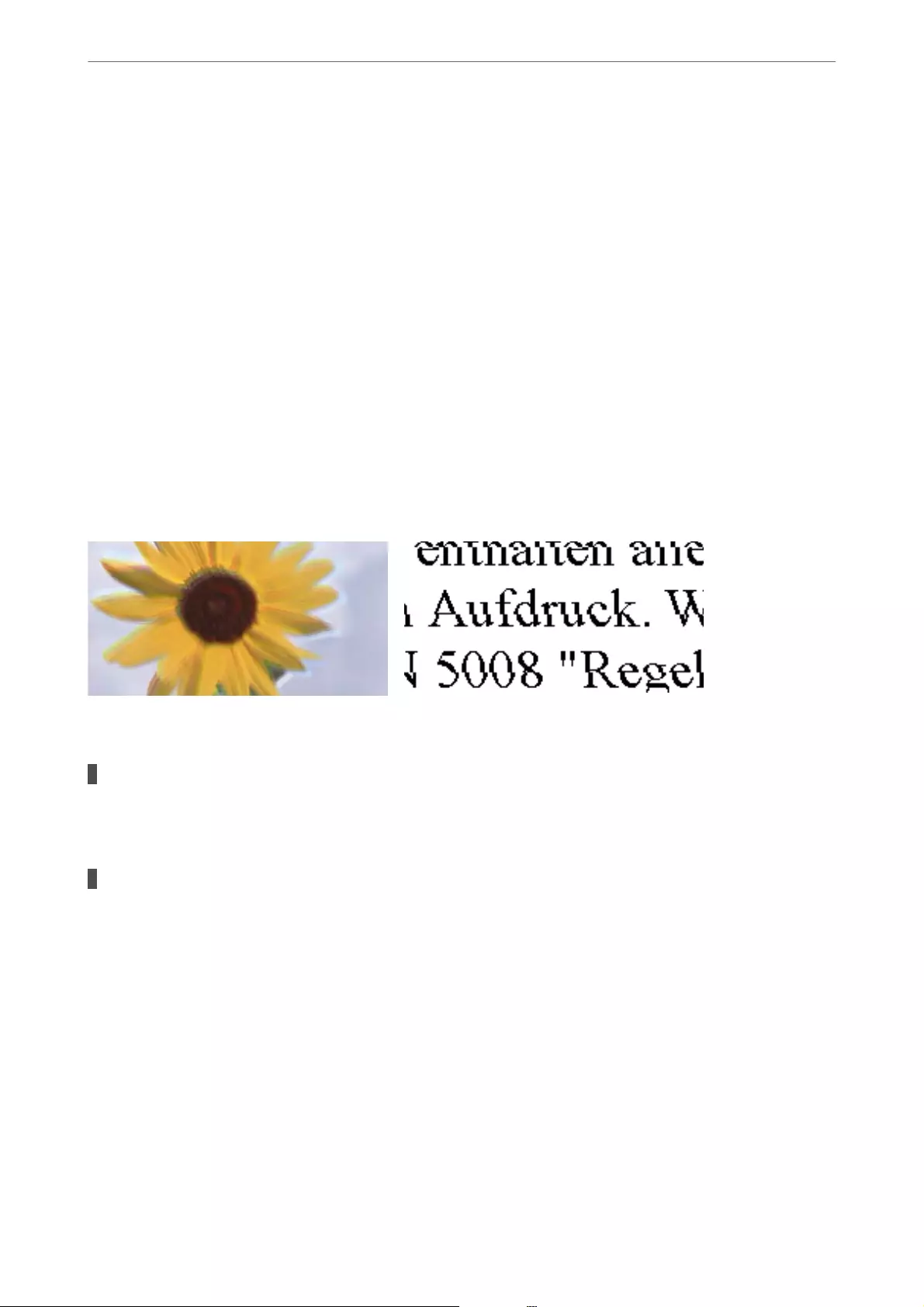
❏Control panel
Select Best as the Quality on the Advanced tab in print settings.
❏Windows
Select High from Quality on the printer driver's Main tab.
❏Mac OS
Select Fine as Print Quality from the print dialog's Print Settings menu.
The print head position is out of alignment.
Align the print head using the Print Quality Adjustment feature.
Related Information
&“Adjusting the Print Quality” on page 146
Blurry Prints, Vertical Banding, or Misalignment
e following causes can be considered.
The print head position is out of alignment.
Solutions
Align the print head using the Print Quality Adjustment feature.
The bidirectional printing setting is enabled.
Solutions
If print quality does not improve even aer aligning the print head, disable the bidirectional setting.
During bidirectional (or high speed) printing, the print head prints while moving in both directions, and
vertical lines may be misaligned. Disabling this setting may slow down printing speed but improve print
quality.
❏Control panel
Select Settings > General Settings > Printer Settings, and then disable Bidirectional.
❏Windows
Clear Bidirectional Printing on the printer driver’s More Options tab.
❏Mac OS
Select System Preferences from the Apple menu > Printers & Scanners (or Print & Scan, Print &
Fax), and then select the printer. Click Options & Supplies > Options (or Driver). Select O as the
Bidirectional Printing setting.
Solving Problems
>
Printing, Copying, Scanning, and Faxing Quality is Poor
>
Print Quality is Poor
238
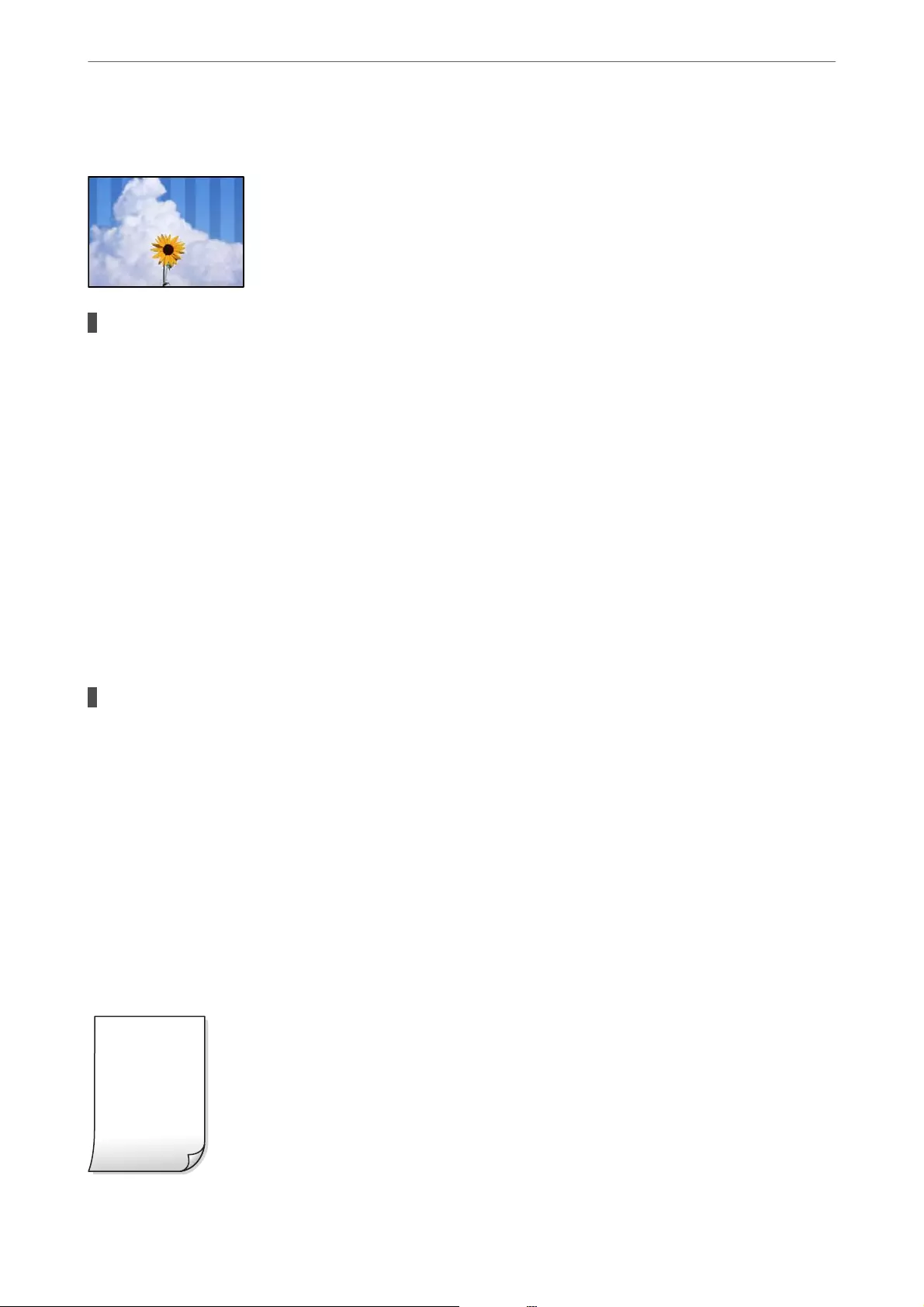
Striped Patterns Appear
The bidirectional printing setting is enabled.
Solutions
When printing on plain paper, disable the bidirectional setting.
During bidirectional (or high speed) printing, the print head prints while moving in both directions, and
vertical lines may be misaligned. Disabling this setting may slow down printing speed but improve print
quality.
❏Control panel
Select Settings > General Settings > Printer Settings, and then disable Bidirectional.
❏Windows
Clear Bidirectional Printing on the printer driver’s More Options tab.
❏Mac OS
Select System Preferences from the Apple menu > Printers & Scanners (or Print & Scan, Print &
Fax), and then select the printer. Click Options & Supplies > Options (or Driver). Select O as the
High Speed Printing setting.
The print quality is set to low.
Solutions
When printing on photo paper, print using a higher quality setting.
❏Control panel
Select Best as the Quality on the Advanced tab in print settings.
❏Windows
Select High from Quality on the printer driver's Main tab.
❏Mac OS
Select Fine as Print Quality from the print dialog's Print Settings menu.
Printout Comes Out as a Blank Sheet
Solving Problems
>
Printing, Copying, Scanning, and Faxing Quality is Poor
>
Print Quality is Poor
239
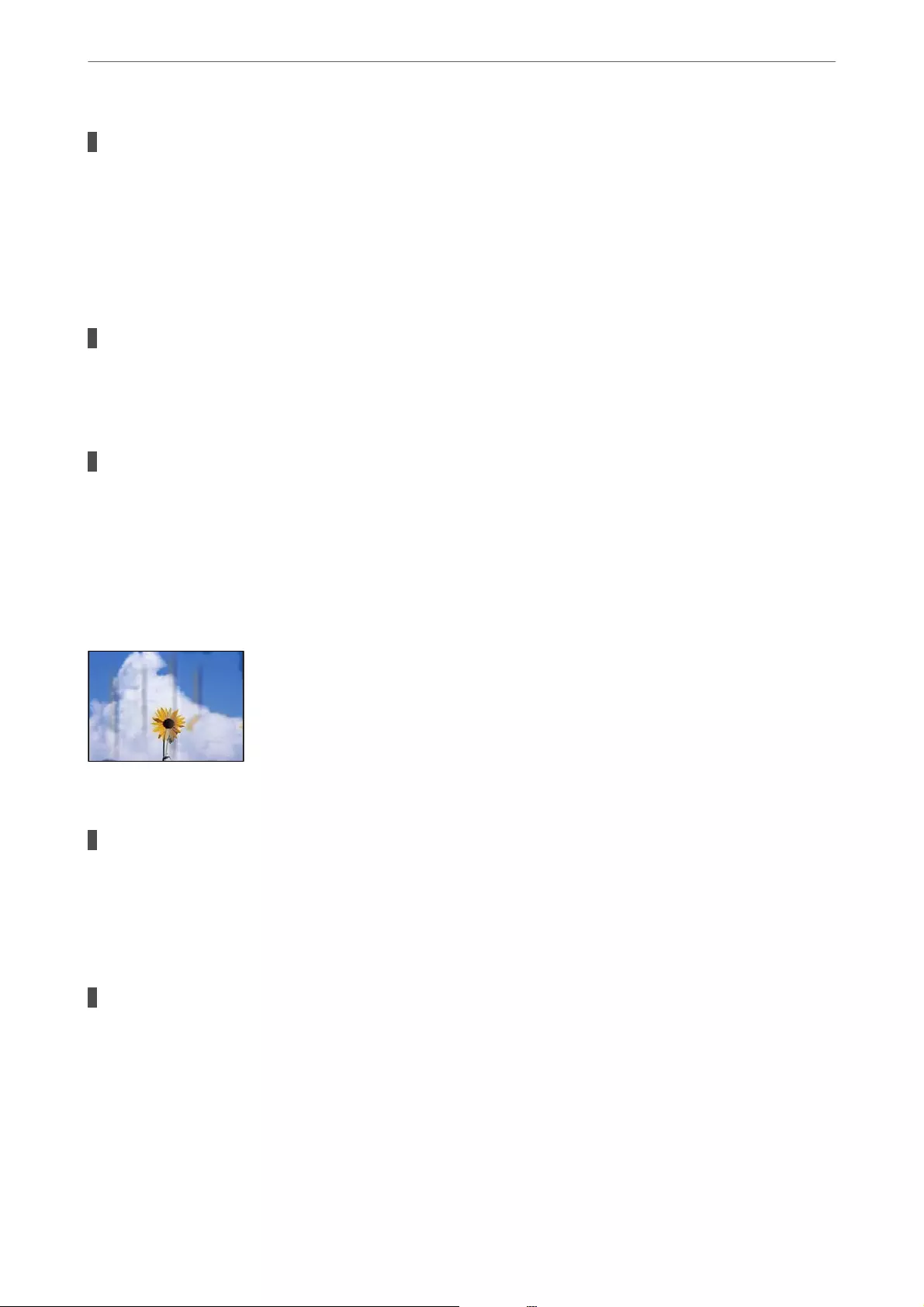
The print head nozzles may be clogged.
Solutions
Perform a nozzle check using the Print Quality Adjustment feature to see if the print head nozzles are
clogged. Perform a nozzle check, and then clean the print head if any of the print head nozzles are
clogged. If you have not used the printer for a long time, the print head nozzles may be clogged and ink
drops may not be discharged.
&“Adjusting the Print Quality” on page 146
The print settings and the paper size loaded in the printer are dierent.
Solutions
Change the print settings according to the paper size loaded in the paper cassette. Load paper in the
paper cassette that matches the print settings.
Multiple sheets of paper are fed into the printer at the same time.
Solutions
See the following to prevent multiple sheets of paper being fed into the printer at the same time.
&“Several Sheets of Paper are Fed at a Time” on page 172
Paper Is Smeared or Scued
e following causes can be considered.
Paper is loaded incorrectly.
Solutions
When horizontal banding (perpendicular to the printing direction) appears, or the top or bottom of the
paper is smeared, load paper in the correct direction and slide the edge guides to the edges of the paper.
&“Loading Paper” on page 31
The paper path is smeared.
Solutions
When vertical banding (horizontal to the printing direction) appears, or the paper is smeared, clean the
paper path.
&“Cleaning the Paper Path for Ink Smears” on page 151
Solving Problems
>
Printing, Copying, Scanning, and Faxing Quality is Poor
>
Print Quality is Poor
240
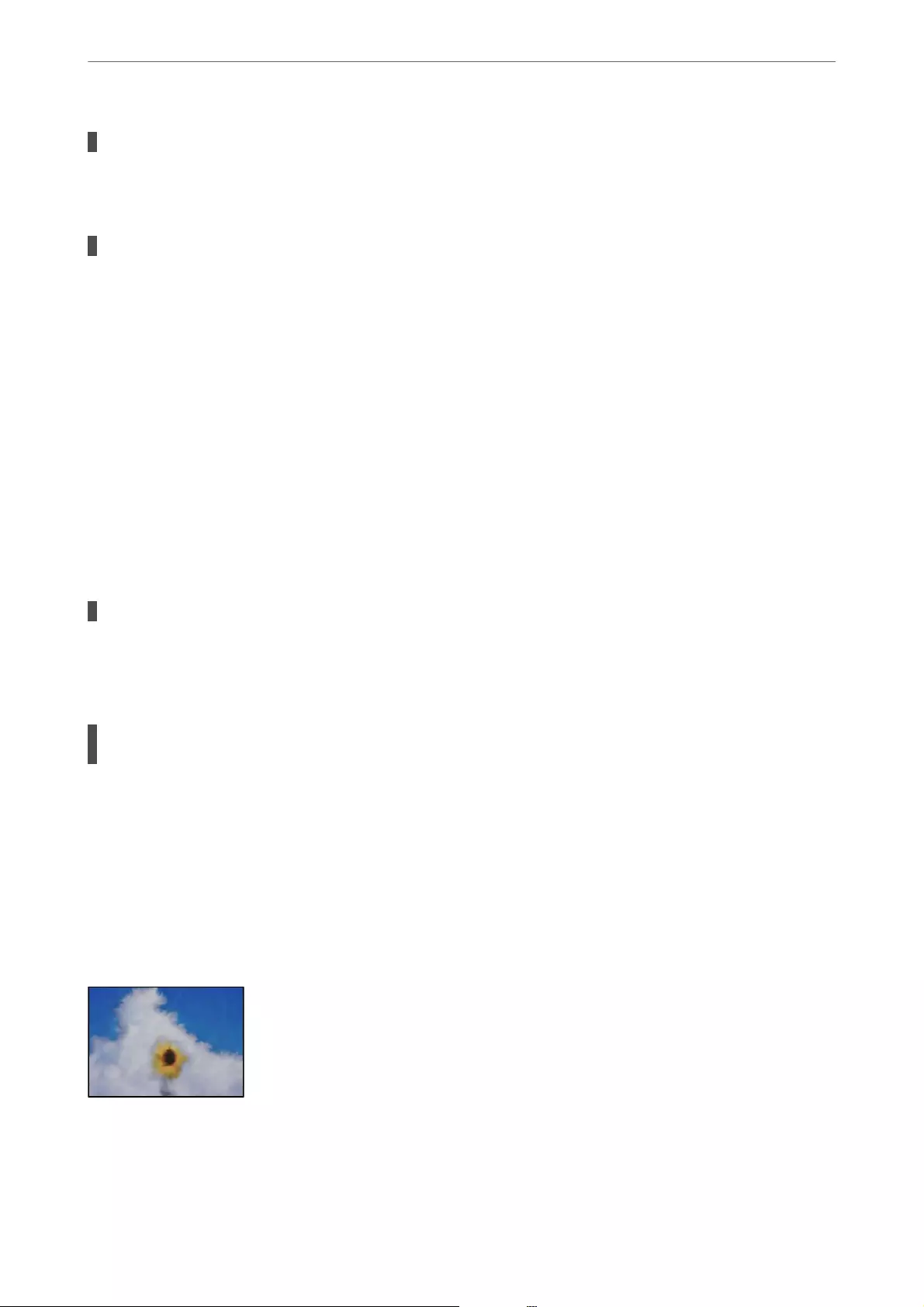
The paper is curled.
Solutions
Place the paper on a at surface to check if it is curled. If it is, atten it.
The print head is rubbing the surface of the paper.
Solutions
When printing on thick paper, the print head is close to the printing surface and the paper may be
scued. In this case, enable the reduce scu setting. If you enable this setting, print quality may decline or
printing may slow down.
❏Control panel
Select Settings > General Settings > Printer Settings, and then enable ick Paper.
❏Windows
Click Extended Settings on the printer driver's Maintenance tab, and then select ick Paper and
Envelopes.
❏Mac OS
Select System Preferences from the Apple menu > Printers & Scanners (or Print & Scan, Print &
Fax), and then select the printer. Click Options & Supplies > Options (or Driver). Select On as
theick paper and envelopes setting.
The back of the paper was printed before the side that had already been printed was dry.
Solutions
When performing manual 2-sided printing, make sure that the ink is completely dry before reloading the
paper.
When printing using automatic 2-sided printing, the print density is too high and the drying
time is too short.
Solutions
When using the automatic 2-sided printing feature and printing high density data such as images and
graphs, set the print density to lower and the drying time to longer.
&“Printing on 2-Sides” on page 47
&“Printing on 2-Sides” on page 69
Printed Photos are Sticky
Solving Problems
>
Printing, Copying, Scanning, and Faxing Quality is Poor
>
Print Quality is Poor
241
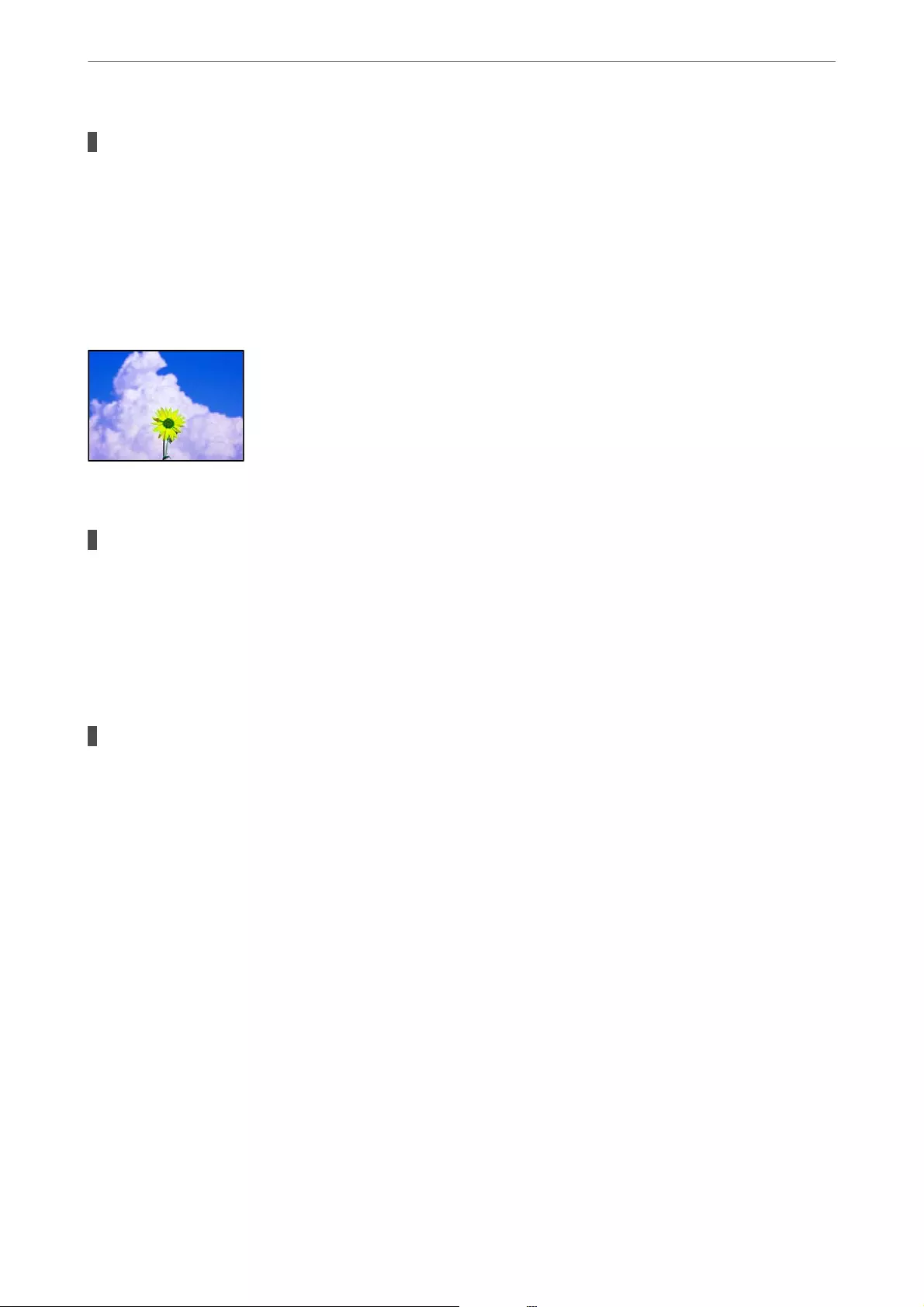
The print was made on the wrong side of the photo paper.
Solutions
Make sure you are printing on the printable side. When printing on the wrong side of the photo paper,
you need to clean the paper path.
&“Cleaning the Paper Path for Ink Smears” on page 151
Images or Photos are Printed in Unexpected Colors
e following causes can be considered.
The print head nozzles may be clogged.
Solutions
Perform a nozzle check using the Print Quality Adjustment feature to see if the print head nozzles are
clogged. Perform a nozzle check, and then clean the print head if any of the print head nozzles are
clogged. If you have not used the printer for a long time, the print head nozzles may be clogged and ink
drops may not be discharged.
&“Adjusting the Print Quality” on page 146
Color correction has been applied.
Solutions
When printing from the control panel or from the Windows printer driver, the Epson auto photo
adjustment setting is applied by default depending on the paper type. Try change the setting.
❏Control panel
Change the Fix Photo setting from Auto to any other option. If changing the setting does not work,
select Enhance O as the Fix Photo setting.
❏Windows printer driver
On the More Options tab, select Custom in Color Correction, and then click Advanced. Change the
Scene Correction setting from Automatic to any other option. If changing the setting does not work,
use any color correction method other than PhotoEnhance in Color Management.
&“JPEG Settings” on page 76
&“Adjusting the Print Color” on page 62
Solving Problems
>
Printing, Copying, Scanning, and Faxing Quality is Poor
>
Print Quality is Poor
242
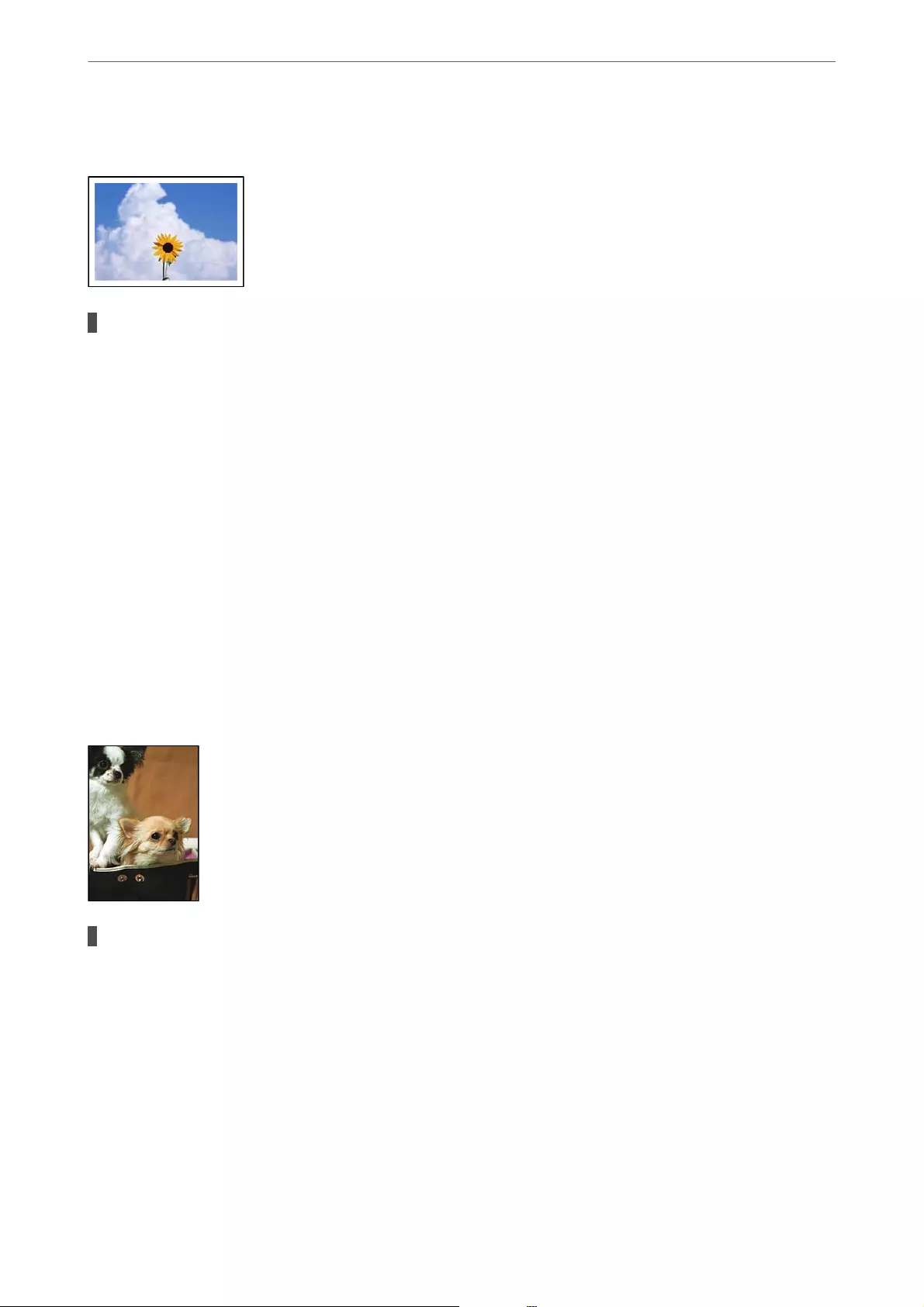
Cannot Print Without Margins
Borderless is not set in the print settings.
Solutions
Make borderless setting in the print settings. If you select a paper type that does not support borderless
printing, you cannot select Borderless. Select a paper type that supports borderless printing.
❏Control panel
Select Borderless as Layout.
❏Windows
Select Borderless on the printer driver's Main tab.
❏Mac OS
Select a borderless paper size from Paper Size.
&“JPEG Settings” on page 76
&“TIFF Settings” on page 77
&“Paper for Borderless Printing” on page 292
Edges of the Image are Cropped During Borderless Printing
Because the image is slightly enlarged, the protruding area is cropped.
Solutions
Select a smaller enlargement setting.
❏Windows
Click Settings next to the Borderless checkbox on the printer driver's Main tab, and then change the
settings.
❏Mac OS
Change the Expansion setting from the print dialog's Print Settings menu.
Solving Problems
>
Printing, Copying, Scanning, and Faxing Quality is Poor
>
Print Quality is Poor
243
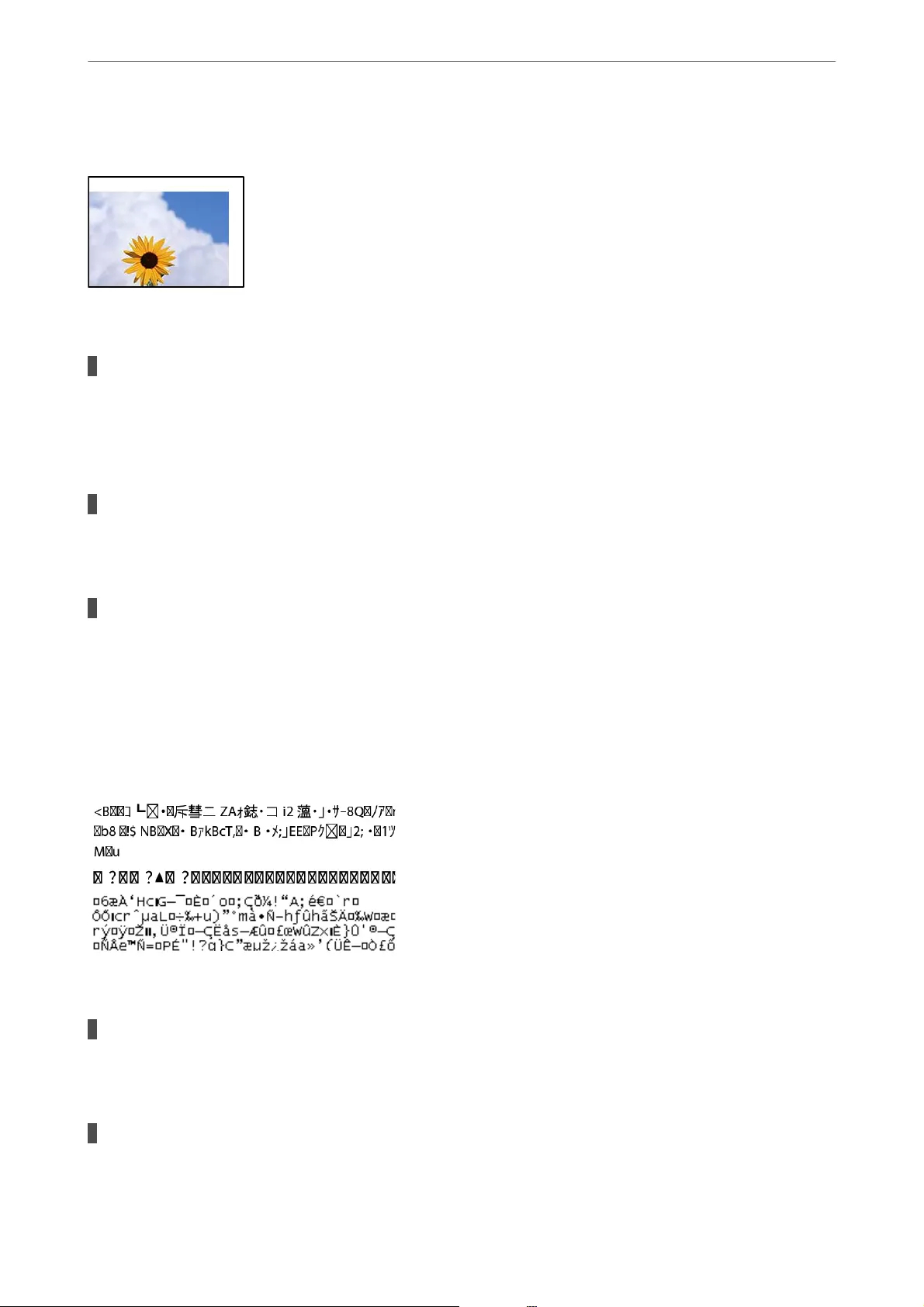
The Position, Size, or Margins of the Printout Are Incorrect
e following causes can be considered.
The paper is loaded incorrectly.
Solutions
Load paper in the correct direction, and slide the edge guide against the edge of the paper.
&“Loading Paper” on page 31
The size of the paper is set incorrectly.
Solutions
Select the appropriate paper size setting.
The margin setting in the application software is not within the print area.
Solutions
Adjust the margin setting in the application so that it falls within the printable area.
&“Printable Area” on page 328
Printed Characters Are Incorrect or Garbled
e following causes can be considered.
The USB cable is not connected correctly.
Solutions
Connect the USB cable securely to the printer and the computer.
There is a job waiting to be printed.
Solutions
Cancel any paused print jobs.
Solving Problems
>
Printing, Copying, Scanning, and Faxing Quality is Poor
>
Print Quality is Poor
244
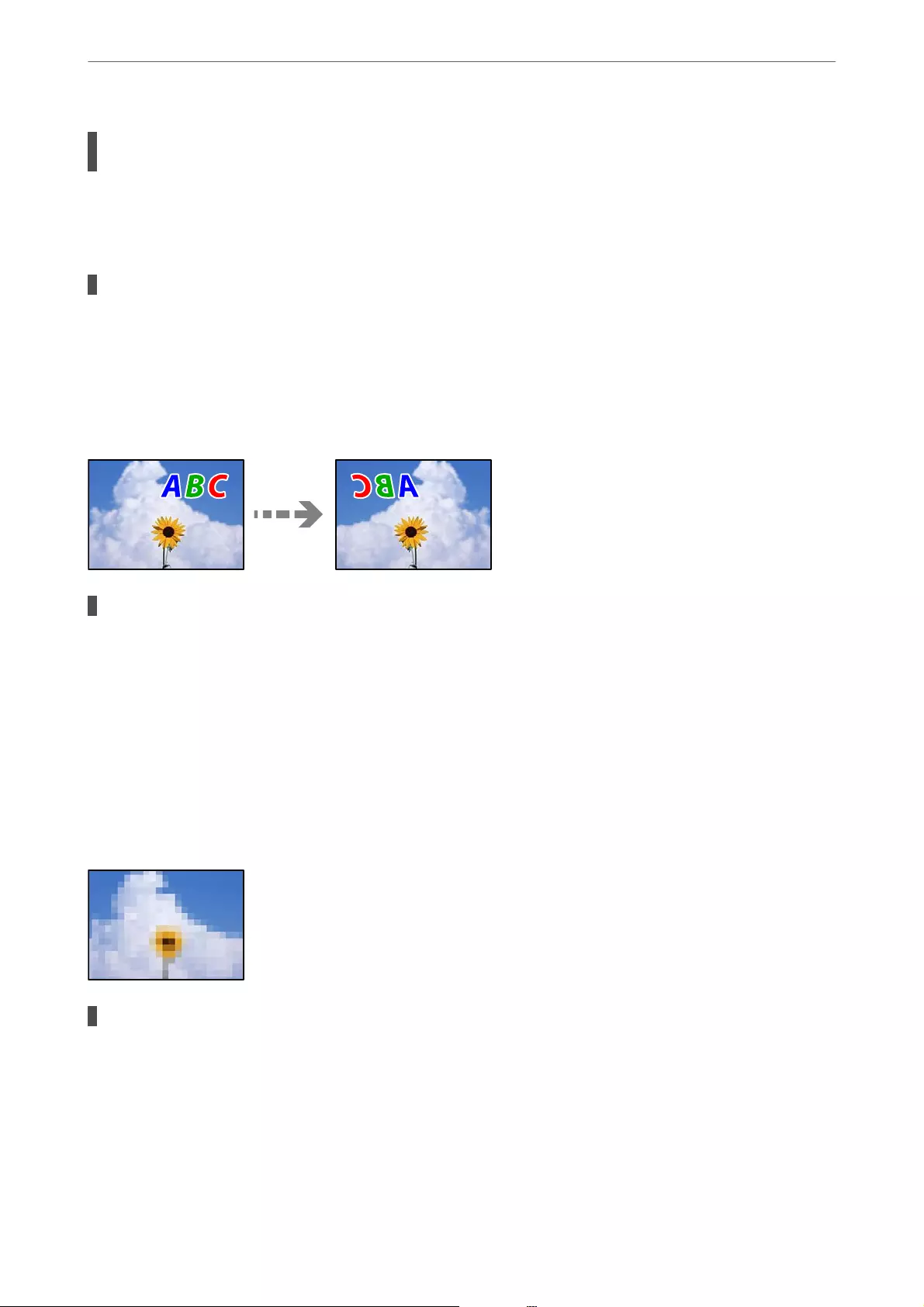
The computer has been manually put into the Hibernate mode or the Sleep mode while
printing.
Solutions
Do not put the computer manually into the Hibernate mode or the Sleep mode while printing. Pages of
garbled text may be printed next time you start the computer.
You are using the printer driver for a dierent printer.
Solutions
Make sure that the printer driver you are using is for this printer. Check the printer name on the top of
the printer driver window.
The Printed Image Is Inverted
The image is set to invert horizontally in the print settings.
Solutions
Clear any mirror image settings in the printer driver or the application.
❏Windows
Clear Mirror Image on the printer driver’s More Options tab.
❏Mac OS
Clear Mirror Image from the print dialog's Print Settings menu.
Mosaic-Like Patterns in the Prints
Images or photos with a low resolution were printed.
Solutions
When printing images or photos, print using high-resolution data. Images on web sites are oen low
resolution although they look good enough on the display, and so print quality may decline.
Solving Problems
>
Printing, Copying, Scanning, and Faxing Quality is Poor
>
Print Quality is Poor
245
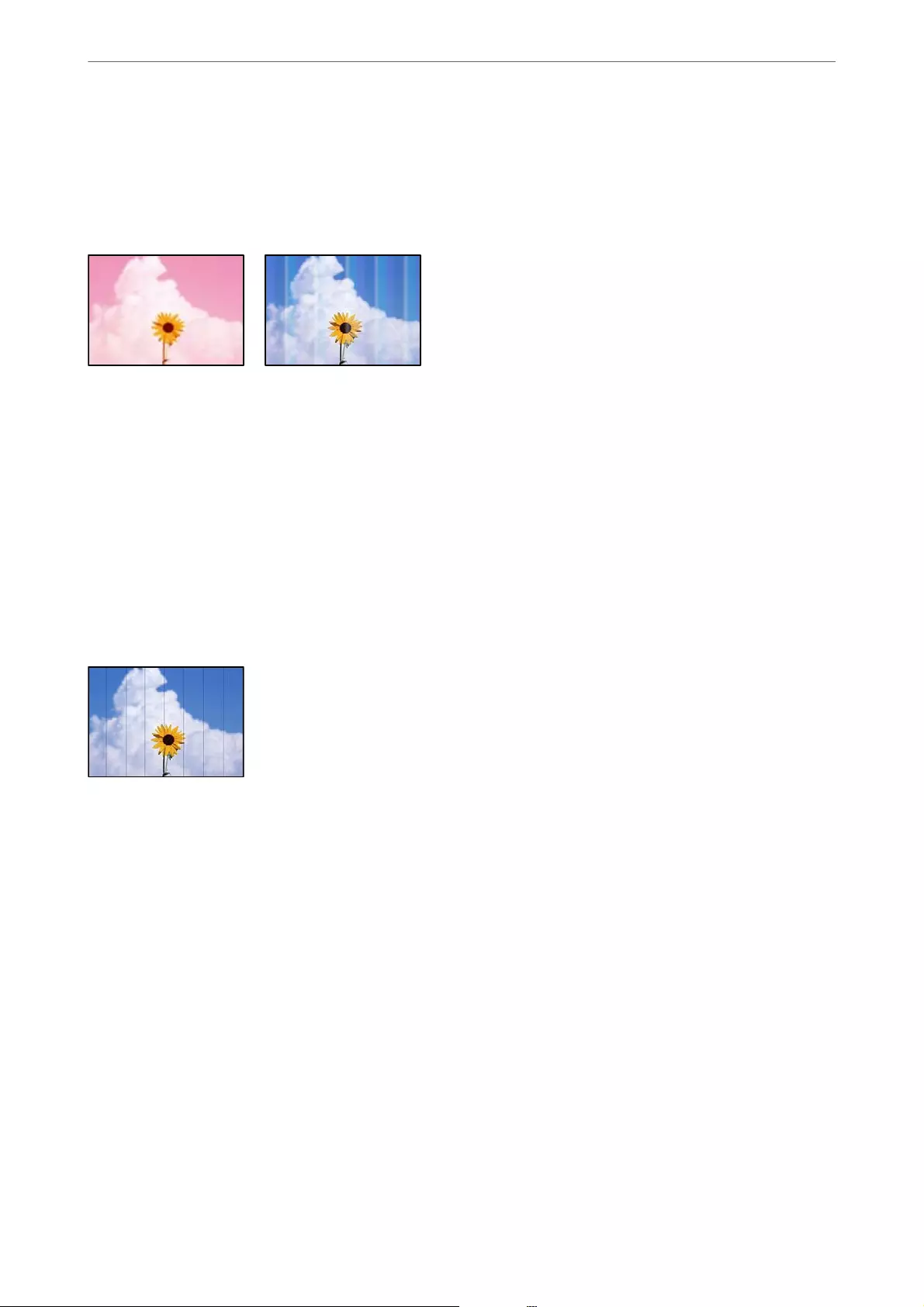
Copy Quality is Poor
Color Missing, Banding, or Unexpected Colors Appear in Copies
The print head nozzles may be clogged.
Perform a nozzle check using the Print Quality Adjustment feature to see if the print head nozzles are clogged.
Perform a nozzle check, and then clean the print head if any of the print head nozzles are clogged. If you have not
used the printer for a long time, the print head nozzles may be clogged and ink drops may not be discharged.
Related Information
&“Adjusting the Print Quality” on page 146
Colored Banding Appears at Intervals of Approximately 1.1 cm or 3.3 cm
e following causes can be considered.
The paper type setting does not match the paper loaded.
Select the appropriate paper type setting for the type of paper loaded in the printer.
Related Information
&“List of Paper Type” on page 31
The print head position is out of alignment.
Align the print head using the Print Quality Adjustment feature.
Related Information
&“Adjusting the Print Quality” on page 146
Solving Problems
>
Printing, Copying, Scanning, and Faxing Quality is Poor
>
Copy Quality is Poor
246
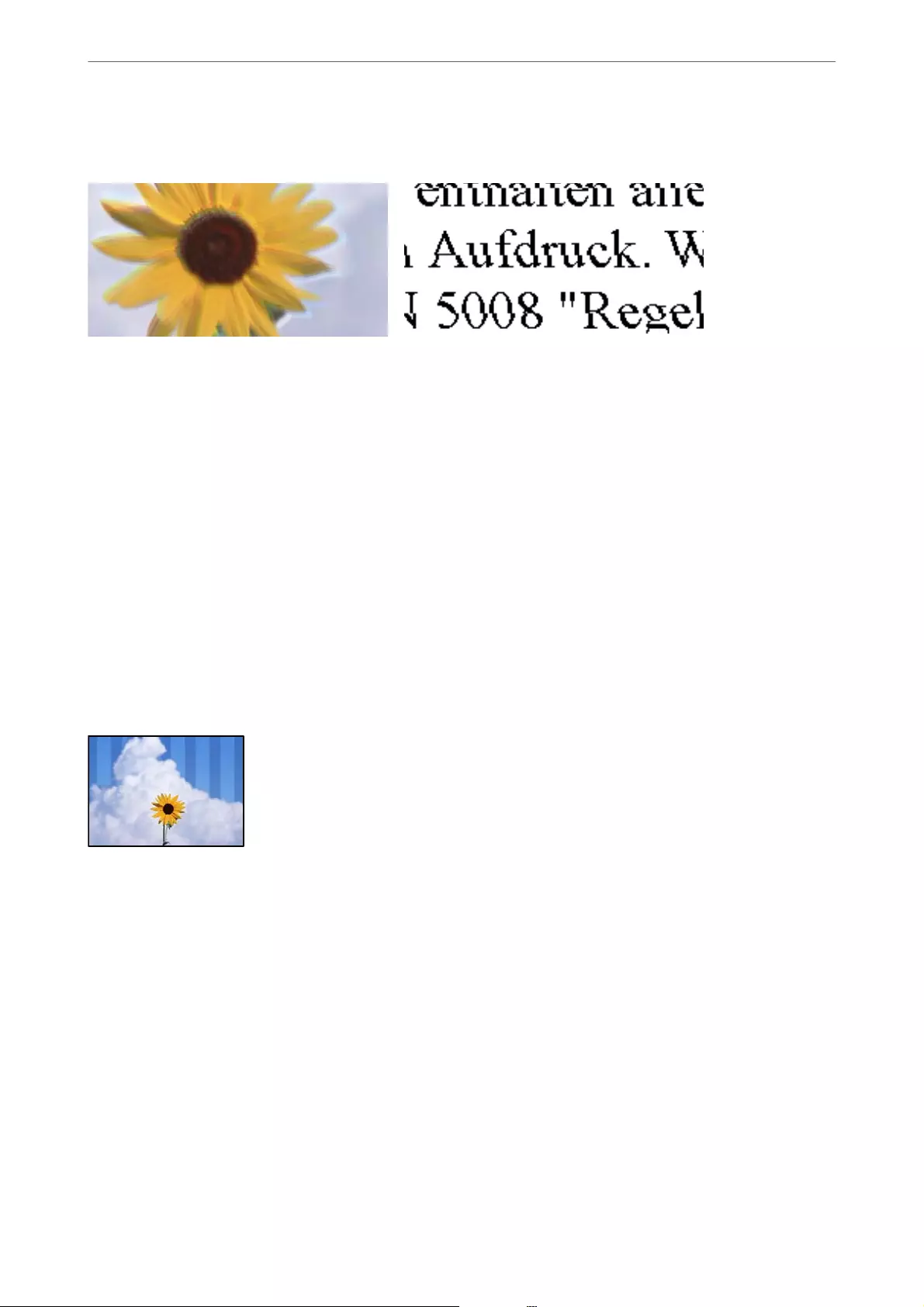
Blurry Copies, Vertical Banding, or Misalignment
e following causes can be considered.
The print head position is out of alignment.
Align the print head using the Print Quality Adjustment feature.
The bidirectional printing setting is enabled.
If print quality does not improve even aer aligning the print head, disable the bidirectional setting.
During bidirectional (or high speed) printing, the print head prints while moving in both directions, and vertical
lines may be misaligned. Disabling this setting may slow down printing speed but improve print quality.
Select Settings > General Settings > Printer Settings, and then disable Bidirectional on the control panel.
Striped Patterns Appear
The bidirectional printing setting is enabled.
When printing on plain paper, disable the bidirectional setting.
During bidirectional (or high speed) printing, the print head prints while moving in both directions, and vertical
lines may be misaligned. Disabling this setting may slow down printing speed but improve print quality.
Select Settings > General Settings > Printer Settings, and then disable Bidirectional on the control panel.
Solving Problems
>
Printing, Copying, Scanning, and Faxing Quality is Poor
>
Copy Quality is Poor
247
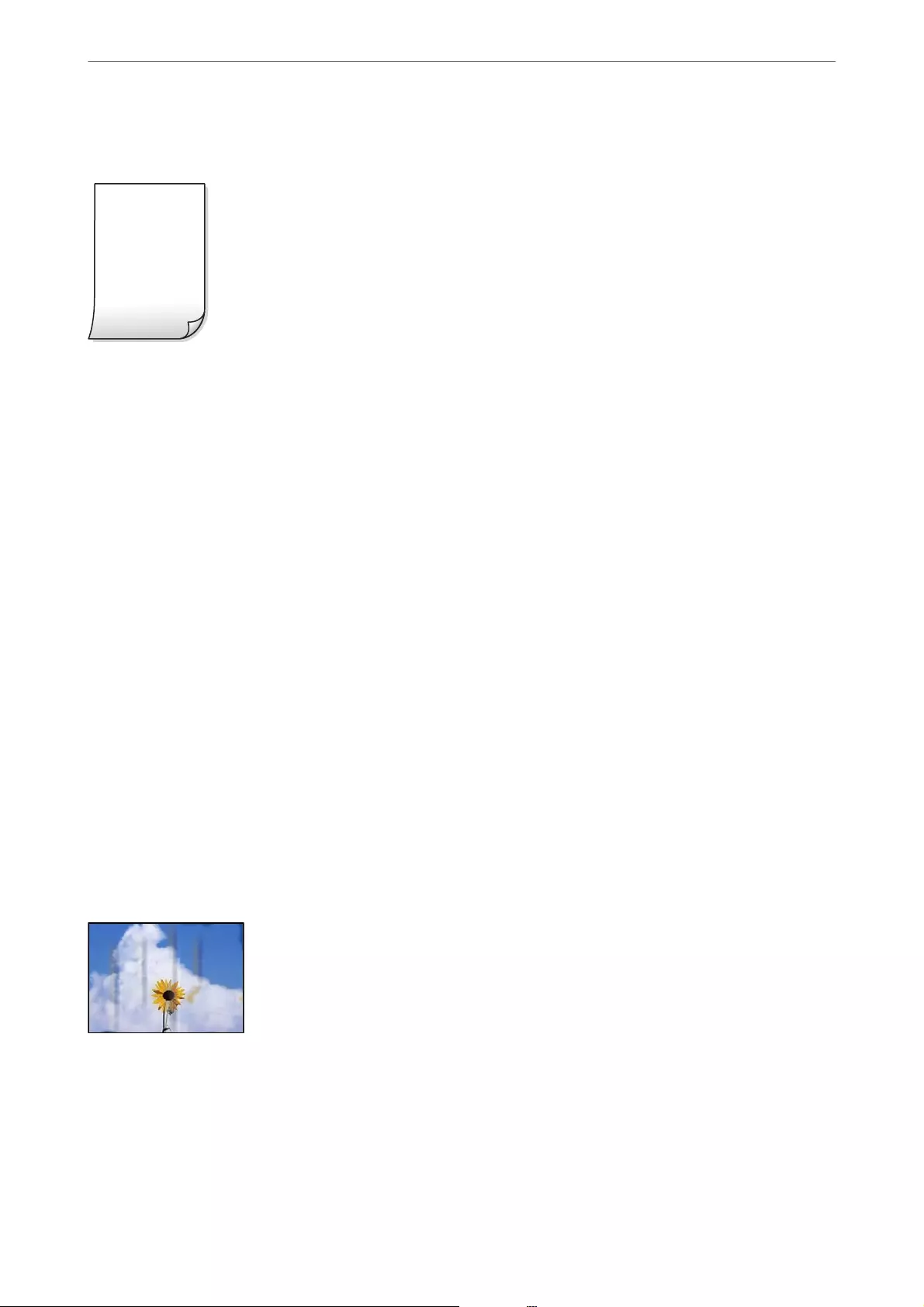
Printout Comes Out as a Blank Sheet
The print head nozzles may be clogged.
Perform a nozzle check using the Print Quality Adjustment feature to see if the print head nozzles are clogged.
Perform a nozzle check, and then clean the print head if any of the print head nozzles are clogged. If you have not
used the printer for a long time, the print head nozzles may be clogged and ink drops may not be discharged.
Related Information
&“Adjusting the Print Quality” on page 146
The print settings and the paper size loaded in the printer are dierent.
Change the print settings according to the paper size loaded in the paper cassette. Load paper in the paper cassette
that matches the print settings.
Multiple sheets of paper are fed into the printer at the same time.
See the following to prevent multiple sheets of paper being fed into the printer at the same time.
Related Information
&“Several Sheets of Paper are Fed at a Time” on page 172
Paper Is Smeared or Scued
e following causes can be considered.
Paper is loaded incorrectly.
When horizontal banding (perpendicular to the printing direction) appears, or the top or bottom of the paper is
smeared, load paper in the correct direction and slide the edge guides to the edges of the paper.
Solving Problems
>
Printing, Copying, Scanning, and Faxing Quality is Poor
>
Copy Quality is Poor
248
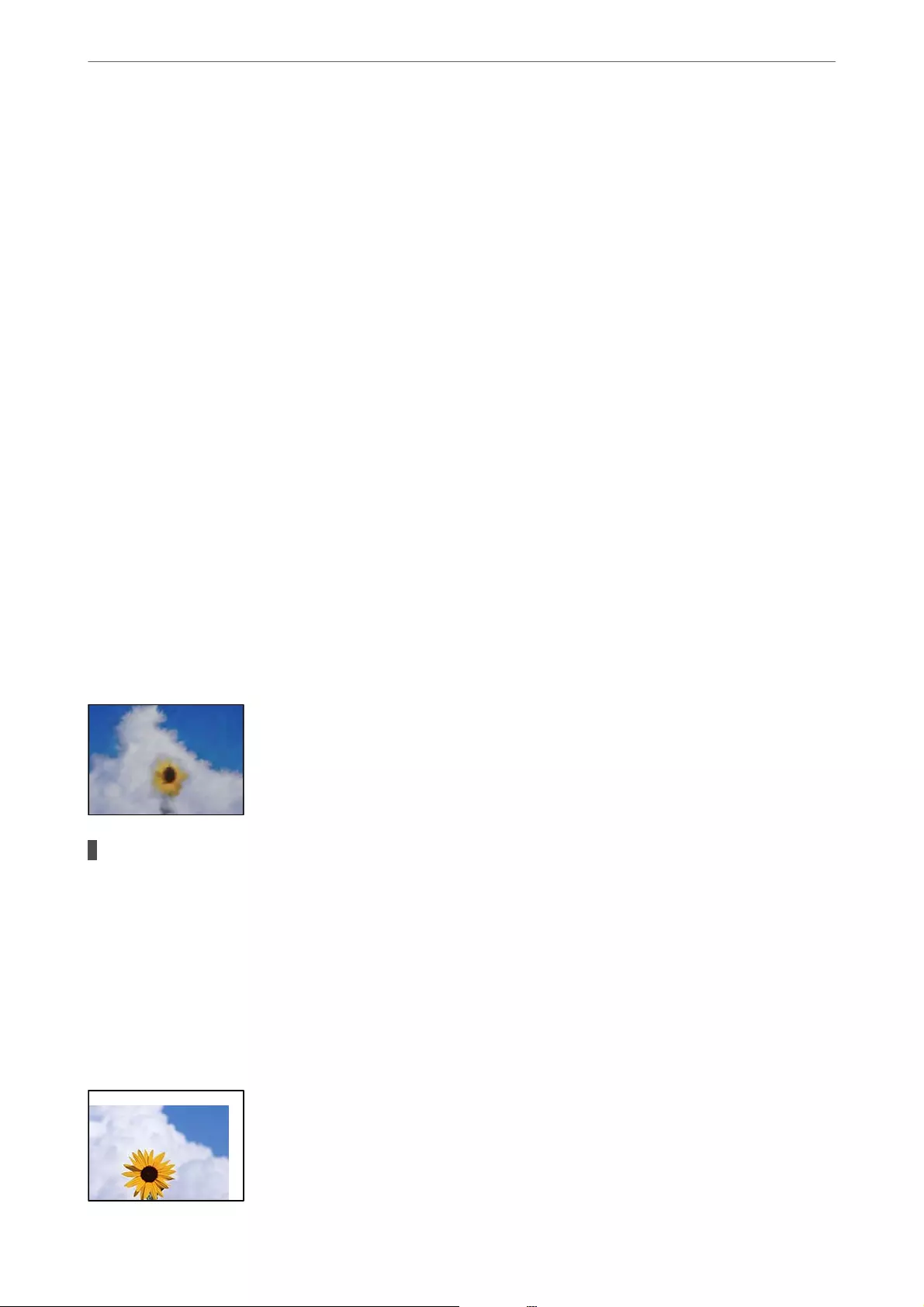
Related Information
&“Loading Paper” on page 31
The paper path is smeared.
When vertical banding (horizontal to the printing direction) appears, or the paper is smeared, clean the paper
path.
Related Information
&“Cleaning the Paper Path for Ink Smears” on page 151
The paper is curled.
Place the paper on a at surface to check if it is curled. If it is, atten it.
The printhead is rubbing the surface of the paper.
When copying on thick paper, the print head is close to the printing surface and the paper may be scued. In this
case, enable the reduce scu setting.
Select Settings > General Settings > Printer Settings, and then enable ick Paper on the control panel. If you
enable this setting, copy quality may decline or may slow down.
Copied Photos are Sticky
The copy was made on the wrong side of the photo paper.
Solutions
Make sure you are copying on the printable side. If you have accidentally copied on the wrong side of the
photo paper, you need to clean the paper path.
&“Loading Paper” on page 31
&“Cleaning the Paper Path for Ink Smears” on page 151
The Position, Size, or Margins of the Copies are Incorrect
Solving Problems
>
Printing, Copying, Scanning, and Faxing Quality is Poor
>
Copy Quality is Poor
249

e following causes can be considered.
The paper is loaded incorrectly.
Load paper in the correct direction, and slide the edge guide against the edge of the paper.
Related Information
&“Loading Paper” on page 31
The size of the paper is set incorrectly.
Select the appropriate paper size setting.
The originals are not placed correctly.
❏Make sure the original is placed correctly against the alignment marks.
❏If the edge of the scanned image is missing, move the original slightly away from the edge of the scanner glass.
You cannot scan the area within approximately 1.5 mm (0.06 in.) from the edge of the scanner glass.
Related Information
&“Placing Originals” on page 35
There is dust or dirt on the scanner glass or document mat.
When scanning from the control panel and selecting the auto scan area cropping function, remove any trash or
dirt from the scanner glass and document mat. If there is any trash or dirt around the original, the scanning range
expands to include it.
Related Information
&“Cleaning the Scanner Glass” on page 151
&“Cleaning the Scanner Glass” on page 151
Original Size is wrong in copy setting.
Select the appropriate Original Size in the copy setting.
Related Information
&“Advanced Menu Options for Copying” on page 88
If the printer is placed in a location near a light source or subjected to direct sunlight, the original
size may not be detected correctly.
Select the original size manually, and then try again.
Solving Problems
>
Printing, Copying, Scanning, and Faxing Quality is Poor
>
Copy Quality is Poor
250
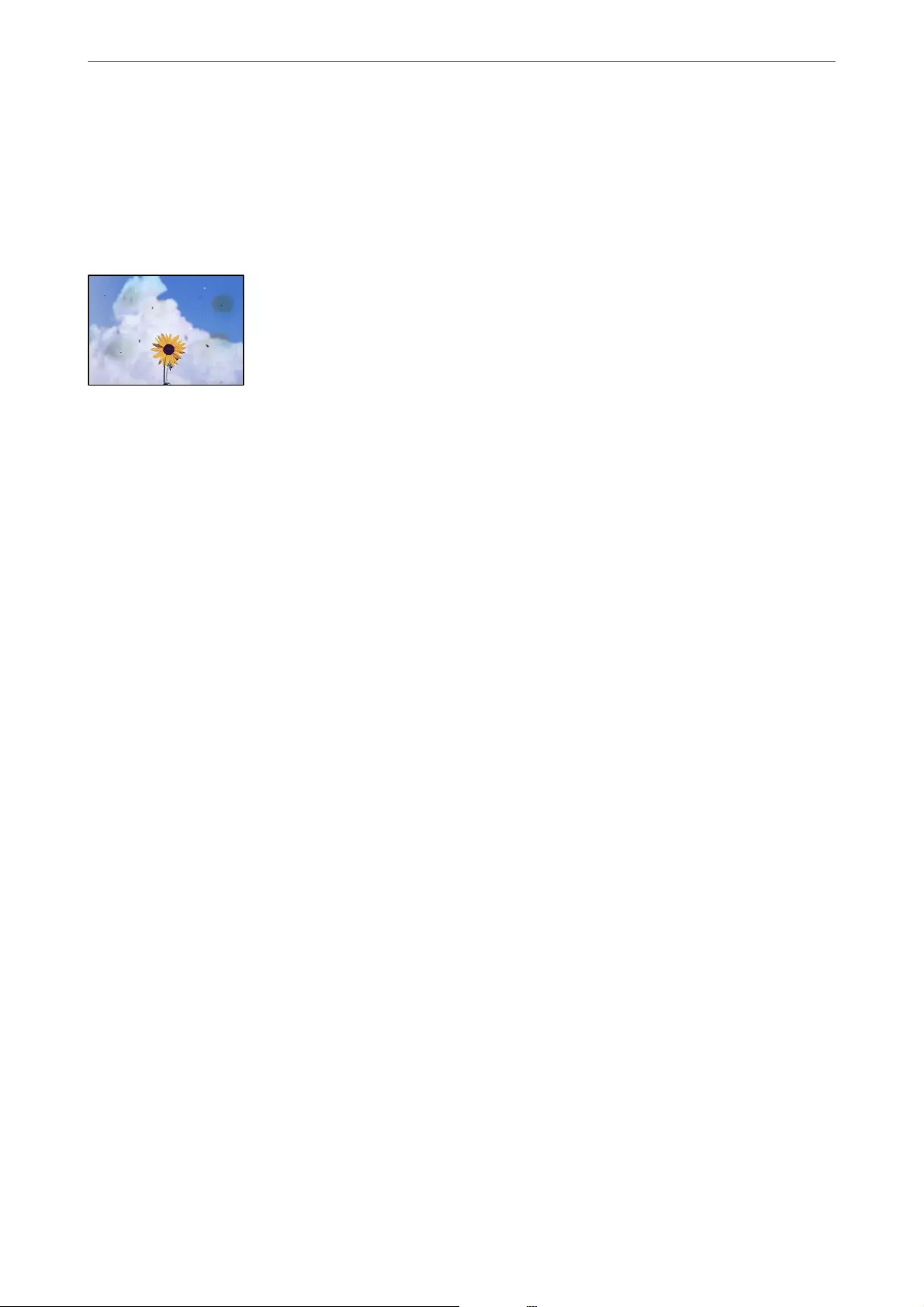
Original is too thin to detect the size automatically.
Select the original size manually, and then try again.
Uneven Colors, Smears, Dots, or Straight Lines Appear in the Copied Image
e following causes can be considered.
The paper path is dirty.
Load and eject paper without printing to clean the paper path.
Related Information
&“Cleaning the Paper Path for Ink Smears” on page 151
There is dust or dirt on the originals or the scanner glass.
Remove any dust or dirt that adheres to the originals, and clean the scanner glass.
Related Information
&“Cleaning the Scanner Glass” on page 151
There is dust or dirt on the ADF or originals.
Clean the ADF, and remove any dust or dirt that adheres to the originals.
Related Information
&“Cleaning the ADF” on page 152
The original was pressed with too much force.
If you press with too much force, blurring, smudges, and spots may occur.
Do not press with too much force on the original or the document cover.
Related Information
&“Placing Originals” on page 35
Solving Problems
>
Printing, Copying, Scanning, and Faxing Quality is Poor
>
Copy Quality is Poor
251
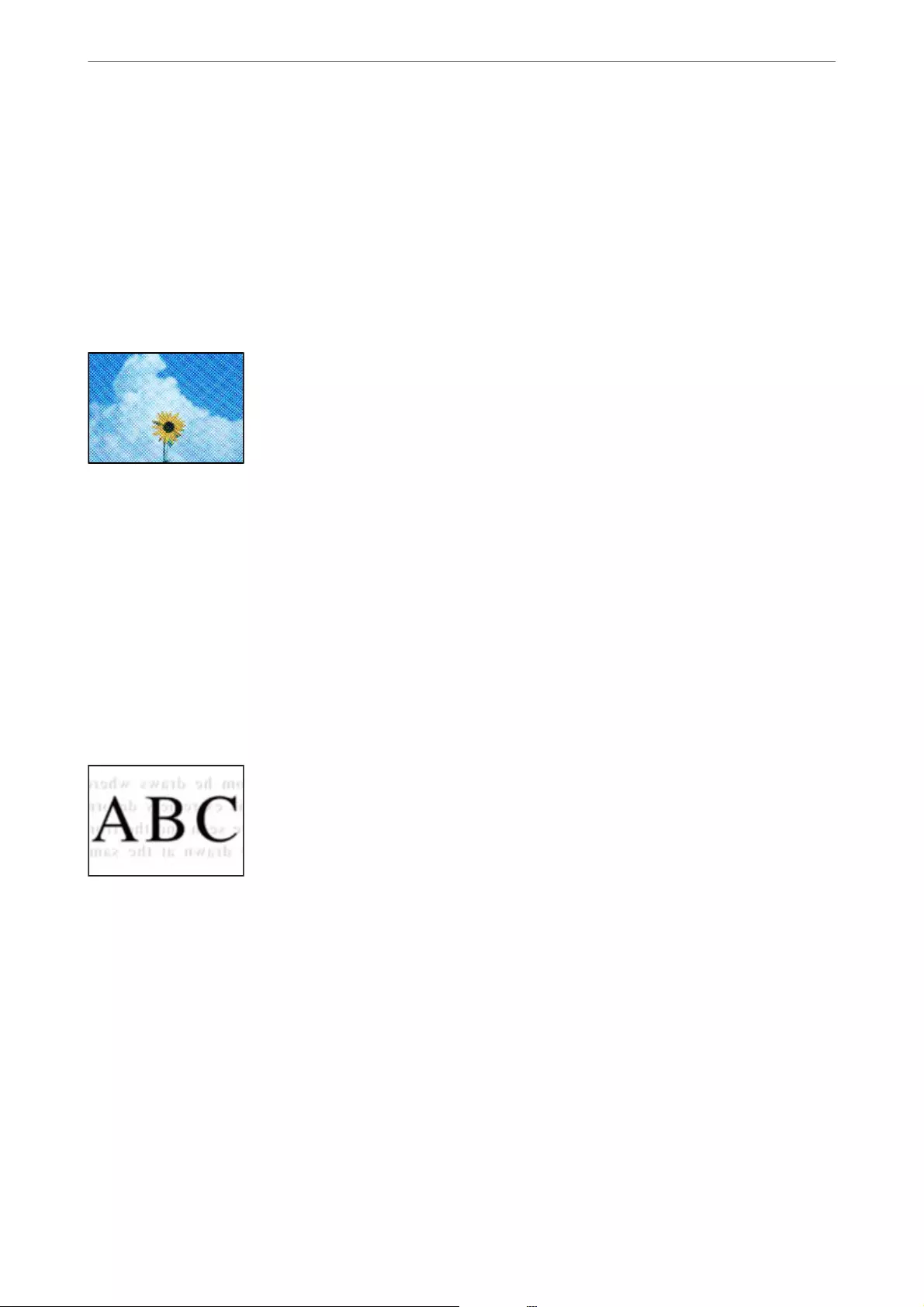
The copy density setting is too high.
Lower the copy density setting.
Related Information
&“Basic Menu Options for Copying” on page 86
Moiré (Cross-Hatch) Patterns Appear in the Copied Image
If the original is a printed document such as a magazine or a catalog, a dotted moiré pattern
appears.
Change the reduce and enlarge setting. If a moiré pattern still appears, place the original at a slightly dierent
angle.
Related Information
&“Basic Menu Options for Copying” on page 86
An Image of the Reverse Side of the Original Appears in the Copied Image
e following causes can be considered.
When scanning thin originals, images on the back may be scanned at the same time.
Place the original on the scanner glass and then place a piece of black paper over it.
Related Information
&“Placing Originals” on page 35
The copy density setting is too high.
Lower the copy density setting.
Solving Problems
>
Printing, Copying, Scanning, and Faxing Quality is Poor
>
Copy Quality is Poor
252
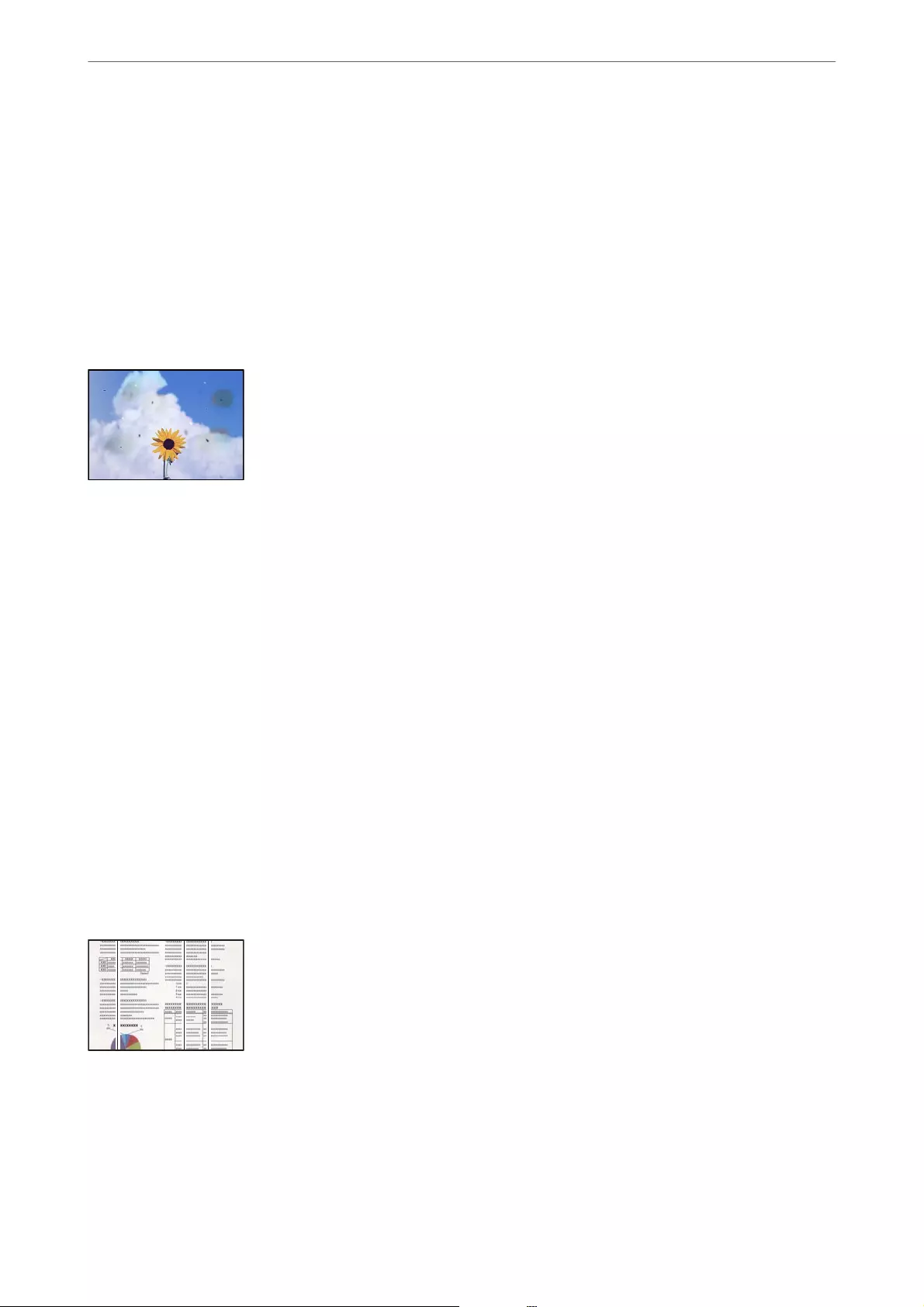
Related Information
&“Basic Menu Options for Copying” on page 86
Scanned Image Problems
Uneven Colors, Dirt, Spots, and so on Appear when Scanning from the
Scanner Glass
There is dust or dirt on the originals or the scanner glass.
Remove any dust or dirt that adheres to the originals, and clean the scanner glass.
Related Information
&“Cleaning the Scanner Glass” on page 151
The original was pressed with too much force.
If you press with too much force, blurring, smudges, and spots may occur.
Do not press with too much force on the original or the document cover.
Related Information
&“Placing Originals” on page 35
Straight Lines Appear when Scanning from ADF
There is dust or dirt on the ADF or originals.
Clean the ADF, and remove any dust or dirt that adheres to the originals.
Solving Problems
>
Printing, Copying, Scanning, and Faxing Quality is Poor
>
Scanned Image Problems
253
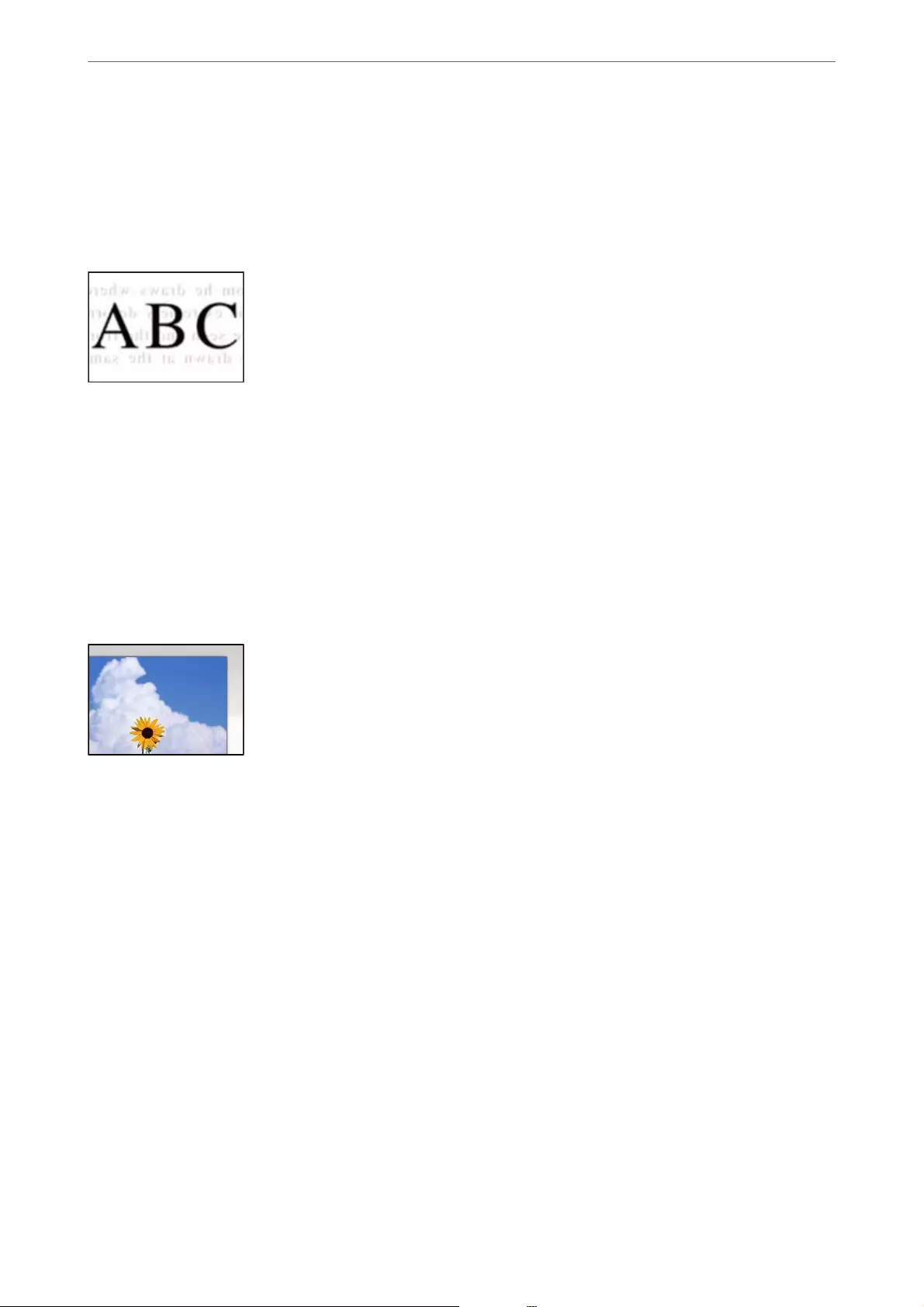
Related Information
&“Cleaning the ADF” on page 152
Oset Appears in the Background of Scanned Images
When scanning thin originals, images on the back may be scanned at the same time.
When scanning from the scanner glass, place black paper or a desk pad over the original.
Related Information
&“Placing Originals” on page 35
Cannot Scan the Correct Area on the Scanner Glass
The originals are not placed correctly.
❏Make sure the original is placed correctly against the alignment marks.
❏If the edge of the scanned image is missing, move the original slightly away from the edge of the scanner glass.
You cannot scan the area within approximately 1.5 mm (0.06 in.) from the edge of the scanner glass.
Related Information
&“Placing Originals” on page 35
If the printer is placed in a location near a light source or subjected to direct sunlight, the original
size may not be detected correctly.
Select the original size manually, and then try again.
There is dust or dirt on the scanner glass or document mat.
When scanning from the control panel and selecting the auto scan area cropping function, remove any trash or
dirt from the scanner glass and document mat. If there is any trash or dirt around the original, the scanning range
expands to include it.
Solving Problems
>
Printing, Copying, Scanning, and Faxing Quality is Poor
>
Scanned Image Problems
254

Related Information
&“Cleaning the Scanner Glass” on page 151
&“Cleaning the Scanner Glass” on page 151
Original is too thin to detect the size automatically.
Select the original size manually, and then try again.
Cannot Solve Problems in the Scanned Image
Check the following if you have tried all of the solutions and have not solved the problem.
There are problems with the scanning software settings.
Use Epson Scan 2 Utility to initialize the settings for the scanner soware.
Note:
Epson Scan 2 Utility is an application supplied with the scanner soware.
1. Start the Epson Scan 2 Utility.
❏Windows 10
Click the start button, and then select EPSON > Epson Scan 2 Utility.
❏Windows 8.1/Windows 8
Enter the application name in the search charm, and then select the displayed icon.
❏Windows 7/Windows Vista/Windows XP
Click the start button, and then select All Programs or Programs > EPSON > Epson Scan 2 > Epson Scan
2 Utility.
❏Mac OS
Select Go > Applications > Epson Soware > Epson Scan 2 Utility.
2. Select the Other tab.
3. Click Reset.
If initialization does not solve the problem, uninstall and re-install the scanner soware.
Related Information
&“Installing the Applications Separately” on page 157
Solving Problems
>
Printing, Copying, Scanning, and Faxing Quality is Poor
>
Scanned Image Problems
255
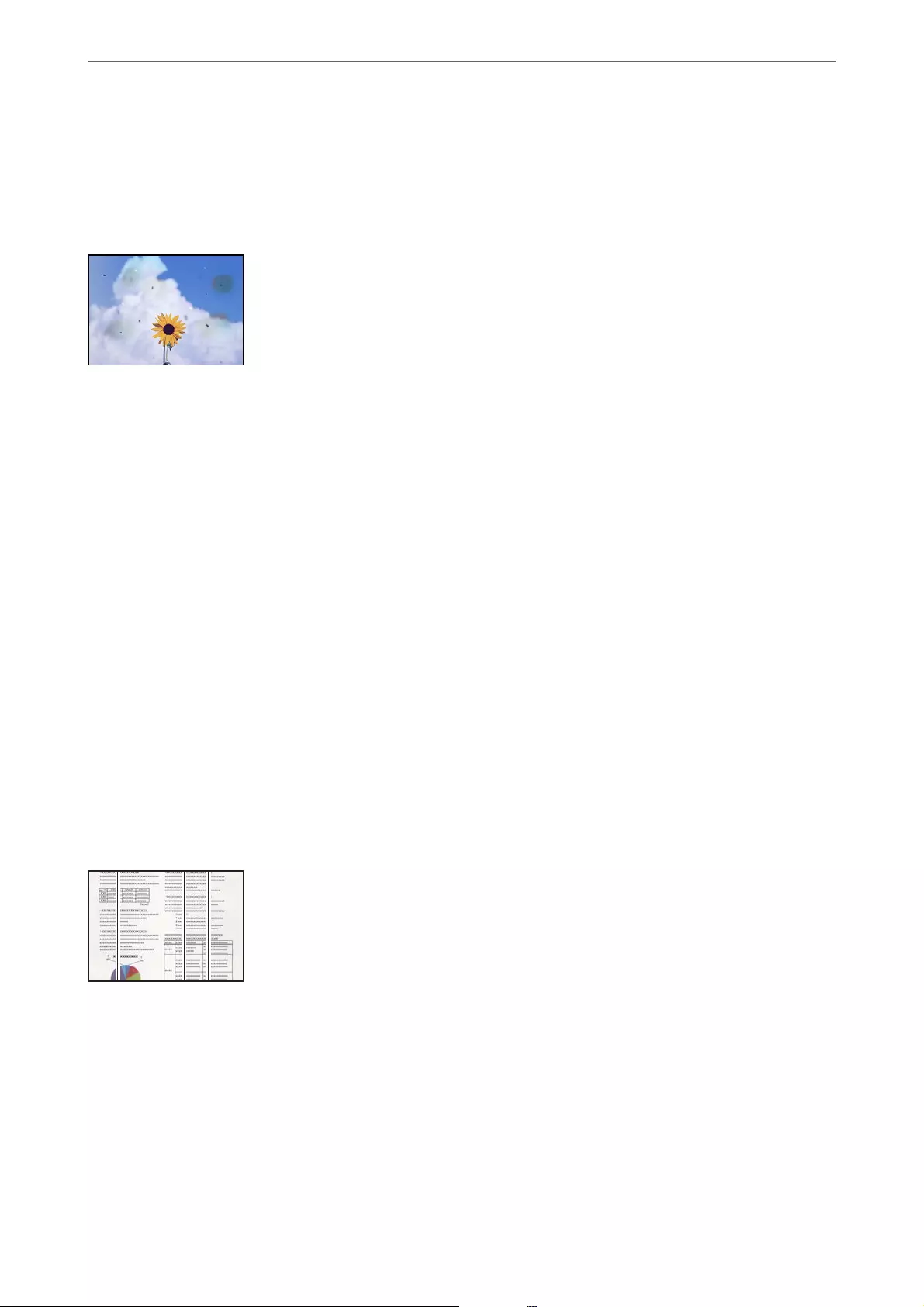
The Quality of the Sent Fax is Poor
Quality of the Sent Fax is Poor
e following causes can be considered.
There is dust or dirt on the originals or the scanner glass.
Remove any dust or dirt that adheres to the originals, and clean the scanner glass.
Related Information
&“Cleaning the Scanner Glass” on page 151
The original was pressed with too much force.
If you press with too much force, blurring, smudges, and spots may occur.
Do not press with too much force on the original or the document cover.
Related Information
&“Placing Originals” on page 35
Straight Lines Appear when Sending Faxes from the ADF
e following causes can be considered.
There is dust or dirt on the ADF or originals.
Clean the ADF, and remove any dust or dirt that adheres to the originals.
Related Information
&“Cleaning the ADF” on page 152
Solving Problems
>
Printing, Copying, Scanning, and Faxing Quality is Poor
>
The Quality of the Sent Fax is Poor
256
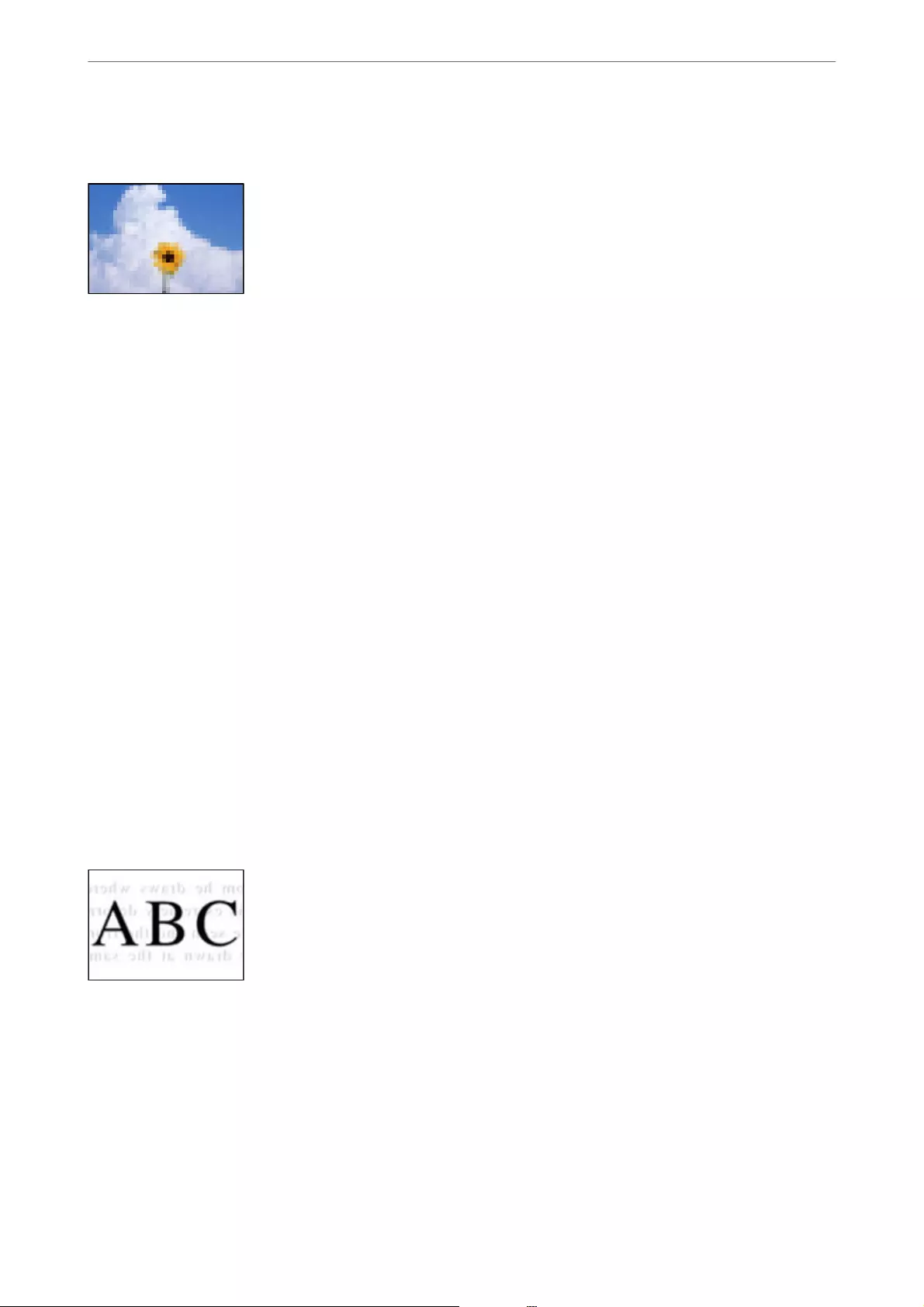
The Iimage Quality of the Sent Fax is Poor
e following causes can be considered.
The Original Type setting is wrong.
Select Fax > Fax Settings > Scan Settings > Original Type, and then change the setting. When the original you are
sending contains text and images, set this to Photo.
The resolution is set to low.
If you do not know the performance of the sender’s fax machine, set the following before sending a fax.
❏Select Fax > Fax Settings and then make the Resolution setting to set the highest quality image.
❏Select Fax > Fax Settings and then enable Direct Send.
Note that if you set Resolution to Super Fine or Ultra Fine but you send the fax without enabling Direct Send,
the fax may be sent at a lower resolution.
ECM setting is disabled.
Select Settings > General Settings > Fax Settings > Basic Settings and enable the ECM setting on the control
panel. is may clear errors that occur due to connection problems. Note that the speed of sending and receiving
faxes may be slower than when ECM is disabled.
An Image of the Reverse Side of the Original Appears in the Sent Fax
e following causes can be considered.
When scanning thin originals, images on the back may be scanned at the same time.
Place the original on the scanner glass and then place a piece of black paper over it.
Related Information
&“Placing Originals” on page 35
Solving Problems
>
Printing, Copying, Scanning, and Faxing Quality is Poor
>
The Quality of the Sent Fax is Poor
257
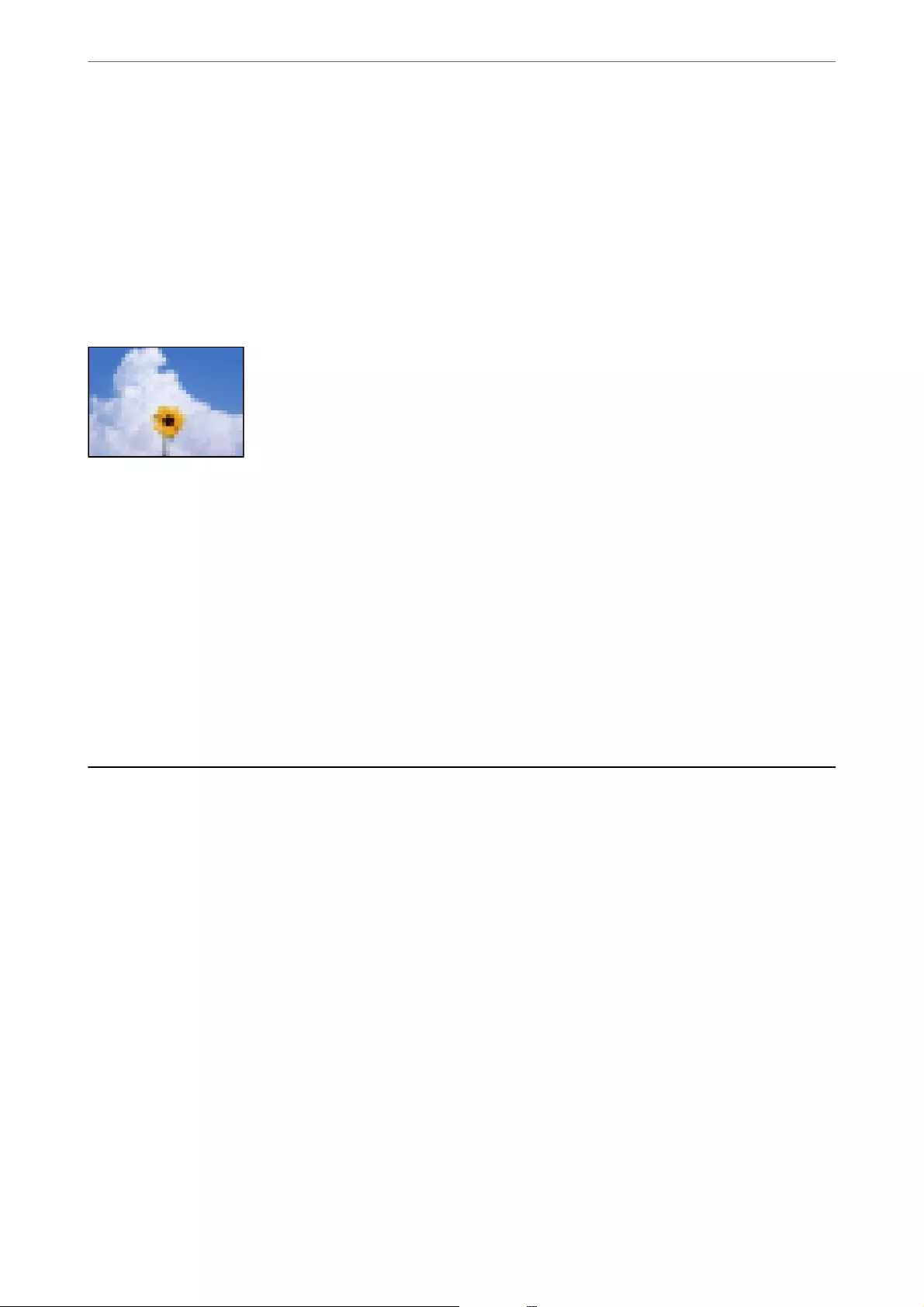
The density setting is high when sending faxes.
Select Fax > Fax Settings > Scan Settings > Density, and then lower the setting.
Received Fax Quality is Poor
The Image Quality of Received Faxes is Poor
e following causes can be considered.
ECM setting is disabled.
Select Settings > General Settings > Fax Settings > Basic Settings and enable the ECM setting on the control
panel. is may clear errors that occur due to connection problems. Note that the speed of sending and receiving
faxes may be slower than when ECM is disabled.
The image quality setting is low on the sender's fax machine.
Ask the sender to send faxes at a higher quality.
Cannot Solve Problem After Trying All Solutions
If you cannot solve the problem aer trying all of the solutions, contact Epson support.
If you cannot solve printing or copying problems, see the following related information.
Related Information
&“Cannot Solve Printing or Copying Problems” on page 258
Cannot Solve Printing or Copying Problems
Try the following problems in order starting at the top until you solve the problem.
❏Make sure you match the paper type loaded in the printer and the paper type set on the printer to the paper
type settings in the printer driver.
“Paper Size and Type Settings” on page 30
❏Use a higher quality setting on the control panel or the printer driver.
❏Align the print head.
“Aligning the Print Head (Control Panel)” on page 150
Solving Problems
>
Cannot Solve Problem After Trying All Solutions
>
Cannot Solve Printing or Copying Problems
258

❏Run a nozzle check to see if the print head nozzles are clogged.
If there are missing segments in the nozzle check pattern, the nozzles may be clogged. Repeat head cleaning and
the nozzle check alternately 3 times and check if the clogging has cleared.
Note that print head cleaning uses some ink.
“Checking and Cleaning the Print Head” on page 147
❏Turn o the printer, wait for at least 12 hours, and then check if the clogging has cleared.
If the problem is clogging, leaving the printer for a while without printing may solve the problem.
You can check the following items while the printer is o.
❏Check that you are using genuine Epson ink bottles.
Try to use genuine Epson ink bottles. e use of non-genuine ink bottles may cause print quality to decline.
❏Make sure that there are no paper fragments le inside the printer.
When you remove the paper, do not touch the translucent lm with your hand or the paper.
❏Check the paper.
Check if the paper is curled or loaded with the printable side facing up.
“Paper Handling Precautions” on page 30
“Available Paper and Capacities” on page 289
“Unavailable Paper Types” on page 294
❏If you turn o the printer, wait for at least 12 hours, and if print quality has still not improved, run Power
Cleaning.
“Running Power Cleaning” on page 148
If you cannot solve the problem by checking the solutions above, you may need to request repairs. Contact Epson
support.
Related Information
&“Before Contacting Epson” on page 457
&“Contacting Epson Support” on page 457
Solving Problems
>
Cannot Solve Problem After Trying All Solutions
>
Cannot Solve Printing or Copying Problems
259

Adding or Replacing the Computer or
Devices
Connecting to a Printer that has been Connected to the Network...............261
Re-setting the Network Connection....................................262
Connecting a Smart Device and Printer Directly (Wi-Fi Direct)................268
Checking the Network Connection Status................................279
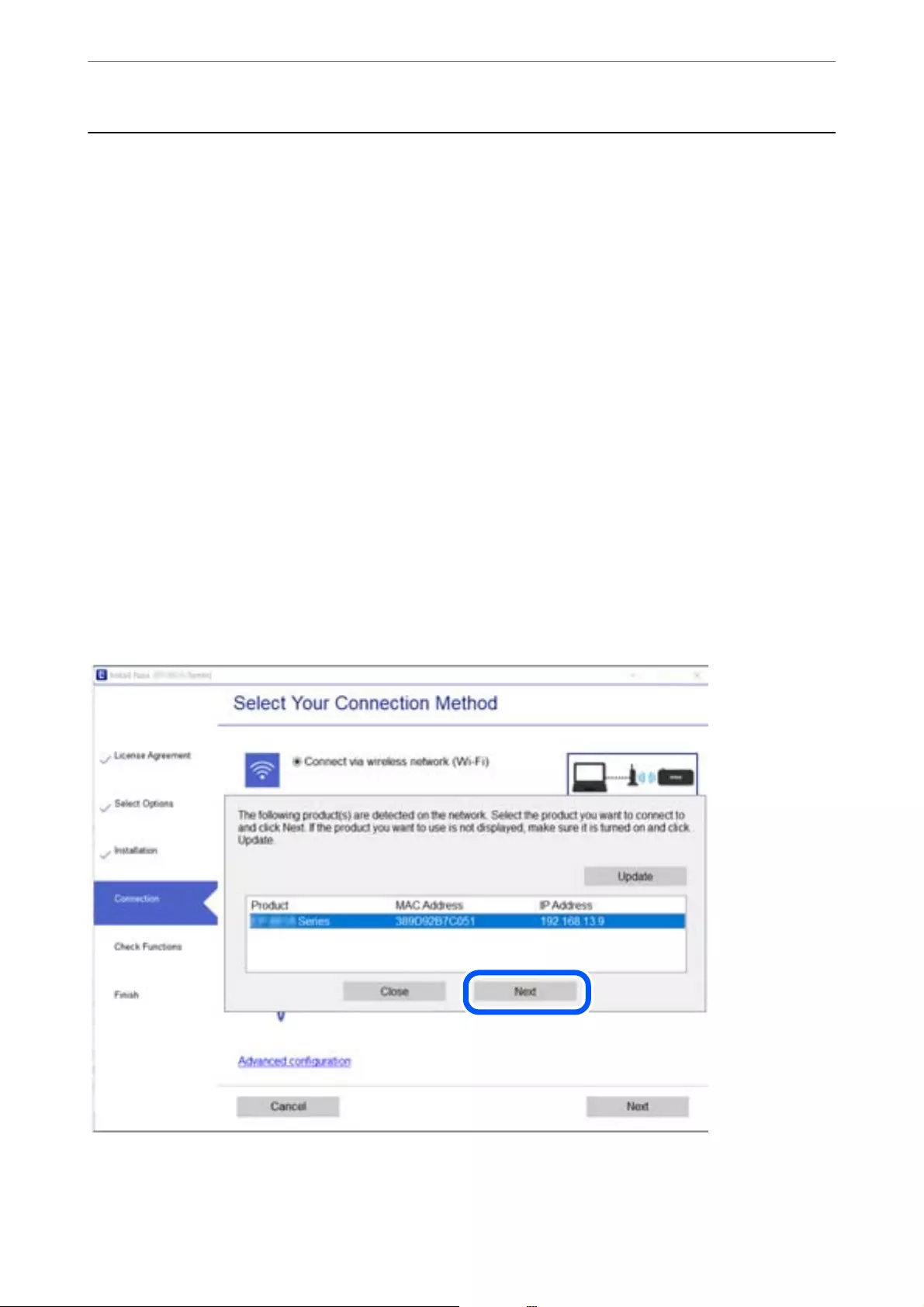
Connecting to a Printer that has been Connected to
the Network
When the printer has already been connected to the network, you can connect a computer or a smart device to the
printer over the network.
Using a Network Printer from a Second Computer
We recommend using the installer to connect the printer to a computer. You can run the installer using one of the
following methods.
❏Setting up from the website
Access the following website, and then enter the product name. Go to Setup, and then start setting up.
http://epson.sn
❏Setting up using the soware disc (only for the models that come with a soware disc and users with Windows
computers with disc drives.)
Insert the soware disc into the computer, and then follow the on-screen instructions.
Selecting the Printer
Follow the on-screen instructions until the following screen is displayed, select the printer name you want to
connect to, and then click Next.
Follow the on-screen instructions.
Adding or Replacing the Computer or Devices
>
Connecting to a Printer that has been Connected t
…
261
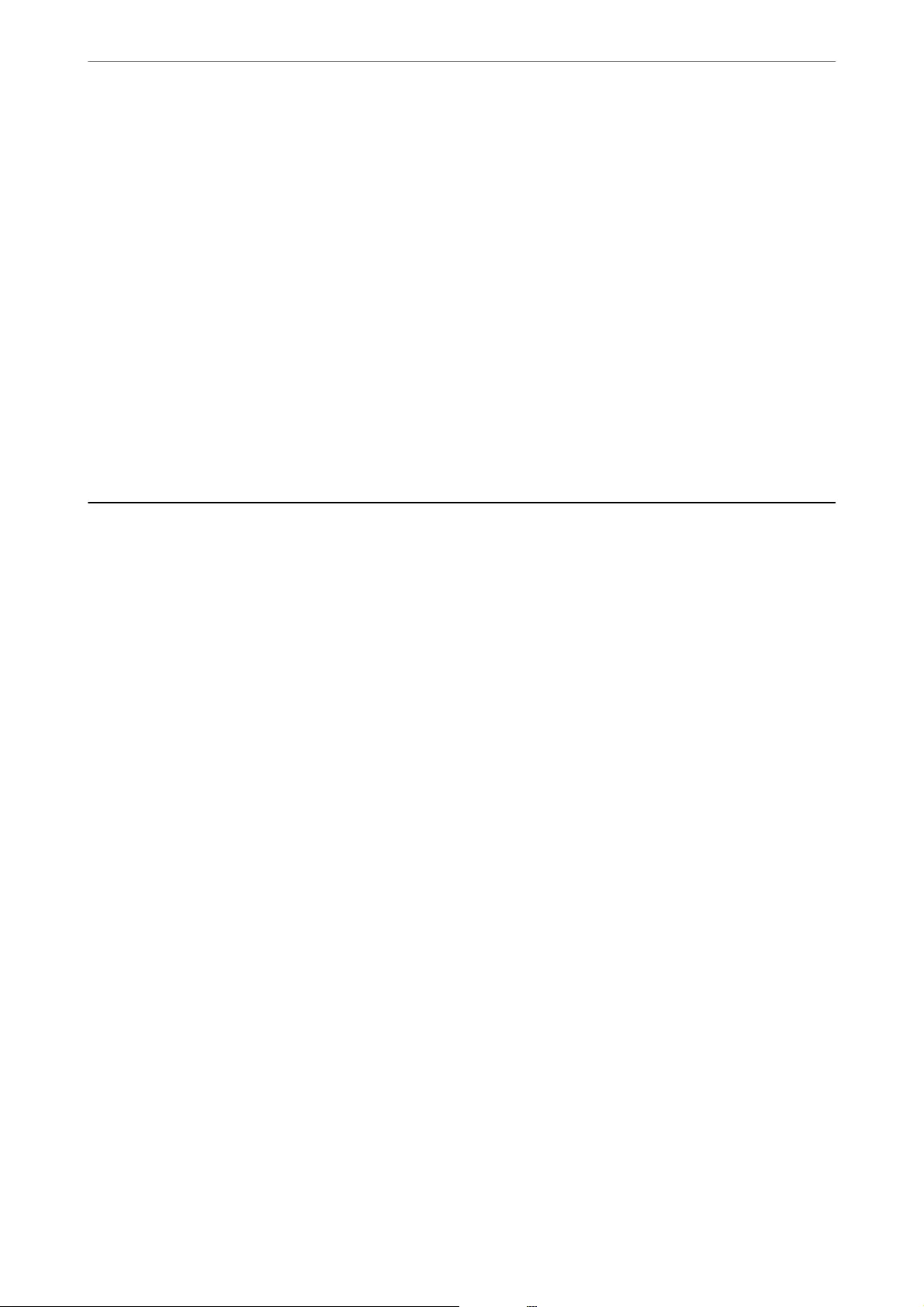
Using a Network Printer from a Smart Device
You can connect a smart device to the printer using one of the following methods.
Connecting over a wireless router
Connect the smart device to the same Wi-Fi network (SSID) as the printer.
See the following for more details.
“Making Settings for Connecting to the Smart Device” on page 263
Connecting by Wi-Fi Direct
Connect the smart device to the printer directly without a wireless router.
See the following for more details.
“Connecting a Smart Device and Printer Directly (Wi-Fi Direct)” on page 268
Re-setting the Network Connection
is section explains how to make the network connection settings and change the connection method when
replacing the wireless router or the computer.
When Replacing the Wireless Router
When you replace the wireless router, make settings for the connection between the computer or the smart device
and the printer.
You need to make these settings if you change your Internet service provider and so on.
Making Settings for Connecting to the Computer
We recommend using the installer to connect the printer to a computer. You can run the installer using one of the
following methods.
❏Setting up from the website
Access the following website, and then enter the product name. Go to Setup, and then start setting up.
http://epson.sn
❏Setting up using the soware disc (only for the models that come with a soware disc and users with Windows
computers with disc drives.)
Insert the soware disc into the computer, and then follow the on-screen instructions.
Selecting the Connection Methods
Follow the on-screen instructions until the following screen is displayed.
Adding or Replacing the Computer or Devices
>
Re-setting the Network Connection
>
When Repl
…
262
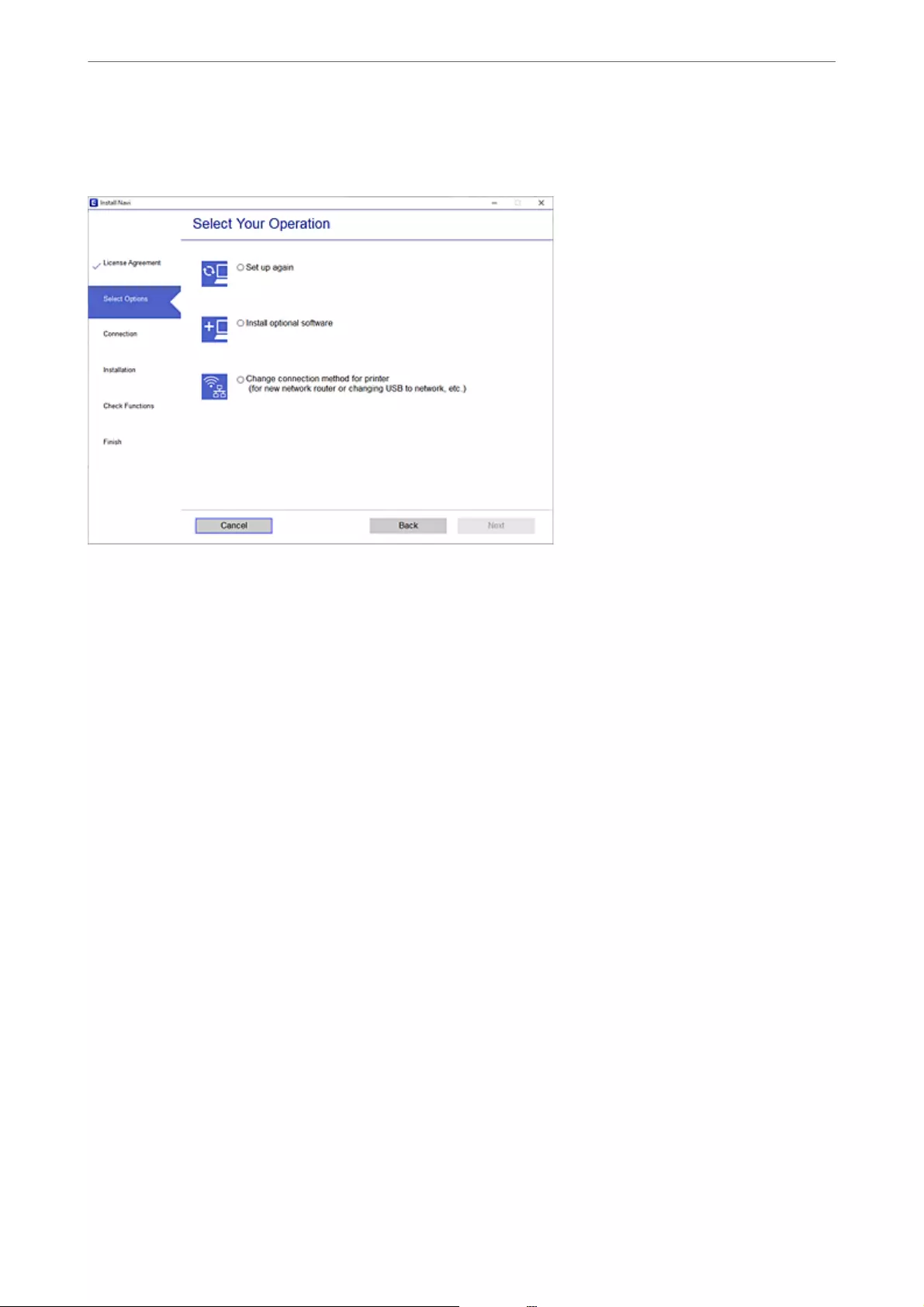
Select Change connection method for printer (for new network router or changing USB to network, etc.) on
the Select Your Operation screen, and then click Next.
Follow the on-screen instructions.
If you cannot connect, see the following to try to solve the problem.
❏Windows: “Cannot connect to a Network” on page 175
❏Mac OS: “Cannot connect to a Network” on page 183
Making Settings for Connecting to the Smart Device
You can use the printer from a smart device when you connect the printer to the same Wi-Fi network (SSID) as the
smart device. To use the printer from a smart device, set up from the following website. Access to the website from
the smart device that you want to connect to the printer.
http://epson.sn > Setup
When Changing the Computer
When changing the computer, make connection settings between the computer and the printer.
Making Settings for Connecting to the Computer
We recommend using the installer to connect the printer to a computer. You can run the installer using one of the
following methods.
❏Setting up from the website
Access the following website, and then enter the product name. Go to Setup, and then start setting up.
http://epson.sn
Adding or Replacing the Computer or Devices
>
Re-setting the Network Connection
>
When Chan
…
263

❏Setting up using the soware disc (only for the models that come with a soware disc and users with Windows
computers with disc drives.)
Insert the soware disc into the computer, and then follow the on-screen instructions.
Follow the on-screen instructions.
Changing the Connection Method to the Computer
is section explains how to change the connection method when the computer and the printer have been
connected.
Changing the Network Connection from Ethernet to Wi-Fi
Change the Ethernet connection to Wi-Fi connection from the printer's control panel. e changing connection
method is basically the same as the Wi-Fi connection settings.
Related Information
&“Making Wi-Fi Settings from the Control Panel” on page 266
Changing the Network Connection from Wi-Fi to Ethernet
Follow the steps below to change from a Wi-Fi connection to an Ethernet connection.
1. Select Settings on the home screen.
2. Select General Settings > Network Settings > Wired LAN Setup.
3. Follow the on-screen instructions.
Changing from USB to a Network Connection
Using the installer and re-set up in a dierent connection method.
❏Setting up from the website
Access the following website, and then enter the product name. Go to Setup, and then start setting up.
http://epson.sn
❏Setting up using the soware disc (only for the models that come with a soware disc and users with Windows
computers with disc drives.)
Insert the soware disc into the computer, and then follow the on-screen instructions.
Selecting Change the Connection Methods
Follow the on-screen instructions until the following screen is displayed.
Adding or Replacing the Computer or Devices
>
Re-setting the Network Connection
>
Changing t
…
264
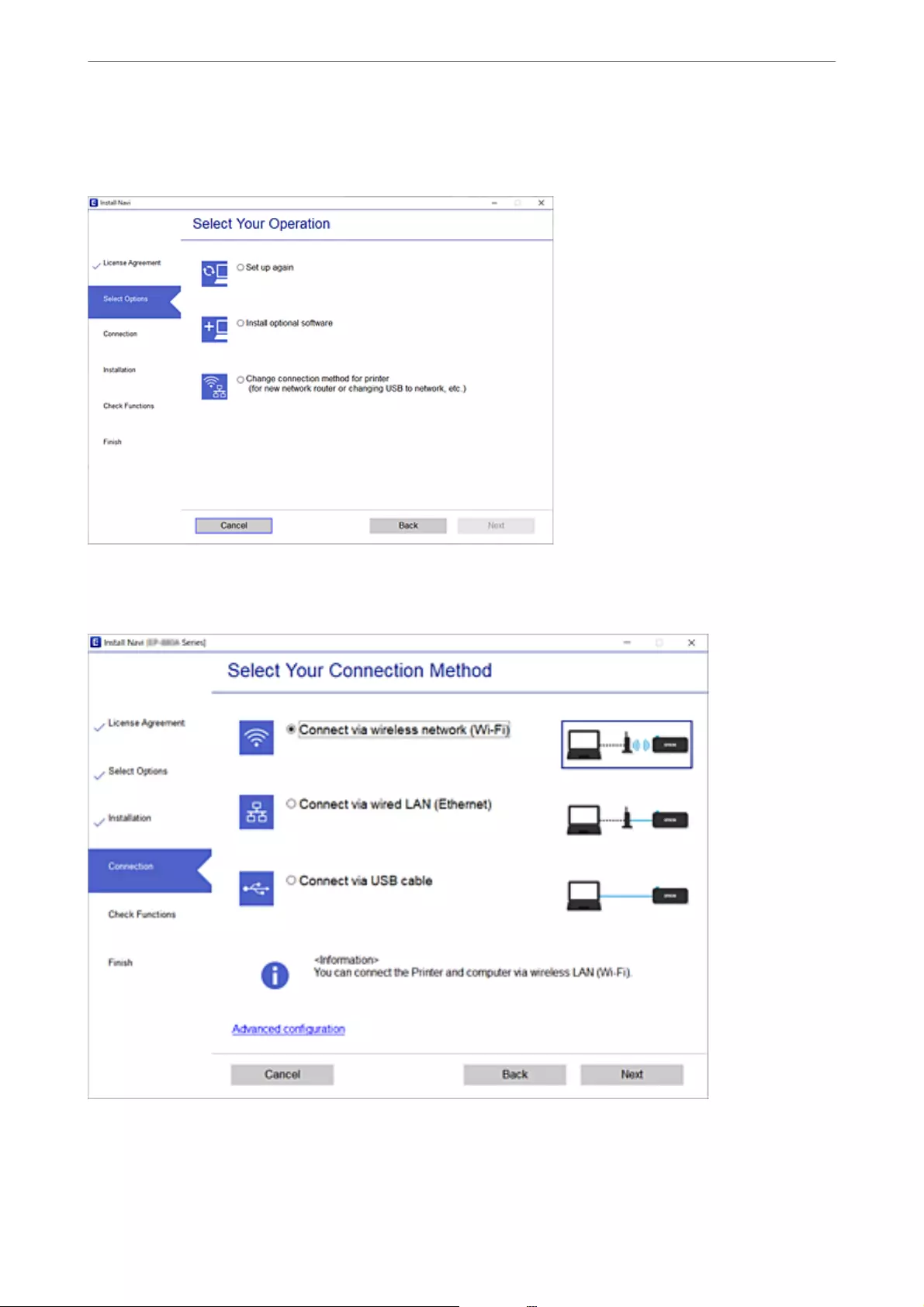
Select Change connection method for printer (for new network router or changing USB to network, etc.) on
the Select Your Operation screen, and then click Next.
Select the network connection that you want to use, Connect via wireless network (Wi-Fi) or Connect via wired
LAN (Ethernet), and then click Next.
Follow the on-screen instructions.
Adding or Replacing the Computer or Devices
>
Re-setting the Network Connection
>
Changing t
…
265
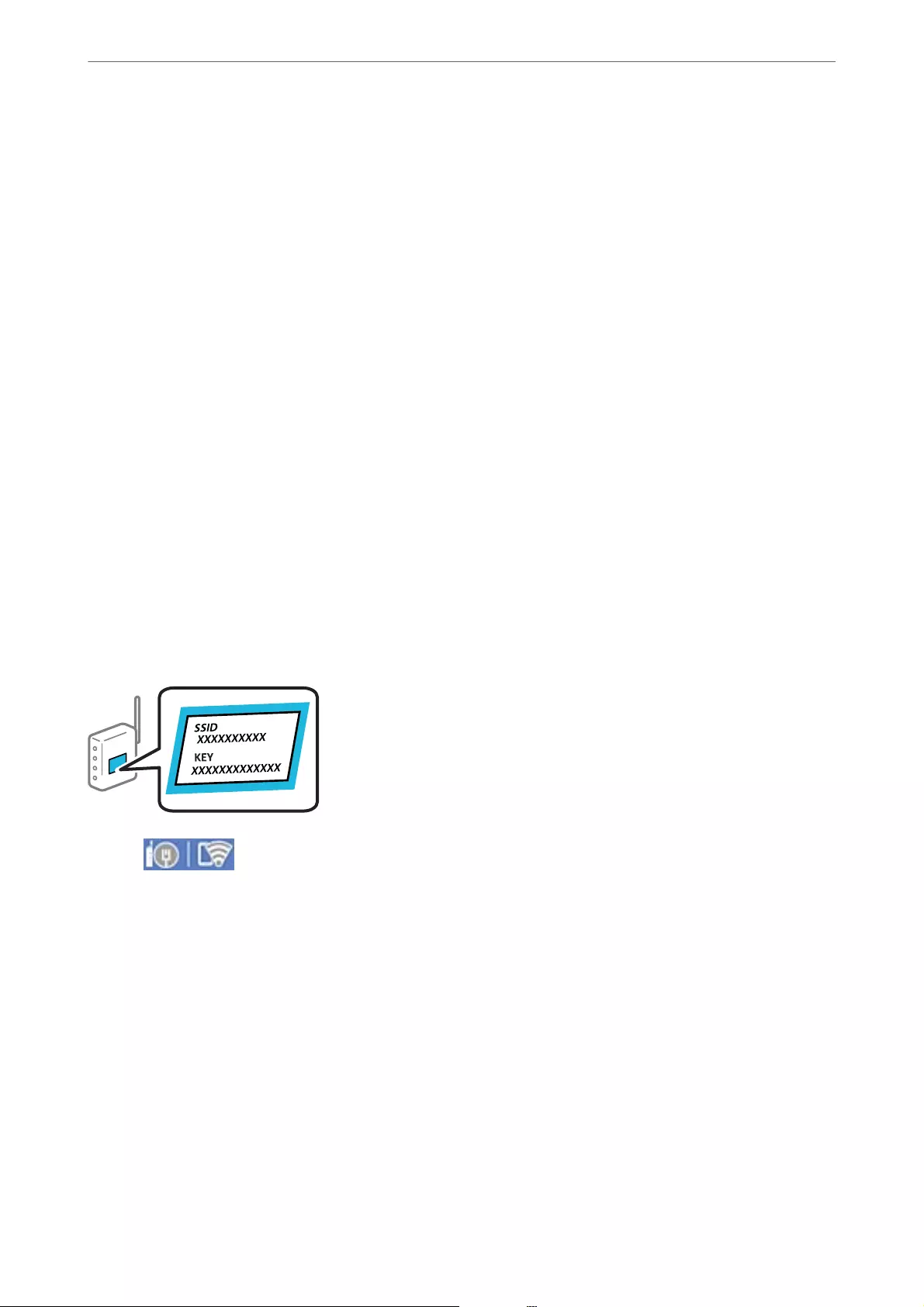
Making Wi-Fi Settings from the Control Panel
You can make network settings from the printer's control panel in several ways. Choose the connection method
that matches the environment and conditions that you are using.
If you know the information for the wireless router such as SSID and password, you can make settings manually.
If the wireless router supports WPS, you can make settings by using push button setup.
Aer connecting the printer to the network, connect to the printer from the device that you want to use (computer,
smart device, tablet, and so on.)
Related Information
&“Making Wi-Fi Settings by Entering the SSID and Password” on page 266
&“Making Wi-Fi Settings by Push Button Setup (WPS)” on page 267
&“Making Wi-Fi Settings by PIN Code Setup (WPS)” on page 268
Making Wi-Fi Settings by Entering the SSID and Password
You can set up a Wi-Fi network by entering the information necessary to connect to a wireless router from the
printer's control panel. To set up using this method, you need the SSID and password for a wireless router.
Note:
If you are using an wireless router with its default settings, the SSID and password are on the label. If you do not know the
SSID and password, contact the person who set up the wireless router, or see the documentation provided with the wireless
router.
1. Tap on the home screen.
2. Select Router.
3. Tap Start Setup.
If the network connection is already set up, the connection details are displayed. Tap Change to Wi-Fi
connection. or Change Settings to change the settings.
4. Select Wi-Fi Setup Wizard .
5. Follow the on-screen instructions to select the SSID, enter the password for the wireless router, and start setup.
If you want to check the network connection status for the printer aer setup is complete, see the related
information link below for details.
Adding or Replacing the Computer or Devices
>
Re-setting the Network Connection
>
Making Wi-
…
266
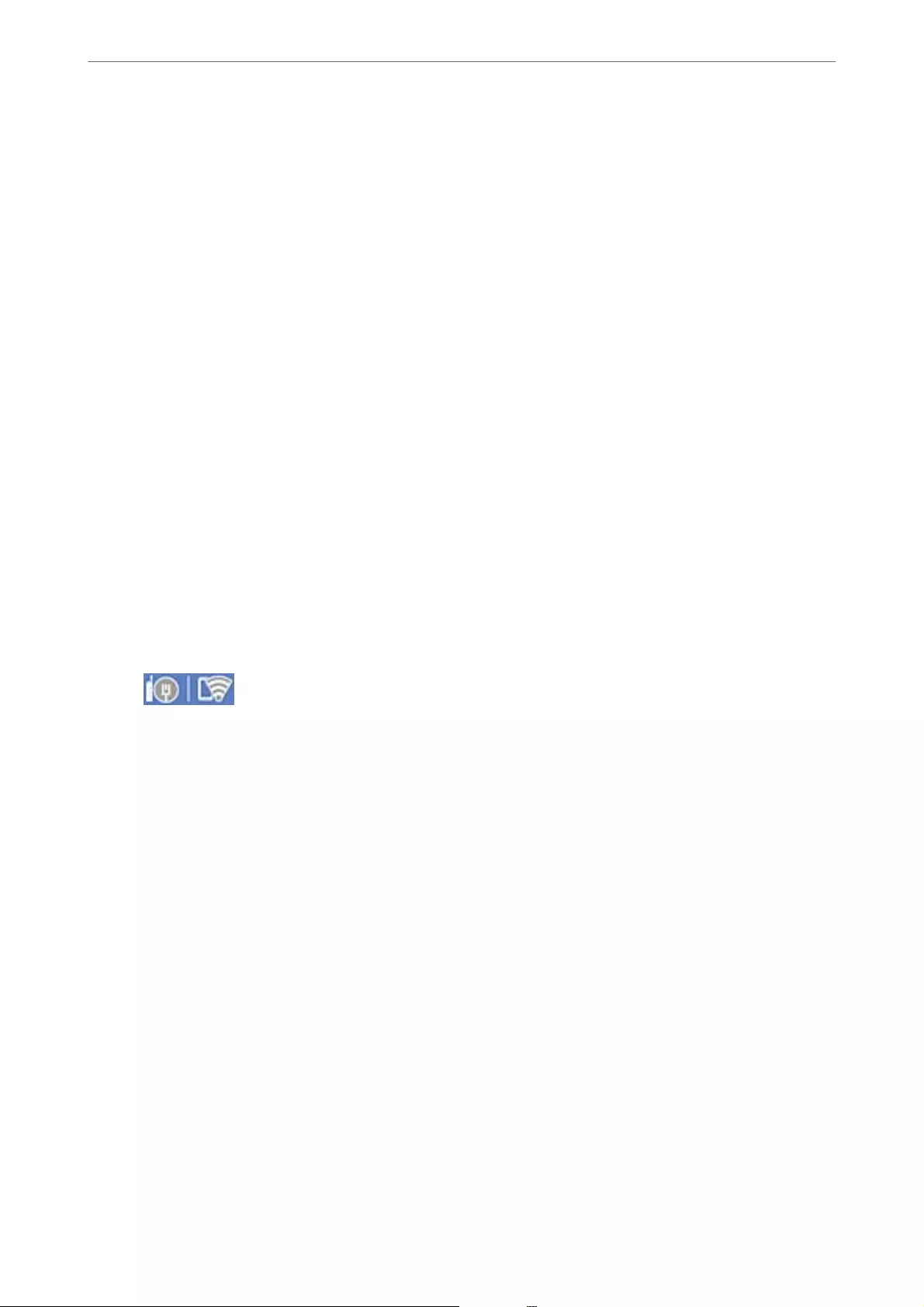
Note:
❏If you do not know the SSID, check if it is written on the label of the wireless router. If you are using the wireless
router with its default settings, use the SSID written on the label. If you cannot nd any information, see the
documentation provided with the wireless router.
❏e password is case-sensitive.
❏If you do not know the password, check if the information is written on the label of the wireless router. On the label,
the password may be written "Network Key", "Wireless Password", and so on. If you are using the wireless router
with its default settings, use the password written on the label.
Related Information
&“Entering Characters” on page 27
&“Checking the Network Connection Status” on page 279
Making Wi-Fi Settings by Push Button Setup (WPS)
You can automatically set up a Wi-Fi network by pressing a button on the wireless router. If the following
conditions are met, you can set up by using this method.
❏e wireless router is compatible with WPS (Wi-Fi Protected Setup).
❏e current Wi-Fi connection was established by pressing a button on the wireless router.
Note:
If you cannot nd the button or you are setting up using the soware, see the documentation provided with the wireless
router.
1. Tap on the home screen.
2. Select Router.
3. Tap Start Setup.
If the network connection is already set up, the connection details are displayed. Tap Change to Wi-Fi
connection. or Change Settings to change the settings.
4. Select Push Button Setup(WPS).
5. Follow the on-screen instructions.
If you want to check the network connection status for the printer aer setup is complete, see the related
information link below for details.
Note:
If connection fails, restart the wireless router, move it closer to the printer, and try again. If it still does not work, print a
network connection report and check the solution.
Related Information
&“Checking the Network Connection Status” on page 279
Adding or Replacing the Computer or Devices
>
Re-setting the Network Connection
>
Making Wi-
…
267
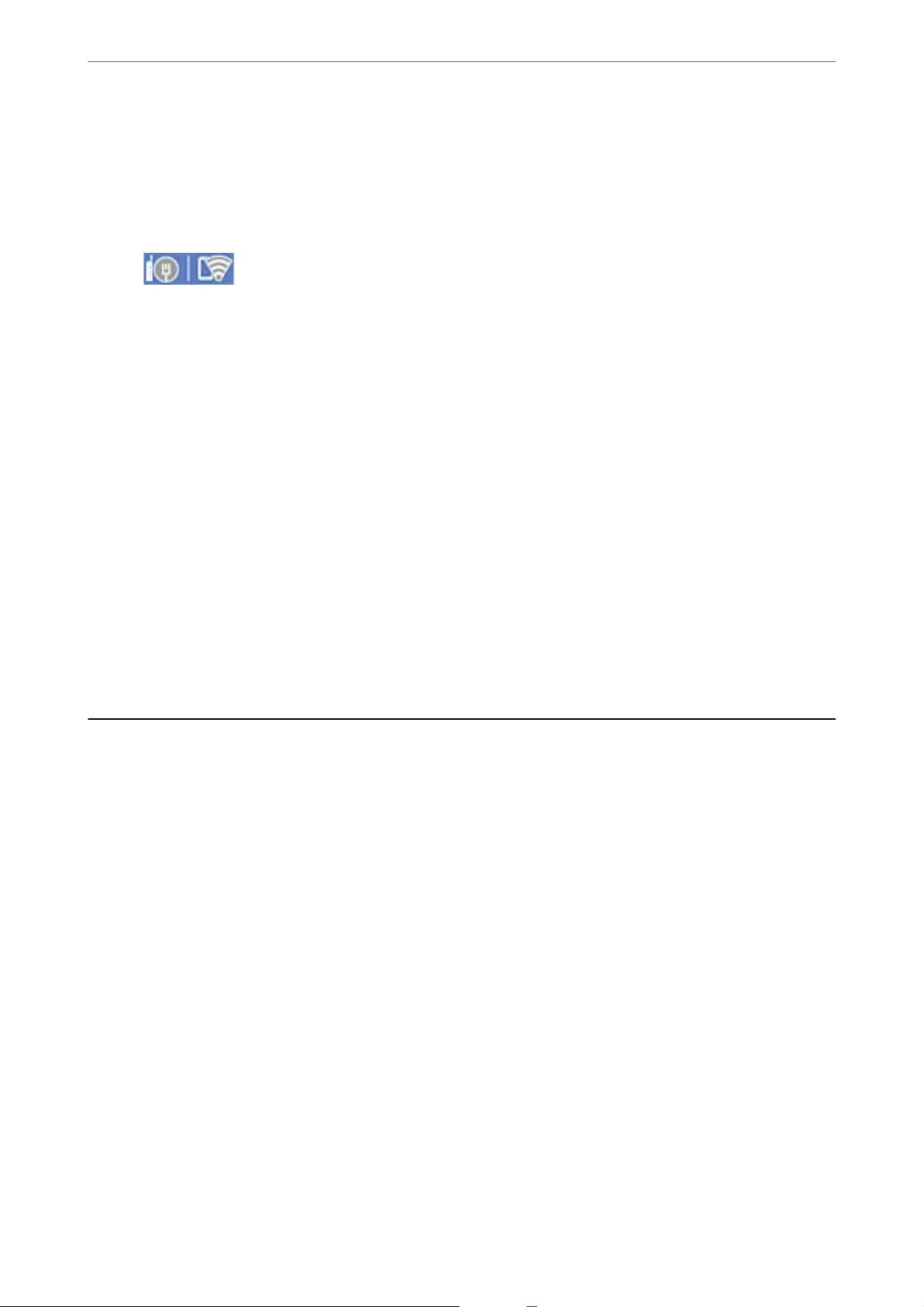
Making Wi-Fi Settings by PIN Code Setup (WPS)
You can automatically connect to an wireless router by using a PIN code. You can use this method to set up if an
wireless router is capable of WPS (Wi-Fi Protected Setup). Use a computer to enter a PIN code into the wireless
router.
1. Tap on the home screen.
2. Select Router.
3. Tap Start Setup.
If the network connection is already set up, the connection details are displayed. Tap Change to Wi-Fi
connection. or Change Settings to change the settings.
4. Select Others > PIN Code Setup(WPS)
5. Follow the on-screen instructions.
If you want to check the network connection status for the printer aer setup is complete, see the related
information link below for details.
Note:
See the documentation provided with your wireless router for details on entering a PIN code.
Related Information
&“Checking the Network Connection Status” on page 279
Connecting a Smart Device and Printer Directly (Wi-Fi
Direct)
Wi-Fi Direct (Simple AP) allows you to connect a smart device directly to the printer without a wireless router and
print from the smart device.
About Wi-Fi Direct
Use this connection method when you are not using Wi-Fi at home or at the oce, or when you want to connect
the printer and the computer or smart device directly. In this mode, the printer acts as an wireless router and you
Adding or Replacing the Computer or Devices
>
Connecting a Smart Device and Printer Directly (Wi
…
268
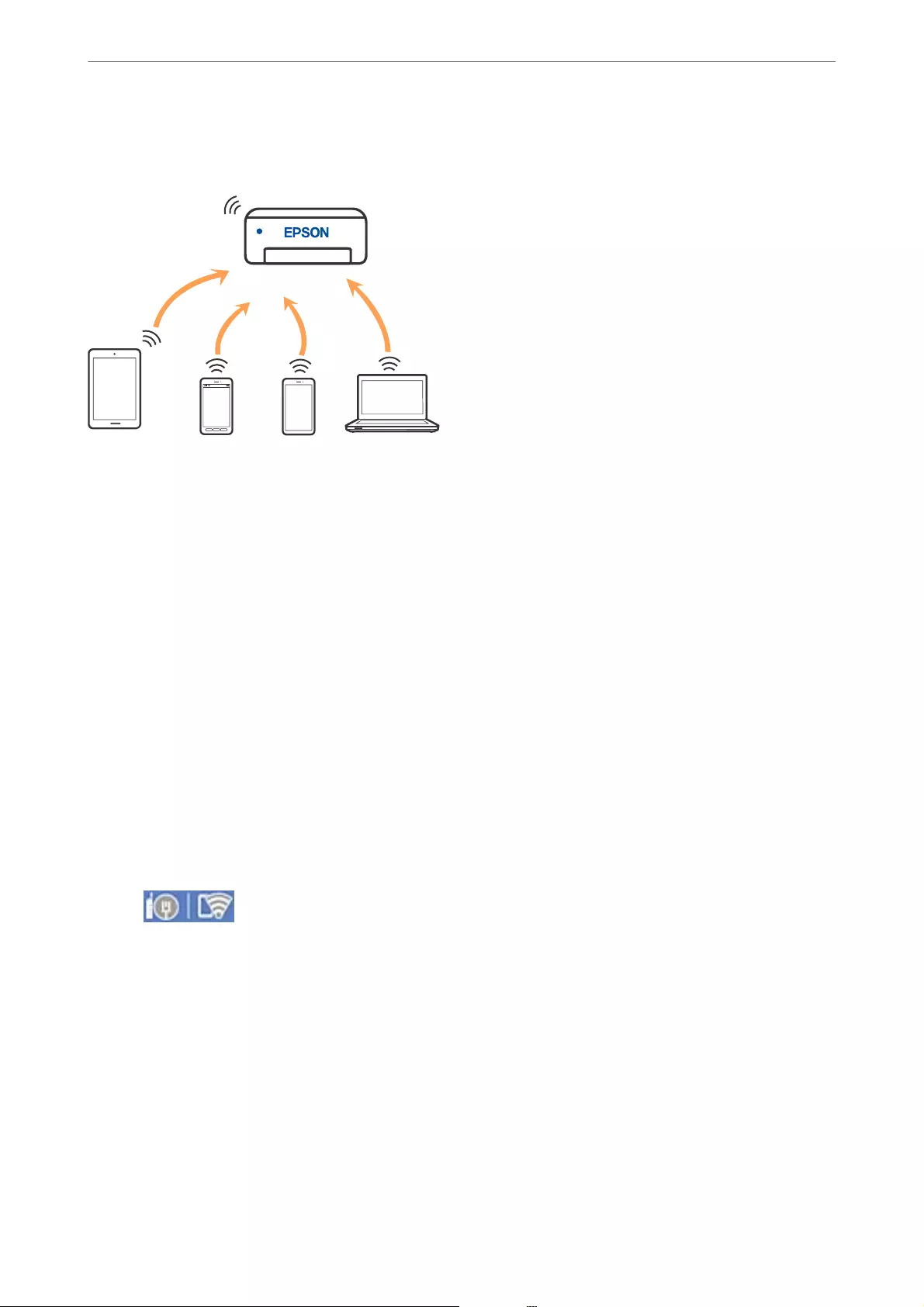
can connect the devices to the printer without having to use a standard wireless router. However, devices directly
connected to the printer cannot communicate with each other through the printer.
e printer can be connected by Wi-Fi or Ethernet, and Wi-Fi Direct (Simple AP) connection simultaneously.
However, if you start a network connection in Wi-Fi Direct (Simple AP) connection when the printer is connected
by Wi-Fi, the Wi-Fi is temporarily disconnected.
Connecting to an iPhone, iPad or iPod touch using Wi-Fi Direct
is method allows you to connect the printer directly to an iPhone, iPad or iPod touch without a wireless router.
e following conditions are required to use this function. If your environment does not match these conditions,
you can connect by selecting Other OS Devices. See the related information link below for details on connecting.
❏iOS 11 or later
❏Using the standard camera application to scan the QR code
❏Epson iPrint version 7.0 or later
Epson printing app, such as Epson iPrint, is used to print from a smart device. Install Epson printing app on the
smart device in advance.
Note:
You only need to make these settings for the printer and the smart device that you want to connect to once. Unless you
disable Wi-Fi Direct or restore the network settings to their defaults, you do not need to make these settings again.
1. Tap on the home screen.
2. Tap Wi-Fi Direct.
3. Tap Start Setup.
Adding or Replacing the Computer or Devices
>
Connecting a Smart Device and Printer Directly (Wi
…
269
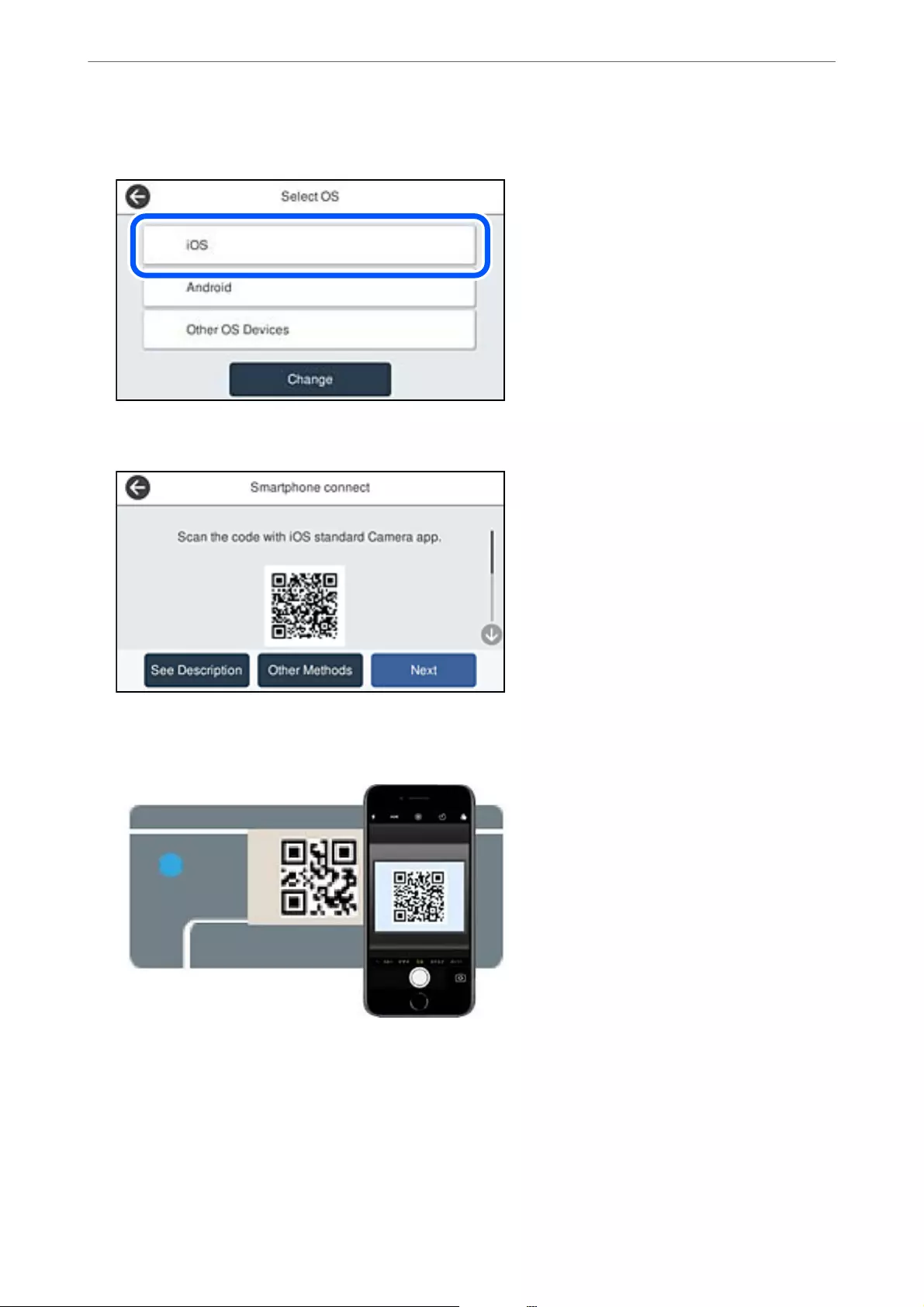
4. Tap iOS.
e QR code is displayed on the printer's control panel.
5. On your iPhone, iPad or iPod touch, start the standard Camera app, and then scan the QR code displayed on
the printer's control panel in PHOTO mode.
Use the Camera app for iOS 11 or later. You cannot connect to the printer using the Camera app for iOS 10 or
earlier. Also, you cannot connect using an app for scanning QR codes. If you cannot connect, select Other
Methods on the printer's control panel. See the related information link below for details on connecting.
Adding or Replacing the Computer or Devices
>
Connecting a Smart Device and Printer Directly (Wi
…
270
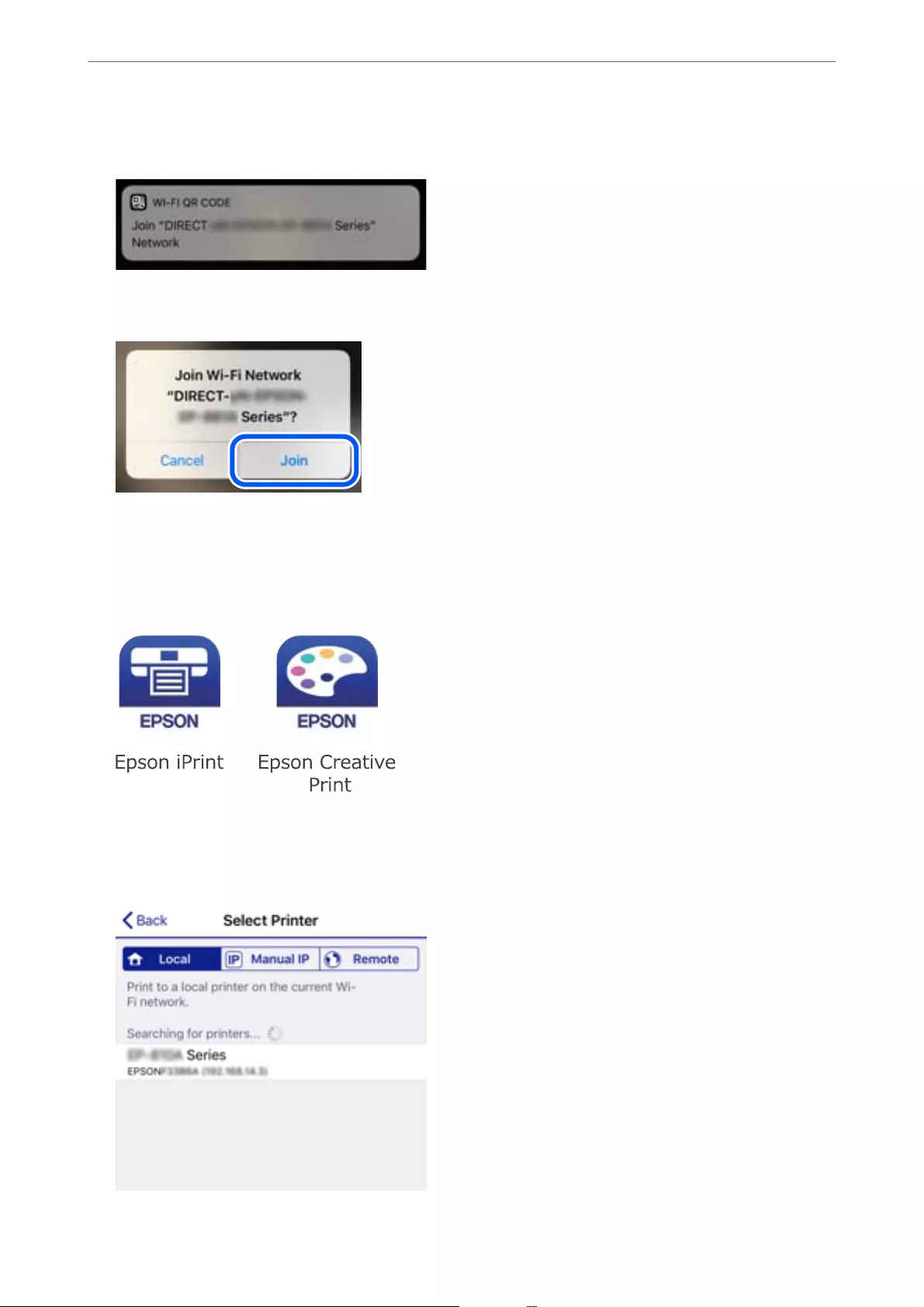
6. Tap the notication displayed on the screen of the iPhone, iPad or iPod touch.
7. Tap Join.
8. On the printer's control panel, select Next.
9. On the iPhone, iPad or iPod touch, start Epson printing app.
Examples of Epson printing apps
10. On the Epson printing app screen, tap Printer is not selected..
11. Select the printer that you want to connect to.
Adding or Replacing the Computer or Devices
>
Connecting a Smart Device and Printer Directly (Wi
…
271
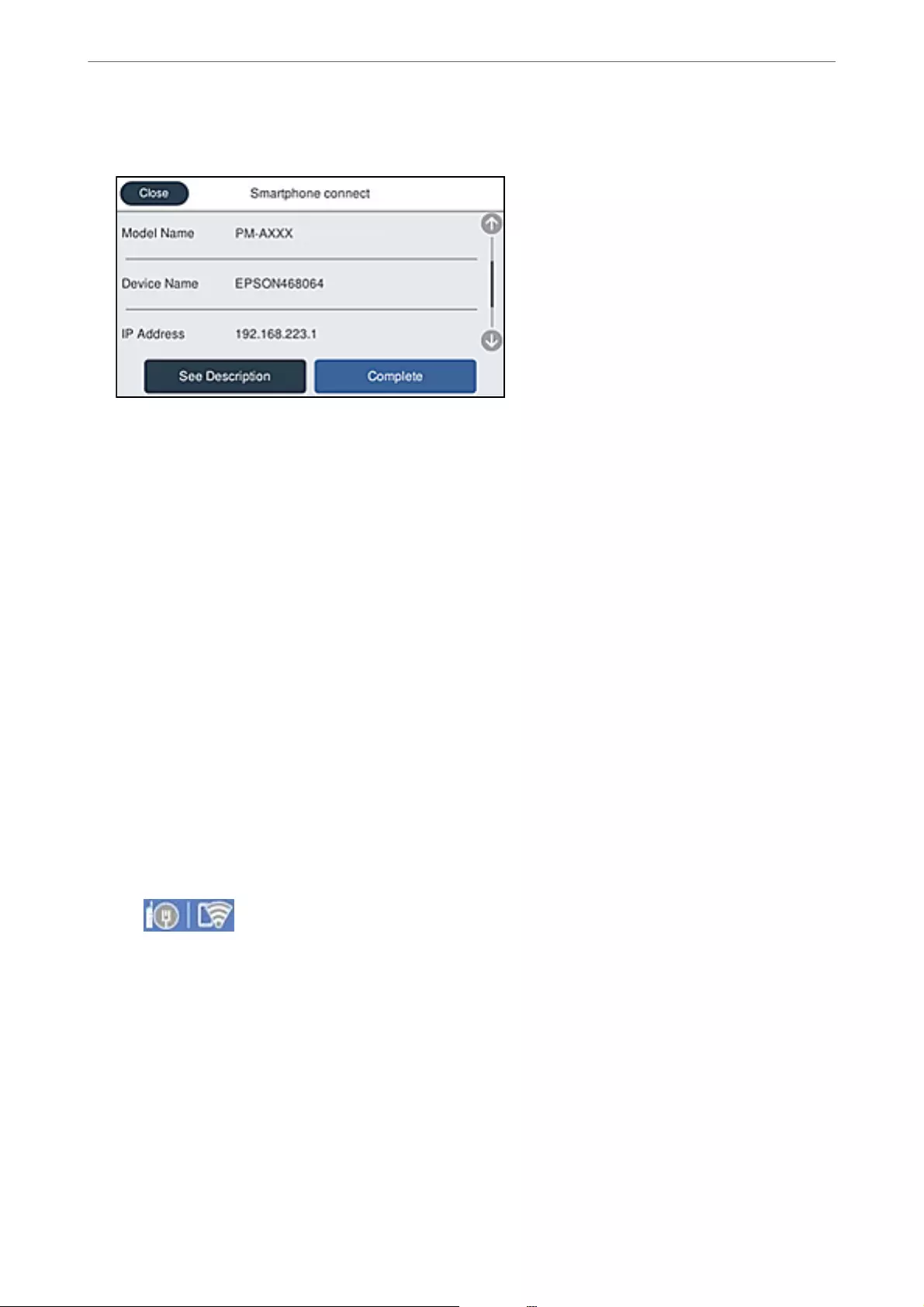
See the information displayed on the printer's control panel to select the printer.
12. On the printer's control panel, select Complete.
For smart devices that have been connected to the printer before, select the network name (SSID) on the smart
device's Wi-Fi screen to connect them again.
Related Information
&“Application for Printing Easily from a Smart Device (Epson iPrint)” on page 298
&“Connecting to Devices other than iOS and Android using Wi-Fi Direct” on page 274
Connecting to Android Devices using Wi-Fi Direct
is method allows you to connect the printer directly to your Android device without a wireless router. e
following conditions are required to use this function.
❏Android 4.4 or later
❏Epson iPrint version 7.0 or later
Epson iPrint is used to print from a smart device. Install Epson iPrint on the smart device in advance.
Note:
You only need to make these settings for the printer and the smart device that you want to connect to once. Unless you
disable Wi-Fi Direct or restore the network settings to their defaults, you do not need to make these settings again.
1. Tap on the home screen.
2. Tap Wi-Fi Direct.
3. Tap Start Setup.
Adding or Replacing the Computer or Devices
>
Connecting a Smart Device and Printer Directly (Wi
…
272
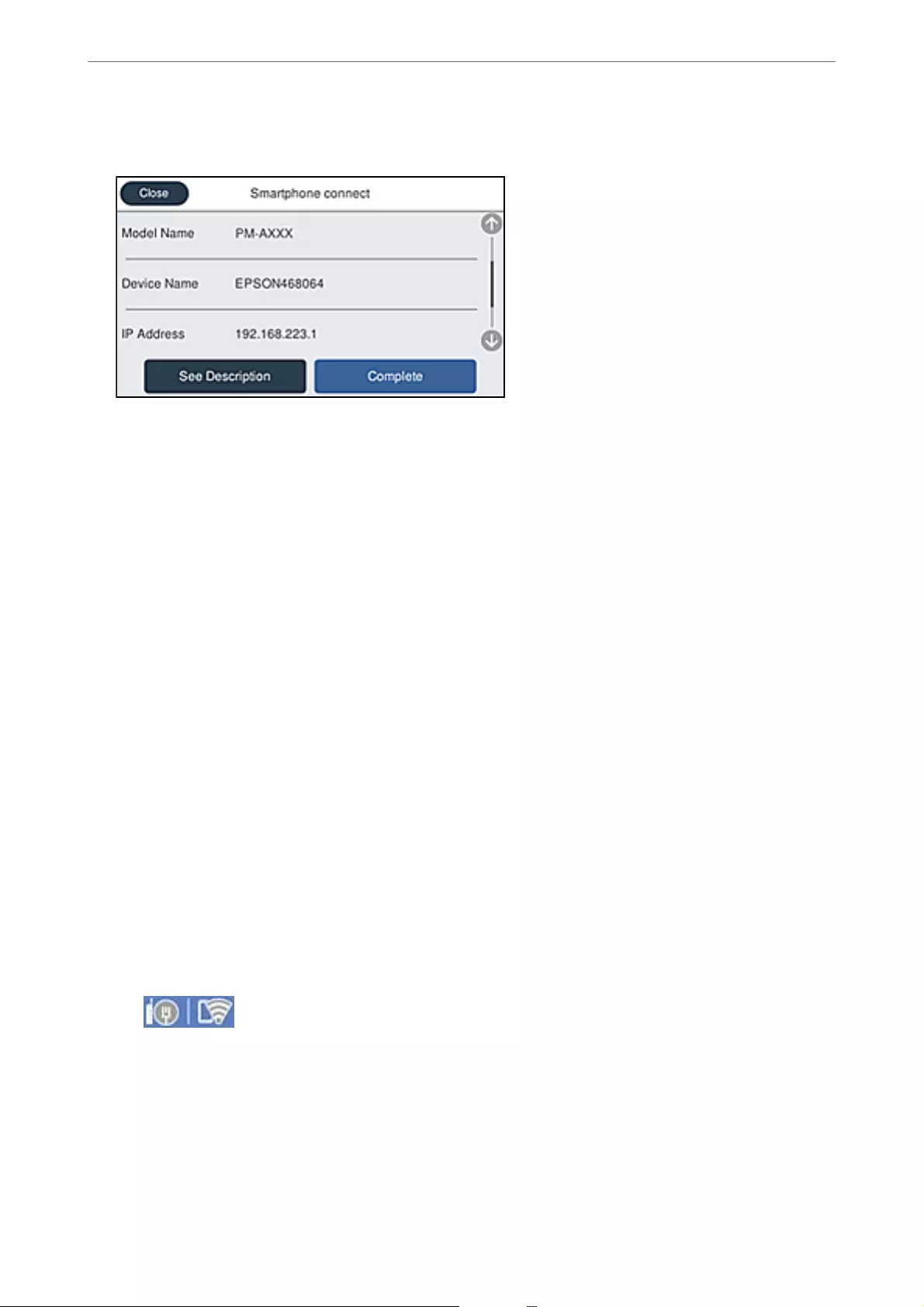
See the information displayed on the printer's control panel to select the printer.
Note:
Printers may not been displayed depending on the Android device. If printers are not displayed, connect by selecting
Other OS Devices. See the related information link below for connecting.
8. When the device connection approval screen is displayed, select Approve.
9. When the device registration conrmation screen is displayed, select whether you register the approved device
to the printer.
10. On the printer's control panel, select Complete.
For smart devices that have been connected to the printer before, select the network name (SSID) on the smart
device's Wi-Fi screen to connect them again.
Related Information
&“Application for Printing Easily from a Smart Device (Epson iPrint)” on page 298
&“Connecting to Devices other than iOS and Android using Wi-Fi Direct” on page 274
Connecting to Devices other than iOS and Android using Wi-Fi
Direct
is method allows you to connect the printer directly to smart devices without a wireless router.
Note:
You only need to make these settings for the printer and the smart device that you want to connect to once. Unless you
disable Wi-Fi Direct or restore the network settings to their defaults, you do not need to make these settings again.
1. Tap on the home screen.
2. Tap Wi-Fi Direct.
3. Tap Start Setup.
Adding or Replacing the Computer or Devices
>
Connecting a Smart Device and Printer Directly (Wi
…
274
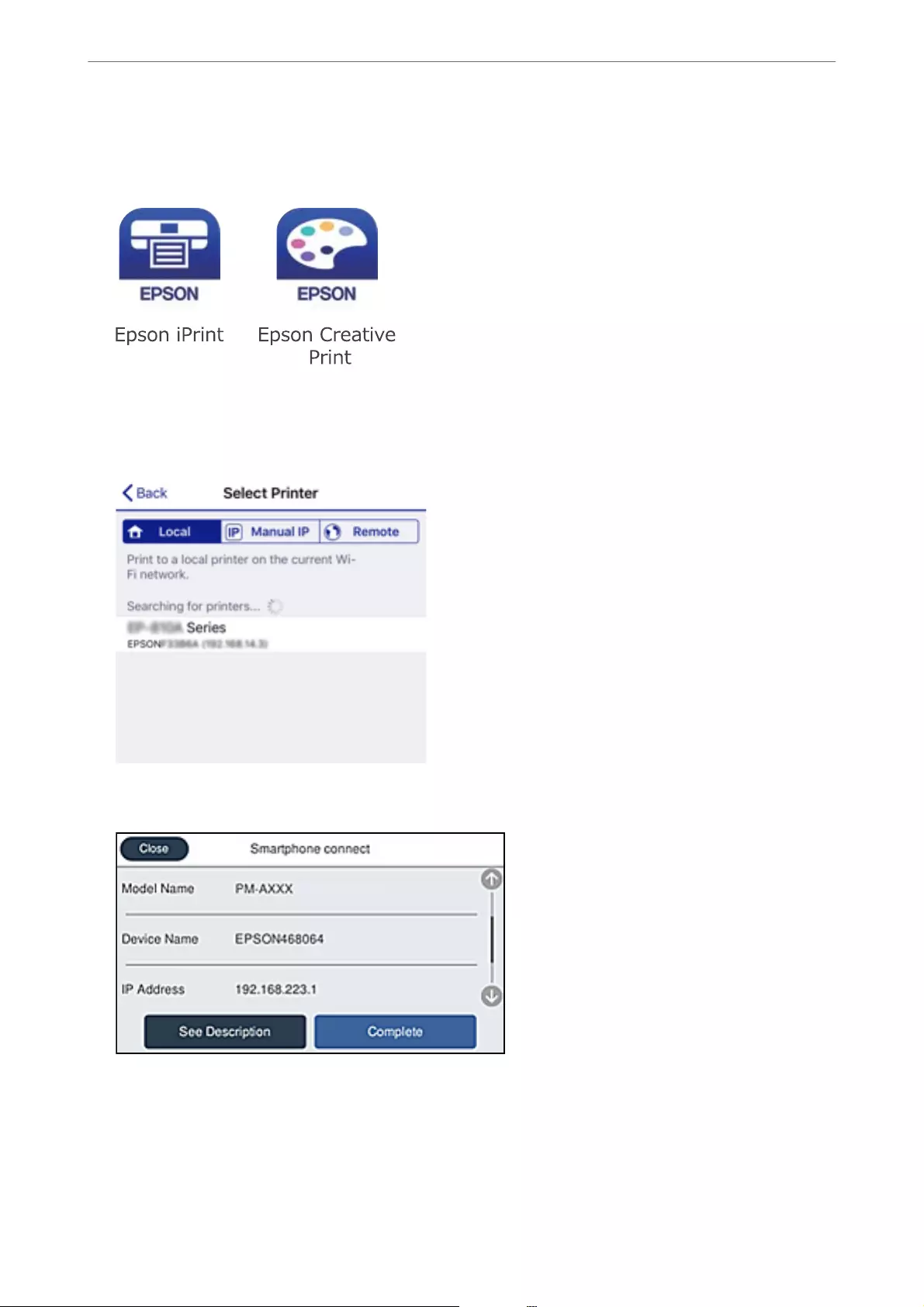
7. On the smart device, start Epson printing app.
Examples of Epson printing apps
8. On the Epson printing app screen, tap Printer is not selected..
9. Select the printer that you want to connect to.
See the information displayed on the printer's control panel to select the printer.
10. On the printer's control panel, select Complete.
For smart devices that have been connected to the printer before, select the network name (SSID) on the smart
device's Wi-Fi screen to connect them again.
Adding or Replacing the Computer or Devices
>
Connecting a Smart Device and Printer Directly (Wi
…
277
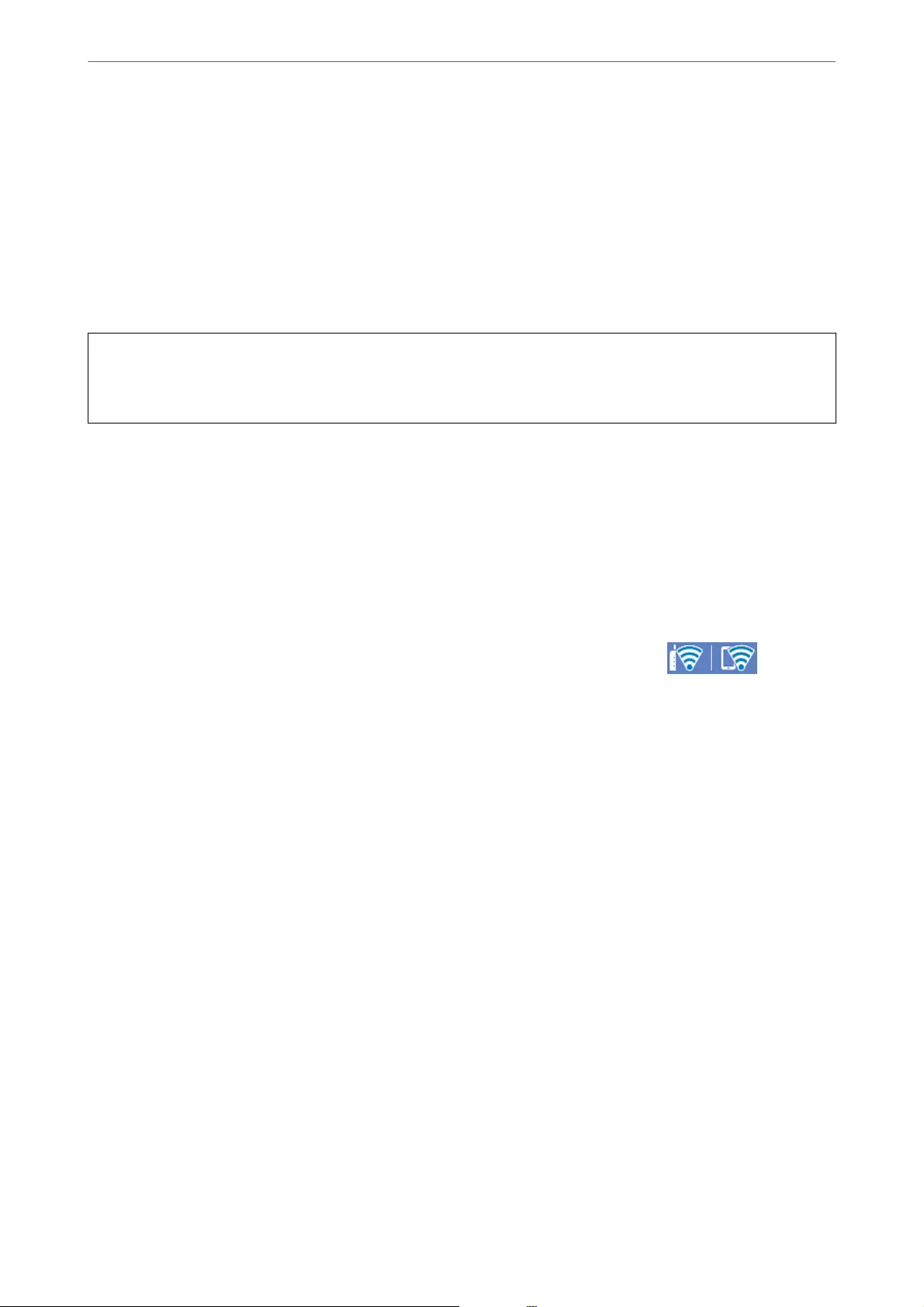
Related Information
&“Application for Printing Easily from a Smart Device (Epson iPrint)” on page 298
Disconnecting Wi-Fi Direct (Simple AP) Connection
ere are two methods available to disable a Wi-Fi Direct (Simple AP) connection; you can disable all connections
by using the printer's control panel, or disable each connection from the computer or the smart device. When you
want to disable all connections, see the related information link below for details.
c
Important:
When Wi-Fi Direct (Simple AP) connection disabled, all computers and smart devices connected to the printer in
Wi-Fi Direct (Simple AP) connection are disconnected.
Note:
If you want to disconnect a specic device, disconnect from the device instead of the printer. Use one of the following
methods to disconnect the Wi-Fi Direct (Simple AP) connection from the device.
❏Disconnect the Wi-Fi connection to the printer's network name (SSID).
❏Connect to another network name (SSID).
Changing the Wi-Fi Direct (Simple AP) Settings Such as the SSID
When Wi-Fi Direct (simple AP) connection is enabled, you can change the settings from > Wi-Fi
Direct > Start Setup > Change, and then the following menu items are displayed.
Change Network Name
Change the Wi-Fi Direct (simple AP) network name (SSID) used for connecting to the printer to your arbitrary
name. You can set the network name (SSID) in ASCII characters that is displayed on the soware keyboard on the
control panel. You can enter up to 22 characters.
When changing the network name (SSID), all connected devices are disconnected. Use the new network name
(SSID) if you want to re-connect the device.
Change Password
Change the Wi-Fi Direct (simple AP) password for connecting to the printer to your arbitrary value. You can set
the password in ASCII characters that is displayed on the soware keyboard on the control panel. You can enter 8
to 22 characters.
When changing the password, all connected devices are disconnected. Use the new password if you want to re-
connect the device.
Change Frequency Range
Change the frequency range of Wi-Fi Direct used for connecting to the printer. You can select 2.4 GHz or 5 GHz.
When changing the frequency range, all connected devices are disconnected. Re-connect the device.
Note that you cannot re-connect from devices that do not support 5 GHz frequency range when changing to 5
GHz.
Depending on the region, this setting may not be displayed.
Adding or Replacing the Computer or Devices
>
Connecting a Smart Device and Printer Directly (Wi
…
278
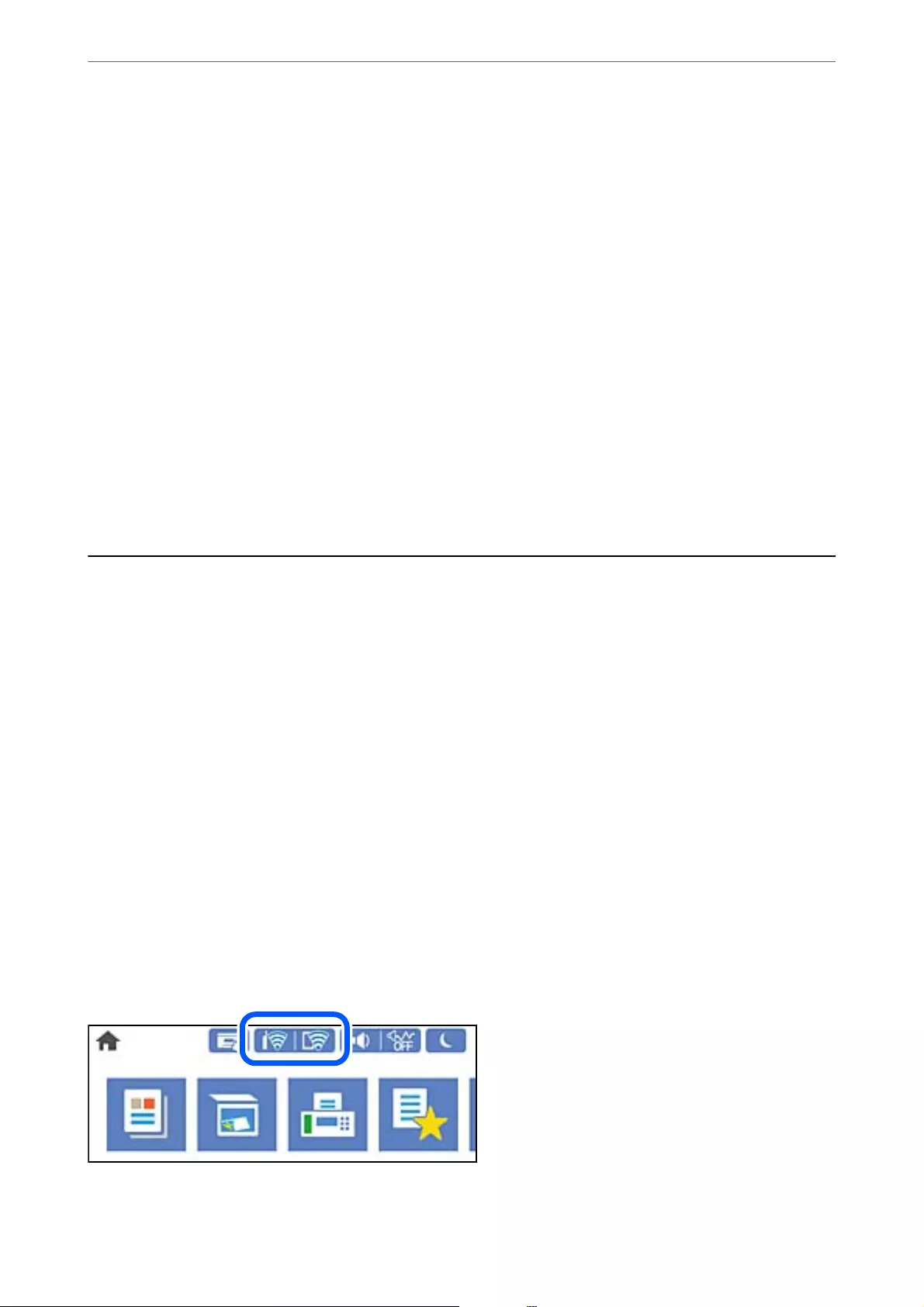
Disable Wi-Fi Direct
Disable Wi-Fi Direct (simple AP) settings of the printer. When disabling it, all devices connected to the printer in
Wi-Fi Direct (Simple AP) connection are disconnected.
Restore Default Settings
Restore all Wi-Fi Direct (simple AP) settings to their defaults.
e Wi-Fi Direct (simple AP) connection information of the smart device saved to the printer is deleted.
Note:
You can also set up from the Network tab > Wi-Fi Direct on Web Cong for the following settings.
❏Enabling or disabling Wi-Fi Direct (simple AP)
❏Changing network name (SSID)
❏Changing password
❏Changing the frequency range
Depending on the region, this setting may not be displayed.
❏Restoring the Wi-Fi Direct (simple AP) settings
Checking the Network Connection Status
You can check the network connection status in the following way.
Related Information
&“Checking the Network Connection Status from the Control Panel” on page 279
&“Printing a Network Connection Report” on page 280
Checking the Network Connection Status from the Control Panel
You can check the network connection status using the network icon or the network information on the printer’s
control panel.
Checking the Network Connection Status using the Network Icon
You can check the network connection status and strength of the radio wave using the network icon on the
printer's home screen.
Adding or Replacing the Computer or Devices
>
Checking the Network Connection Status
>
Chec
…
279

Related Information
&“Guide to the Network Icon” on page 25
Displaying Detailed Network Information on the Control Panel
When your printer is connected to the network, you can also view other network-related information by selecting
the network menus you want to check.
1. Select Settings on the home screen.
2. Select General Settings > Network Settings > Network Status.
3. To check the information, select the menus that you want to check.
❏Wired LAN/Wi-Fi Status
Displays the network information (device name, connection, signal strength, and so on) for Ethernet or Wi-
Fi connections.
❏Wi-Fi Direct Status
Displays whether Wi-Fi Direct is enabled or disabled, and the SSID, password and so on for Wi-Fi Direct
connections.
❏Email Server Status
Displays the network information for email server.
❏Print Status Sheet
Prints a network status sheet. e information for Ethernet, Wi-Fi, Wi-Fi Direct, and so on is printed on
two or more pages.
Printing a Network Connection Report
You can print a network connection report to check the status between the printer and the wireless router.
1. Select Settings on the home screen.
2. Select General Settings > Network Settings > Connection Check.
e connection check starts.
3. Select Print Check Report.
4. Print the network connection report.
If an error has occurred, check the network connection report, and then follow the printed solutions.
Related Information
&“Messages and Solutions on the Network Connection Report” on page 281
Adding or Replacing the Computer or Devices
>
Checking the Network Connection Status
>
Printi
…
280
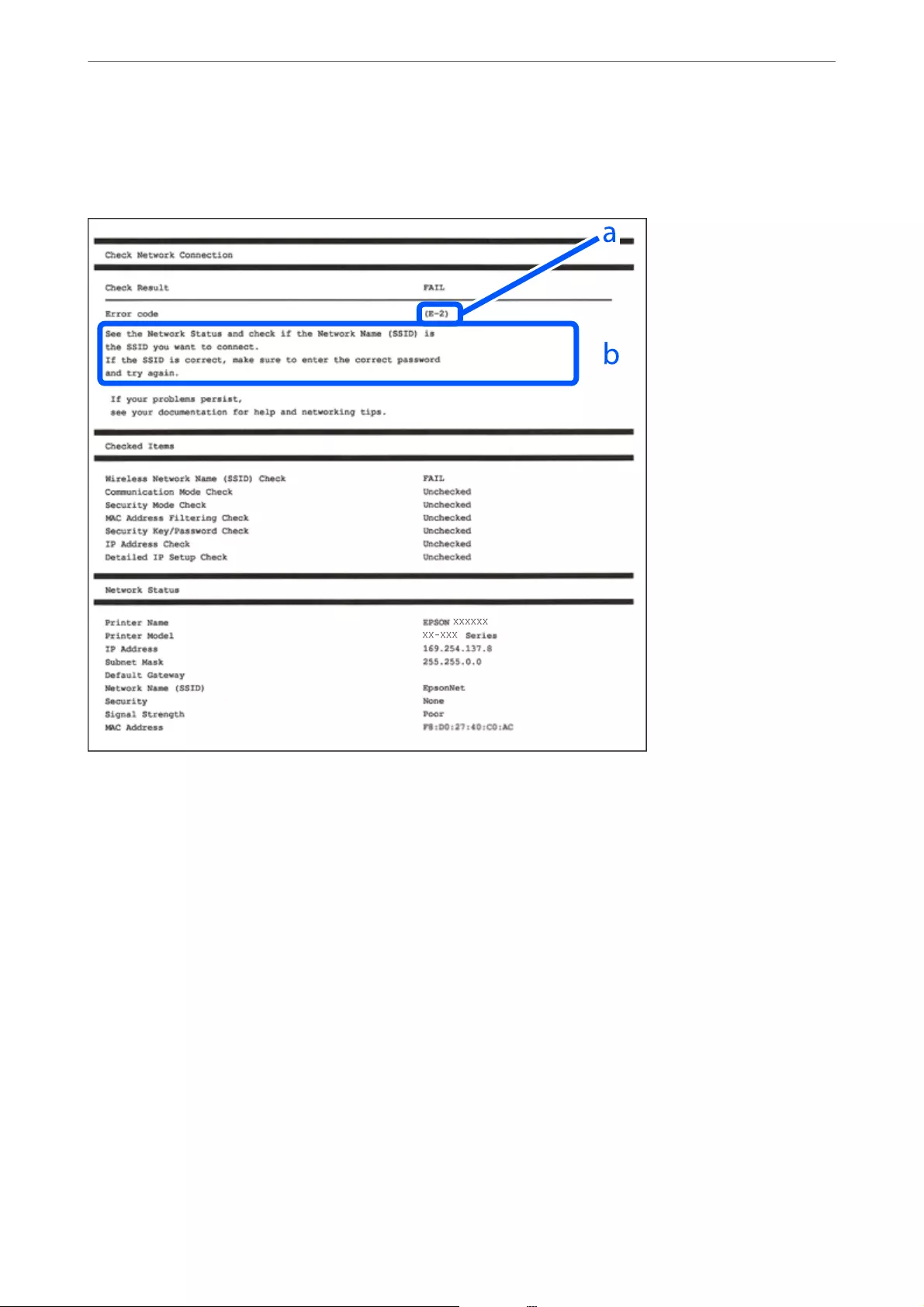
Messages and Solutions on the Network Connection Report
Check the messages and error codes on the network connection report, and then follow the solutions.
a. Error code
b. Messages on the Network Environment
Related Information
&“E-1” on page 282
&“E-2, E-3, E-7” on page 282
&“E-5” on page 283
&“E-6” on page 283
&“E-8” on page 283
&“E-9” on page 284
&“E-10” on page 284
&“E-11” on page 284
&“E-12” on page 285
&“E-13” on page 285
&“Message on the Network Environment” on page 286
Adding or Replacing the Computer or Devices
>
Checking the Network Connection Status
>
Printi
…
281

E-1
Solutions:
❏Make sure the Ethernet cable is securely connected to your printer and to your hub or other network device.
❏Make sure your hub or other network device is turned on.
❏If you want to connect the printer by Wi-Fi, make Wi-Fi settings for the printer again because it is disabled.
E-2, E-3, E-7
Solutions:
❏Make sure your wireless router is turned on.
❏Conrm that your computer or device is connected correctly to the wireless router.
❏Turn o the wireless router. Wait for about 10 seconds, and then turn it on.
❏Place the printer closer to your wireless router and remove any obstacles between them.
❏If you have entered the SSID manually, check if it is correct. Check the SSID from the Network Status part on
the network connection report.
❏If an wireless router has multiple SSIDs, select the SSID that is displayed. When the SSID is using a non-
compliant frequency, the printer does not display them.
❏If you are using push button setup to establish a network connection, make sure your wireless router supports
WPS. You cannot use push button setup if your wireless router does not support WPS.
❏Makes sure your SSID uses only ASCII characters (alphanumeric characters and symbols). e printer cannot
display an SSID that contains non-ASCII characters.
❏Makes sure you know your SSID and password before connecting to the wireless router. If you are using a
wireless router with its default settings, the SSID and password are located on a label on the wireless router. If
you do not know your SSID and password, contact the person who set up the wireless router, or see the
documentation provided with the wireless router.
❏If you are connecting to an SSID generated from a tethering smart device, check for the SSID and password in
the documentation provided with the smart device.
❏If your Wi-Fi connection suddenly disconnects, check for the conditions below. If any of these conditions are
applicable, reset your network settings by downloading and running the soware from the following website.
http://epson.sn > Setup
❏Another smart device was added to the network using push button setup.
❏e Wi-Fi network was set up using any method other than push button setup.
Related Information
&“Making Settings for Connecting to the Computer” on page 263
&“Making Wi-Fi Settings from the Control Panel” on page 266
Adding or Replacing the Computer or Devices
>
Checking the Network Connection Status
>
Printi
…
282

E-5
Solutions:
Make sure the wireless router’s security type is set to one of the following. If it is not, change the security type on
the wireless router, and then reset the printer’s network settings.
❏WEP-64 bit (40 bit)
❏WEP-128 bit (104 bit)
❏WPA PSK (TKIP/AES)
*
❏WPA2 PSK (TKIP/AES)
*
❏WPA (TKIP/AES)
❏WPA2 (TKIP/AES)
❏WPA3-SAE (AES)
❏WPA2/WPA3-Enterprise
* WPA PSK is also known as WPA Personal. WPA2 PSK is also known as WPA2 Personal.
E-6
Solutions:
❏Check if MAC address ltering is disabled. If it is enabled, register the printer’s MAC address so that it is not
ltered. See the documentation provided with the wireless router for details. You can check the printer’s MAC
address from the Network Status part on the network connection report.
❏If your wireless router is using shared authentication with WEP security, make sure the authentication key and
index are correct.
❏If the number of connectable devices on the wireless router is less than the number of network devices that you
want to connect, make settings on the wireless router to increase the number of connectable devices. See the
documentation provided with the wireless router to make settings.
Related Information
&“Making Settings for Connecting to the Computer” on page 263
E-8
Solutions:
❏Enable DHCP on the wireless router if the printer’s Obtain IP Address setting is set to Auto.
❏If the printer’s Obtain IP Address setting is set to Manual, the IP address you manually set is invalid due to out
of range (for example: 0.0.0.0). Set a valid IP address from the printer’s control panel.
Related Information
&“Network Settings” on page 308
Adding or Replacing the Computer or Devices
>
Checking the Network Connection Status
>
Printi
…
283

E-9
Solutions:
Check the following.
❏Devices are turned on.
❏You can access the Internet and other computers or network devices on the same network from the devices you
want to connect to the printer.
If still does not connect your printer and network devices aer conrming the above, turn o the wireless router.
Wait for about 10 seconds, and then turn it on. en reset your network settings by downloading and running the
installer from the following website.
http://epson.sn > Setup
Related Information
&“Making Settings for Connecting to the Computer” on page 263
E-10
Solutions:
Check the following.
❏Other devices on the network are turned on.
❏Network addresses (IP address, subnet mask, and default gateway) are correct if you have set the printer’s
Obtain IP Address to Manual.
Reset the network address if they are incorrect. You can check the IP address, subnet mask, and default gateway
from the Network Status part on the network connection report.
Related Information
&“Network Settings” on page 308
E-11
Solutions:
Check the following.
❏e default gateway address is correct if you set the printer’s TCP/IP Setup setting to Manual.
❏e device that is set as the default gateway is turned on.
Set the correct default gateway address. You can check the default gateway address from the Network Status part
on the network connection report.
Related Information
&“Network Settings” on page 308
Adding or Replacing the Computer or Devices
>
Checking the Network Connection Status
>
Printi
…
284

E-12
Solutions:
Check the following.
❏Other devices on the network are turned on.
❏e network addresses (IP address, subnet mask, and default gateway) are correct if you are entering them
manually.
❏e network addresses for other devices (subnet mask and default gateway) are the same.
❏e IP address does not conict with other devices.
If still does not connect your printer and network devices aer conrming the above, try the following.
❏Turn o the wireless router. Wait for about 10 seconds, and then turn it on.
❏Make network settings again using the installer. You can run it from the following website.
http://epson.sn > Setup
❏You can register several passwords on a wireless router that uses WEP security type. If several passwords are
registered, check if the rst registered password is set on the printer.
Related Information
&“Network Settings” on page 308
&“Making Settings for Connecting to the Computer” on page 263
E-13
Solutions:
Check the following.
❏Network devices such as a wireless router, hub, and router are turned on.
❏e TCP/IP Setup for network devices has not been set up manually. (If the printer’s TCP/IP Setup is set
automatically while the TCP/IP Setup for other network devices is performed manually, the printer’s network
may dier from the network for other devices.)
If it still does not work aer checking the above, try the following.
❏Turn o the wireless router. Wait for about 10 seconds, and then turn it on.
❏Make network settings on the computer that is on the same network as the printer using the installer. You can
run it from the following website.
http://epson.sn > Setup
❏You can register several passwords on a wireless router that uses the WEP security type. If several passwords are
registered, check if the rst registered password is set on the printer.
Related Information
&“Network Settings” on page 308
&“Making Settings for Connecting to the Computer” on page 263
Adding or Replacing the Computer or Devices
>
Checking the Network Connection Status
>
Printi
…
285
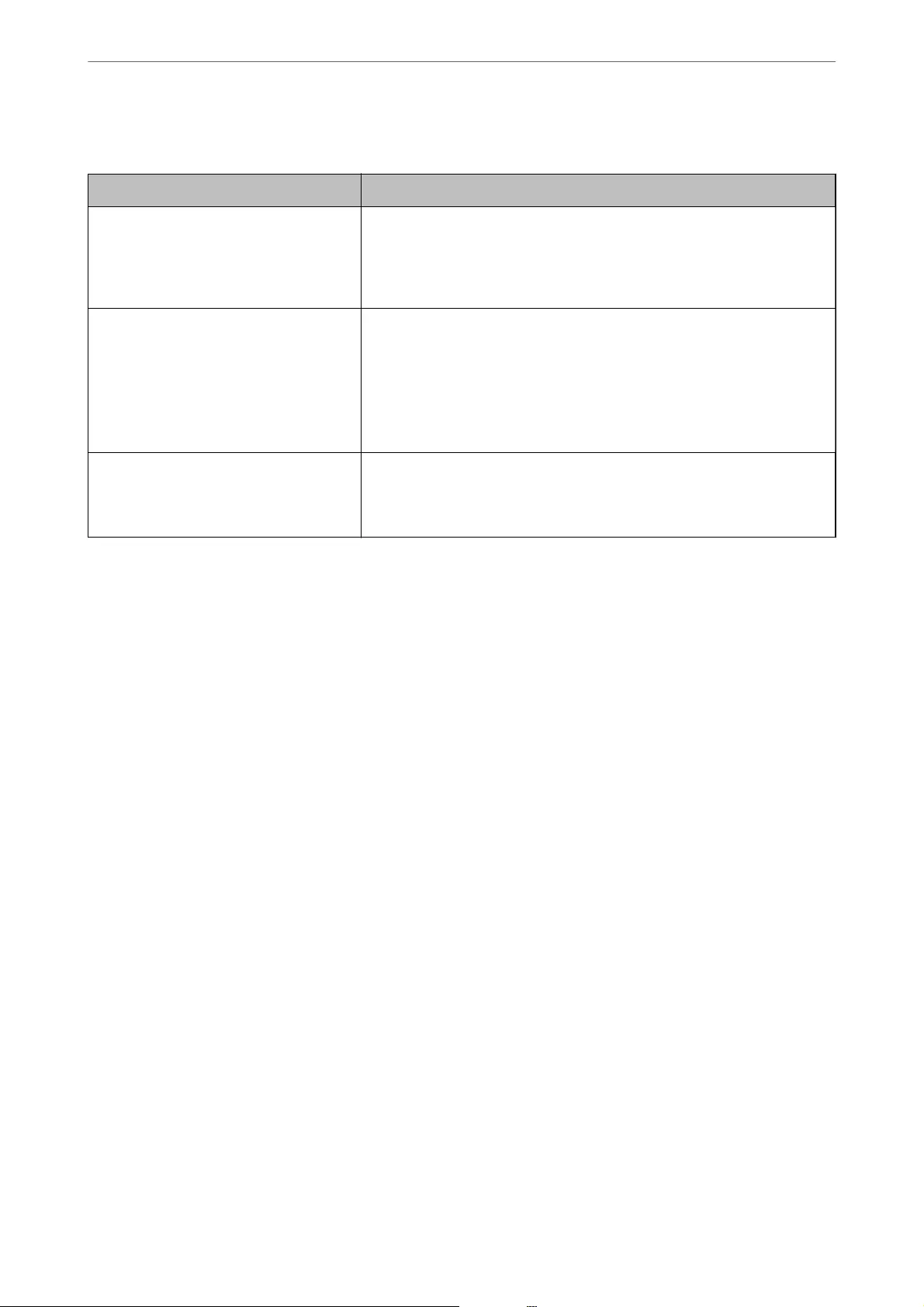
Message on the Network Environment
Message Solution
The Wi-Fi environment needs to be
improved. Turn the wireless router o and
then turn it on. If the connection does not
improve, see the documentation for the
wireless router.
After moving the printer closer to the wireless router and removing any
obstacles between them, turn o the wireless router. Wait for about 10
seconds, and then turn it on. If it still does not connect, see the
documentation supplied with the wireless router.
*No more devices can be connected.
Disconnect one of the connected devices if
you want to add another one.
Computer and smart devices that can be connected simultaneously are
connected in full in the Wi-Fi Direct (Simple AP) connection. To add another
computer or smart device, disconnect one of the connected devices or
connect it to the other network rst.
You can conrm the number of wireless devices which can be connected
simultaneously and the number of connected devices by checking the
network status sheet or the printer’s control panel.
The same SSID as Wi-Fi Direct exists in the
environment. Change the Wi-Fi Direct SSID
if you cannot connect a smart device to the
printer.
On the printer’s control panel, go to Wi-Fi Direct Setup screen and select the
menu to change the setting. You can change the network name following
after DIRECT-XX-. Enter within 22 characters.
Printing a Network Status Sheet
You can check the detailed network information by printing it.
1. Select Settings on the home screen.
2. Select General Settings > Network Settings > Network Status.
3. Select Print Status Sheet.
4. Check the message, and then print the network status sheet.
Checking the Network of the Computer (Windows only)
By using the command prompt, check the connection status of the computer and the connection path to the
printer. is will lead you to solve the problems.
Adding or Replacing the Computer or Devices
>
Checking the Network Connection Status
>
Chec
…
286
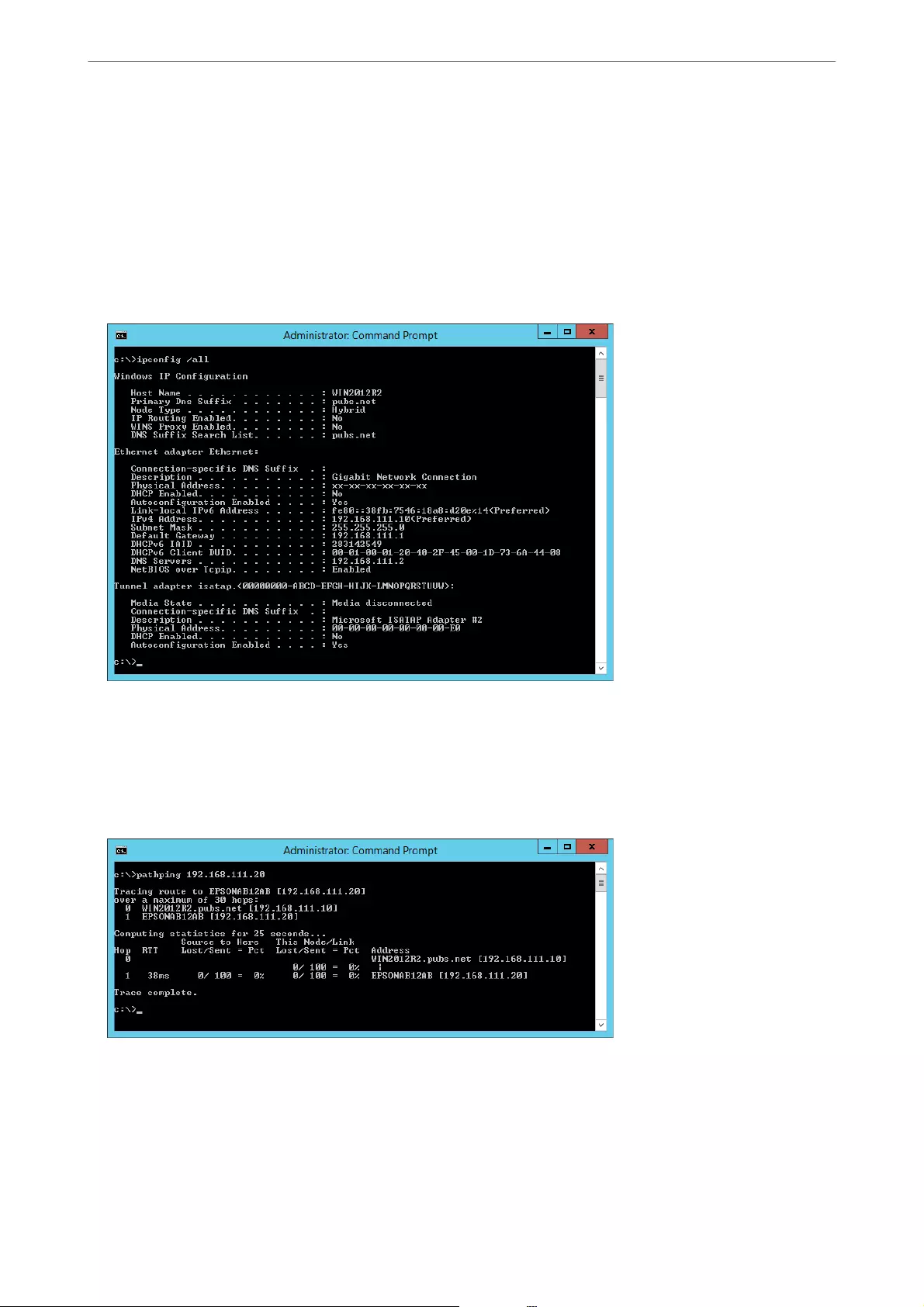
❏ipcong command
Display the connection status of the network interface that is currently used by the computer.
By comparing the setting information with actual communication, you can check whether the connection is
correct. In case there are multiple DHCP servers on the same network, you can nd out the actual address
assigned to the computer, the referred DNS server, etc.
❏Format : ipcong /all
❏Examples :
❏pathping command
You c a n conrm the list of routers passing through the destination host and the routing of communication.
❏Format : pathping xxx.xxx.xxx.xxx
❏Examples : pathping 192.0.2.222
Adding or Replacing the Computer or Devices
>
Checking the Network Connection Status
>
Chec
…
287

Product Information
Paper Information.................................................289
Consumable Products Information.....................................294
Soware Information.............................................. 295
Settings Menu List.................................................304
Product Specications..............................................327
Regulatory Information.............................................339
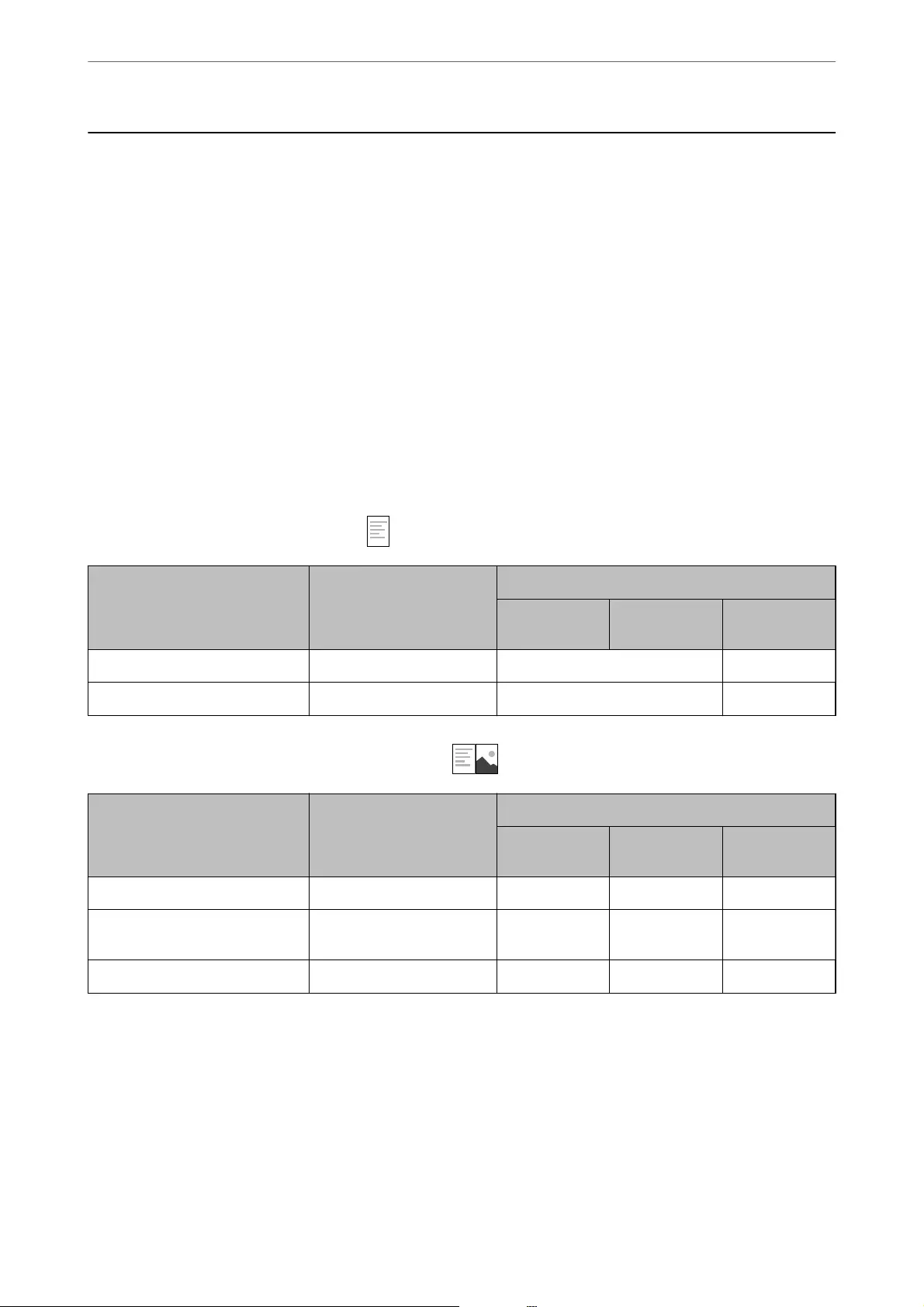
Paper Information
Available Paper and Capacities
Genuine Epson Paper
Epson recommends using genuine Epson paper to ensure high-quality printouts.
Note:
❏e availability of paper varies by location. For the latest information on paper available in your area, contact Epson
support.
❏See the following for information on available paper types for borderless and 2-sided printing.
“Paper for Borderless Printing” on page 292
“Paper for 2-Sided Printing” on page 293
Paper suitable for printing documents
Media Name Size Loading Capacity (Sheets)
Paper
Cassette 1
Paper
Cassette 2
Paper Tray
Epson Business Paper A4 250 50
Epson Bright White Ink Jet Paper A4 250 50
Paper suitable for printing documents and photos
Media Name Size Loading Capacity (Sheets)
Paper
Cassette 1
Paper
Cassette 2
Paper Tray
Epson Photo Quality Ink Jet Paper A4 100 - 20
Epson Double-sided Photo
Quality Ink Jet Paper
A4 1 - 1
Epson Matte Paper-Heavyweight A4, 20x25 cm (8x 10 in.) 50 - 20
Product Information
>
Paper Information
>
Available Paper and Capacities
289
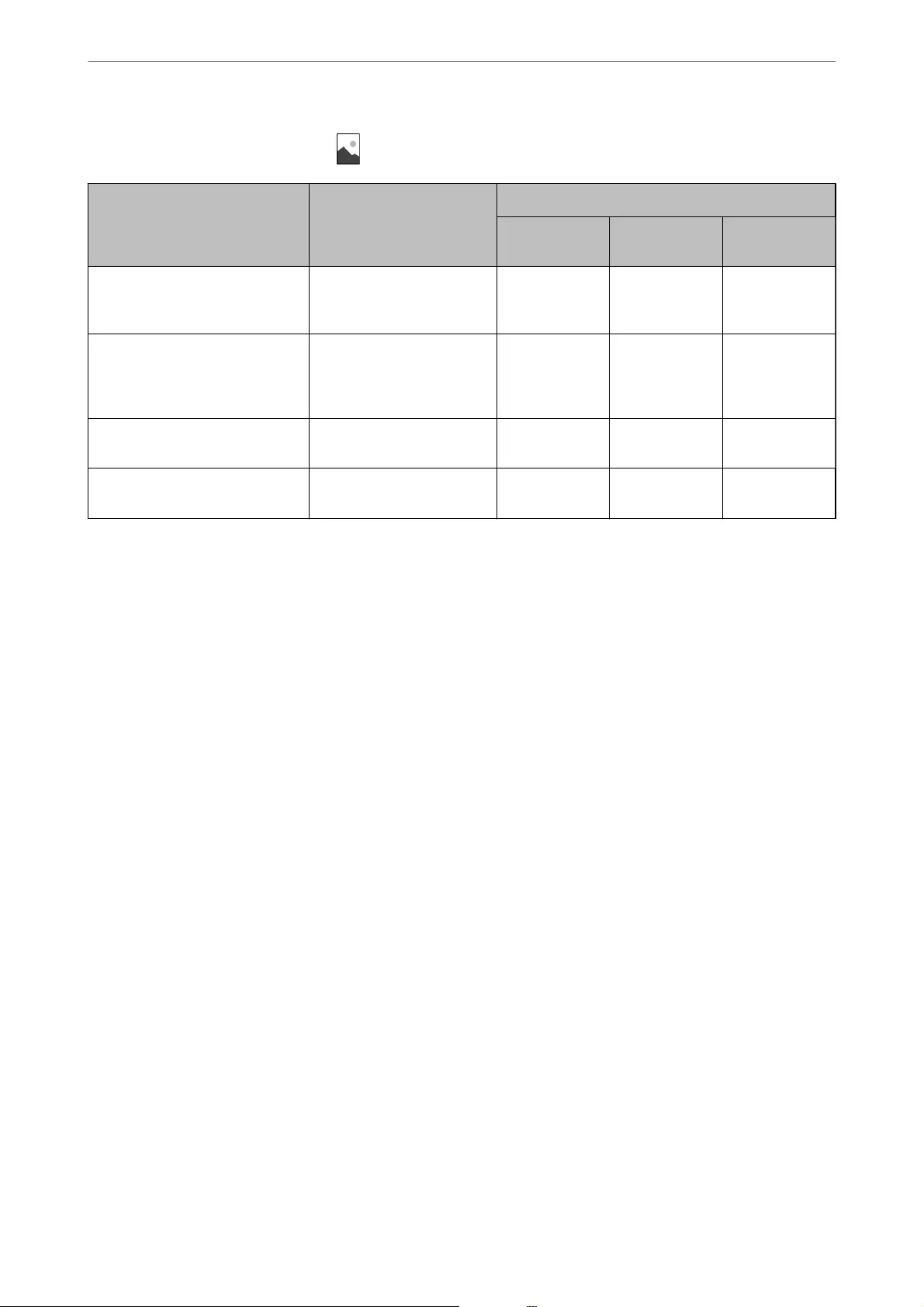
Paper suitable for printing photos
Media Name Size Loading Capacity (Sheets)
Paper
Cassette 1
Paper
Cassette 2
Paper Tray
Epson Ultra Glossy Photo Paper A4, 13x18 cm (5x7 in.),
10x15 cm (4x6 in.), 20x25
cm (8x10 in.)
50 - 20
Epson Premium Glossy Photo
Paper
A4, 13x18 cm (5x7 in.),
10x15 cm (4x6 in.), 20x25
cm (8x10 in.), 16:9 wide
(4x7.11 in.)
50 - 20
Epson Premium Semigloss Photo
Paper
A4, 13x18 cm (5x7in.), 10x15
cm(4x6 in.)
50 - 20
Epson Photo Paper Glossy A4, 13x18 cm (5x7in.), 10x15
cm(4x6 in.)
50 - 20
Commercially Available Paper
Note:
See the following for information on available paper types for borderless and 2-sided printing.
“Paper for Borderless Printing” on page 292
“Paper for 2-Sided Printing” on page 293
Product Information
>
Paper Information
>
Available Paper and Capacities
290
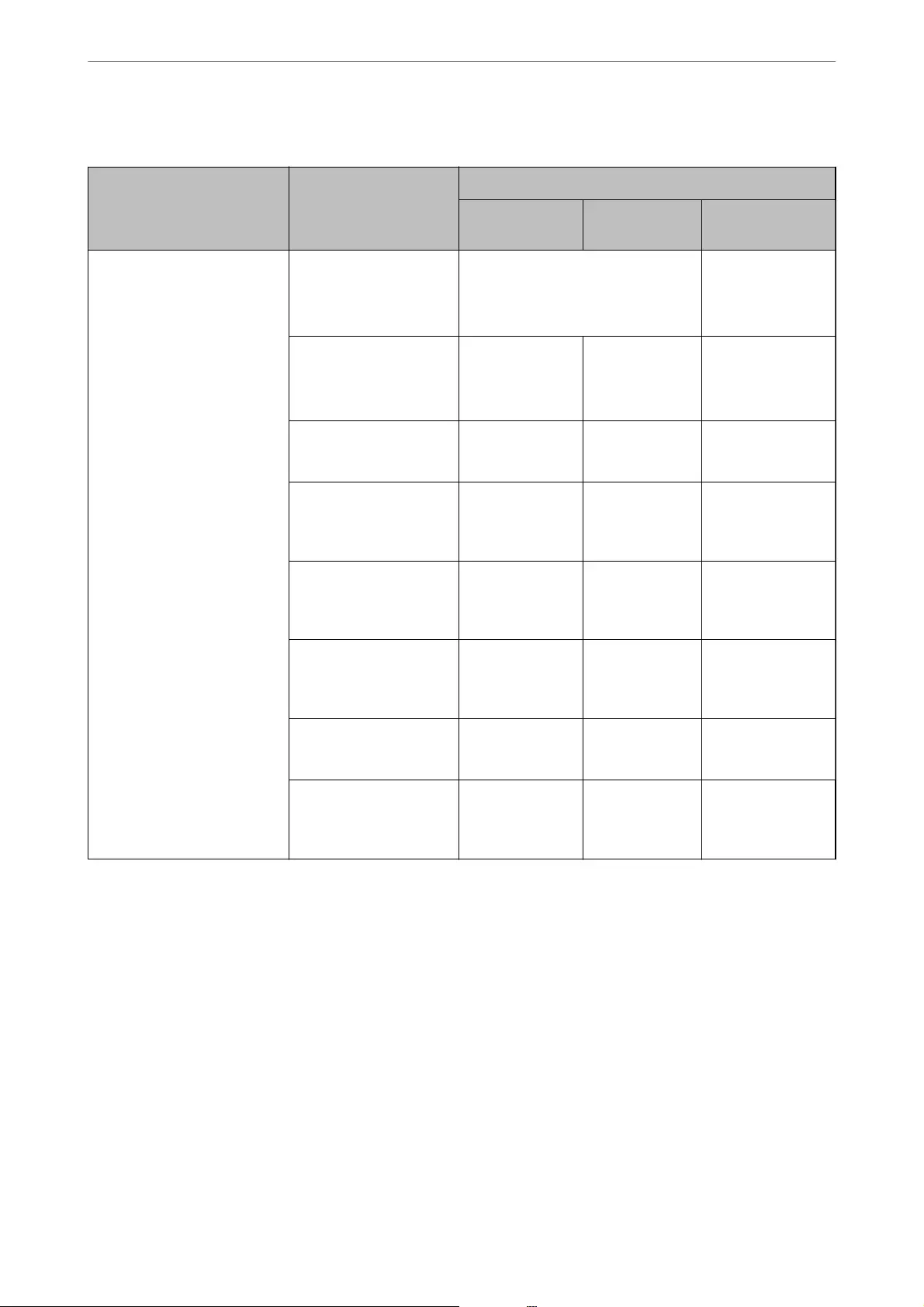
Plain papers
Media Name Size Loading Capacity (Sheets)
Paper Cassette
1
Paper Cassette
2
Paper Tray
Plain paper, Copy paper
Preprinted paper
*1
Letterhead
Color paper
Recycled paper
High quality plain paper
Legal, Letter, 8.5×13 in.,
A4, Executive
*2
, B5, 16K
(195×270 mm), Indian-
Legal, SP1 (210×270 mm)
250 50
A5, A6, B6, SP2 (210×149
mm), SP3 (100×170mm),
SP4 (130×182 mm), SP5
(192×132 mm)
250 – 50
User Dened
*2
(mm)
89 to 215.9×127 to 355.6
250 – –
User Dened
*2
(mm)
89 to 215.9×355.7 to
1200
1––
User Dened
*2
(mm)
182 to 215.9×257 to
355.6
– 250 –
User Dened
*2
(mm)
182 to 215.9×355.7 to
1200
–1–
User Dened
*2
(mm)
64 to 215.9×127 to 355.6
––50
User Dened
*2
(mm)
64 to 215.9×355.7 to
6000
––1
*1 Paper on which various forms are pre-printed such as slips or securities.
*2 Only printing from computer is available.
Product Information
>
Paper Information
>
Available Paper and Capacities
291
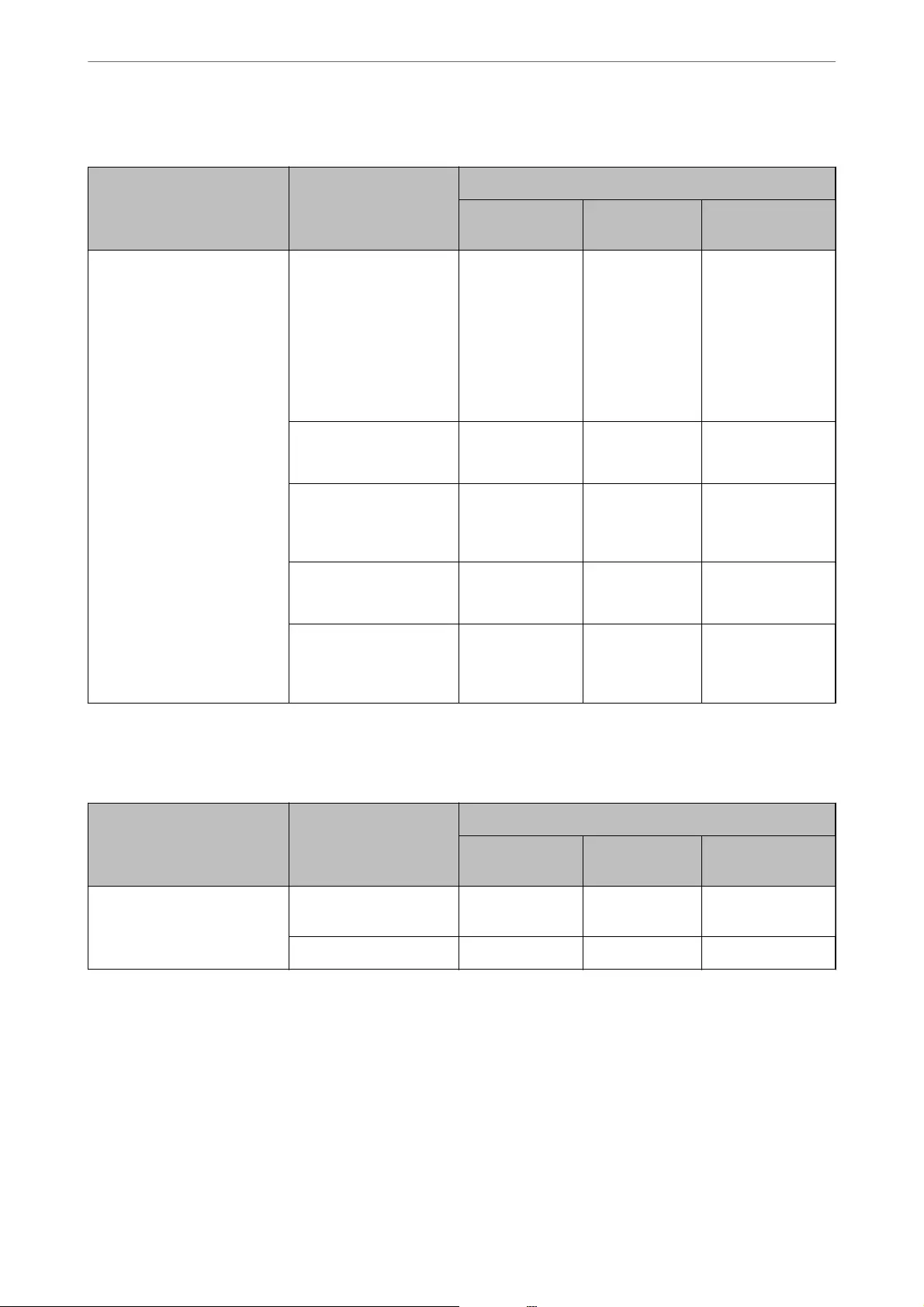
Thick papers
Media Name Size Loading Capacity (Sheets)
Paper Cassette
1
Paper Cassette
2
Paper Tray
Thick paper Legal, Letter, 8.5×13 in.,
A4, Executive
*
, B5, A5,
A6, B6, 16K (195×270
mm), Indian-Legal, SP1
(210×270 mm), SP2
(210×149 mm), SP3
(100×170mm), SP4
(130×182 mm), SP5
(192×132 mm)
50 – 20
User Dened
*
(mm)
89 to 215.9×127 to 355.6
50 – –
User Dened
*
(mm)
89 to 215.9×355.7 to
1200
1––
User Dened
*
(mm)
64 to 215.9×127 to 355.6
––20
User Dened
*
(mm)
64 to 215.9×355.7 to
6000
––1
* Only printing from computer is available.
Envelope
Media Name Size Loading Capacity (Envelopes)
Paper Cassette
1
Paper Cassette
2
Paper Tray
Envelope Envelope #10, Envelope
DL, Envelope C6
10 – 10
Envelope C4 – – 10
Paper for Borderless Printing
Genuine Epson Paper
❏Epson Business Paper
❏Epson Bright White Ink Jet Paper
❏Epson Photo Quality Ink Jet Paper
❏Epson Double-sided Photo Quality Ink Jet Paper
Product Information
>
Paper Information
>
Available Paper and Capacities
292

❏Epson Matte Paper-Heavyweight
❏Epson Ultra Glossy Photo Paper
❏Epson Premium Glossy Photo Paper
❏Epson Premium Semigloss Photo Paper
❏Epson Photo Paper Glossy
Related Information
&“Available Paper and Capacities” on page 289
Commercially Available Paper
❏Plain paper, Copy paper, Preprinted paper, Letterhead, Color paper, Recycled paper, High quality plain paper
(Letter, A4)
❏ick paper (Letter, A4)
Related Information
&“Available Paper and Capacities” on page 289
Paper for 2-Sided Printing
Genuine Epson Paper
❏Epson Business Paper
❏Epson Bright White Ink Jet Paper
❏Epson Double-sided Photo Quality Ink Jet Paper
Related Information
&“Available Paper and Capacities” on page 289
Commercially Available Paper
❏Plain paper, Copy paper, Preprinted paper, Letterhead, Color paper, Recycled paper, High quality plain paper
*
❏ick paper
*
* SP2, SP3, SP4, SP5 size paper is not supported for automatic 2-sided printing.
For automatic 2-sided printing with User Dened paper sizes, you can use 182 to 215.9 x 257 to 297 mm paper sizes.
Related Information
&“Available Paper and Capacities” on page 289
Product Information
>
Paper Information
>
Available Paper and Capacities
293
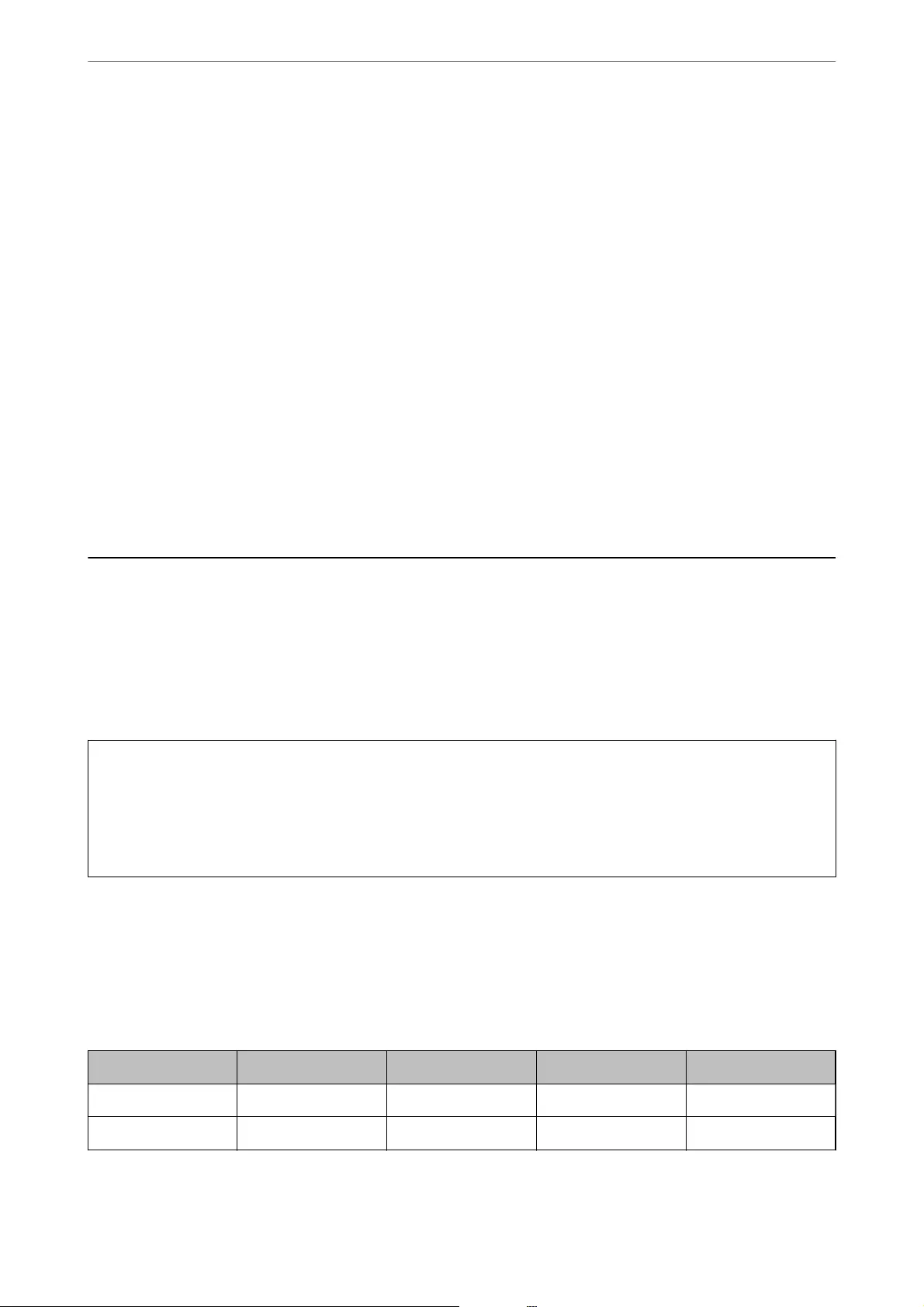
Unavailable Paper Types
Do not use the following papers. Using these types of paper causes paper jams and smears on the printout.
❏Papers that are wavy
❏Papers that are torn or cut
❏Papers that are folded
❏Papers that are damp
❏Papers that are too thick or too thin
❏Papers that have stickers
Do not use the following envelopes. Using these types of envelope causes paper jams and smears on the printout.
❏Envelopes that are curled or folded
❏Envelopes with adhesive surfaces on the aps or window envelopes
❏Envelopes that are too thin
ey may curl during printing.
Consumable Products Information
Ink Bottle Codes
Epson recommends the use of genuine Epson ink bottles.
e following are the codes for genuine Epson ink bottles.
c
Important:
❏Epson warranty does not cover damage caused by inks other than those specied, including any genuine Epson
ink not designed for this printer or any third party ink.
❏Other products not manufactured by Epson may cause damage that is not covered by Epson’s warranties, and
under certain circumstances, may cause erratic printer behavior.
Note:
❏Ink bottle codes may vary by location. For the correct codes in your area, contact Epson support.
❏Although the ink bottles may contain recycled materials, this does not aect printer function or performance.
❏Specications and appearance of the ink bottle are subject to change without prior notice for improvement.
For Europe
Product BK: Black C: Cyan M: Magenta Y: Yellow
ET-5800 113 113 113 113
L6550 112 112 112 112
Product Information
>
Consumable Products Information
>
Ink Bottle Codes
294
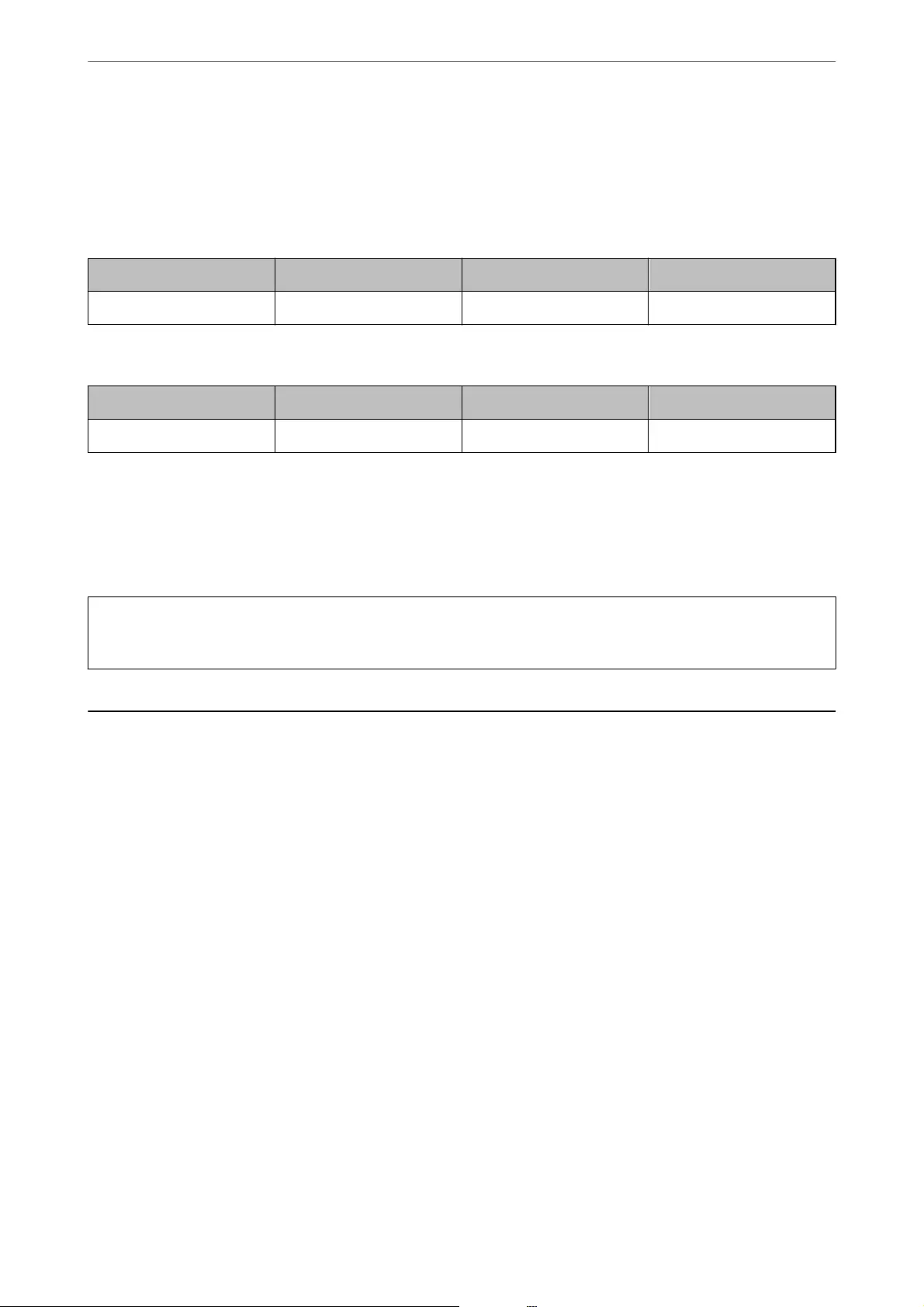
Note:
Visit the following website for information on Epson's ink bottle yields.
http://www.epson.eu/pageyield
For Australia and New Zealand
BK: Black C: Cyan M: Magenta Y: Yellow
542 542 542 542
For Asian countries except for China
BK: Black C: Cyan M: Magenta Y: Yellow
008 008 008 008
Maintenance Box Code
Epson recommends the use of a genuine Epson maintenance box.
Maintenance box code: C9345
c
Important:
Once a maintenance box has been installed in a printer it cannot be used with other printers.
Software Information
is section introduces the network services and soware products available for your printer from the Epson
website or the supplied soware disc.
Software for Printing
Application for Printing from a Computer (Windows Printer Driver)
e printer driver controls the printer according to the commands from an application. Making settings on the
printer driver provides the best printing results. You can also check the status of the printer or keep it in top
operating condition using the printer driver utility.
Note:
You can change the language of the printer driver. Select the language you want to use from the Language setting on the
Maintenance tab.
Accessing the printer driver from applications
To make settings that apply only to the application you are using, access from that application.
Select Print or Print Setup from the File menu. Select your printer, and then click Preferences or Properties.
Product Information
>
Software Information
>
Software for Printing
295

Note:
Operations dier depending on the application. See the application's help for details.
Accessing the printer driver from the control panel
To make settings that apply to all of the applications, access from the control panel.
❏Windows 10/Windows Server 2019/Windows Server 2016
Click on the start button, and then select Windows System > Control Panel > View devices and printers in
Hardware and Sound. Right-click on your printer, or press and hold it and then select Printing preferences
❏Windows 8.1/Windows 8/Windows Server 2012 R2/Windows Server 2012
Select Desktop > Settings > Control Panel > View devices and printers in Hardware and Sound. Right-click
on your printer, or press and hold it and then select Printing preferences
❏Windows 7/Windows Server 2008 R2
Click the start button, and select Control Panel > View devices and printers in Hardware and Sound. Right-
click on your printer and select Printing preferences.
❏Windows Vista/Windows Server 2008
Click the start button, and select Control Panel > Printers in Hardware and Sound. Right-click on your printer
and select Printing preferences.
❏Windows XP/Windows Server 2003 R2/Windows Server 2003
Click the start button, and select Control Panel > Printers and Other Hardware > Printers and Faxes. Right-
click on your printer and select Printing preferences.
Accessing the printer driver from the printer icon on the task bar
e printer icon on the desktop task bar is a shortcut icon allowing you to quickly access the printer driver.
If you click the printer icon and select Printer Settings, you can access the same printer settings window as the one
displayed from the control panel. If you double-click this icon, you can check the status of the printer.
Note:
If the printer icon is not displayed on the task bar, access the printer driver window, click Monitoring Preferences on the
Maintenance tab, and then select Register the shortcut icon to the taskbar.
Starting the utility
Access the printer driver window. Click the Maintenance tab.
Related Information
&“Menu Options for the Printer Driver” on page 42
Application for Printing from a Computer (Mac OS Printer Driver)
e printer driver controls the printer according to the commands from an application. Making settings on the
printer driver provides the best printing results. You can also check the status of the printer or keep it in top
operating condition using the printer driver utility.
Accessing the printer driver from applications
Click Page Setup or Print on the File menu of your application. If necessary, click Show Details (or
d
) to expand
the print window.
Product Information
>
Software Information
>
Software for Printing
296

Note:
Depending on the application being used, Page Setup may not be displayed in the File menu, and the operations for
displaying the print screen may dier.See the application's help for details.
Starting the utility
Select System Preferences from the Apple menu > Printers & Scanners (or Print & Scan, Print & Fax), and then
select the printer. Click Options & Supplies > Utility > Open Printer Utility.
Related Information
&“Menu Options for the Printer Driver” on page 66
Guide to Mac OS Printer Driver
Epson Printer Utility
You can run a maintenance feature such as nozzle check and print head cleaning, and by starting EPSON Status
Monitor, you can check printer status and error information.
Application for Quick and Fun Printing from a Computer (Epson Photo+)
Epson Photo+ is an application that allows you to easily print images with a variety of layouts. You can also
perform image correction and adjust the position while viewing a preview of your document. You can also
brighten up your images by adding text and stamps wherever you like. When printing on genuine Epson photo
paper, the ink performance is maximized creating a beautiful nish with excellent coloring.
Product Information
>
Software Information
>
Software for Printing
297
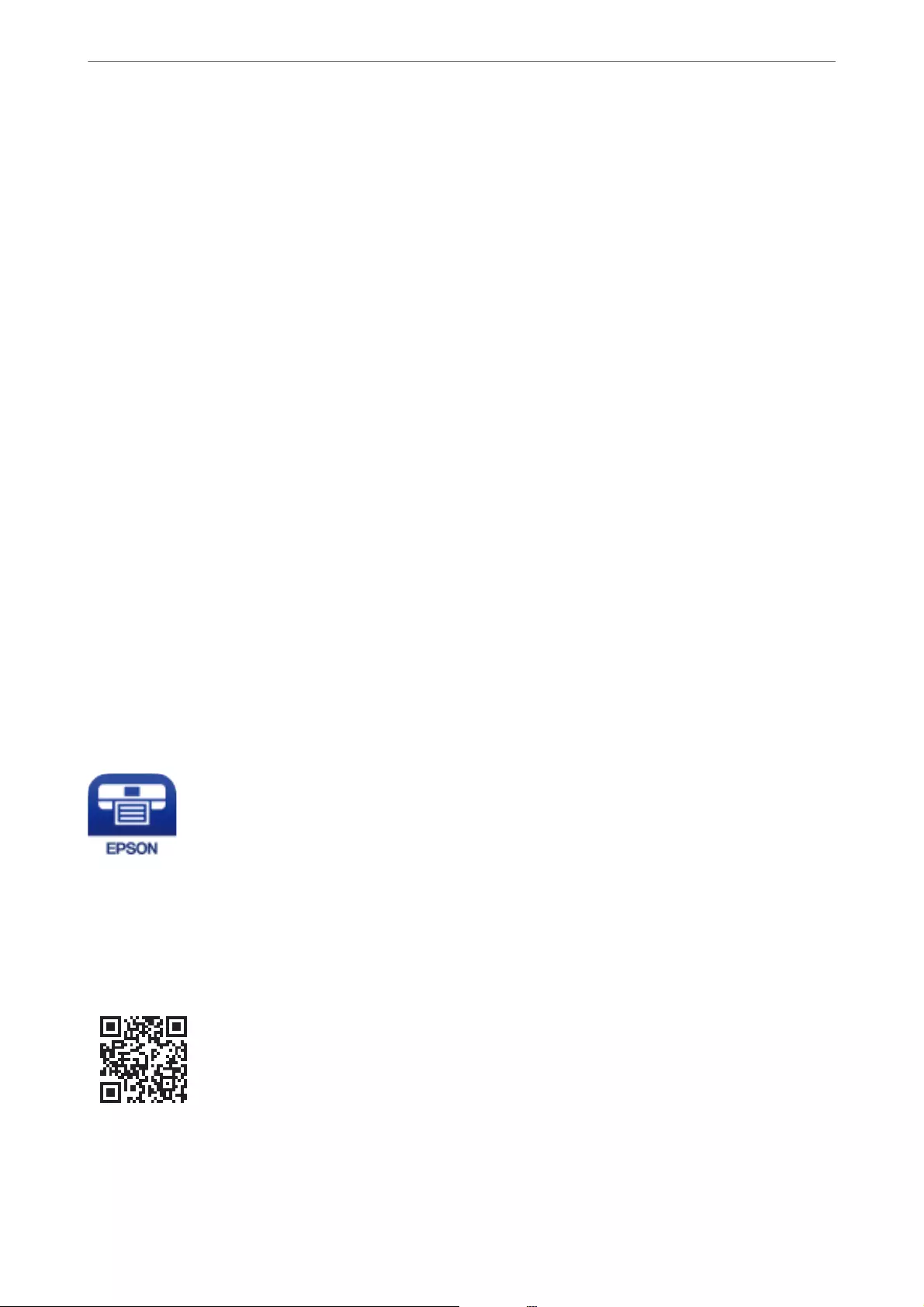
See the application's help for details.
Note:
❏Windows Server operating systems are not supported.
❏To use this application the printer driver for this printer must be installed.
Starting on Windows
❏Windows 10
Click the start button, and then select Epson Soware > Epson Photo+.
❏Windows 8.1/Windows 8
Enter the application name in the search charm, and then select the displayed icon.
❏Windows 7/Windows Vista/Windows XP
Click the start button, and select All Programs or Programs > Epson Soware > Epson Photo+.
Starting on Mac OS
Select Go > Applications > Epson Soware > Epson Photo+.
Related Information
&“Installing the Applications Separately” on page 157
Application for Printing Easily from a Smart Device (Epson iPrint)
Epson iPrint is an application that allows you to print photos, documents, and web pages from a smart device such
as a smartphone or tablet. You can use local print, printing from a smart device that is connected to the same
wireless network as your printer, or remote print, printing from a remote location over the Internet. To use remote
print, register your printer in the Epson Connect service.
Installing Epson iPrint
You can install Epson iPrint on your smart device from the following URL or QR code.
http://ipr.to/c
Product Information
>
Software Information
>
Software for Printing
298

Application for Printing Easily from an Android Application (Epson Print
Enabler)
Epson Print Enabler is an application that allows you to wirelessly print your documents, emails, photos, and web
pages right from your Android phone or tablet (Android v4.4 or later). With a few taps, your Android device will
discover an Epson printer that is connected to the same wireless network.
Search for and install Epson Print Enabler from Google Play.
Software for Scanning
Application for Scanning from a Computer (Epson ScanSmart)
is application allows you to scan documents easily, and then save the scanned images in simple steps.
See the Epson ScanSmart help for details on using the features.
Starting on Windows
❏Windows 10
Click the start button, and then select Epson Soware > Epson ScanSmart.
❏Windows 8.1/Windows 8
Enter the application name in the search charm, and then select the displayed icon.
❏Windows 7
Click the start button, and then select All Programs > Epson Soware > Epson ScanSmart.
Starting on Mac OS
Select Go > Applications > Epson Soware > Epson ScanSmart.
Software for Faxing
Application for Conguring Fax Operations and Sending Faxes (FAX Utility)
FAX Utility is an application that allows you to congure various settings for sending faxes from a computer. You
can create or edit the contacts list to be used when sending a fax, congure to save received faxes in PDF format on
the computer, and so on. See the application's help for details.
Note:
❏Windows Server operating systems are not supported.
❏Make sure you have installed the printer driver before installing FAX Utility.
❏Make sure you have installed the printer driver before installing FAX Utility. See "Starting on Windows" or "Starting on
Mac OS" below to check if the application has been installed.
Starting on Windows
❏Windows 10
Click the start button, and select Epson Soware > FAX Utility.
Product Information
>
Software Information
>
Software for Faxing
299

❏Windows 8.1/Windows 8
Enter the application name in the search charm, and then select the displayed icon.
❏Windows 7/Windows Vista/Windows XP
Click the start button, and select All Programs (or Programs) > Epson Soware > FAX Utility.
Starting on Mac OS
Select System Preferences from the Apple menu > Printers & Scanners (or Print & Scan, Print & Fax), and then
select the printer (FAX). Click Options & Supplies > Utility > Open Printer Utility.
Related Information
&“Sending a Fax from a Computer” on page 137
&“Receiving Faxes on a Computer” on page 141
Application for Sending Faxes (PC-FAX Driver)
PC-FAX driver is an application that allows you to send a document created on a separate application as a fax
directly from the computer. PC-FAX driver is installed when you install FAX Utility. See the application's help for
details.
Note:
❏Windows Server operating systems are not supported.
❏e operation diers depending on the application you used to create the document. See the application's help for details.
❏Check if the application has been installed. See "Accessing from Windows" or "Accessing from Mac OS" below.
Accessing from Windows
In the application, select Print or Print Setup from the File menu. Select your printer (FAX), and then click
Preferences or Properties.
Accessing from Mac OS
In the application, select Print from the File menu. Select your printer (FAX) as the Printer setting, and then select
Fax Settings or Recipient Settings from the pop-up menu.
Related Information
&“Sending a Fax from a Computer” on page 137
Software for Package Creation
Application for Creating Driver Packages (EpsonNet SetupManager)
EpsonNet SetupManager is a soware to create a package for a simple printer installation, such as installing the
printer driver, installing EPSON Status Monitor and creating a printer port. is soware allows the administrator
to create unique soware packages and distribute them among groups.
For more information, visit your regional Epson website.
http://www.epson.com
Product Information
>
Software Information
>
Software for Package Creation
300

Software for Making Settings or Managing Devices
Application for Conguring Printer Operations (Web Cong)
Web Cong is an application that runs in a web browser, such as Internet Explorer and Safari, on a computer or
smart device. You can conrm the printer status or change the network service and printer settings. To use the
Web Cong, connect the printer and the computer or device to the same network.
e following browsers are supported.
Microso Edge, Internet Explorer 8 or later, Firefox
*
, Chrome
*
, Safari
*
*Use the latest version.
Running Web Cong on a Web Browser
1. Check the printer's IP address.
Select the network icon on the printer's home screen, and then select the active connection method to conrm
the printer's IP address.
Note:
You can also check the IP address by printing the network connection report.
2. Launch a Web browser from a computer or smart device, and then enter the printer's IP address.
Format:
IPv4: http://the printer's IP address/
IPv6: http://[the printer's IP address]/
Examples:
IPv4: http://192.168.100.201/
IPv6: http://[2001:db8::1000:1]/
Note:
Using the smart device, you can also run Web Cong from the maintenance screen of Epson iPrint.
Since the printer uses a self-signed certicate when accessing HTTPS, a warning is displayed on the browser
when you start Web Cong; this does not indicate a problem and can be safely ignored.
Related Information
&“Application for Printing Easily from a Smart Device (Epson iPrint)” on page 298
&“Printing a Network Connection Report” on page 280
Running Web Cong on Windows
When connecting a computer to the printer using WSD, follow the steps below to run Web Cong.
1. Open the printer list on the computer.
❏Windows 10
Click on the start button, and then select Windows System > Control Panel > View devices and printers
in Hardware and Sound.
Product Information
>
Software Information
>
Software for Making Settings or Managing Devices
301

❏Windows 8.1/Windows 8
Select Desktop > Settings > Control Panel > View devices and printers in Hardware and Sound (or
Hardware).
❏Windows 7
Click the start button, and select Control Panel > View devices and printers in Hardware and Sound.
❏Windows Vista
Click the start button, and select Control Panel > Printers in Hardware and Sound.
2. Right-click on your printer and select Properties.
3. Select the Web Ser v ice tab and click the URL.
Since the printer uses a self-signed certicate when accessing HTTPS, a warning is displayed on the browser
when you start Web Cong; this does not indicate a problem and can be safely ignored.
Running Web Cong on Mac OS
1. Select System Preferences from the Apple menu > Printers & Scanners (or Print & Scan, Print & Fax), and
then select the printer.
2. Click Options & Supplies> Show Printer Webpage.
Since the printer uses a self-signed certicate when accessing HTTPS, a warning is displayed on the browser
when you start Web Cong; this does not indicate a problem and can be safely ignored.
Application for Setting up the Device on a Network (EpsonNet Cong)
EpsonNet Cong is an application that allows you to set the network interface addresses and protocols. See the
operations guide for EpsonNet Cong or the application's help for more details.
Starting on Windows
❏Windows 10/Windows Server 2019/Windows Server 2016
Click the start button, and then select EpsonNet > EpsonNet Cong.
❏Windows 8.1/Windows 8/Windows Server 2012 R2/Windows Server 2012
Enter the application name in the search charm, and then select the displayed icon.
❏Windows 7/Windows Vista/Windows XP/Windows Server 2008 R2/Windows Server 2008/Windows Server
2003 R2/Windows Server 2003
Click the start button, and select All Programs or Programs > EpsonNet > EpsonNet Cong SE > EpsonNet
Cong.
Starting on Mac OS
Go > Applications > Epson Soware > EpsonNet > EpsonNet Cong SE > EpsonNet Cong.
Related Information
&“Installing the Applications Separately” on page 157
Product Information
>
Software Information
>
Software for Making Settings or Managing Devices
302

Software for Managing Devices on the Network (Epson Device Admin)
Epson Device Admin is a multifunctional application soware that manages the device on the network.
e following functions are available.
❏Monitor or manage up to 2,000 printers or scanners over the segment
❏Make a detailed report, such as for the consumable or product status
❏Update the rmware of the product
❏Introduce the device to the network
❏Apply the unied settings to multiple devices.
You can download Epson Device Admin from Epson support website. For more information, see the
documentation or help of Epson Device Admin.
Software for Updating
Application for Updating Software and Firmware (EPSON Software Updater)
EPSON Soware Updater is an application that installs new soware, and updates rmware and manuals over the
Internet.
Note:
Windows Server operating systems are not supported.
Starting on Windows
❏Windows 10
Click the start button, and then select Epson Soware > EPSON Soware Updater.
❏Windows 8.1/Windows 8
Enter the application name in the search charm, and then select the displayed icon.
❏Windows 7/Windows Vista/Windows XP
Click the start button, and then select All Programs (or Programs) > Epson Soware > EPSON Soware
Updater.
Note:
You can also start EPSON Soware Updater by clicking the printer icon on the task bar on the desktop, and then selecting
Soware Update.
Starting on Mac OS
Select Go > Applications > Epson Soware > EPSON Soware Updater.
Related Information
&“Installing the Applications Separately” on page 157
Product Information
>
Software Information
>
Software for Updating
303

Settings Menu List
Select Settings on the home screen of the printer to make various settings.
General Settings
Select the menus on the control panel as described below.
Settings > General Settings
Basic Settings
Select the menus on the control panel as described below.
Settings > General Settings > Basic Settings
You cannot change settings that have been locked by your administrator.
LCD Brightness:
Adjust the brightness of the LCD screen.
Sounds:
Adjust the volume.
❏Mute
Select On to mute all sound.
❏Normal Mode
Select the volume such as Button Press.
❏Quiet Mode
Select the volume such as Button Press in Quiet Mode.
Sleep Timer:
Adjust the time period to enter a sleep mode (energy saving mode) when the printer has not
performed any operations. e LCD screen turns black when the setting time passes.
Wake from Sleep:
Wake with LCD Screen Touch:
Select On to return from sleep mode (energy saving mode) by tapping the touch panel. When
this is o, you need to press a button on the control panel to wake the printer. Turning this
feature o prevents any unintentional operations caused due to foreign objects touching the
screen. You can also set a time period during this feature is on.
Power O Timer:
Your product may have this feature or the Power O Settings feature depending on the location of
purchase.
Product Information
>
Settings Menu List
>
General Settings
304

Select this setting to turn the printer o automatically when it is not used for a specied period of
time. You can adjust the time before power management is applied. Any increase will aect the
product’s energy eciency. Please consider the environment before making any change.
Power O Settings:
Your product may have this feature or the Power O Timer feature depending on the location of
purchase.
❏Power O If Inactive
Select this setting to turn the printer o automatically if it is not used for a specied period of
time. Any increase will aect the product’s energy eciency. Please consider the environment
before making any change.
❏Power O If Disconnected
Select this setting to turn the printer o aer 30 minutes when all ports including the LINE port
are disconnected. is feature may not be available depending on your region.
Date/Time Settings:
❏Date/Time
Enter the current date and time.
❏Daylight Saving Time
Select the summer time setting that applies to your area.
❏Time Dierence
Enter the time dierence between your local time and UTC (Coordinated Universal Time).
Country/Region:
Select the country or region in which you are using your printer. If you change the country or region,
your fax settings return to their defaults and you must select them again.
Language:
Select the language used on the LCD screen.
Start-up Screen:
Specify the initial menu displayed on the LCD screen when the printer turns on and Operation Time
Out is enable.
Edit Home:
Change the layout of the icons on the LCD screen. You can also add, remove, and move icons.
Wall Paper:
Change the background color of the LCD screen.
Operation Time Out:
Select On to return to the initial screen when no operations have been performed for the specied
time. When user restrictions have been applied and no operations are performed for the specied
time, you are logged out and returned to the initial screen.
Keyboard:
Change the layout of the keyboard on the LCD screen.
Product Information
>
Settings Menu List
>
General Settings
305

Default Screen(Job/Status)
Select the default information you want to display when you tap Job/Status.
Related Information
&“Saving Power” on page 156
&“Entering Characters” on page 27
Printer Settings
Select the menus on the control panel as described below.
Settings > General Settings > Printer Settings
You cannot change settings that have been locked by your administrator.
Paper Source Settings:
Paper Setting:
Select the paper source to specify the paper size and paper type you loaded. When Paper Size
Auto Detect is enabled, the printer detects the paper size you loaded.
Paper Tray Priority:
Select On to give printing priority to paper loaded in the rear paper feed.
A4/Letter Auto Switching:
Select On to feed paper from the paper source set as A4 size when there is no paper source set
as Letter, or feed from the paper source set as Letter size when there is no paper source set as
A4.
Auto Select Settings:
When paper runs out, paper is automatically fed from a paper source that has the same
settings as the paper settings for the print jobs. You can set automatic selection for every paper
source for each function in copy, fax, or other. You cannot set everything to o.
is setting is disabled when you select a specic paper source in the paper settings for the
print jobs. Depending on the paper type setting on the Main tab of the printer driver, paper
may not be fed automatically.
Error Notice:
Select On to display an error message when the selected paper size or type does not match the
loaded paper.
Paper Setup Auto Display:
Select On to display the Paper Setting screen when loading paper in the paper cassette. If you
disable this feature, you cannot print from an iPhone, iPad, or iPod touch using AirPrint.
Universal Print Settings:
ese print settings are applied when you print by an external device without using the printer driver.
Product Information
>
Settings Menu List
>
General Settings
306

Top Oset:
Adjust the top margin of the paper.
Left Oset:
Adjust the le margin of the paper.
Top Oset in Back:
Adjust the top margin for the back of the page when performing 2-sided printing.
Left Oset in Back:
Adjust the le margin for the back of the page when performing 2-sided printing.
Check Paper Width:
Select On to check the paper width before printing. is prevents printing beyond the edges of
the paper when the paper size setting is incorrect, but this may lower the print speed.
Skip Blank Page:
Skips blank pages in the print data automatically.
Auto Error Solver:
Select an action to perform when a 2-sided printing error or a memory full error occurs.
❏On
Displays a warning and prints in single-sided mode when a 2-sided printing error occurs, or prints
only what the printer could process when a memory full error occurs.
❏O
Displays an error message and cancels printing.
Memory Device Interface:
❏Memory Device:
Select Enable to allow the printer to access an inserted memory device. If Disable is selected, you
cannot save data to the memory device with the printer. is prevents condential documents
from being removed illegally.
❏File Sharing:
Select whether to give write access to the memory device from a USB-connected computer or a
network-connected computer.
Thick Paper:
Select On to prevent ink from smearing on your printouts, however, this may lower the print speed.
Quiet Mode:
Select On to reduce noise during printing, however, this may lower the print speed. Depending on
the paper type and print quality settings you selected, there may be no dierence in the printer's noise
level.
Ink Drying Time:
Select the ink drying time you want to use when performing 2-sided printing. e printer prints the
other side aer printing one side. If your printout is smeared, increase the time setting.
Product Information
>
Settings Menu List
>
General Settings
307
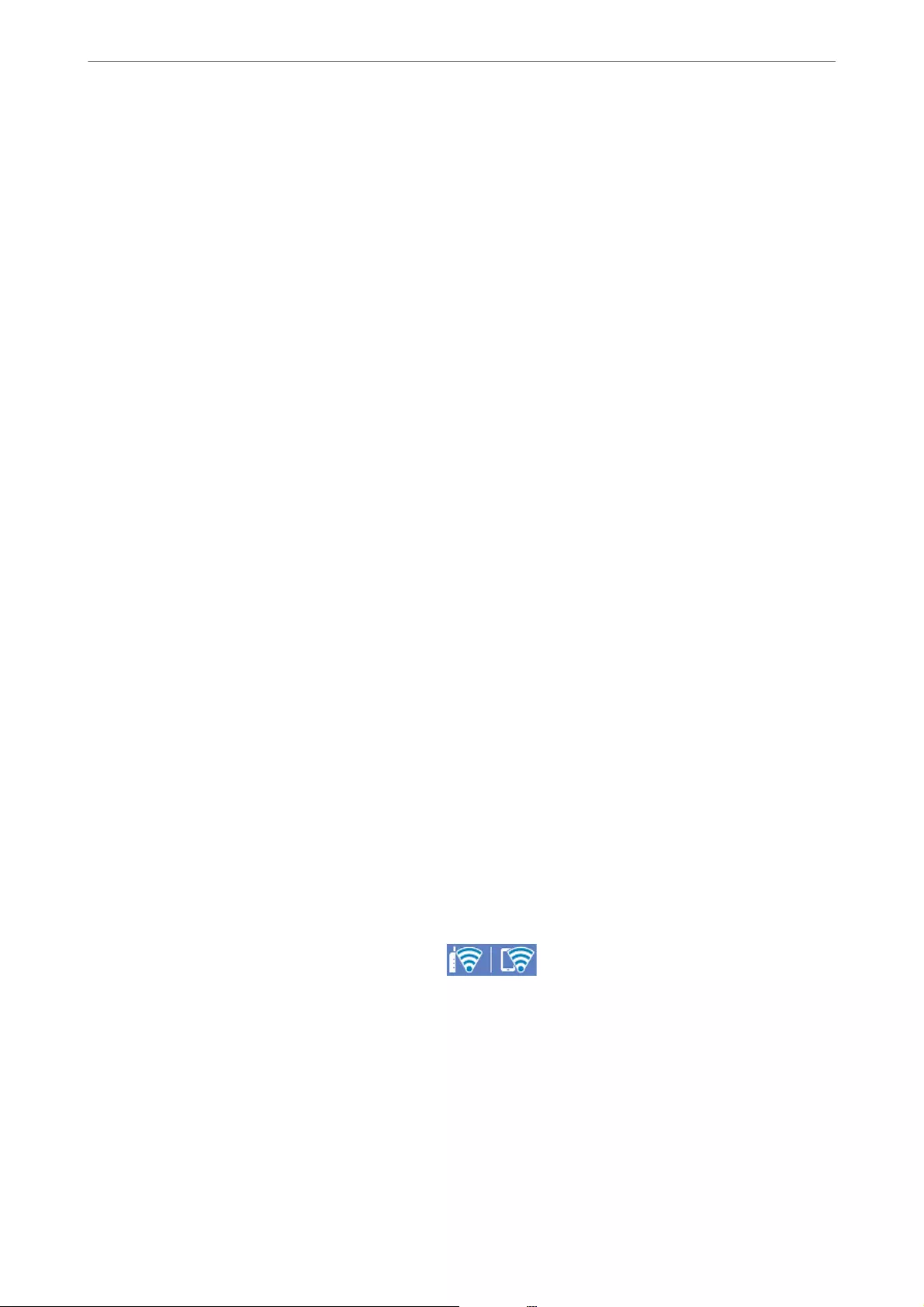
Bidirectional:
Select On to change the print direction; Prints while the print head moves to the le and to the right.
If vertical or horizontal ruled lines on your printout look blurred or misaligned, disabling this feature
may solve the problem; however, doing so may reduce print speed.
Output Tray Auto Extension:
Select On to automatically extend the output paper support when printing on paper larger than A4
size.
PC Connection via USB:
Select Enable to allow a computer to access the printer when connected by USB. When Disable is
selected, printing and scanning that is not sent over a network connection is restricted.
Related Information
&“Loading Paper” on page 31
Network Settings
Select the menus on the control panel as described below.
Settings > General Settings > Network Settings
Wi-Fi Setup:
Set up or change wireless network settings. Choose the connection method from following and then
follow the instructions on the control panel.
Router:
❏Wi-Fi Setup Wizard
❏Push Button Setup(WPS)
❏Others
❏PIN Code Setup(WPS)
❏Wi-Fi Auto Connect
❏Disable Wi-Fi
You may be able to resolve network problems by disabling the Wi-Fi settings or making
the Wi-Fi settings again. Tap > Router > Change Settings > Others >
Disable Wi-Fi > Start Setup.
Wi-Fi Direct:
❏iOS
❏Android
❏Other OS Devices
Product Information
>
Settings Menu List
>
General Settings
308

❏Change
❏Change Network Name
❏Change Password
❏Disable Wi-Fi Direct
❏Restore Default Settings
Wired LAN Setup:
Set up or change a network connection that uses a LAN cable and router. When this is being used,
Wi-Fi connections are disabled.
Network Status:
Displays or prints the current network settings.
❏Wired LAN/Wi-Fi Status
❏Wi-Fi Direct Status
❏Email Server Status
❏Print Status Sheet
Connection Check:
Checks the current network connection and prints a report. If there are any problems with the
connection, see the report to solve the problem.
Advanced:
Make the following detailed settings.
❏Device Name
❏TCP/IP
❏Proxy Server
❏Email Server
❏IPv6 Address
❏MS Network Sharing
❏Link Speed & Duplex
❏Redirect HTTP to HTTPS
❏Disable IPsec/IP Filtering
❏Disable IEEE802.1X
Related Information
&“Making Wi-Fi Settings by Entering the SSID and Password” on page 266
&“Making Wi-Fi Settings by Push Button Setup (WPS)” on page 267
&“Making Wi-Fi Settings by PIN Code Setup (WPS)” on page 268
&“Connecting a Smart Device and Printer Directly (Wi-Fi Direct)” on page 268
&“Printing a Network Connection Report” on page 280
&“Checking the Network Connection Status” on page 279
Product Information
>
Settings Menu List
>
General Settings
309

Web Service Settings
Select the menus on the control panel as described below.
Settings > General Settings > Web Service Settings
You cannot change settings that have been locked by your administrator.
Epson Connect Services:
Displays whether the printer is registered and connected to Epson Connect.
You can register to the service by selecting Register and follow the instructions.
When you have registered, you can change the following settings.
❏Suspend/Resume
❏Unregister
For details, see the following web site.
https://www.epsonconnect.com/
http://www.epsonconnect.eu (Europe only)
Related Information
&“Printing Using a Cloud Service” on page 79
Fax Settings
Selecting Settings > General Settings > Fax Settings from the printer's control panel displays this
menu.
Note:
❏You can also access Fax Settings from Web Cong. Click the Fax tab on the Web Cong screen.
❏When you use Web Cong to display the Fax Settings menu, there may be slight dierences in the user interface and in
location compared to the printer's control panel.
Related Information
&“Quick Operation Button” on page 310
&“Basic Settings” on page 311
&“Send Settings” on page 313
&“Receive Settings” on page 313
&“Report Settings” on page 320
&“Security Settings” on page 321
&“Check Fax Connection” on page 321
&“Fax Setting Wizard” on page 322
Quick Operation Button
You can nd the menu on the printer's control panel below.
Product Information
>
Settings Menu List
>
General Settings
310

Settings > General Settings > Fax Settings > Quick Operation Button
Note:
❏If a password entry screen is displayed, enter the administrator password.
❏You cannot display this menu on the Web Cong screen.
Quick Operation Button 1, Quick Operation Button 2, Quick Operation Button 3:
Registers up to three shortcuts allowing you to quickly access the menu you use oen when sending
faxes. e shortcuts are displayed on the following menu.
Fax > Fax Settings tab.
Basic Settings
You c a n nd the menu on the printer's control panel below.
Settings > General Settings > Fax Settings > Basic Settings
Note:
❏On the Web Cong screen, you can nd the menu below.
Fax tab > Basic Settings
❏If a password entry screen is displayed, enter the password.
Fax Speed:
Select the fax transmission speed. We recommend selecting Slow(9,600bps) when a communication
error occurs frequently, when sending/receiving a fax to/from abroad, or when you are using an IP
(VoIP) phone service.
ECM:
Automatically corrects errors in the fax transmission (Error Correction Mode), mostly caused by
telephone line noise. If this is disabled, you cannot send or receive documents in color.
Dial Tone Detection:
Detects a dial tone before starting to dial. If the printer is connected to a PBX (Private Branch
Exchange) or digital phone line, the printer may fail to start dialing. In this situation, change the Line
Type setting to PBX. If this does not work, disable this feature. However, disabling this feature may
drop the rst digit of a fax number and send the fax to the wrong number.
Dial Mode:
Select the type of phone system to which you have connected the printer. When set to Pulse, you can
temporarily switch the dialing mode from pulse to tone by pressing ("T" is entered) while entering
numbers on the fax top screen. is setting may not be displayed depending on your region or
country.
Line Type:
Select the line type to which you have connected the printer.
When using the printer in an environment that uses extensions and requires an external access code,
such as 0 and 9, to get an outside line, select PBX. For an environment that uses a DSL modem or
terminal adapter, setting to PBX is also recommended.
Product Information
>
Settings Menu List
>
General Settings
311

Access Code
Select Use, and then register an external access code such as 0 or 9. en, when sending a fax
to an outside fax number, enter # (hash) instead of the real code. # (hash) must also be used in
Contacts as an external access code. If an external access code such as 0 or 9 is set in a contact,
you cannot send faxes to the contact. In this case, set Access Code to Do Not Use, otherwise
you must change the code in Contacts to #.
Header:
Enter your sender name and fax number. ese appear as a header on outgoing faxes.
❏Your Phone Number: You can enter up to 20 characters using 0-9 + or space. For Web Cong, you
can enter up to 30 characters.
❏Fax Header: You can register up to 21 sender names as necessary. You can enter up to 40 characters
for each sender name. For Web Cong, enter the header in Unicode (UTF-8).
Receive Mode:
Select the receive mode. For details, see the related Information below.
DRD:
If you have subscribed to a distinctive ring service from your telephone company, select the ring
pattern to be used for incoming faxes. e distinctive ring service, oered by many telephone
companies (the service name diers by company), allows you to have several phone numbers on one
phone line. Each number is assigned dierent ring pattern. You can use one number for voice calls
and another for fax calls. Depending on the region, this option may be On or O.
Rings to Answer:
Select the number of rings that must occur before the printer automatically receives a fax.
Remote Receive:
Remote Receive
When you answer an incoming fax call on a phone connected to the printer, you can start
receiving the fax by entering the code using the phone.
Start Code
Set the start code of Remote Receive. Enter two characters using 0-9, *, #.
Rejection Fax:
Rejection Fax
Select options to reject receiving junk faxes.
❏Rejection Number List: If the other party's phone number is in the rejection number list, set
whether to reject the incoming faxes.
❏Fax Header Blank: If the other party's phone number is blocked, set whether to reject
receiving the faxes.
❏Unregistered Contacts: If the other party's phone number is not in the contacts, set whether
to reject receiving the faxes.
Product Information
>
Settings Menu List
>
General Settings
312

Edit Blocked Number list
You can register up to 30 fax numbers to reject the faxes and calls. Enter up to 20 characters
using 0-9, *, #, or space.
Related Information
&“Enabling Sending Faxes from a Computer” on page 401
&“Making the Printer Ready to Send and Receive Faxes” on page 390
&“Making Settings for a PBX Phone System” on page 392
&“Receiving Incoming Faxes” on page 119
&“Making Settings for Blocking Junk Faxes” on page 401
Send Settings
You can nd the menu on the printer's control panel below.
Settings > General Settings > Fax Settings > Send Settings
Note:
❏On the Web Cong screen, you can nd the menu below.
Fax tab > Send Settings
❏If a password entry screen is displayed, enter the password.
Batch Send:
When there are multiple faxes waiting to be sent to the same recipient, this groups them together to
send them at once. Up to ve documents (up to 100 pages in total) can be sent at one time. is helps
you save on transmission costs by reducing the number of connection times.
Save Failure Data:
Saves documents that failed to be sent in the printer's memory. You can resend the documents from
the Job/Status.
Wait Time for Next Original:
Set the time to wait for the next original. e printer starts sending the fax aer the time has passed.
Fax Preview Display Time:
You can preview the scanned document for a set time before sending it. e printer stars sending the
fax aer the time has passed.
PC to FAX Function:
is item is displayed on the Web Cong screen only. Enables sending faxes using a client computer.
Receive Settings
Related Information
&“Save/Forward Settings” on page 314
&“Print Settings” on page 318
Product Information
>
Settings Menu List
>
General Settings
313

Save/Forward Settings
Unconditional Save/Forward:
You c a n nd the menu on the printer's control panel below.
Settings > General Settings > Fax Settings > Receive Settings > Save/Forward Settings >
Unconditional Save/Forward
Note:
On the Web Cong screen, you can nd the menu below.
Fax tab > Save/Forward Settings > Unconditional Save/Forward
You can set saving and forwarding destinations to the Inbox, a computer, an external memory device,
email addresses, shared folders, and other fax machines. You can use these features at the same time.
If you set all items to O on the printer's control panel, the printer is set to print received faxes.
Related Information
&“Making Saving Settings to Receive Faxes” on page 394
&“Making Forwarding Settings to Receive Faxes” on page 395
Save to Inbox:
Saves received faxes to the printer's Inbox. Up to 100 documents can be saved. Note that saving
100 documents may not be possible depending on the usage conditions such as the le size of
saved documents, and using of multiple fax saving features at a time.
ough the received faxes are not automatically printed, you can view them on the printer's
screen and print only the ones you need. However, if you select Yes a nd Pri n t in another item,
such as Save to Computer in Unconditional Save/Forward, the received faxes are printed
automatically.
Save to Computer:
Saves received faxes as PDF les on a computer connected to the printer. You can set this to
Yes by using only the FAX Utility. Install FAX Utility on the computer in advance. Aer setting
this to Yes , you can change this to Yes a n d Print .
Save to Memory Device:
Saves received faxes as PDF les to an external memory device connected to the printer.
Selecting Yes and Pri n t prints received faxes while saving them to the memory device.
Received documents are saved in the printer's memory temporarily before the documents are
saved in the memory device connected to the printer. Because a memory full error disables
sending and receiving faxes, keep the memory device connected to the printer.
Forward:
Forwards received faxes to another fax machine, or forwards them as PDF les to a shared
folder on a network or to an email address. Forwarded faxes are deleted from the printer.
Selecting Yes and Pri n t prints received faxes while forwarding them. First add the forwarding
destinations to the contacts list. To forward to an email address, congure the email server
settings.
Product Information
>
Settings Menu List
>
General Settings
314

❏Destination: You can select forwarding destinations from the contacts list you added in
advance.
If you have selected a shared folder on a network or an email address as the forwarding
destination, we recommend that you test if you can send a scanned image to the destination
in the scan mode. Select Scan > Email, or Scan > Network Folder/FTP from the home
screen, select the destination, and then start scanning.
❏Options When Forwarding Failed: You can select whether to print the failed fax or save it to
the Inbox.
When the Inbox is full, receiving faxes is disabled. You should delete the documents from
the inbox once they have been checked. e number of documents that have failed to be
forwarded is displayed on the on the home screen, in addition to other unprocessed
jobs.
Email Notications:
Sends an email notication when the process you select below is complete. You can use the
features below at the same time.
Recipient
Set the destination of the process completion notication.
Notify on Receive
Sends a notication when receiving a fax is complete.
Notify on Print
Sends a notication when printing a fax is complete.
Notify on Save
Sends a notication when saving a fax to a memory device is complete.
Notify on Forward
Sends a notication when forwarding a fax is complete.
Related Information
&“Making Saving Settings to Receive Faxes” on page 394
&“Making Forwarding Settings to Receive Faxes” on page 395
Conditional Save/Forward:
You can nd the menu on the printer's control panel below.
Settings > General Settings > Fax Settings > Receive Settings > Save/Forward Settings >
Conditional Save/Forward
Note:
On the Web Cong screen, you can nd the menu below.
Fax tab > Save/Forward Settings > Conditional Save/Forward
You can set saving and/or forwarding destinations to the Inbox, condential boxes, an external
memory device, email addresses, shared folders, and another fax machine.
Product Information
>
Settings Menu List
>
General Settings
315
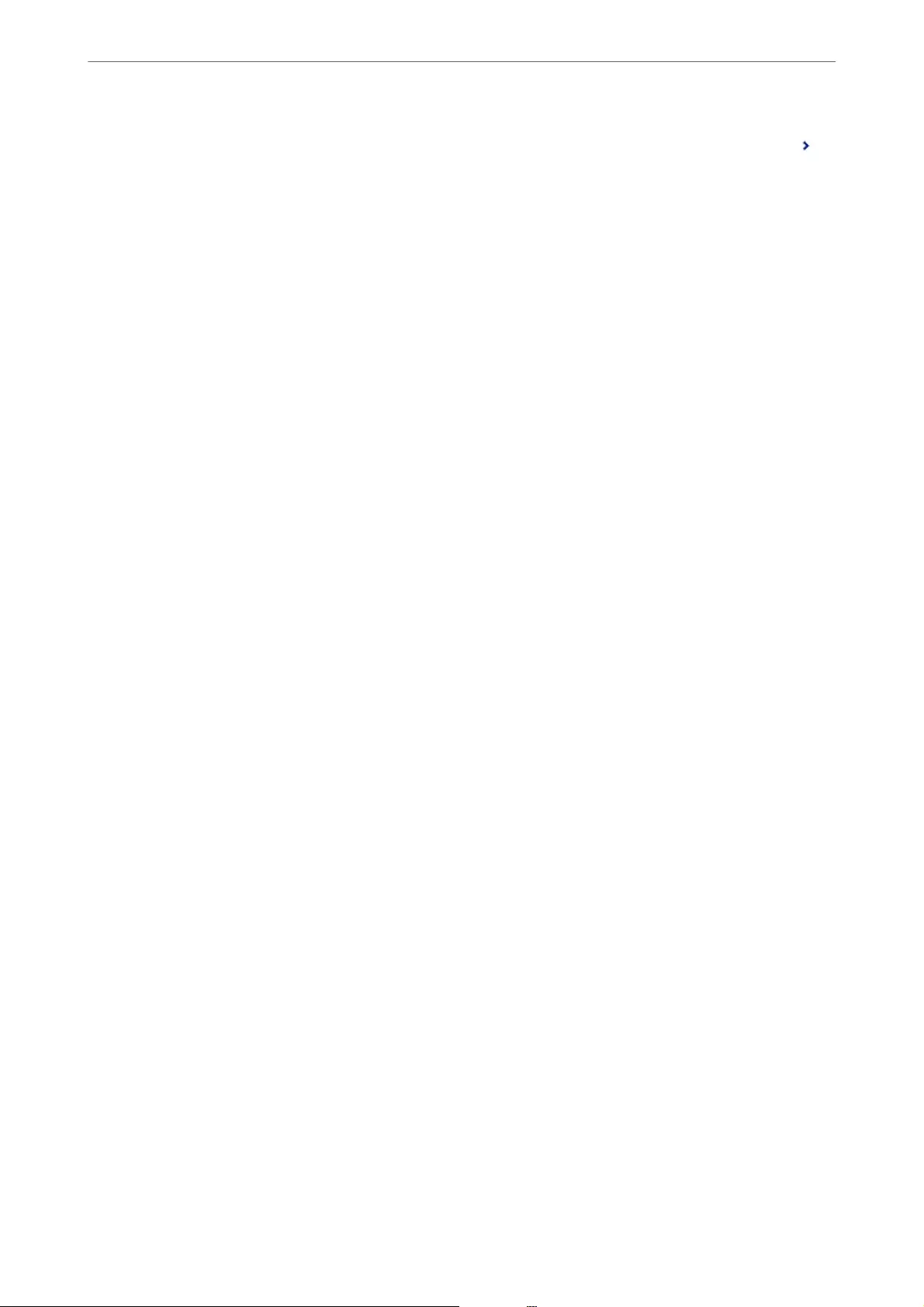
To switch between enabling or disabling the conditions, tap anywhere on the set item except for .
Related Information
&“Making Saving Settings to Receive Faxes with Specic Conditions” on page 397
&“Making Forwarding Settings to Receive Faxes with Specied Conditions” on page 399
Name:
Enter name of the condition.
Condition(s):
Select the conditions and make the settings.
Sender Fax Number match
When the sender fax number matches, the received fax is saved and forwarded.
Subaddress(SUB) perfect match
When the subaddress (SUB) matches perfectly, the received fax is saved and forwarded.
Password(SID) perfect match
When the password (SID) matches perfectly, the received fax is saved and forwarded.
Receiving Time
Saves and forwards a fax received during the specied period of time.
Save/Forward Destination:
Select the destination to save and forward received documents that match the conditions. You
can use the features below at the same time.
Save to Fax Box:
Saves received faxes in the printer's Inbox or condential box.
You can save up to 100 documents in total. Note that saving 100 documents may not be
possible depending on the usage conditions such as the le size of saved documents,
and using of multiple fax saving features at a time.
Save to Memory Device:
Saves received faxes as PDF les to an external memory device connected to the printer.
Received documents are saved in the printer's memory temporarily before the
documents are saved in the memory device connected to the printer. Because a memory
full error disables sending and receiving faxes, keep the memory device connected to
the printer.
Forward:
Forwards received faxes to another fax machine, or forwards them as PDF les to a
shared folder on a network or to an email address. Forwarded faxes are deleted from the
printer. First add the forwarding destination to the contacts list. To forward to an email
address, you also need to congure the email server settings.
Product Information
>
Settings Menu List
>
General Settings
316

❏Destination: You can select a forwarding destination from the contacts list you added
in advance.
If you have selected a shared folder on a network or an email address as the
forwarding destination, we recommend that you test if you can send a scanned image
to the destination in the scan mode. Select Scan > Email, or Scan > Network
Folder/FTP from the home screen, select the destination, and then start scanning.
❏Options When Forwarding Failed: You can select whether to print the failed fax or
save it to the Inbox.
Print:
Prints received faxes.
Email Notications:
Sends an email notication when the process you select below is complete. You can use the
features below at the same time.
Recipient
Set the destination of the process completion notication.
Notify on Receive
Sends a notication when receiving a fax is complete.
Notify on Print
Sends a notication when printing a fax is complete.
Notify on Save
Sends a notication when saving a fax to a memory device is complete.
Notify on Forward
Sends a notication when forwarding a fax is complete.
Transmission Report:
Prints a transmission report automatically aer you save or forward a received fax.
Selecting Print on Error prints a report only when you save or forward a received fax and an
error occurs.
Related Information
&“Making Saving Settings to Receive Faxes with Specic Conditions” on page 397
&“Making Forwarding Settings to Receive Faxes with Specied Conditions” on page 399
Common Settings:
You can nd the menu on the printer's control panel below.
Settings > General Settings > Fax Settings > Receive Settings > Save/Forward Settings > Common
Settings
Product Information
>
Settings Menu List
>
General Settings
317

Note:
On the Web Cong screen, you can nd the menu below.
❏Fax tab > Fax Box > Inbox
❏Fax tab > Save/Forward Settings > Common Settings
Inbox settings:
Options when memory is full:
You can select the operation to print the received fax or refuse to receive it when the
Inbox memory is full.
Inbox Password Settings:
Password protects the Inbox to restrict users from viewing received faxes. Select Change
to change the password, and select Reset to cancel password protection. When changing
or resetting the password, you need the current password.
You c a n n ot s e t a password when Options when memory is full has been set to Receive
and print faxes.
Email Subject to Forward:
You can specify a subject for the email when forwarding to an email address.
Menu:
You c a n nd on the printer's control panel by accessing the following menus in order.
Settings > General Settings > Fax Settings > Receive Settings > Save/Forward Settings >
Note:
You cannot print the list from the Web Cong screen.
Print Conditional Save/Forward list:
Prints the Conditional Save/Forward list.
Print Settings
You can nd the menu on the printer's control panel below.
Settings > General Settings > Fax Settings > Receive Settings > Print Settings
Note:
❏On the Web Cong screen, you can nd the menu below.
Fax tab > Print Settings
❏If a password entry screen is displayed, enter the password.
Auto Reduction:
Prints received faxes with large-size documents reduced to t on the paper in the paper source.
Reducing may not always be possible depending on the received data. If this is turned o, large
documents are printed at their original size on multiple sheets, or a blank second page may be
ejected.
Product Information
>
Settings Menu List
>
General Settings
318

Split Page Settings:
Prints received faxes with the page split when the size of the received documents is larger than the
size of the paper loaded in the printer.
Auto Rotation:
Rotates faxes received as landscape-oriented A5 size documents so that they are printed on A5 size
paper. is setting is applied when the paper size setting for at least one paper source used for
printing faxes is set to A5.
By selecting O, faxes received as landscape-oriented A5 size, which are the same width as A4
portrait documents, are assumed to be A4 size faxes and printed as such.
Check the paper source settings for printing faxes and paper size for the paper sources in the
following menus in Settings > General Settings > Printer Settings > Paper Source Settings.
❏Auto Select Settings
❏Paper Setting > Paper Size
Add Reception Information:
Prints reception information on the received fax, even if the sender does not set the header
information. e reception information includes the received date and time, sender's ID, reception
ID (such as " #001"), and page number (such as "P1"). By collating the reception ID printed on the
received fax, you can check the transmission log in the fax report and the fax job history. When Split
Page Settings is enabled, the split page number is also included.
2-Sided:
Prints multiple pages of received faxes on both sides of the paper.
Print Start Timing:
Select options to start printing the faxes to receive.
❏All Pages Received: Printing starts aer receiving all of the pages. To start printing from the rst
page or last page depends on the setting of Collation Stack feature. See the explanation for
Collation Stack.
❏First Page Received: Starts printing when the rst page is received, and then prints in order as the
pages are received. If the printer cannot start printing, such as when it is printing other jobs, the
printer starts printing received pages as a batch when it is available.
Collation Stack:
Since the rst page is printed last (output to the top), the printed documents are stacked in the correct
page order. When the printer is running low on memory, this feature may not be available.
Print Suspend Time:
Print Suspend Time
During the specied time period, the printer saves documents received in the printer's
memory without printing them. is feature can be used for noise prevention at night or to
prevent condential documents from being disclosed while you are away. Before using this
feature, make sure there is enough free memory. Even before the restarting time, you can check
and print the received documents individually from Job/Status on the home screen.
Time to Stop
Stops printing documents.
Product Information
>
Settings Menu List
>
General Settings
319

Time to Restart
Restarts printing documents automatically.
Quiet Mode:
Reduces the noise the printer makes when printing faxes, however, print speed may be reduced.
Report Settings
You can nd the menu on the printer's control panel below.
Settings > General Settings > Fax Settings > Report Settings
Note:
❏On the Web Cong screen, you can nd the menu below.
Fax tab > Report Settings
❏If a password entry screen is displayed, enter the password.
Forwarding Report:
Prints a report aer forwarding a received fax document. Select Print to print every time a document
is forwarded.
Backup Error Report:
Prints a report when a backup error occurs on forwarding the sent fax to Backup Destination. You
can set the destination in Fax > Fax Settings > Backup. Note that the backup feature is available
when:
❏Sending a fax in monochrome
❏Sending a fax using the Send Fax Later feature
❏Sending a fax using the Batch Send feature
❏Sending a fax using the Store Fax Data feature
Fax Log Auto Print:
Prints the fax log automatically. Select On(Every 30) to print a log every time 30 fax jobs are
completed. Select On(Time) to print the log at a specied time. However, if the number of fax jobs
exceeds 30, the log is printed before the specied time.
Attach Fax image to report:
Prints a Transmission Report with an image of the rst page of the sent document. Select On(Large
Image) to print the upper part of the page without reducing. Select On(Small Image) to print the
entire page reducing it to t onto the report.
Report Format:
Selects a format for fax reports in Fax > More tab > Fax Report other than Protocol Trace. Select
Detail to print with error codes.
Output Method:
Select an output method for fax reports, such as Save to Memory Device. When you select Forward,
select Destination from the contacts.
Product Information
>
Settings Menu List
>
General Settings
320

Security Settings
You can nd the menu on the printer's control panel below.
Settings > General Settings > Fax Settings > Security Settings
Note:
❏On the Web Cong screen, you can nd the menu below.
Fax tab > Security Settings
❏If a password entry screen is displayed, enter the password.
Direct Dialing Restrictions:
Selecting On disables manual entry of the recipient's fax numbers allowing the operator to select
recipients only from the contacts list or sent history.
Selecting Enter Twice requires the operator to enter the fax number again when the number was
manually entered.
Selecting O enables manual entry of the recipient's fax numbers.
Broadcasting Restrictions:
Selecting On allows only one fax number to be entered as the Recipient.
Conrm Address List:
Selecting On displays a recipient conrmation screen before starting the transmission.
You can select the recipients from All or Only for Broadcasting.
Backup Data Auto Clear:
Selecting On automatically erases the backups when sending or receiving a document completes
successfully and the backups become unnecessary.
Selecting O, to prepare for an unexpected power o due to an electricity failure or an incorrect
operation, temporarily stores backup copies of sent and received documents in its memory.
Clear Backup Data:
Erases all backup copies temporarily stored in the printer's memory. Run this before you give the
printer to someone else or dispose of it.
is menu is not displayed on the Web Cong screen.
Check Fax Connection
You can nd the menu on the printer's control panel below.
Settings > General Settings > Fax Settings > Check Fax Connection
Note:
You cannot display this menu on the Web Cong screen.
Selecting Check Fax Connection checks that the printer is connected to the phone line and ready for fax
transmission. You can print the check result on A4 size plain paper.
Product Information
>
Settings Menu List
>
General Settings
321

Fax Setting Wizard
You can nd the menu on the printer's control panel below:
Settings > General Settings > Fax Settings > Fax Setting Wizard
Note:
You cannot display this menu on the Web Cong screen.
Selecting Fax Setting Wizard makes basic fax settings. Follow the on-screen instructions.
Related Information
&“Basic Settings” on page 311
&“Making the Printer Ready to Send and Receive Faxes” on page 390
Scan Settings
Conrm Recipient
Check destination before scanning.
Email Server
Set the email server settings for scanning Email.
❏Server Settings
Specify the authentication method for the printer to access the mail server.
“Mail Server Setting Items” on page 355
❏Connection Check
Check the connection to the mail server.
System Administration
By using this menu, you can maintain the product as a system administrator. It also allows you to restrict product
features for individual users to suite your work or oce style.
Select the menus on the control panel as described below.
Settings > General Settings > System Administration
Contacts Manager:
You can make the following settings for contacts.
Register/Delete:
Register and/or delete contacts for the Fax, Scan to Email, and Scan to Network Folder/FTP
menus.
Frequent:
Register frequently used contacts to access them quickly. You can also change the order of the
list.
Product Information
>
Settings Menu List
>
General Settings
322

Print Contacts:
Print your contact list.
View Options:
Change the way the contact list is displayed.
Search Options:
Change the method for searching contacts.
Clear Internal Memory Data:
Delete the printer's internal memory data, such as jobs with passwords.
Security Settings:
You can make the following security settings.
Restrictions:
Permit to change the settings of the following items when panel lock is enabled.
❏Job Log Access
❏Access to Register/Delete Contacts
❏Fax Recent Access
❏Fax Transmission Log Access
❏Access to Fax Report
❏Access to Print Save History of Scan to Network Folder/FTP
❏Access to Recent of Scan to Email
❏Access to Show Sent History of Scan to Email
❏Access to Print Sent History of Scan to Email
❏Access to Language
❏Access to ick Paper
❏Access to Quiet Mode
❏Protection of Personal Data
Access Control:
Select On to restrict product features. is requires users to log into the product control panel
with their user name and password before they can use control panel features. In Accept
Unknown User Jobs, you can select whether or not to allow jobs that do not have the
necessary authentication information.
Admin Settings:
❏Admin Password
Set, change, and clear an administrator password.
❏Lock Setting
Select whether or not to lock the control panel using the password registered in Admin
Password.
Product Information
>
Settings Menu List
>
General Settings
323

Password Encryption:
Select On to encrypt your password. If you turn the power o while restart is in progress, data
may be damaged and the printer settings are restores to defaults. In that case, set password
information again.
Customer Research:
Select Approve to provide product usage information such as the number of prints to Seiko Epson
Corporation.
Restore Default Settings:
Reset the settings in the following menus to their defaults.
❏Network Settings
❏Copy Settings
❏Scan Settings
❏Fax Settings
❏Clear All Data and Settings
Firmware Update:
You can get rmware information such as your current version and information on available updates.
Update:
Check if the latest version of the rmware has been uploaded to the network server. If an
update is available, you can select whether or not to start updating.
Notication:
Select On to receive a notication if a rmware update is available.
Print Counter
Select the menus on the control panel as described below.
Settings > Print Counter
Displays the total number of prints, B&W prints, and color prints including items such as the status sheet from the
time you purchased the printer.
Supply Status
Select the menus on the control panel as described below.
Settings > Supply Status
Displays the approximate service life of the maintenance box. When is displayed, the maintenance box is
nearly full. When is displayed, the maintenance box is full.
Product Information
>
Settings Menu List
>
Supply Status
324

Related Information
&“Relling the Ink Tanks” on page 231
Maintenance
Select the menus on the control panel as described below.
Settings > Maintenance
Print Quality Adjustment:
Select this feature if there are any problems with your print outs. You can check for clogged nozzles
and clean the print head if necessary, and then adjust some parameters to improve print quality.
Print Head Nozzle Check:
Select this feature to check if the print head nozzles are clogged. e printer prints a nozzle check
pattern.
Print Head Cleaning:
Select this feature to clean clogged nozzles in the print head.
Power Cleaning:
Select this feature to replace all of the ink inside the ink tubes. More ink is consumed than in usual
cleaning. See the "Related Information" below for details on using this feature.
Print Head Alignment:
Select this feature to adjust the print head to improve print quality.
❏Ruled Line Alignment
Select this feature to align vertical lines.
❏Horizontal Alignment
Select this feature if horizontal banding appears at regular intervals in your printouts.
Fill Ink:
Select this feature to reset the ink level to 100% when lling the ink tank.
Reset Ink Level:
Select this feature to set the ink level according to the actual ink remaining.
Paper Guide Cleaning:
Select this feature if there are ink stains on the internal rollers. e printer feeds paper to clean the
internal rollers.
Remove Paper:
Select this feature if there are still some torn pieces of paper inside the printer even aer removing
jammed paper. e printer makes more space between the print head and the surface of the paper to
easily remove the torn pieces of paper.
Product Information
>
Settings Menu List
>
Maintenance
325

Periodic Cleaning:
e printer automatically performs Print Head Nozzle Check and Print Head Cleaning based on
the specic period of time. Select On to maintain premium print quality. Under the following
conditions, perform Print Head Nozzle Check and Print Head Cleaning yourself.
❏Printout problems
❏When O is selected for Periodic Cleaning
❏When printing at high quality, such as photos
❏When the Print Head Cleaning message is displayed on the LCD screen
Related Information
&“Checking and Cleaning the Print Head” on page 147
&“Running Power Cleaning (Mac OS)” on page 150
&“Relling the Ink Tanks” on page 231
&“Cleaning the Paper Path for Ink Smears” on page 151
Language
Select the menus on the control panel as described below.
Settings > Language
Select the language used on the LCD screen.
Printer Status/Print
Select the menus on the control panel as described below.
Settings > Printer Status/Print
Print Status Sheet:
Conguration Status Sheet:
Print information sheets showing the current printer status and settings.
Supply Status Sheet:
Print information sheets showing the status of consumables.
Usage History Sheet:
Print information sheets showing the usage history of the printer.
Network:
Displays the current network settings. You can also print the status sheet.
Product Information
>
Settings Menu List
>
Printer Status/Print
326
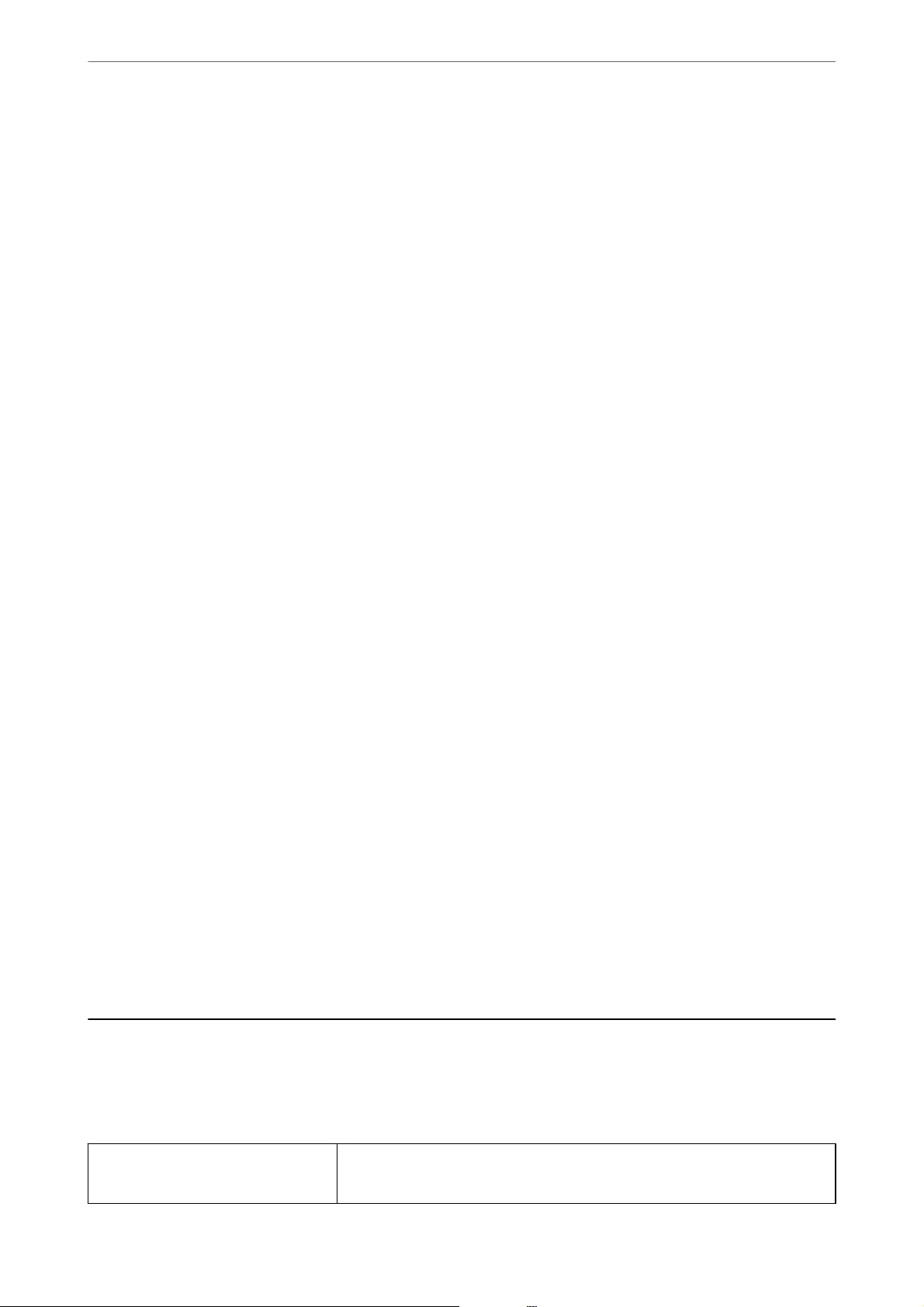
Contacts Manager
Select the menus on the control panel as described below.
Settings > Contacts Manager
Register/Delete:
Register and/or delete contacts for the Fax, Scan to Email, and Scan to Network Folder/FTP menus.
Frequent:
Register frequently used contacts to access them quickly. You can also change the order of the list.
Print Contacts:
Print your contact list.
View Options:
Change the way the contact list is displayed.
Search Options:
Change the method for searching contacts.
User Settings
Select the menus on the control panel as described below.
Settings > User Settings
You can change the default settings for your frequently used scanning, copying, and faxing settings. See the
following related information for details.
❏Scan to Network Folder/FTP
❏Scan to Email
❏Scan to Computer
❏Scan to Memory Device
❏Scan to Cloud
❏Copy Settings
❏Fax
Product Specications
Printer Specications
Print Head Nozzle Placement Black ink nozzles: 800
Color ink nozzles: 256 for each color
Product Information
>
Product Specications
>
Printer Specications
327
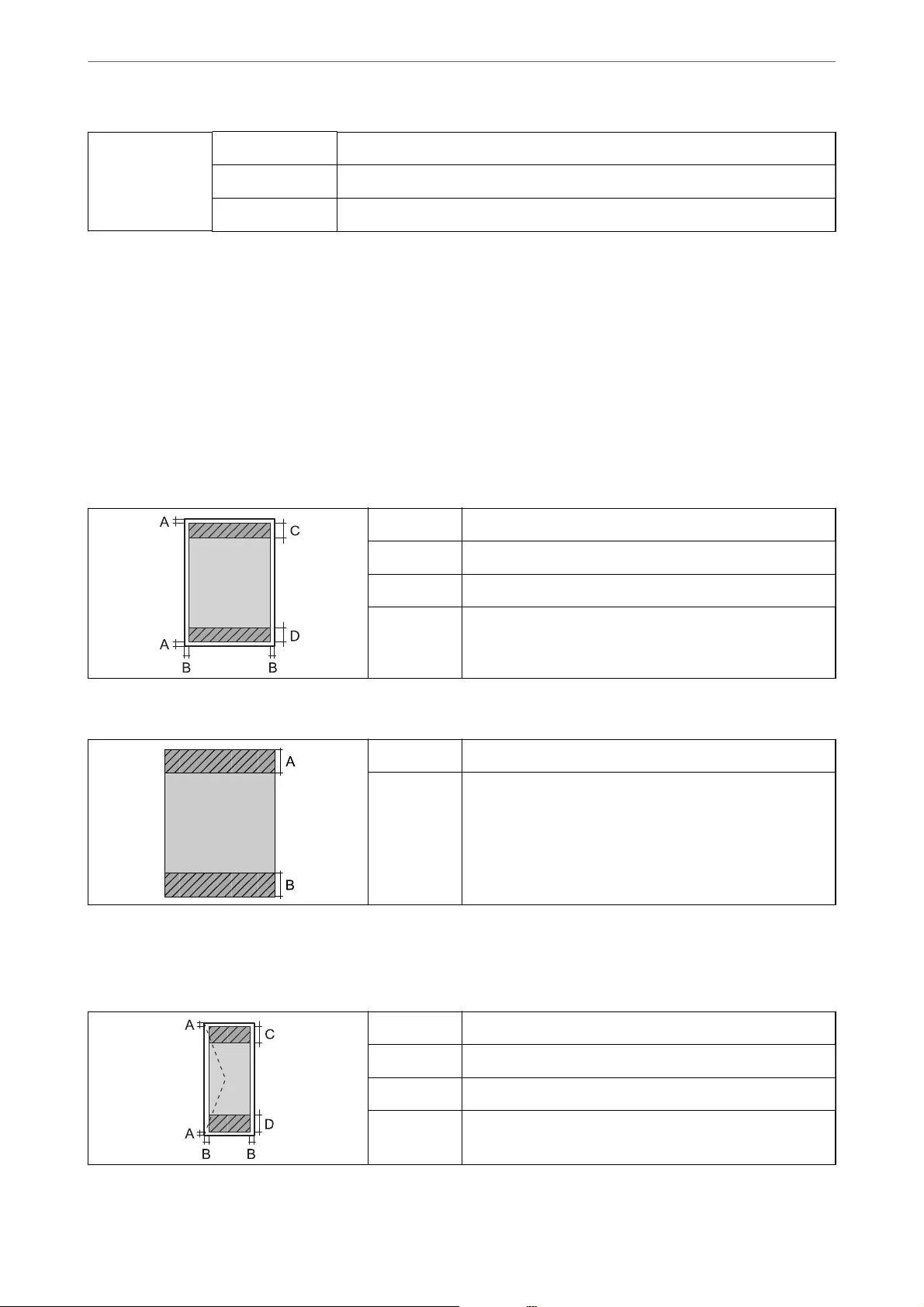
Weight of Paper
*
Plain Paper 64 to 90 g/m(17 to 24lb)
Thick Paper 91 to 256 g/m (25 to 68 lb)
Envelopes Envelope #10, DL, C6, C4: 75 to 100 g/m (20 to 27 lb)
* Even when the paper thickness is within this range, the paper may not feed in the printer or print result may adversely
aected depending on the paper property or quality.
Printable Area
Printable Area for Single Sheets
Print quality may decline in the shaded areas due to the printer's mechanism.
Printing with borders
A 3.0 mm (0.12 in.)
B 3.0 mm (0.12 in.)
C 48.0 mm (1.89 in.)
D 49.0 mm (1.93 in.)
Borderless printing
A 51.0 mm (2.01 in.)
B 52.0 mm (2.05 in.)
Printable Area for Envelopes
Print quality may decline in the shaded areas due to the printer's mechanism.
A 3.0 mm (0.12 in.)
B 3.0 mm (0.12 in.)
C 48.0 mm (1.89 in.)
D 49.0 mm (1.93 in.)
Product Information
>
Product Specications
>
Printer Specications
328
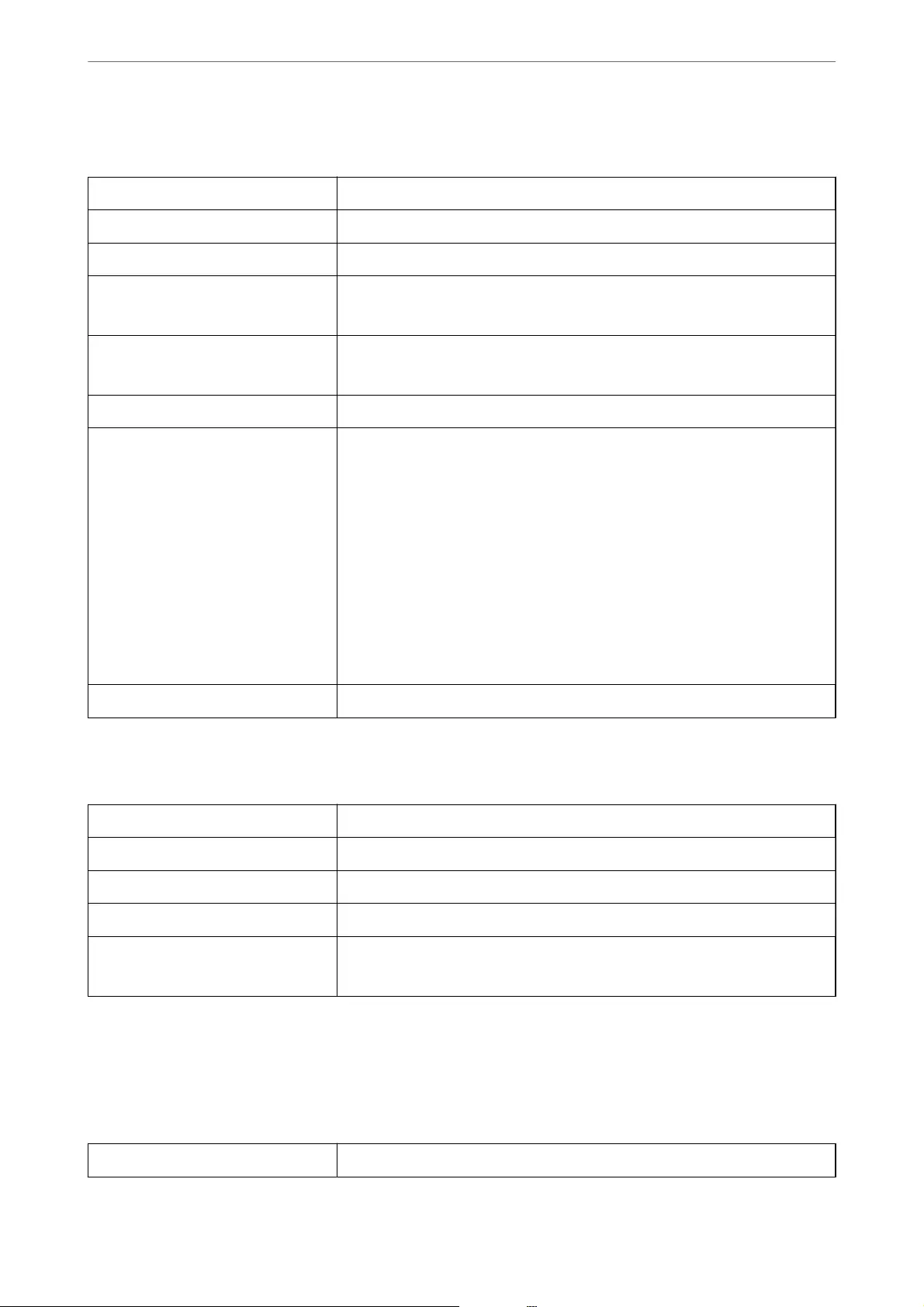
Scanner Specications
Scanner Type Flatbed
Photoelectric Device CIS
Eective Pixels 10200×14040 pixels (1200 dpi)
Maximum Document Size 216×297 mm (8.5×11.7 in.)
A4, Letter
Scanning Resolution 1200 dpi (main scan)
2400 dpi (sub scan)
Output Resolution 50 to 9600 dpi in 1 dpi increments
Color Depth Color
❏48 bits per pixel internal (16 bits per pixel per color internal)
❏24 bits per pixel external (8 bits per pixel per color external)
Grayscale
❏16 bits per pixel internal
❏8 bits per pixel external
Black and white
❏16 bits per pixel internal
❏1 bits per pixel external
Light Source LED
ADF Specications
ADF Type Auto duplex scanning
Available Paper Sizes A5, A4, B5, Letter, Legal
Paper Type Plain Paper
Weight of Paper 64 to 95 g/m
Loading Capacity Except for Legal: 50 sheets or 5.5 mm
Legal: 10 sheets
Even when the original meets the specications for media that can be placed in the ADF, it may not feed from the
ADF or the scan quality may decline depending on the paper properties or quality.
Fax Specications
Fax Type Walk-up black-and-white and color fax capability (ITU-T Super Group 3)
Product Information
>
Product Specications
>
Fax Specications
329
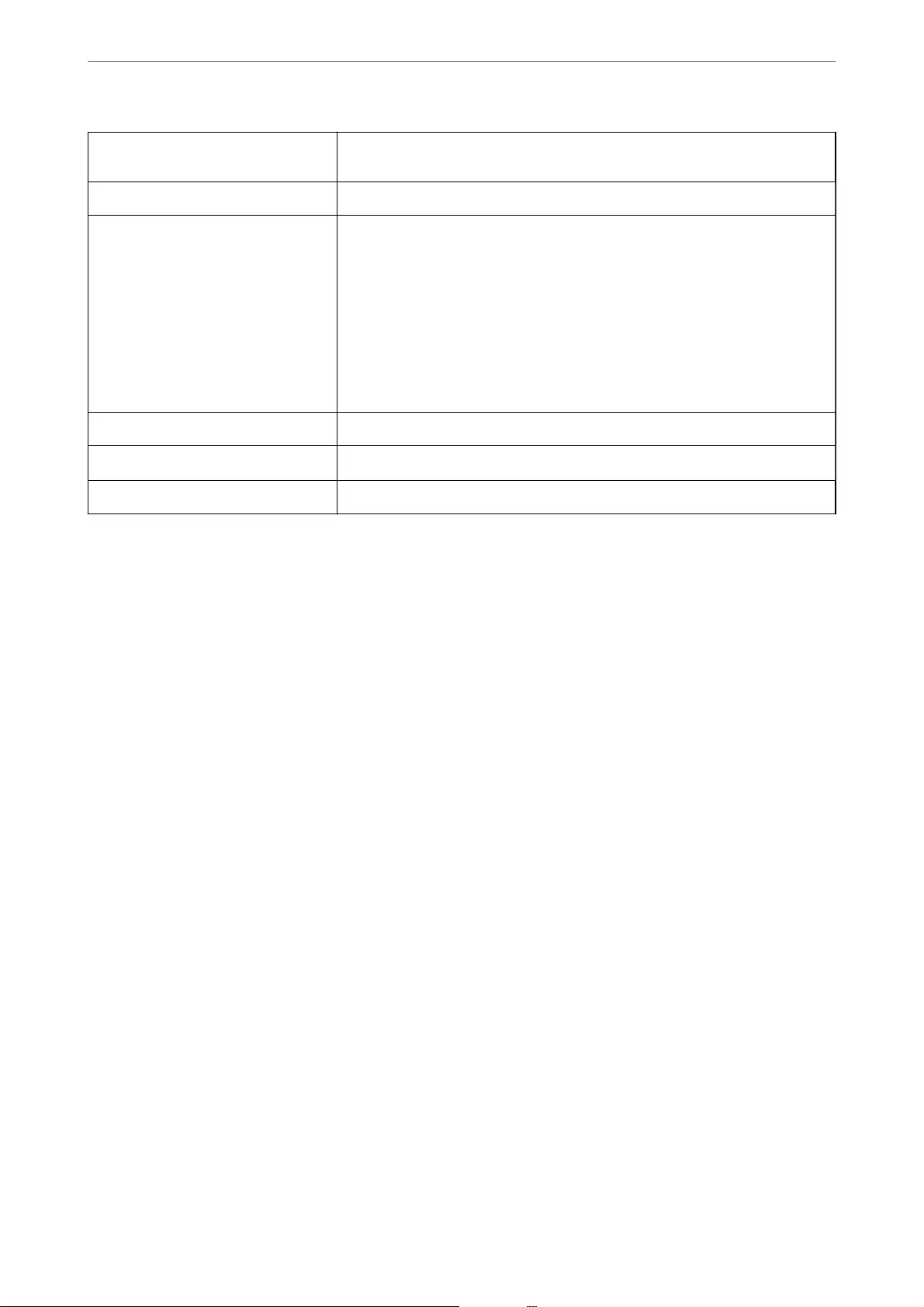
Supported Lines Standard analogue telephone lines, PBX (Private Branch Exchange) telephone
systems
Speed Up to 33.6 kbps
Resolution Monochrome
❏Standard: 8 pel/mm×3.85 line/mm (203 pel/in.×98 line/in.)
❏Fine: 8 pel/mm×7.7 line/mm (203 pel/in.×196 line/in.)
❏Super Fine: 8 pel/mm×15.4 line/mm (203 pel/in.×392 line/in.)
❏Ultra Fine: 16 pel/mm×15.4 line/mm (406 pel/in.×392 line/in.)
Color
200×200 dpi
Page Memory Up to 550 pages (when received ITU-T No.1 chart in monochrome draft mode)
Redial
*
2 times (with 1 minute intervals)
Interface RJ-11 Phone Line, RJ-11 Telephone set connection
* The specications may dier by country or region.
Using Port for the Printer
e printer uses the following port. ese ports should be allowed to become available by the network
administrator as necessary.
Product Information
>
Product Specications
>
Using Port for the Printer
330
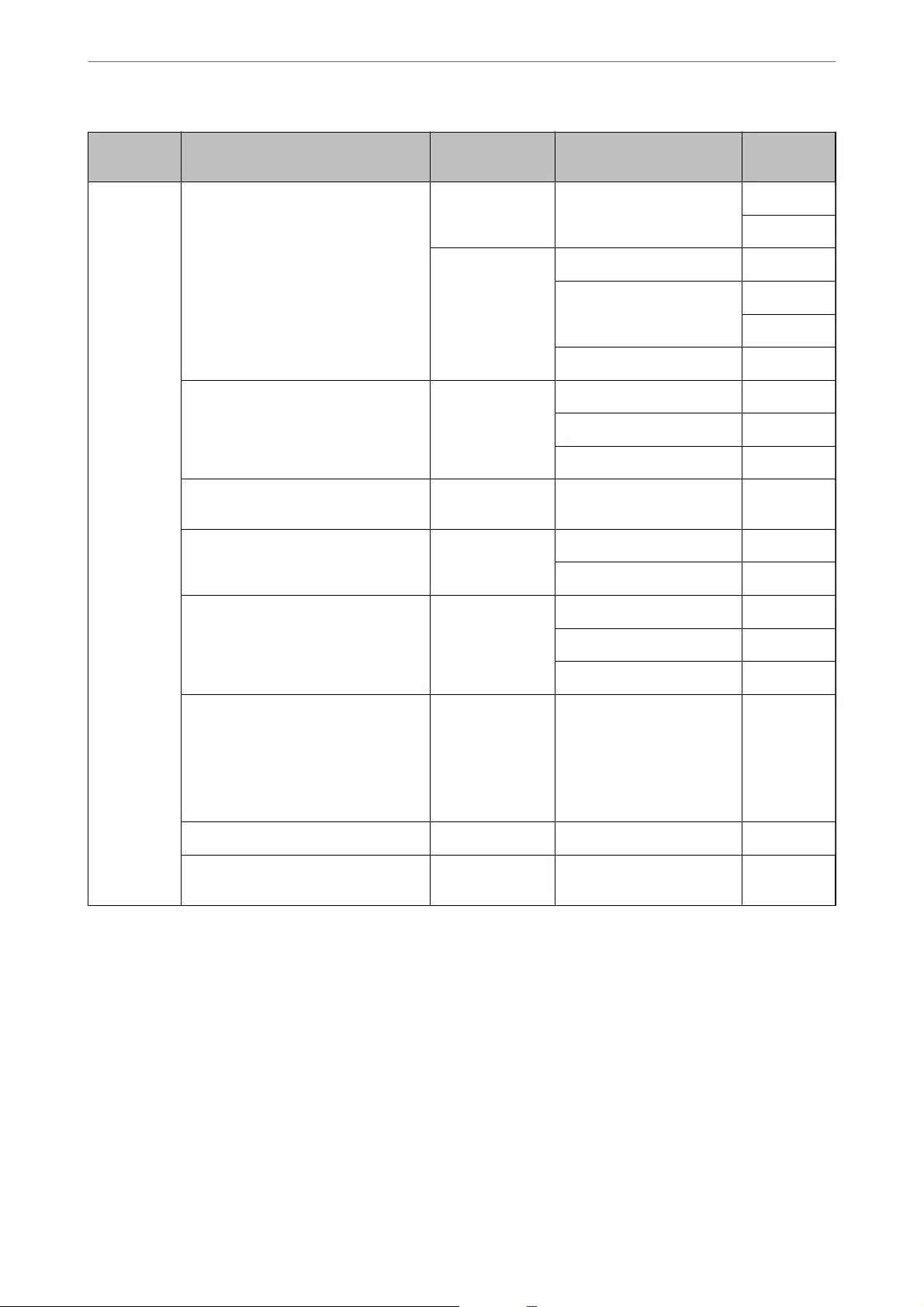
Sender
(Client)
Use Destination
(Server)
Protocol Port
Number
Printer File sending (When scan to network
folder is used from the printer)
FTP server FTP (TCP) 20
21
File server SMB (TCP) 445
NetBIOS (UDP) 137
138
NetBIOS (TCP) 139
Email sending (When scan to mail is
used from the printer)
SMTP server SMTP (TCP) 25
SMTP SSL/TLS (TCP) 465
SMTP STARTTLS (TCP) 587
POP before SMTP connection (When
scan to mail is used from the printer)
POP server POP3 (TCP) 110
When Epson Connect is used Epson Connect
Server
HTTPS 443
XMPP 5222
Collecting user information (Use the
contacts from the printer)
LDAP server LDAP (TCP) 389
LDAP SSL/TLS (TCP) 636
LDAP STARTTLS (TCP) 389
User authentication when collecting
user information (When using the
contacts from the printer)
User authentication when using the
scan to network folder (SMB) from the
printer
KDC server Kerberos 88
Control WSD Client computer WSD (TCP) 5357
Search the computer when push
scanning from Epson ScanSmart
Client computer Network Push Scan
Discovery
2968
Product Information
>
Product Specications
>
Using Port for the Printer
331
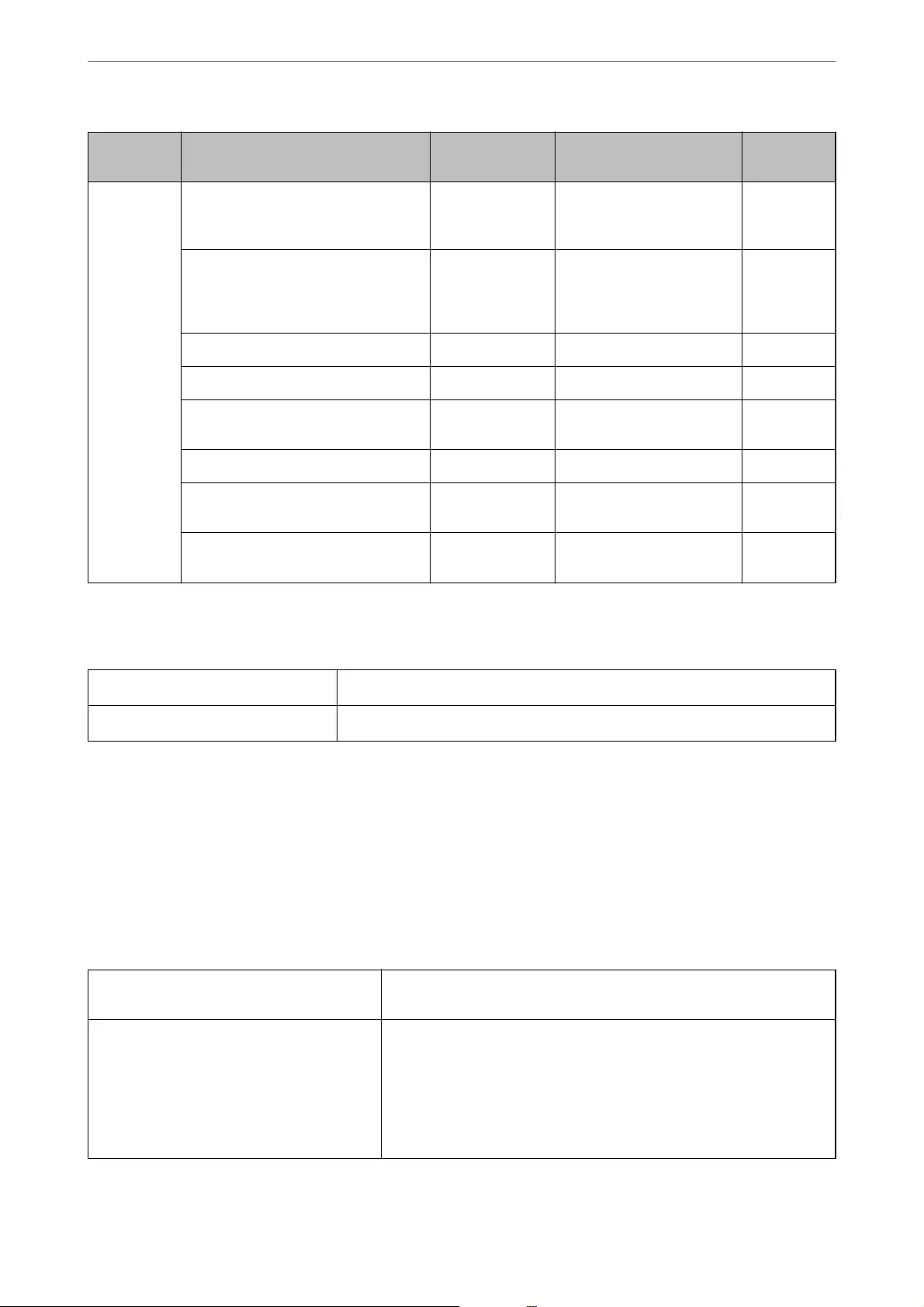
Sender
(Client)
Use Destination
(Server)
Protocol Port
Number
Client
computer
Discover the printer from an
application such as EpsonNet Cong,
printer driver, and scanner driver.
Printer ENPC (UDP) 3289
Collect and set up the MIB information
from an application such as EpsonNet
Cong, printer driver, and scanner
driver.
Printer SNMP (UDP) 161
Forwarding LPR data Printer LPR (TCP) 515
Forwarding RAW data Printer RAW (Port9100) (TCP) 9100
Forwarding AirPrint (IPP/IPPS printing)
data
Printer IPP/IPPS (TCP) 631
Searching WSD printer Printer WS-Discovery (UDP) 3702
Forwarding the scan data from Epson
ScanSmart
Printer Network Scan (TCP) 1865
Collecting the job information when
push scanning from Epson ScanSmart
Printer Network Push Scan 2968
Interface Specications
For Computer Hi-Speed USB
*
For External USB Device Hi-Speed USB
*
* USB 3.0 cables are not supported.
Network Specications
Wi-Fi Specications
See the following table for Wi-Fi specications.
Countries or regions except for those listed
below
Table A
Australia
New Zealand
China
Hong Kong
South Korea
Table B
Product Information
>
Product Specications
>
Network Specications
332
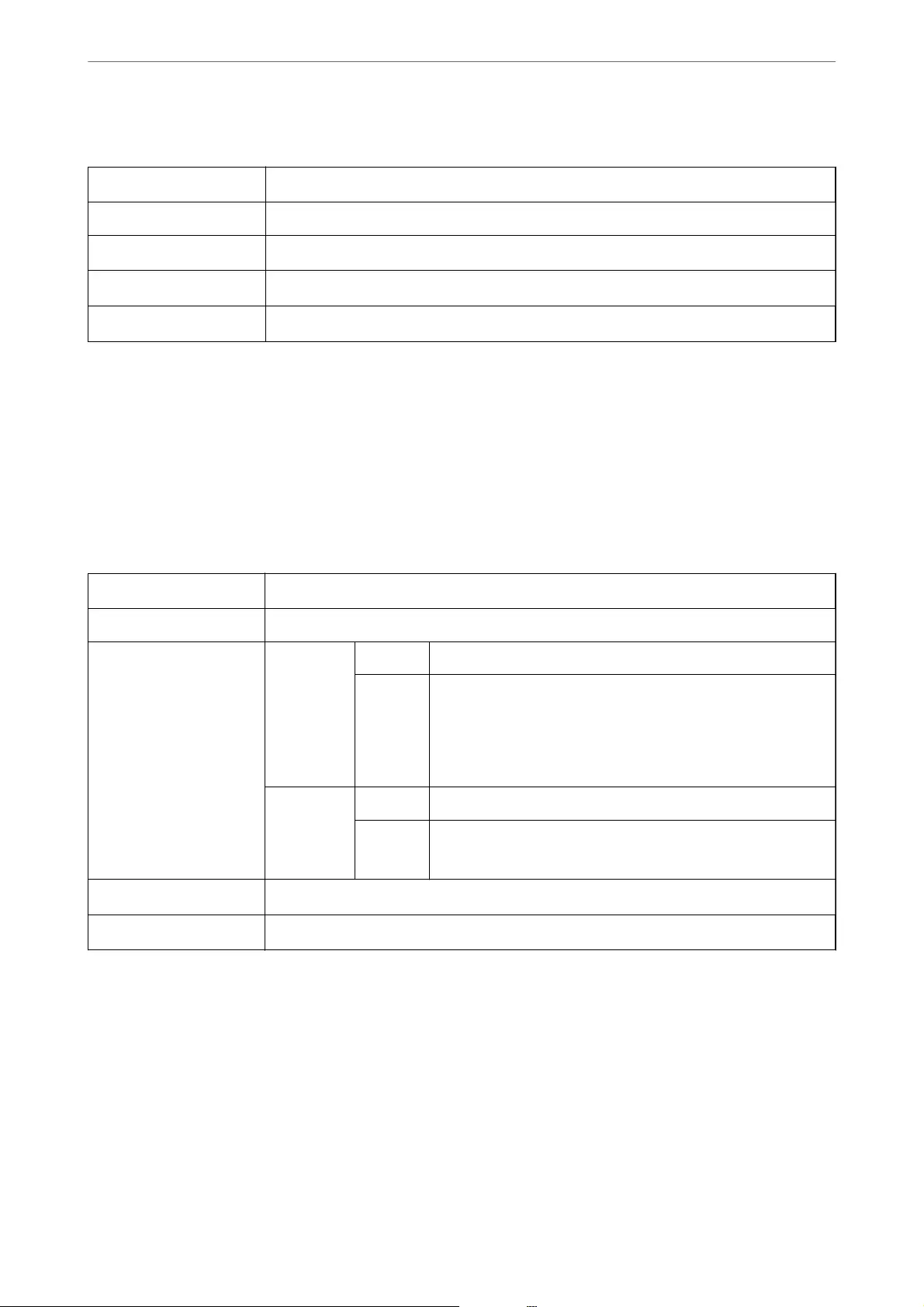
Table A
Standards IEEE802.11b/g/n
*1
Frequency Range 2.4 GHz
Channels 1/2/3/4/5/6/7/8/9/10/11/12
*2
/13
*2
Coordination Modes Infrastructure, Wi-Fi Direct (Simple AP)
*3*4
Security Protocols
*5
WEP (64/128bit), WPA2-PSK (AES)
*6
, WPA3-SAE (AES), WPA2/WPA3-Enterprise
*1 Only available for the HT20
*2 Not available in Taiwan
*3 Not supported for IEEE 802.11b
*4 Infrastructure and Wi-Fi Direct modes or an Ethernet connection can be used simultaneously.
*5 Wi-Fi Direct supports WPA2-PSK (AES) only.
*6 Complies with WPA2 standards with support for WPA/WPA2 Personal.
Table B
Standards IEEE802.11a/b/g/n
*1
/ac
Frequency Ranges IEEE802.11b/g/n: 2.4 GHz, IEEE802.11a/n/ac: 5 GHz
Channels Wi-Fi 2.4 GHz 1/2/3/4/5/6/7/8/9/10/11/12/13
5 GHz
*2
W52 (36/40/44/48),
W53 (52/56/60/64),
W56 (100/104/108/112/116/120/124/128/132/136/140),
W58 (149/153/157/161/165)
Wi-Fi Direct 2.4 GHz 1/2/3/4/5/6/7/8/9/10/11/12/13
5 GHz
*2
W52 (36/40/44/48)
W58 (149/153/157/161/165)
Connection Modes Infrastructure, Wi-Fi Direct (Simple AP)
*3*4
Security Protocols
*5
WEP (64/128bit), WPA2-PSK (AES)
*6
, WPA3-SAE (AES), WPA2/WPA3-Enterprise
*1 Only available for the HT20
*2 The availability of these channels and use of the product outdoors over these channels varies by location. For more
information, see http://support.epson.net/wi5ghz/
*3 Not supported for IEEE 802.11b
*4 Infrastructure and Wi-Fi Direct modes or an Ethernet connection can be used simultaneously.
*5 Wi-Fi Direct only supports WPA2-PSK (AES) .
*6 Complies with WPA2 standards with support for WPA/WPA2 Personal.
Product Information
>
Product Specications
>
Network Specications
333
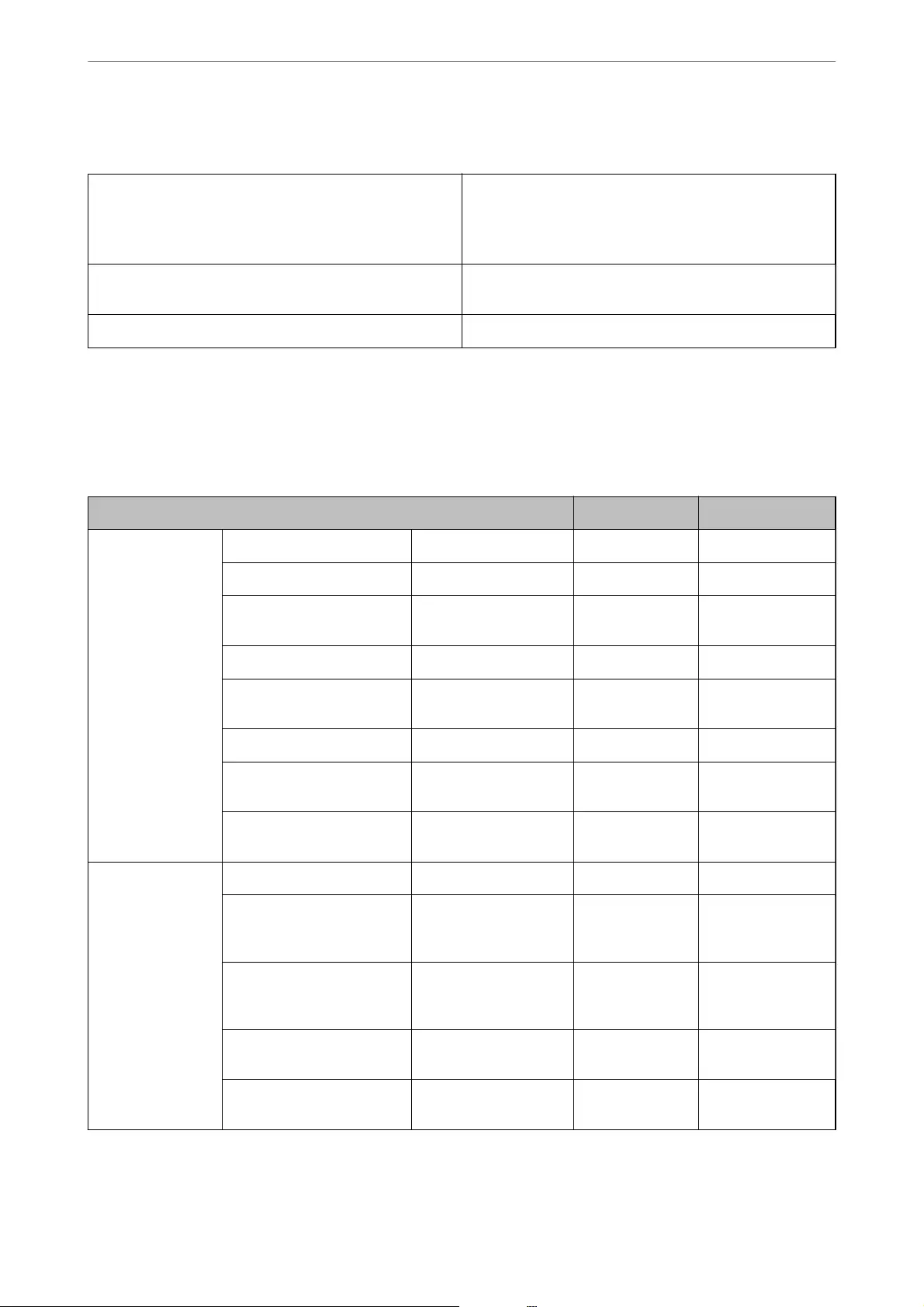
Ethernet Specications
Standards IEEE802.3i (10BASE-T)
*1
IEEE802.3u (100BASE-TX)
IEEE802.3az (Energy Ecient Ethernet)
*2
Communication Mode Auto, 10Mbps Full duplex, 10Mbps Half duplex, 100Mbps
Full duplex, 100Mbps Half duplex
Connector RJ-45
*1 Use a category 5e or higher STP (Shielded twisted pair) cable to prevent risk of radio interference.
*2 The connected device should comply with IEEE802.3az standards.
Network Functions and IPv4/IPv6
Functions Supported Remarks
Network Printing EpsonNet Print (Windows) IPv4 ✓-
Standard TCP/IP (Windows) IPv4, IPv6 ✓-
WSD Printing (Windows) IPv4, IPv6 ✓Windows Vista or
later
Bonjour Printing (Mac OS) IPv4, IPv6 ✓-
IPP Printing (Windows, Mac
OS)
IPv4, IPv6 ✓-
PictBridge Printing (Wi-Fi) IPv4 - Digital camera
Epson Connect (Email Print,
Remote Print)
IPv4 ✓-
AirPrint (iOS, Mac OS) IPv4, IPv6 ✓iOS 5 or later, Mac
OS X v10.7 or later
Network Scanning Epson Scan 2 IPv4, IPv6 ✓-
Epson ScanSmart IPv4 ✓Windows 7 or later,
Mac OS X El
Capitan or later
Event Manager IPv4 ✓Windows XP, Vista,
Mac OS X v10.6 to
Yosemite
Epson Connect (Scan to
Cloud)
IPv4 ✓-
AirPrint (Scan) IPv4, IPv6 ✓OS X Mavericks or
later
Product Information
>
Product Specications
>
Network Specications
334
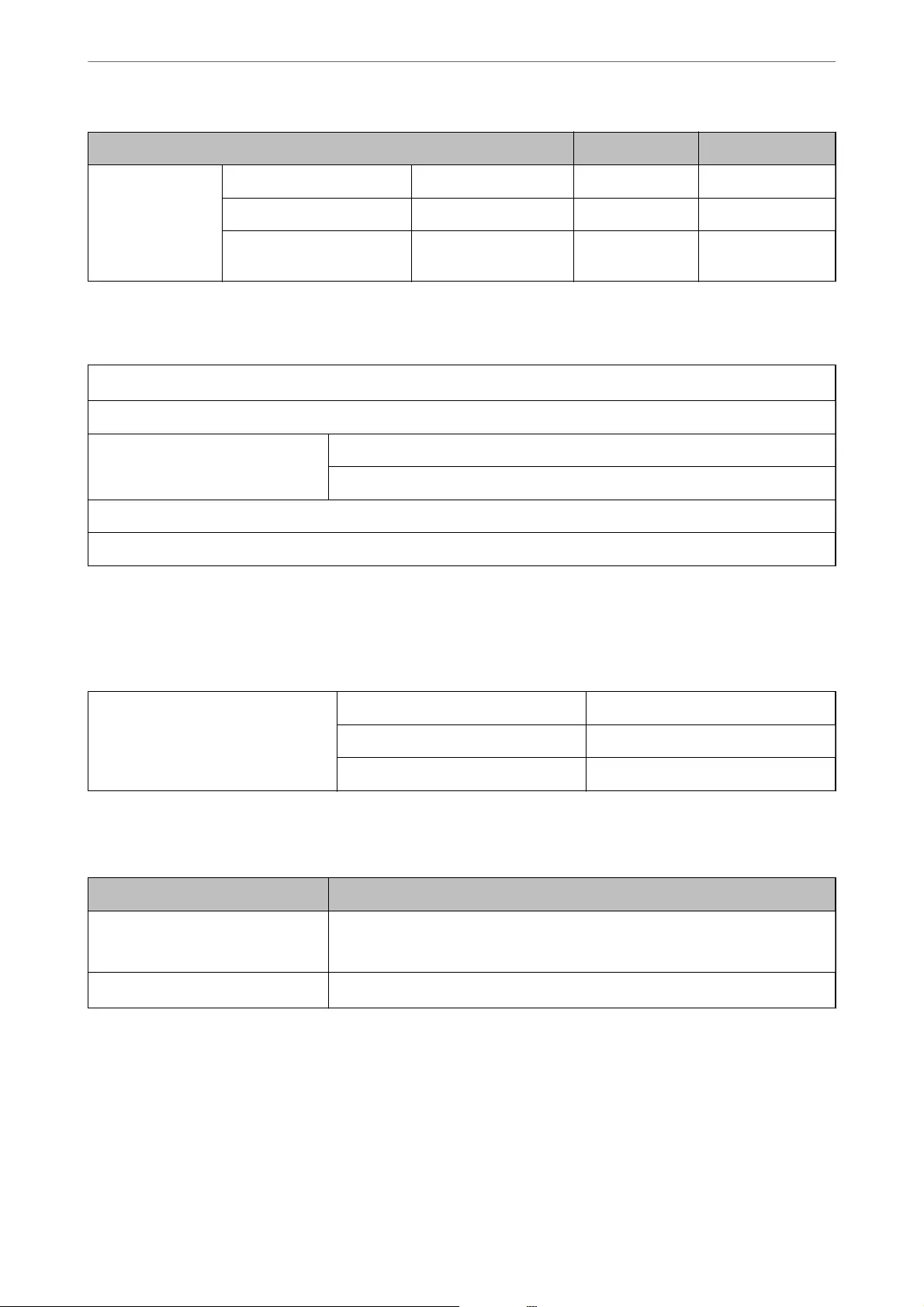
Functions Supported Remarks
Fax Send a fax IPv4 ✓-
Receive a fax IPv4 ✓-
AirPrint (Faxout) IPv4, IPv6 ✓OS X Mountain
Lion or later
Security Protocol
IEEE802.1X
*
IPsec/IP Filtering
SSL/TLS HTTPS Server/Client
IPPS
SMTPS (STARTTLS, SSL/TLS)
SNMPv3
* You need to use a device for connection that complies with IEEE802.1X.
Supported Third Party Services
AirPrint Print iOS 5 or later/Mac OS X v10.7.x or later
Scan OS X Mavericks or later
Fax OS X Mountain Lion or later
Memory Device Specications
Devices Maximum Capacities
Hard Disk Drive
*1
USB Flash Drive
2 TB (formatted in FAT, FAT32, or exFAT.)
Multi-card reader
*2
2 TB (formatted in FAT, FAT32, or exFAT)
*1: We do not recommend using external USB devices that are powered by USB. Use only external USB devices with
independent AC power sources.
*2: Only insert one memory card into the multi-card reader. Multi-card readers with more than two memory cards inserted are
not supported.
You cannot use the following devices:
❏A device that requires a dedicated driver
❏A device with security settings (password, encryption, and so on)
Product Information
>
Product Specications
>
Memory Device Specications
335
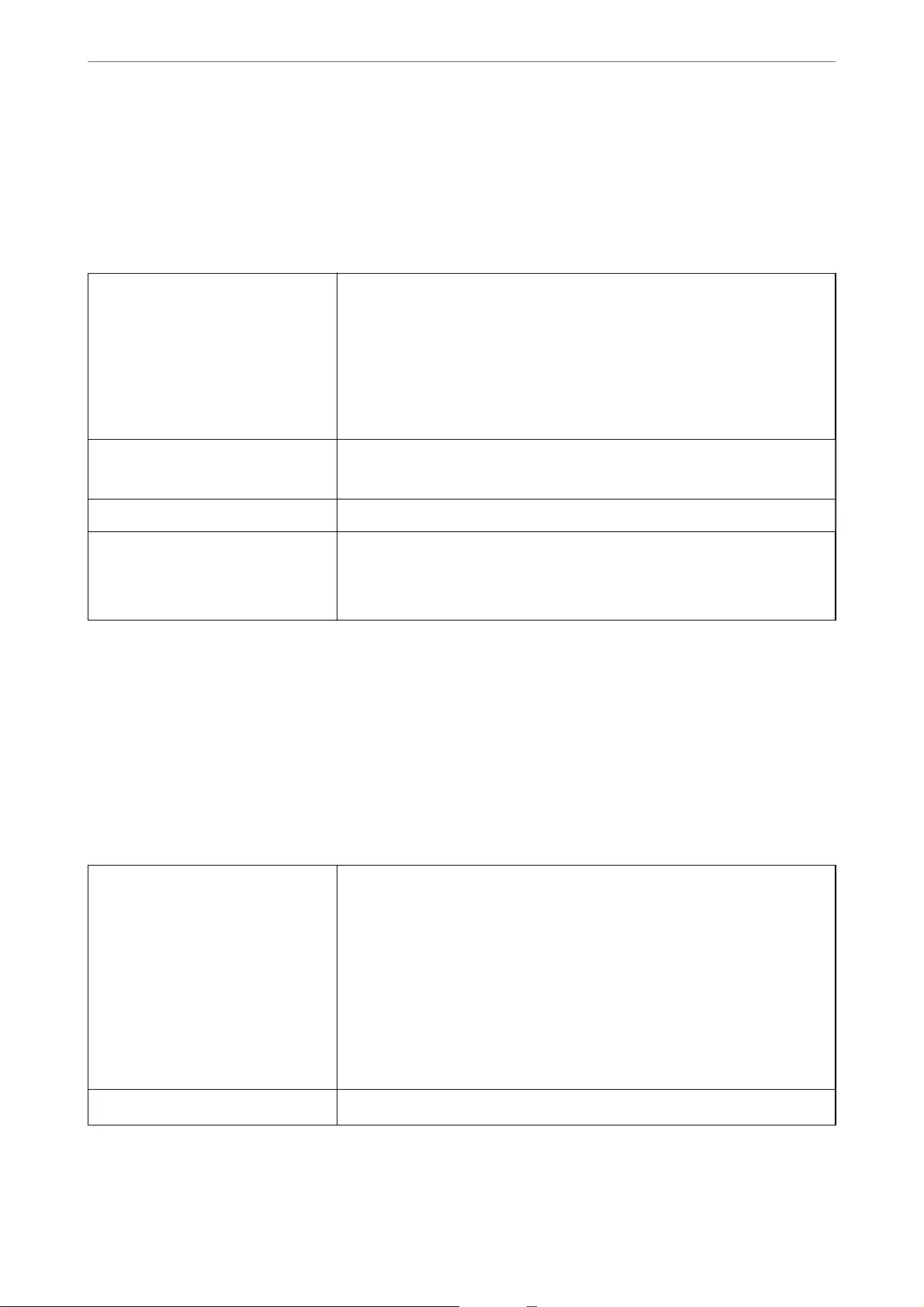
❏A device with a built-in USB hub
Epson cannot guarantee all operations of externally connected devices.
Supported Data Specications
File Format JPEGs (*.JPG) with the Exif Version 2.31 standard taken by digital cameras DCF
*1
version 1.0 or 2.0
*2
compliant
TIFF 6.0 compliant images as below
❏RGB full color images (not compressed)
❏Binary images (not compressed or CCITT encoded)
PDF le made by “Scan to Memory Device” of the Epson inkjet printer.
Image Size Horizontal: 80 to 10200 pixels
Vertical: 80 to 10200 pixels
File Size Less than 2 GB
Maximum Number of Files JPEG: 9990
*3
TIFF: 999
PDF: 999
*1 Design rule for Camera File system.
*2 Photo data stored on digital cameras with a built-in memory is not supported.
*3 Up to 999 les can be displayed at a time. (If the number of les exceeds 999, the les are displayed in groups.)
Note:
"×" is displayed on the LCD screen when the printer cannot recognize the image le. In this situation, if you select a multiple
image layout, blank sections will be printed.
Dimensions
Dimensions Storage
❏Width: 425 mm (16.7 in.)
❏Depth: 500 mm (19.7 in.)
❏Height: 350 mm (13.8 in.)
Printing
❏Width: 425 mm (16.7 in.)
❏Depth: 824 mm (32.4 in.)
❏Height: 459 mm (18.1 in.)
Weight
*
Approx. 17.5 kg (38.6 lb)
* Without the ink and the power cord.
Product Information
>
Product Specications
>
Dimensions
336
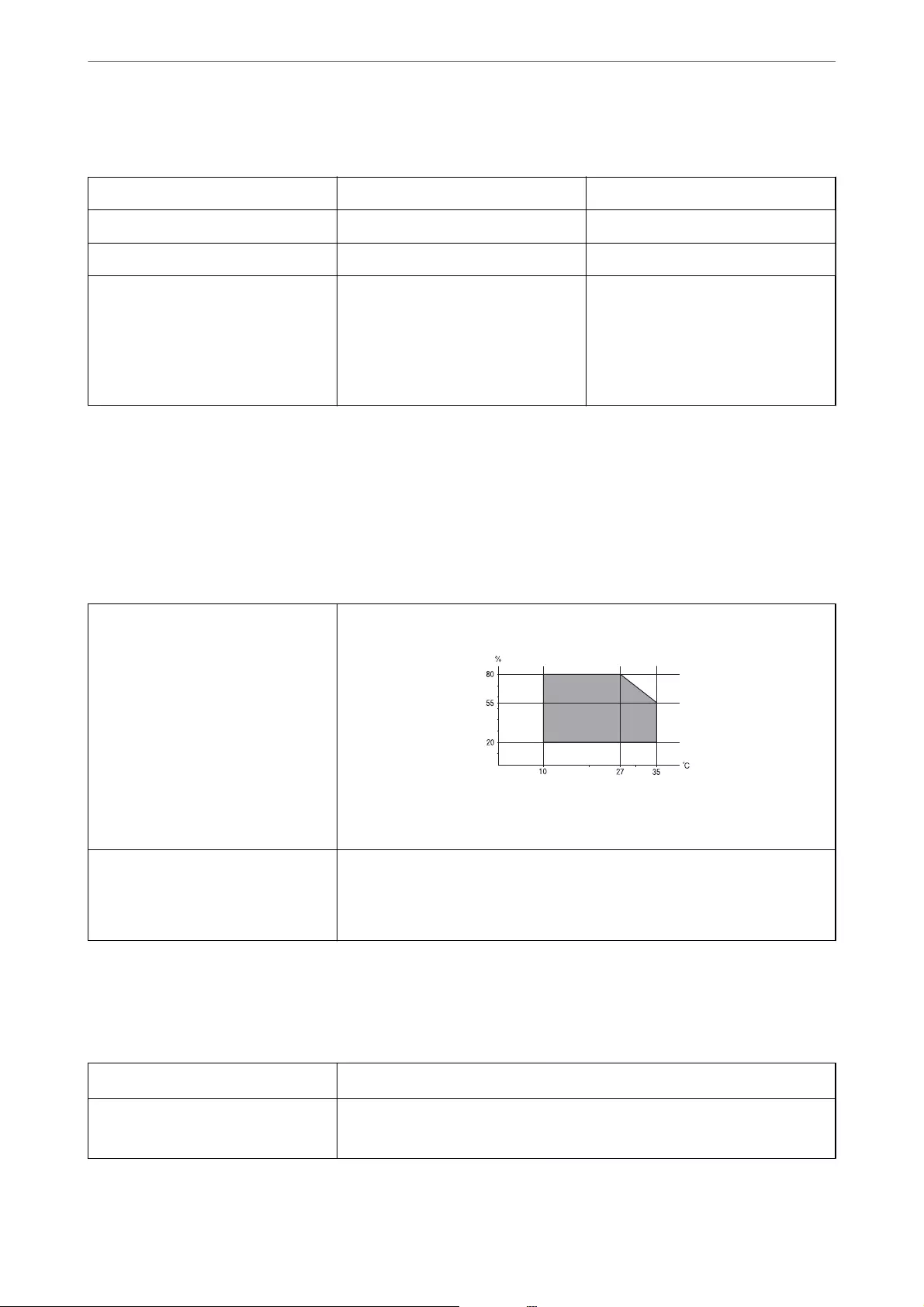
Electrical Specications
Model 100 to 240 V Model 220 to 240 V Model
Rated Frequency Range 50 to 60 Hz 50 to 60 Hz
Rated Current 0.7 to 0.4 A 0.4 A
Power Consumption (with USB Con-
nection)
Standalone copying: Approx. 19.0 W
(ISO/IEC24712)
Ready mode: Approx. 8.9 W
Sleep mode: Approx. 0.8 W
Power o: Approx. 0.15 W
Standalone copying: Approx. 19.0 W
(ISO/IEC24712)
Ready mode: Approx. 8.9 W
Sleep mode: Approx. 0.8 W
Power o: Approx. 0.2 W
Note:
❏Check the label on the printer for its voltage.
❏For European users, see the following Website for details on power consumption.
http://www.epson.eu/energy-consumption
Environmental Specications
Operation Use the printer within the range shown in the following graph.
Temperature: 10 to 35°C (50 to 95°F)
Humidity: 20 to 80% RH (without condensation)
Storage Temperature after initial ink charging: -15 to 40°C (5 to 104°F)
*
Temperature before initial ink charging: -20 to 40°C (-4 to 104°F)
*
Humidity: 5 to 85% RH (without condensation)
* You can store for one month at 40°C (104°F).
Environmental Specications for Ink Bottles
Storage Temperature -20 to 40 °C (-4 to 104 °F)
*
Freezing Temperature -15 °C (5 °F)
Ink thaws and is usable after approximately 2 hours at 25 °C (77 °F).
* You can store for one month at 40 °C (104 °F).
Product Information
>
Product Specications
>
Environmental Specications
337
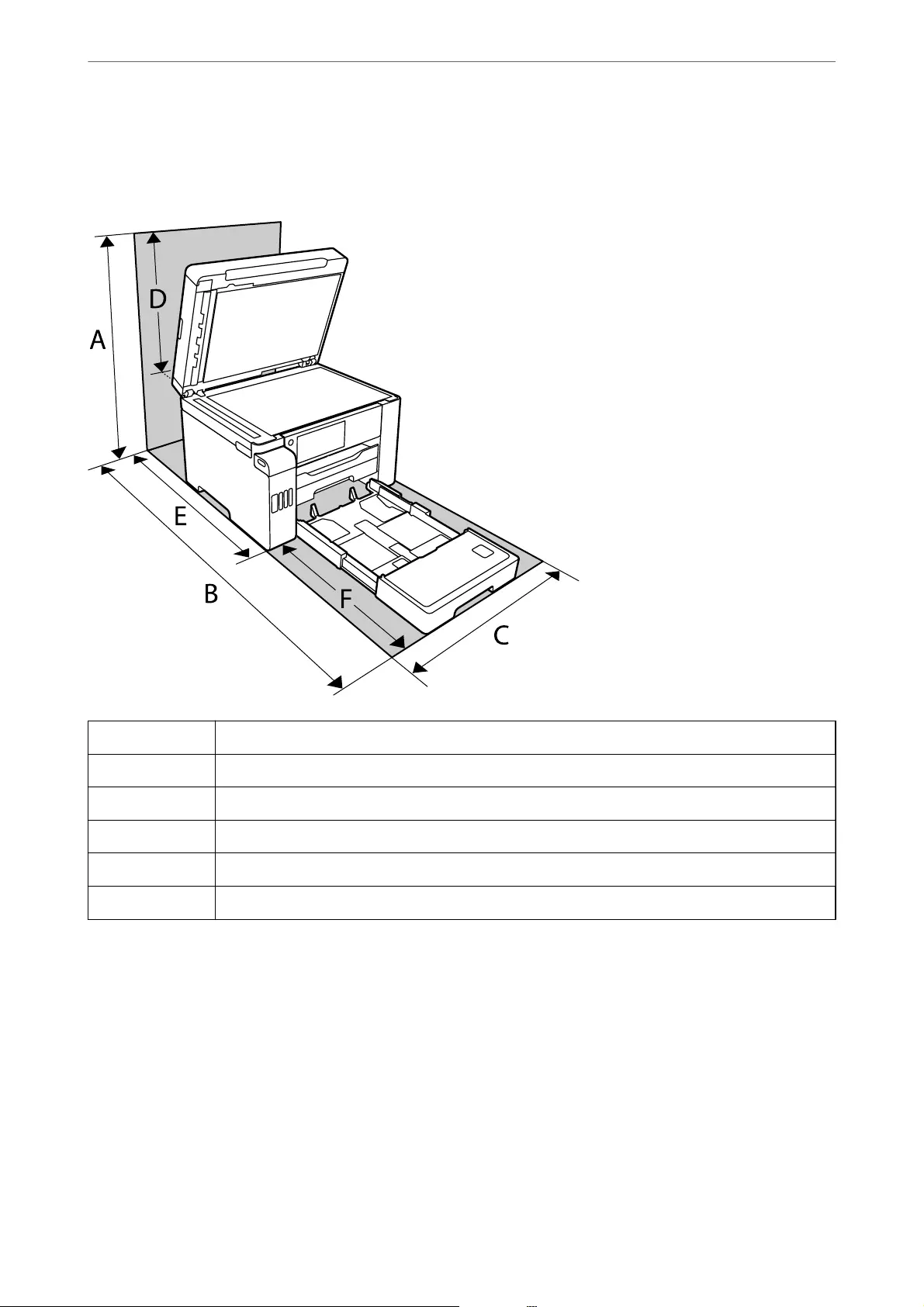
Installation Location and Space
Secure enough place to install and operate the printer correctly.
A 681.0mm
B 1074.1mm
C 425.0mm
D 331.0mm
E 175.7mm
F 398.4mm
See "Safety Instructions" in this manual to conrm the environmental conditions.
System Requirements
❏Windows 10 (32-bit, 64-bit)/Windows 8.1 (32-bit, 64-bit)/Windows 8 (32-bit, 64-bit)/Windows 7 (32-bit, 64-
bit)/Windows Vista (32-bit, 64-bit)/Windows XP SP3 or later (32-bit)/Windows XP Professional x64 Edition
SP2 or later/Windows Server 2019/Windows Server 2016/Windows Server 2012 R2/Windows Server 2012/
Windows Server 2008 R2/Windows Server 2008/Windows Server 2003 R2/Windows Server 2003 SP2 or later
❏macOS Catalina/macOS Mojave/macOS High Sierra/macOS Sierra/OS X El Capitan/OS X Yosemite/OS X
Mavericks/OS X Mountain Lion/Mac OS X v10.7.x/Mac OS X v10.6.8
Product Information
>
Product Specications
>
System Requirements
338
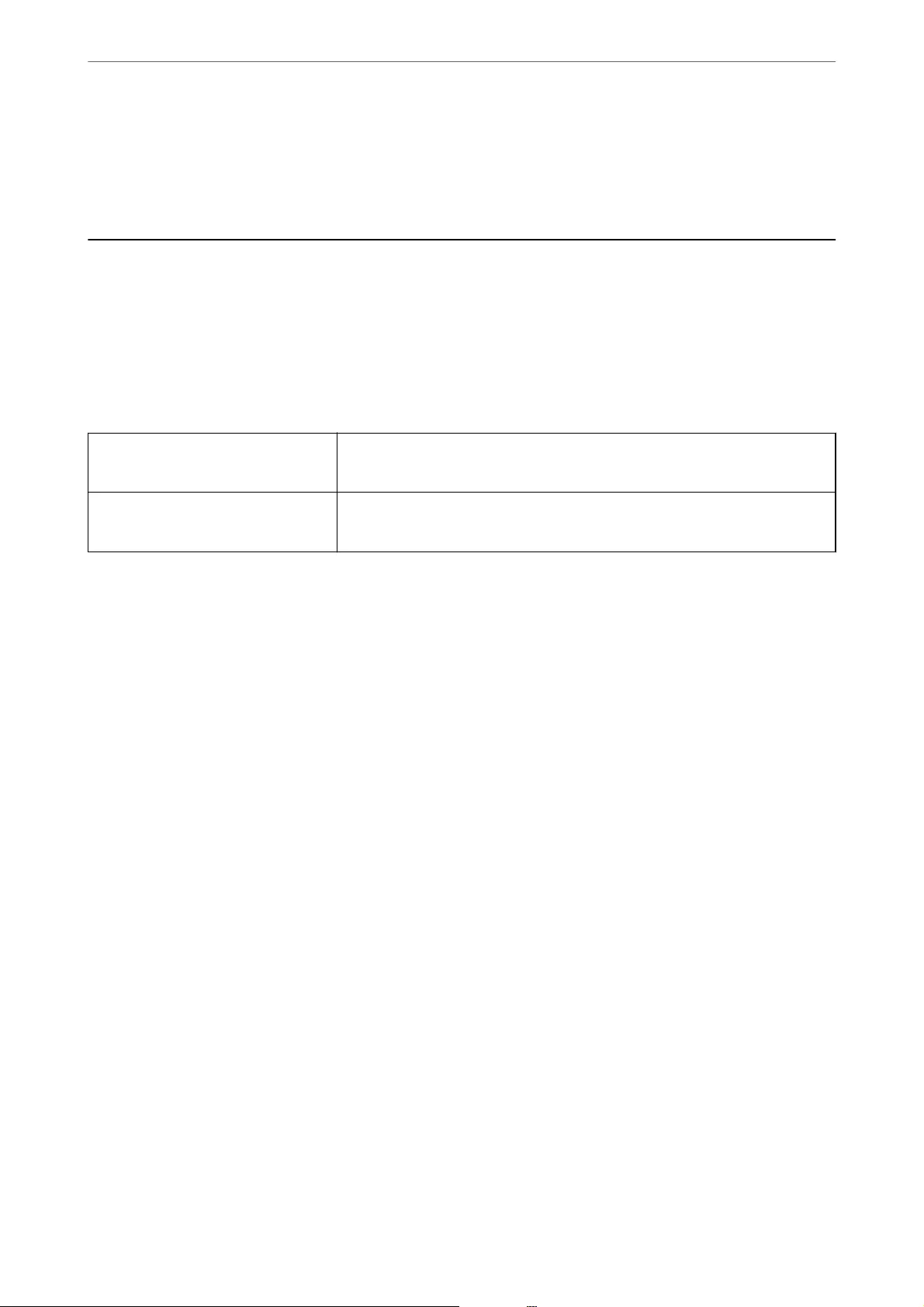
Note:
❏Mac OS may not support some applications and features.
❏e UNIX File System (UFS) for Mac OS is not supported.
Regulatory Information
Standards and Approvals
Standards and Approvals for U.S. Model
Safety UL60950-1
CAN/CSA-C22.2 No.60950-1
EMC FCC Part 15 Subpart B Class B
CAN ICES-3 (B)/NMB-3 (B)
is equipment contains the following wireless module.
Manufacturer: Seiko Epson Corporation
Type: J26H005
is product conforms to Part 15 of the FCC Rules and RSS-210 of the IC Rules. Epson cannot accept
responsibility for any failure to satisfy the protection requirements resulting from a non-recommended
modication of the product. Operation is subject to the following two conditions: (1) this device may not cause
harmful interference, and (2) this device must accept any interference received, including interference that may
cause undesired operation of the device.
To prevent radio interference to the licensed service, this device is intended to be operated indoors and away from
windows to provide maximum shielding. Equipment (or its transmit antenna) that is installed outdoors is subject
to licensing.
is equipment complies with FCC/IC radiation exposure limits set forth for an uncontrolled environment and
meets the FCC radio frequency (RF) Exposure Guidelines in Supplement C to OET65 and RSS-102 of the IC radio
frequency (RF) Exposure rules. is equipment should be installed and operated so that the radiator is kept at least
7.9 inches (20 cm) or more away from a person's body (excluding extremities: hands, wrists, feet and ankles).
Standards and Approvals for European Model
For European users
Hereby, Seiko Epson Corporation declares that the following radio equipment model is in compliance with
Directive 2014/53/EU. e full text of the EU declaration of conformity is available at the following website.
http://www.epson.eu/conformity
C762B
For use only in Ireland, UK, Austria, Germany, Liechtenstein, Switzerland, France, Belgium, Luxemburg,
Netherlands, Italy, Portugal, Spain, Denmark, Finland, Norway, Sweden, Iceland, Croatia, Cyprus, Greece,
Slovenia, Malta, Bulgaria, Czech, Estonia, Hungary, Latvia, Lithuania, Poland, Romania, and Slovakia.
Product Information
>
Regulatory Information
>
Standards and Approvals
339
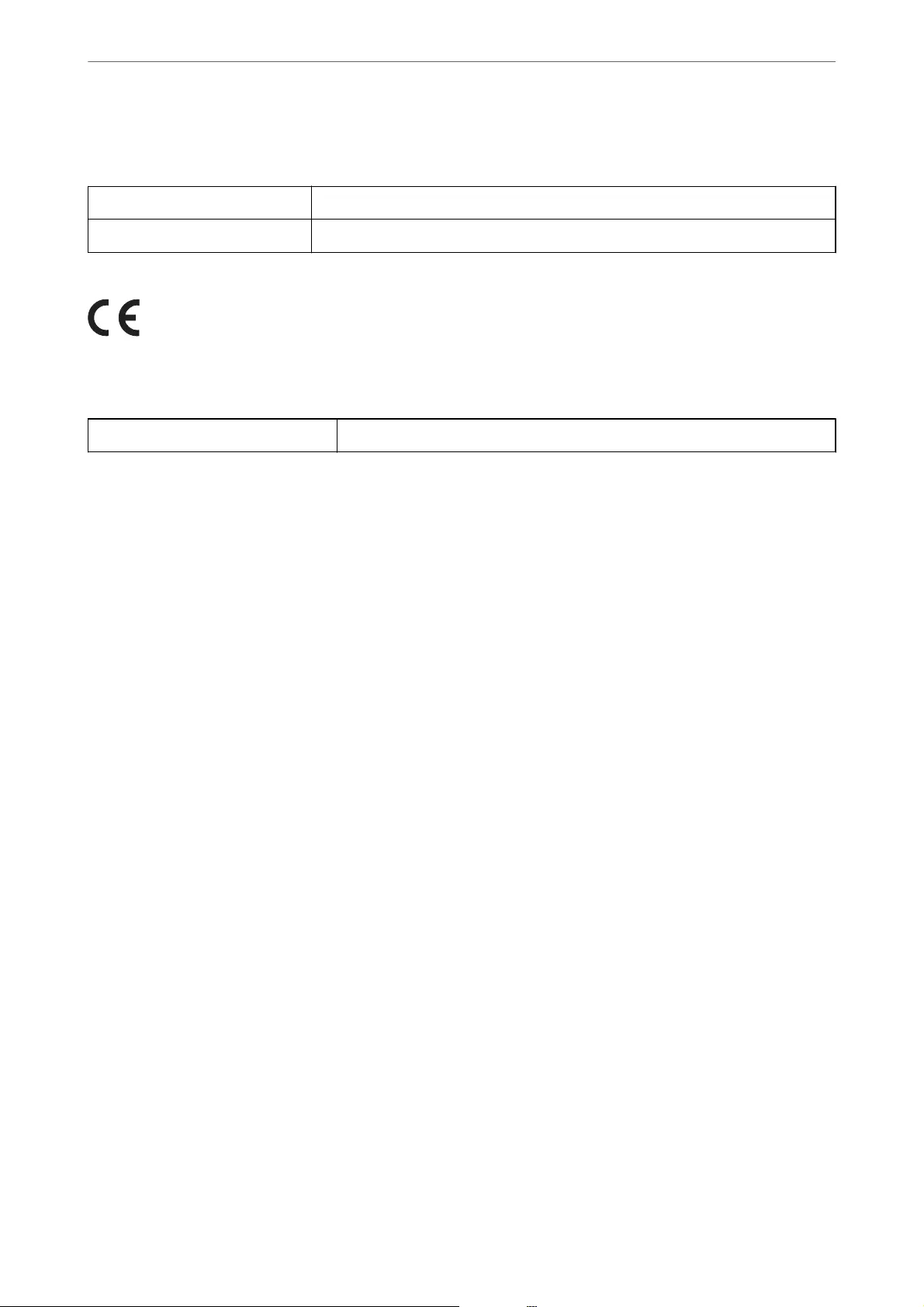
Epson cannot accept responsibility for any failure to satisfy the protection requirements resulting from a non-
recommended modication of the products.
Frequency Maximum Radio-Frequency Power Transmitted
2400-2483.5 MHz 20 dBm (EIRP)
Standards and Approvals for Australian Model
EMC AS/NZS CISPR32 Class B
Epson hereby declares that the following equipment Models are in compliance with the essential requirements and
other relevant provisions of AS/NZS4268:
C762A
Epson cannot accept responsibility for any failure to satisfy the protection requirements resulting from a non-
recommended modication of the products.
Standards and Approvals for New Zealand Model
General Warning
e grant of a Telepermit for any item of terminal equipment indicates only that Telecom has accepted that the
item complies with minimum conditions for connection to its network. It indicates no endorsement of the product
by Telecom, nor does it provide any sort of warranty. Above all, it provides no assurance that any item will work
correctly in all respects with another item of Telepermitted equipment of a dierent make or model, nor does it
imply that any product is compatible with all of Telecom's network services.
Telepermitted equipment only may be connected to the EXT telephone port. is port is not specically designed
for 3-wire-connected equipment. 3-wire-connected equipment might not respond to incoming ringing when
attached to this port.
Important Notice
Under power failure conditions, this telephone may not operate. Please ensure that a separate telephone, not
dependent on local power, is available for emergency use.
is equipment is not capable, under all operating conditions, of correct operation at the higher speeds for which it
is designed. Telecom will accept no responsibility should diculties arise in such circumstances.
is equipment shall not be set up to make automatic calls to the Telecom '111' Emergency Service.
Restrictions on Copying
Observe the following restrictions to ensure the responsible and legal use of the printer.
Copying of the following items is prohibited by law:
❏Bank bills, coins, government-issued marketable securities, government bond securities, and municipal
securities
Product Information
>
Regulatory Information
>
Restrictions on Copying
340

❏Unused postage stamps, pre-stamped postcards, and other ocial postal items bearing valid postage
❏Government-issued revenue stamps, and securities issued according to legal procedure
Exercise caution when copying the following items:
❏Private marketable securities (stock certicates, negotiable notes, checks, etc.), monthly passes, concession
tickets, etc.
❏Passports, driver’s licenses, warrants of tness, road passes, food stamps, tickets, etc.
Note:
Copying these items may also be prohibited by law.
Responsible use of copyrighted materials:
Printers can be misused by improperly copying copyrighted materials. Unless acting on the advice of a
knowledgeable attorney, be responsible and respectful by obtaining the permission of the copyright holder before
copying published material.
Product Information
>
Regulatory Information
>
Restrictions on Copying
341

Administrator Information
Connecting the Printer to the Network..................................343
Settings to Use the Printer...........................................347
Managing the Printer...............................................406
Advanced Security Settings..........................................422
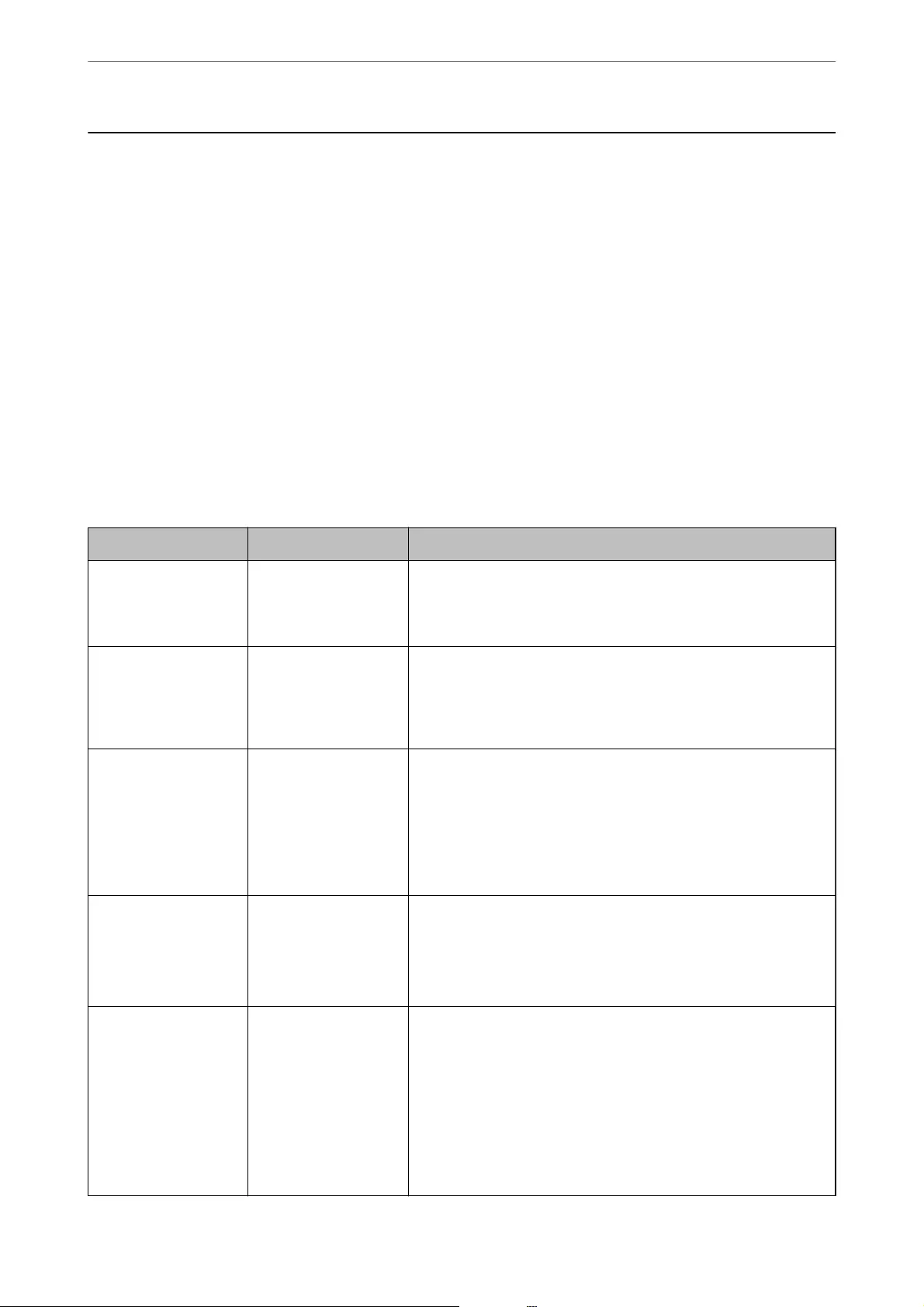
Connecting the Printer to the Network
You can connect the printer to the network in several ways.
❏Connect by using advanced settings on the control panel.
❏Connect by using the installer on the website or on the soware disc.
is section explains the procedure to connect the printer to the network using the printer's control panel.
Before Making Network Connection
To connect to the network, check the connection method and setting information for connection in advance.
Gathering Information on the Connection Setting
Prepare the necessary setting information to connect. Check the following information in advance.
Divisions Items Note
Device connection
method
❏Ethernet
❏Wi-Fi
Decide how to connect the printer to the network.
For Wired LAN, connects to the LAN switch.
For Wi-Fi, connects to the network (SSID) of the access point.
LAN connection
information
❏IP address
❏Subnet mask
❏Default gateway
Decide the IP address to assign to the printer.
When you assign the IP address statically, all values are required.
When you assign the IP address dynamically using the DHCP function,
this information is not required because it is set automatically.
Wi-Fi connection
information
❏SSID
❏Password
These are the SSID (network name) and the password of the access
point that the printer connects to.
If MAC address ltering has been set, register the MAC address of the
printer in advance to register the printer.
See the following for the supported standards.
“Wi-Fi Specications” on page 332
DNS server information ❏IP address for
primary DNS
❏IP address for
secondary DNS
These are required when specifying DNS servers. The secondary DNS
is set when the system has a redundant conguration and there is a
secondary DNS server.
If you are in a small organization and do not set the DNS server, set
the IP address of the router.
Proxy server
information
❏Proxy server name Set this when your network environment uses the proxy server to
access the internet from the intranet, and you use the function that
the printer directly accesses to the internet.
For the following functions, the printer directly connects to the
internet .
❏Epson Connect Services
❏Cloud services of other companies
❏Firmware updating
Administrator Information
>
Connecting the Printer to the Network
>
Before Making Network Connection
343
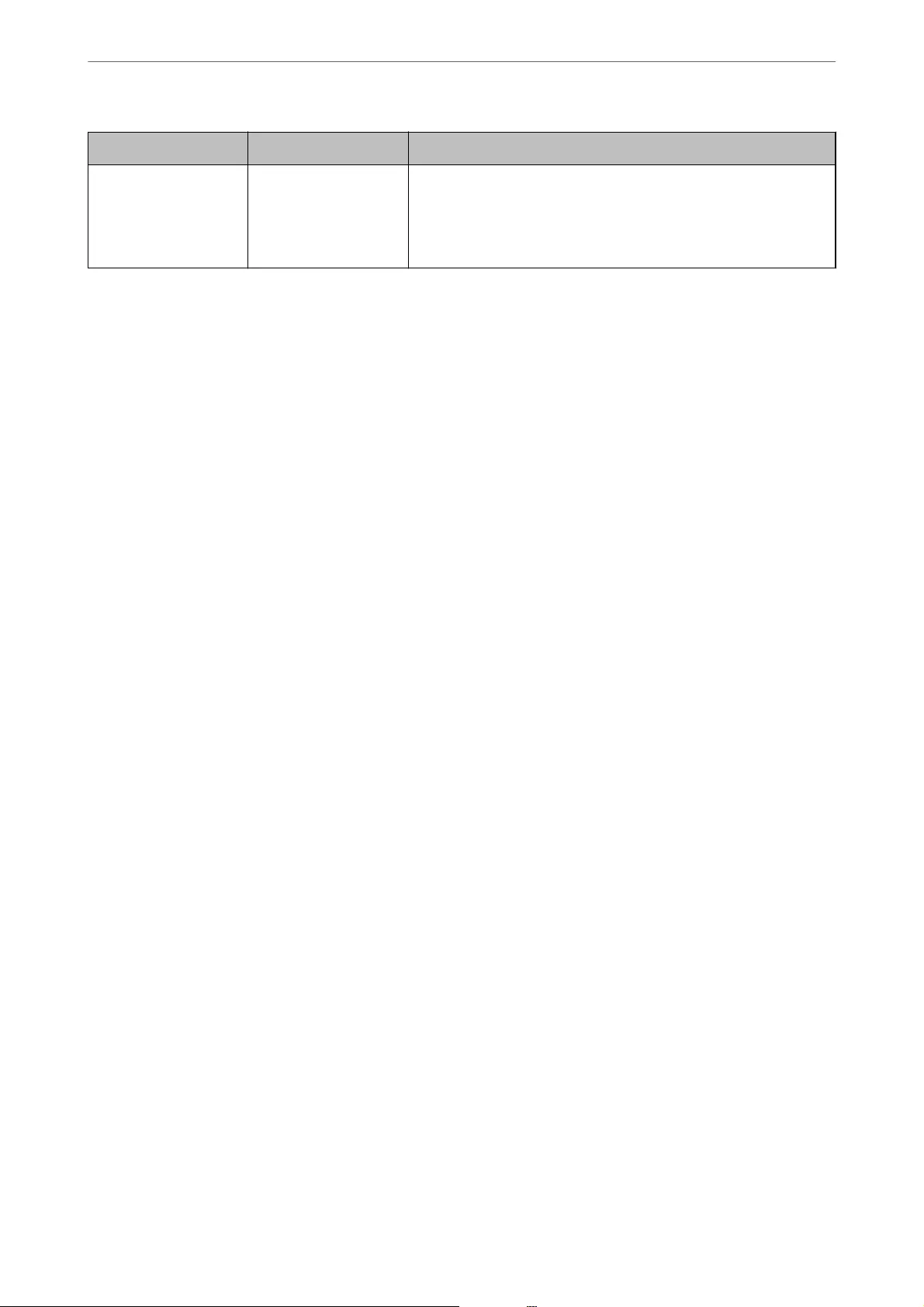
Divisions Items Note
Port number
information
❏Port number to
release
Check the port number used by the printer and computer, then
release the port that is blocked by a rewall, if necessary.
See the following for the port number used by the printer.
“Using Port for the Printer” on page 330
IP Address Assignment
ese are the following types of IP address assignment.
Static IP address:
Assign the predetermined IP address to the printer (host) manually.
e information to connect to the network (subnet mask, default gateway, DNS server and so on) need to be set
manually.
e IP address does not change even when the device is turned o, so this is useful when you want to manage
devices with an environment where you cannot change the IP address or you want to manage devices using the IP
address. We recommend settings to the printer, server, etc. that many computers access. Also, when using security
features such as IPsec / IP ltering, assign a xed IP address so that the IP address does not change.
Automatic assignment by using DHCP function (dynamic IP address):
Assign the IP address automatically to the printer (host) by using the DHCP function of the DHCP server or
router.
e information to connect to the network (subnet mask, default gateway, DNS server and so on) is set
automatically, so you can easily connect the device to the network.
If the device or the router is turned o, or depending on the DHCP server settings, IP address may change when
re-connecting.
We recommend managing devices other than the IP address and communicating with protocols that can follow
the IP address.
Note:
When you use the IP address reservation function of the DHCP, you can assign the same IP address to the devices at any
time.
DNS Server and Proxy Server
e DNS server has a host name, domain name of the email address, etc. in association with the IP address
information.
Communication is impossible if the other party is described by host name, domain name, etc. when the computer
or the printer performs IP communication.
Queries the DNS server for that information and gets the IP address of the other party. is process is called name
resolution.
erefore, the devices such as computers and printers can communicate using the IP address.
Name resolution is necessary for the printer to communicate using the email function or Internet connection
function.
When you use those functions, make the DNS server settings.
Administrator Information
>
Connecting the Printer to the Network
>
Before Making Network Connection
344
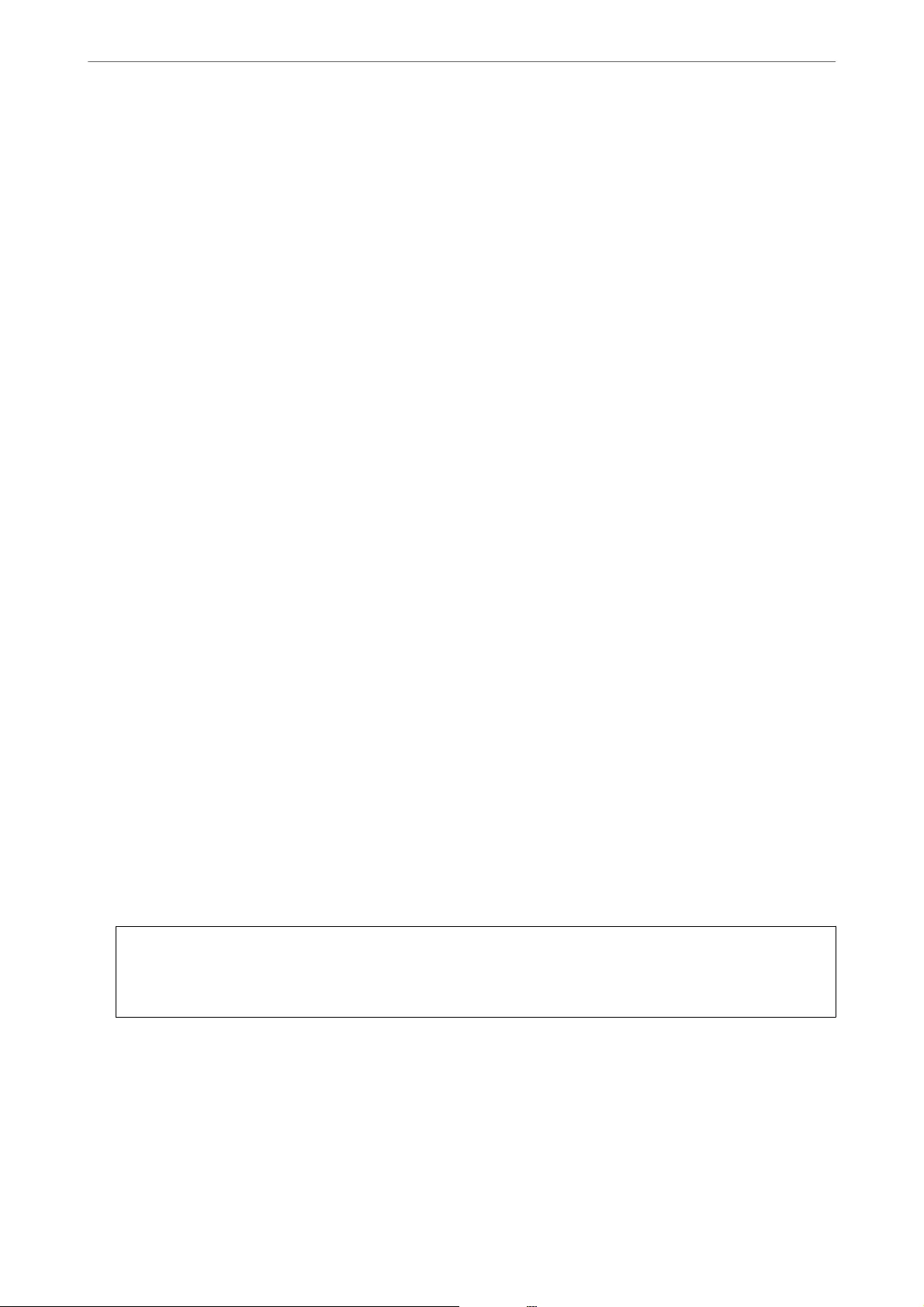
When you assign the printer's IP address by using the DHCP function of the DHCP server or router, it is
automatically set.
e proxy server is placed at the gateway between the network and the Internet, and it communicates to the
computer, printer, and Internet (opposite server) on behalf of each of them. e opposite server communicates
only to the proxy server. erefore, printer information such as the IP address and port number cannot be read
and increased security is expected.
When you connect to the Internet via a proxy server, congure the proxy server on the printer.
Connecting to the Network from the Control Panel
Connect the printer to the network by using the printer's control panel.
Assigning the IP Address
Set up the basic items such as Host Address, Subnet Mask, Default Gateway.
is section explains the procedure for setting a static IP address.
1. Turn on the printer.
2. Select Settings on the home screen on the printer's control panel.
3. Select General Settings > Network Settings > Advanced > TCP/IP.
4. Select Manual for Obtain IP Address.
When you set the IP address automatically by using the DHCP function of router, select Auto. In that case, the
IP Address, Subnet Mask, and Default Gateway on step 5 to 6 are also set automatically, so go to step 7.
5. Enter the IP address.
Focus moves to the forward segment or the back segment separated by a period if you select
l
and
r
.
Conrm the value reected on the previous screen.
6. Set up the Subnet Mask and Default Gateway.
Conrm the value reected on the previous screen.
c
Important:
If the combination of the IP Address, Subnet Mask and Default Gateway is incorrect, Start Setup is inactive
and cannot proceed with the settings. Conrm that there is no error in the entry.
7. Enter the IP address for the primary DNS server.
Conrm the value reected on the previous screen.
Note:
When you select Auto for the IP address assignment settings, you can select the DNS server settings from Manual or
Auto. If you cannot obtain the DNS server address automatically, select Manual and enter the DNS server address.
en, enter the secondary DNS server address directly. If you select Auto, go to step 9.
Administrator Information
>
Connecting the Printer to the Network
>
Connecting to the Network from the
…
345

8. Enter the IP address for the secondary DNS server.
Conrm the value reected on the previous screen.
9. Tap Start Setup.
Setting the Proxy Server
Set up the proxy server if both of the following are true.
❏e proxy server is built for Internet connection.
❏When using a function in which a printer directly connects to the Internet, such as Epson Connect service or
another company's cloud services.
1. Select Settings on the home screen.
When making settings aer IP address setting, the Advanced screen is displayed. Go to step 3.
2. Select General Settings > Network Settings > Advanced.
3. Select Proxy Server.
4. Select Use for Proxy Server Settings.
5. Enter the address for the proxy server by IPv4 or FQDN format.
Conrm the value reected on the previous screen.
6. Enter the port number for the proxy server.
Conrm the value reected on the previous screen.
7. Tap Start Setup.
Connecting to LAN
Connect the printer to the network by Ethernet or Wi-Fi.
Connecting to Ethernet
Connect the printer to the network by using the Ethernet cable, and check the connection.
1. Connect the printer and hub (LAN switch) by Ethernet cable.
2. Select Settings on the home screen.
3. Select General Settings > Network Settings > Connection Check.
e connection diagnosis result is displayed. Conrm the connection is correct.
4. Tap OK to nish.
When you tap Print Check Report, you can print the diagnosis result. Follow the on-screen instructions to
print it.
Administrator Information
>
Connecting the Printer to the Network
>
Connecting to the Network from the
…
346
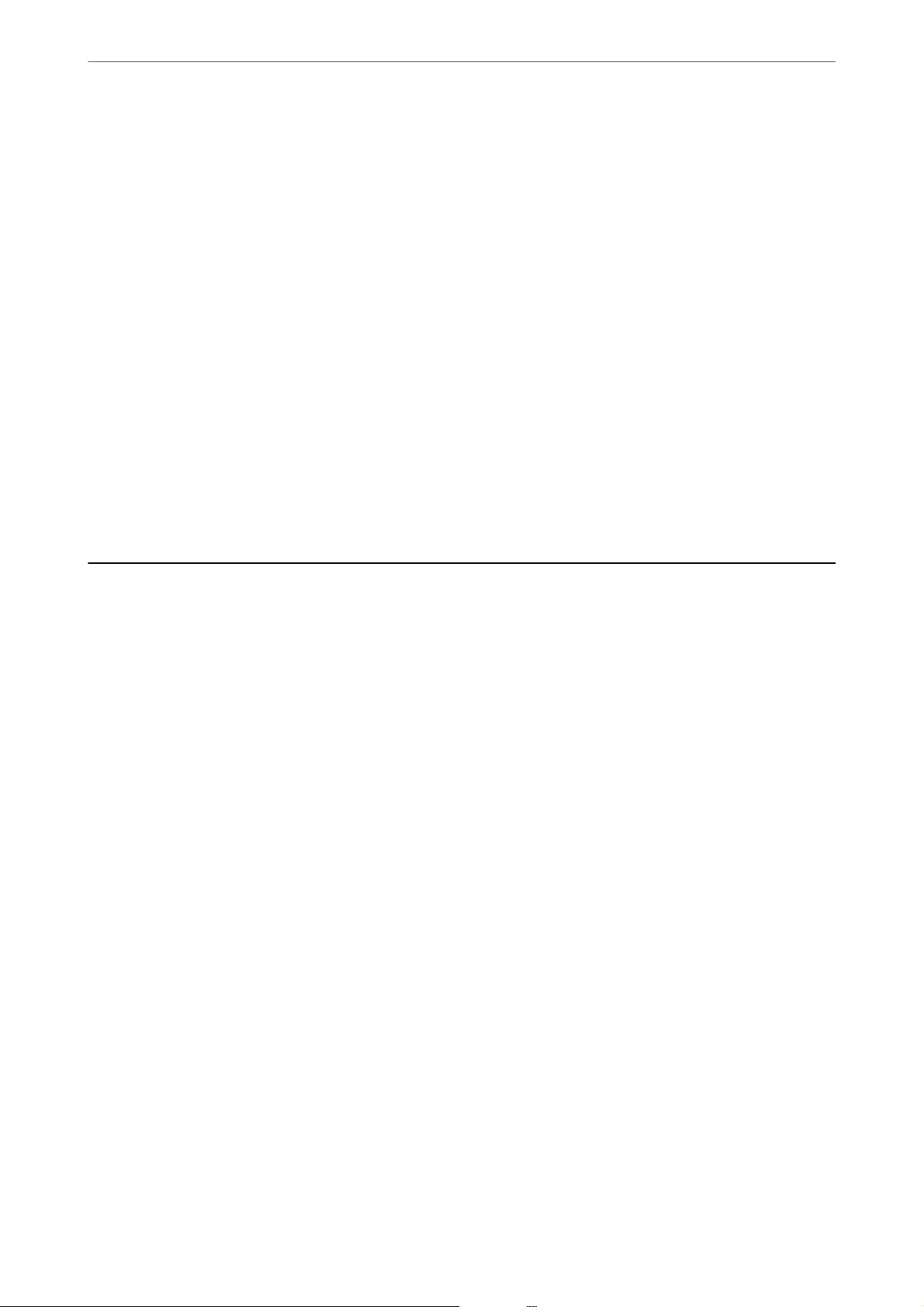
Related Information
&“Changing the Network Connection from Wi-Fi to Ethernet” on page 264
Connecting to the Wireless LAN (Wi-Fi)
You can connect the printer to the wireless LAN (Wi-Fi) in several ways. Choose the connection method that
matches the environment and conditions that you are using.
If you know the information for the wireless router such as SSID and password, you can make settings manually.
If the wireless router supports WPS, you can make settings by using push button setup.
Aer connecting the printer to the network, connect to the printer from the device that you want to use (computer,
smart device, tablet, and so on.)
Related Information
&“Making Wi-Fi Settings by Entering the SSID and Password” on page 266
&“Making Wi-Fi Settings by Push Button Setup (WPS)” on page 267
&“Making Wi-Fi Settings by PIN Code Setup (WPS)” on page 268
Settings to Use the Printer
Using the Print Functions
Enable to use the print function through the network.
To use the printer on the network, you need to set the port for network connection on the computer as well as the
printer’s network connection.
Printer Connection Types
e following two methods are available for the printer's network connection.
❏Peer to peer connection (direct printing)
❏Server / client connection (printer sharing using the Windows server)
Peer to Peer Connection Settings
is is the connection to connect the printer on the network and the computer directly. Only a network-capable
model can be connected.
Connection method:
Connect the printer to the network directly via hub or access point.
Printer driver:
Install the printer driver on each client computer.
When using EpsonNet SetupManager, you can provide the driver's package that includes the printer settings.
Administrator Information
>
Settings to Use the Printer
>
Using the Print Functions
347

Features:
❏e print job starts immediately because the print job is sent to the printer directly.
❏You can print as long as the printer runs.
Server / Client Connection Settings
is is the connection that the server computer shares with the printer. To prohibit the connection without going
through the server computer, you can enhance the security.
When using USB, the printer without the network function can be also shared.
Connection method:
Connect the printer to the network via LAN switch or access point.
You can also connect the printer to the server directly by USB cable.
Printer driver:
Install the printer driver on the Windows server depending on the OS of the client computers.
By accessing the Windows server and linking the printer, the printer driver is installed on the client computer and
can be used.
Features:
❏Manage the printer and the printer driver in batch.
❏Depending on the server spec, it may take time to start the print job because all print jobs go through the print
server.
❏You cannot print when the Windows server is turned o.
Print Settings for Peer to Peer Connection
For peer to peer connection (direct printing), a printer and a client computer have a one-to-one relationship.
e printer driver must be installed on each client computer.
Print Settings for Server / Client Connection
Enable to print from the printer that is connected as the server / client connection.
For the server / client connection, set up the print server rst, and then share the printer on the network.
When using the USB cable to connect to the server, also set the print server rst, and then share the printer on the
network.
Setting Up the Network Ports
Create the print queue for network printing on the print server by using standard TCP/IP, and then set the network
port.
is example is when using Windows 2012 R2.
Administrator Information
>
Settings to Use the Printer
>
Using the Print Functions
348
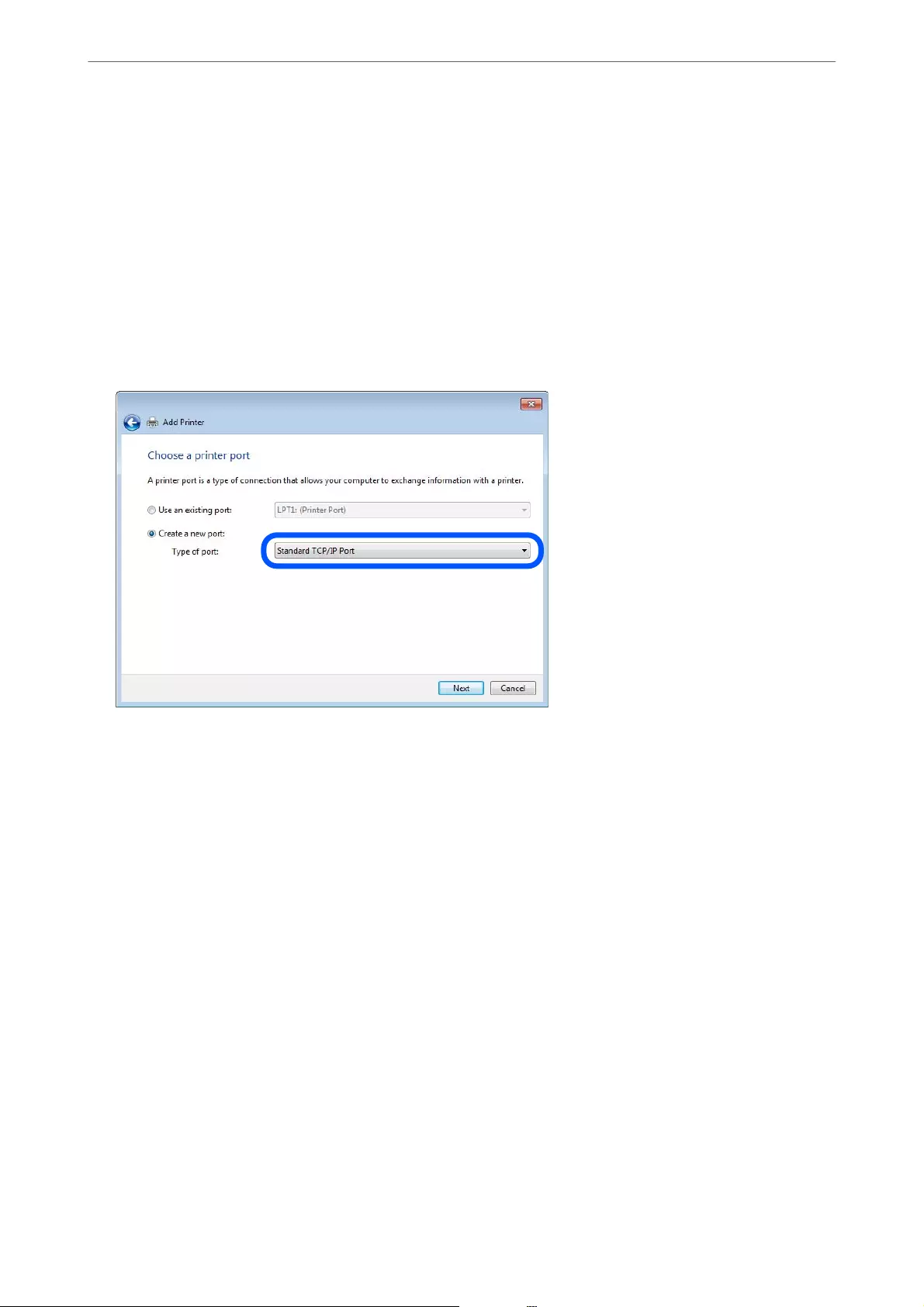
1. Open the devices and printers screen.
Desktop > Settings > Control Panel > Hardware and Sound or Hardware > Devices and Printers.
2. Add a printer.
Click Add printer, and then select e printer that I want isn't listed.
3. Add a local printer.
Select Add a local printer or network printer with manual settings, and then click Next.
4. Select Create a new port, select Standard TCP/IP Port as the Port Type, and then click Next.
5. Enter the printer's IP address or printer name in Host Name or IP Address or Printer Name or IP Address,
and then click Next.
Example:
❏Printer name : EPSONA1A2B3C
❏IP address : 192.0.2.111
Do not change Port name.
Administrator Information
>
Settings to Use the Printer
>
Using the Print Functions
349
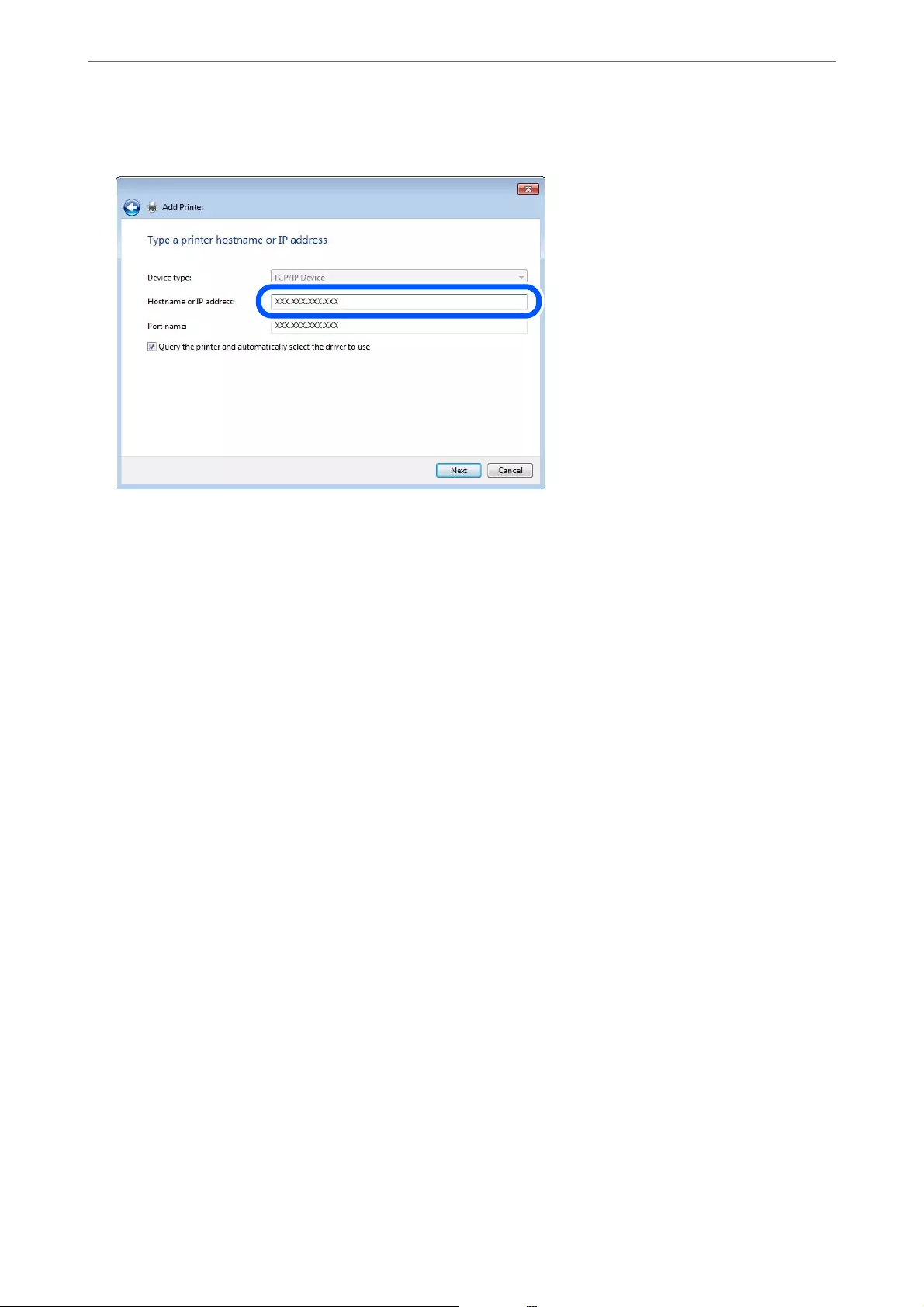
Click Continue when the User Account Control screen is displayed.
Note:
If you specify the printer name on the network where the name resolution is available, the IP address is tracked even if
printer's IP address has been changed by DHCP. You can conrm the printer name from the network status screen on
the printer's control panel or network status sheet.
6. Set the printer driver.
❏If the printer driver is already installed:
Select Manufacturer and Printers. Click Next.
7. Follow the on-screen instructions.
When using the printer under the server / client connection (printer sharing using the Windows server), make the
sharing settings hereaer.
Checking the Port Conguration - Windows
Check if the correct port is set for the print queue.
1. Open the devices and printers screen.
Desktop > Settings > Control Panel > Hardware and Sound or Hardware > Devices and Printers.
2. Open the printer properties screen.
Right-click the printer icon, and then click Printer properties.
3. Click the Ports tab, select Standard TCP/IP Port, and then click Congure Port.
4. Check the port conguration.
❏For RAW
Check that Raw is selected in Protocol, and then click OK.
Administrator Information
>
Settings to Use the Printer
>
Using the Print Functions
350

❏For LPR
Check that LPR is selected in Protocol. Enter "PASSTHRU" in Queue name from LPR Settings. Select LPR
Byte Counting Enabled, and then click OK.
Sharing the Printer (Windows only)
When using the printer under the server / client connection (printer sharing using the Windows server), set up the
printer sharing from the print server.
1. Select Control Panel > View devices and printers on the print server.
2. Right-click the printer icon (print queue) that you want to share with, and then select Printer Properties >
Sharing tab.
3. Select Share this printer and then enter to Share name.
For Windows Server 2012, click Change Sharing Options and then congure the settings.
Installing Additional Drivers (Windows only)
If the Windows versions for a server and clients are dierent, it is recommended to install additional drivers to the
print server.
1. Select Control Panel > View devices and printers on the print server.
2. Right-click the printer icon that you want to share with the clients, and then click Printer Properties >
Sharing tab.
3. Click Additional Drivers.
For Windows Server 2012, click Change Sharing Options and then congure the settings.
4. Select versions of Windows for clients, and then click OK.
5. Select the information le for the printer driver (*.inf) and then install the driver.
Using the Shared Printer – Windows
e administrator needs to inform the clients of the computer name assigned to the print server and how to add it
to their computers. If the additional driver(s) have not been congured yet, inform the clients how to use Devices
and Printers to add the shared printer.
If additional driver(s) have already been congured on the print server, follow these steps:
1. Select the name assigned to the print server in Windows Explorer.
2. Double-click the printer that you want to use.
Basic Settings for Printing
Set the print settings, such as paper size or printing error.
Administrator Information
>
Settings to Use the Printer
>
Using the Print Functions
351

Setting the Paper Source
Set the size and type of paper to be loaded in each paper source.
1. Access Web Cong and select the Print tab > Paper Source Settings.
2. Set each item.
e displayed items may vary by the situation.
❏Paper source name
Display the target paper source name, such as Rear Paper Feed, Cassette 1.
❏Paper Size
Select the paper size you want to set from the pull-down menu.
❏Unit
Select the unit of the user-dened size. You can select it when User dened is selected on Paper Size.
❏Width
Set the horizontal length of the user-dened size.
e range you can enter here depends on the paper source, which is indicated on the side of Width.
When you select mm in Unit, you can enter up to one decimal place.
When you select inch in Unit, you can enter up to two decimal places.
❏Height
Set the vertical length of the user-dened size.
e range you can enter here depends on the paper source, which is indicated on the side of Height.
When you select mm in Unit, you can enter up to one decimal place.
When you select inch in Unit, you can enter up to two decimal places.
❏Paper Type
Select the paper type you want to set from the pull-down menu.
3. Check the settings, and then click OK.
Setting Errors
Set the displaying error for the device.
1. Access Web Cong and select the Print tab > Error Settings.
2. Set each item.
❏Paper Size Notice
Set whether to display an error on the control panel when the paper size of the specied paper source is
dierent from the paper size of the print data.
❏Paper Type Notice
Set whether to display an error on the control panel when the paper type of the specied paper source is
dierent from the paper type of the print data.
❏Auto Error Solver
Set whether to automatically cancel the error if there is no operation on the control panel for 5 seconds
aer displaying the error.
Administrator Information
>
Settings to Use the Printer
>
Using the Print Functions
352
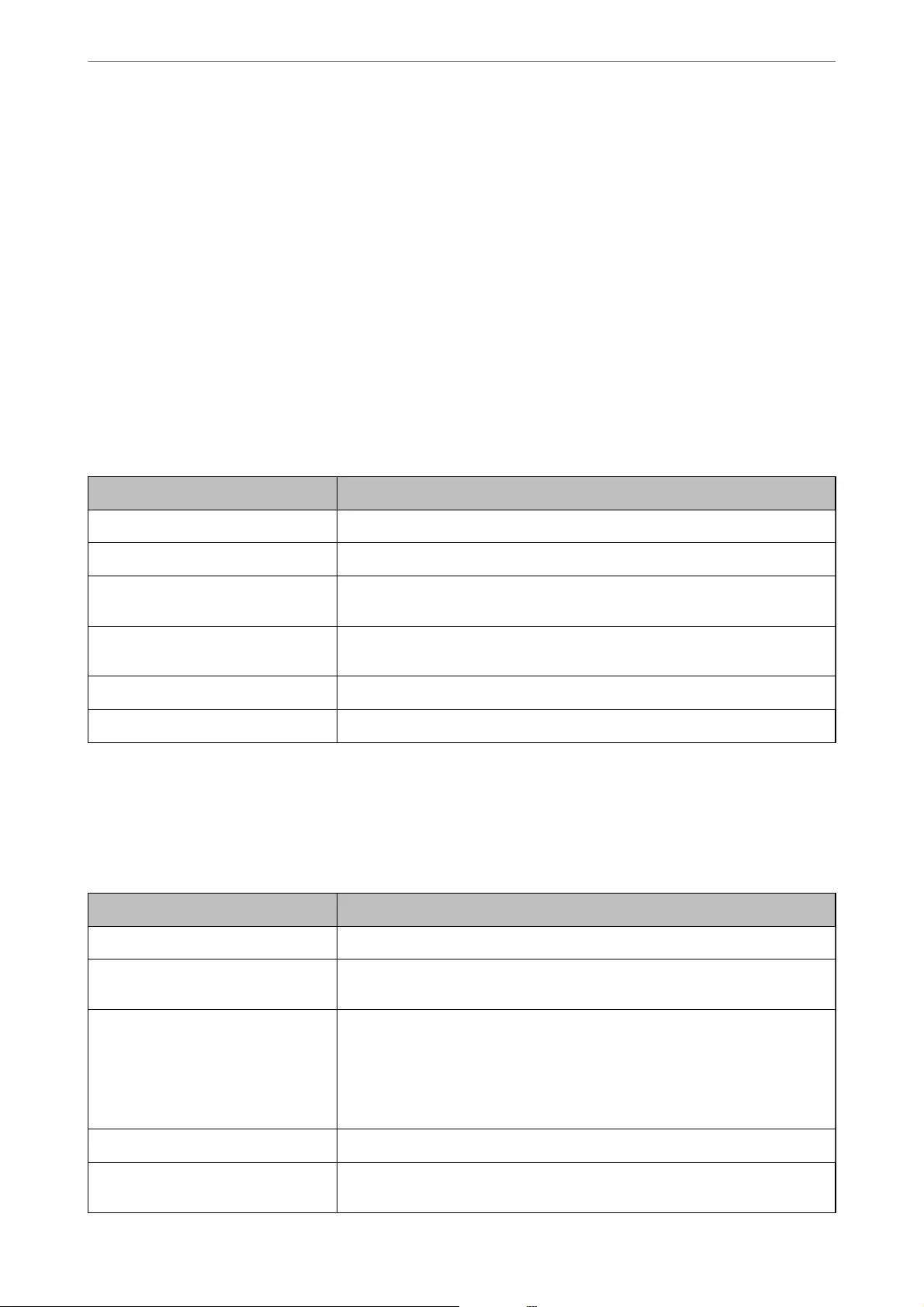
3. Check the settings, and then click OK.
Setting Universal Print
Set when you print from external devices without using the printer driver.
Some items are not displayed depending on the printing language of your printer.
1. Access Web Cong and select the Print tab > Universal Print Settings.
2. Set each item.
3. Check the settings, and then click OK.
Basic
Items Explanation
Top Oset(-30.0-30.0mm) Sets the vertical position of the paper on which printing starts.
Left Oset(-30.0-30.0mm) Sets the horizontal position of the paper on which printing starts.
Top Oset in Back(-30.0-30.0mm) Sets the vertical position of the paper on which the printing of the back side of
the paper starts in duplex printing.
Left Oset in Back(-30.0-30.0mm) Sets the horizontal position of the paper on which the printing of the back side of
the paper starts in duplex printing.
Check Paper Width Set whether to check paper width when printing.
Skip Blank Page If there is a blank page in the print data, set not to print a blank page.
Setting Up AirPrint
Set when using AirPrint printing and scanning.
Access Web Cong and select the Network tab > AirPrint Setup.
Items Explanation
Bonjour Service Name Enter the Bonjour service name between 1 and 41 characters in ASCII (0x20-0x7E).
Bonjour Location Enter location information such as the printer's placement within 127 bytes or less
in Unicode (UTF-8).
Geolocation
Latitude and Longitude (WGS84)
Enter the printer's location information. This entry is optional.
Enter values by using WGS-84 datum, which separates latitude and longitude with
a comma.
You can enter -90 to +90 for the latitude value, and -180 to +180 for the longitude
value. You can enter less than a decimal to the sixth place, and you can omit "+".
Top Priority Protocol Select top priority protocol from IPP and Port9100.
Wide-Area Bonjour Set whether or not to use Wide-Area Bonjour. If you use it, the printers must be
registered on the DNS server to be able to search the printer over the segment.
Administrator Information
>
Settings to Use the Printer
>
Setting Up AirPrint
353
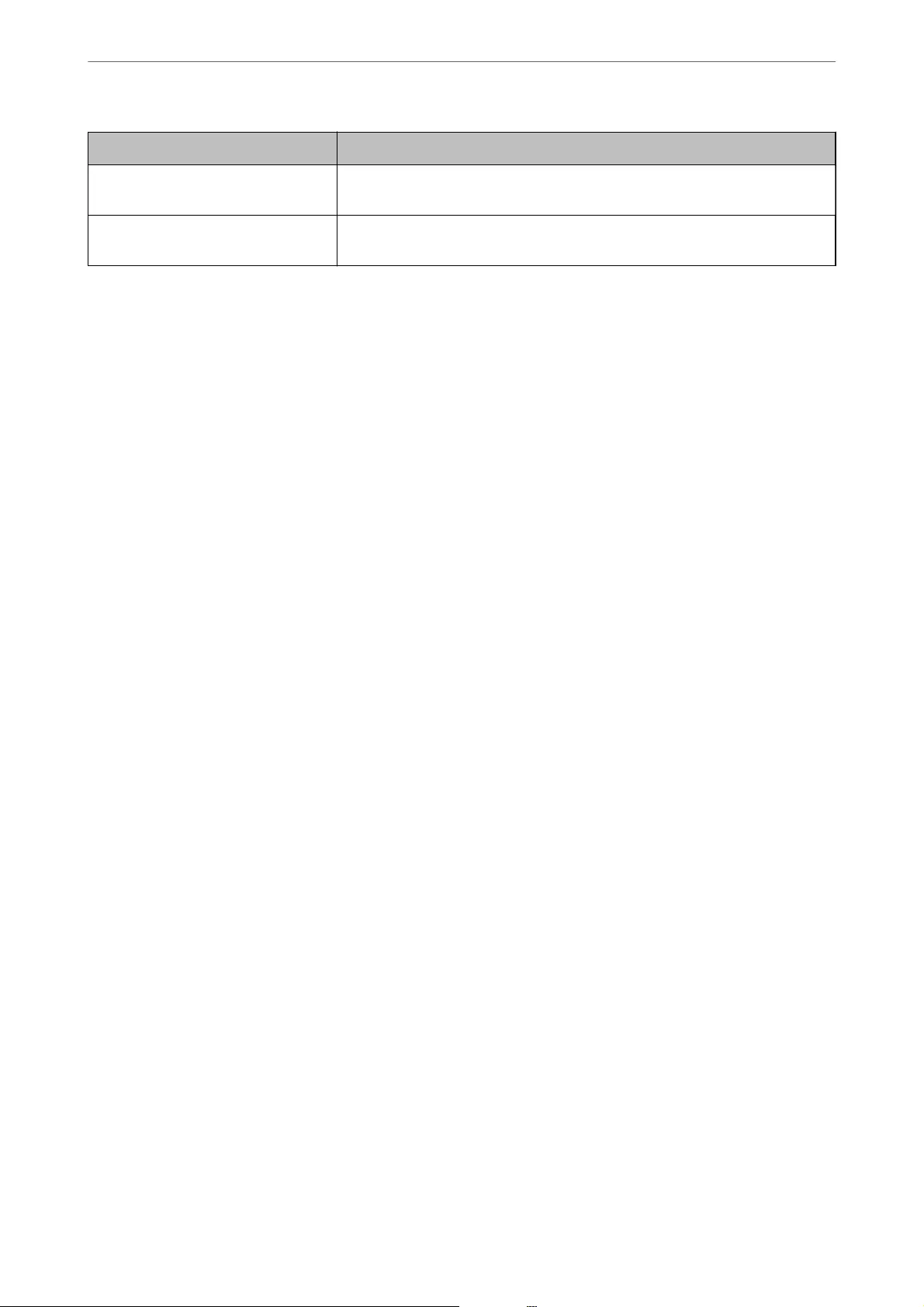
Items Explanation
Require PIN Code when using IPP
printing
Select whether or not to require a PIN code when using IPP printing. If you select
Yes , IPP print jobs without PIN codes are not saved in the printer.
Enable AirPrint IPP, Bonjour, AirPrint (Scan service) are enabled, and IPP is established only with
secure communication.
Conguring a Mail Server
Set the mail server from Web Cong.
When the printer can send the email by setting the mail server, the following are possible.
❏Transfers the scan results or fax by using email
❏Receives the email notication from the printer
Check below before setting up.
❏e printer is connected to the network that can access the mail server.
❏Email setting information of the computer that uses the same mail server as the printer.
Note:
❏When you use the mail server on the Internet, conrm the setting information from the provider or website.
❏You can also set the mail server from the printer’s control panel. Access as below.
Settings > General Settings > Network Settings > Advanced > Email Server > Server Settings
1. Access Web Cong and select the Network tab > Email Server > Basic.
2. Enter a value for each item.
3. Select OK.
e settings you have selected are displayed.
When the setup completes, perform the connection check.
Related Information
&“Running Web Cong on a Web Browser” on page 301
Administrator Information
>
Settings to Use the Printer
>
Conguring a Mail Server
354
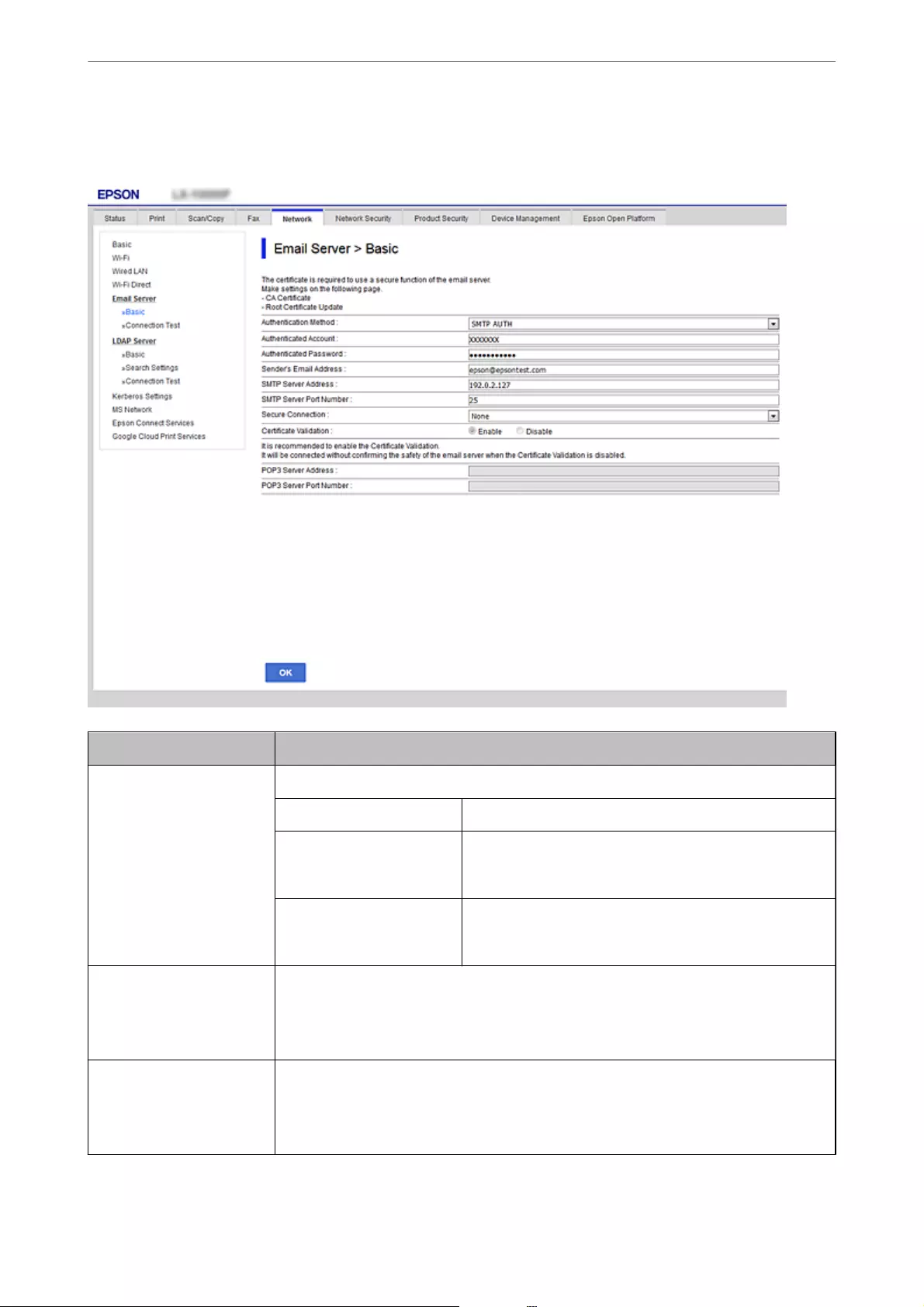
Mail Server Setting Items
Items Settings and Explanation
Authentication Method Specify the authentication method for the printer to access the mail server.
O Set when the mail server does not need authentication.
SMTP AUTH Authenticates on the SMTP server (outgoing mail server)
when sending the email. The mail server needs to support
SMTP authentication.
POP before SMTP Authenticates on the POP3 server (receiving mail server)
before sending the email. When you select this item, set the
POP3 server.
Authenticated Account If you select SMTP AUTH or POP before SMTP as the Authentication Method, enter the
authenticated account name between 0 and 255 characters in ASCII (0x20-0x7E).
When you select SMTP AUTH, enter the SMTP server account. When you select POP before
SMTP, enter the POP3 server account.
Authenticated Password If you select SMTP AUTH or POP before SMTP as the Authentication Method, enter the
authenticated password between 0 and 20 characters in ASCII (0x20-0x7E).
When you select SMTP AUTH, enter the authenticated account for the SMTP server. When
you select POP before SMTP, enter the authenticated account for the POP3 server.
Administrator Information
>
Settings to Use the Printer
>
Conguring a Mail Server
355
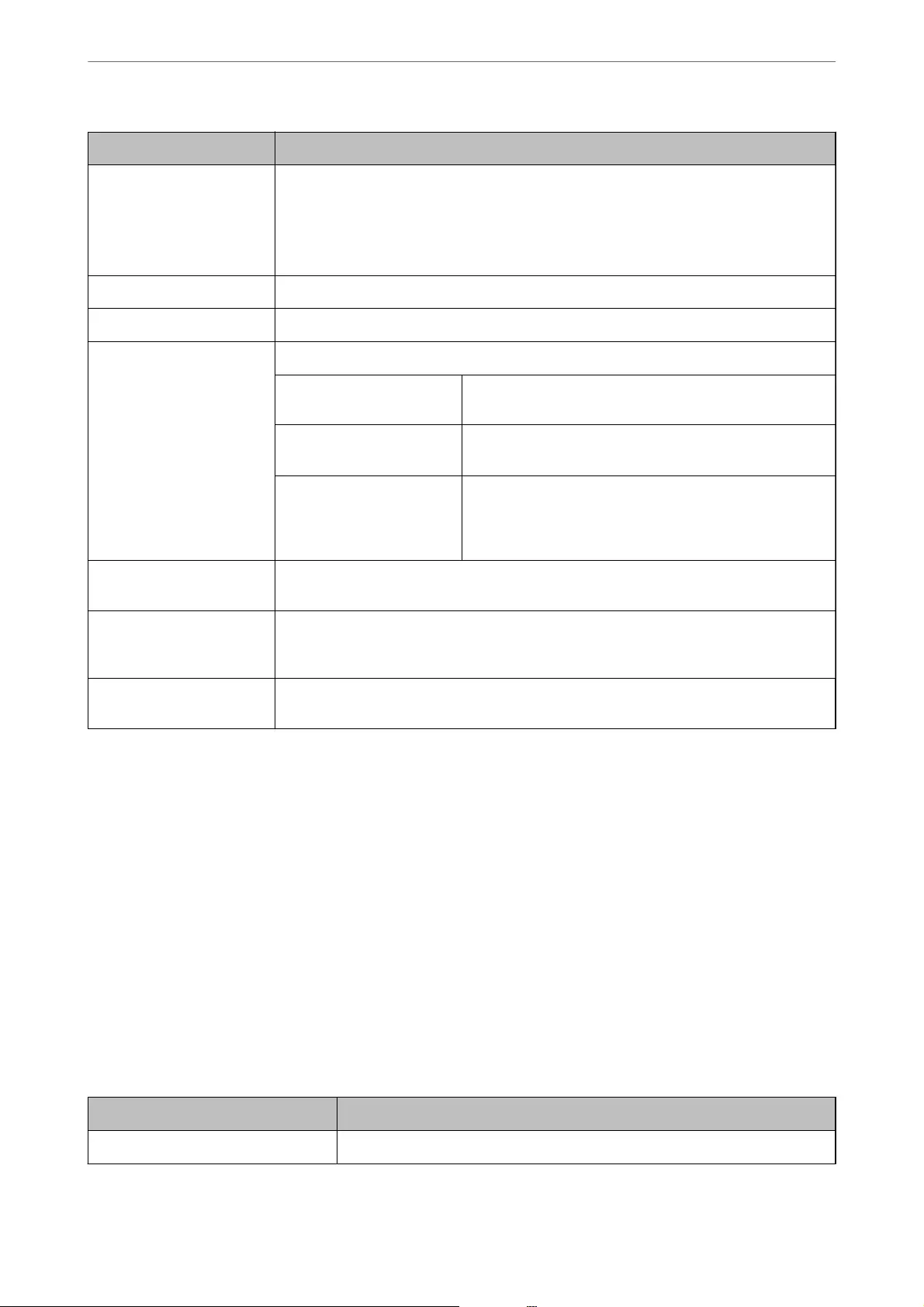
Items Settings and Explanation
Sender's Email Address Enter the sender's email address such as the email address of the system administrator. This
is used when authenticating, so enter a valid email address that is registered to the mail
server.
Enter between 0 and 255 characters in ASCII (0x20-0x7E) except for : ( ) < > [ ] ; ¥. A period "."
cannot be the rst character.
SMTP Server Address Enter between 0 and 255 characters using A-Z a-z 0-9 . - . You can use IPv4 or FQDN format.
SMTP Server Port Number Enter a number between 1 and 65535.
Secure Connection Select the encryption method of the communication to the mail server.
None If you select POP before SMTP in Authentication Method,
the connection is not encrypted.
SSL/TLS This is available when Authentication Method is set to O
or SMTP AUTH. Communication is encrypted from the start.
STARTTLS This is available when Authentication Method is set to O
or SMTP AUTH. Communication is not encrypted from the
start, but depending on the network environment, whether
the communication is encrypted or not is changed.
Certicate Validation The certicate is validated when this is enabled. We recommend this is set to Enable. To set
up, you need to import the CA Certicate to the printer.
POP3 Server Address If you select POP before SMTP as the Authentication Method, enter the POP3 server
address between 0 and 255 characters using A-Z a-z 0-9 . - . You can use IPv4 or FQDN
format.
POP3 Server Port Number If you select POP before SMTP as the Authentication Method, enter a number between 1
and 65535.
Checking a Mail Server Connection
You can check the connection to the mail server by performing the connection check.
1. Access Web Cong and select the Network tab > Email Server > Connection Test.
2. Select Start.
e connection test to the mail server is started. Aer the test, the check report is displayed.
Note:
You can also check the connection to the mail server from the printer’s control panel. Access as below.
Settings > General Settings > Network Settings > Advanced > Email Server > Connection Check
Mail Server Connection Test References
Messages Cause
Connection test was successful. This message appears when the connection with the server is successful.
Administrator Information
>
Settings to Use the Printer
>
Conguring a Mail Server
356
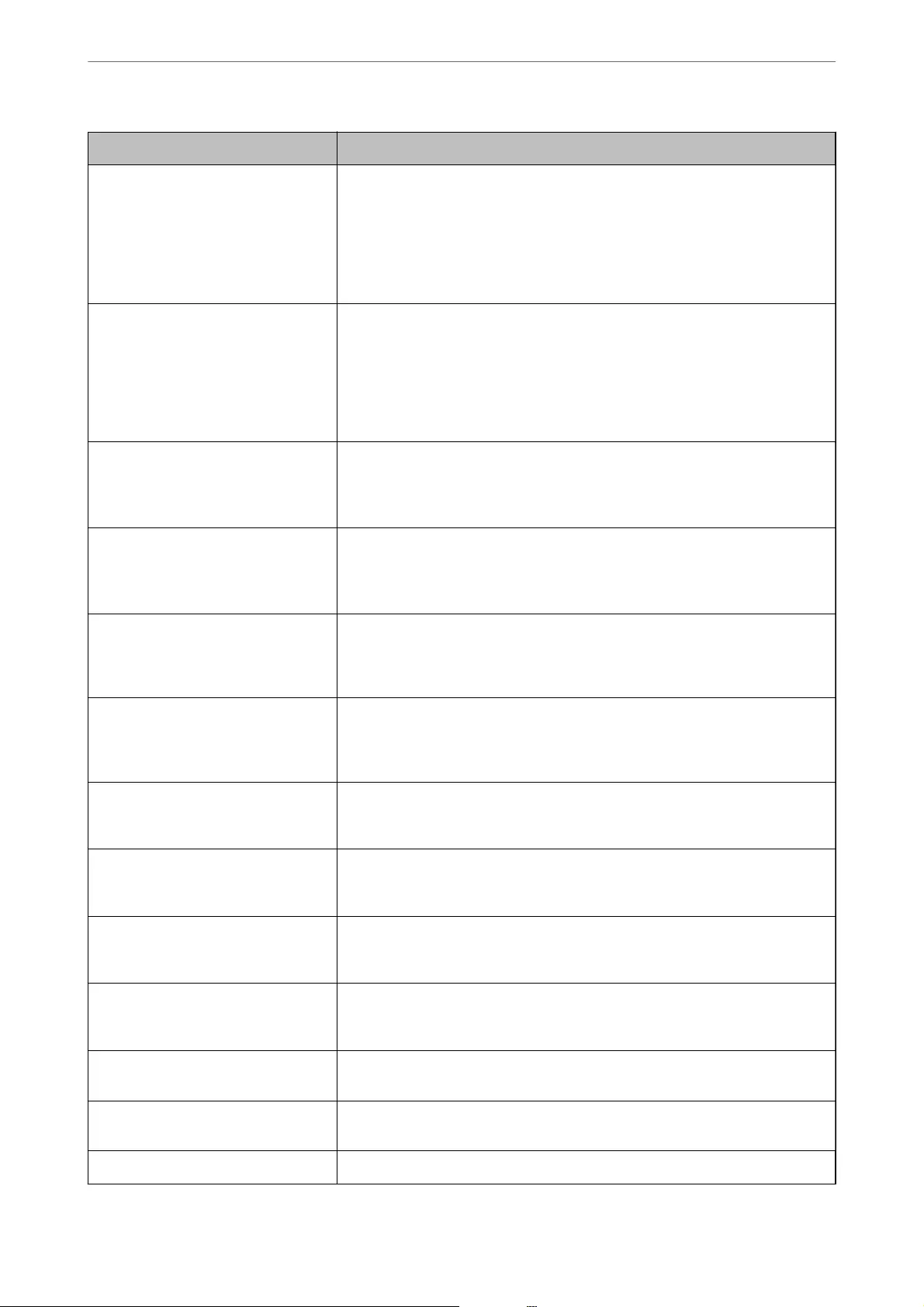
Messages Cause
SMTP server communication error.
Check the following. - Network
Settings
This message appears when
❏The printer is not connected to a network
❏SMTP server is down
❏Network connection is disconnected while communicating
❏Received incomplete data
POP3 server communication error.
Check the following. - Network
Settings
This message appears when
❏The printer is not connected to a network
❏POP3 server is down
❏Network connection is disconnected while communicating
❏Received incomplete data
An error occurred while connecting to
SMTP server. Check the followings. -
SMTP Server Address - DNS Server
This message appears when
❏Connecting to a DNS server failed
❏Name resolution for an SMTP server failed
An error occurred while connecting to
POP3 server. Check the followings. -
POP3 Server Address - DNS Server
This message appears when
❏Connecting to a DNS server failed
❏Name resolution for an POP3 server failed
SMTP server authentication error.
Check the followings. - Authentication
Method - Authenticated Account -
Authenticated Password
This message appears when SMTP server authentication failed.
POP3 server authentication error.
Check the followings. - Authentication
Method - Authenticated Account -
Authenticated Password
This message appears when POP3 server authentication failed.
Unsupported communication method.
Check the followings. - SMTP Server
Address - SMTP Server Port Number
This message appears when you try to communicate with unsupported protocols.
Connection to SMTP server failed.
Change Secure Connection to None.
This message appears when an SMTP mismatch occurs between a server and a
client, or when the server does not support SMTP secure connection (SSL
connection).
Connection to SMTP server failed.
Change Secure Connection to SSL/TLS.
This message appears when an SMTP mismatch occurs between a server and a
client, or when the server requests to use an SSL/TLS connection for an SMTP
secure connection.
Connection to SMTP server failed.
Change Secure Connection to
STARTTLS.
This message appears when an SMTP mismatch occurs between a server and a
client, or when the server requests to use an STARTTLS connection for an SMTP
secure connection.
The connection is untrusted. Check the
following. - Date and Time
This message appears when the printer’s date and time setting is incorrect or the
certicate has expired.
The connection is untrusted. Check the
following. - CA Certicate
This message appears when the printer does not have a root certicate
corresponding to the server or a CA Certicate has not been imported.
The connection is not secured. This message appears when the obtained certicate is damaged.
Administrator Information
>
Settings to Use the Printer
>
Conguring a Mail Server
357
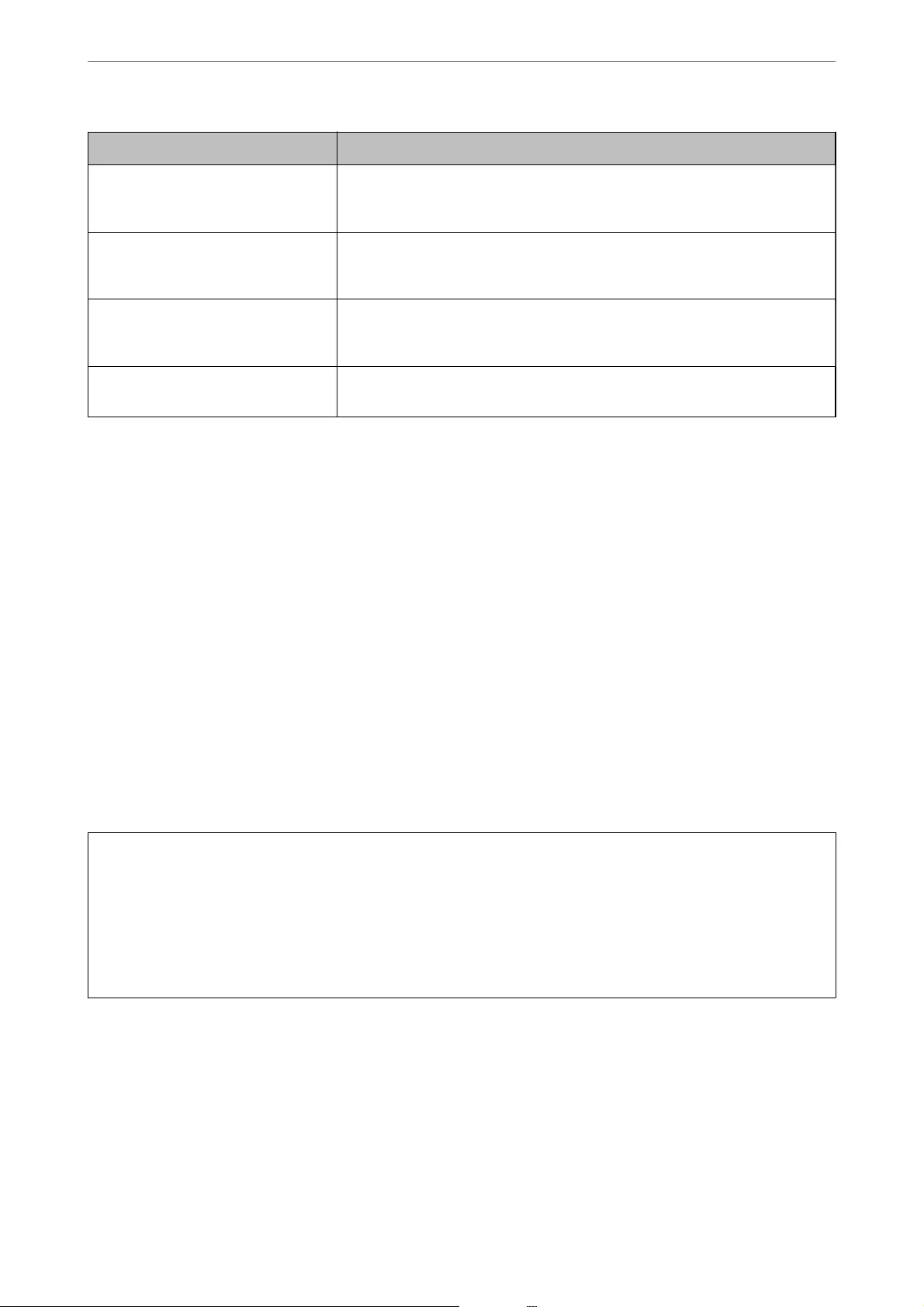
Messages Cause
SMTP server authentication failed.
Change Authentication Method to
SMTP-AUTH.
This message appears when an authentication method mismatch occurs between
a server and a client. The server supports SMTP AUTH.
SMTP server authentication failed.
Change Authentication Method to
POP before SMTP.
This message appears when an authentication method mismatch occurs between
a server and a client. The server does not support SMTP AUTH.
Sender's Email Address is incorrect.
Change to the email address for your
email service.
This message appears when the specied sender’s Email address is wrong.
Cannot access the printer until
processing is complete.
This message appears when the printer is busy.
Setting a Shared Network Folder
Set a shared network folder to save the scanned image and the results of faxing.
When saving a le to the folder, the printer logs on as the user of the computer on which the folder was created.
Also, make sure you setup MS Network when creating the shared network folder.
Creating the Shared Folder
Before Creating the Shared Folder
Before creating the shared folder, check the following.
❏e printer is connected to the network where it can access the computer where the shared folder will be
created.
❏A multi-byte character is not included in the name of the computer where the shared folder will be created.
c
Important:
When a multi-byte character is included in the computer name, saving the le to the shared folder may fail.
In that case, change to the computer that does not include the Multi-byte character in the name or change the
computer name.
When changing the computer name, make sure to conrm with the administrator in advance because it may aect
some settings, such as computer management, resource access, etc.
Checking the Network Prole
On the computer where the shared folder will be created, check whether folder sharing is available.
1. Log in to the computer where the shared folder will be created by the administrator authority user account.
2. Select Control Panel > Network and Internet > Network and Sharing Center.
Administrator Information
>
Settings to Use the Printer
>
Setting a Shared Network Folder
358

3. Click Advanced sharing settings, and then click for the prole with (current prole) in the displayed
network proles.
4. Check whether Turn on le and printer sharing is selected on File and Printer Sharing.
If already selected, click Cancel and close the window.
When you change the settings, click Save Changes and close the window.
Related Information
&“Location Where the Shared Folder is Created and an Example of the Security” on page 359
Location Where the Shared Folder is Created and an Example of the Security
Depending on the location where the shared folder is created, security and convenience vary.
To operate the shared folder from the printers or other computers, the following reading and changing permissions
for the folder are required.
❏Sharing tab > Advanced Sharing > Permissions
It controls the network access permission of the shared folder.
❏Access permission of Security tab
It controls permission of the network access and local access of the shared folder.
When you set Everyone to the shared folder that is created on the desktop, as an example of creating a shared
folder, all users who can access the computer will be permitted access.
However, the user who does not have authority cannot access them because the desktop (folder) is under the
control of the user folder, and then the security settings of the user folder are handed down to it. e user who is
permitted access on the Security tab (user logged in and administrator in this case) can operate the folder.
See below to create the proper location.
is example is when creating the "scan_folder" folder.
Related Information
&“Example of Conguration for File Servers” on page 359
&“Example of Conguration for a Personal Computer” on page 365
Example of Conguration for File Servers
is explanation is an example for creating the shared folder on the root of the drive on the shared computer, such
as the le server under the following condition.
Access controllable users, such as someone who has the same domain of a computer to create a shared folder, can
access the shared folder.
Set this conguration when you permit any user to read and write to the shared folder on the computer, such as the
le server and the shared computer.
❏Place for creating shared folder: Root of drive
❏Folder path: C:\scan_folder
❏Access permission via network (Share Permissions): Everyone
❏Access permission on le system (Security): Authenticated Users
Administrator Information
>
Settings to Use the Printer
>
Setting a Shared Network Folder
359
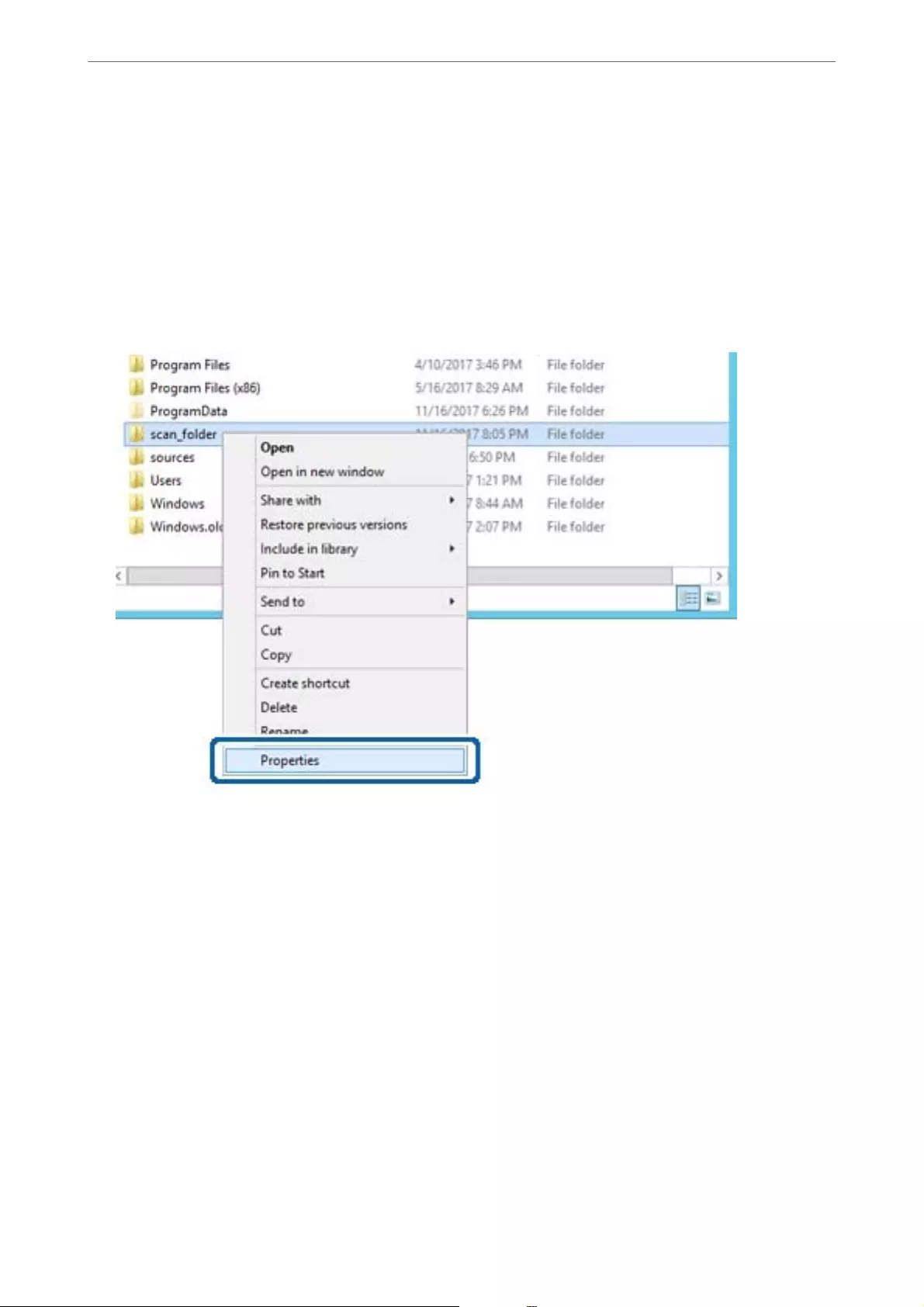
1. Log in to the computer where the shared folder will be created by the administrator authority user account.
2. Start explorer.
3. Create the folder on the root of drive, and then name it "scan_folder".
For the folder name, enter between 1 and 12 alphanumeric characters. If the character limit of the folder name
is exceeded, you may not be able to access it normally by the varied environment.
4. Right click the folder, and then select Properties.
Administrator Information
>
Settings to Use the Printer
>
Setting a Shared Network Folder
360
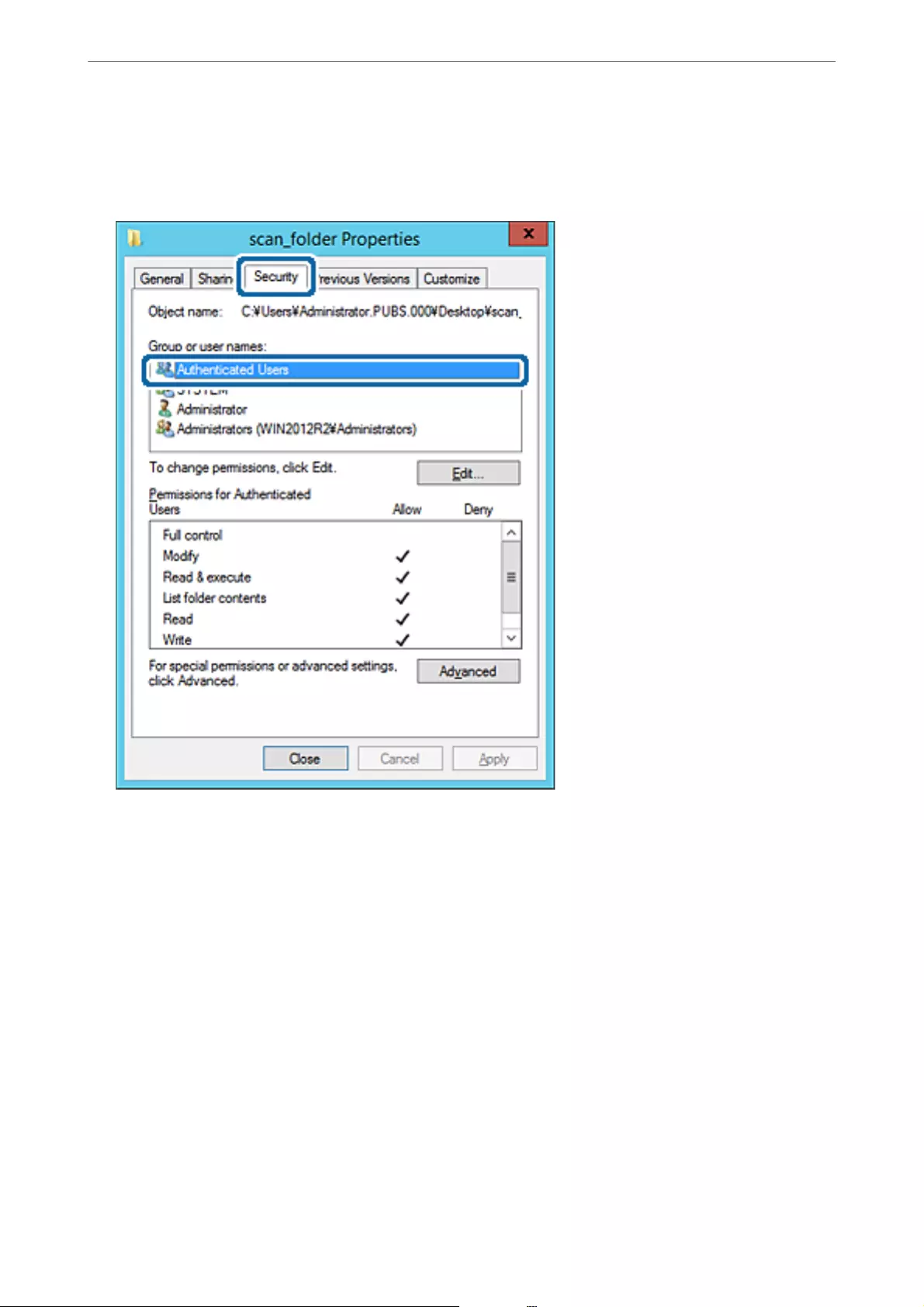
8. Click OK.
9. Select Security tab, and then select Authenticated Users on the Group or user names.
"Authenticated Users" is the special group that includes all users who can log in to the domain or computer.
is group is displayed only when the folder is created just below the root folder.
If it is not displayed, you can add it by clicking Edit. For more details, see Related Information.
Administrator Information
>
Settings to Use the Printer
>
Setting a Shared Network Folder
363
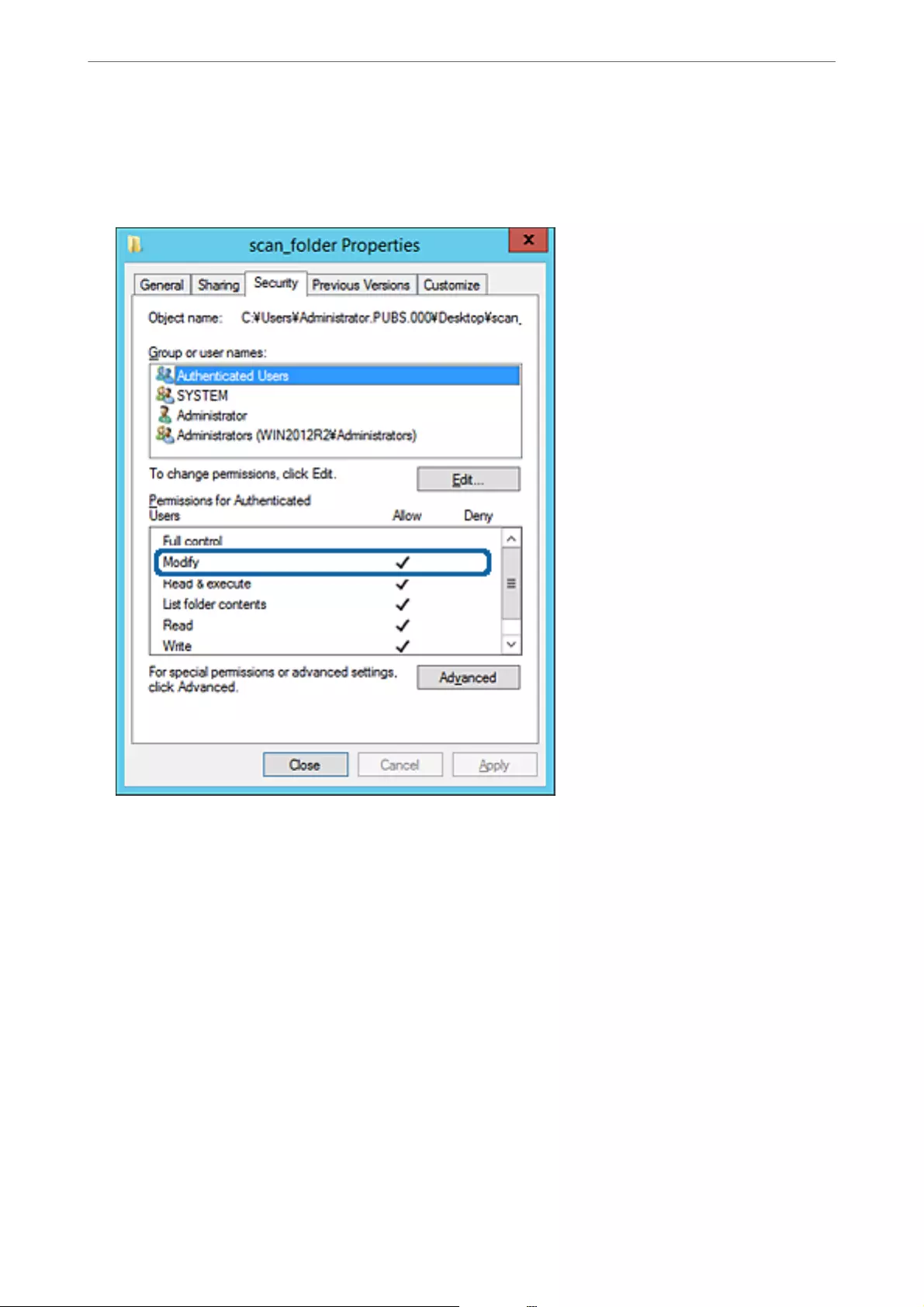
10. Check that Allow on Modify is selected in Permissions for Authenticated Users.
If it is not selected, select Authenticated Users, click Edit, select Allow on Modify in Permissions for
Authenticated Users, and then click OK.
Administrator Information
>
Settings to Use the Printer
>
Setting a Shared Network Folder
364
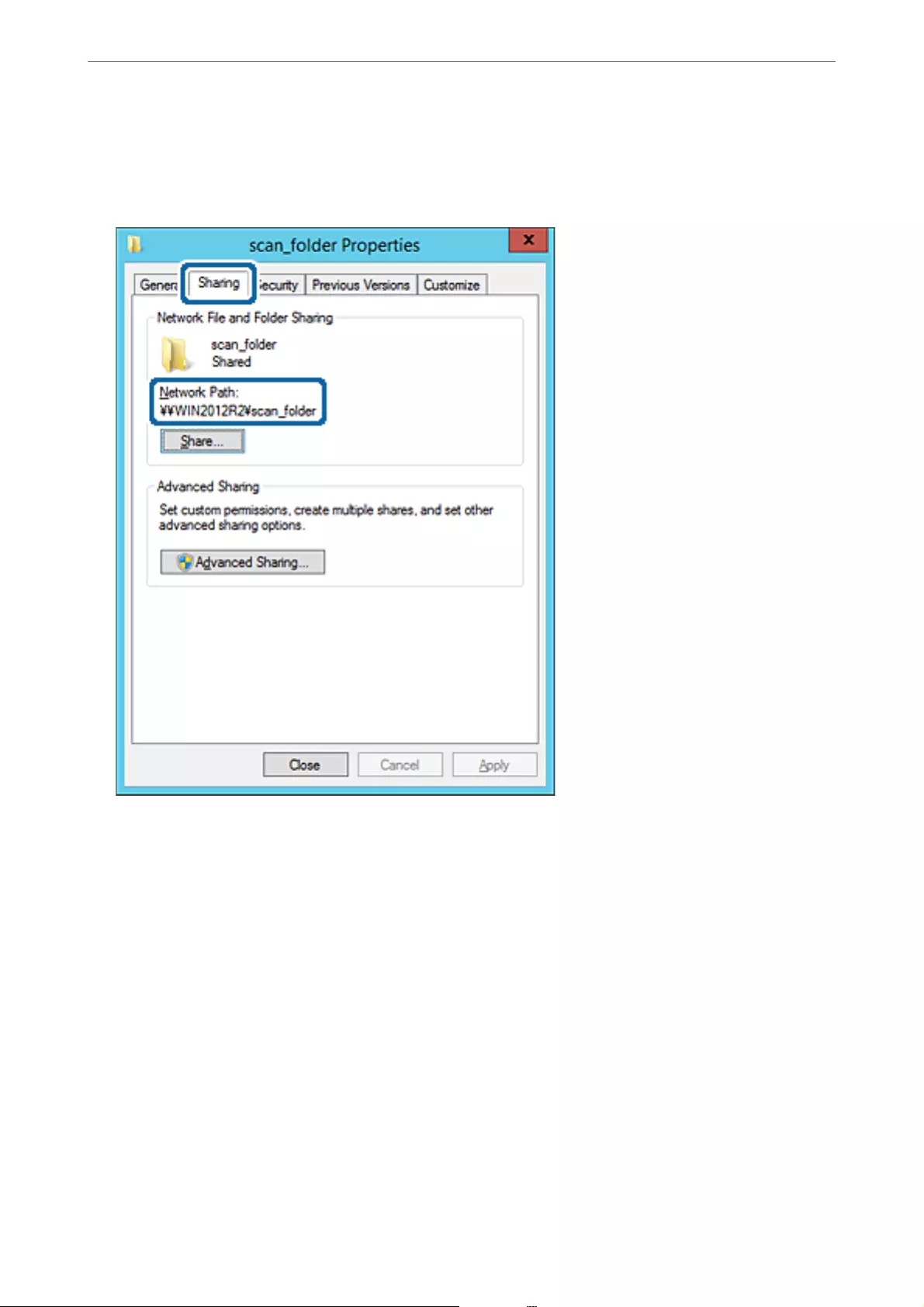
11. Select Sharing tab.
e network path of the shared folder is displayed. is is used when registering to the contacts of the printer.
Please write it down.
12. Click OK or Close to close the screen.
Check whether the le can be written or read on the shared folder from the computers of the same domain.
Related Information
&“Adding Group or User Which Permits Access” on page 370
Example of Conguration for a Personal Computer
is explanation is an example for creating the shared folder on the desktop of the user currently logging in to the
computer.
e user who logs in to the computer and who has administrator authority can access the desktop folder and the
document folder that are under the User folder.
Set this conguration when you DO NOT permit reading and writing to another user to the shared folder on a
personal computer.
❏Place for creating shared folder: Desktop
❏Folder path: C:\Users\xxxx\Desktop\scan_folder
Administrator Information
>
Settings to Use the Printer
>
Setting a Shared Network Folder
365
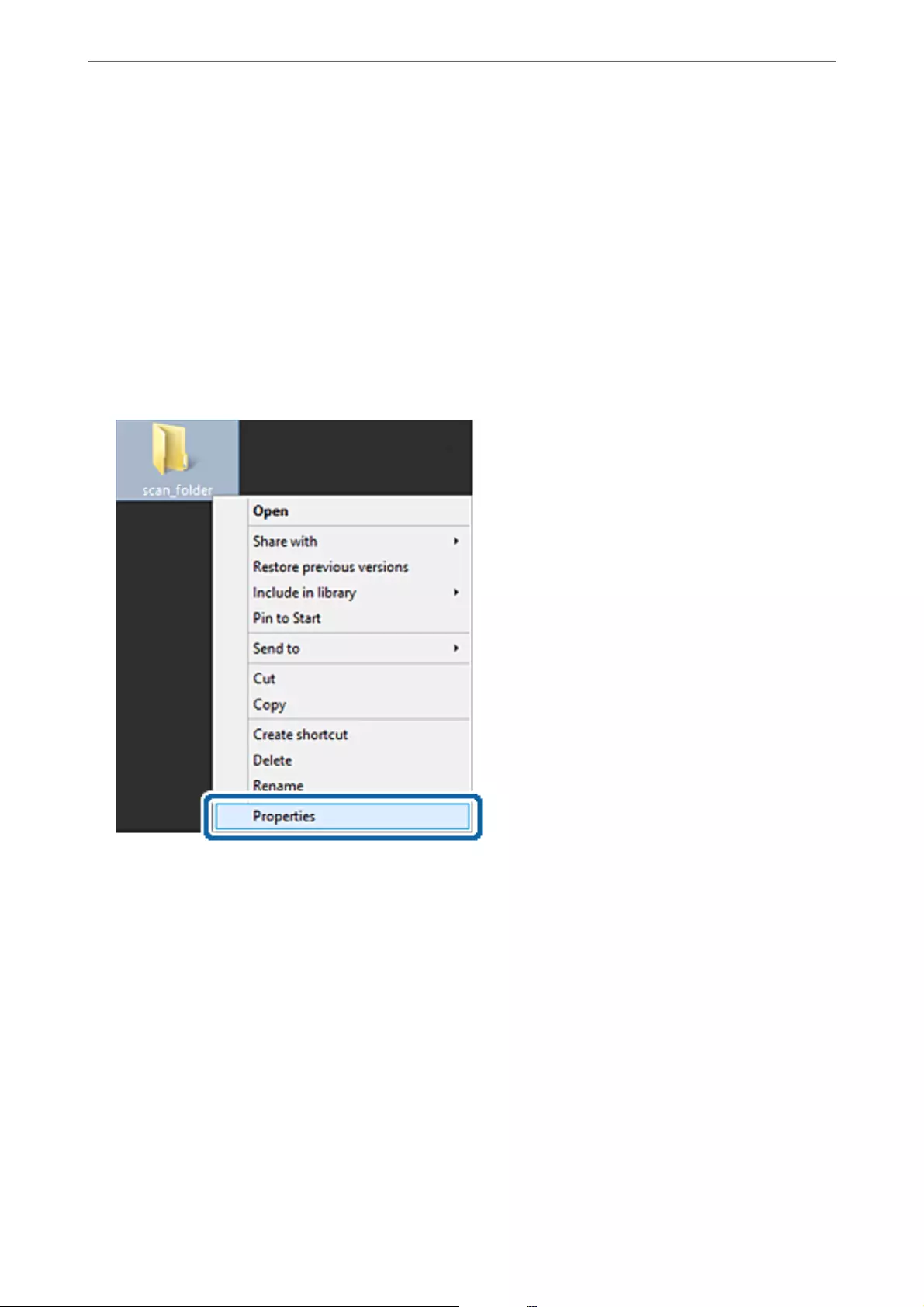
❏Access permission via network (Share Permissions): Everyone
❏Access permission on le system (Security): do not add, or add User/Group names to permit access
1. Log in to the computer where the shared folder will be created by the administrator authority user account.
2. Start explorer.
3. Create the folder on the desktop, and then name it "scan_folder".
For the folder name, enter between 1 and 12 alphanumeric characters. If the character limit of the folder name
is exceeded, you may not be able to access it normally by the varied environment.
4. Right click the folder, and then select Properties.
Administrator Information
>
Settings to Use the Printer
>
Setting a Shared Network Folder
366
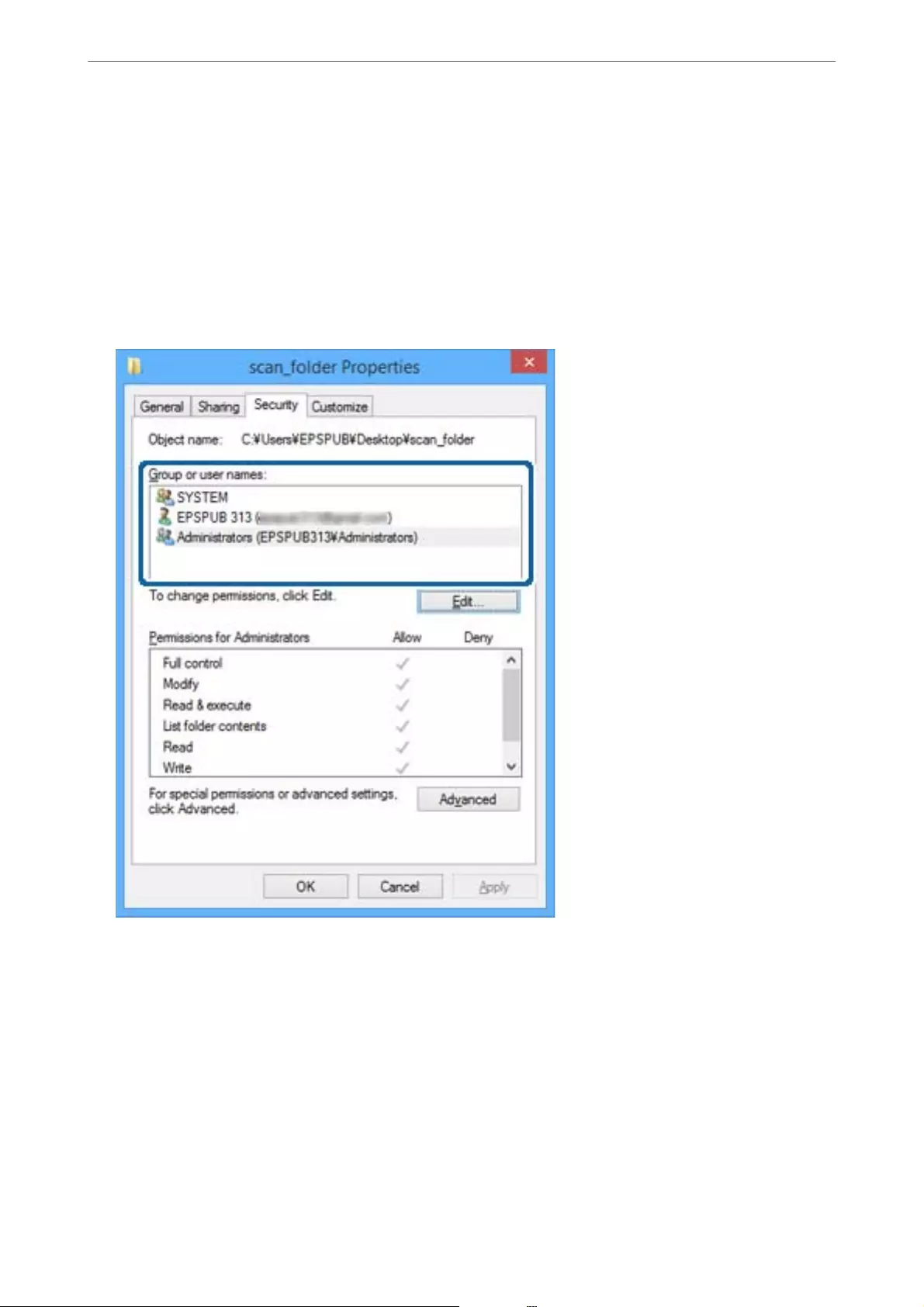
8. Click OK.
9. Select Security tab.
10. Check the group or the user in the Group or user names.
e group or the user that is displayed here can access the shared folder.
In this case, the user who logs in to this computer and the Administrator can access the shared folder.
Add access permission, if necessary. You can add it by clicking Edit. For more details, see Related Information.
Administrator Information
>
Settings to Use the Printer
>
Setting a Shared Network Folder
369
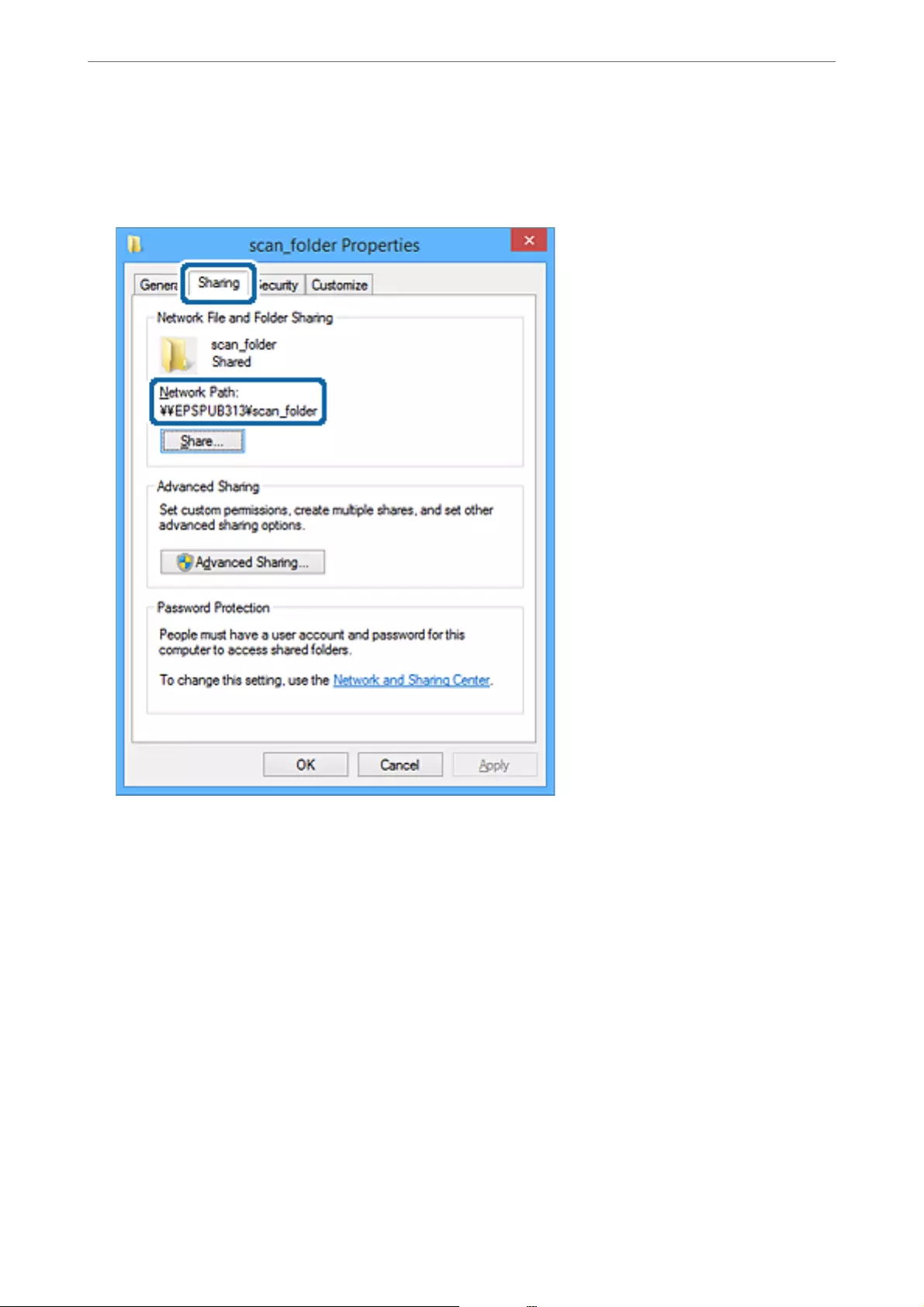
11. Select Sharing tab.
e network path of the shared folder is displayed. is is used when registering to the printer's contact. Please
write it down.
12. Click OK or Close to close the screen.
Check whether the le can be written or read on the shared folder from the computers of users or groups with
access permission.
Related Information
&“Adding Group or User Which Permits Access” on page 370
Adding Group or User Which Permits Access
You can add the group or user which permits access.
1. Right click the folder and select Properties.
2. Select Security tab.
Administrator Information
>
Settings to Use the Printer
>
Setting a Shared Network Folder
370
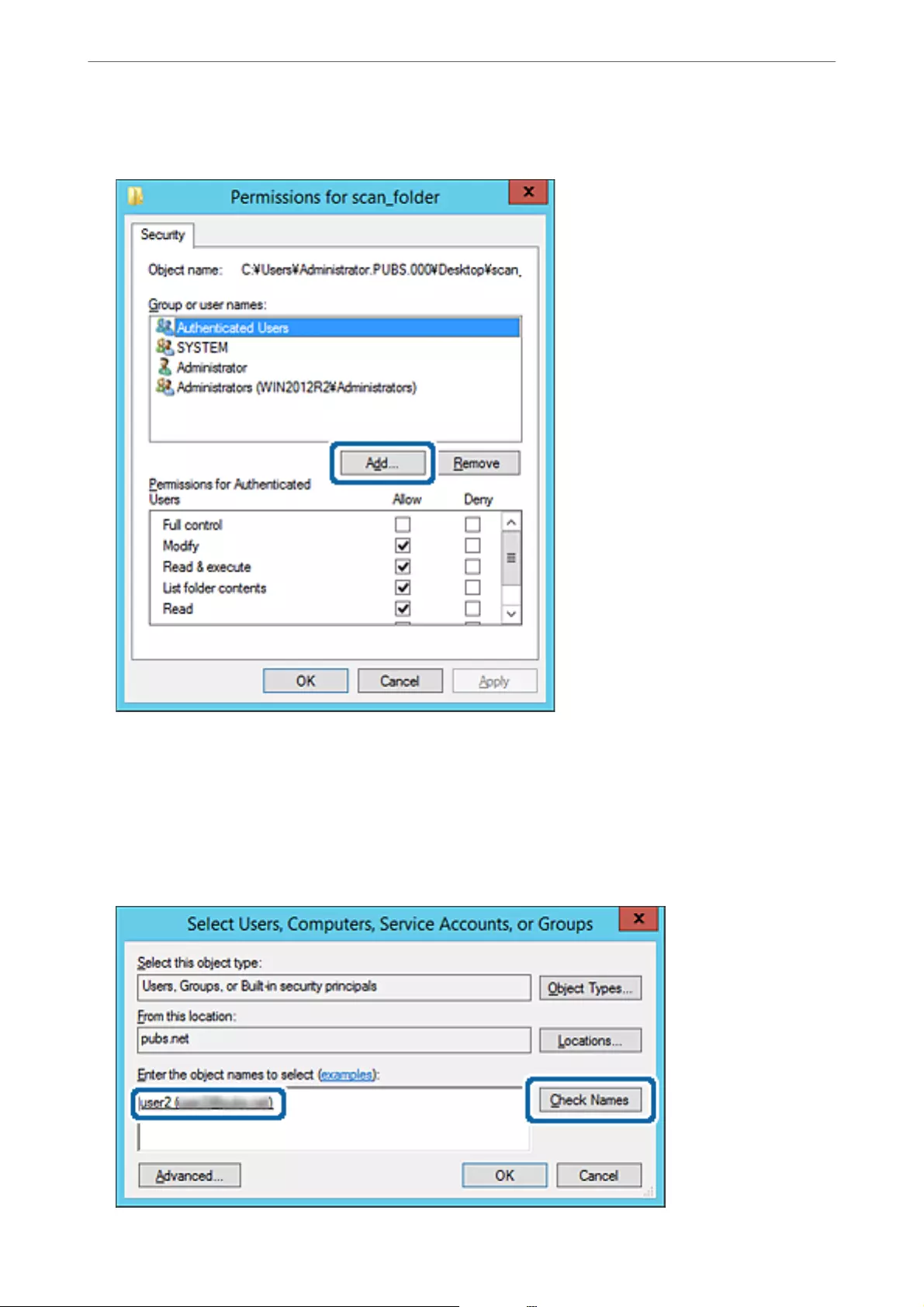
4. Click Add under the Group or user names.
5. Enter the group or user name that you want to permit access, and then click Check Names.
An underline is added to the name.
Note:
If you do not know the full name of the group or user, enter part of the name, and then click Check Names. e group
names or user names that match part of the name are listed, and then you can select the full name from the list.
If just one name matches, the full name with underlining is displayed in Enter the object name to select.
Administrator Information
>
Settings to Use the Printer
>
Setting a Shared Network Folder
372
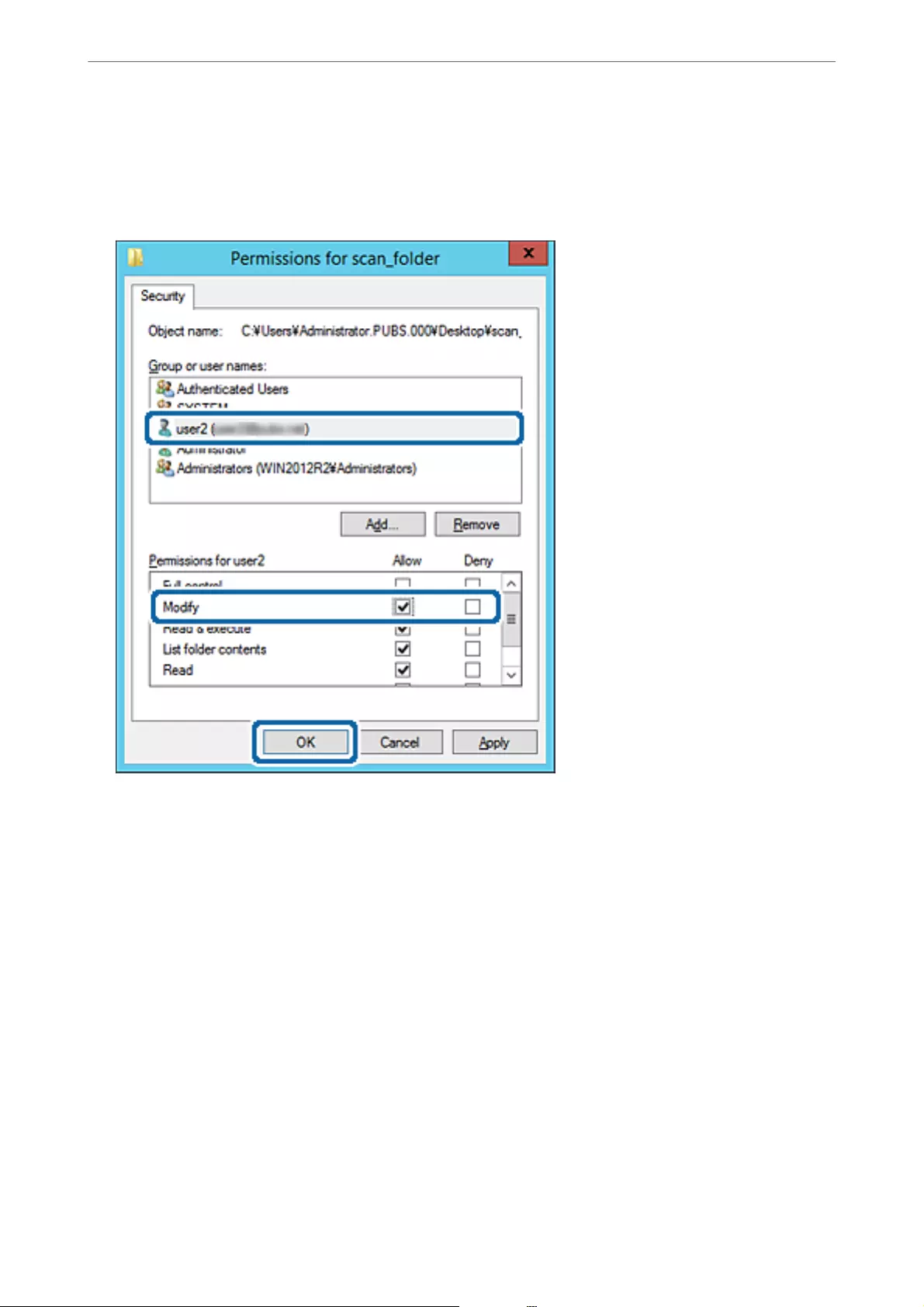
6. Click OK.
7. On the Permission screen, select the user name that is entered in Group or user names , select the access
permission on Modify, and then click OK.
8. Click OK or Close to close the screen.
Check whether the le can be written or read on the shared folder from the computers of users or groups with
access permission.
Using Microsoft Network Sharing
When enabling it, the following are possible.
❏Shares the USB storage over the network that is connected to the printer.
❏Forwards the scan result or receiving fax to the shared folder on the computer.
1. Access Web Cong and select the Network tab > MS Network.
2. Select Use Microso network sharing.
3. Set each item.
4. Click Next.
Administrator Information
>
Settings to Use the Printer
>
Setting a Shared Network Folder
373
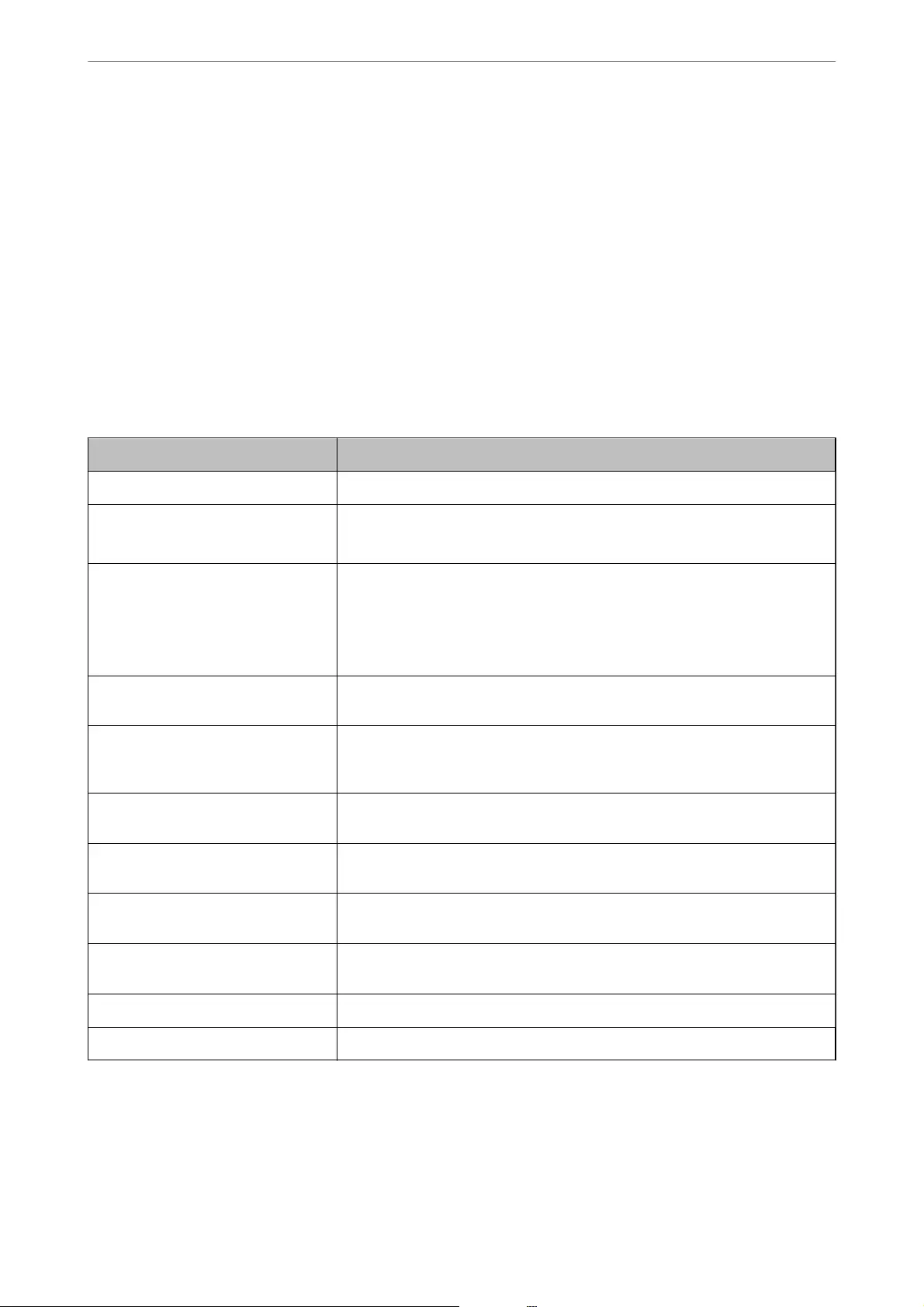
5. Conrm the settings, and then click OK.
6. Enter the following on the computer's explorer, and then press the Enter key.
Check whether there is a network folder and that you can access it.
\\Printer's IP address
Example : \\192.0.2.111
Related Information
&“Running Web Cong on a Web Browser” on page 301
MS Network Setting items
Items Explanation
Use Microsoft network sharing Select when enabling MS Network sharing.
SMB1.0
SMB2/SMB3
Enable the protocol you want to use. You can only enable SMB1.0 or SMB2/SMB3.
File Sharing Select whether to enable le sharing or not.
Enable it for the following situations.
❏Shares the USB storage over the network that is connected to the printer.
❏Forwards the scan result or receiving fax to the shared folder on the computer.
User Authentication Select whether to perform user authentication or not when accessing USB storage
on the network that is connected to the printer.
User Name Set the user name for user authentication. Enter between 1 and 127 characters in
ASCII except "/\[]:;|=,+*?<>@%. However, you cannot enter a single period or a
combination of the period "." and a space alone.
Password Set the password for user authentication. Enter between 1 and 64 characters in
ASCII. However, you cannot just set 10 asterisks "*".
Encrypted Communication Set whether to enable encrypted communication or not. You can select it when
Enable is selected on User Authentication.
Host Name Display the MS Network host name of the printer. To change this, select the
Network tab > Basic, and then change the Device Name.
Workgroup Name Enter the work group name of MS Network. Enter between 0 and 15 characters in
ASCII.
Access Attribute Set the Access Attribute of le sharing.
Shared Name(USB Host) Display as the shared name when sharing the le.
Making Contacts Available
Registering destinations in the printer's contacts list allows you to easily enter the destination when scanning or
sending faxes.
You can also use the LDAP server (LDAP search) to enter the destination.
Administrator Information
>
Settings to Use the Printer
>
Making Contacts Available
374
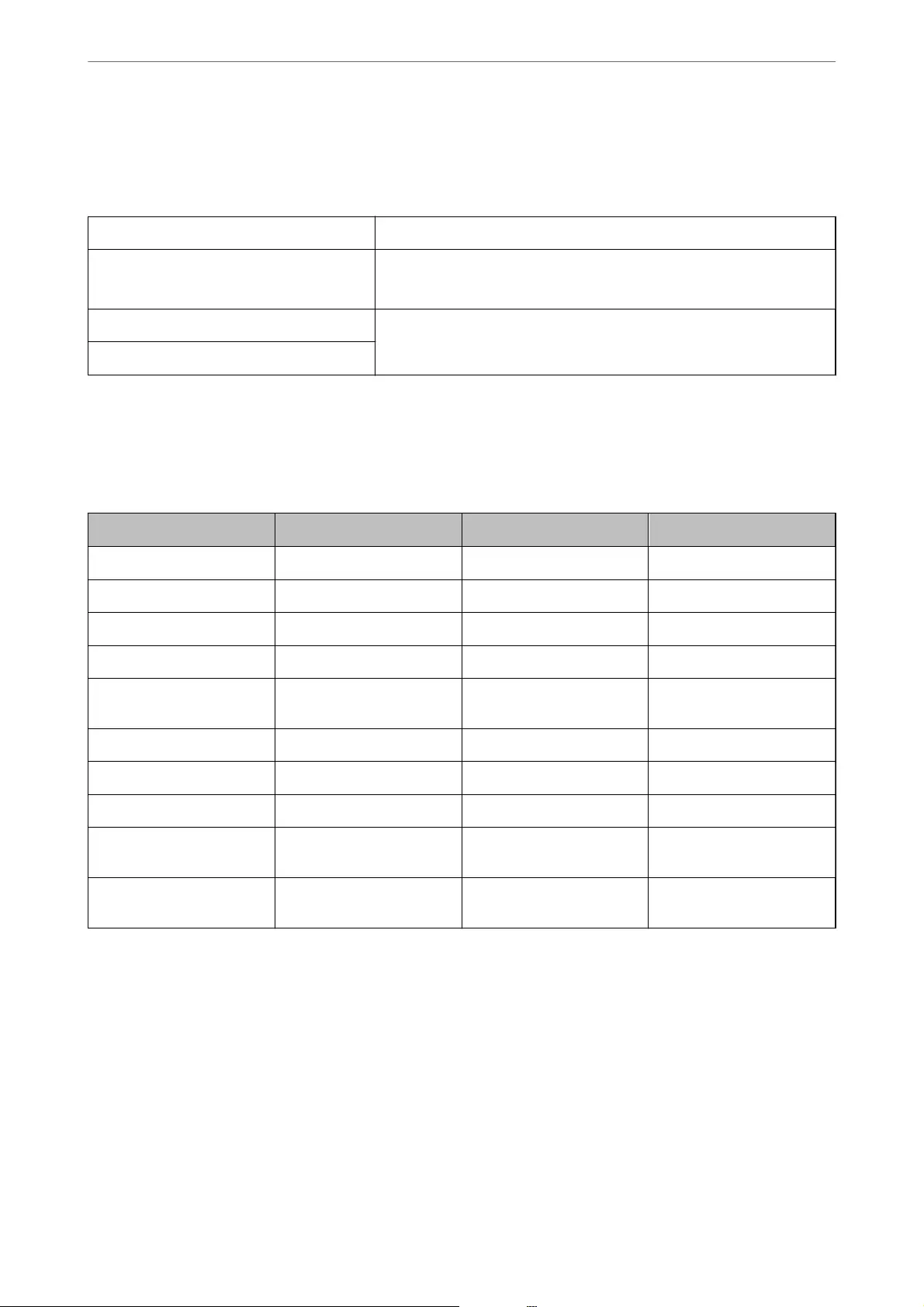
Note:
❏You can switch between your printer's contacts list and the LDAP using the printer’s control panel.
❏You can register the following types of destinations in the contacts list. You can register up to 200 entries in total.
Fax Destination for fax
Email Destination for email
You need to congure the email server settings beforehand.
Network Folder (SMB) Destination for scan data and fax forwarding data
Network Folder/FTP
Contacts Conguration Comparison
ere are three tools for conguring the printer's contacts: Web Cong, Epson Device Admin, and the printer’s
control panel. e dierences between three tools are listed in the table below.
Features Web Cong Epson Device Admin Printer’s control panel
Registering a destination ✓✓✓
Editing a destination ✓✓✓
Adding a group ✓✓✓
Editing a group ✓✓✓
Deleting a destination or
groups
✓✓✓
Deleting all destinations ✓✓ –
Importing a le ✓✓ –
Exporting to a le ✓✓ –
Assigning destinations to
frequent use
✓✓✓
Sorting destinations
assigned to frequent use
––✓
Note:
You can also congure the fax destination using the FAX Utility.
Registering a Destination to Contacts using Web Cong
Note:
You can also register the contacts on the printer’s control panel.
1. Access Web Cong and select the Scan/Copy or Fax tab > Contacts.
2. Select the number that you want to register, and then click Edit.
Administrator Information
>
Settings to Use the Printer
>
Making Contacts Available
375
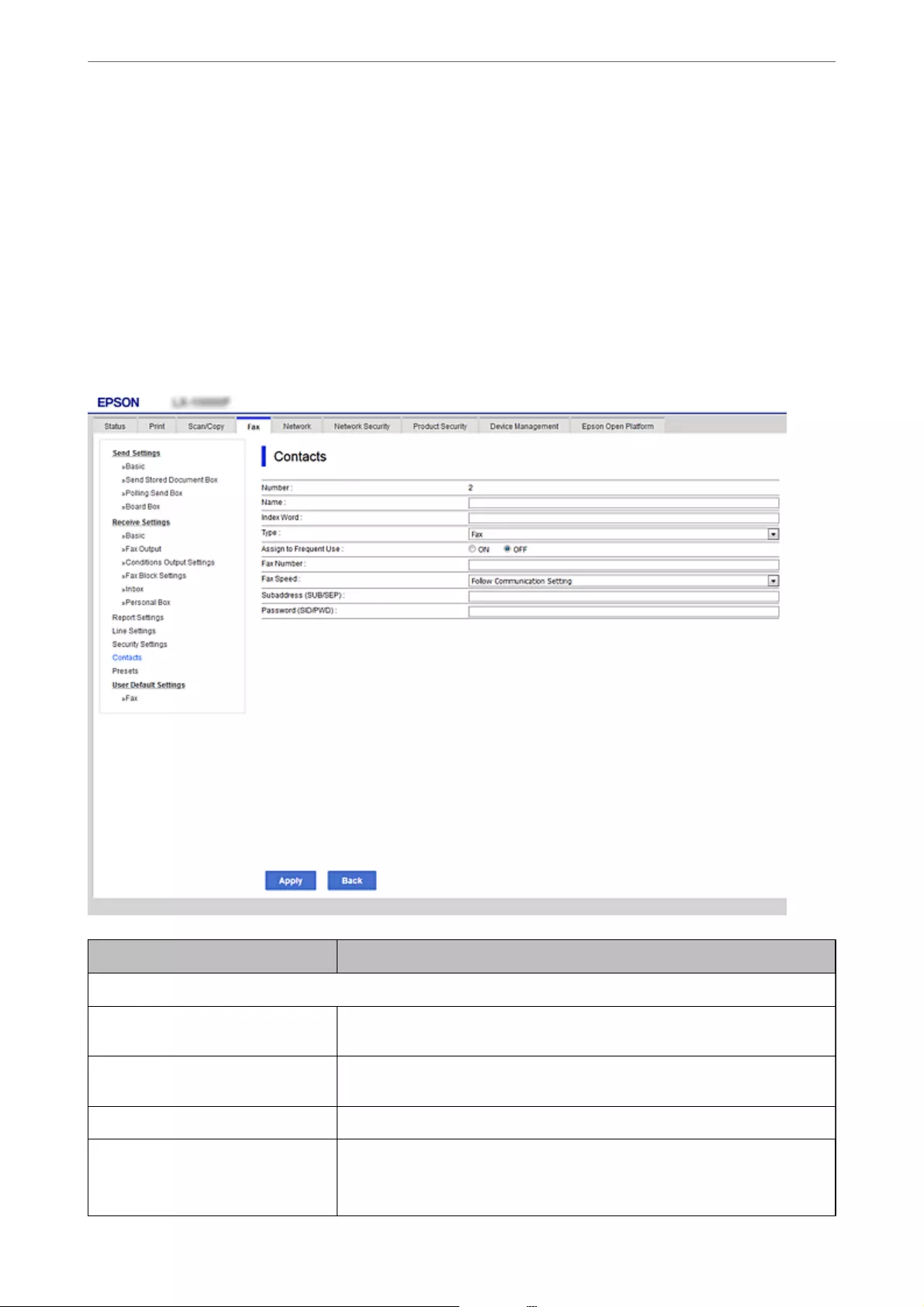
3. Enter Name and Index Word.
4. Select the destination type as the Type option.
Note:
You cannot change the Ty pe option aer registration is complete. If you want to change the type, delete the destination
and then register again.
5. Enter a value for each item, and then click Apply.
Destination Setting Items
Items Settings and Explanation
Common Settings
Name Enter a name displayed in the contacts in 30 characters or less in Unicode (UTF-8).
If you do not specify this, leave it blank.
Index Word Enter words to search in 30 characters or less in Unicode (UTF-8). If you do not
specify this, leave it blank.
Type Select the type of the address that you want to register.
Assign to Frequent Use Select to set the registered address as a frequently used address.
When setting as a frequently used address, it is displayed on the top screen of fax
and scan, and you can specify the destination without displaying the contacts.
Administrator Information
>
Settings to Use the Printer
>
Making Contacts Available
376
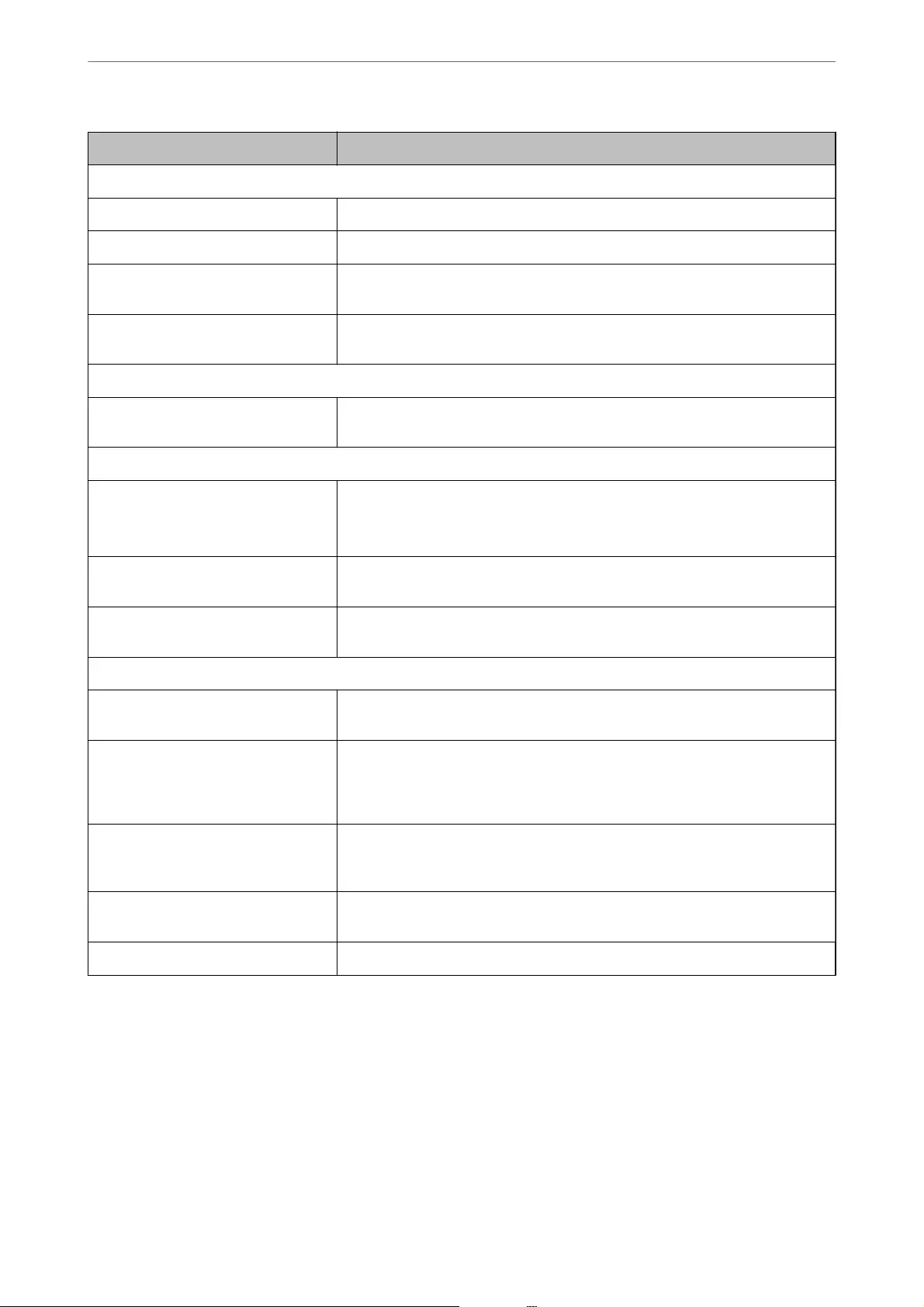
Items Settings and Explanation
Fax
Fax Number Enter between 1 and 64 characters using 0-9 - * # and space.
Fax Speed Select a communication speed for a destination.
Subaddress (SUB/SEP) Set the sub address that is appended when fax is sent. Enter within 20 characters
or less using 0-9, *, # or spaces. If you do not specify this, leave it blank.
Password (SID/PWD) Set the password for the sub address. Enter within 20 characters or less using 0-9,
*, # or spaces. If you do not specify this, leave it blank.
Email
Email Address Enter between 1 and 255 characters using A-Z a-z 0-9 ! # $ % & ' * + - . / = ? ^ _ { | }
~ @.
Network Folder (SMB)
Save to \\“Folder path”
Enter the location where the target folder is located between 1 and 253 characters
in Unicode (UTF-8), omitting "\\".
User Name Enter a user name to access a network folder in 30 characters or less in Unicode
(UTF-8). However, avoid using control characters (0x00 to 0x1f, 0x7F).
Password Enter a password to access a network folder in 20 characters or less in Unicode
(UTF-8). However, avoid using control characters (0x00 to 0x1f, 0x7F).
FTP
Save to Enter the server name between 1 and 253 characters in ASCII (0x20-0x7E),
omitting "ftp://".
User Name Enter a user name to access an FTP server in 30 characters or less in Unicode
(UTF-8). However, avoid using control characters (0x00 to 0x1f, 0x7F). If the server
allows anonymous connections, enter a user name such as Anonymous and FTP. If
you do not specify this, leave it blank.
Password Enter a password to access to an FTP server within 20 characters or less in Unicode
(UTF-8). However, avoid using control characters (0x00 to 0x1f, 0x7F). If you do not
specify this, leave it blank.
Connection Mode Select the connection mode from the menu. If a rewall is set between the printer
and the FTP server, select Passive Mode.
Port Number Enter the FTP server port number between 1 and 65535.
Registering Destinations as a Group Using Web Cong
If the destination type is set to Fax or Email, you can register the destinations as a group.
1. Access Web Cong and select the Scan/Copy or Fax tab > Contacts.
2. Select the number that you want to register, and then click Edit.
3. Select a group from Type.
Administrator Information
>
Settings to Use the Printer
>
Making Contacts Available
377
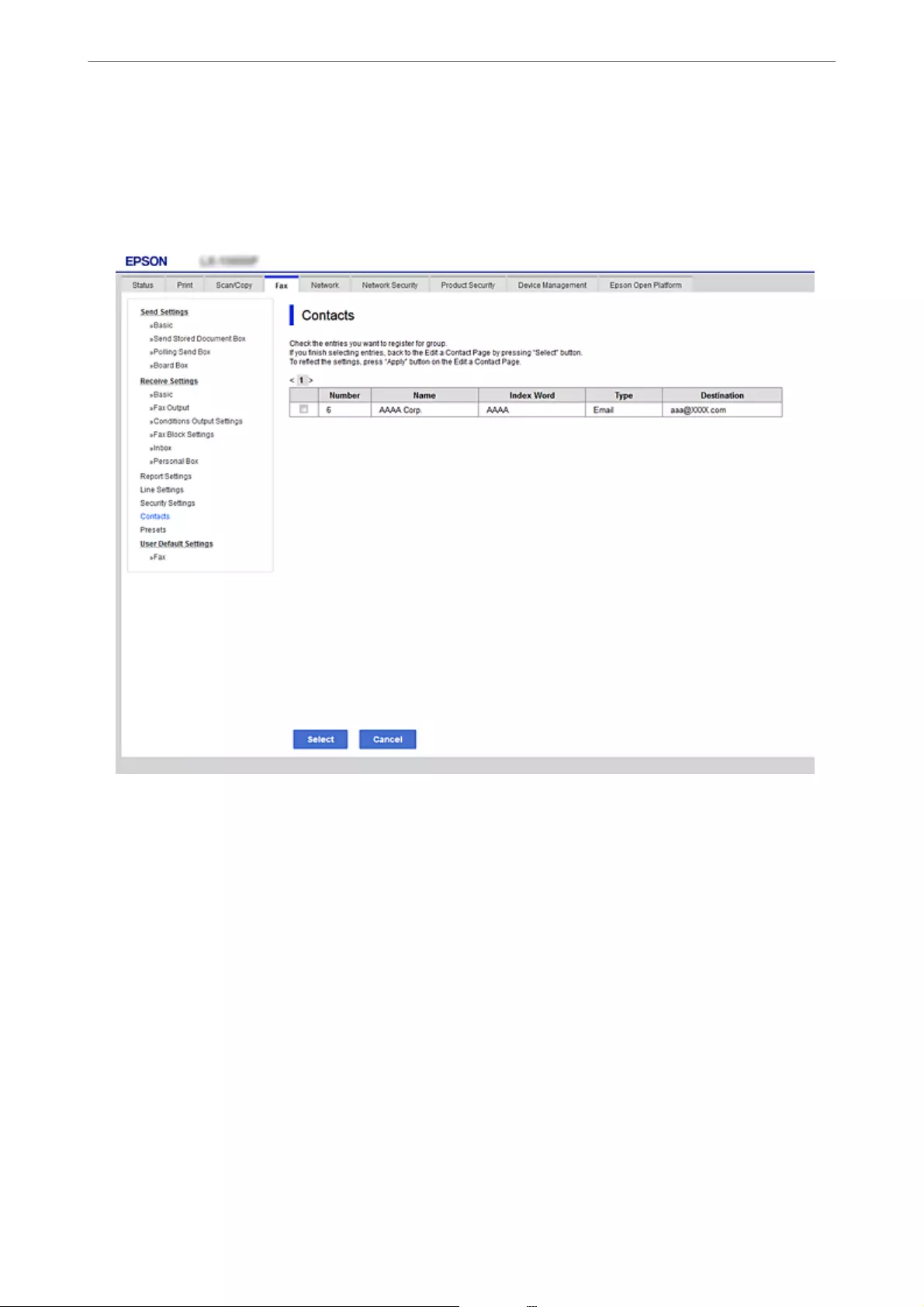
4. Click Select for Contact(s) for Group.
e available destinations are displayed.
5. Select the destination that you want to register to the group, and then click Select.
6. Enter a Name and Index Word.
7. Select whether or not you assign the registered group to the frequently used group.
Note:
Destinations can be registered to multiple groups.
8. Click Apply.
Registering Frequently Used Contacts
When you register frequently used contacts, the contacts are displayed at the top of the screen where you specify
the address.
1. Select Settings on the home screen.
2. Select Contacts Manager, and then select Frequent.
3. Select the type of contact you want to register.
Administrator Information
>
Settings to Use the Printer
>
Making Contacts Available
378

4. Select Edit.
Note:
To edit the order of the contacts, select Sort.
5. Select frequently used contacts that you want to register, and then select OK.
Note:
❏To deselect a contact, tap it again.
❏You can search for addresses from the contacts list. Enter the search keyword into the box on the top of the screen.
6. Select Close.
Backing Up and Importing Contacts
Using Web Cong or other tools, you can back up and import contacts.
For Web Cong, you can back up contacts by exporting the printer settings that include contacts. e exported le
cannot be edited because it is exported as a binary le.
When importing the printer settings to the printer, contacts are overwritten.
For Epson Device Admin, only contacts can be exported from the device’s property screen. Also, if you do not
export the security-related items, you can edit the exported contacts and import them because this can be saved as
a SYLK le or CSV le.
Importing Contacts Using Web Cong
If you have a printer that allows you to backup contacts and is compatible with this printer, you can register
contacts easily by importing the backup le.
Note:
For instructions on how to back up the printer contacts, see the manual provided with the printer.
Follow the steps below to import the contacts to this printer.
1. Access Web Cong, select Device Management > Export and Import Setting Value > Import.
2. Select the backup le you created in File, enter the password, and then click Next.
3. Select the Contacts checkbox, and then click Next.
Backing up Contacts Using Web Cong
Contacts data may be lost due to a printer malfunction. We recommend that you make a backup of the data
whenever you update the data. Epson shall not be responsible for the loss of any data, for backing up or recovering
data and/or settings even during a warranty period.
Using Web Cong, you can back up the contact data stored in the printer to the computer.
1. Access Web Cong, and then select the Device Management tab > Export and Import Setting Value >
Export.
Administrator Information
>
Settings to Use the Printer
>
Making Contacts Available
379

2. Select one of the Contacts checkboxes.
For example, if you select Contacts under the Scan/Copy category, the same checkbox under the Fax category
is also selected.
3. Enter a password to encrypt the exported le.
You need the password to import the le. Leave this blank if you do not want to encrypt the le.
4. Click Export.
Export and Bulk Registration of Contacts Using Tool
If you use Epson Device Admin, you can back up just the contacts and edit the exported les, then register them all
at once.
It is useful if you want to back up only the contacts or when you replace the printer and you want to transfer the
contacts from the old one to new one.
Exporting Contacts
Save the contacts information to the le.
You can edit les saved in SYLK format or csv format by using a spreadsheet application or text editor. You can
register all at once aer deleting or adding the information.
Information that includes security items such as password and personal information can be saved in binary format
with a password. You cannot edit the le. is can be used as the backup le of the information including the
security items.
1. Start Epson Device Admin.
2. Select Devices on the side bar task menu.
3. Select the device you want to congure from the device list.
4. Click Device Conguration on the Home tab on the ribbon menu.
When the administrator password has been set, enter the password and click OK.
5. Click Common > Contacts.
6. Select the export format from Export > Export items.
❏All Items
Export the encrypted binary le. Select when you want to include the security items such as password and
personal information. You cannot edit the le. If you select it, you have to set the password. Click
Conguration and set a password between 8 and 63 characters long in ASCII. is password is required
when importing the binary le.
❏Items except Security Information
Export the SYLK format or csv format les. Select when you want to edit the information of the exported
le.
7. Click Export.
Administrator Information
>
Settings to Use the Printer
>
Making Contacts Available
380

8. Specify the place to save the le, select the le type, and then click Save.
e completion message is displayed.
9. Click OK.
Check that the le is saved to the specied place.
Importing Contacts
Import the contacts information from the le.
You can import the les saved in SYLK format or csv format or the backed-up binary le that includes the security
items.
1. Start Epson Device Admin.
2. Select Devices on the side bar task menu.
3. Select the device you want to congure from the device list.
4. Click Device Conguration on the Home tab on the ribbon menu.
When the administrator password has been set, enter the password and click OK.
5. Click Common > Contacts.
6. Click Browse on Import.
7. Select the le you want to import and then click Open.
When you select the binary le, in Password enter the password you set when exporting the le.
8. Click Import.
e conrmation screen is displayed.
9. Click OK.
e validation result is displayed.
❏Edit the information read
Click when you want to edit the information individually.
❏Read more le
Click when you want to import multiple les.
10. Click Import, and then click OK on the import completion screen.
Return to the device's property screen.
11. Click Transmit.
12. Click OK on the conrmation message.
e settings are sent to the printer.
Administrator Information
>
Settings to Use the Printer
>
Making Contacts Available
381
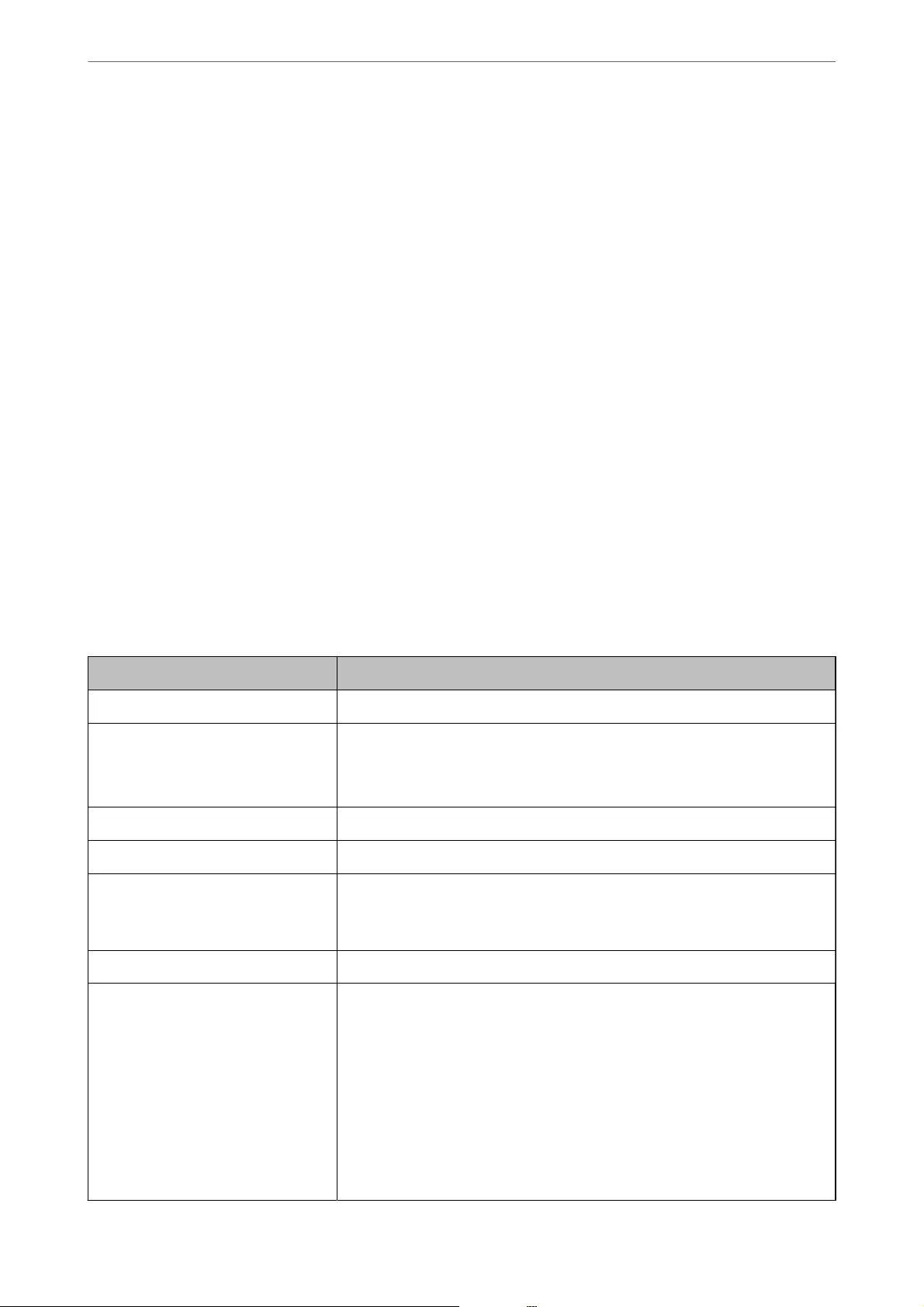
13. On the sending completion screen, click OK.
e printer's information is updated.
Open the contacts from Web Cong or printer's control panel, and then check that the contact is updated.
Cooperation between the LDAP Server and Users
When cooperating with the LDAP server, you can use the address information registered to the LDAP server as the
destination of an email or fax.
Conguring the LDAP Server
To use the LDAP server information, register it on the printer.
1. Access the Web Cong and select the Network tab > LDAP Server > Basic.
2. Enter a value for each item.
3. Select OK.
e settings you have selected are displayed.
LDAP Server Setting Items
Items Settings and Explanation
Use LDAP Server Select Use or Do Not Use.
LDAP Server Address Enter the address of the LDAP server. Enter between 1 and 255 characters of
either IPv4, IPv6, or FQDN format. For the FQDN format, you can use alphanumeric
characters in ASCII (0x20-0x7E) and "- " except for the beginning and end of the
address.
LDAP server Port Number Enter the LDAP server port number between 1 and 65535.
Secure Connection Specify the authentication method when the printer accesses the LDAP server.
Certicate Validation When this is enabled, the certicate of the LDAP sever is validated. We
recommend this is set to Enable.
To set up, the CA Certicate needs to be imported to the printer.
Search Timeout (sec) Set the length of time for searching before timeout occurs between 5 and 300.
Authentication Method Select one of the methods.
If you select Kerberos Authentication, select Kerberos Settings to make
settings for Kerberos.
To perform Kerberos Authentication, the following environment is required.
❏The printer and the DNS server can communicate.
❏The time of the printer, KDC server, and the server that is required for
authentication (LDAP server, SMTP server, File server) are synchronized.
❏When the service server is assigned as the IP address, the FQDN of the service
server is registered on the DNS server reverse lookup zone.
Administrator Information
>
Settings to Use the Printer
>
Making Contacts Available
382
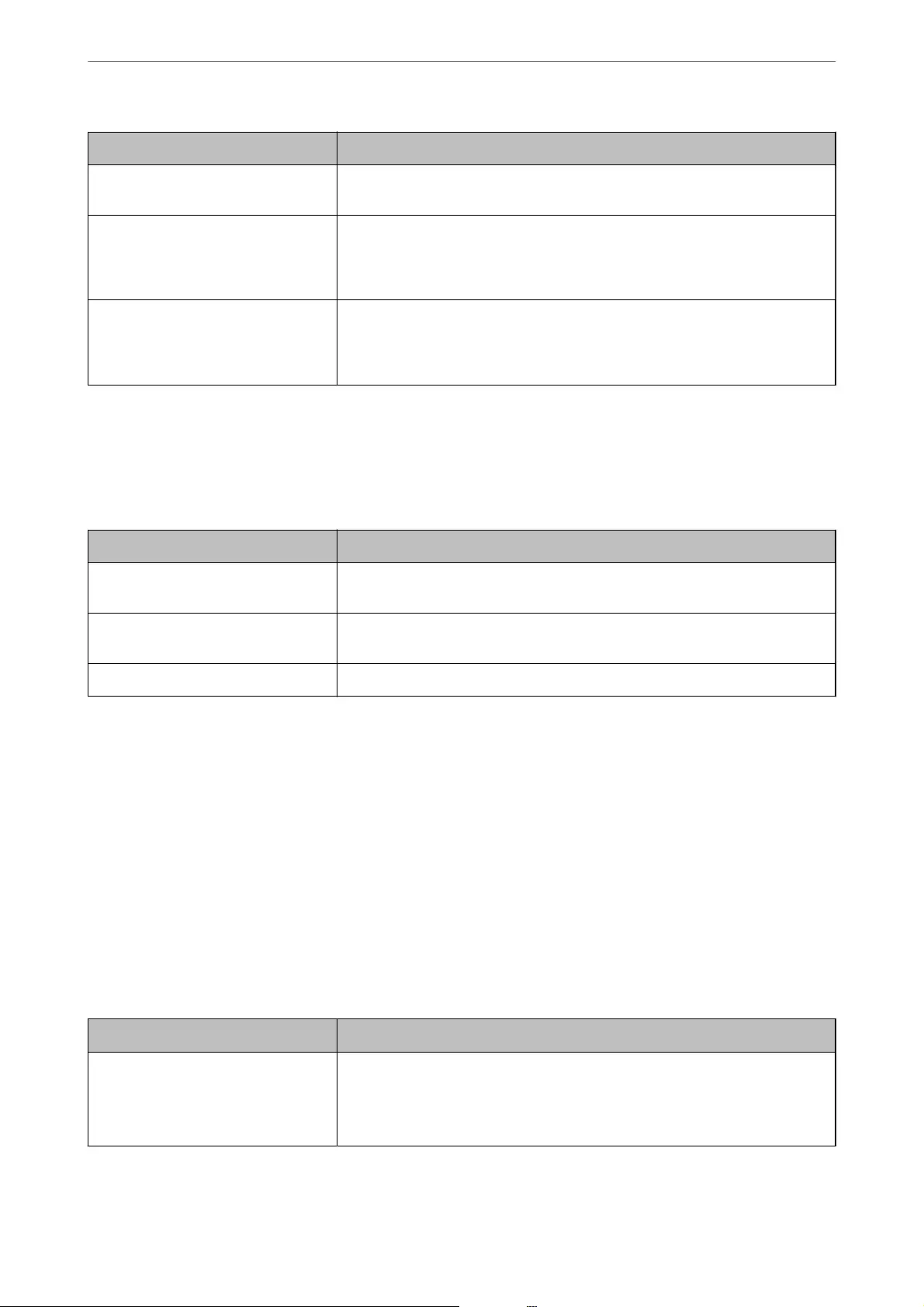
Items Settings and Explanation
Kerberos Realm to be Used If you select Kerberos Authentication for Authentication Method, select the
Kerberos realm that you want to use.
Administrator DN / User Name Enter the user name for the LDAP server in 128 characters or less in Unicode
(UTF-8). You cannot use control characters, such as 0x00-0x1F and 0X7F. This
setting is not used when Anonymous Authentication is selected as the
Authentication Method. If you do not specify this, leave it blank.
Password Enter the password for the LDAP server authentication in 128 characters or less in
Unicode (UTF-8). You cannot use control characters, such as 0x00-0x1F and 0X7F.
This setting is not used when Anonymous Authentication is selected as the
Authentication Method. If you do not specify this, leave it blank.
Kerberos Settings
If you select Kerberos Authentication for Authentication Method of LDAP Server > Basic, make the following
Kerberos settings from the Network tab > Kerberos Settings. You can register up to 10 settings for the Kerberos
settings.
Items Settings and Explanation
Realm (Domain) Enter the realm of the Kerberos authentication in 255 characters or less in ASCII
(0x20-0x7E). If you do not register this, leave it blank.
KDC Address Enter the address of the Kerberos authentication server. Enter 255 characters or
less in either IPv4, IPv6 or FQDN format. If you do not register this, leave it blank.
Port Number (Kerberos) Enter the Kerberos server port number between 1 and 65535.
Conguring the LDAP Server Search Settings
When you set up the search settings, you can use the email address and fax number registered to the LDAP server.
1. Access Web Cong and select the Network tab > LDAP Server > Search Settings.
2. Enter a value for each item.
3. Click OK to display the setting result.
e settings you have selected are displayed.
LDAP Server Search Setting Items
Items Settings and Explanation
Search Base (Distinguished Name) If you want to search an arbitrary domain, specify the domain name of the LDAP
server. Enter between 0 and 128 characters in Unicode (UTF-8). If you do not
search for arbitrary attribute, leave this blank.
Example for the local server directory: dc=server,dc=local
Administrator Information
>
Settings to Use the Printer
>
Making Contacts Available
383
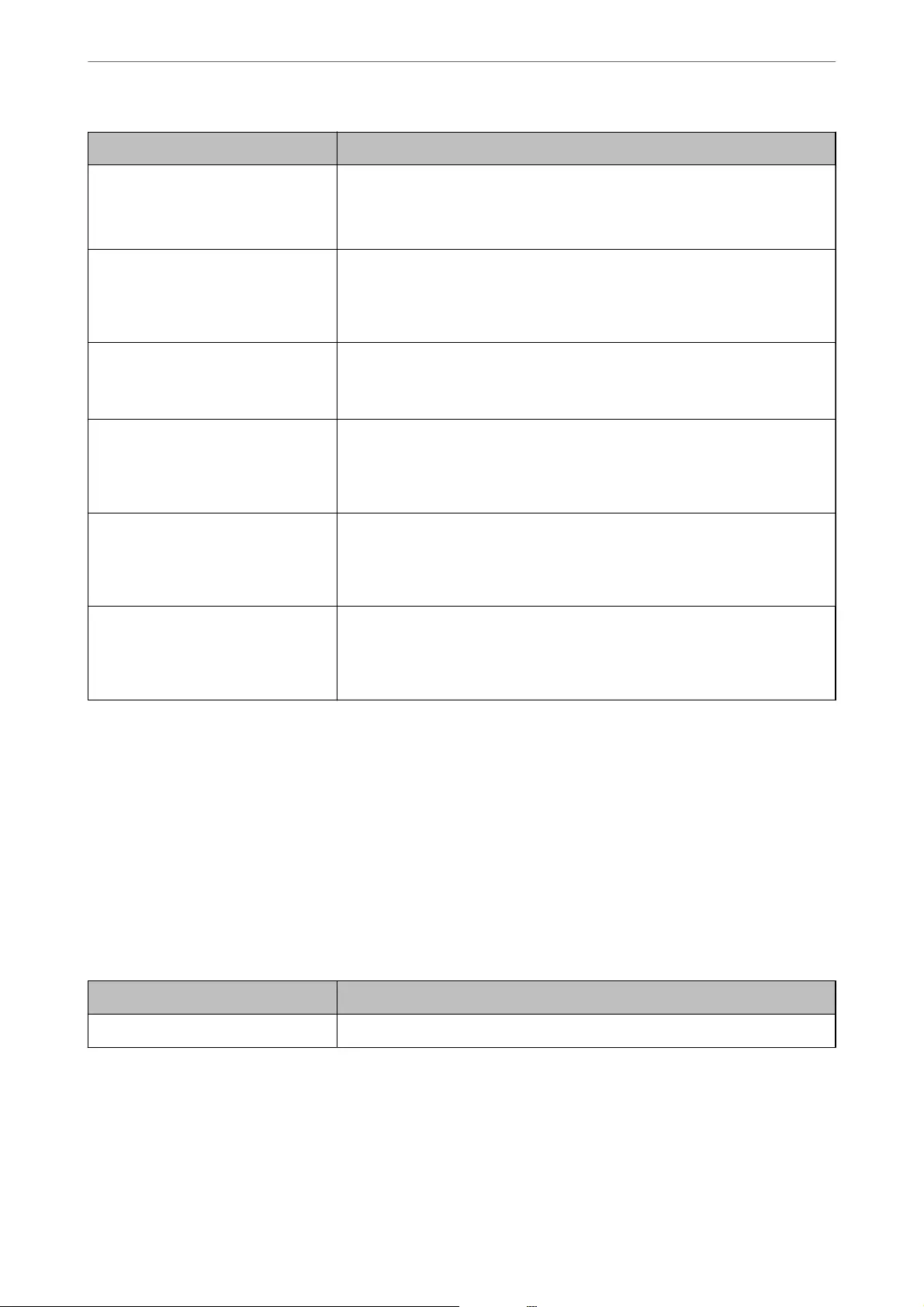
Items Settings and Explanation
Number of search entries Specify the number of search entries between 5 and 500. The specied number of
the search entries is saved and displayed temporarily. Even if the number of the
search entries is over the specied number and an error message appears, the
search can be completed.
User name Attribute Specify the attribute name to display when searching for user names. Enter
between 1 and 255 characters in Unicode (UTF-8). The rst character should be a-z
or A-Z.
Example: cn, uid
User name Display Attribute Specify the attribute name to display as the user name. Enter between 0 and 255
characters in Unicode (UTF-8). The rst character should be a-z or A-Z.
Example: cn, sn
Fax Number Attribute Specify the attribute name to display when searching for fax numbers. Enter a
combination of between 1 and 255 characters using A-Z, a-z, 0-9, and -. The rst
character should be a-z or A-Z.
Example: facsimileTelephoneNumber
Email Address Attribute Specify the attribute name to display when searching for email addresses. Enter a
combination of between 1 and 255 characters using A-Z, a-z, 0-9, and -. The rst
character should be a-z or A-Z.
Example: mail
Arbitrary Attribute 1 - Arbitrary
Attribute 4
You can specify other arbitrary attributes to search for. Enter between 0 and 255
characters in Unicode (UTF-8). The rst character should be a-z or A-Z. If you do
not want to search for arbitrary attributes, leave this blank.
Example: o, ou
Checking the LDAP Server Connection
Performs the connection test to the LDAP server by using the parameter set on LDAP Server > Search Settings.
1. Access Web Cong and select the Network tab > LDAP Server > Connection Test.
2. Select Start.
e connection test is started. Aer the test, the check report is displayed.
LDAP Server Connection Test References
Messages Explanation
Connection test was successful. This message appears when the connection with the server is successful.
Administrator Information
>
Settings to Use the Printer
>
Making Contacts Available
384
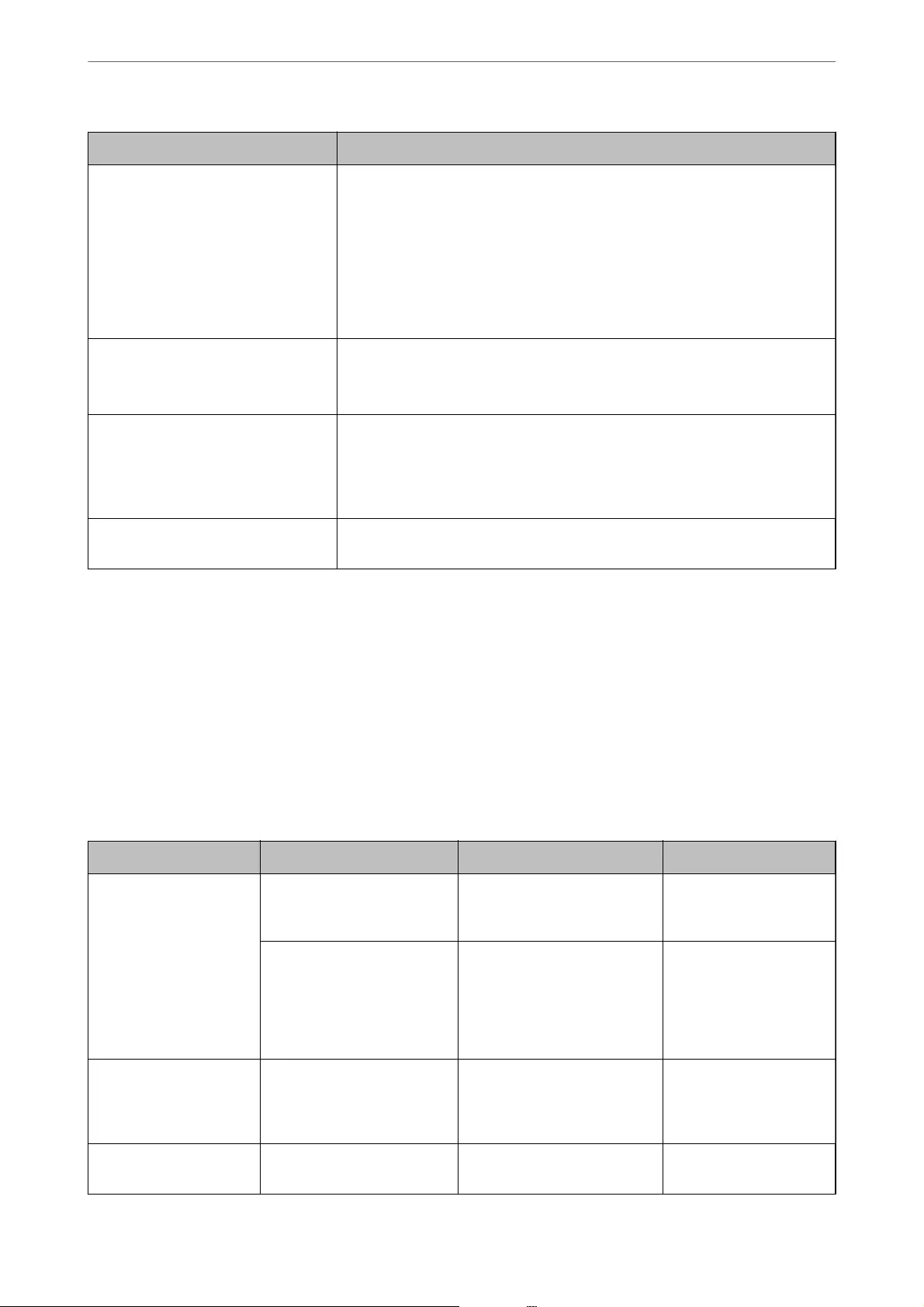
Messages Explanation
Connection test failed.
Check the settings.
This message appears for the following reasons:
❏The LDAP server address or the port number is incorrect.
❏A timeout has occurred.
❏Do Not Use is selected as the Use LDAP Server.
❏If Kerberos Authentication is selected as the Authentication Method,
settings such as Realm (Domain), KDC Address and Port Number (Kerberos)
are incorrect.
Connection test failed.
Check the date and time on your
product or server.
This message appears when the connection fails because the time settings for the
printer and the LDAP server are mismatched.
Authentication failed.
Check the settings.
This message appears for the following reasons:
❏User Name and/or Password is incorrect.
❏If Kerberos Authentication is selected as the Authentication Method, the
time/date may not be congured.
Cannot access the printer until
processing is complete.
This message appears when the printer is busy.
Preparing to Scan
Scanning using the control panel
e scan to network folder function and the scan to mail function using the printer’s control panel, as well as the
transfer of scan results to mail, folders, etc. are performed by executing a job from the computer.
Settings of Servers and Folders
Name Settings Location Requirement
Scan to Network Folder
(SMB)
Create and set up sharing of
the save folder
A computer that has a save
folder location
The administrative user
account to the computer
that creates save folders.
Destination for Scan to
Network Folder (SMB)
Contacts of the device User name and password
to log on to the
computer that has the
save folder, and the
privilege to update the
save folder.
Scan to Network Folder
(FTP)
Setup for FTP server log on Contacts of the device Logon information for
the FTP server and the
privilege to update the
save folder.
Scan to Email Setup for email server Device Setup information for
email server
Administrator Information
>
Settings to Use the Printer
>
Preparing to Scan
385
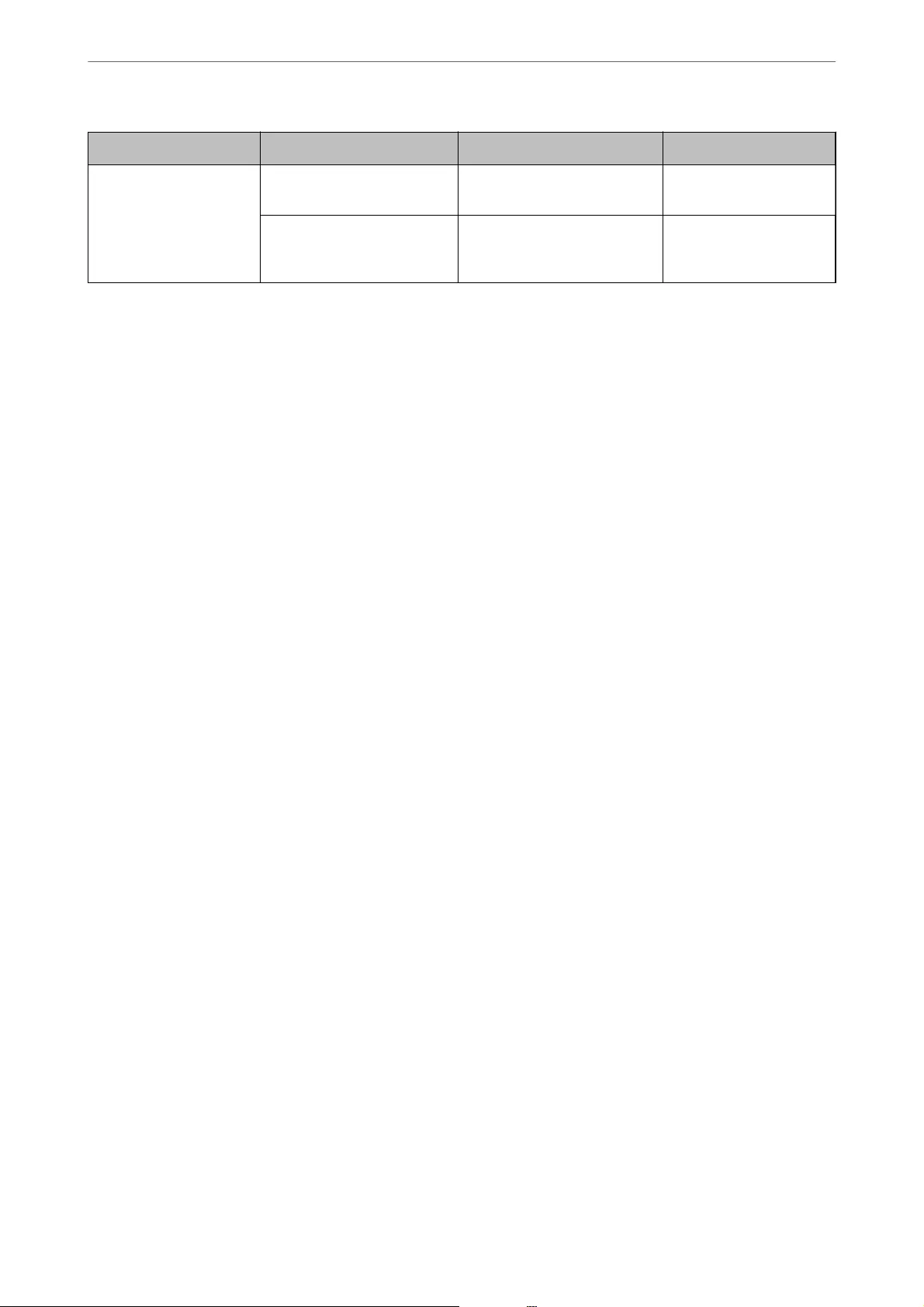
Name Settings Location Requirement
Scan to Cloud Printer registration to Epson
Connect
Device Internet connection
environment
Contact registration to Epson
Connect
Epson Connect service User and printer
registration to Epson
Connect
Related Information
&“Setting a Shared Network Folder” on page 358
&“Conguring a Mail Server” on page 354
Scanning From a Computer
Install the soware and check that the network scan service is enabled to scan via a network from the computer.
Software to be installed
❏Epson ScanSmart
❏Epson Scan 2 (application required to use the scanner feature)
Conrming that Network Scan is Enabled
You can set the network scan service when you scan from a client computer over the network. e default setting is
enabled.
1. Access Web Cong and select the Scan/Copy tab > Network Scan.
2. Make sure that Enable scanning of EPSON Scan is selected.
If it is selected, this task is completed. Close Web Cong.
If it is cleared, select it and go to next step.
3. Click Next.
4. Click OK.
e network is re-connected, and then the settings are enabled.
Related Information
&“Running Web Cong on a Web Browser” on page 301
Administrator Information
>
Settings to Use the Printer
>
Preparing to Scan
386

Making Fax Features Available
Before Using Fax Features
Set up the following to use the fax features.
❏Connect the printer correctly with the phone line and, if necessary, with a phone
❏Complete the Fax Setting Wizard, which is required to make basic settings.
Set the following as necessary.
❏Output destinations and related settings, such as network settings and mail server settings
❏Contacts registration
❏User Settings that dene default values for Fax menu items
❏Report Settings to print reports when faxes are sent, received, or forwarded
Related Information
&“Connecting the Printer to a Phone Line” on page 387
&“Making the Printer Ready to Send and Receive Faxes” on page 390
&“Making the Printer Ready to Send and Receive Faxes” on page 390
&“Fax Settings” on page 310
&“Conguring a Mail Server” on page 354
&“Setting a Shared Network Folder” on page 358
&“Making Contacts Available” on page 374
&“Report Settings” on page 320
Connecting the Printer to a Phone Line
Compatible Telephone Lines
You can use the printer over standard analogue telephone lines (PSTN = Public Switched Telephone Network) and
PBX (Private Branch Exchange) telephone systems.
You may not be able to use the printer with the following phone lines or systems.
❏VoIP phone line such as DSL or ber-optic digital service
❏Digital phone line (ISDN)
❏Some PBX telephone systems
❏When adapters such as terminal adapters, VoIP adapters, splitters, or DSL router are connected between the
telephone wall jack and the printer
Connecting the Printer to a Phone Line
Connect the printer to a telephone wall jack using an RJ-11 (6P2C) phone cable. When connecting a telephone to
the printer, use a second RJ-11 (6P2C) phone cable.
Depending on the area, a phone cable may be included with the printer. If it is included, use that cable.
Administrator Information
>
Settings to Use the Printer
>
Making Fax Features Available
387
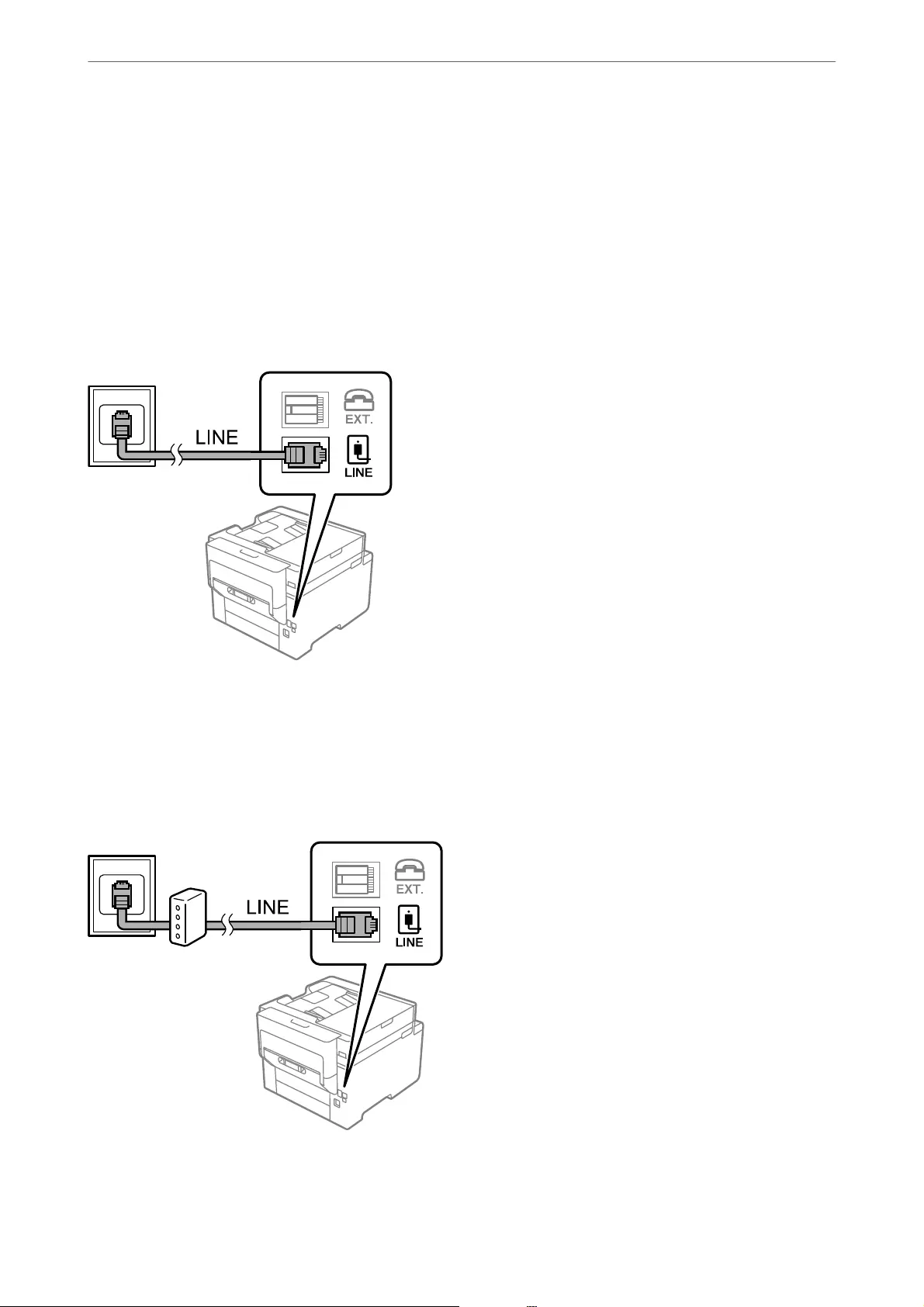
You may need to connect the phone cable to an adapter provided for your country or region.
Note:
Remove the cap from the EXT. port of the printer only when connecting your telephone to the printer. Do not remove the cap
if you are not connecting your telephone.
In areas where lightning strikes occur frequently, we recommend that you use a surge protector.
Connecting to a Standard Phone Line (PSTN) or PBX
Connect a phone cable from the telephone wall jack or PBX port to the LINE port on the back of the printer.
Connecting to DSL or ISDN
Connect a phone cable from the DSL modem or the ISDN terminal adapter to the LINE port on the back of the
printer. See the documentation provided with the modem or the adapter for more details.
Note:
If your DSL modem is not equipped with a built-in DSL lter, connect a separate DSL lter.
Administrator Information
>
Settings to Use the Printer
>
Making Fax Features Available
388
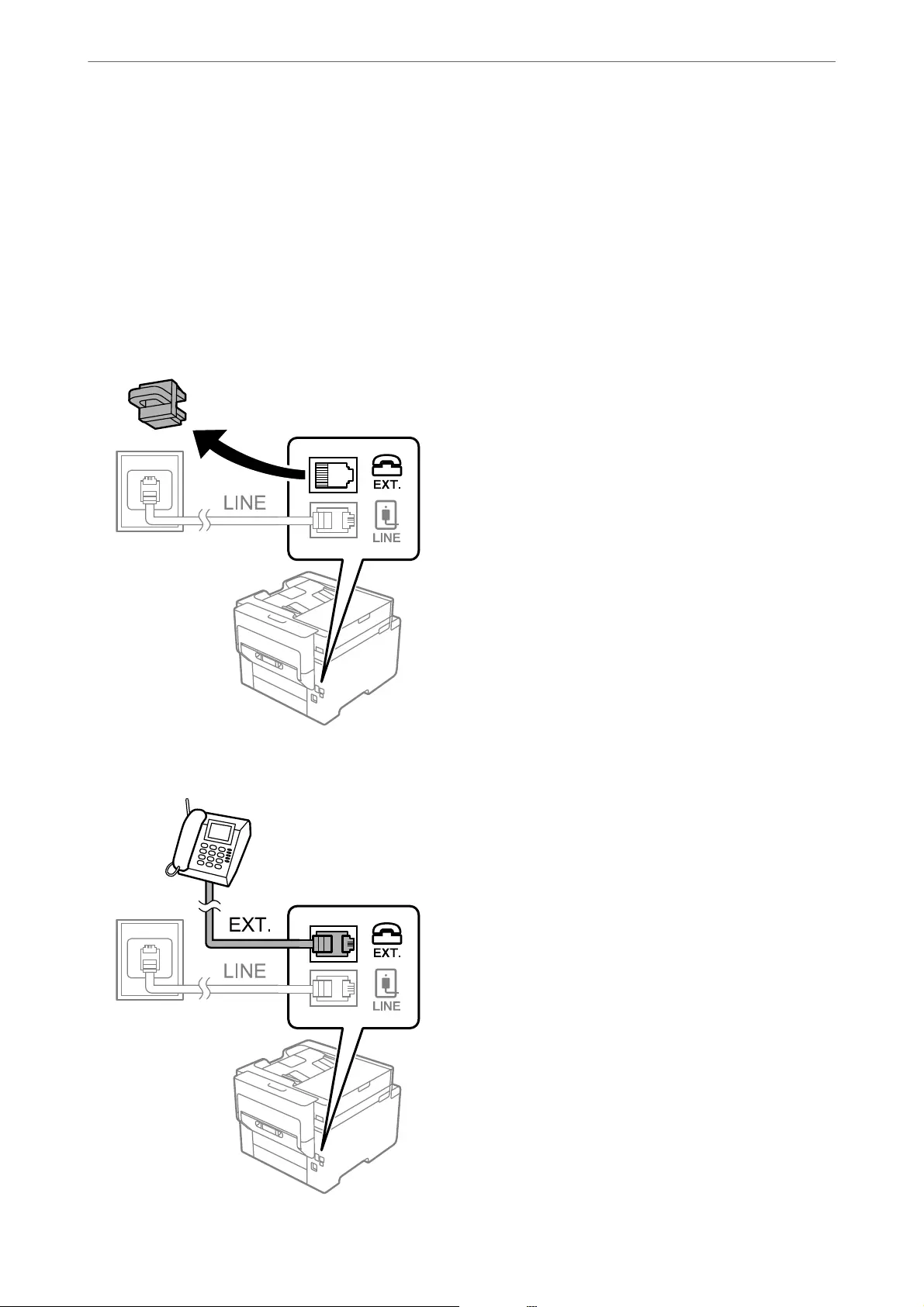
Connecting Your Phone Device to the Printer
When using the printer and your telephone on a single phone line, connect the telephone to the printer.
Note:
❏If your phone device has a fax function, disable the fax function before connecting. See the manuals that came with the
phone device for details. Depending on the model of the phone device, the fax function cannot be completely disabled, so
you may not be able to use it as an external phone.
❏If you connect an answering machine, make sure the printer's Rings to Answer setting is set higher than the number of
rings your answering machine is set to answer a call.
1. Remove the cap from the EXT. port on the back of the printer.
2. Connect the phone device and the EXT. port with a phone cable.
Administrator Information
>
Settings to Use the Printer
>
Making Fax Features Available
389
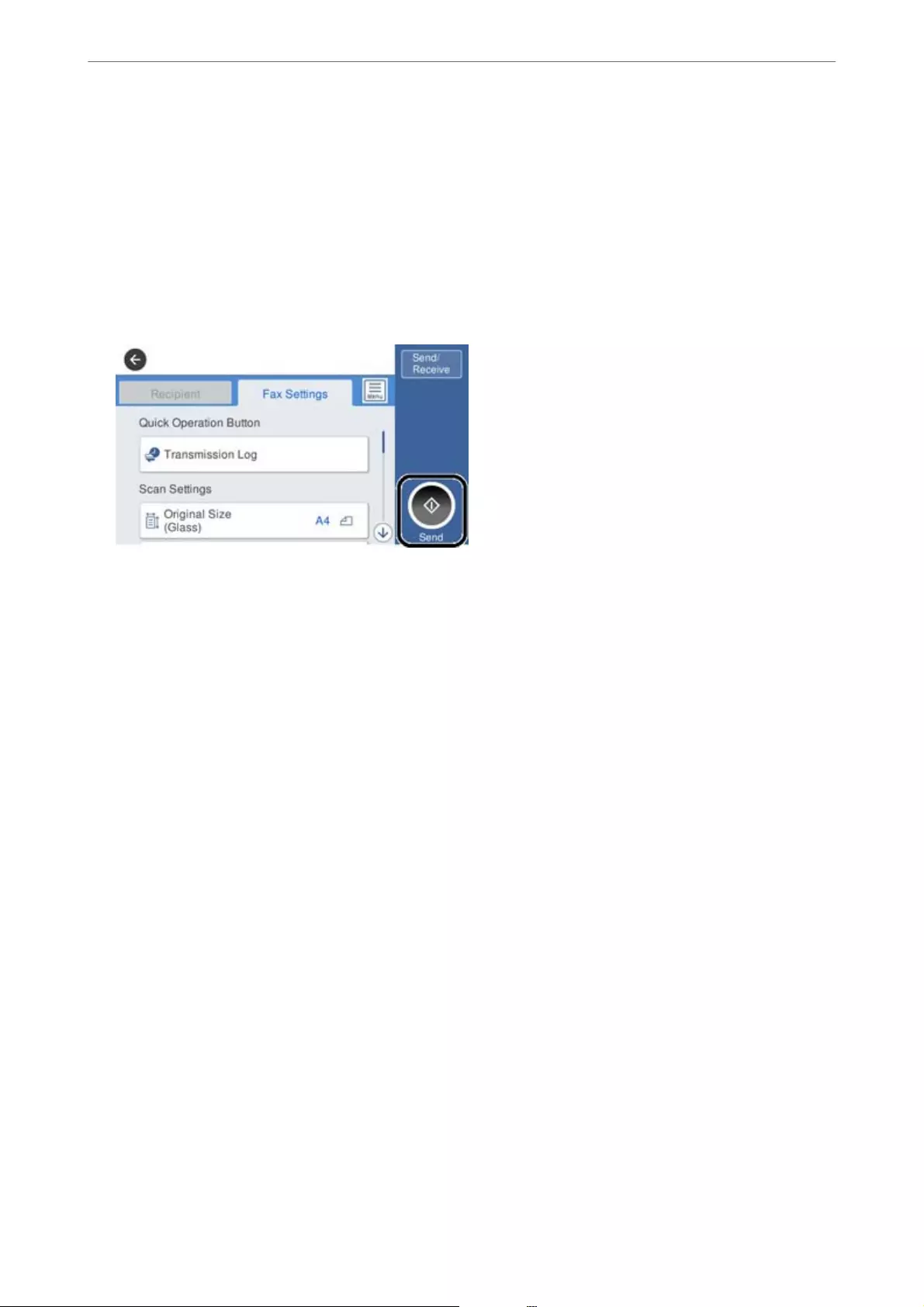
Note:
When sharing a single phone line, make sure you connect the phone device to the EXT. port of the printer. If you split
the line to connect the phone device and the printer separately, the phone and the printer do not work correctly.
3. Select Fax on the home screen.
4. Pick up the handset.
If a message to start sending or receiving faxes is displayed as shown on the following screen, the connection
has been established.
Related Information
&“Making the Printer Ready to Send and Receive Faxes” on page 390
&“Making Settings to Use an Answering Machine” on page 393
&“Making Settings to Receive Faxes Operating Only a Connected Phone” on page 393
&“Receive Mode:” on page 312
Making the Printer Ready to Send and Receive Faxes
Fax Setting Wizard congures the basic fax features to make the printer ready to send and receive faxes.
e Wizard is displayed automatically when the printer is turned on for the rst time. You can also display the
wizard manually from the printer's control panel. You need to run the wizard again in case the wizard is skipped
when the printer is rst turned on or when the connection environment has changed.
❏e items below are what you can set through the wizard.
❏Header (Your Phone Number and Fax Header)
❏Receive Mode (Auto or Manual)
❏Distinctive Ring Detection (DRD) Setting
❏e items below are set automatically according to the connection environment.
❏Dial Mode (such as Tone or Pulse)
❏Other items in Basic Settings remain as they are.
Related Information
&“Basic Settings” on page 311
Administrator Information
>
Settings to Use the Printer
>
Making Fax Features Available
390
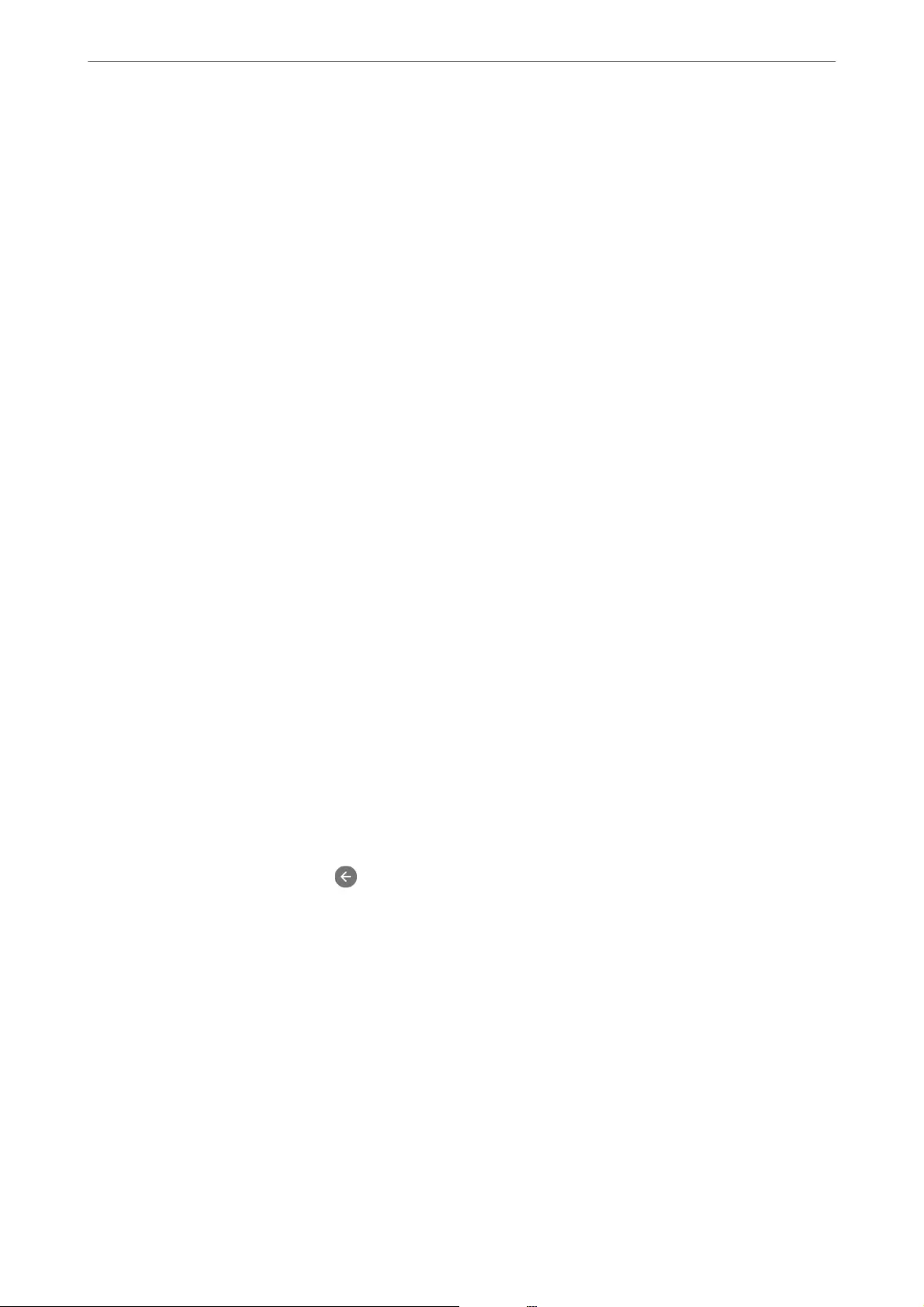
Making the Printer Ready to Send and Receive Faxes Using Fax Setting Wizard
1. Select Settings on the home screen on the printer's control panel, and then select General Settings > Fax
Settings > Fax Setting Wizard.
2. Following the on-screen instructions, enter the sender name such as your company name, your fax number.
Note:
Your sender name and your fax number appear as the header for outgoing faxes.
3. Make the distinctive ring detection (DRD) setting.
❏If you have subscribed to a distinctive ring service from your telephone company:
Go to the next screen and select the ring pattern to be used for incoming faxes.
When you tap any item except All, Receive Mode is set to Auto and you continue to the next screen where
you can check the settings you made.
❏If you have not subscribed to a distinctive ring service from your telephone company, or you do not need to
set this option:
Skip this setting and go to the screen where you can check the settings you made.
Note:
❏Distinctive ring services, oered by many telephone companies (the service name diers by company), allows you to
have several phone numbers on one phone line. Each number is assigned a dierent ring pattern. You can use one
number for voice calls and another for fax calls. Select the ring pattern assigned to fax calls in DRD.
❏Depending on the region, On and O are displayed as the DRD options. Select On to use the distinctive ring feature.
4. Make the Receive Mode setting.
❏If you do not need to connect a phone device to the printer:
Select No.
Receive Mode is set to Auto.
❏If you need to connect a phone device to the printer:
Select Yes , and then select whether or not to receive faxes automatically.
5. Check the settings you made on the screen displayed, and then proceed to the next screen.
To correct or change settings, tap .
6. Check the fax connection by selecting Start Checking, and then select Print to print a report that shows the
connection status.
Note:
❏If there are any errors reported, follow the instructions on the report to solve them.
❏If the Select Line Type screen is displayed, select the line type.
- When you are connecting the printer to a PBX phone system or terminal adapter, select PBX.
- When you are connecting the printer to a standard phone line, select PSTN, and then select Do Not Detect on the
Conrmation screen displayed. However, setting this to Do Not Detect may cause the printer to skip the rst digit of
a fax number when dialing and send the fax to the wrong number.
Related Information
&“Connecting the Printer to a Phone Line” on page 387
&“Making Settings to Use an Answering Machine” on page 393
Administrator Information
>
Settings to Use the Printer
>
Making Fax Features Available
391

&“Receive Mode:” on page 312
&“Making Settings to Receive Faxes Operating Only a Connected Phone” on page 393
&“Basic Settings” on page 311
Making Settings for the Printer's Fax Features According to Use
You can congure the printer's fax features individually using the printer's control panel according to use. e
settings made using Fax Setting Wizard can also be changed. For more details, see the descriptions of the Fax
Settings menu.
Note:
❏Using Web Cong, you can congure the printer's fax features.
❏When you use Web Cong to display the Fax Settings menu, there may be slight dierences in the user interface and in
location compared to the printer's control panel.
Related Information
&“Fax Settings” on page 310
&“Receiving Incoming Faxes” on page 119
&“Making Settings for a PBX Phone System” on page 392
&“Making Settings When You Connect a Phone Device” on page 393
&“Making Settings to Save and Forward Received Faxes” on page 394
&“Making Settings to Save and Forward Received Faxes with Specic Conditions” on page 397
&“Making Settings for Blocking Junk Faxes” on page 401
&“Making Settings to Send and Receive Faxes on a Computer” on page 401
Making Settings for a PBX Phone System
Make the following settings when using the printer in oces that use extensions and require external access codes,
such as 0 and 9, to get an outside line.
1. Select Settings on the home screen.
2. Select General Settings > Fax Settings > Basic Settings.
3. Select Line Type, and then select PBX.
4. When sending a fax to an outside fax number using # (hash) instead of the actual external access code, select
the Access Code box, and then select Use.
e # entered instead of the actual access code, is replaced with the stored access code when dialing. Using #
helps avoid connection problems when connecting to an outside line.
Note:
You cannot send faxes to recipients in Contacts in which an external access code such as 0 or 9 is set.
If you have registered recipients in Contacts using an external access code such as 0 or 9, set the Access Code to Do Not
Use. Otherwise, you must change the code to # in Contacts.
5. Tap the Access Code input box, enter the external access code used for your phone system, and then tap OK.
Administrator Information
>
Settings to Use the Printer
>
Making Fax Features Available
392

6. Select OK to apply the settings.
e access code is stored in the printer.
Making Settings When You Connect a Phone Device
Making Settings to Use an Answering Machine
You need settings to use an answering machine.
1. Select Settings on the home screen on the printer's control panel..
2. Select General Settings > Fax Settings > Basic Settings.
3. Set Receive Mode to Auto.
4. Set the Rings to Answer setting of the printer to a higher number than the number of rings for the answering
machine.
If Rings to Answer is set lower than the number of rings for the answering machine, the answering machine
cannot receive voice calls to record voice messages. See the manuals that came with the answering machine for
its settings.
e printer's Rings to Answer setting may not be displayed, depending on the region.
Related Information
&“Basic Settings” on page 311
Making Settings to Receive Faxes Operating Only a Connected Phone
You can start receiving incoming faxes by only picking up the handset and operating the phone, without operating
the printer at all.
e Remote Receive feature is available for telephones that support tone dialing.
1. Select Settings on the home screen on the printer's control panel.
2. Select General Settings > Fax Settings > Basic Settings > Remote Receive.
3. Tap Remote Receive to set this to On.
4. Select Start Code, enter a two digit code (you can enter 0 to 9, *, and #), and then tap OK.
5. Select OK to apply the settings.
Related Information
&“Basic Settings” on page 311
Administrator Information
>
Settings to Use the Printer
>
Making Fax Features Available
393
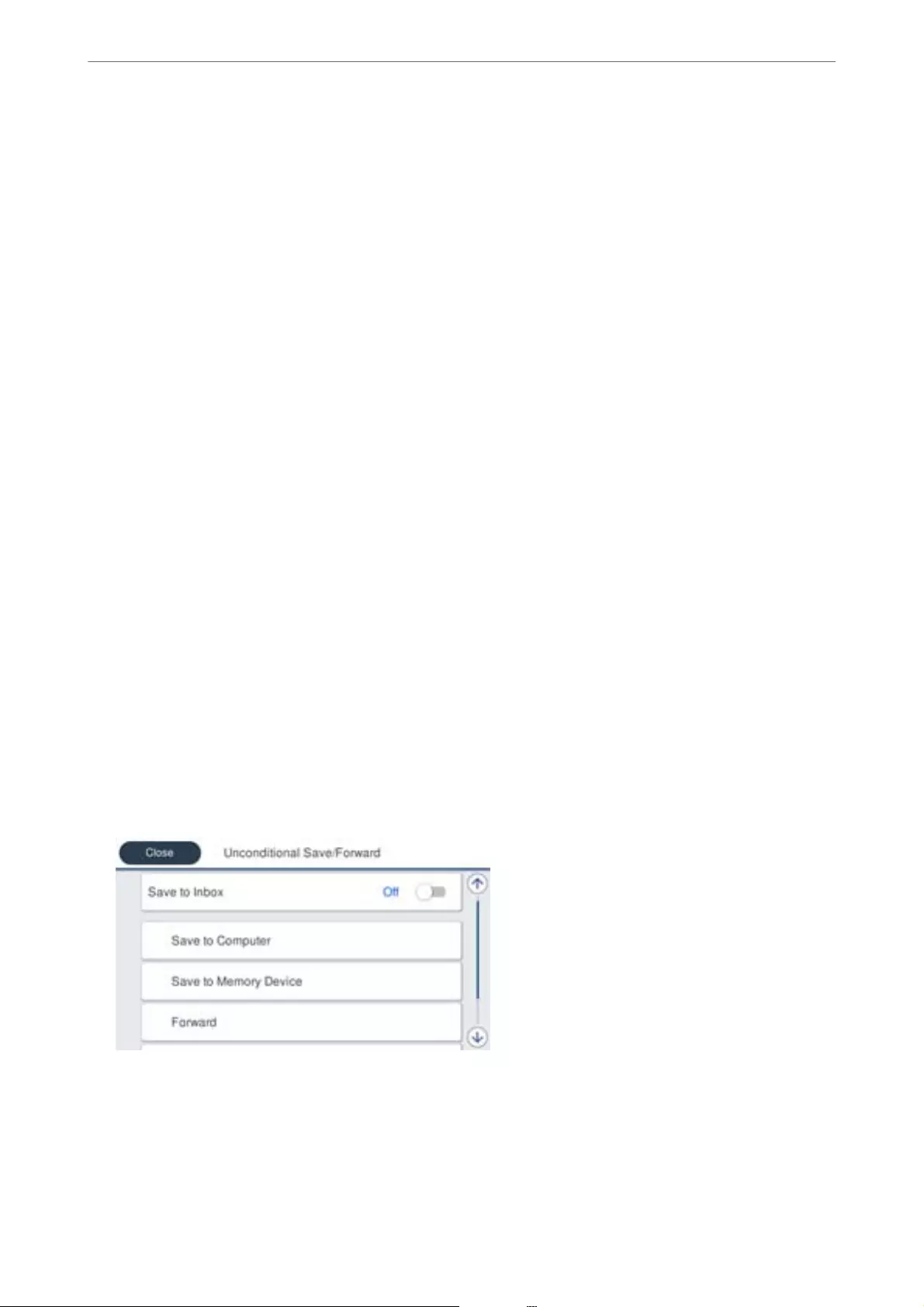
Making Settings to Save and Forward Received Faxes
e printer is set to print received faxes by default. Besides printing, you can set the printer to save and/or forward
received faxes.
Note:
As well as using the printer's control panel, you can also make settings using Web Cong.
Related Information
&“Making Saving Settings to Receive Faxes” on page 394
&“Making Forwarding Settings to Receive Faxes” on page 395
Making Saving Settings to Receive Faxes
You can make saving settings to receive faxes to the inbox and an external memory device regardless of the sender
or time. Saving a fax to the inbox allows you to conrm the contents of the received fax by viewing the fax on the
printer's LCD screen before the printer prints the fax.
To make settings to save received faxes to a computer using the PC-FAX feature, see “ Feature: PC-FAX Send/
Receive (Windows/Mac OS)” on page 109.
Note:
❏As well as using the printer's control panel, you can use Web Cong to make saving settings to receive faxes. Select the
Fax tab > Save/Forward Settings > Unconditional Save/Forward, and then make the saving destination settings in
Fax Output.
❏You can also print and/or forward the received faxes at the same time. Make the settings on the Fax Output screen
mentioned above.
1. Select Settings on the printer's control panel, and then select General Settings > Fax Settings.
2. Select Receive Settings > Save/Forward Settings > Unconditional Save/Forward.
When a message is displayed, check the content, and then tap OK.
3. Make settings for the saving destinations, the inbox and/or an external memory device.
❏To save received faxes to the Inbox:
A
Select Save to Inbox to set this to On.
B
If a message is displayed, check the content, and then select OK.
Administrator Information
>
Settings to Use the Printer
>
Making Fax Features Available
394
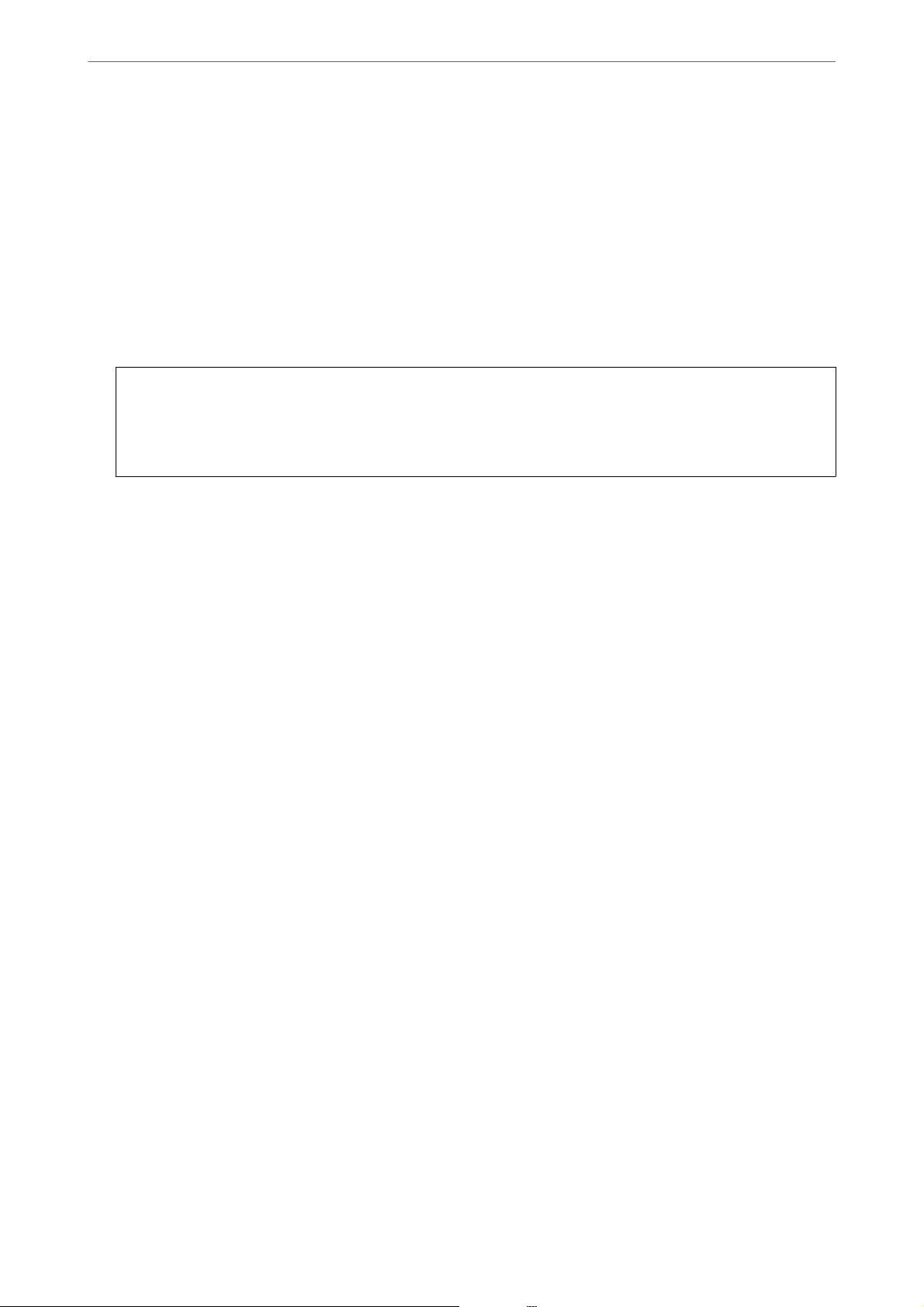
❏To save received faxes to an external memory device:
A
Insert a memory device into the printer's external interface USB port.
B
Select Save to Memory Device.
C
Select Yes . To print the documents automatically while saving them in the memory device, select Yes
and Print instead.
D
Check the message that is displayed, and then tap Create.
A folder for saving received documents is created in the memory device.
E
Check the message, tap Close or wait until the message is cleared, and then tap Close.
F
When the next message is displayed, check it, and then tap OK.
c
Important:
Received documents are saved in the printer's memory temporarily before the documents are saved in the
memory device connected to the printer. Because a memory full error disables sending and receiving faxes, keep
the memory device connected to the printer.
Note:
You can set the printer to send emails to people you want to notify about the results of saving faxes, when saving is
complete. As necessary, select Email Notications, set the processes, and then set the destination to which you want to
send notications.
4. Select Close to complete the Unconditional Save/Forward Settings.
is completes making unconditional saving settings to receive faxes. You can set Common Settings as necessary.
For details, see the explanation for Common Settings in the Save/Forward Settings menu.
Related Information
&“Save/Forward Settings” on page 314
&“Viewing Received Faxes Saved in the Printer on the LCD Screen” on page 123
&“Making Saving Settings to Receive Faxes with Specic Conditions” on page 397
Making Forwarding Settings to Receive Faxes
You can make forwarding settings to up to ve destinations, email addresses, shared folders, and/or another fax
machine regardless of the sender or time. If you make settings to forward received faxes, rst add the forwarding
destinations to the contacts list. To forward to an email address, you also need to congure the email server
settings beforehand.
“Conguring a Mail Server” on page 354
“Setting a Shared Network Folder” on page 358
“Making Contacts Available” on page 374
Color documents cannot be forwarded to another fax machine. ey are processed as documents that failed to be
forwarded.
Note:
❏As well as using the printer's control panel, you can use Web Cong to make forwarding settings to receive faxes. Select
the Fax tab > Save/Forward Settings > Unconditional Save/Forward, and then make the forwarding destination
settings in Fax Output.
❏You can also print and/or save received faxes at the same time. Make the settings on the Fax Output screen mentioned
above.
Administrator Information
>
Settings to Use the Printer
>
Making Fax Features Available
395
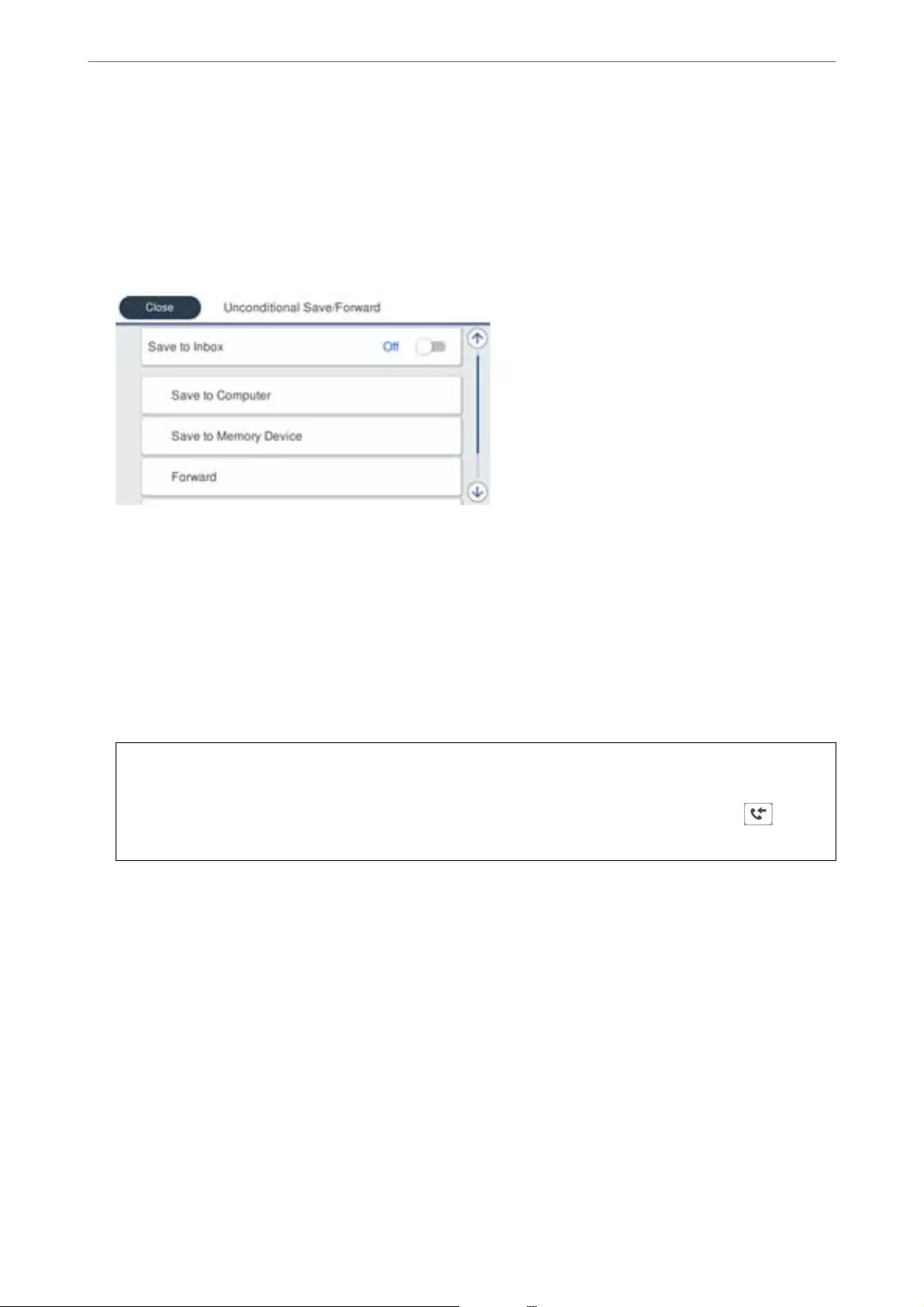
1. Select Settings on the printer's control panel, then select General Settings > Fax Settings.
2. Select Receive Settings > Save/Forward Settings > Unconditional Save/Forward.
When a message is displayed, check the content, and then tap OK.
3. Make settings for up to ve forwarding destinations.
A
Select Forward.
B
Select Yes. To print the documents automatically while forwarding them, select Yes and Print instead.
C
Destination > Add Entry, and then select forwarding destinations from the contacts list. You can specify up
to ve forwarding destinations.
D
Tap Close to nish selecting forwarding destinations, and then tap Close.
E
In Options When Forwarding Failed, select whether to print received documents or save them in the
printer's Inbox when forwarding fails.
F
Tap OK.
c
Important:
When the Inbox is full, receiving faxes is disabled. You should delete the documents from the inbox once they
have been checked. e number of documents that have failed to be forwarded is displayed on the on the
home screen, in addition to other unprocessed jobs.
Note:
You can set the printer to send emails to people you want to notify about the results of forwarding faxes when the
forwarding process is complete. As necessary, select Email Notications, set the processes, and then select the
destination to which you want to send notications from the contacts list.
4. Select Close to complete the Unconditional Save/Forward Settings.
Note:
❏is completes making unconditional forwarding settings to receive faxes. You can set Common Settings as necessary.
For details, see the explanation for Common Settings in the Save/Forward Settings menu.
❏If you have selected a shared folder on a network or an email address as the forwarding destination, we recommend that
you test if you can send a scanned image to the destination in the scan mode. Select Scan > Email, or Scan > Network
Folder/FTP from the home screen, select the destination, and then start scanning.
Related Information
&“Save/Forward Settings” on page 314
Administrator Information
>
Settings to Use the Printer
>
Making Fax Features Available
396
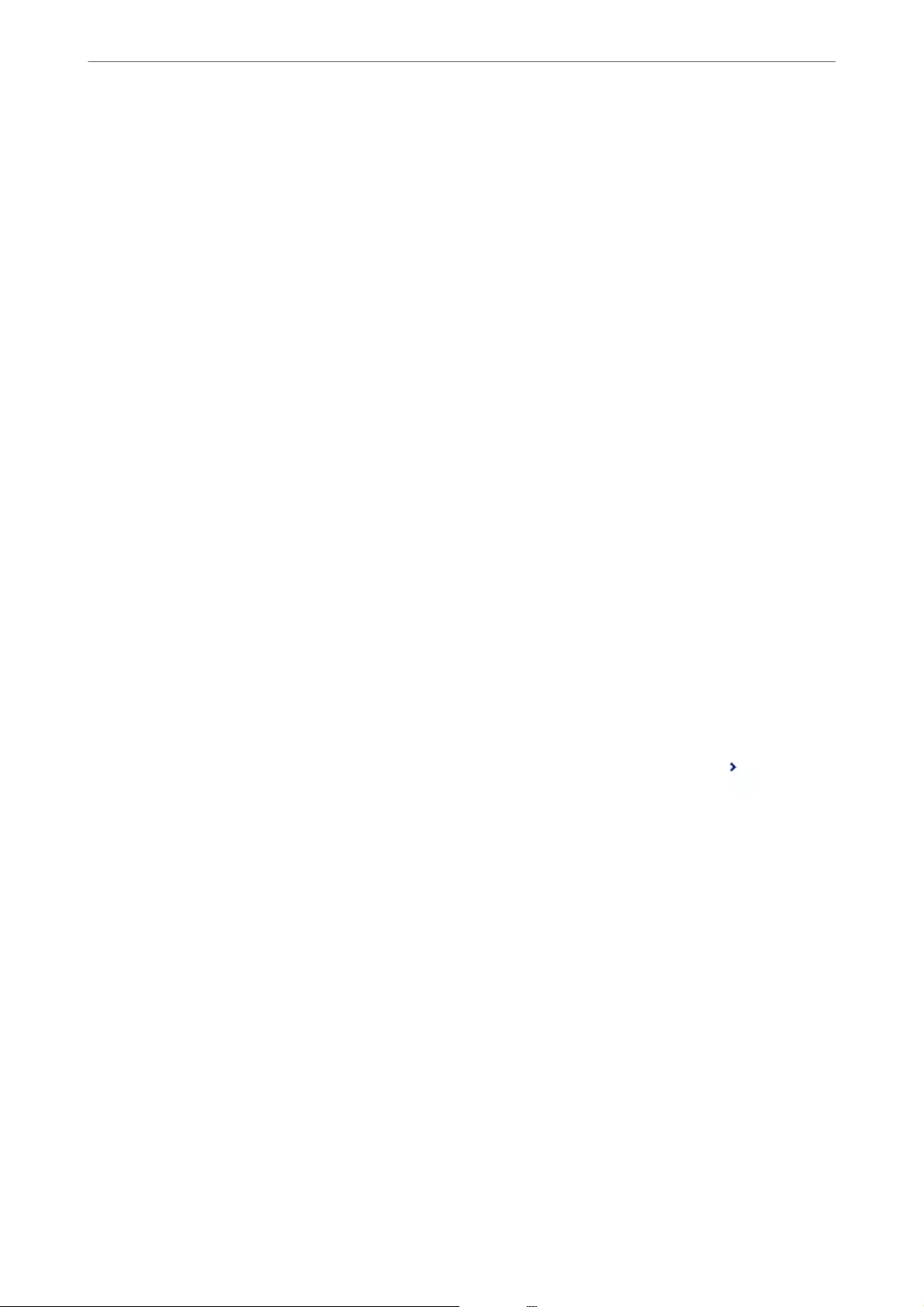
Making Settings to Save and Forward Received Faxes with Specic Conditions
You can save and/or forward received faxes under set conditions.
Note:
❏e printer is set to print received faxes by default.
❏You can also receive and save faxes without any conditions.
“Making Settings to Save and Forward Received Faxes” on page 394
Related Information
&“Making Saving Settings to Receive Faxes with Specic Conditions” on page 397
&“Making Forwarding Settings to Receive Faxes with Specied Conditions” on page 399
Making Saving Settings to Receive Faxes with Specic Conditions
You can make settings to save received faxes to the inbox and an external memory device from a specied sender
or at a specied time. Saving a fax in a condential box or the inbox allows you to conrm the contents of the
received fax by viewing the fax on the printer's LCD screen before the printer prints the fax.
Before you use the feature to save received faxes at a specied time, make sure the printer's Date/Time and Time
Dierence settings are correct. Access the menu from Settings > General Settings > Basic Settings > Date/Time
Settings.
Note:
❏As well as using the printer's control panel, you can use Web Cong to make saving settings to receive faxes. Select the
Fax tab > Save/Forward Settings > Conditional Save/Forward, select the number of the condential box, and then
select Edit and make the saving destination settings.
❏You can also print and/or forward received faxes at the same time. Make the settings on the Edit screen mentioned above.
1. Select Settings on the printer's control panel, and then select General Settings > Fax Settings.
2. Select Receive Settings > Save/Forward Settings > Conditional Save/Forward, and then tap on an
unregistered box under Conditional Save/Forward.
3. Select the Name box and enter the name you want to register.
4. Select the Condition(s) box to make a condition setting.
❏Sender Fax Number match: If the incoming fax number matches the conditions you selected in this item,
the printer saves and forwards the received faxes.
Select the Sender Fax Number match condition and enter the fax number (max. 20 digits) by selecting the
Fax Number box.
❏Subaddress(SUB) perfect match: If the subaddress (SUB) is a perfect match, the printer saves and forwards
the received faxes.
Enable the Subaddress(SUB) perfect match setting and enter the password by selecting the
Subaddress(SUB) box.
❏Password(SID) perfect match: If the password (SID) is perfectly matched, the printer saves and forwards
the received faxes.
Enable the Password(SID) perfect match setting and input the password by selecting the Password(SID)
box.
Administrator Information
>
Settings to Use the Printer
>
Making Fax Features Available
397
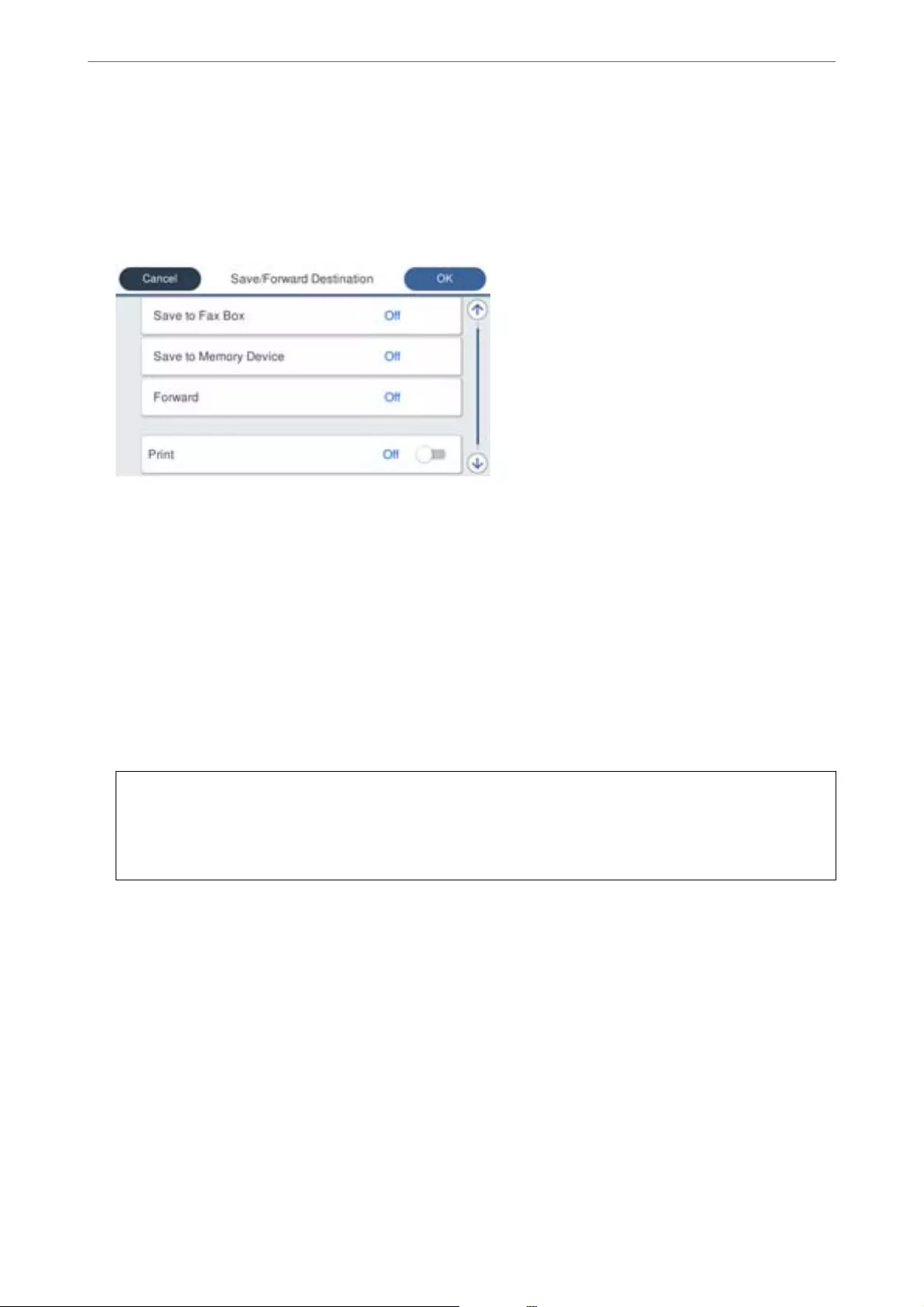
❏Receiving Time: e printer saves and forwards received faxes during the specied time period.
Enable the Receiving Time setting and then set the time in Start Time and End Time.
5. Select Save/Forward Destination and then make settings for the target destination, box, and/or an external
memory device.
❏To save the received faxes to the Inbox or a condential box:
A
Select Save to Fax Box.
B
Tap Save to Fax Box to set this to On.
C
Select the box in which to save the document.
❏To save received faxes to an external memory device:
A
Insert a memory device into the printer's external interface USB port.
B
Select Save to Memory Device.
C
Tap Save to Memory Device to set this to On.
D
Check the message that is displayed, and then tap Create.
A folder for saving received documents is created in the memory device.
c
Important:
Received documents are saved in the printer's memory temporarily before the documents are saved in the
memory device connected to the printer. Because a memory full error disables sending and receiving faxes, keep
the memory device connected to the printer.
Note:
To print received faxes at the same time, tap Print to set this to On.
6. Select Close to complete the Save/Forward Destination Settings.
Note:
You can set the printer to send emails to people you want to notify about the results of saving faxes, when saving is
complete. As necessary, select Email Notications, set the processes, and then select the destination to which you want
to send notications from the contacts list.
7. Select OK until you return to the Save/Forward Settings screen to complete Conditional Save/Forward.
8. Select the registered box for which you made a condition setting, and then select Enable.
is completes making conditional saving settings to receive faxes. You can set Common Settings as necessary.
For details, see the explanation for Common Settings in the Save/Forward Settings menu.
Administrator Information
>
Settings to Use the Printer
>
Making Fax Features Available
398
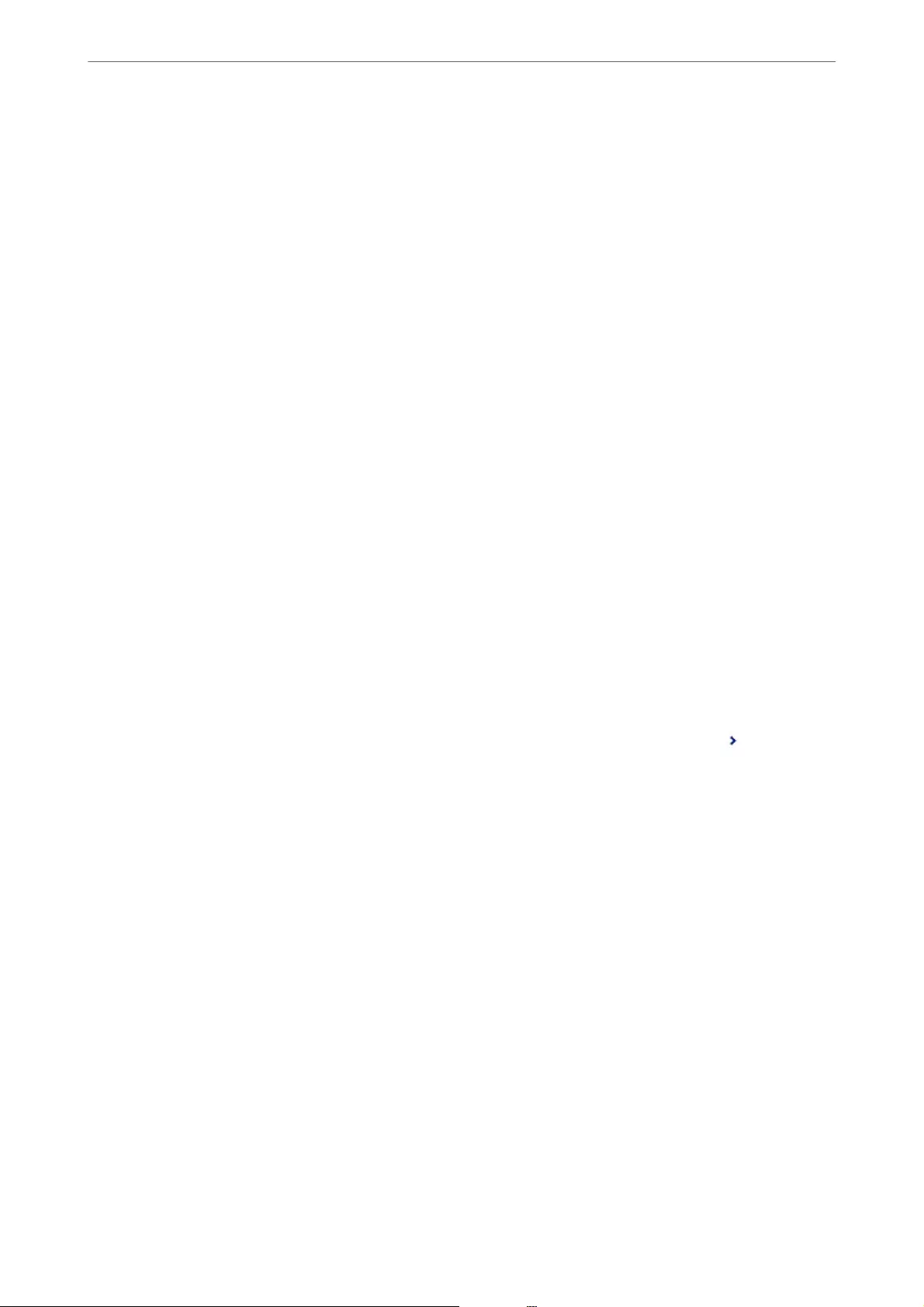
Related Information
&“Save/Forward Settings” on page 314
&“Viewing Received Faxes Saved in the Printer on the LCD Screen” on page 123
Making Forwarding Settings to Receive Faxes with Specied Conditions
You can make forwarding settings to a destination, an email address, shared folders or another fax machine from a
specied sender or at a specied time. If you make settings to forward received faxes, rst add the forwarding
destination to the contacts list. To forward to an email address, you also need to congure the email server settings
beforehand.
“Conguring a Mail Server” on page 354
“Setting a Shared Network Folder” on page 358
“Making Contacts Available” on page 374
Before you use the feature to forward received faxes at a specied time, make sure the printer's Date/Time and
Time Dierence settings are correct. Access the menu from Settings > General Settings > Basic Settings > Date/
Time Settings.
Color documents cannot be forwarded to another fax machine. ey are processed as documents that failed to be
forwarded.
Note:
❏As well as using the printer's control panel, you can use Web Cong to make forwarding settings to receive faxes. Select
the Fax tab > Save/Forward Settings > Conditional Save/Forward, select the number of the condential box, and then
select Edit and make the forwarding destination settings.
❏You can also print and/or save received faxes at the same time. Make the settings on the Edit screen mentioned above.
1. Select Settings on the printer's control panel, and then select General Settings > Fax Settings.
2. Select Receive Settings > Save/Forward Settings > Conditional Save/Forward, and then tap on an
unregistered box under Conditional Save/Forward.
3. Select the Name box and enter the name you want to register.
4. Select the Condition(s) box to make a condition setting.
❏Sender Fax Number match: If the incoming fax number matches the conditions you selected in this item,
the printer saves and forwards the received faxes.
Select the Sender Fax Number match condition and enter the fax number (max. 20 digits) by selecting the
Fax Number box.
❏Subaddress(SUB) perfect match: If the subaddress (SUB) is a perfect match, the printer saves and forwards
the received faxes.
Enable the Subaddress(SUB) perfect match setting and enter the password by selecting the
Subaddress(SUB) box.
❏Password(SID) perfect match: If the password (SID) is perfectly matched, the printer saves and forwards
the received faxes.
Enable the Password(SID) perfect match setting and input the password by selecting the Password(SID)
box.
❏Receiving Time: e printer saves and forwards received faxes during the specied time period.
Enable the Receiving Time setting and then set the time in Start Time and End Time.
Administrator Information
>
Settings to Use the Printer
>
Making Fax Features Available
399
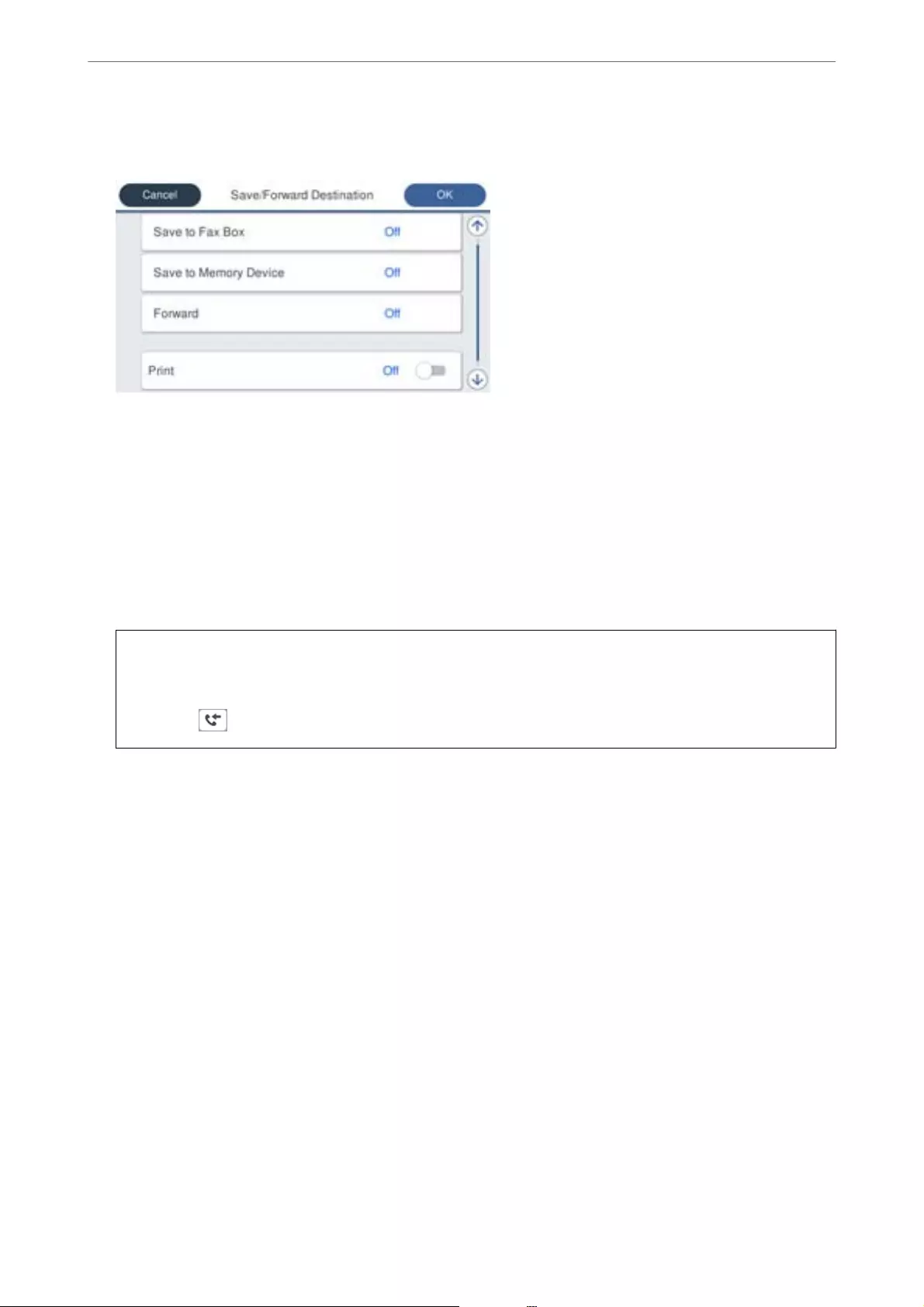
5. Select Save/Forward Destination, and then make settings for a forwarding destination.
A
Select Forward.
B
Select Yes. To print the documents automatically while forwarding them, select Yes and Print instead.
C
Select Destination > Add Entry, and then select forwarding destinations from the contacts list. You can
specify a forwarding destination.
D
When you have nished selecting forwarding destinations, tap Close.
E
Check that the forwarding destination you selected is correct, and then select Close.
F
In Options When Forwarding Failed, select whether to print received documents or save them in the
printer's Inbox when forwarding fails.
c
Important:
When the Inbox or a condential box is full, receiving faxes is disabled. You should delete the documents from
the inbox once they have been checked. e number of documents that have failed to be forwarded is displayed
on the on the home screen, in addition to other unprocessed jobs.
6. Select Close to complete the Save/Forward Destination Settings.
Note:
You can set the printer to send emails to people you want to notify about the results of forwarding faxes when the
forwarding process is complete. As necessary, select Email Notications, set the processes, and then select the
destination to which you want to send notications from the contacts list.
7. Select OK until you return to the Save/Forward Settings screen to complete Conditional Save/Forward.
8. Select the registered box for which you made a condition setting, and then select Enable.
is is completes making conditional saving settings to receive faxes. You can set Common Settings as necessary.
For details, see the explanation for Common Settings in the Save/Forward Settings menu.
Note:
❏is completes making conditional forwarding settings to receive faxes. You can set Common Settings as necessary. For
details, see the explanation for Common Settings in the Save/Forward Settings menu.
❏If you have selected a shared folder on a network or an email address as the forwarding destination, we recommend that
you test if you can send a scanned image to the destination in the scan mode. Select Scan > Email, or Scan > Network
Folder/FTP from the home screen, select the destination, and then start scanning.
Related Information
&“Save/Forward Settings” on page 314
Administrator Information
>
Settings to Use the Printer
>
Making Fax Features Available
400
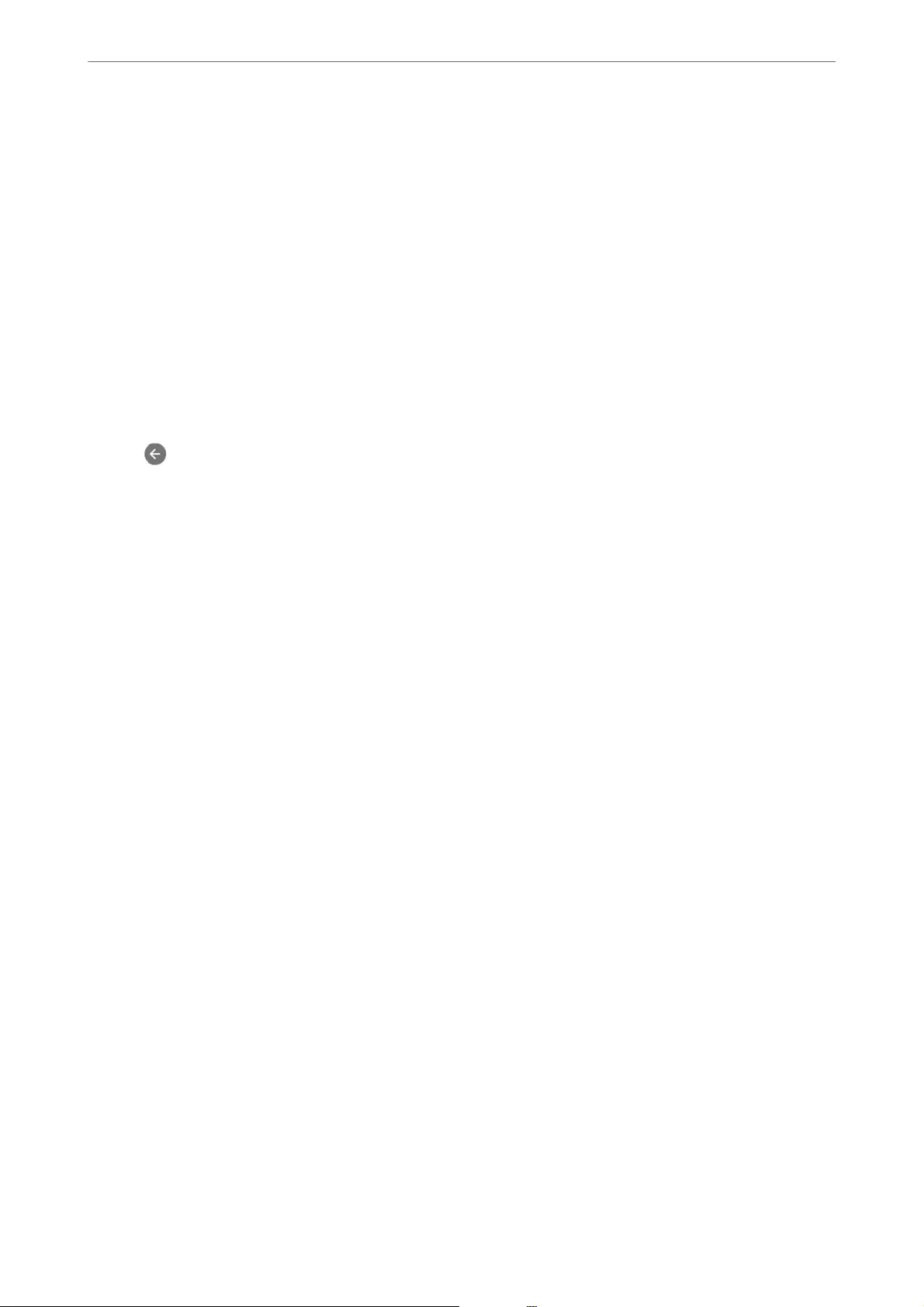
Making Settings for Blocking Junk Faxes
You can block junk faxes.
1. Select Settings on the home screen on the printer's control panel.
2. Select General Settings > Fax Settings > Basic Settings > Rejection Fax.
3. Set the condition to block junk faxes.
Select Rejection Fax, and then enable the following options.
❏Rejection Number List: Rejects faxes that are in the Rejection Number List.
❏Fax Header Blank: Rejects faxes that have blank header information.
❏Unregistered Contacts: Rejects faxes that have not been added to the contact list.
4. Tap to return to the Rejection Fax screen.
5. If you are using the Rejection Number List, select Edit Blocked Number list, and then edit the list.
Making Settings to Send and Receive Faxes on a Computer
To send and receive faxes on a client computer, FAX Utility must be installed on the computer connected by
network or USB cable.
Enabling Sending Faxes from a Computer
Set up the following using Web Cong.
1. Access Web Cong, click the Fax tab, and then click Send Settings.
2. Select Use for the PC to FAX Function.
e default setting value of the PC to FAX Function is Use. To disable sending faxes from any
computer, select Do Not Use.
3. Click OK.
Making Save to Computer Setting to Receive Faxes
You can receive faxes on a computer by using the FAX Utility. Install FAX Utility on the client
computer and make the setting. For details, see Basic Operations in the FAX Utility help (displayed
on the main window).
e setting item below on the printer's control panel is set to Yes, and the faxes received can be saved
on the computer.
Settings > General Settings > Fax Settings > Receive Settings > Save/Forward Settings >
Unconditional Save/Forward > Save to Computer
Making Save to Computer Setting to Also Print on the Printer to Receive Faxes
You can make the setting to print received faxes on the printer as well as save them on a computer.
1. Select Settings on the home screen on the printer's control panel.
Administrator Information
>
Settings to Use the Printer
>
Making Fax Features Available
401

2. Select General Settings > Fax Settings > Receive Settings.
3. Select Save/Forward Settings > Unconditional Save/Forward > Save to Computer > Yes an d
Print.
Making Save to Computer Setting not to Receive Faxes
To set the printer not to save received faxes on the computer, change the settings on the printer.
Note:
You can also change the settings using the FAX Utility. However, if there are any faxes that have been unsaved
to the computer, the feature does not work.
1. Select Settings on the home screen on the printer's control panel.
2. Select General Settings > Fax Settings > Receive Settings.
3. Select Save/Forward Settings > Unconditional Save/Forward > Save to Computer > No.
Making Basic Operation Settings for the Printer
Setting the Control Panel
Setup for the printer's control panel. You can set up as follows.
1. Access Web Cong and select the Device Management tab > Control Panel.
2. Set up the following items as necessary.
❏Language
Select the displayed language on the control panel.
❏Panel Lock
If you select ON, you cannot select items that require the administrator's authority. To select them, log in to
the printer as the administrator. If the administrator password is not set, the panel lock is disabled.
❏Operation Timeout
If you select ON, when you log in as the access control user or administrator, you are automatically logged
out and go to the initial screen if there is no activity for a certain period of time.
You can set between 10 seconds and 240 minutes by the second.
Note:
You can also set up from the printer’s control panel.
❏Language : Settings > General Settings > Basic Settings > Language
❏Panel Lock : Settings > General Settings > System Administration > Security Settings > Admin Settings > Lock
Setting
❏Operation Time Out : Settings > General Settings > Basic Settings > Operation Time Out (You can specify On or
O.)
3. Click OK.
Administrator Information
>
Settings to Use the Printer
>
Making Basic Operation Settings for the Printer
402

Power Saving Settings During Inactivity
You can set up the time to shi to the power saving mode or to turn the power o when the printer’s control panel
is not operated for a certain period of time. Set the time depending on your usage environment.
1. Access Web Cong and select the Device Management tab > Power Saving.
2. Enter the time for the Sleep Timer to switch to power saving mode when inactivity occurs.
Note:
You can also set up from the printer’s control panel.
Settings > General Settings > Basic Settings > Sleep Timer
3. Select the turning o time for the Power O Timer or Power O If Inactive depending on the location of
purchase. If you use the fax function, set to None or O depending on the location of purchase.
Note:
You can also set up from the printer’s control panel.
Settings > General Settings > Basic Settings > Power O Timer or Power O Settings
4. Click OK.
Setting the Sound
Make the sound settings when operating the control panel, printing, faxing and so on.
Note:
You can also set up from the printer’s control panel.
Settings > General Settings > Basic Settings > Sounds
1. Access Web Cong and select the Device Management tab > Sound.
2. Set up the following items as necessary.
❏Normal Mode
Set the sound when the printer is set to Normal Mode.
❏Quiet Mode
Set the sound when the printer is set to Quiet Mode.
is is enabled when the one of the following items is enabled.
❏Printer's control panel:
Settings > General Settings > Printer Settings > Quiet Mode
Settings > General Settings > Fax Settings > Receive Settings > Print Settings > Quiet Mode
❏Web Cong :
Fax tab > Print Settings > Quiet Mode
3. Click OK.
Administrator Information
>
Settings to Use the Printer
>
Making Basic Operation Settings for the Printer
403

Synchronizing the Date and Time with Time Server
When synchronizing with the time server (NTP server), you can synchronize the time of the printer and the
computer on the network. e time server may be operated within the organization or published on the Internet.
When using the CA certicate or Kerberos authentication, time-related trouble can be prevented by synchronizing
with the time server.
1. Access Web Cong and select the Device Management tab > Date and Time > Time Server.
2. Select Use for Use Time Server.
3. Enter the time server address for Time Server Address.
You can use IPv4, IPv6 or FQDN format. Enter 252 characters or less. If you do not specify this, leave it blank.
4. Enter Update Interval (min).
You can set up to 10,800 minutes by the minute.
5. Click OK.
Note:
You can conrm the connection status with the time server on Time Server Status.
Setting the Default Value for Scanning,Copying and Sending Faxes. (User
Default Settings)
You can set the default value for the functions.
You can set the following functions.
❏Scan to Network Folder/FTP
❏Scan to Email
❏Scan to Memory Device
❏Scan to Cloud
❏Copy
❏Fax
1. Access Web Cong and select the functions for which you want to set the default value for the Scan/Copy tab
> User Default Settings.
Select the Fax tab > User Default Settings to set the default value for fax.
2. Set each item.
3. Click OK.
If the combination of the value is invalid, it is automatically modied, and then a valid value is set.
Administrator Information
>
Settings to Use the Printer
>
Making Basic Operation Settings for the Printer
404

Problems when Making Settings
Hints to Solving Problems
❏Checking the error message
When trouble has occurred, rst check whether there are any messages on the printer's control panel or driver
screen. If you have the notication email set when the events occur, you can promptly learn the status.
❏Network connection report
Diagnose the network and the printer status, and then print the result.
You can nd the diagnosed error from the printer side.
❏Checking the communication status
Check the communication status of server computer or client computer by using the command such as ping
and ipcong.
❏Connection test
For checking the connection between the printer to the mail server, perform the connection test from the
printer. Also, check the connection from the client computer to the server to check the communication status.
❏Initializing the settings
If the settings and communication status show no problem, the problems may be solved by disabling or
initializing the network settings of the printer, and then setting up again.
Cannot Access Web Cong
The IP address is not assigned to the printer.
A valid IP address may not be assigned to the printer. Congure the IP address using the printer’s
control panel. You can conrm the current setting information with a network status sheet or from
the printer’s control panel.
Web browser does not support the Encryption Strength for SSL/TLS.
SSL/TLS has the Encryption Strength. You can open Web Cong by using a web browser that
supports bulk encryptions as indicated below. Check you are using the a supported browser.
❏80bit: AES256/AES128/3DES
❏112bit: AES256/AES128/3DES
❏128bit: AES256/AES128
❏192bit: AES256
❏256bit: AES256
CA-signed Certicate is expired.
If there is a problem with the expiration date of the certicate, "e certicate has expired" is
displayed when connecting to Web Cong with SSL/TLS communication (https). If the message
appears before its expiration date, make sure that the printer's date is congured correctly.
Administrator Information
>
Settings to Use the Printer
>
Problems when Making Settings
405
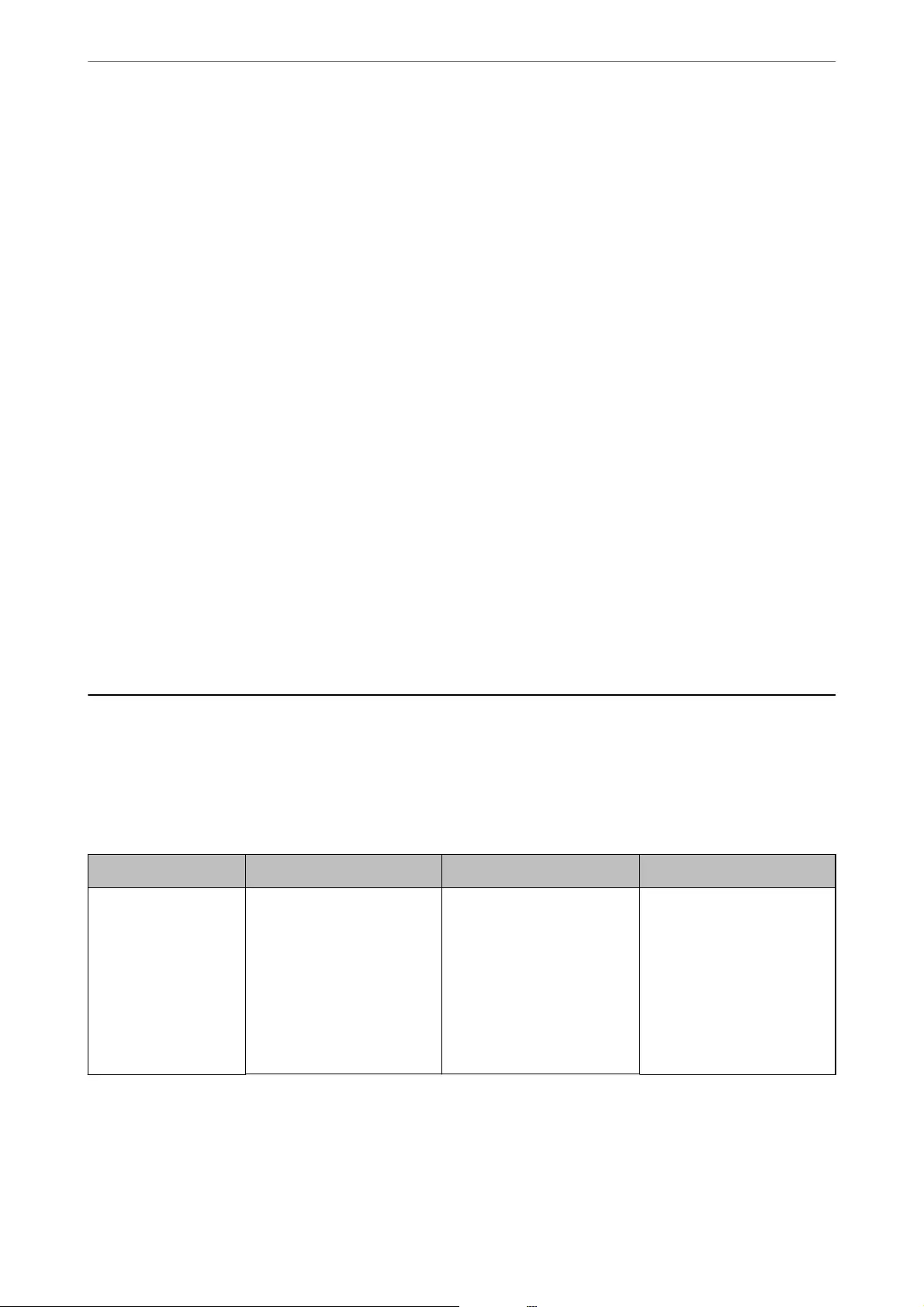
The common name of the certicate and the printer do not match.
If the common name of the certicate and the printer do not match, the message "e name of the
security certicate does not match···" is displayed when accessing Web Cong using SSL/TLS
communication (https). is happens because the following IP addresses do not match.
❏e printer's IP address entered to common name for creating a Self-signed Certicate or CSR
❏IP address entered to web browser when running Web Cong
For Self-signed Certicate, update the certicate.
For CA-signed Certicate, take the certicate again for the printer.
The proxy server setting of local address is not set to web browser.
When the printer is set to use a proxy server, congure the web browser not to connect to the local
address via the proxy server.
❏Windows:
Select Control Panel > Network and Internet > Internet Options > Connections > LAN settings
> Proxy server, and then congure not to use the proxy server for LAN (local addresses).
❏Mac OS:
Select System Preferences > Network > Advanced > Proxies, and then register the local address
for Bypass proxy settings for these Hosts & Domains.
Example:
192.168.1.*: Local address 192.168.1.XXX, subnet mask 255.255.255.0
192.168.*.*: Local address 192.168.XXX.XXX, subnet mask 255.255.0.0
Managing the Printer
Introduction of Product Security Features
is section introduces the security function of the Epson Devices.
Feature name Feature type What to set What to prevent
Setup for the
administrator
password
Locks the system settings,
such as connection setup for
network or USB, detail setup
for fax reception/transmission
or transferring, and the user
default settings.
An administrator sets a
password to the device.
You can set or change from
both Web Cong and the
printer's control panel.
Prevent from illegally reading
and changing the
information stored in the
device such as ID, password,
network settings, and
contacts. Also, reduce a wide
range of security risks such as
leakage of information for the
network environment or
security policy.
Administrator Information
>
Managing the Printer
>
Introduction of Product Security Features
406
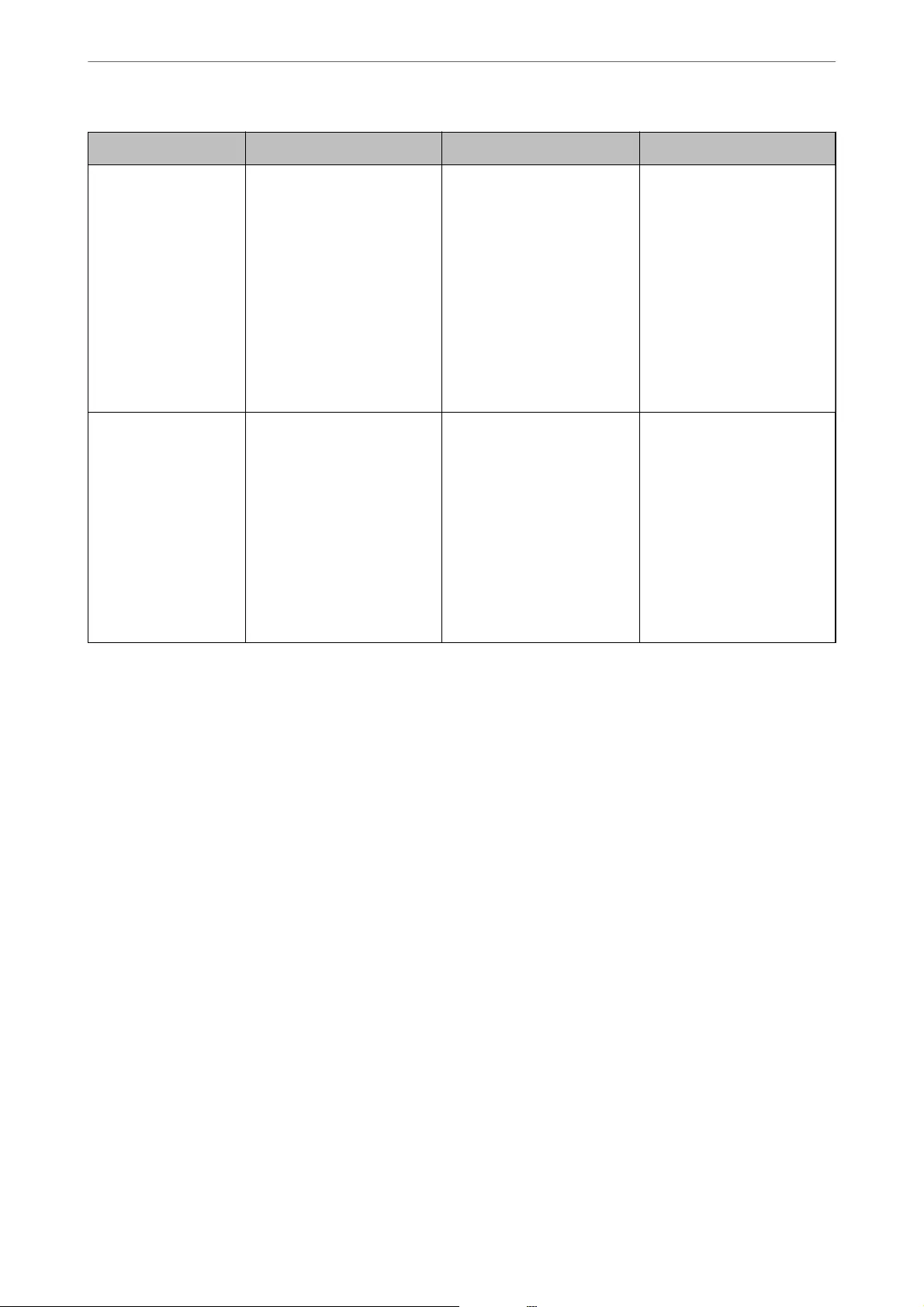
Feature name Feature type What to set What to prevent
Setup for access
control
Limits the functions that can
be used on devices, such as
print, scan, copy, and fax for
each user. If you log on with a
user account registered in
advance, you are allowed to
use certain functions.
In addition, after logging on
from the control panel, you
will be logged o
automatically if there is no
activity for a certain period of
time.
Register any user account,
and then select the function
you want to allow, such as
copy and scan.
You can register up to 10 user
accounts.
The risk of leakage and
unauthorized viewing of data
can be reduced by
minimizing the numbers of
functions in accordance with
the business content and the
role of the user.
Setup for external
interface
Controls the interface, such as
USB port that connects to the
device.
Enable or disable the USB
port for connecting external
devices such as USB memory
and USB connection with the
computer.
❏USB port control: Reduces
the possibility of data
being taken through
unauthorized scanning of
condential documents.
❏USB connection of
computer: Prevents
unauthorized use of the
device by prohibiting
printing or scanning
without going through
the network.
Related Information
&“Application for Conguring Printer Operations (Web Cong)” on page 301
&“Conguring the Administrator Password” on page 407
&“Restricting Available Features” on page 416
&“Disabling the External Interface” on page 418
Administrator Settings
Conguring the Administrator Password
When you set the administrator password, you can prevent the users from changing system management settings.
You can set and change the administrator password using either Web Cong, the printer's control panel, or Epson
Device Admin. When using Epson Device Admin, see the Epson Device Admin guide or help.
Related Information
&“Application for Conguring Printer Operations (Web Cong)” on page 301
&“Soware for Managing Devices on the Network (Epson Device Admin)” on page 303
Conguring the Administrator Password from the Control Panel
You can set the administrator password from the printer's control panel.
Administrator Information
>
Managing the Printer
>
Administrator Settings
407

1. Select Settings on the printer's control panel.
2. Select General Settings > System Administration > Security Settings > Admin Settings.
3. Select Admin Password > Register.
4. Enter the new password.
5. Enter the password again.
Note:
You can change or delete the administrator password when you select Change or Reset on the Admin Password screen and
enter the administrator password.
Conguring the Administrator Password from a Computer
You can set the administrator password using Web Cong.
1. Access Web Cong and select the Product Security tab > Change Administrator Password.
2. Enter a password to New Password and Conrm New Password. Enter the user name, if necessary.
If you want to change the password to new one, enter a current password.
3. Select OK.
Note:
❏To set or change the locked menu items, click Administrator Login, and then enter the administrator password.
❏To delete the administrator password, click Product Security tab > Delete Administrator Password, and then enter
the administrator password.
Related Information
&“Application for Conguring Printer Operations (Web Cong)” on page 301
Controlling the Panel Operation
If you set the administrator password and enable the Lock Setting, you can lock the items related to the printer’s
system settings so that users cannot change them.
Enabling the Lock Setting
Enable the Lock Setting for the printer where the password is set.
Specify an administrator's password rst.
Enabling the Lock Setting from the Control Panel
1. Select Settings on the printer's control panel.
2. Select General Settings > System Administration > Security Settings > Admin Settings.
Administrator Information
>
Managing the Printer
>
Administrator Settings
408
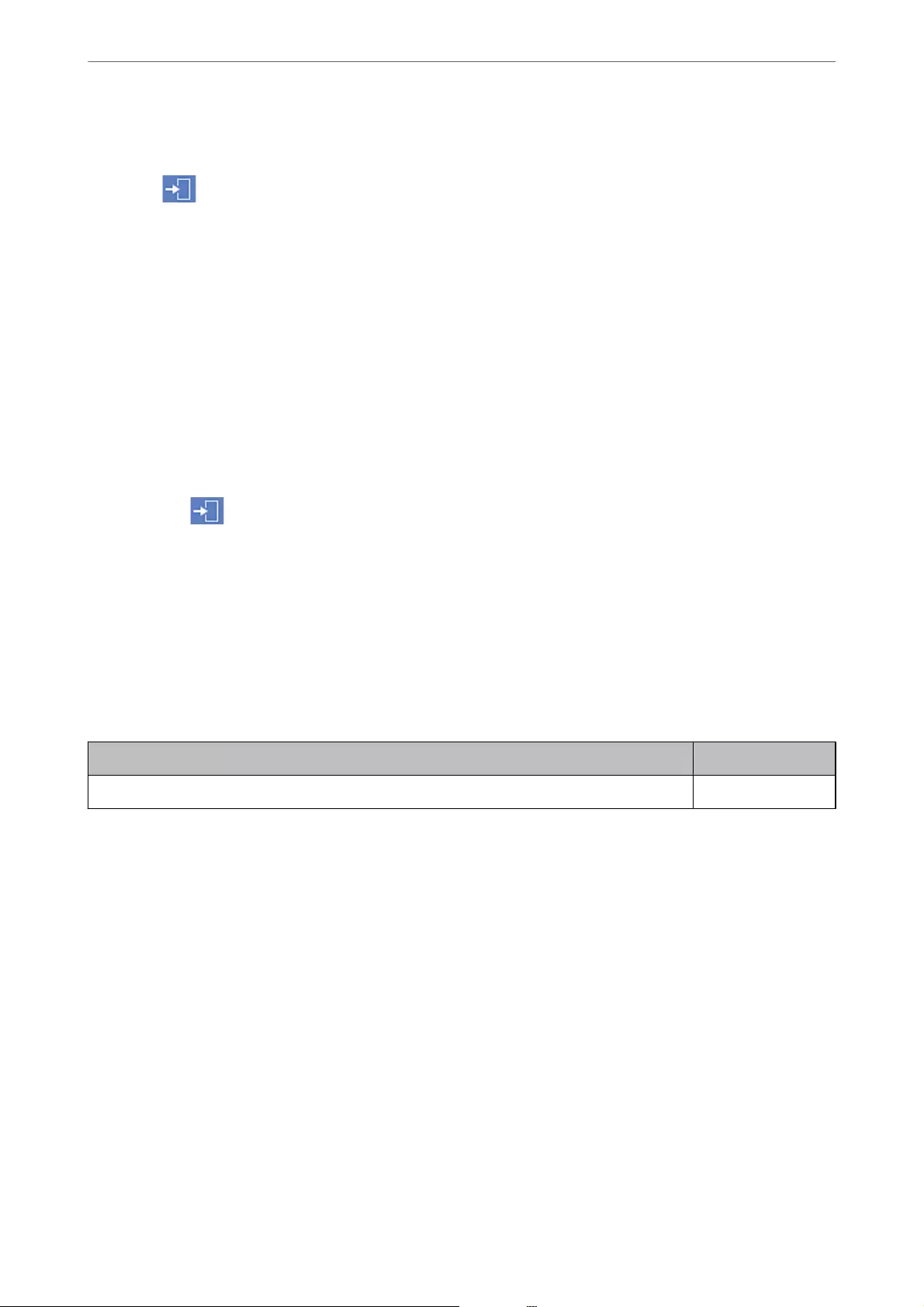
3. Select On on Lock Setting.
Check that is displayed on the home screen.
Enabling the Lock Setting from a Computer
1. Access Web Cong and click the Administrator Login.
2. Enter the user name and password, and then click OK.
3. Select the Device Management tab > Control Panel.
4. On the Panel Lock, select ON.
5. Click OK.
6. Check that is displayed on the home screen on the printer's control panel.
Related Information
&“Application for Conguring Printer Operations (Web Cong)” on page 301
Lock Setting Items for General Settings Menu
is is a list of the Lock Setting items in Settings > General Settings on the control panel.
Some functions can be set enabled or disabled individually.
General Settings menu Panel Lock
Basic Settings -
Administrator Information
>
Managing the Printer
>
Administrator Settings
409
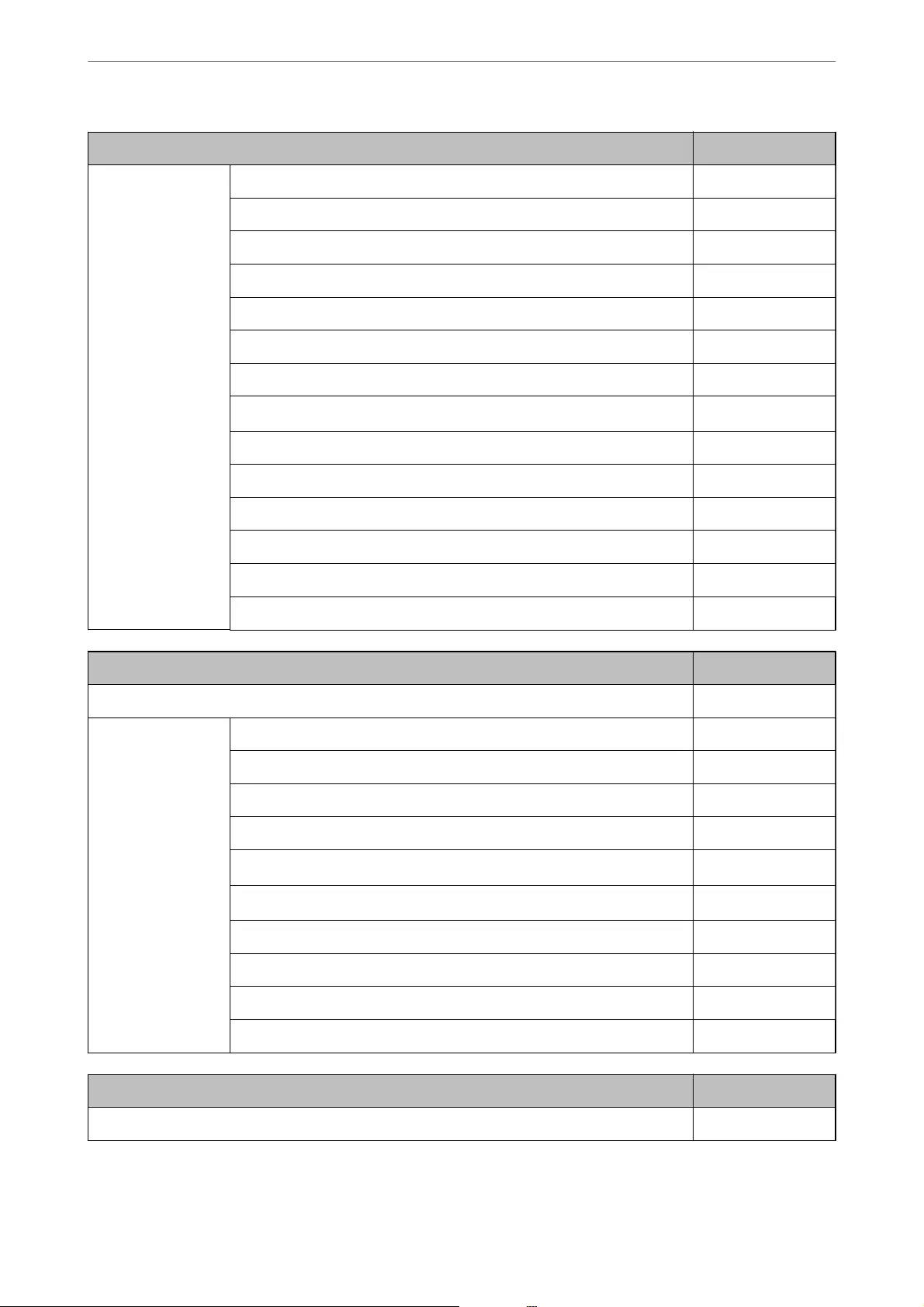
General Settings menu Panel Lock
LCD Brightness -
Sounds -
Sleep Timer ✓
Wake from Sleep -
Power O Timer or Power O Settings ✓
Date/Time Settings ✓
Country/Region ✓
Language ✓
*1
Start-up Screen ✓
Edit Home ✓
Wall Paper ✓
Operation Time Out ✓
Keyboard -
Default Screen(Job/Status) ✓
General Settings menu Panel Lock
Printer Settings -
Paper Source Settings -
Universal Print Settings ✓
Auto Error Solver ✓
Memory Device Interface ✓
Thick Paper ✓
*1
Quiet Mode ✓
*1
Ink Drying Time -
Bidirectional -
Output Tray Auto Extension -
PC Connection via USB ✓
General Settings menu Panel Lock
Network Settings ✓
Administrator Information
>
Managing the Printer
>
Administrator Settings
410
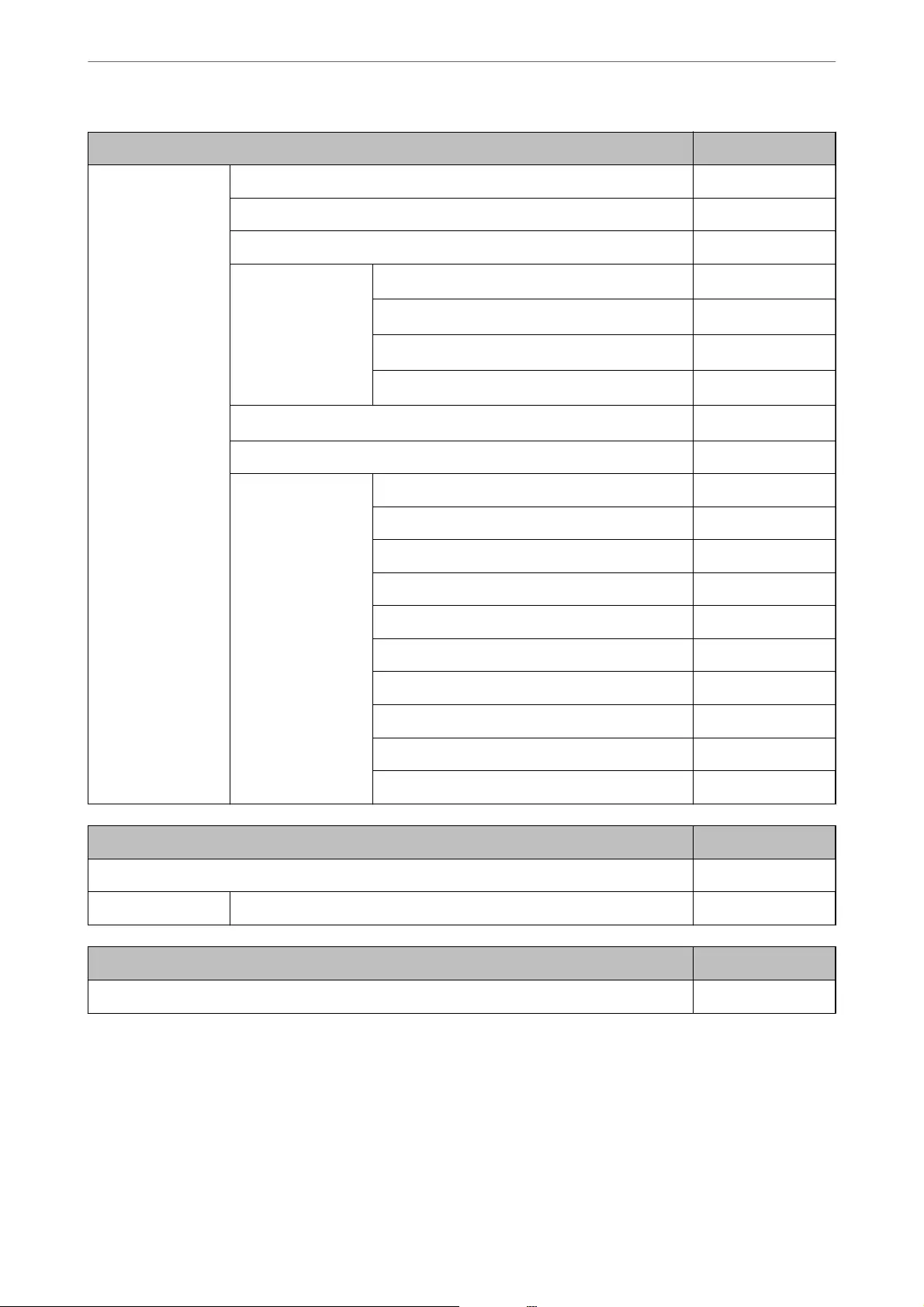
General Settings menu Panel Lock
Wi-Fi Setup ✓
Wired LAN Setup ✓
Network Status ✓
Wired LAN/Wi-Fi Status ✓
*2
Wi-Fi Direct Status ✓
*2
Email Server Status ✓
*2
Print Status Sheet ✓
*2
Connection Check ✓
*3
Advanced ✓
Device Name ✓
TCP/IP ✓
Proxy Server ✓
Email Server ✓
IPv6 Address ✓
MS Network Sharing ✓
Link Speed & Duplex ✓
Redirect HTTP to HTTPS ✓
Disable IPsec/IP Filtering ✓
Disable IEEE802.1X ✓
General Settings menu Panel Lock
Web Service Settings ✓
Epson Connect Services ✓
General Settings menu Panel Lock
Fax Settings ✓
Administrator Information
>
Managing the Printer
>
Administrator Settings
411
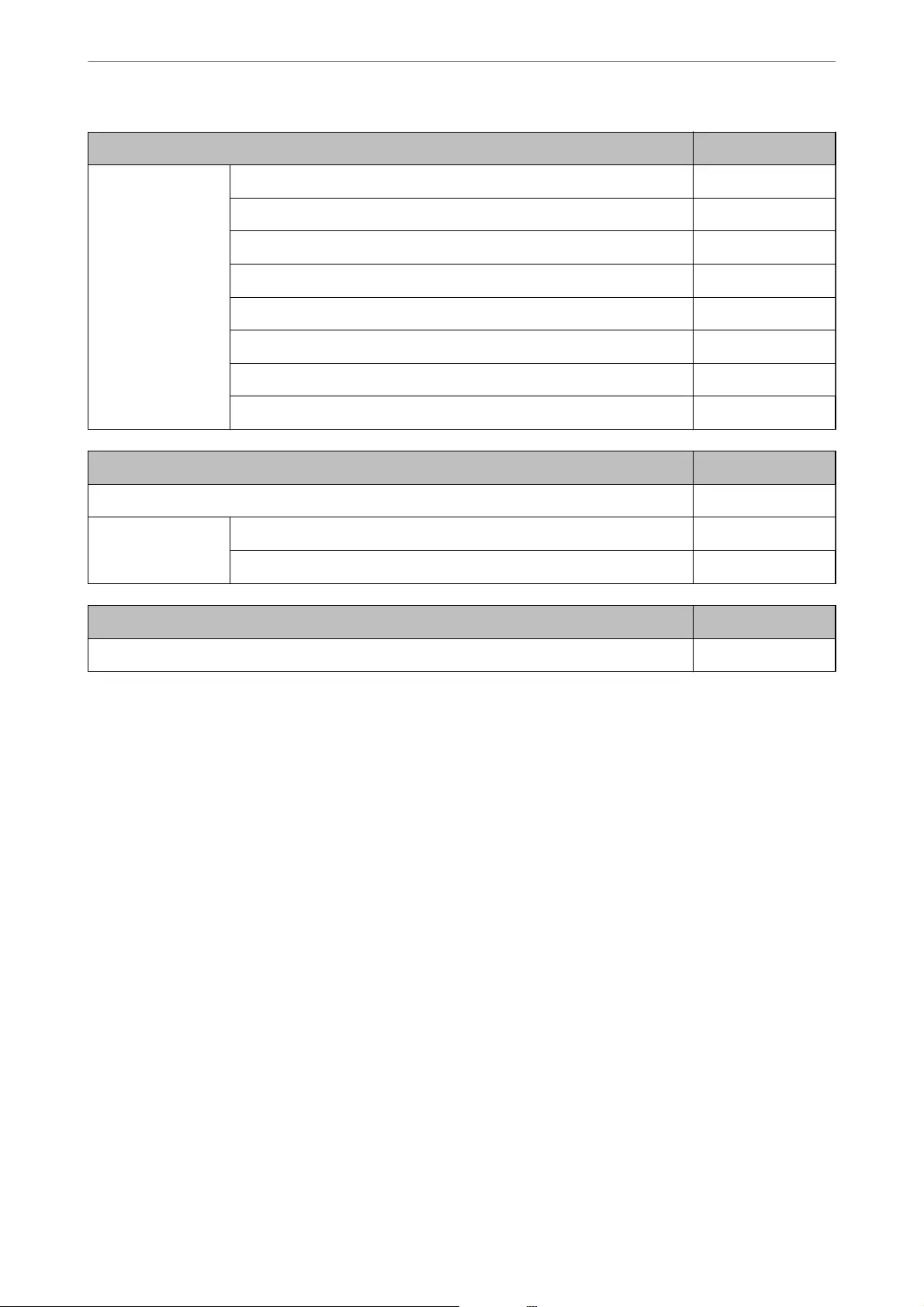
General Settings menu Panel Lock
Quick Operation Button ✓
Basic Settings ✓
Send Settings ✓
Receive Settings ✓
Report Settings ✓
Security Settings ✓
Check Fax Connection ✓
Fax Setting Wizard ✓
General Settings menu Panel Lock
Scan Settings ✓
Conrm Recipient ✓
Email Server ✓
General Settings menu Panel Lock
System Administration ✓
Administrator Information
>
Managing the Printer
>
Administrator Settings
412
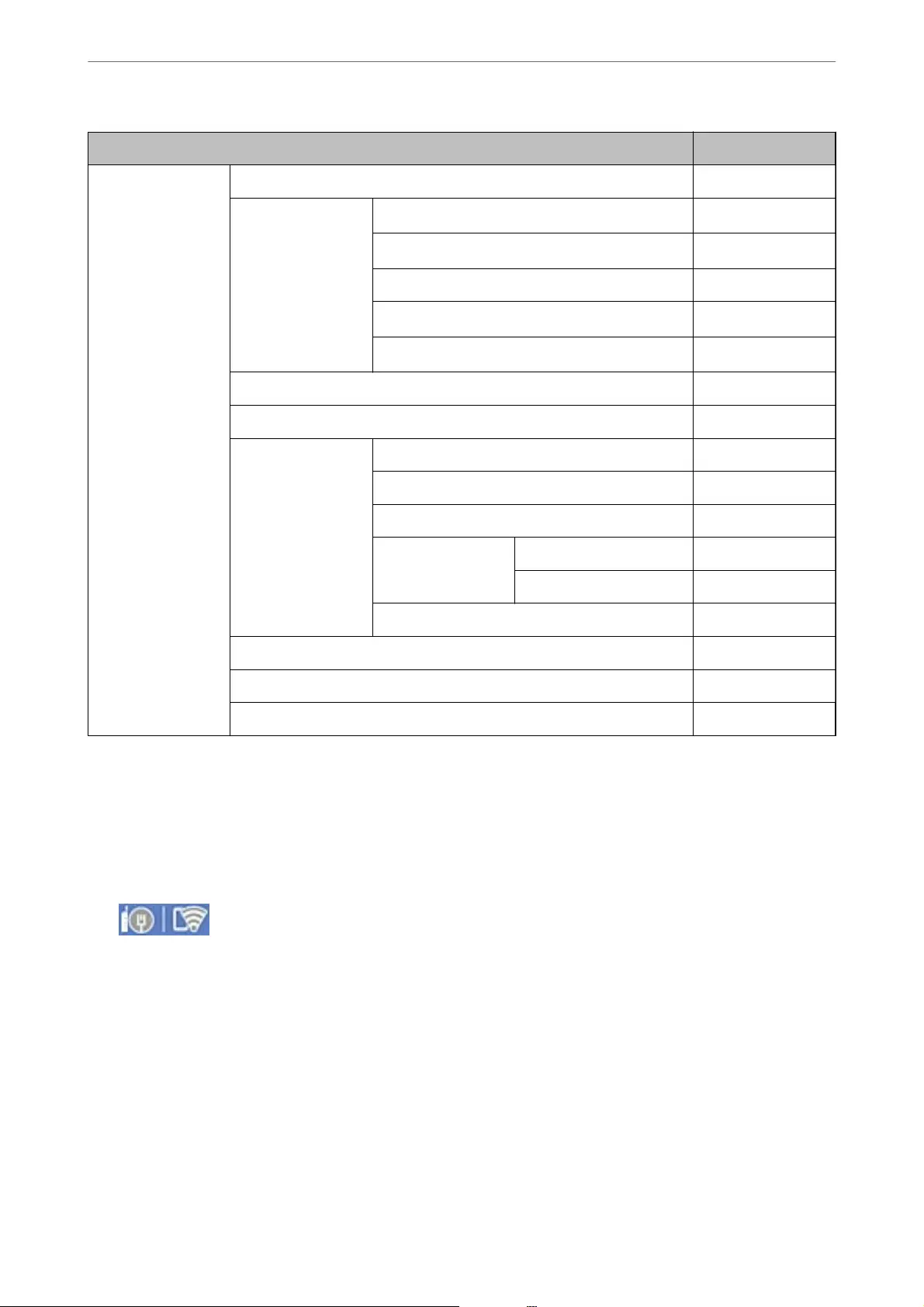
General Settings menu Panel Lock
Contacts Manager ✓
Register/Delete ✓
*1*4
Frequent ✓
*4
Print Contacts ✓
View Options ✓
*4
Search Options ✓
*4
Clear Internal Memory Data ✓
Security Settings ✓
Restrictions ✓
Access Control ✓
Admin Settings ✓
Admin Password ✓
Lock Setting ✓
Password Encryption ✓
Customer Research ✓
Restore Default Settings ✓
Firmware Update ✓
✓ = To be locked.
- = Not to be locked.
*1 : You can enable or disable the lock from General Settings > System Administration > Security Settings > Restrictions.
*2 : Even though items on the upper level can be locked by administrator lock, you can still access them from the same name
menu of Settings > Printer Status/Print.
*3 : Even though items on the upper level can be locked by administrator lock, you can still access them from Home >
> Description > When you cannot connect to the network.
*4 : Even though items on the upper level can be locked by administrator lock, you can still access them from the same name
menu of Settings > Contacts Manager.
Related Information
&“Other Lock Setting Items” on page 413
&“Items at Can Be Set Individually” on page 414
Other Lock Setting Items
Besides the General Settings menu, Lock Setting would be enabled to the items below.
Administrator Information
>
Managing the Printer
>
Administrator Settings
413

❏Presets
❏Add New
❏Delete
❏Rename
❏Add or remove to Home screen
❏Changing user settings
❏Settings > User Settings.
Related Information
&“Lock Setting Items for General Settings Menu” on page 409
&“Items at Can Be Set Individually” on page 414
Operating Display and Function Setting Individually
For the some target items of the Lock Setting, you can individually set whether they are enabled or disabled.
You can set each user’s availability as necessary, such as registering or changing the contacts, displaying job history,
etc.
1. Select Settings on the printer's control panel.
2. Select General Settings > System Administration > Security Settings > Restrictions.
3. Select the item for the function that you want to change the setting of, and then set to On or O.
Items That Can Be Set Individually
e administrator can permit the items below to display and change settings individually.
❏Job Log Access : Job/Status > Log
Control the display of the status monitor's job history. Select On to permit the job history to display.
❏Access to Register/Delete Contacts : Settings > Contacts Manager > Register/Delete
Control the registering and changing of contacts. Select On to register or change the contacts.
❏Fax Recent Access : Fax > Recipient > Recent
Control the display of destination when sending and receiving a fax. Select On to display the destination.
❏Fax Transmission Log Access : Fax > Menu > Transmission Log
Control the display of the communication history of a fax. Select On to display the communication history.
❏Access to Fax Report : Fax > Menu > Fax Report
Control the printing of the fax report. Select On to permit printing.
❏Access to Print Save History of Scan to Network Folder/FTP : Scan > Network Folder/FTP > Menu > Print
Save History
Control the printing of save history for scan to network folder function. Select On to permit the printing.
❏Access to Recent of Scan to Email : Scan > Email > Recipient > History
Control the display of the history for the scan to mail function. Select On to display the history.
Administrator Information
>
Managing the Printer
>
Administrator Settings
414
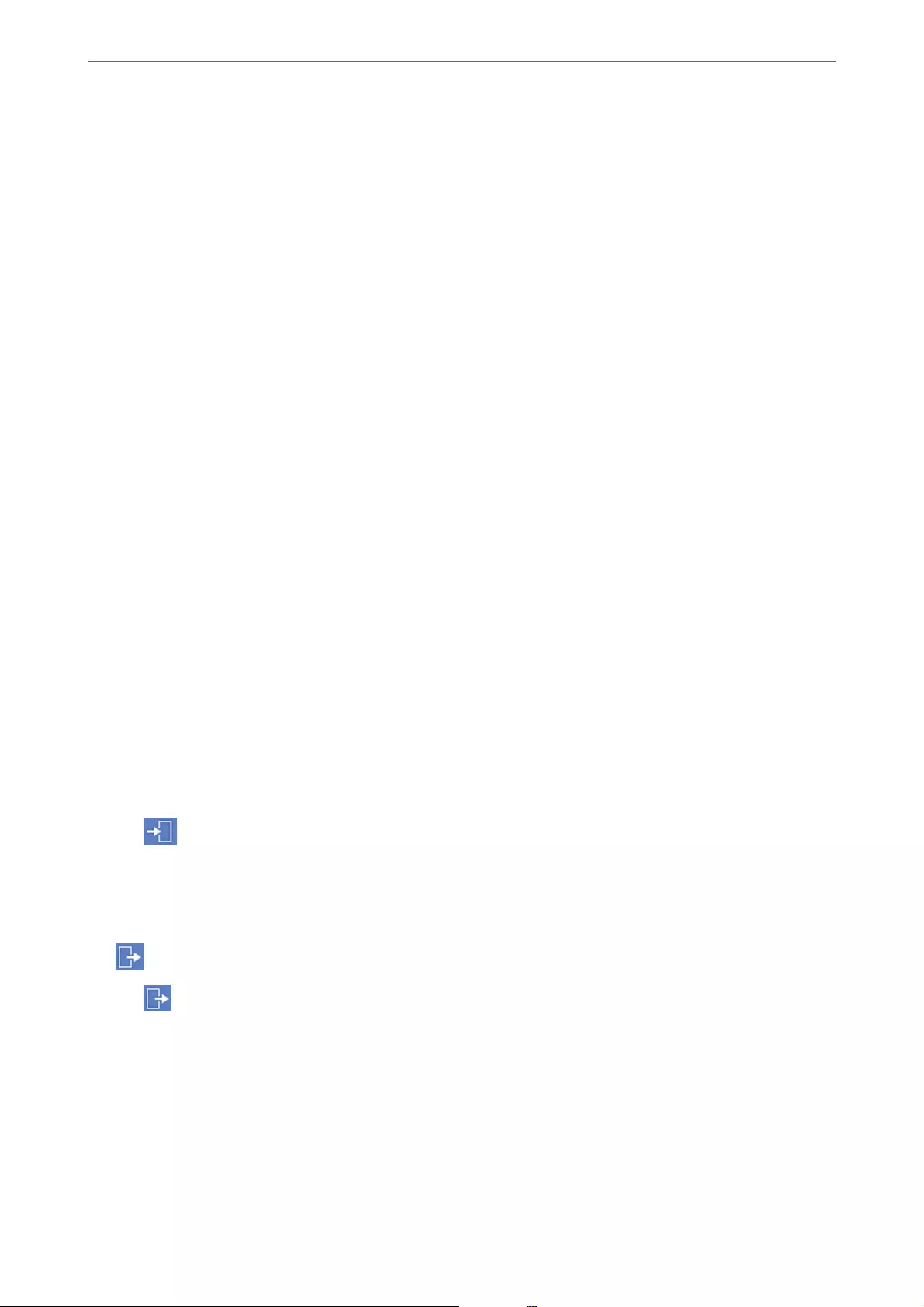
❏Access to Show Sent History of Scan to Email : Scan > Email > Menu > Show Sent History
Control the display of the history of email sending for the scan to mail function. Select On to display the history
of email sending.
❏Access to Print Sent History of Scan to Email : Scan > Email > Menu > Print Sent History
Control the printing of the history of email sending for the scan to mail function. Select On to permit the
printing.
❏Access to Language : Settings > Language
Control the changing of the language displayed on the control panel. Select On to change the languages.
❏Access to ick Paper : Settings > General Settings > Printer Settings > ick Paper
Control the changing of the settings of the ick Paper function. Select On to change the settings.
❏Access to Quiet Mode : Settings > General Settings > Printer Settings > Quiet Mode
Control the changing of settings of the Quiet Mode function. Select On to change the settings.
❏Protection of Personal Data :
Control the display of the destination information on speed dial registration. Select On to display the
destination as (***).
Related Information
&“Lock Setting Items for General Settings Menu” on page 409
&“Other Lock Setting Items” on page 413
Logging on to the Printer as an Administrator
If the administrator password is set to the printer, you need to log on as an administrator to operate the locked
menu items.
Logging on the Printer Using the Control Panel
1. Tap .
2. Tap Administrator.
3. Enter the administrator password, and then tap OK.
is displayed when being authenticated, then you can operate the locked menu items.
Tap to log o.
Note:
When you select On for Settings > General Settings > Basic Settings > Operation Time Out, you log o automatically
aer a specic length of time if there is no activity on the control panel.
Logging on to the Printer from a Computer
When you log in to Web Cong as an administrator, you can operate items that are set in the Lock Setting.
1. Enter the printer's IP address into a browser to run Web Cong.
Administrator Information
>
Managing the Printer
>
Administrator Settings
415

2. Click Administrator Login.
3. Enter the user name and administrator password in User Name and Current password.
4. Click OK.
e locked items and Administrator Logout are displayed when being authenticated.
Click Administrator Logout to log o.
Note:
When you select ON for the Device Management tab > Control Panel > Operation Timeout, you log o automatically
aer a specic length of time if there is no activity on the control panel.
Related Information
&“Application for Conguring Printer Operations (Web Cong)” on page 301
Restricting Available Features
You can register user accounts on the printer, link them with functions, and control functions that users can use.
When enabling access control, the user can use functions such as copy, fax, etc. by entering the password on the
printer’s control panel and logging in to the printer.
e unavailable functions will be grayed out and cannot be selected.
From the computer, when you register the authentication information to the printer driver or scanner driver, you
will be able to print or scan. For details of the driver settings, see the driver's help or manual.
Creating the User Account
Create the user account for access control.
1. Access Web Cong and select the Product Security tab > Access Control Settings > User Settings.
2. Click Add for the number you want to register.
3. Set each item.
❏User Name :
Enter the name displayed on the user name list between 1 and 14 characters long using alphanumeric
characters.
❏Password :
Enter a password between 0 and 20 characters long in ASCII (0x20-0x7E). When initializing the password,
leave it blank.
❏Select the check box to enable or disable each function.
Select the function that you permit to use.
4. Click Apply.
Return to the user setting list aer a specic length of time.
Check that the user name you registered on User Name is displayed and changed Add to Edit.
Administrator Information
>
Managing the Printer
>
Restricting Available Features
416
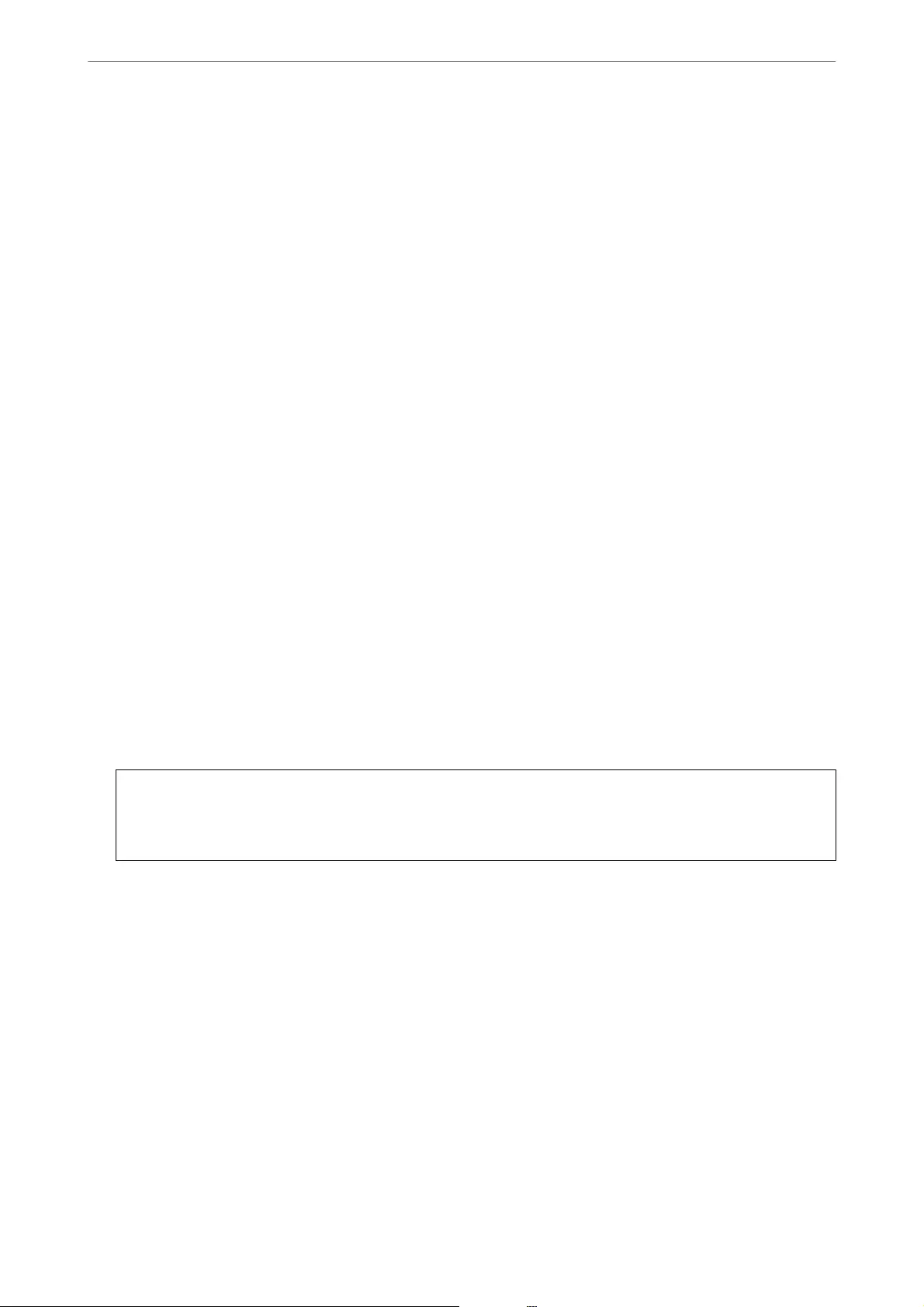
Related Information
&“Application for Conguring Printer Operations (Web Cong)” on page 301
Editing the User Account
Edit the account registered to access control.
1. Access Web Cong and select the Product Security tab > Access Control Settings > User Settings.
2. Click Edit for the number you want to edit.
3. Change each item.
4. Click Apply.
Return to the user setting list aer a specic length of time.
Related Information
&“Application for Conguring Printer Operations (Web Cong)” on page 301
Deleting the User Account
Delete the account registered to access control.
1. Access Web Cong and select the Product Security tab > Access Control Settings > User Settings.
2. Click Edit for the number you want to delete.
3. Click Delete.
c
Important:
When clicking Delete, the user account will be deleted without a conrmation message. Take care when
deleting the account.
Return to the user setting list aer a specic length of time.
Related Information
&“Application for Conguring Printer Operations (Web Cong)” on page 301
Enabling Access Control
When enabling access control, only the registered user will be able to use the printer.
1. Access Web Cong and select the Product Security tab > Access Control Settings > Basic.
Administrator Information
>
Managing the Printer
>
Restricting Available Features
417

2. Select Enables Access Control.
If you select Allows printing and scanning without authentication information, you can print or scan from
the drivers that are not set with the authentication information. Set it when you want to control the operation
only from the printer's control panel and to permit printing and scanning from the computers.
3. Click OK.
e completion message is displayed aer a certain period of time.
Conrm that the icons such as copy and scan are grayed out on the printer's control panel.
Related Information
&“Application for Conguring Printer Operations (Web Cong)” on page 301
Disabling the External Interface
You can disable the interface that is used to connect the device to the printer. Make the restriction settings to
restrict printing and scanning other than via network.
Note:
You can also make the restriction settings on the printer's control panel.
❏Memory Device : Settings > General Settings > Printer Settings > Memory Device Interface > Memory Device
❏PC Connection via USB : Settings > General Settings > Printer Settings > PC Connection via USB
1. Access Web Cong and select the Product Security tab > External Interface.
2. Select Disable on the functions you want to set.
Select Enable when you want to cancel controlling.
❏Memory Device
Prohibit saving the data to external memory via USB port for external device connection.
❏PC Connection via USB
You can restrict the usage of the USB connection from the computer. If you want to restrict it, select
Disable.
3. Click OK.
4. Check that the disabled port cannot be used.
❏Memory Device
Conrm that there is no response when connecting a storage device such as USB memory to the external
interface USB port.
Administrator Information
>
Managing the Printer
>
Disabling the External Interface
418

❏PC Connection via USB
If the driver was installed on the computer
Connect the printer to the computer using a USB cable, and then conrm that the printer does not print
and scan.
If the driver was not installed on the computer
Windows:
Open the device manager and keep it, connect the printer to the computer using a USB cable, and then
conrm that the device manager's display contents stays unchanged.
Mac OS:
Connect the printer to the computer using a USB cable, and then conrm that the printer is not listed if you
want to add the printer from Printers & Scanners.
Related Information
&“Application for Conguring Printer Operations (Web Cong)” on page 301
Monitoring a Remote Printer
Checking Information for a Remote Printer
You can check the following information of the operating printer from Status by using Web Cong.
❏Product Status
Check the status, cloud service, product number, MAC address, etc.
❏Network Status
Check the information of the network connection status, IP address, DNS server, etc.
❏Usage Status
Check the rst day of printings, printed pages, printing count for each language, scanning count, etc.
❏Hardware Status
Check the status of each function of the printer.
❏Job History
Check the job log for print jobs, transmission jobs, and so on.
Related Information
&“Application for Conguring Printer Operations (Web Cong)” on page 301
Receiving Email Notications When Events Occur
About Email Notications
is is the notication function that, when events such as printing stop and printer error occur, send the email to
the specied address.
You can regist e r up to ve destinations and set the notication settings for each destination.
Administrator Information
>
Managing the Printer
>
Monitoring a Remote Printer
419
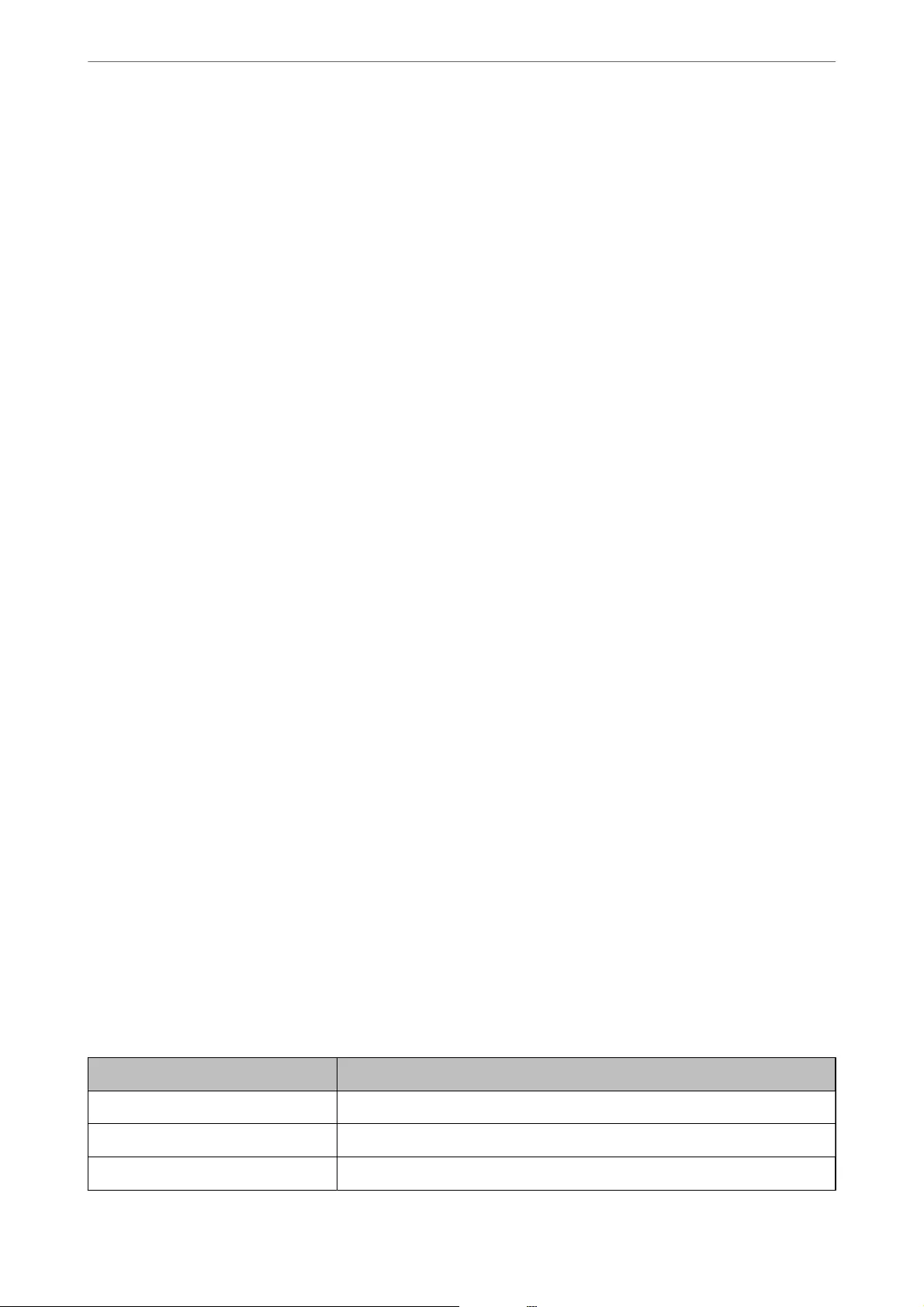
To use this function, you need to set up the mail server before setting up notications.
Related Information
&“Conguring a Mail Server” on page 354
Conguring Email Notication
Congure email notication by using Web Cong.
1. Access Web Cong and select the Device Management tab > Email Notication.
2. Set the subject of email notication.
Select the contents displayed on the subject from the two pull-down menus.
❏e selected contents are displayed next to Subject.
❏e same contents cannot be set on le and right.
❏When the number of characters in Location exceeds 32 bytes, characters exceeding 32 bytes are omitted.
3. Enter the email address for sending the notication email.
Use A-Z a-z 0-9 ! # $ % & ' * + - . /= ? ^ _ { | } ~ @, and enter between 1 and 255 characters.
4. Select the language for the email notications.
5. Select the check box on the event for which you want to receive a notication.
e number of Notication Settings is linked to the destination number of Email Address Settings.
Example :
If you want a notication sent to the email address set for number 1 in Email Address Settings when the
printer is out of paper, select the check box column 1 in line Paper out.
6. Click OK.
Conrm that an email notication will be sent by causing an event.
Example : Print by specifying the Paper Source where paper is not set.
Related Information
&“Application for Conguring Printer Operations (Web Cong)” on page 301
&“Conguring a Mail Server” on page 354
Items for Email Notication
Items Settings and Explanation
Reset Ink Level Notice when the ink is expended.
Ink low Notice when the ink is nearing expended.
Maintenance box: end of service life Notice when the maintenance box is full.
Administrator Information
>
Managing the Printer
>
Monitoring a Remote Printer
420
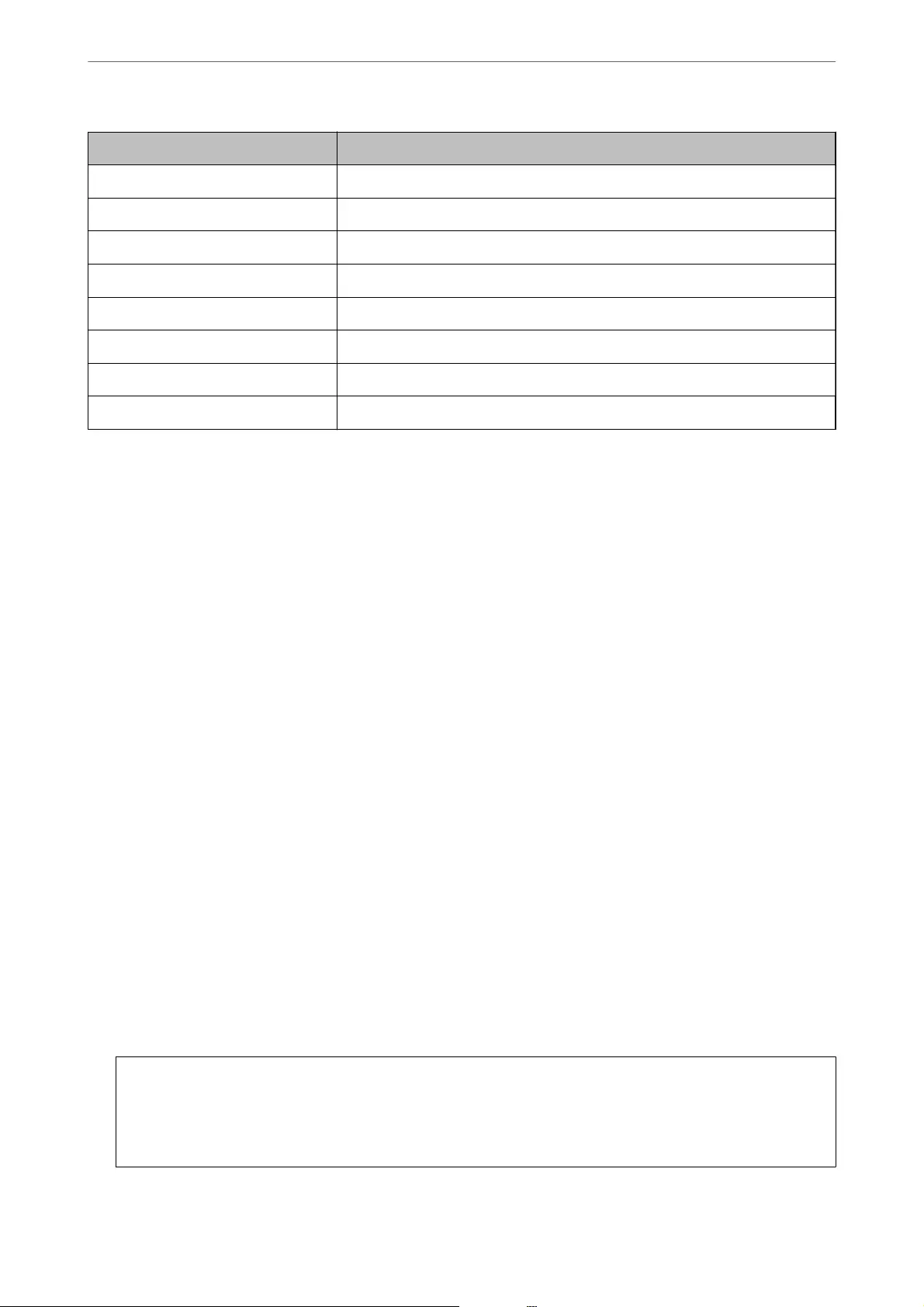
Items Settings and Explanation
Maintenance box: nearing end Notice when the maintenance box is nearing full.
Administrator password changed Notice when administrator password has been changed.
Paper out Notice when the paper-out error has occurred in the specied paper source..
Printing stopped* Notice when the printing is stopped due to paper jam or paper cassette not set.
Printer error Notice when the printer error has occurred.
Scanner error Notice when the scanner error has occurred.
Fax error Notice when the fax error has occurred.
Wi-Fi failure Notice when the error of the wireless LAN interface has occurred.
Related Information
&“Conguring Email Notication” on page 420
Backing Up the Settings
You can export the setting value set from Web Cong to the le. You can use it for backing up the contacts, setting
values, replacing the printer, etc.
e exported le cannot be edited because it is exported as a binary le.
Export the settings
Export the setting for the printer.
1. Access Web Cong, and then select the Device Management tab > Export and Import Setting Value >
Export.
2. Select the settings that you want to export.
Select the settings you want to export. If you select the parent category, subcategories are also selected.
However, subcategories that cause errors by duplicating within the same network (such as IP addresses and so
on) cannot be selected.
3. Enter a password to encrypt the exported le.
You need the password to import the le. Leave this blank if you do not want to encrypt the le.
4. Click Export.
c
Important:
If you want to export the printer’s network settings such as the device name and IPv6 address, select Enable to
select the individual settings of device and select more items. Only use the selected values for the replacement
printer.
Administrator Information
>
Managing the Printer
>
Backing Up the Settings
421
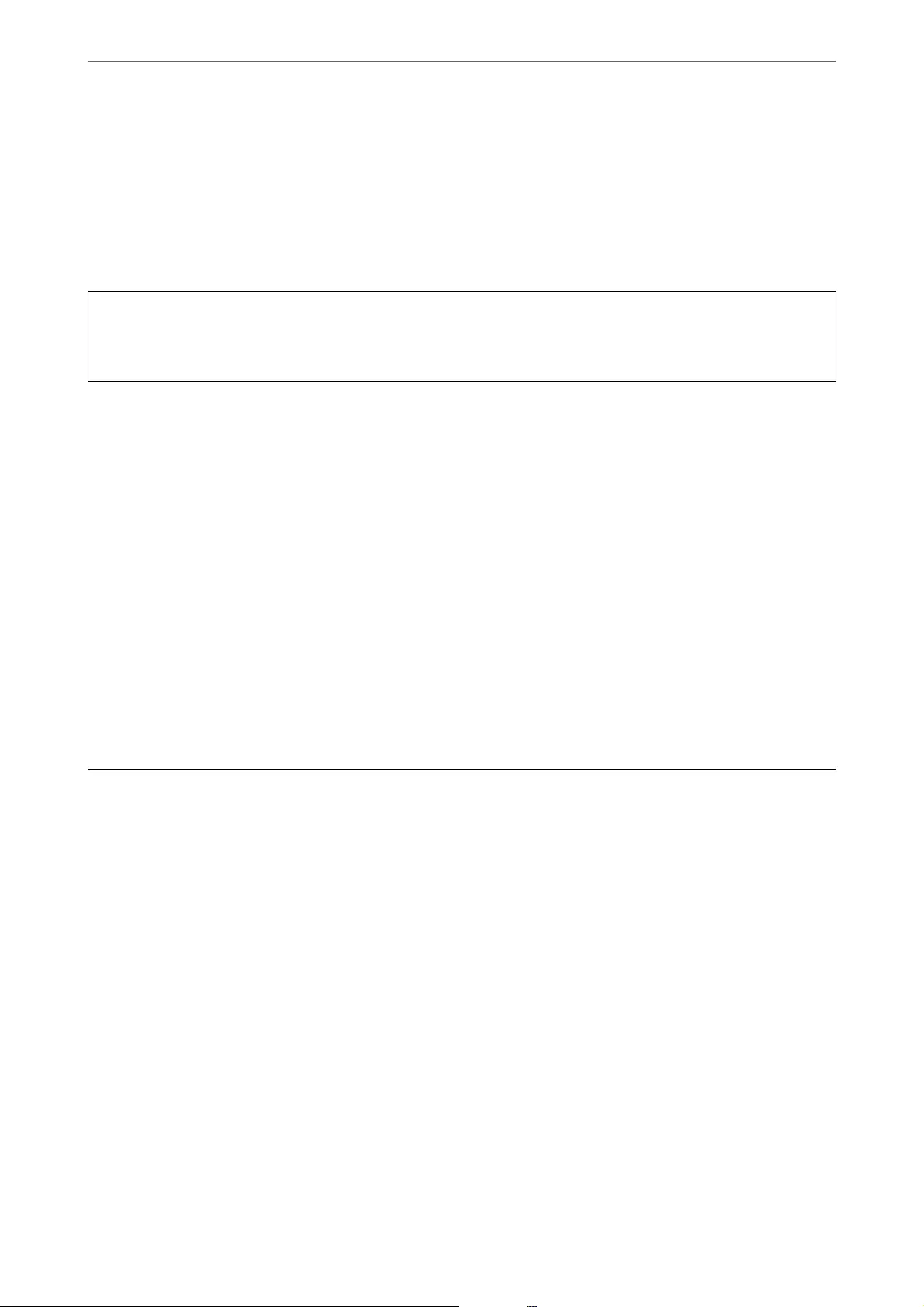
Related Information
&“Application for Conguring Printer Operations (Web Cong)” on page 301
Import the settings
Import the exported Web Cong le to the printer.
c
Important:
When importing values that include individual information such as a printer name or IP address, make sure the
same IP address does not exist on the same network.
1. Access Web Cong, and then select the Device Management tab > Export and Import Setting Value >
Import.
2. Select the exported le, and then enter the encrypted password.
3. Click Next.
4. Select the settings that you want to import, and then click Next.
5. Click OK.
e settings are applied to the printer.
Related Information
&“Application for Conguring Printer Operations (Web Cong)” on page 301
Advanced Security Settings
is section explains advanced security features.
Security Settings and Prevention of Danger
When a printer is connected to a network, you can access it from a remote location. In addition, many people can
share the printer, which is helpful in improving operational eciency and convenience. However, risks such as
illegal access, illegal use, and tampering with data are increased. If you use the printer in an environment where
you can access the Internet, the risks are even higher.
For printers that do not have access protection from the outside, it will be possible to read the print job logs that
are stored in the printer from the Internet.
In order to avoid this risk, Epson printers have a variety of security technologies.
Set the printer as necessary according to the environmental conditions that have been built with the customer's
environment information.
Administrator Information
>
Advanced Security Settings
>
Security Settings and Prevention of Danger
422
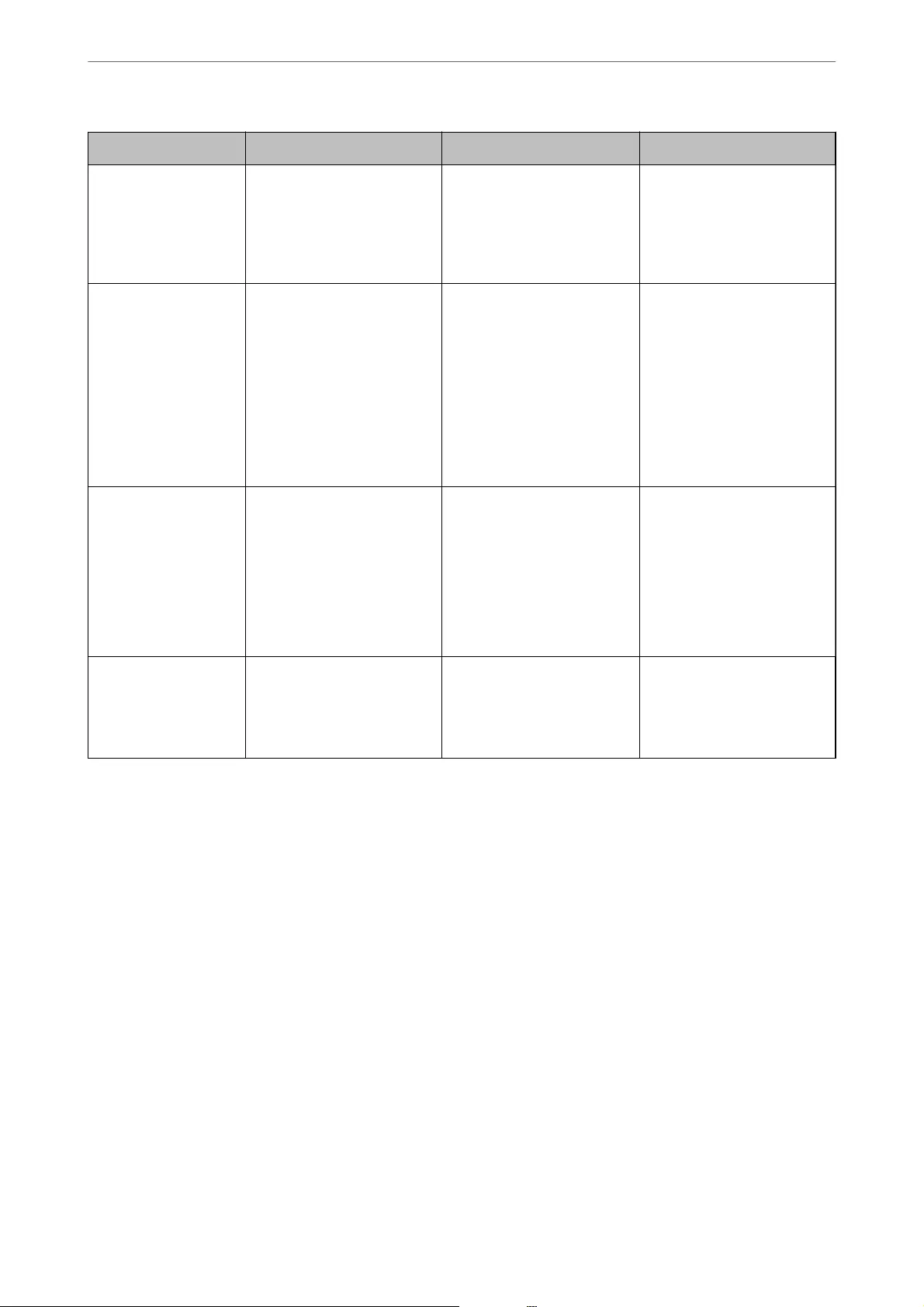
Name Feature type What to set What to prevent
Control of protocol Controls the protocols and
services to be used for
communication between
printers and computers, and
it enables and disables
features.
A protocol or service that is
applied to features allowed or
prohibited separately.
Reducing security risks that
may occur through
unintended use by
preventing users from using
unnecessary functions.
SSL/TLS
communications
The communication content
is encrypted with SSL/TLS
communications when
accessing to the Epson server
on the Internet from the
printer, such as
communicating to the
computer via web browser,
using Epson Connect, and
updating rmware.
Obtain a CA-signed
certicate, and then import it
to the printer.
Clearing an identication of
the printer by the CA-signed
certication prevents
impersonation and
unauthorized access. In
addition, communication
contents of SSL/TLS are
protected, and it prevents the
leakage of contents for
printing data and setup
information.
IPsec/IP ltering You can set to allow severing
and cutting o of data that is
from a certain client or is a
particular type. Since IPsec
protects the data by IP packet
unit (encryption and
authentication), you can
safely communicate
unsecured protocol.
Create a basic policy and
individual policy to set the
client or type of data that can
access the printer.
Protect unauthorized access,
and tampering and
interception of
communication data to the
printer.
IEEE802.1X Only allows authenticated
users to connect to the
network. Allows only a
permitted user to use the
printer.
Authentication setting to the
RADIUS server
(authentication sever).
Protect unauthorized access
and use to the printer.
Related Information
&“Controlling Using Protocols” on page 424
&“SSL/TLS Communication with the Printer” on page 433
&“Encrypted Communication Using IPsec/IP Filtering” on page 434
&“Connecting the Printer to an IEEE802.1X Network” on page 446
Security Feature Settings
When setting IPsec/IP ltering or IEEE802.1X, it is recommended that you access Web Cong using SSL/TLS to
communicate settings information in order to reduce security risks such as tampering or interception.
Make sure you congure the administrator password before setting IPsec/IP ltering or IEEE802.1X.
Also, you can use Web Cong by connecting the printer directly to the computer using an Ethernet cable, and then
entering the IP address into a web browser. e printer can be connected in a secure environment aer the security
settings have been completed.
Administrator Information
>
Advanced Security Settings
>
Security Settings and Prevention of Danger
423
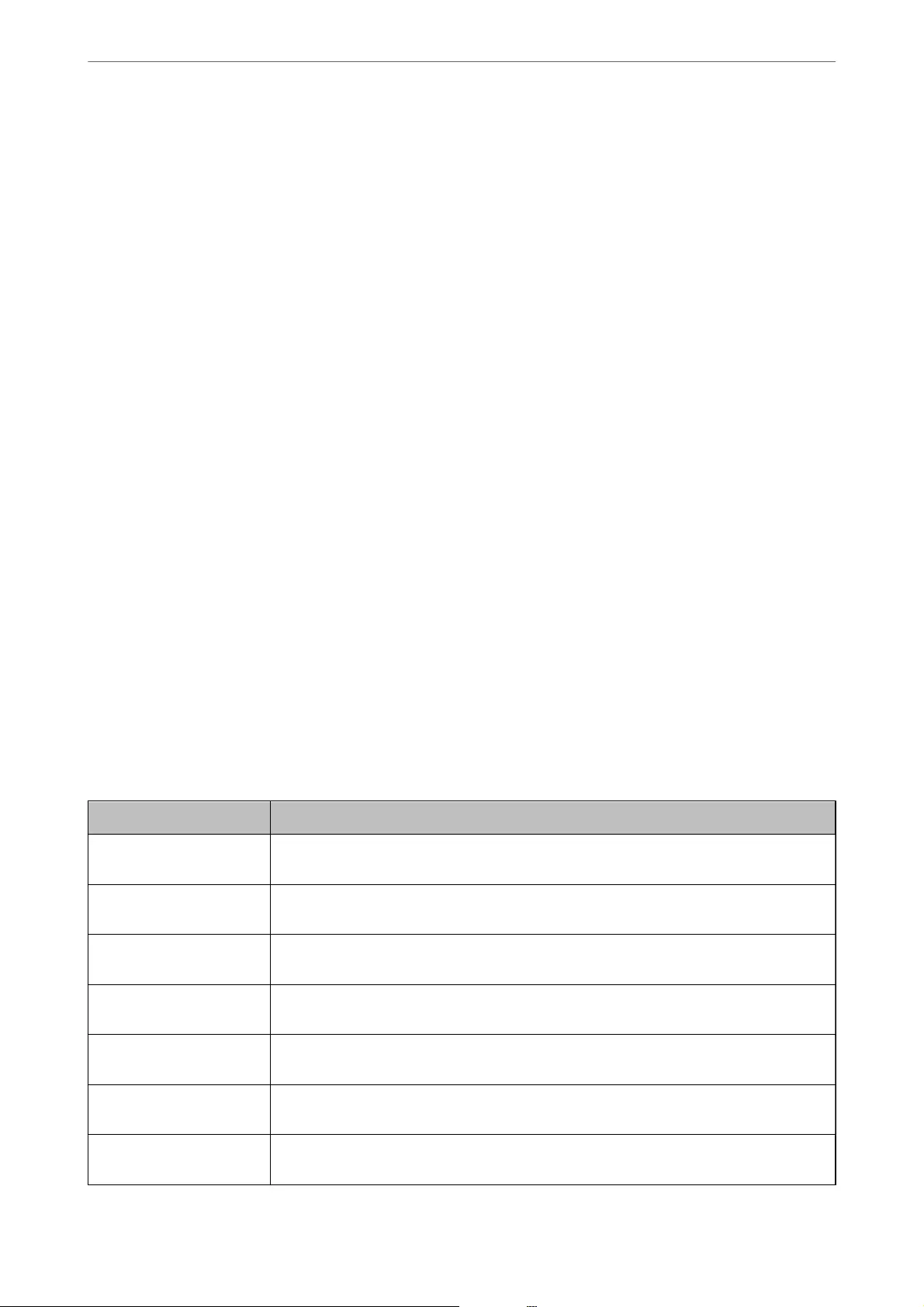
Controlling Using Protocols
You can print using a variety of pathways and protocols.
If you are using a multi-function printer, you can use network scanning and PC-FAX from an unspecied number
of network computers.
You can lower unintended security risks by restricting printing from specic pathways or by controlling the
available functions.
Controlling protocols
Congure the protocol settings.
1. Access Web Cong and then select the Network Security tab > Protocol.
2. Congure each item.
3. Click Next.
4. Click OK.
e settings are applied to the printer.
Related Information
&“Application for Conguring Printer Operations (Web Cong)” on page 301
&“Protocols you can Enable or Disable” on page 424
&“Protocol Setting Items” on page 425
Protocols you can Enable or Disable
Protocol Description
Bonjour Settings You can specify whether to use Bonjour. Bonjour is used to search for devices, print, and so
on.
SLP Settings You can enable or disable the SLP function. SLP is used for push scanning and network
searching in EpsonNet Cong.
WSD Settings You can enable or disable the WSD function. When this is enabled, you can add WSD devices,
and print from the WSD port.
LLTD Settings You can enable or disable the LLTD function. When this is enabled, it is displayed on the
Windows network map.
LLMNR Settings You can enable or disable the LLMNR function. When this is enabled, you can use name
resolution without NetBIOS even if you cannot use DNS.
LPR Settings You can specify whether or not to allow LPR printing. When this is enabled, you can print from
the LPR port.
RAW(Port9100) Settings You can specify whether or not to allow printing from the RAW port (Port 9100). When this is
enabled, you can print from the RAW port (Port 9100).
Administrator Information
>
Advanced Security Settings
>
Controlling Using Protocols
424

Protocol Description
IPP Settings You can specify whether or not to allow printing from IPP. When this is enabled, you can print
over the Internet.
SNMPv1/v2c Settings You can specify whether or not to enable SNMPv1/v2c. This is used to set up devices,
monitoring, and so on.
SNMPv3 Settings You can specify whether or not to enable SNMPv3. This is used to set up encrypted devices,
monitoring, etc.
Related Information
&“Controlling protocols” on page 424
&“Protocol Setting Items” on page 425
Protocol Setting Items
Bonjour Settings
Items Setting value and Description
Use Bonjour Select this to search for or use devices through Bonjour.
Bonjour Name Displays the Bonjour name.
Bonjour Service Name Displays the Bonjour service name.
Location Displays the Bonjour location name.
Top Priority Protocol Select the top priority protocol for Bonjour print.
SLP Settings
Items Setting value and Description
Enable SLP Select this to enable the SLP function.
This is used such as network searching in EpsonNet Cong.
WSD Settings
Items Setting value and Description
Enable WSD Select this to enable adding devices using WSD, and print
and scan from the WSD port.
Printing Timeout (sec) Enter the communication timeout value for WSD printing
between 3 to 3,600 seconds.
Scanning Timeout (sec) Enter the communication timeout value for WSD scanning
between 3 to 3,600 seconds.
Device Name Displays the WSD device name.
Location Displays the WSD location name.
Administrator Information
>
Advanced Security Settings
>
Controlling Using Protocols
425
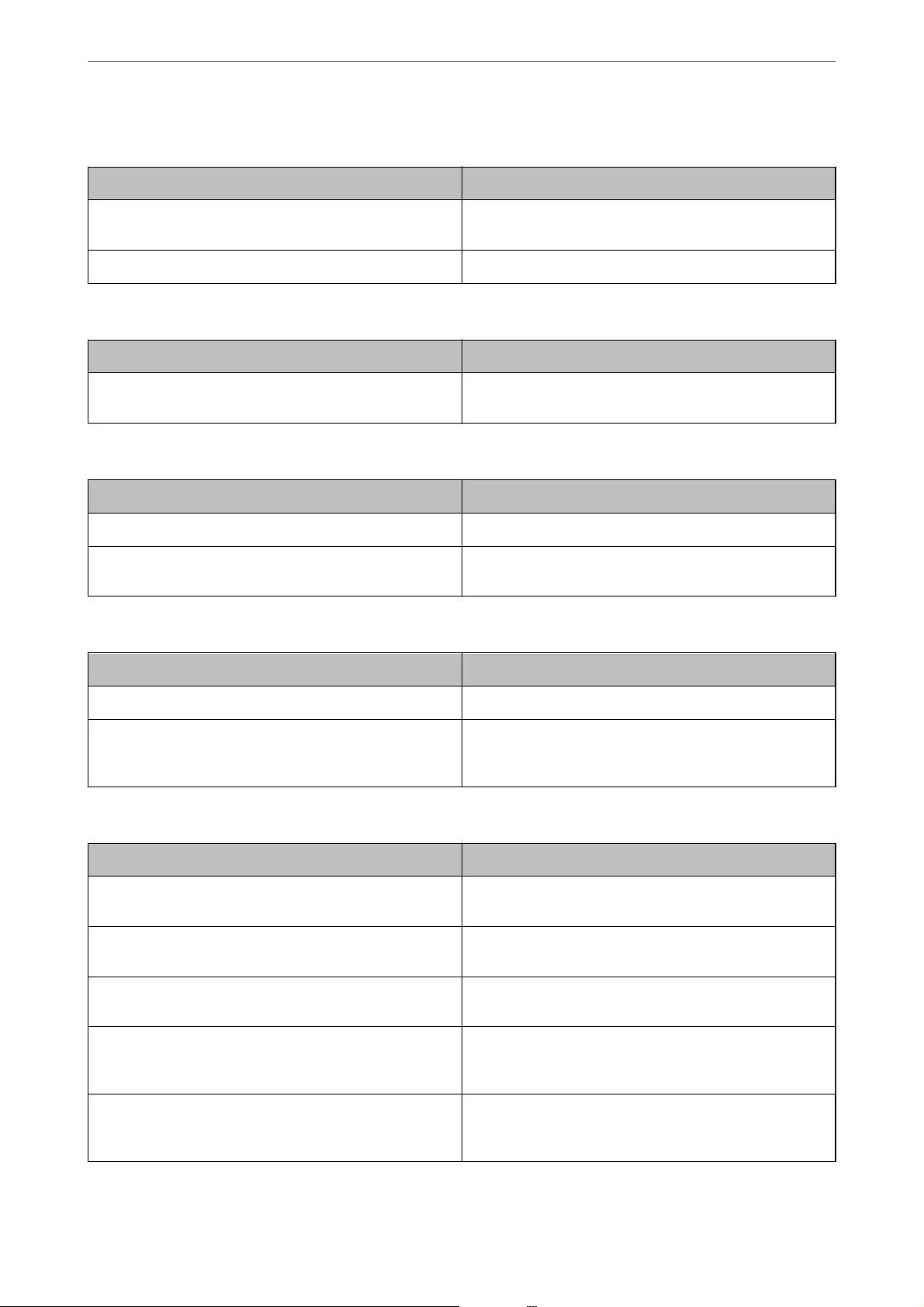
LLTD Settings
Items Setting value and Description
Enable LLTD Select this to enable LLTD. The printer is displayed in the
Windows network map.
Device Name Displays the LLTD device name.
LLMNR Settings
Items Setting value and Description
Enable LLMNR Select this to enable LLMNR. You can use name resolution
without NetBIOS even if you cannot use DNS.
LPR Settings
Items Setting value and Description
Allow LPR Port Printing Select to allow printing from the LPR port.
Printing Timeout (sec) Enter the timeout value for LPR printing between 0 to 3,600
seconds. If you do not want to timeout, enter 0.
RAW(Port9100) Settings
Items Setting value and Description
Allow RAW(Port9100) Printing Select to allow printing from the RAW port (Port 9100).
Printing Timeout (sec) Enter the timeout value for RAW (Port 9100) printing be-
tween 0 to 3,600 seconds. If you do not want to timeout, en-
ter 0.
IPP Settings
Items Setting value and Description
Enable IPP Select to enable IPP communication. Only printers that sup-
port IPP are displayed.
Allow Non-secure Communication Select Allowed to allow the printer to communicate without
any security measures (IPP).
Communication Timeout (sec) Enter the timeout value for IPP printing between 0 to 3,600
seconds.
Require PIN Code when using IPP printing Select whether or not to require a PIN code when using IPP
printing. If you select Yes , IPP print jobs without PIN codes
are not saved in the printer.
URL(Network) Displays IPP URLs (http and https) when the printer is con-
nected to the network. The URL is a combined value of the
printer’s IP address, Port number, and IPP printer name.
Administrator Information
>
Advanced Security Settings
>
Controlling Using Protocols
426
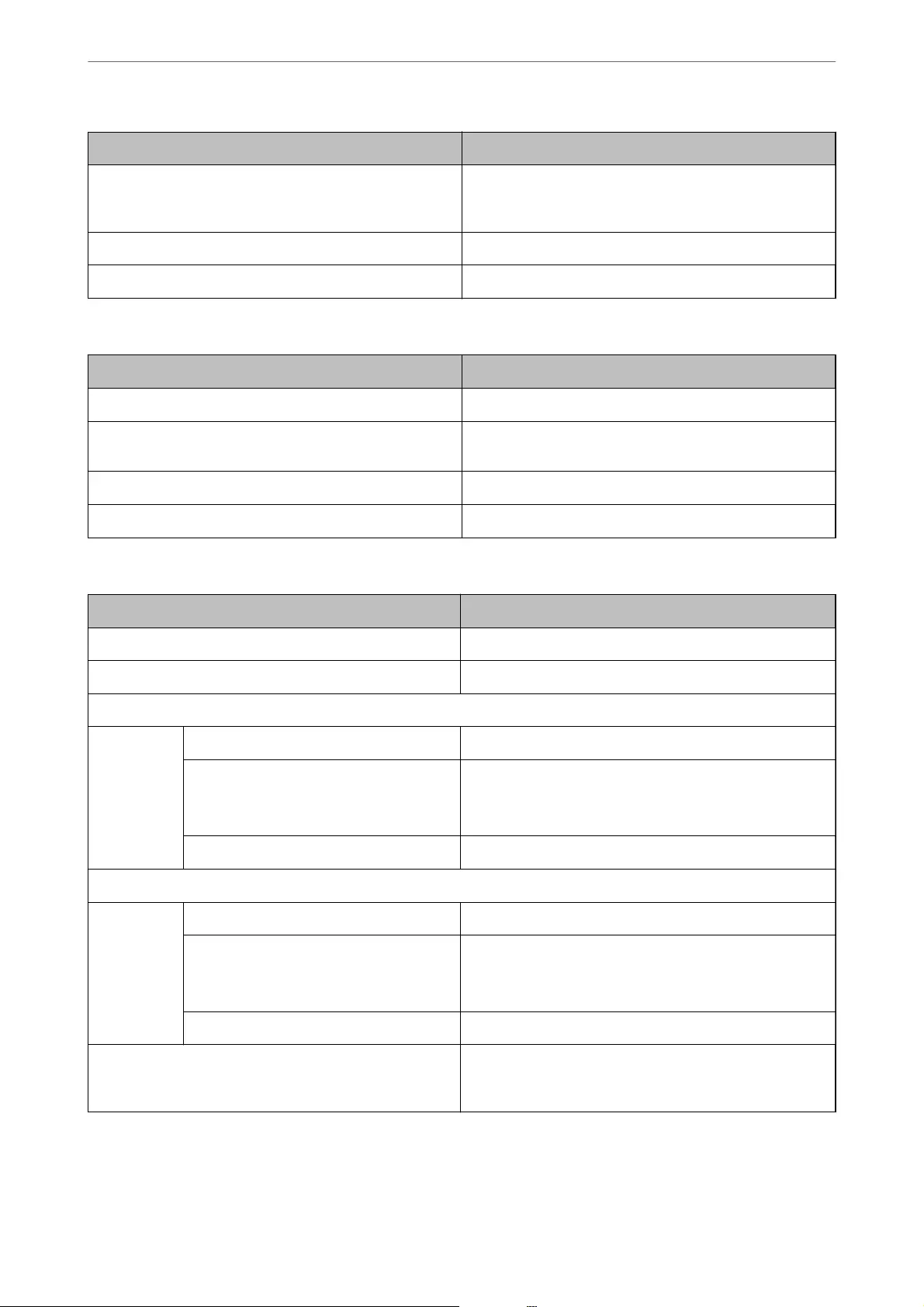
Items Setting value and Description
URL(Wi-Fi Direct) Displays IPP URLs (http and https) when the printer is con-
nected by Wi-Fi Direct. The URL is a combined value of the
printer’s IP address, Port number, and IPP printer name.
Printer Name Displays the IPP printer name.
Location Displays the IPP location.
SNMPv1/v2c Settings
Items Setting value and Description
Enable SNMPv1/v2c Select to enable SNMPv1/v2c.
Access Authority Set the access authority when SNMPv1/v2c is enabled. Se-
lect Read Only or Read/Write.
Community Name (Read Only) Enter 0 to 32 ASCII (0x20 to 0x7E) characters.
Community Name (Read/Write) Enter 0 to 32 ASCII (0x20 to 0x7E) characters.
SNMPv3 Settings
Items Setting value and Description
Enable SNMPv3 SNMPv3 is enabled when the box is checked.
User Name Enter between 1 and 32 characters using 1 byte characters.
Authentication Settings
Algorithm Select an algorithm for an authentication for SNMPv3.
Password Enter the password for an authentication for SNMPv3.
Enter between 8 and 32 characters in ASCII (0x20-0x7E). If
you do not specify this, leave it blank.
Conrm Password Enter the password you congured for conrmation.
Encryption Settings
Algorithm Select an algorithm for an encryption for SNMPv3.
Password Enter the password for an encryption for SNMPv3.
Enter between 8 and 32 characters in ASCII (0x20-0x7E). If
you do not specify this, leave it blank.
Conrm Password Enter the password you congured for conrmation.
Context Name Enter within 32 characters or less in Unicode (UTF-8). If you
do not specify this, leave it blank. The number of characters
that can be entered varies depending on the language.
Related Information
&“Controlling protocols” on page 424
&“Protocols you can Enable or Disable” on page 424
Administrator Information
>
Advanced Security Settings
>
Controlling Using Protocols
427

Using a Digital Certicate
About Digital Certication
❏CA-signed Certicate
is is a certicate signed by the CA (Certicate Authority.) You can obtain it to apply to the Certicate
Authority. is certicate certies the existence of the printer is and used for SSL/TLS communication so that
you can ensure the safety of data communication.
When it is used for SSL/TLS communication, it is used as a server certicate.
When it is set to IPsec/IP Filtering or IEEE802.1x communication, it is used as a client certicate.
❏CA Certicate
is is a certicate that is in chain of the CA-signed Certicate, also called the intermediate CA certicate. It is
used by the web browser to validate the path of the printer's certicate when accessing the server of the other
party or Web Cong.
For the CA Certicate, set when to validate the path of server certicate accessing from the printer. For the
printer, set to certify the path of the CA-signed Certicate for SSL/TLS connection.
You can obtain the CA certicate of the printer from the Certication Authority where the CA certicate is
issued.
Also, you can obtain the CA certicate used to validate the server of the other party from the Certication
Authority that issued the CA-signed Certicate of the other server.
❏Self-signed Certicate
is is a certicate that the printer signs and issues itself. It is also called the root certicate. Because the issuer
certies itself, it is not reliable and cannot prevent impersonation.
Use it when making the security setting and performing simple SSL/TLS communication without the CA-
signed Certicate.
If you use this certicate for an SSL/TLS communication, a security alert may be displayed on a web browser
because the certicate is not registered on a web browser. You can use the Self-signed Certicate only for an
SSL/TLS communication.
Related Information
&“Conguring a CA-signed Certicate” on page 428
&“Updating a Self-signed Certicate” on page 432
&“Conguring a CA Certicate” on page 432
Conguring a CA-signed Certicate
Obtaining a CA-signed Certicate
To obtain a CA-signed certicate, create a CSR (Certicate Signing Request) and apply it to certicate authority.
You can create a CSR using Web Cong and a computer.
Follow the steps to create a CSR and obtain a CA-signed certicate using Web Cong. When creating a CSR using
Web Cong, a certicate is the PEM/DER format.
Administrator Information
>
Advanced Security Settings
>
Using a Digital Certicate
428
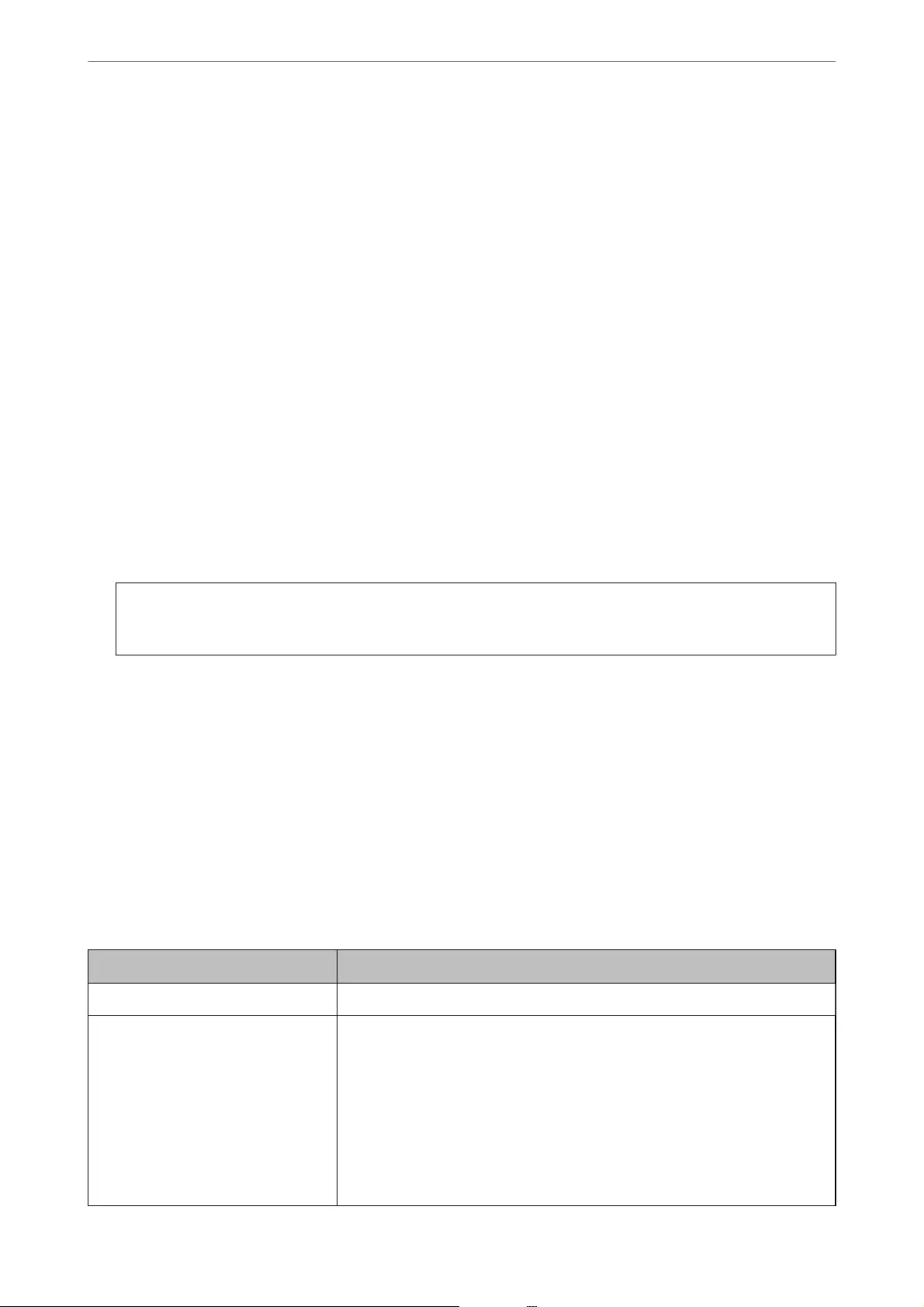
1. Access Web Cong, and then select the Network Security tab. Next, select SSL/TLS > Certicate or IPsec/IP
Filtering > Client Certicate or IEEE802.1X > Client Certicate.
Whatever you choose, you can obtain the same certicate and use it in common.
2. Click Generate of CSR.
A CSR creating page is opened.
3. Enter a value for each item.
Note:
Available key length and abbreviations vary by a certicate authority. Create a request according to rules of each
certicate authority.
4. Click OK.
A completion message is displayed.
5. Select the Network Security tab. Next, select SSL/TLS > Certicate, or IPsec/IP Filtering > Client
Certicate or IEEE802.1X > Client Certicate.
6. Click one of the download buttons of CSR according to a specied format by each certicate authority to
download a CSR to a computer.
c
Important:
Do not generate a CSR again. If you do so, you may not be able to import an issued CA-signed Certicate.
7. Send the CSR to a certicate authority and obtain a CA-signed Certicate.
Follow the rules of each certicate authority on sending method and form.
8. Save the issued CA-signed Certicate to a computer connected to the printer.
Obtaining a CA-signed Certicate is complete when you save a certicate to a destination.
Related Information
&“Application for Conguring Printer Operations (Web Cong)” on page 301
CSR Setting Items
Items Settings and Explanation
Key Length Select a key length for a CSR.
Common Name You can enter between 1 and 128 characters. If this is an IP address, it should be a
static IP address. You can enter 1 to 5 IPv4 addresses, IPv6 addresses, host names,
FQDNs by separating them with commas.
The rst element is stored to the common name, and other elements are stored to
the alias eld of the certicate subject.
Example:
Printer's IP address : 192.0.2.123, Printer name : EPSONA1B2C3
Common Name : EPSONA1B2C3,EPSONA1B2C3.local,192.0.2.123
Administrator Information
>
Advanced Security Settings
>
Using a Digital Certicate
429
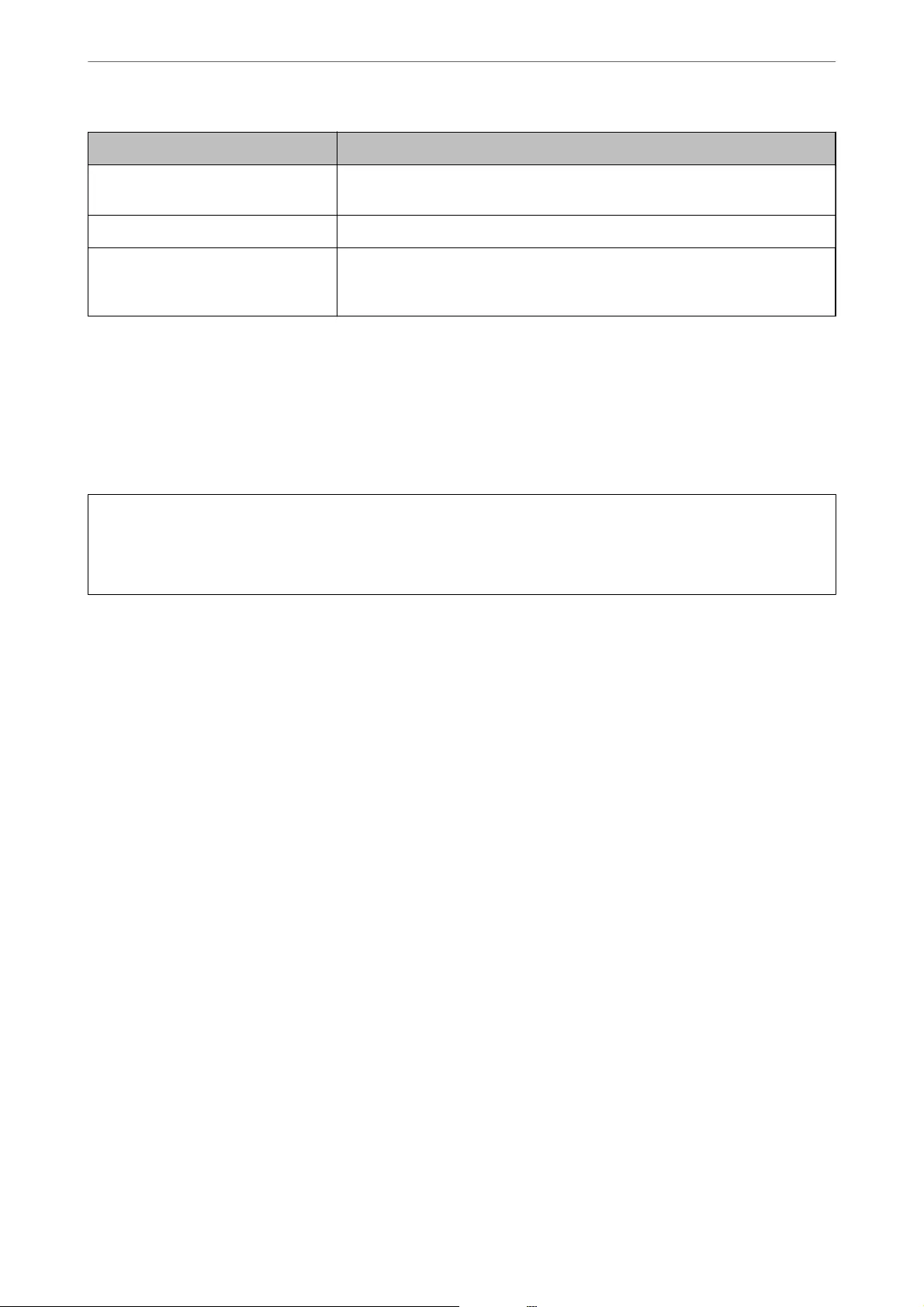
Items Settings and Explanation
Organization/ Organizational Unit/
Locality/ State/Province
You can enter between 0 and 64 characters in ASCII (0x20-0x7E). You can divide
distinguished names with commas.
Country Enter a country code in two-digit number specied by ISO-3166.
Sender's Email Address You can enter the sender's email address for the mail server setting. Enter the
same email address as the Sender's Email Address for the Network tab > Email
Server > Basic.
Related Information
&“Obtaining a CA-signed Certicate” on page 428
Importing a CA-signed Certicate
Import the obtained CA-signed Certicate to the printer.
c
Important:
❏Make sure that the printer’s date and time is set correctly. Certicate may be invalid.
❏If you obtain a certicate using a CSR created from Web Cong, you can import a certicate one time.
1. Access Web Cong and then select the Network Security tab. Next, select SSL/TLS > Certicate, or IPsec/IP
Filtering > Client Certicate or IEEE802.1X > Client Certicate.
2. Click Import
A certicate importing page is opened.
3. Enter a value for each item. Set CA Certicate 1 and CA Certicate 2 when verifying the path of the
certicate on the web browser that accesses the printer.
Depending on where you create a CSR and the le format of the certicate, required settings may vary. Enter
values to required items according to the following.
❏A certicate of the PEM/DER format obtained from Web Cong
❏Private Key: Do not congure because the printer contains a private key.
❏Password: Do not congure.
❏CA Certicate 1/CA Certicate 2: Optional
❏A certicate of the PEM/DER format obtained from a computer
❏Private Key: You need to set.
❏Password: Do not congure.
❏CA Certicate 1/CA Certicate 2: Optional
❏A certicate of the PKCS#12 format obtained from a computer
❏Private Key: Do not congure.
❏Password: Optional
❏CA Certicate 1/CA Certicate 2: Do not congure.
Administrator Information
>
Advanced Security Settings
>
Using a Digital Certicate
430
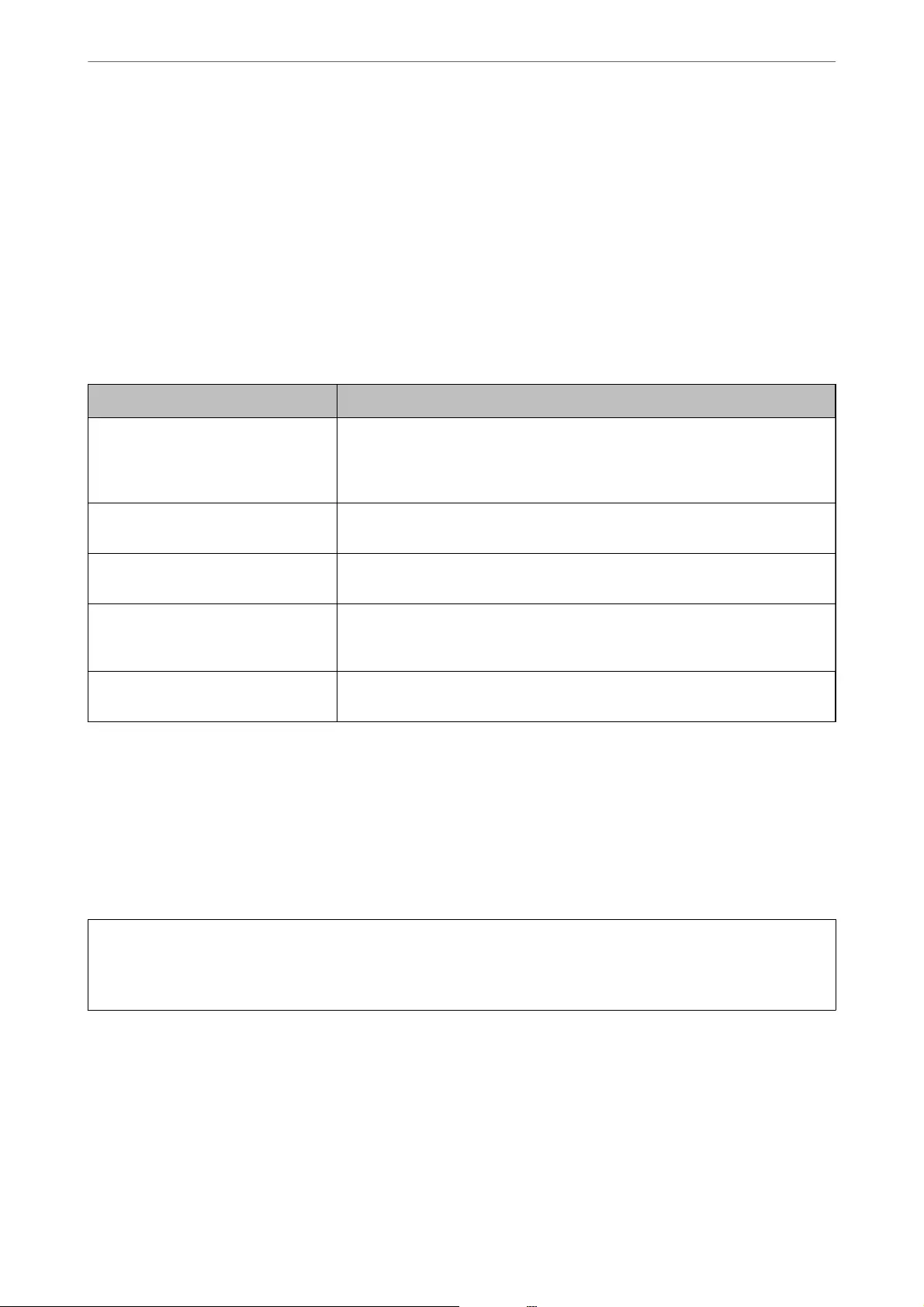
4. Click OK.
A completion message is displayed.
Note:
Click Conrm to verify the certicate information.
Related Information
&“Application for Conguring Printer Operations (Web Cong)” on page 301
CA-signed Certicate Importing Setting Items
Items Settings and Explanation
Server Certicate or Client Certicate Select a certicate’s format.
For SSL/TLS connection, the Server Certicate is displayed.
For IPsec/IP Filtering or IEEE802.1x, the Client Certicate is displayed.
Private Key If you obtain a certicate of the PEM/DER format by using a CSR created from a
computer, specify a private key le that is match a certicate.
Password If the le format is Certicate with Private Key (PKCS#12), enter the password
for encrypting the private key that is set when you obtain the certicate.
CA Certicate 1 If your certicate’s format is Certicate (PEM/DER), import a certicate of a
certicate authority that issues a CA-signed Certicate used as server certicate.
Specify a le if you need.
CA Certicate 2 If your certicate’s format is Certicate (PEM/DER), import a certicate of a
certicate authority that issues CA Certicate 1. Specify a le if you need.
Related Information
&“Importing a CA-signed Certicate” on page 430
Deleting a CA-signed Certicate
You can delete an imported certicate when the certicate has expired or when an encrypted connection is no
longer necessary.
c
Important:
If you obtain a certicate using a CSR created from Web Cong, you cannot import a deleted certicate again. In
this case, create a CSR and obtain a certicate again.
1. Access Web Cong, and then select the Network Security tab. Next, select SSL/TLS > Certicate or IPsec/IP
Filtering > Client Certicate or IEEE802.1X > Client Certicate.
2. Click Delete.
3. Conrm that you want to delete the certicate in the message displayed.
Administrator Information
>
Advanced Security Settings
>
Using a Digital Certicate
431

Related Information
&“Application for Conguring Printer Operations (Web Cong)” on page 301
Updating a Self-signed Certicate
Because the Self-signed Certicate is issued by the printer, you can update it when it has expired or when the
content described changes.
1. Access Web Cong and select the Network Security tab > SSL/TLS > Certicate.
2. Click Update.
3. Enter Common Name.
You can enter up to 5 IPv4 addresses, IPv6 addresses, host names, FQDNs between 1 to 128 characters and
separating them with commas. e rst parameter is stored to the common name, and the others are stored to
the alias eld for the subject of the certicate.
Example:
Printer's IP address : 192.0.2.123, Printer name : EPSONA1B2C3
Common name : EPSONA1B2C3,EPSONA1B2C3.local,192.0.2.123
4. Specify a validity period for the certicate.
5. Click Next.
A conrmation message is displayed.
6. Click OK.
e printer is updated.
Note:
You can check the certicate information from Network Security tab > SSL/TLS > Certicate > Self-signed Certicate
and click Conrm.
Related Information
&“Application for Conguring Printer Operations (Web Cong)” on page 301
Conguring a CA Certicate
When you set the CA Certicate, you can validate the path to the CA certicate of the server that the printer
accesses. is can prevent impersonation.
You can obtain the CA Certicate from the Certication Authority where the CA-signed Certicate is issued.
Importing a CA Certicate
Import the CA Certicate to the printer.
1. Access Web Cong and then select the Network Security tab > CA Certicate.
Administrator Information
>
Advanced Security Settings
>
Using a Digital Certicate
432

2. Click Import.
3. Specify the CA Certicate you want to import.
4. Click OK.
When importing is complete, you are returned to the CA Certicate screen, and the imported CA Certicate is
displayed.
Related Information
&“Application for Conguring Printer Operations (Web Cong)” on page 301
Deleting a CA Certicate
You can delete the imported CA Certicate.
1. Access Web Cong and then select the Network Security tab > CA Certicate.
2. Click Delete next to the CA Certicate that you want to delete.
3. Conrm that you want to delete the certicate in the message displayed.
4. Click Reboot Network, and then check that the deleted CA Certicate is not listed on the updated screen.
Related Information
&“Application for Conguring Printer Operations (Web Cong)” on page 301
SSL/TLS Communication with the Printer
When the server certicate is set using SSL/TLS (Secure Sockets Layer/Transport Layer Security) communication
to the printer, you can encrypt the communication path between computers. Do this if you want to prevent remote
and unauthorized access.
Conguring Basic SSL/TLS Settings
If the printer supports the HTTPS server feature, you can use an SSL/TLS communication to encrypt
communications. You can congure and manage the printer using Web Cong while ensuring security.
Congure encryption strength and redirect feature.
1. Access Web Cong and select the Network Security tab > SSL/TLS > Basic.
2. Select a value for each item.
❏Encryption Strength
Select the level of encryption strength.
❏Redirect HTTP to HTTPS
Redirect to HTTPS when HTTP is accessed.
Administrator Information
>
Advanced Security Settings
>
SSL/TLS Communication with the Printer
433

3. Click Next.
A conrmation message is displayed.
4. Click OK.
e printer is updated.
Related Information
&“Application for Conguring Printer Operations (Web Cong)” on page 301
Conguring a Server Certicate for the Printer
1. Access Web Cong and select the Network Security tab > SSL/TLS > Certicate.
2. Specify a certicate to use on Server Certicate.
❏Self-signed Certicate
A self-signed certicate has been generated by the printer. If you do not obtain a CA-signed certicate,
select this.
❏CA-signed Certicate
If you obtain and import a CA-signed certicate in advance, you can specify this.
3. Click Next.
A conrmation message is displayed.
4. Click OK.
e printer is updated.
Related Information
&“Application for Conguring Printer Operations (Web Cong)” on page 301
&“Conguring a CA-signed Certicate” on page 428
&“Updating a Self-signed Certicate” on page 432
Encrypted Communication Using IPsec/IP Filtering
About IPsec/IP Filtering
You can lter trac based on IP addresses, services, and port by using IPsec/IP Filtering function. By combining of
the ltering, you can congure the printer to accept or block specied clients and specied data. Additionally, you
can improve security level by using an IPsec.
Note:
Computers that run Windows Vista or later or Windows Server 2008 or later support IPsec.
Administrator Information
>
Advanced Security Settings
>
Encrypted Communication Using IPsec/IP Filtering
434
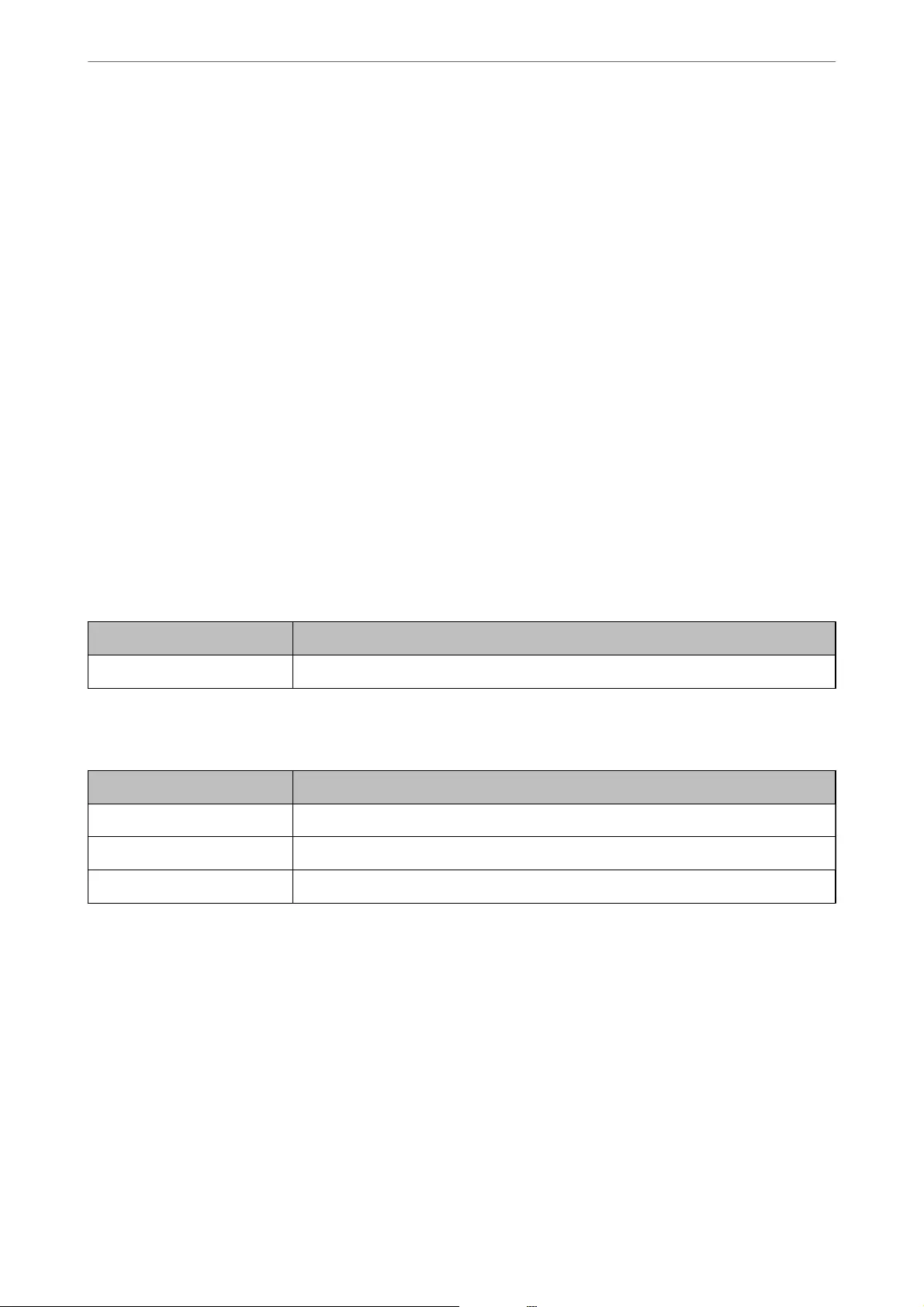
Conguring Default Policy
To lter trac, congure the default policy. e default policy applies to every user or group connecting to the
printer. For more ne-grained control over users and groups of users, congure group policies.
1. Access Web Cong and then select the Network Security tab > IPsec/IP Filtering > Basic.
2. Enter a value for each item.
3. Click Next.
A conrmation message is displayed.
4. Click OK.
e printer is updated.
Related Information
&“Application for Conguring Printer Operations (Web Cong)” on page 301
Default Policy Setting Items
Default Policy
Items Settings and Explanation
IPsec/IP Filtering You can enable or disable an IPsec/IP Filtering feature.
❏Access Control
Congure a control method for trac of IP packets.
Items Settings and Explanation
Permit Access Select this to permit congured IP packets to pass through.
Refuse Access Select this to refuse congured IP packets to pass through.
IPsec Select this to permit congured IPsec packets to pass through.
Administrator Information
>
Advanced Security Settings
>
Encrypted Communication Using IPsec/IP Filtering
435
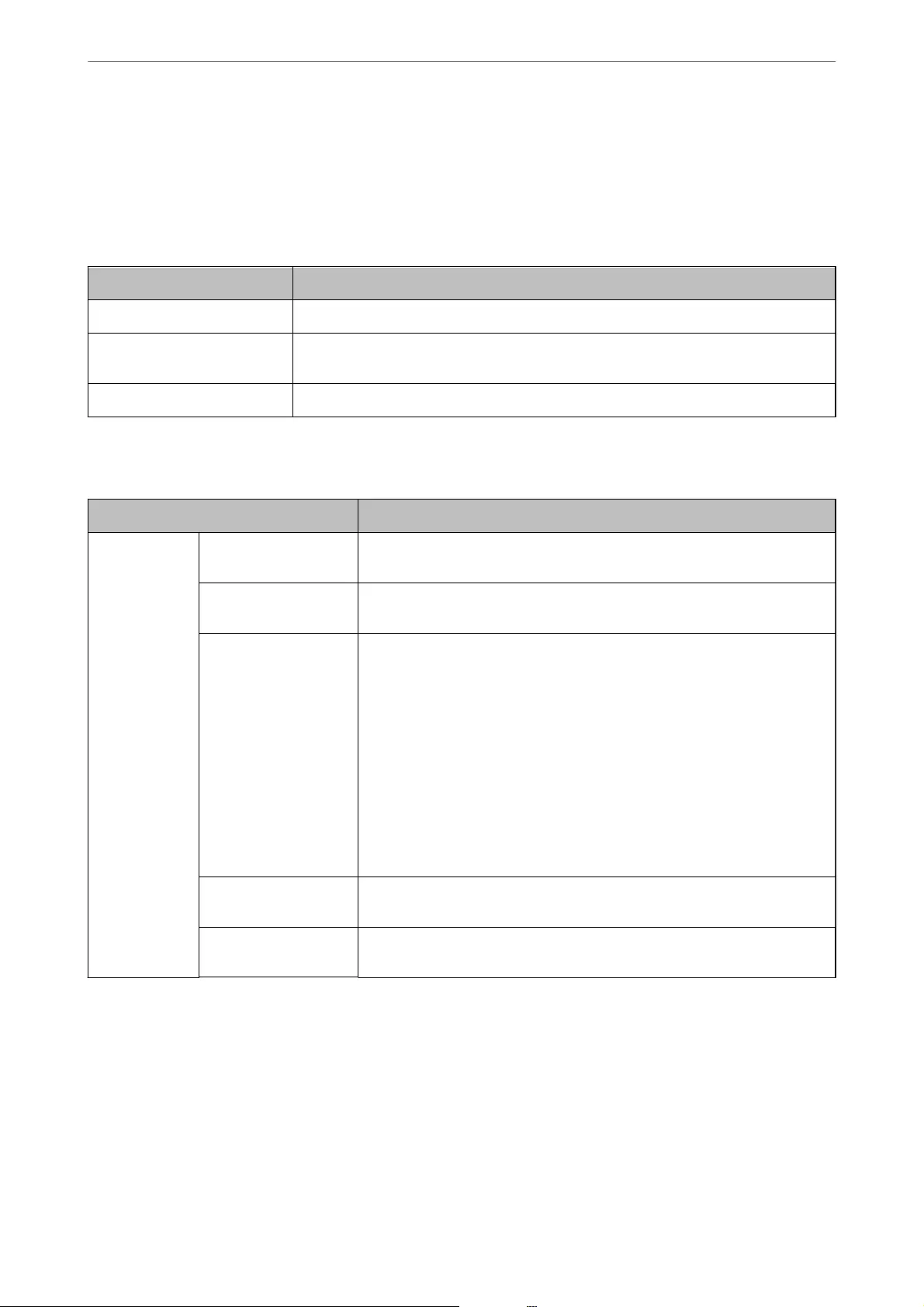
❏IKE Version
Select IKEv1 or IKEv2 for IKE Version. Select one of them according to the device that the printer is connected
to.
❏IKEv1
e following items are displayed when you select IKEv1 for IKE Version.
Items Settings and Explanation
Authentication Method To select Certicate, you need to obtain and import a CA-signed certicate in advance.
Pre-Shared Key If you select Pre-Shared Key for Authentication Method, enter a pre-shared key
between 1 and 127 characters.
Conrm Pre-Shared Key Enter the key you congured for conrmation.
❏IKEv2
e following items are displayed when you select IKEv2 for IKE Version.
Items Settings and Explanation
Local Authentication Method To select Certicate, you need to obtain and import a CA-signed certicate in
advance.
ID Type If you select Pre-Shared Key for Authentication Method, select the type of
ID for the printer.
ID Enter the printer's ID that matches the type of ID.
You cannot use "@", "#", and "=" for the rst character.
Distinguished Name : Enter 1 to 255 1-byte ASCII (0x20 to 0x7E) characters.
You need to include "=".
IP Address : Enter IPv4 or IPv6 format.
FQDN : Enter a combination of between 1 and 255 characters using A-Z, a-z,
0-9, "-", and period (.).
Email Address : Enter 1 to 255 1-byte ASCII (0x20 to 0x7E) characters. You
need to include "@".
Key ID : Enter 1 to 255 1-byte ASCII (0x20 to 0x7E) characters.
Pre-Shared Key If you select Pre-Shared Key for Authentication Method, enter a pre-shared
key between 1 and 127 characters.
Conrm Pre-Shared
Key
Enter the key you congured for conrmation.
Administrator Information
>
Advanced Security Settings
>
Encrypted Communication Using IPsec/IP Filtering
436
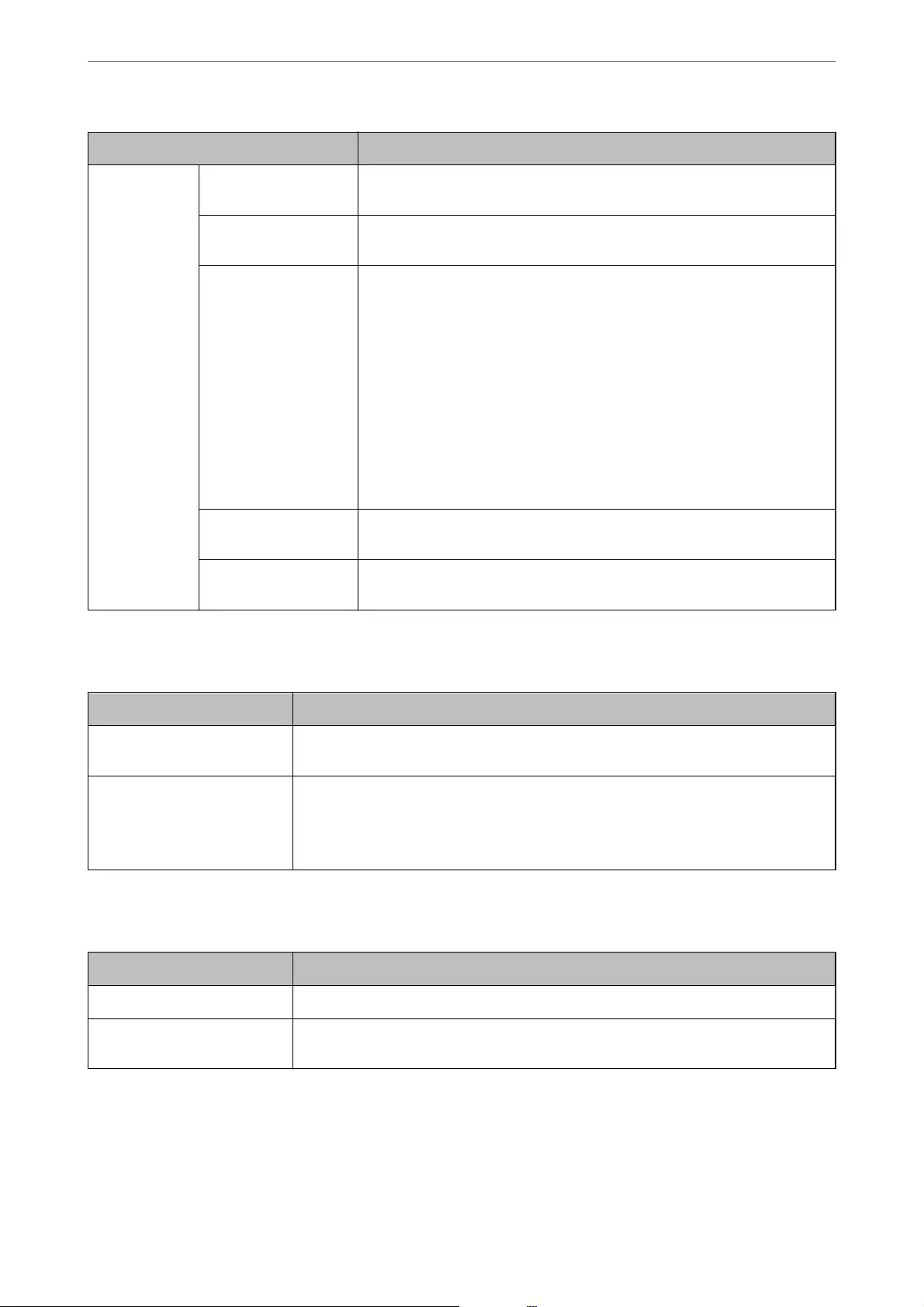
Items Settings and Explanation
Remote Authentication Method To select Certicate, you need to obtain and import a CA-signed certicate in
advance.
ID Type If you select Pre-Shared Key for Authentication Method, select the type of
ID for the device that you want to authenticate.
ID Enter the printer's ID that matches to the type of ID.
You cannot use "@", "#", and "=" for the rst character.
Distinguished Name : Enter 1 to 255 1-byte ASCII (0x20 to 0x7E) characters.
You need to include "=".
IP Address : Enter IPv4 or IPv6 format.
FQDN : Enter a combination of between 1 and 255 characters using A-Z, a-z,
0-9, "-", and period (.).
Email Address : Enter 1 to 255 1-byte ASCII (0x20 to 0x7E) characters. You
need to include "@".
Key ID : Enter 1 to 255 1-byte ASCII (0x20 to 0x7E) characters.
Pre-Shared Key If you select Pre-Shared Key for Authentication Method, enter a pre-shared
key between 1 and 127 characters.
Conrm Pre-Shared
Key
Enter the key you congured for conrmation.
❏Encapsulation
If you select IPsec for Access Control, you need to congure an encapsulation mode.
Items Settings and Explanation
Transport Mode If you only use the printer on the same LAN, select this. IP packets of layer 4 or later are
encrypted.
Tunnel Mode If you use the printer on the Internet-capable network such as IPsec-VPN, select this
option. The header and data of the IP packets are encrypted.
Remote Gateway(Tunnel Mode): If you select Tunnel Mode for Encapsulation, enter a
gateway address between 1 and 39 characters.
❏Security Protocol
If you select IPsec for Access Control, select an option.
Items Settings and Explanation
ESP Select this to ensure the integrity of an authentication and data, and encrypt data.
AH Select this to ensure the integrity of an authentication and data. Even if encrypting data is
prohibited, you can use IPsec.
Administrator Information
>
Advanced Security Settings
>
Encrypted Communication Using IPsec/IP Filtering
437
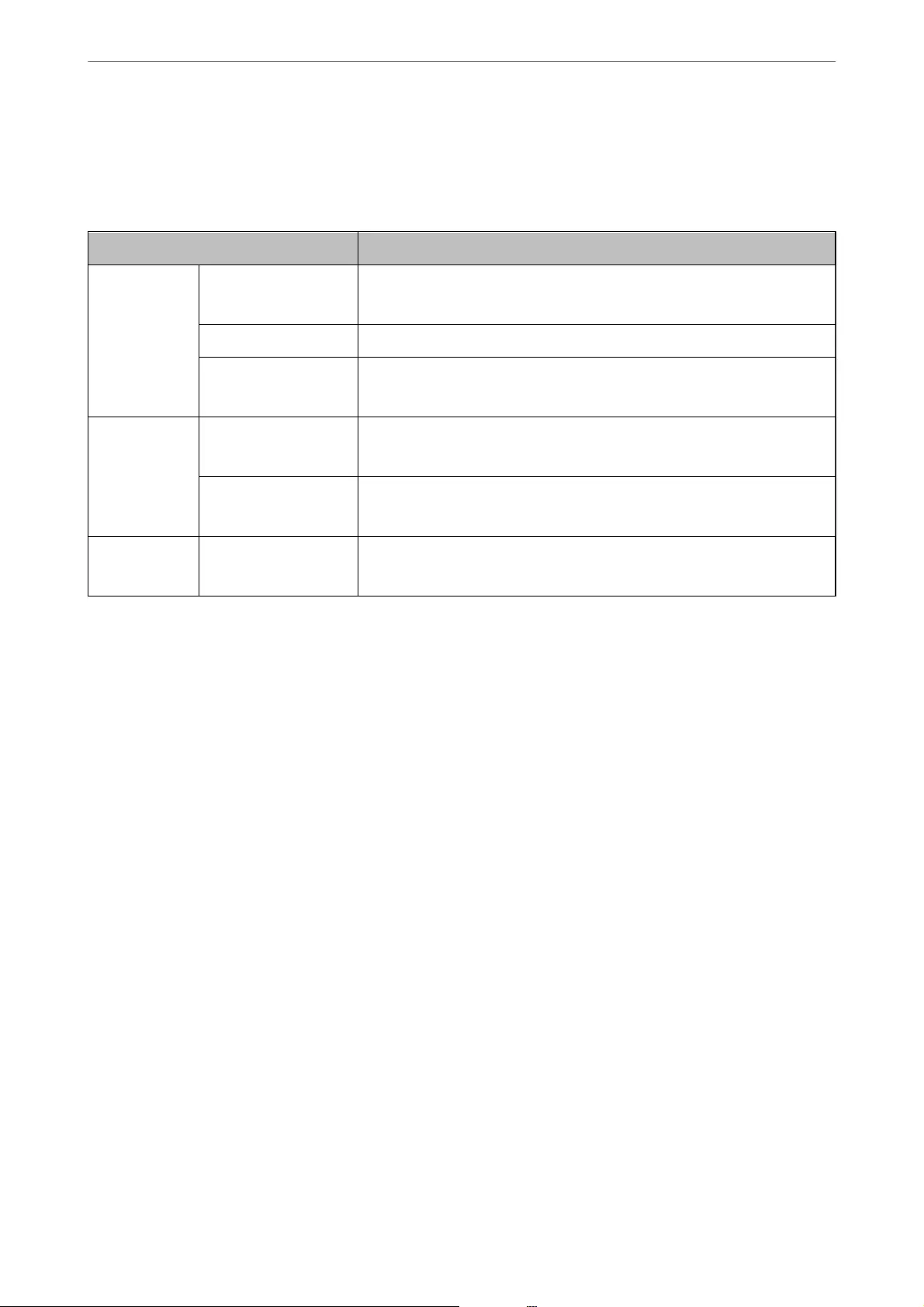
❏Algorithm Settings
It is recommended that you select Any for all settings or select an item other than Any for each setting. If you
select Any for some of the settings and select an item other than Any for the other settings, the device may not
communicate depending on the other device that you want to authenticate.
Items Settings and Explanation
IKE Encryption Select the encryption algorithm for IKE.
The items vary depending on the version of IKE.
Authentication Select the authentication algorithm for IKE.
Key Exchange Select the key exchange algorithm for IKE.
The items vary depending on the version of IKE.
ESP Encryption Select the encryption algorithm for ESP.
This is available when ESP is selected for Security Protocol.
Authentication Select the authentication algorithm for ESP.
This is available when ESP is selected for Security Protocol.
AH Authentication Select the encryption algorithm for AH.
This is available when AH is selected for Security Protocol.
Related Information
&“Conguring Default Policy” on page 435
Conguring Group Policy
A group policy is one or more rules applied to a user or user group. e printer controls IP packets that match with
congured policies. IP packets are authenticated in the order of a group policy 1 to 10 then a default policy.
1. Access Web Cong and then select the Network Security tab > IPsec/IP Filtering > Basic.
2. Click a numbered tab you want to congure.
3. Enter a value for each item.
4. Click Next.
A conrmation message is displayed.
5. Click OK.
e printer is updated.
Related Information
&“Application for Conguring Printer Operations (Web Cong)” on page 301
Administrator Information
>
Advanced Security Settings
>
Encrypted Communication Using IPsec/IP Filtering
438
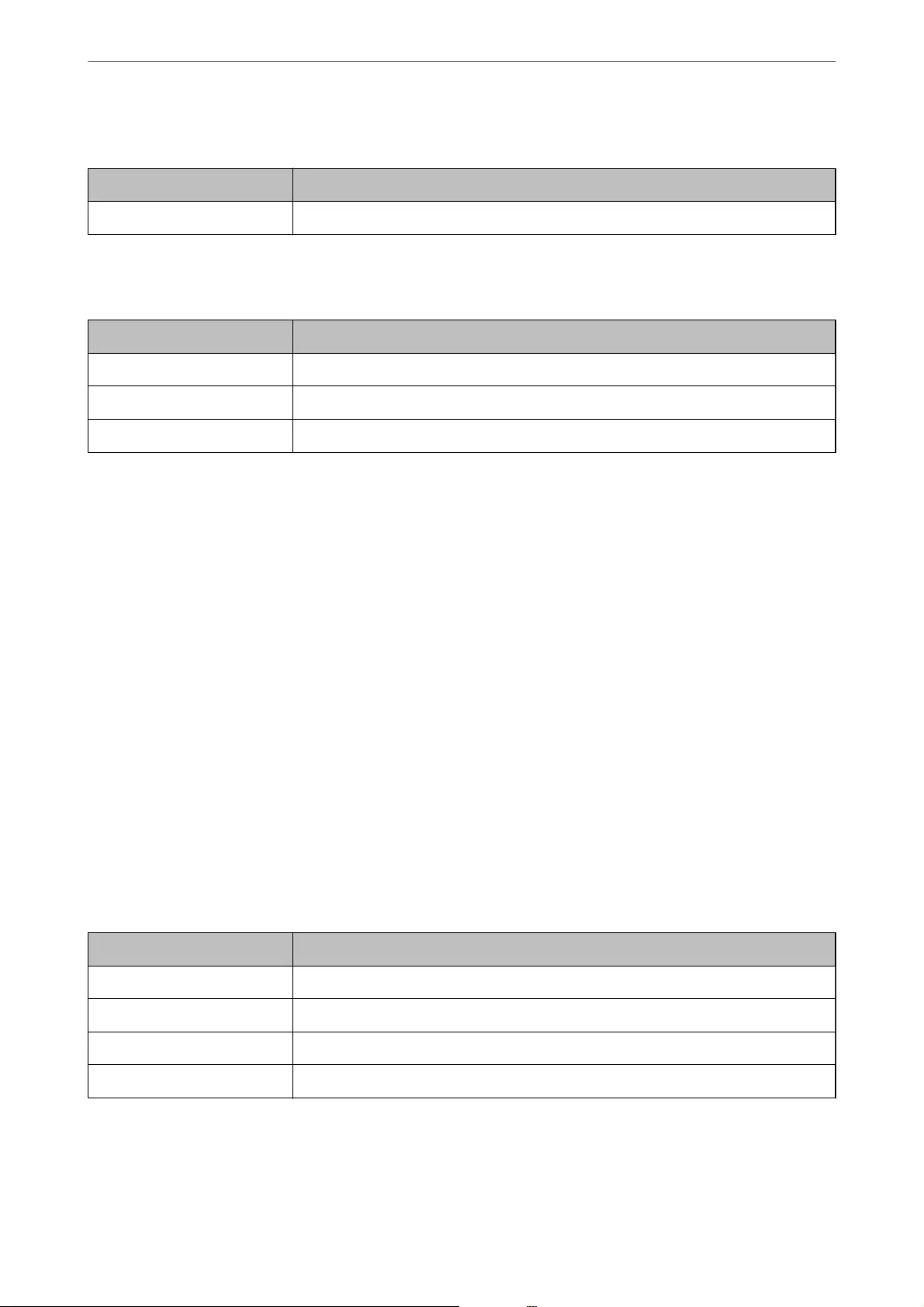
Group Policy Setting Items
Items Settings and Explanation
Enable this Group Policy You can enable or disable a group policy.
Access Control
Congure a control method for trac of IP packets.
Items Settings and Explanation
Permit Access Select this to permit congured IP packets to pass through.
Refuse Access Select this to refuse congured IP packets to pass through.
IPsec Select this to permit congured IPsec packets to pass through.
Local Address(Printer)
Select an IPv4 address or IPv6 address that matches your network environment. If an IP address is assigned
automatically, you can select Use auto-obtained IPv4 address.
Note:
If an IPv6 address is assigned automatically, the connection may be unavailable. Congure a static IPv6 address.
Remote Address(Host)
Enter a device's IP address to control access. e IP address must be 43 characters or less. If you do not enter an IP
address, all addresses are controlled.
Note:
If an IP address is assigned automatically (e.g. assigned by DHCP), the connection may be unavailable. Congure a static IP
address.
Method of Choosing Port
Select a method to specify ports.
❏Service Name
If you select Service Name for Method of Choosing Port, select an option.
❏Transport Protocol
If you select Port Number for Method of Choosing Port, you need to congure an encapsulation mode.
Items Settings and Explanation
Any Protocol Select this to control all protocol types.
TCP Select this to control data for unicast.
UDP Select this to control data for broadcast and multicast.
ICMPv4 Select this to control ping command.
Administrator Information
>
Advanced Security Settings
>
Encrypted Communication Using IPsec/IP Filtering
439
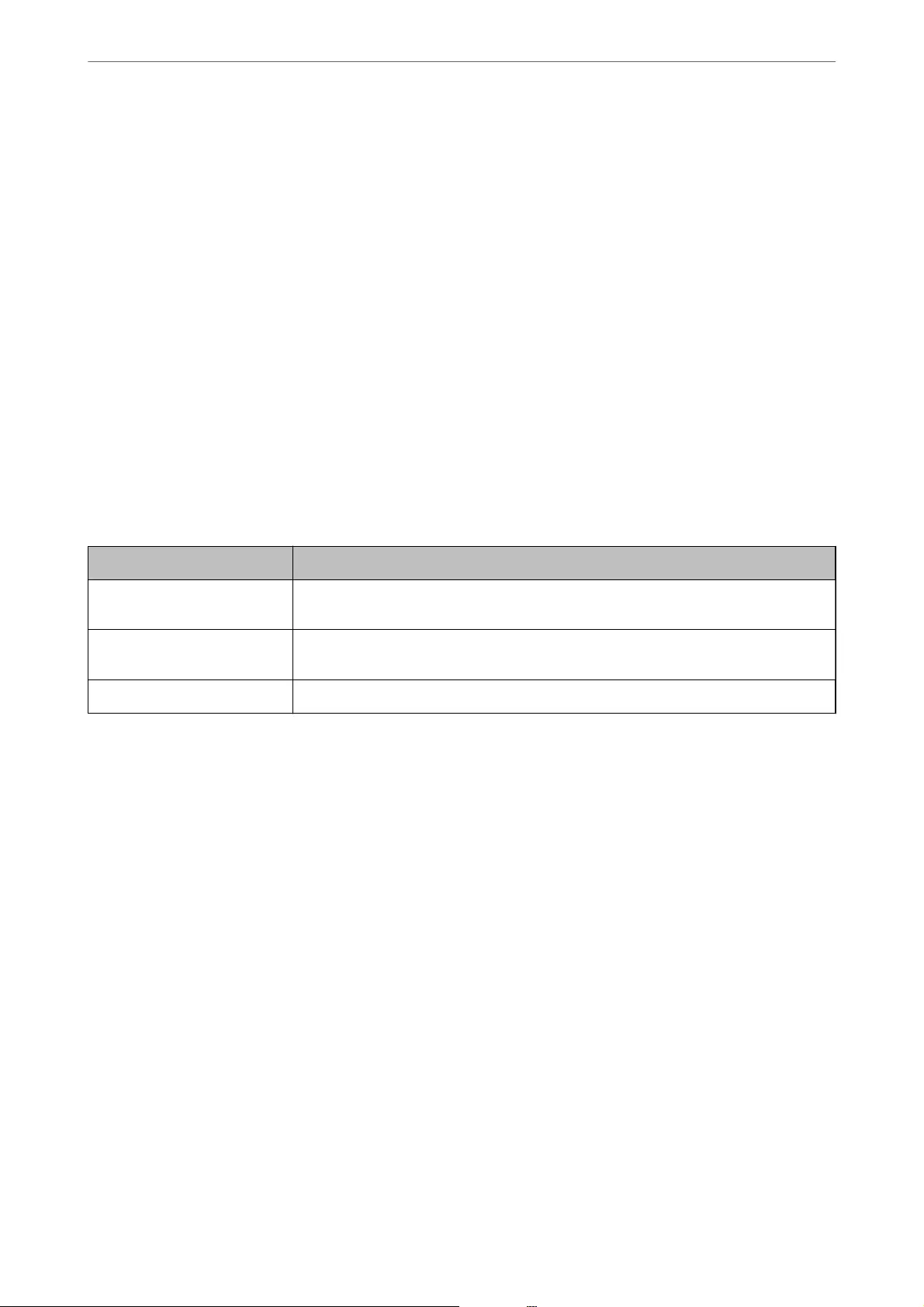
❏Local Port
If you select Port Number for Method of Choosing Port and if you select TCP or UDP for Transport
Protocol, enter port numbers to control receiving packets, separating them with commas. You can enter 10 port
numbers at the maximum.
Example: 20,80,119,5220
If you do not enter a port number, all ports are controlled.
❏Remote Port
If you select Port Number for Method of Choosing Port and if you select TCP or UDP for Transport
Protocol, enter port numbers to control sending packets, separating them with commas. You can enter 10 port
numbers at the maximum.
Example: 25,80,143,5220
If you do not enter a port number, all ports are controlled.
IKE Version
Select IKEv1 or IKEv2 for IKE Version. Select one of them according to the device that the printer is connected to.
❏IKEv1
e following items are displayed when you select IKEv1 for IKE Version.
Items Settings and Explanation
Authentication Method If you select IPsec for Access Control, select an option. Used certicate is common with a
default policy.
Pre-Shared Key If you select Pre-Shared Key for Authentication Method, enter a pre-shared key
between 1 and 127 characters.
Conrm Pre-Shared Key Enter the key you congured for conrmation.
Administrator Information
>
Advanced Security Settings
>
Encrypted Communication Using IPsec/IP Filtering
440
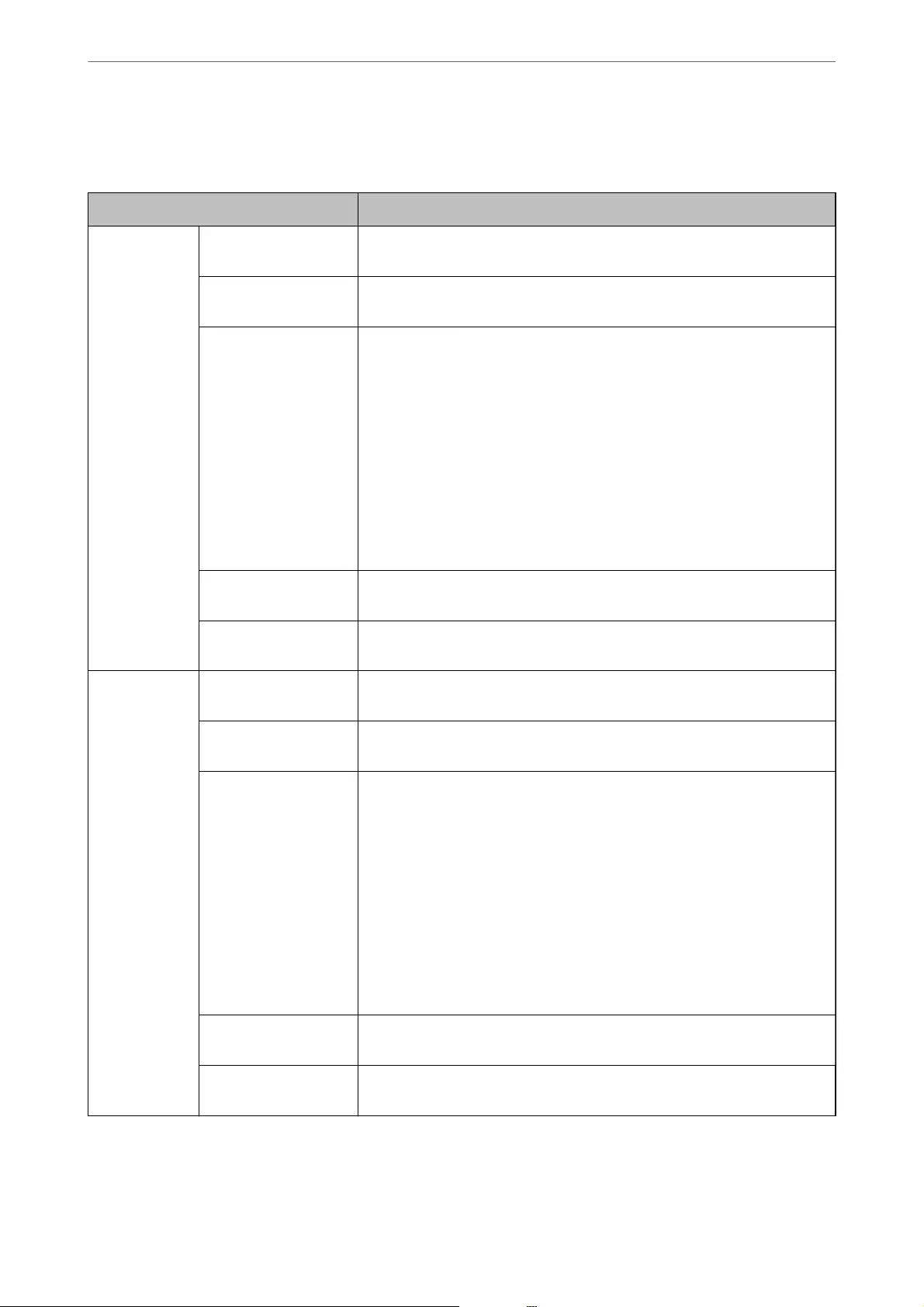
❏IKEv2
e following items are displayed when you select IKEv2 for IKE Version.
Items Settings and Explanation
Local Authentication Method If you select IPsec for Access Control, select an option. Used certicate is
common with a default policy.
ID Type If you select Pre-Shared Key for Authentication Method, select the type of
ID for the printer.
ID Enter the printer's ID that matches the type of ID.
You cannot use "@", "#", and "=" for the rst character.
Distinguished Name : Enter 1 to 255 1-byte ASCII (0x20 to 0x7E) characters.
You need to include "=".
IP Address : Enter IPv4 or IPv6 format.
FQDN : Enter a combination of between 1 and 255 characters using A-Z, a-z,
0-9, "-", and period (.).
Email Address : Enter 1 to 255 1-byte ASCII (0x20 to 0x7E) characters. You
need to include "@".
Key ID : Enter 1 to 255 1-byte ASCII (0x20 to 0x7E) characters.
Pre-Shared Key If you select Pre-Shared Key for Authentication Method, enter a pre-shared
key between 1 and 127 characters.
Conrm Pre-Shared
Key
Enter the key you congured for conrmation.
Remote Authentication Method If you select IPsec for Access Control, select an option. Used certicate is
common with a default policy.
ID Type If you select Pre-Shared Key for Authentication Method, select the type of
ID for the device that you want to authenticate.
ID Enter the printer's ID that matches to the type of ID.
You cannot use "@", "#", and "=" for the rst character.
Distinguished Name : Enter 1 to 255 1-byte ASCII (0x20 to 0x7E) characters.
You need to include "=".
IP Address : Enter IPv4 or IPv6 format.
FQDN : Enter a combination of between 1 and 255 characters using A-Z, a-z,
0-9, "-", and period (.).
Email Address : Enter 1 to 255 1-byte ASCII (0x20 to 0x7E) characters. You
need to include "@".
Key ID : Enter 1 to 255 1-byte ASCII (0x20 to 0x7E) characters.
Pre-Shared Key If you select Pre-Shared Key for Authentication Method, enter a pre-shared
key between 1 and 127 characters.
Conrm Pre-Shared
Key
Enter the key you congured for conrmation.
Encapsulation
If you select IPsec for Access Control, you need to congure an encapsulation mode.
Administrator Information
>
Advanced Security Settings
>
Encrypted Communication Using IPsec/IP Filtering
441
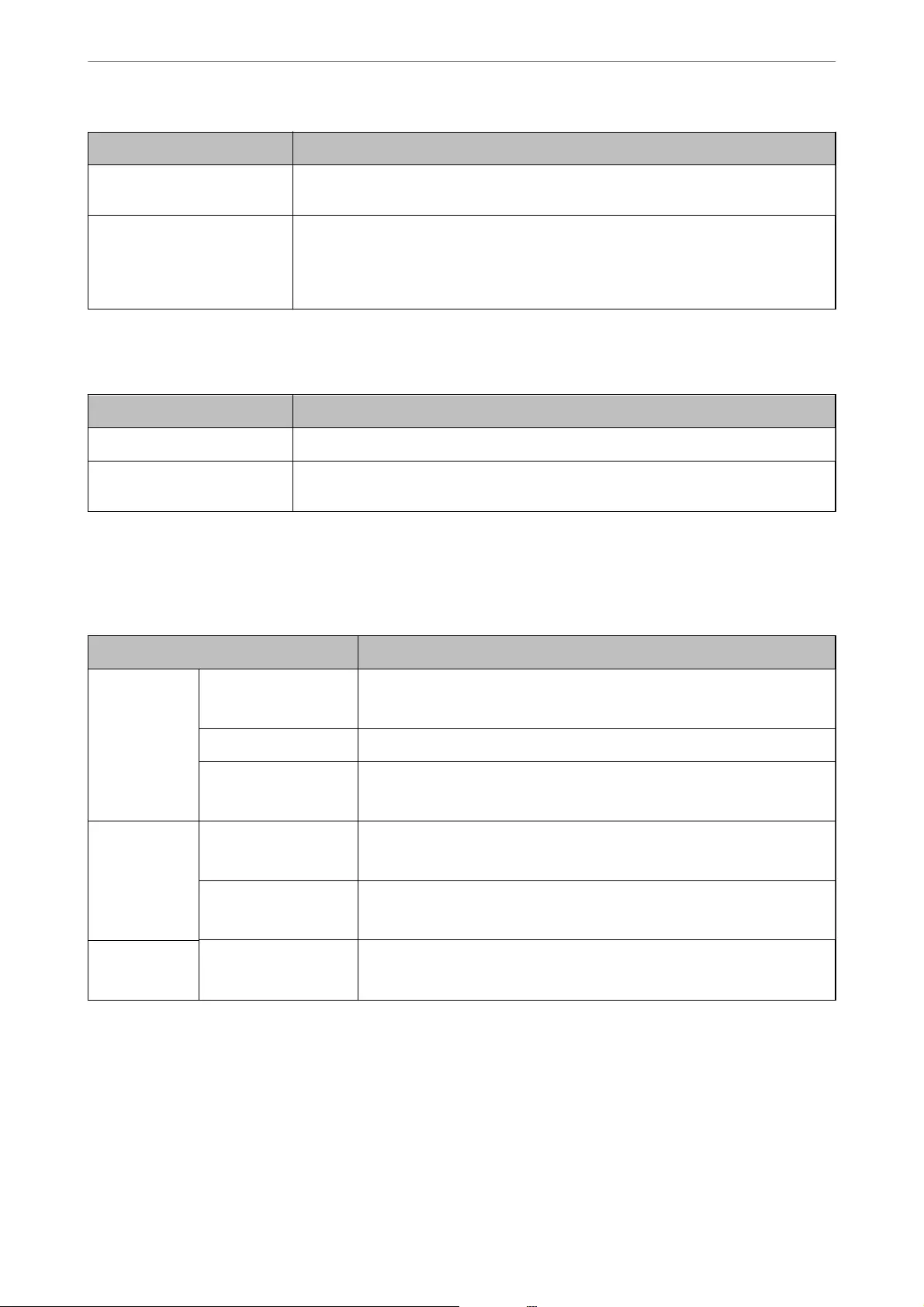
Items Settings and Explanation
Transport Mode If you only use the printer on the same LAN, select this. IP packets of layer 4 or later are
encrypted.
Tunnel Mode If you use the printer on the Internet-capable network such as IPsec-VPN, select this
option. The header and data of the IP packets are encrypted.
Remote Gateway(Tunnel Mode): If you select Tunnel Mode for Encapsulation, enter a
gateway address between 1 and 39 characters.
Security Protocol
If you select IPsec for Access Control, select an option.
Items Settings and Explanation
ESP Select this to ensure the integrity of an authentication and data, and encrypt data.
AH Select this to ensure the integrity of an authentication and data. Even if encrypting data is
prohibited, you can use IPsec.
Algorithm Settings
It is recommended that you select Any for all settings or select an item other than Any for each setting. If you
select Any for some of the settings and select an item other than Any for the other settings, the device may not
communicate depending on the other device that you want to authenticate.
Items Settings and Explanation
IKE Encryption Select the encryption algorithm for IKE.
The items vary depending on the version of IKE.
Authentication Select the authentication algorithm for IKE.
Key Exchange Select the key exchange algorithm for IKE.
The items vary depending on the version of IKE.
ESP Encryption Select the encryption algorithm for ESP.
This is available when ESP is selected for Security Protocol.
Authentication Select the authentication algorithm for ESP.
This is available when ESP is selected for Security Protocol.
AH Authentication Select the encryption algorithm for AH.
This is available when AH is selected for Security Protocol.
Related Information
&“Conguring Group Policy” on page 438
&“Combination of Local Address(Printer) and Remote Address(Host) on Group Policy” on page 443
&“References of Service Name on Group Policy” on page 443
Administrator Information
>
Advanced Security Settings
>
Encrypted Communication Using IPsec/IP Filtering
442
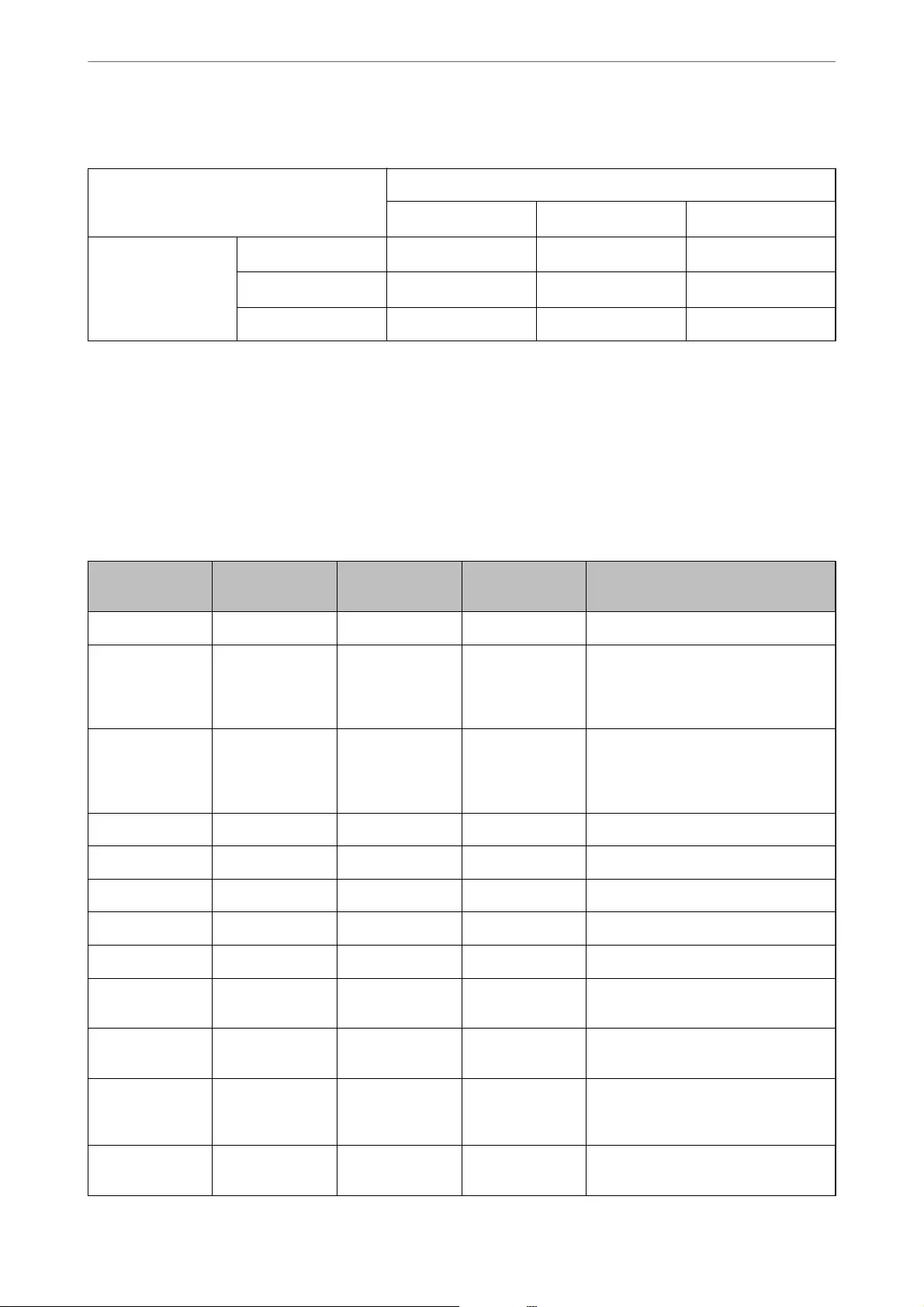
Combination of Local Address(Printer) and Remote Address(Host) on Group Policy
Setting of Local Address(Printer)
IPv4 IPv6
*2
Any addresses
*3
Setting of Remote
Address(Host)
IPv4
*1
✓–✓
IPv6
*1*2
–✓✓
Blank ✓✓✓
*1If IPsec is selected for Access Control, you cannot specify in a prex length.
*2If IPsec is selected for Access Control, you can select a link-local address (fe80::) but group policy will be disabled.
*3Except IPv6 link local addresses.
References of Service Name on Group Policy
Note:
Unavailable services are displayed but cannot be selected.
Service Name Protocol type Local port
number
Remote port
number
Features controlled
Any – – – All services
ENPC UDP 3289 Any port Searching for a printer from
applications such as Epson Device
Admin, a printer driver and the a
scanner driver
SNMP UDP 161 Any port Acquiring and conguring of MIB from
applications such as Epson Device
Admin, the Epson printer driver and
the Epson scanner driver
LPR TCP 515 Any port Forwarding LPR data
RAW (Port9100) TCP 9100 Any port Forwarding RAW data
IPP/IPPS TCP 631 Any port Forwarding data of IPP/IPPS printing
WSD TCP Any port 5357 Controlling WSD
WS-Discovery UDP 3702 Any port Searching for a printer from WSD
Network Scan TCP 1865 Any port Forwarding scan data from the
scanning software
Network Push
Scan
TCP Any port 2968 Acquiring job information of push
scanning from the scanning software
Network Push
Scan Discovery
UDP 2968 Any port Searching for a computer when push
scanning from the scanning software
is executed
FTP Data (Local) TCP 20 Any port FTP server (forwarding data of FTP
printing)
Administrator Information
>
Advanced Security Settings
>
Encrypted Communication Using IPsec/IP Filtering
443
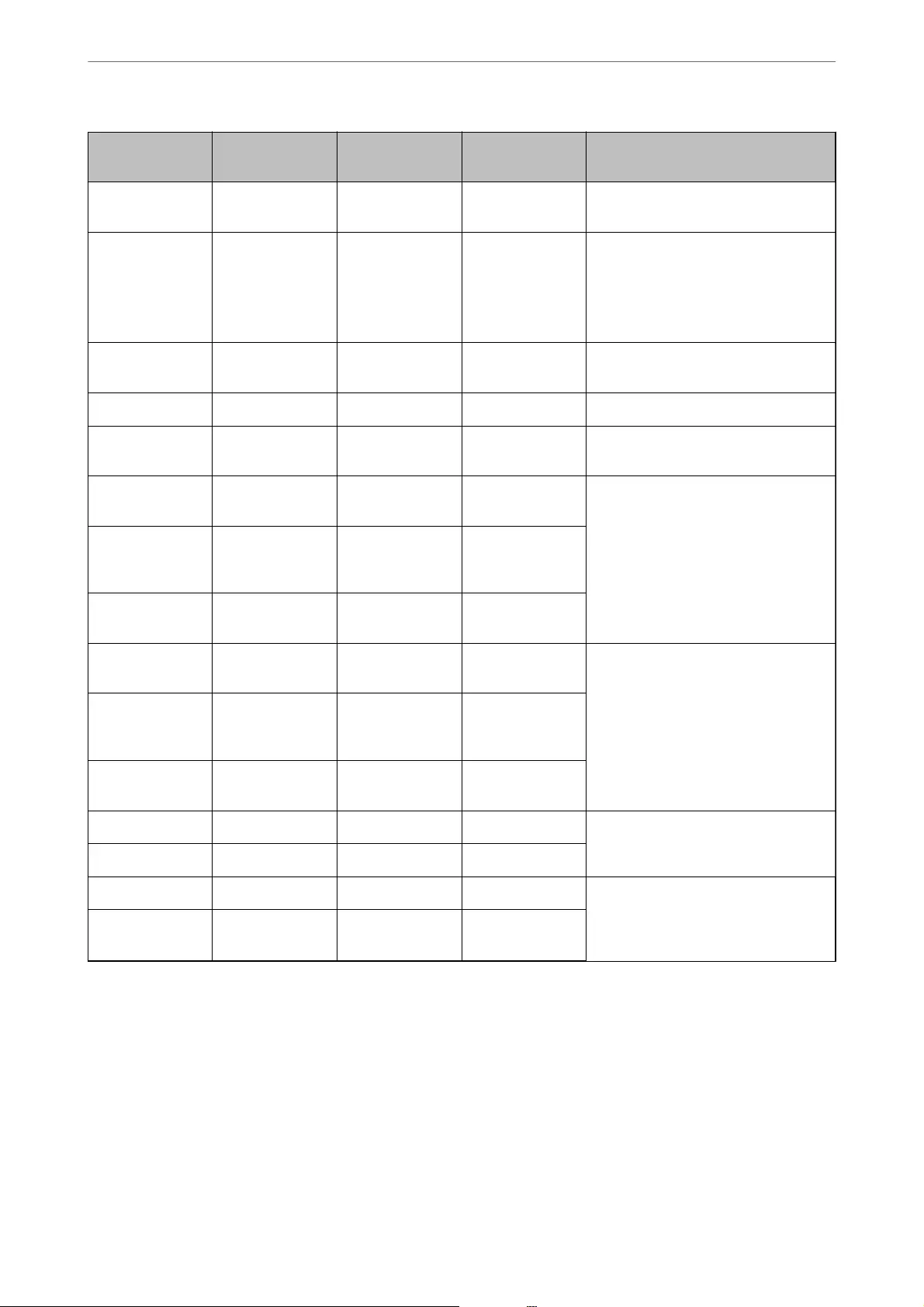
Service Name Protocol type Local port
number
Remote port
number
Features controlled
FTP Control
(Local)
TCP 21 Any port FTP server (controlling FTP printing)
FTP Data
(Remote)
TCP Any port 20 FTP client (forwarding scan data and
received fax data)
However this can control only an FTP
server that uses remote port number
20.
FTP Control
(Remote)
TCP Any port 21 FTP client (controlling to forward scan
data and received fax data)
CIFS (Local) TCP 445 Any port CIFS server (Sharing a network folder)
CIFS (Remote) TCP Any port 445 CIFS client (forwarding scan data and
received fax data to a folder)
NetBIOS Name
Service (Local)
UDP 137 Any port CIFS server (Sharing a network folder)
NetBIOS
Datagram
Service (Local)
UDP 138 Any port
NetBIOS Session
Service (Local)
TCP 139 Any port
NetBIOS Name
Service (Remote)
UDP Any port 137 CIFS client (forwarding scan data and
received fax data to a folder)
NetBIOS
Datagram
Service (Remote)
UDP Any port 138
NetBIOS Session
Service (Remote)
TCP Any port 139
HTTP (Local) TCP 80 Any port HTTP(S) server (forwarding data of
Web Cong and WSD)
HTTPS (Local) TCP 443 Any port
HTTP (Remote) TCP Any port 80 HTTP(S) client (communicating
between Epson Connect, rmware
updating and root certicate
updating)
HTTPS (Remote) TCP Any port 443
Conguration Examples of IPsec/IP Filtering
Receiving IPsec packets only
is example is to congure a default policy only.
Default Policy:
❏IPsec/IP Filtering: Enable
❏Access Control: IPsec
Administrator Information
>
Advanced Security Settings
>
Encrypted Communication Using IPsec/IP Filtering
444

❏Authentication Method: Pre-Shared Key
❏Pre-Shared Key: Enter up to 127 characters.
Group Policy: Do not congure.
Receiving printing data and printer settings
is example allows communications of printing data and printer conguration from specied services.
Default Policy:
❏IPsec/IP Filtering: Enable
❏Access Control: Refuse Access
Group Policy:
❏Enable this Group Policy: Check the box.
❏Access Control: Permit Access
❏Remote Address(Host): IP address of a client
❏Method of Choosing Port: Service Name
❏Service Name: Check the box of ENPC, SNMP, HTTP (Local), HTTPS (Local) and RAW (Port9100).
Note:
To avoid receiving HTTP (Local) and HTTPS (Local), clear their checkboxes in Group Policy. When doing so, disable
IPsec/IP ltering from the printer's control panel temporarily to change the printer settings.
Receiving access from a specied IP address only
is example allows a specied IP address to access the printer.
Default Policy:
❏IPsec/IP Filtering: Enable
❏Access Control:Refuse Access
Group Policy:
❏Enable this Group Policy: Check the box.
❏Access Control: Permit Access
❏Remote Address(Host): IP address of an administrator’s client
Note:
Regardless of policy conguration, the client will be able to access and congure the printer.
Conguring a Certicate for IPsec/IP Filtering
Congure the Client Certicate for IPsec/IP Filtering. When you set it, you can use the certicate as an
authentication method for IPsec/IP Filtering. If you want to congure the certication authority, go to CA
Certicate.
1. Access Web Cong and then select the Network Security tab > IPsec/IP Filtering > Client Certicate.
Administrator Information
>
Advanced Security Settings
>
Encrypted Communication Using IPsec/IP Filtering
445
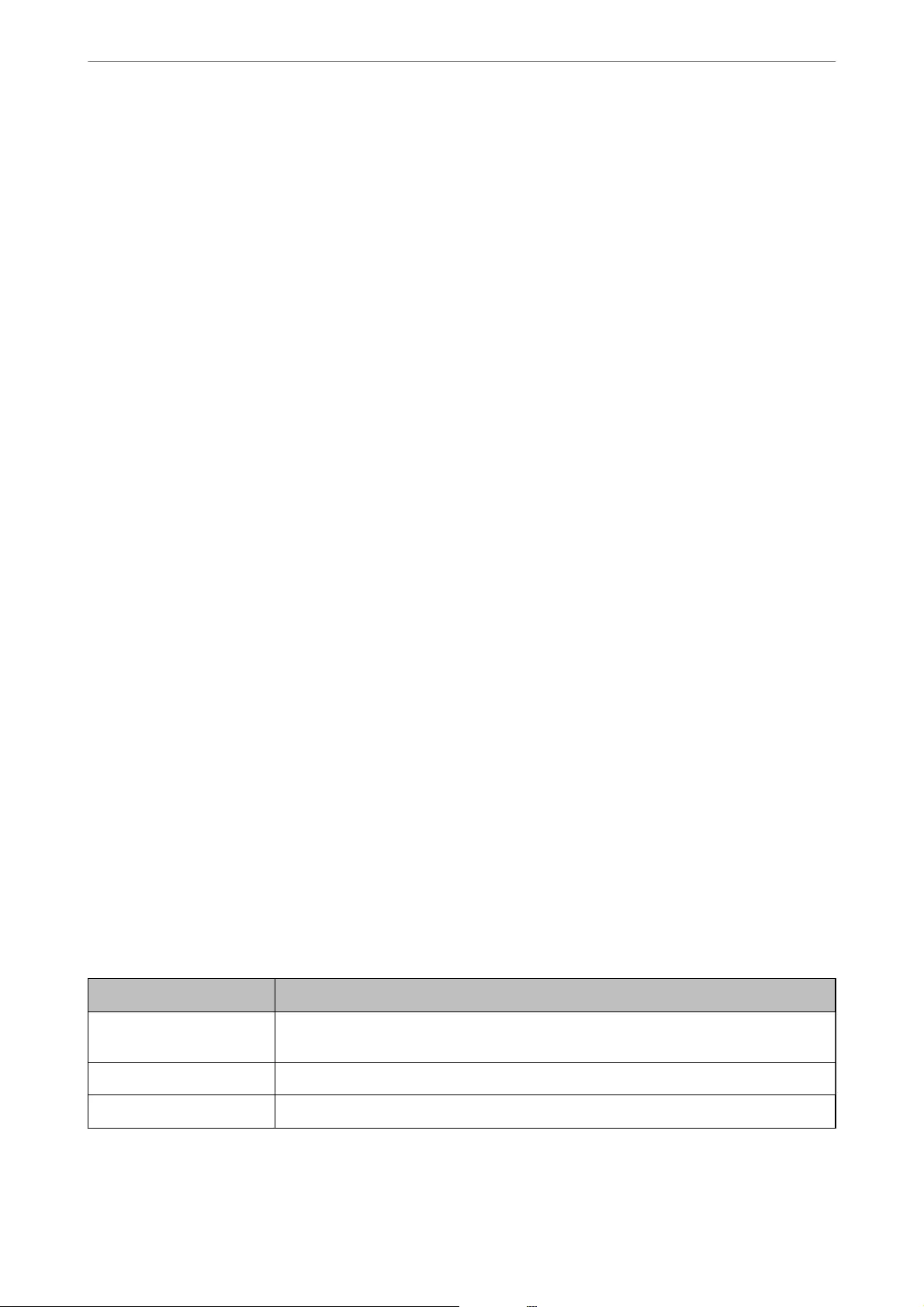
2. Import the certicate in Client Certicate.
If you have already imported a certicate published by a Certication Authority, you can copy the certicate
and use it in IPsec/IP Filtering. To copy, select the certicate from Copy From, and then click Copy.
Related Information
&“Application for Conguring Printer Operations (Web Cong)” on page 301
&“Conguring a CA-signed Certicate” on page 428
&“Conguring a CA Certicate” on page 432
Connecting the Printer to an IEEE802.1X Network
Conguring an IEEE802.1X Network
When you set IEEE802.1X to the printer, you can use it on the network connected to a RADIUS server, a LAN
switch with authentication function, or an access point.
1. Access Web Cong and then select the Network Security tab > IEEE802.1X > Basic.
2. Enter a value for each item.
If you want to use the printer on a Wi-Fi network, click Wi-Fi Setup and select or enter an SSID.
Note:
You can share settings between Ethernet and Wi-Fi.
3. Click Next.
A conrmation message is displayed.
4. Click OK.
e printer is updated.
Related Information
&“Application for Conguring Printer Operations (Web Cong)” on page 301
IEEE802.1X Network Setting Items
Items Settings and Explanation
IEEE802.1X (Wired LAN) You can enable or disable settings of the page (IEEE802.1X > Basic) for IEEE802.1X (Wired
LAN).
IEEE802.1X (Wi-Fi) The connection status of IEEE802.1X (Wi-Fi) is displayed.
Connection Method The connection method of a current network is displayed.
Administrator Information
>
Advanced Security Settings
>
Connecting the Printer to an IEEE802.1X Network
446
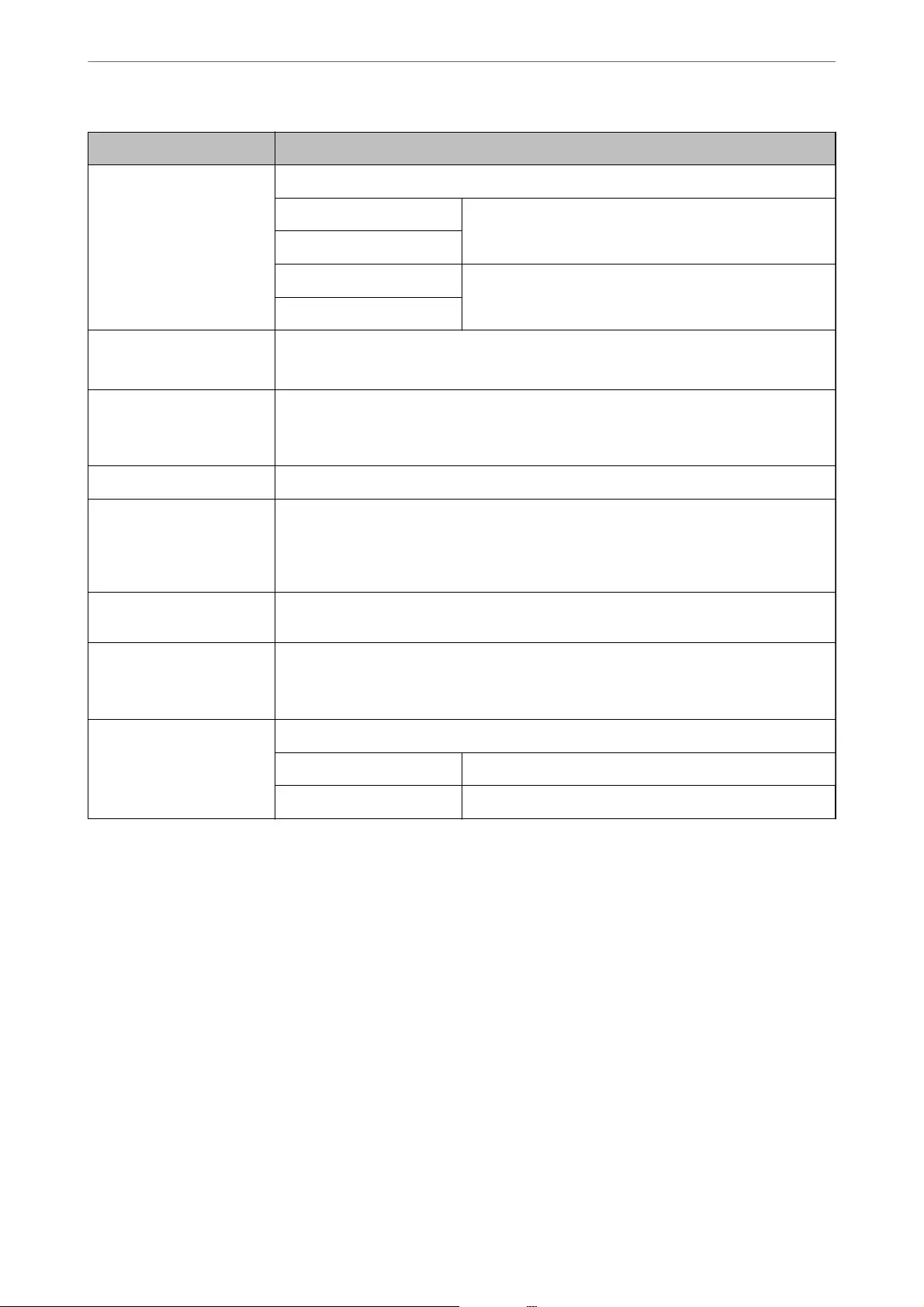
Items Settings and Explanation
EAP Type Select an option for an authentication method between the printer and a RADIUS server.
EAP-TLS You need to obtain and import a CA-signed certicate.
PEAP-TLS
EAP-TTLS You need to congure a password.
PEAP/MSCHAPv2
User ID Congure an ID to use for an authentication of a RADIUS server.
Enter 1 to 128 1-byte ASCII (0x20 to 0x7E) characters.
Password Congure a password to authenticate the printer.
Enter 1 to 128 1-byte ASCII (0x20 to 0x7E) characters. If you are using a Windows server as a
RADIUS server, you can enter up to 127 characters.
Conrm Password Enter the password you congured for conrmation.
Server ID You can congure a server ID to authenticate with a specied RADIUS server. Authenticator
veries whether a server ID is contained in the subject/subjectAltName eld of a server
certicate that is sent from a RADIUS server or not.
Enter 0 to 128 1-byte ASCII (0x20 to 0x7E) characters.
Certicate Validation You can set certicate validation regardless of the authentication method. Import the
certicate in CA Certicate.
Anonymous Name If you select PEAP-TLS, EAP-TTLS or PEAP/MSCHAPv2 for EAP Type, you can congure an
anonymous name instead of a user ID for a phase 1 of a PEAP authentication.
Enter 0 to 128 1-byte ASCII (0x20 to 0x7E) characters.
Encryption Strength You can select one of the followings.
High AES256/3DES
Middle AES256/3DES/AES128/RC4
Related Information
&“Conguring an IEEE802.1X Network” on page 446
Conguring a Certicate for IEEE802.1X
Congure the Client Certicate for IEEE802.1X. When you set it, you can use EAP-TLS and PEAP-TLS as an
authentication method of IEEE802.1x. If you want to congure the certication authority certicate, go to CA
Certicate.
1. Access Web Cong and then select the Network Security tab > IEEE802.1X > Client Certicate.
2. Enter a certicate in the Client Certicate.
If you have already imported a certicate published by a Certication Authority, you can copy the certicate
and use it in IEEE802.1X. To copy, select the certicate from Copy From, and then click Copy.
Administrator Information
>
Advanced Security Settings
>
Connecting the Printer to an IEEE802.1X Network
447
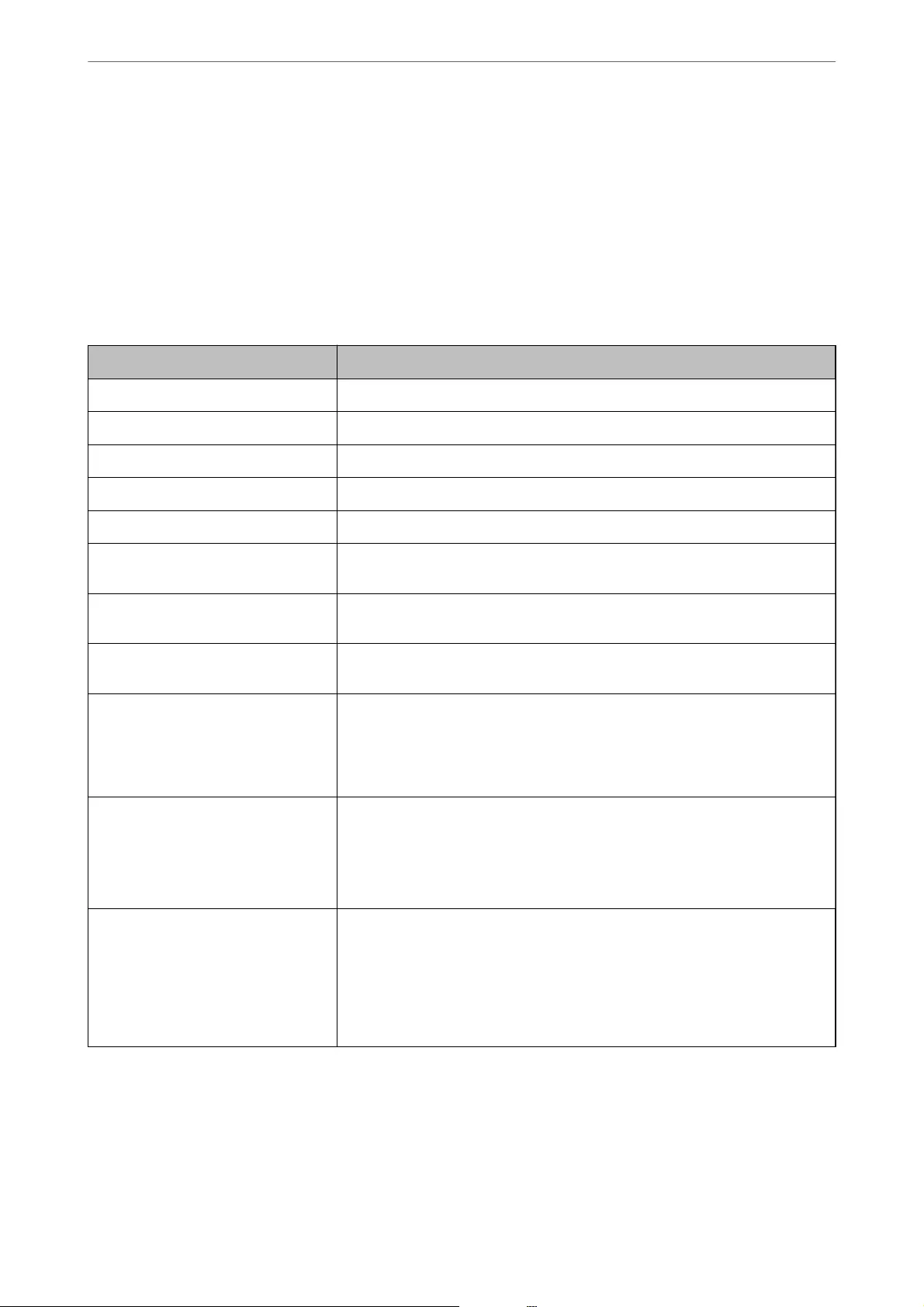
Related Information
&“Application for Conguring Printer Operations (Web Cong)” on page 301
&“Conguring a CA-signed Certicate” on page 428
&“Conguring a CA Certicate” on page 432
Checking IEEE802.1X Network Status
You can check the IEEE802.1X status by printing a network status sheet.
Status ID IEEE802.1X Status
Disable IEEE802.1X feature is disable.
EAP Success IEEE802.1X authentication has succeeded and network connection is available.
Authenticating IEEE802.1X authentication has not been completed.
Cong Error Authentication has failed since the user ID has not been set.
Client Certicate Error Authentication has failed since the client certicate is out of date.
Timeout Error Authentication has failed since there is no answer from the RADIUS server and/or
authenticator.
User ID Error Authentication has failed since the printer's user ID and/or certicate protocol is
incorrect.
Server ID Error Authentication has failed since the server ID of the server certicate and the
server's ID do not match.
Server Certicate Error Authentication has failed since there are the following errors in the server
certicate.
❏The server certicate is out of date.
❏The chain of the server certicate is incorrect.
CA Certicate Error Authentication has failed since there are the following errors in a CA certicate.
❏Specied CA certicate is incorrect.
❏The correct CA certicate is not imported.
❏CA certicate is out of date.
EAP Failure Authentication has failed since there are the following errors in the printer
settings.
❏If EAP Type is EAP-TLS or PEAP-TLS, client certicate is incorrect or has
certain problems.
❏If EAP Type is EAP-TTLS or PEAP/MSCHAPv2, user ID or password is not
correct.
Related Information
&“Printing a Network Status Sheet” on page 286
Administrator Information
>
Advanced Security Settings
>
Connecting the Printer to an IEEE802.1X Network
448
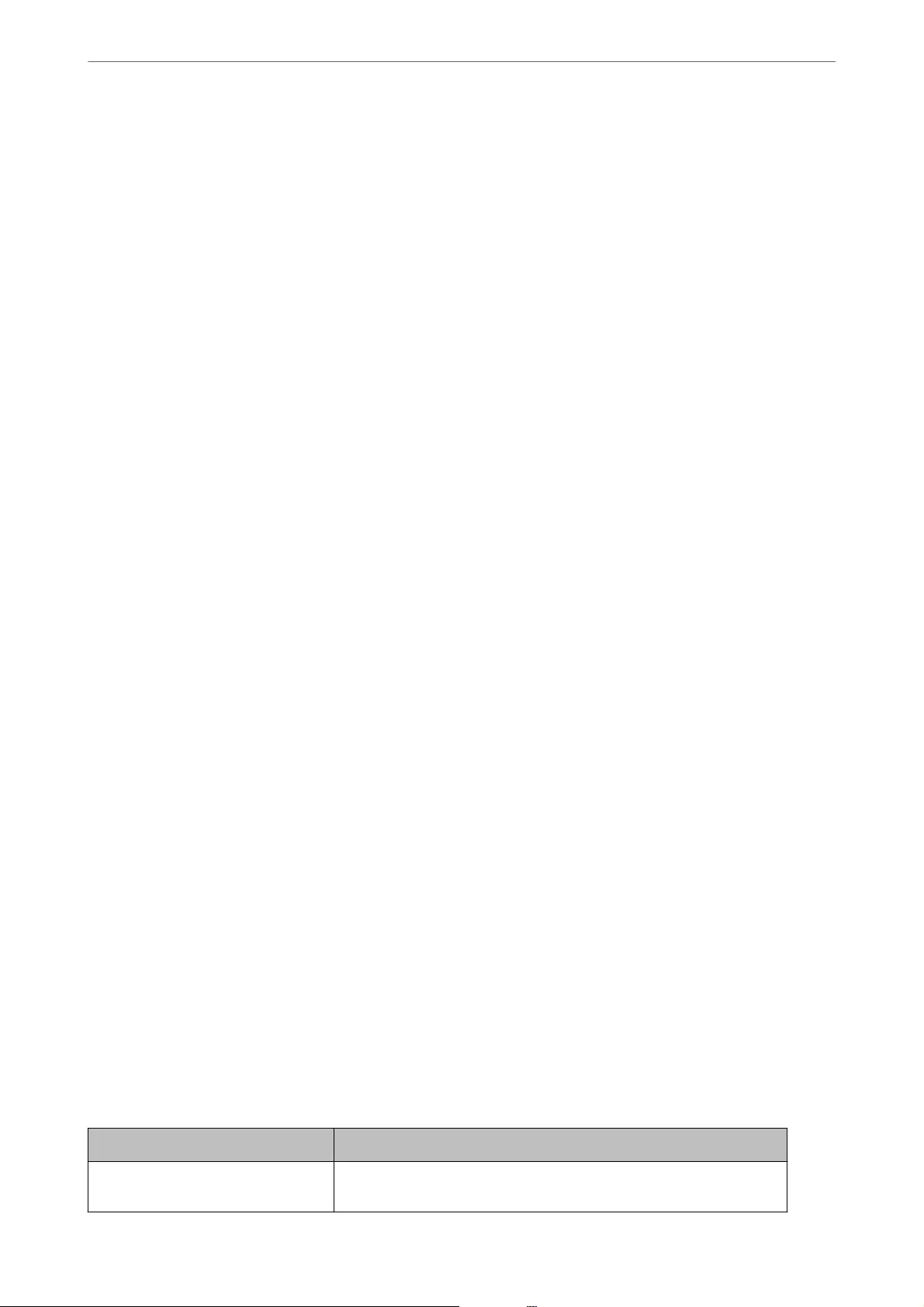
Solving Problems for Advanced Security
Restoring the Security Settings
When you establish a highly secure environment such as IPsec/IP Filtering or IEEE802.1X, you may not be able to
communicate with devices because of incorrect settings or trouble with the device or server. In this case, restore
the security settings in order to make settings for the device again or to allow you temporary use.
Disabling the Security Function Using the Control Panel
You can disable IPsec/IP Filtering or IEEE802.1X using the printer's control panel.
1. Select Settings > General Settings > Network Settings.
2. Select Advanced.
3. Select from the following items that you want to disable.
❏Disable IPsec/IP Filtering
❏Disable IEEE802.1X
4. Select Start Setup on the conrmation screen.
Problems Using Network Security Features
Forgot a Pre–shared Key
Re-congure a pre-shared key.
To change the key, access Web Cong and select the Network Security tab > IPsec/IP Filtering > Basic > Default
Policy or Group Policy.
When you change the pre-shared key, congure the pre-shared key for computers.
Related Information
&“Application for Conguring Printer Operations (Web Cong)” on page 301
&“Encrypted Communication Using IPsec/IP Filtering” on page 434
Cannot Communicate with IPsec Communication
Specify the algorithm that the printer or the computer does not support.
e printer supports the following algorithms. Check the settings of the computer.
Security Methods Algorithms
IKE encryption algorithm AES-CBC-128, AES-CBC-192, AES-CBC-256, AES-GCM-128*, AES-GCM-192*,
AES-GCM-256*, 3DES
Administrator Information
>
Advanced Security Settings
>
Solving Problems for Advanced Security
449
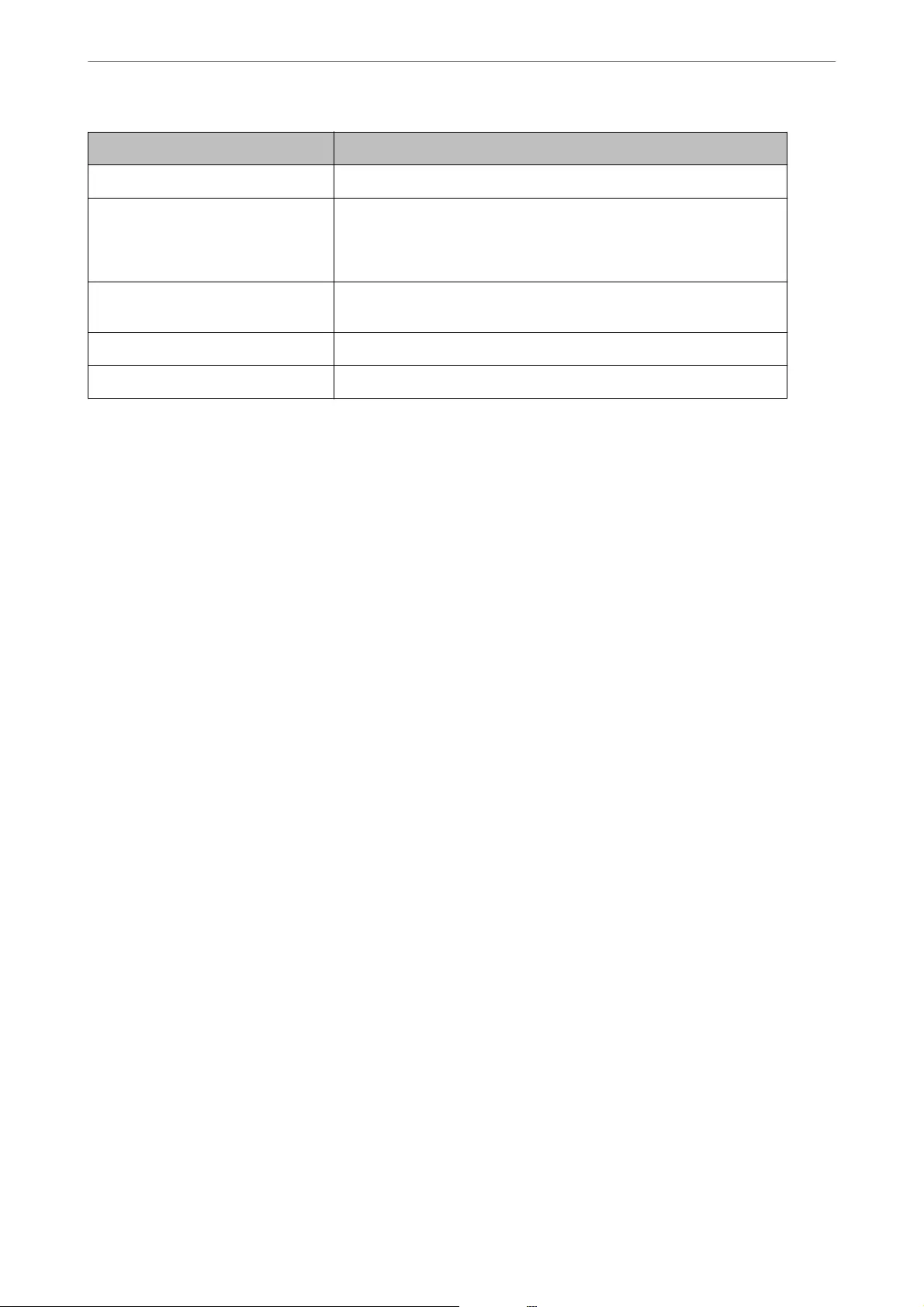
Security Methods Algorithms
IKE authentication algorithm SHA-1, SHA-256, SHA-384, SHA-512, MD5
IKE key exchange algorithm DH Group1, DH Group2, DH Group5, DH Group14, DH Group15, DH
Group16, DH Group17, DH Group18, DH Group19, DH Group20, DH
Group21, DH Group22, DH Group23, DH Group24, DH Group25, DH
Group26, DH Group27*, DH Group28*, DH Group29*, DH Group30*
ESP encryption algorithm AES-CBC-128, AES-CBC-192, AES-CBC-256, AES-GCM-128, AES-GCM-192,
AES-GCM-256, 3DES
ESP authentication algorithm SHA-1, SHA-256, SHA-384, SHA-512, MD5
AH authentication algorithm SHA-1, SHA-256, SHA-384, SHA-512, MD5
*available for IKEv2 only
Related Information
&“Encrypted Communication Using IPsec/IP Filtering” on page 434
Cannot Communicate Suddenly
The IP address of the printer has been changed or cannot be used.
When the IP address registered to the local address on Group Policy has been changed or cannot be used, IPsec
communication cannot be performed. Disable IPsec using the printer's control panel.
If the DHCP is out of date, rebooting or the IPv6 address is out of date or has not been obtained, then the IP
address registered for the printer's Web Cong (Network Security tab > IPsec/IP Filtering > Basic > Group
Policy > Local Address(Printer)) may not be found.
Use a static IP address.
The IP address of the computer has been changed or cannot be used.
When the IP address registered to the remote address on Group Policy has been changed or cannot be used, IPsec
communication cannot be performed.
Disable IPsec using the printer's control panel.
If the DHCP is out of date, rebooting or the IPv6 address is out of date or has not been obtained, then the IP
address registered for the printer's Web Cong (Network Security tab > IPsec/IP Filtering > Basic > Group
Policy > Remote Address(Host)) may not be found.
Use a static IP address.
Related Information
&“Application for Conguring Printer Operations (Web Cong)” on page 301
&“Encrypted Communication Using IPsec/IP Filtering” on page 434
Administrator Information
>
Advanced Security Settings
>
Solving Problems for Advanced Security
450

Cannot Create the Secure IPP Printing Port
The correct certicate is not specied as the server certicate for SSL/TLS communication.
If the specied certicate is not correct, creating a port may fail. Make sure you are using the correct certicate.
The CA certicate is not imported to the computer accessing the printer.
If a CA certicate is not imported to the computer, creating a port may fail. Make sure a CA certicate is imported.
Related Information
&“Conguring a Server Certicate for the Printer” on page 434
Cannot Connect After Conguring IPsec/IP Filtering
The settings of IPsec/IP Filtering are incorrect.
Disable IPsec/IP ltering from the printer’s control panel. Connect the printer and computer and make the
IPsec/IP Filtering settings again.
Related Information
&“Encrypted Communication Using IPsec/IP Filtering” on page 434
Cannot Access the Printer or Scanner after Conguring IEEE802.1X
The settings of IEEE802.1X are incorrect.
Disable IEEE802.1X and Wi-Fi from the printer’s control panel. Connect the printer and a computer, and then
congure IEEE802.1X again.
Related Information
&“Conguring an IEEE802.1X Network” on page 446
Problems on Using a Digital Certicate
Cannot Import a CA-signed Certicate
CA-signed Certicate and the information on the CSR do not match.
If the CA-signed Certicate and CSR do not have the same information, the CSR cannot be imported. Check the
following:
❏Are you trying to import the certicate to a device that does not have the same information?
Check the information of the CSR and then import the certicate to a device that has the same information.
❏Did you overwrite the CSR saved into the printer aer sending the CSR to a certicate authority?
Obtain the CA-signed certicate again with the CSR.
Administrator Information
>
Advanced Security Settings
>
Solving Problems for Advanced Security
451

CA-signed Certicate is more than 5KB.
You cannot import a CA-signed Certicate that is more than 5KB.
The password for importing the certicate is incorrect.
Enter the correct password. If you forget the password, you cannot import the certicate. Re-obtain the CA-signed
Certicate.
Related Information
&“Importing a CA-signed Certicate” on page 430
Cannot Update a Self-Signed Certicate
The Common Name has not been entered.
Common Name must be entered.
Unsupported characters have been entered to Common Name.
Enter between 1 and 128 characters of either IPv4, IPv6, host name, or FQDN format in ASCII (0x20-0x7E).
A comma or space is included in the common name.
If a comma is entered, the Common Name is divided at that point. If only a space is entered before or aer a
comma, an error occurs.
Related Information
&“Updating a Self-signed Certicate” on page 432
Cannot Create a CSR
The Common Name has not been entered.
e Common Name must be entered.
Unsupported characters have been entered to Common Name, Organization, Organizational Unit,
Locality, and State/Province.
Enter characters of either IPv4, IPv6, host name, or FQDN format in ASCII (0x20-0x7E).
A comma or space is included in the Common Name.
If a comma is entered, the Common Name is divided at that point. If only a space is entered before or aer a
comma, an error occurs.
Related Information
&“Obtaining a CA-signed Certicate” on page 428
Administrator Information
>
Advanced Security Settings
>
Solving Problems for Advanced Security
452
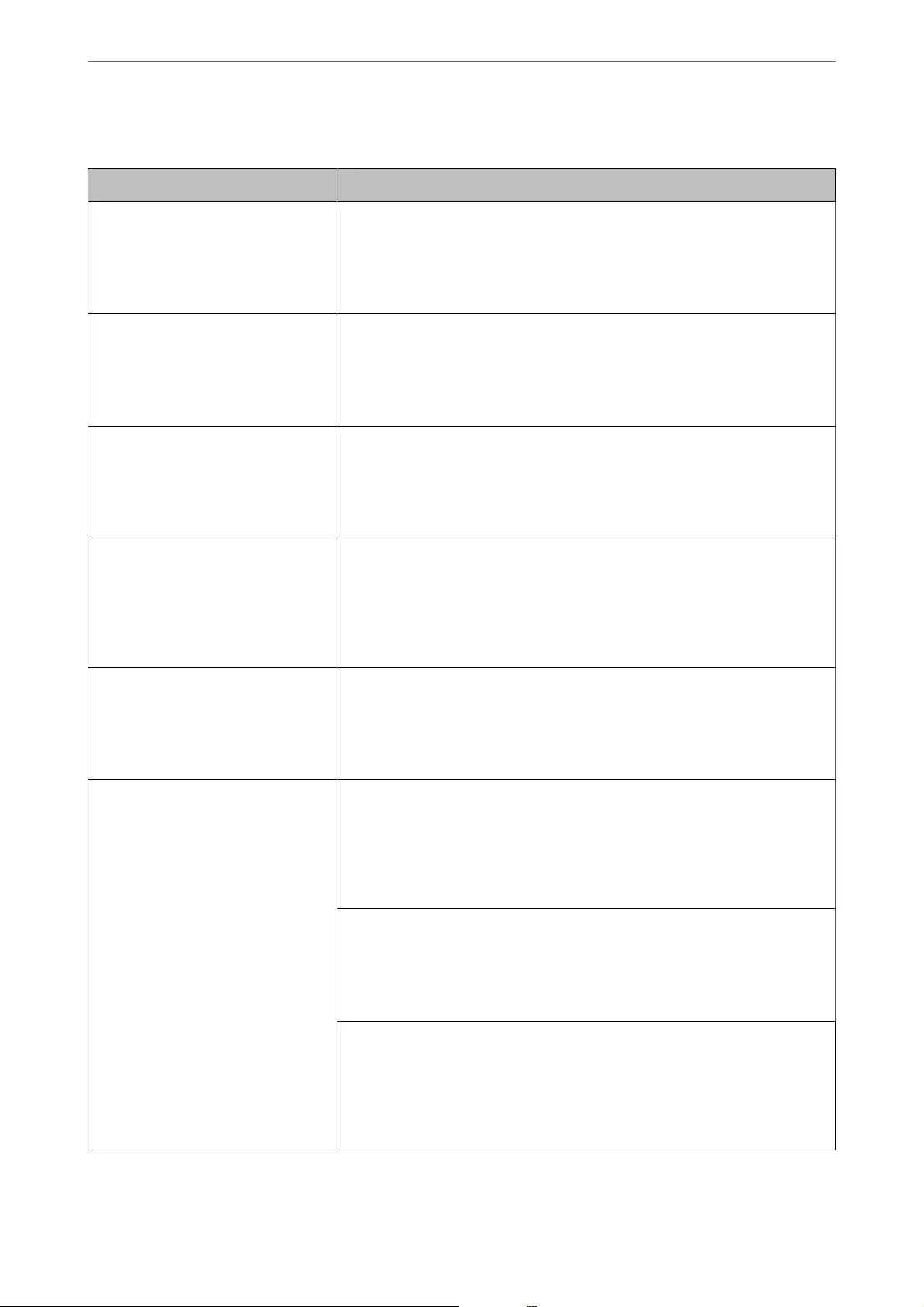
Warning Relating to a Digital Certicate Appears
Messages Cause/What to do
Enter a Server Certicate. Cause:
You have not selected a le to import.
What to do:
Select a le and click Import.
CA Certicate 1 is not entered. Cause:
CA certicate 1 is not entered and only CA certicate 2 is entered.
What to do:
Import CA certicate 1 rst.
Invalid value below. Cause:
Unsupported characters are contained in the le path and/or password.
What to do:
Make sure that the characters are entered correctly for the item.
Invalid date and time. Cause:
Date and time for the printer have not been set.
What to do:
Set date and time using Web Cong, EpsonNet Cong or the printer's control
panel.
Invalid password. Cause:
The password set for CA certicate and entered password do not match.
What to do:
Enter the correct password.
Invalid le. Cause:
You are not importing a certicate le in X509 format.
What to do:
Make sure that you are selecting the correct certicate sent by a trusted certicate
authority.
Cause:
The le you have imported is too large. The maximum le size is 5KB.
What to do:
If you select the correct le, the certicate might be corrupted or fabricated.
Cause:
The chain contained in the certicate is invalid.
What to do:
For more information on the certicate, see the website of the certicate
authority.
Administrator Information
>
Advanced Security Settings
>
Solving Problems for Advanced Security
453
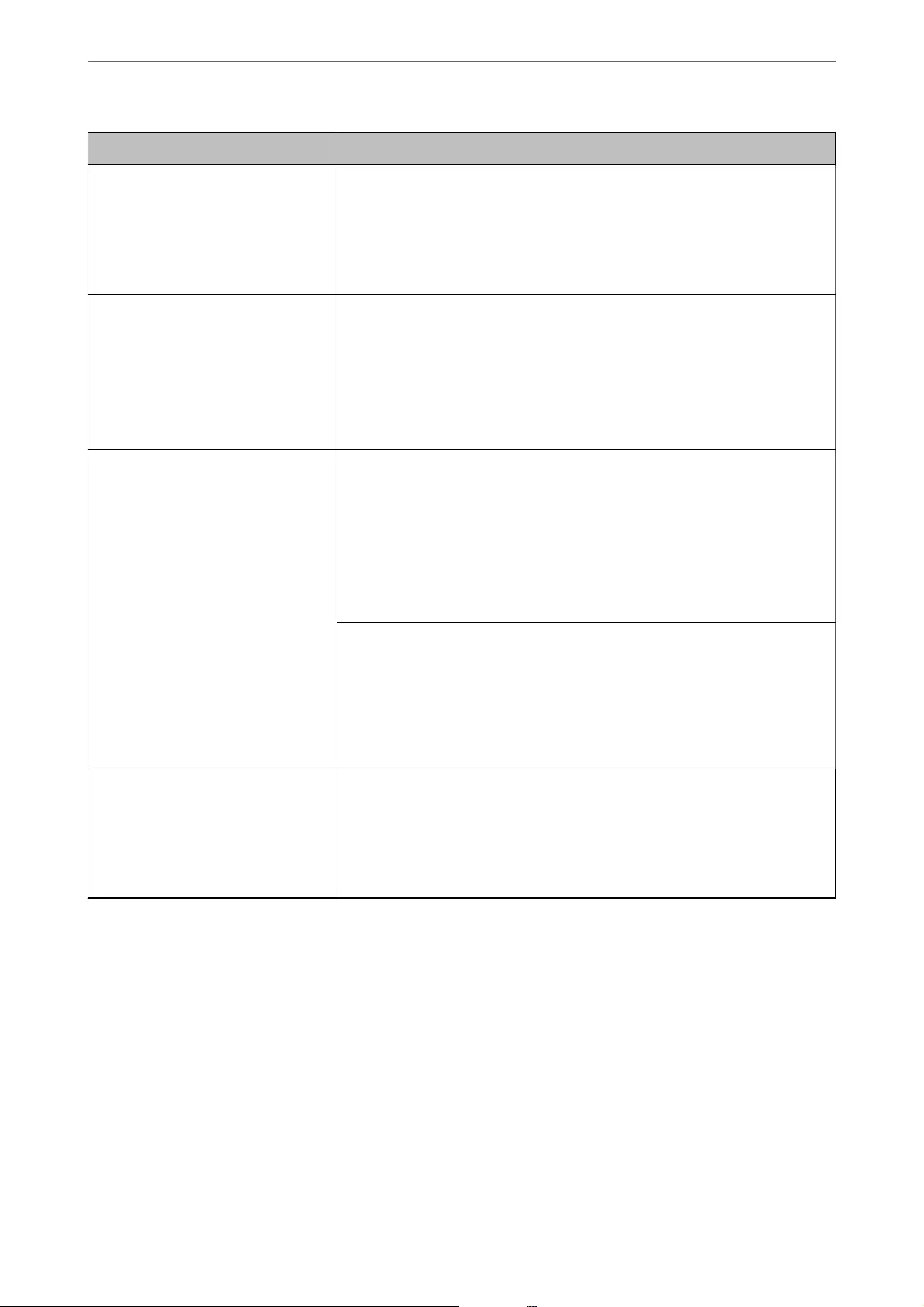
Messages Cause/What to do
Cannot use the Server Certicates that
include more than three CA
certicates.
Cause:
The certicate le in PKCS#12 format contains more than 3 CA certicates.
What to do:
Import each certicate as converting from PKCS#12 format to PEM format, or
import the certicate le in PKCS#12 format that contains up to 2 CA certicates.
The certicate has expired. Check if the
certicate is valid, or check the date
and time on your printer.
Cause:
The certicate is out of date.
What to do:
❏If the certicate is out of date, obtain and import the new certicate.
❏If the certicate is not out of date, make sure the printer's date and time are set
correctly.
Private key is required. Cause:
There is no paired private key with the certicate.
What to do:
❏If the certicate is the PEM/DER format and it is obtained from a CSR using a
computer, specify the private key le.
❏If the certicate is the PKCS#12 format and it is obtained from a CSR using a
computer, create a le that contains the private key.
Cause:
You have re-imported the PEM/DER certicate obtained from a CSR using Web
Cong.
What to do:
If the certicate is the PEM/DER format and it is obtained from a CSR using Web
Cong, you can only import it once.
Setup failed. Cause:
Cannot nish the conguration because the communication between the printer
and computer failed or the le cannot be read by some errors.
What to do:
After checking the specied le and communication, import the le again.
Related Information
&“About Digital Certication” on page 428
Delete a CA-signed Certicate by Mistake
There is no backup le for the CA-signed certicate.
If you have the backup le, import the certicate again.
If you obtain a certicate using a CSR created from Web Cong, you cannot import a deleted certicate again.
Create a CSR and obtain a new certicate.
Administrator Information
>
Advanced Security Settings
>
Solving Problems for Advanced Security
454
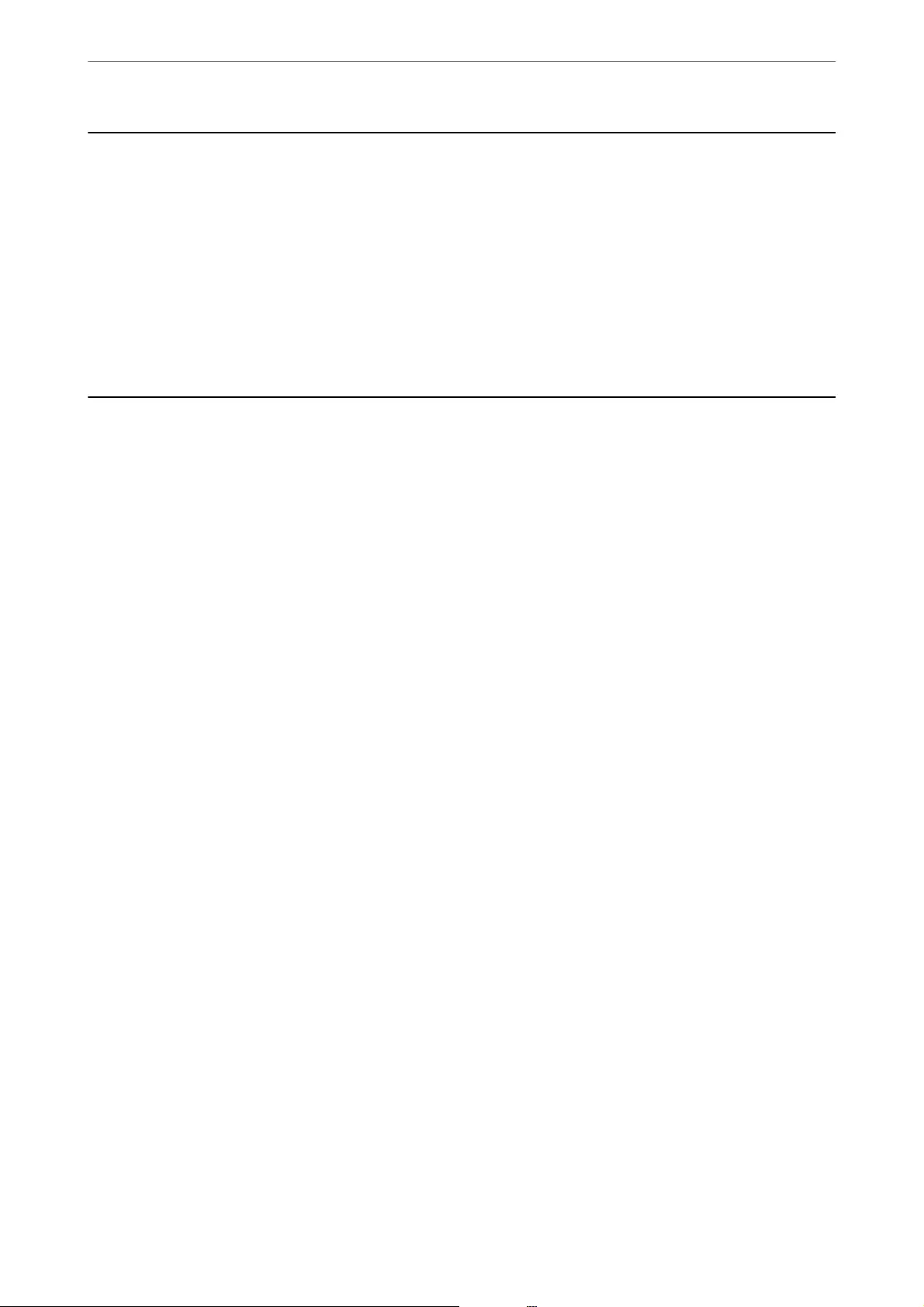
Technical Support Web Site
If you need further help, visit the Epson support website shown below. Select your country or region and go to the
support section of your local Epson website. e latest drivers, FAQs, manuals, or other downloadables are also
available from the site.
http://support.epson.net/
http://www.epson.eu/Support (Europe)
If your Epson product is not operating properly and you cannot solve the problem, contact Epson support services
for assistance.
Contacting Epson Support
Before Contacting Epson
If your Epson product is not operating properly and you cannot solve the problem using the troubleshooting
information in your product manuals, contact Epson support services for assistance. If Epson support for your area
is not listed below, contact the dealer where you purchased your product.
Epson support will be able to help you much more quickly if you give them the following information:
❏Product serial number
(e serial number label is usually on the back of the product.)
❏Product model
❏Product soware version
(Click About, Version Info, or a similar button in the product soware.)
❏Brand and model of your computer
❏Your computer operating system name and version
❏Names and versions of the soware applications you normally use with your product
Note:
Depending on the product, the dial list data for fax and/or network settings may be stored in the product’s memory. Due to
breakdown or repair of a product, data and/or settings may be lost. Epson shall not be responsible for the loss of any data, for
backing up or recovering data and/or settings even during a warranty period. We recommend that you make your own
backup data or take notes.
Help for Users in Europe
Check your Pan-European Warranty Document for information on how to contact Epson support.
Help for Users in Australia
Epson Australia wishes to provide you with a high level of customer service. In addition to your product manuals,
we provide the following sources for obtaining information:
Where to Get Help
>
Contacting Epson Support
>
Help for Users in Australia
457

Internet URL
http://www.epson.com.au
Access the Epson Australia World Wide Web pages. Worth taking your modem here for the occasional surf! e
site provides a download area for drivers, Epson contact points, new product information and technical support (e-
mail).
Epson Helpdesk
Phone: 1300-361-054
Epson Helpdesk is provided as a nal backup to make sure our clients have access to advice. Operators on the
Helpdesk can aid you in installing, conguring and operating your Epson product. Our Pre-sales Helpdesk sta
can provide literature on new Epson products and advise where the nearest dealer or service agent is located. Many
types of queries are answered here.
We encourage you to have all the relevant information on hand when you ring. e more information you prepare,
the faster we can help solve the problem. is information includes your Epson product manuals, type of
computer, operating system, application programs, and any information you feel is required.
Transportation of Product
Epson recommends retaining product packaging for future transportation. Securing the ink tank with tape and
keeping the product upright is also recommended.
Help for Users in New Zealand
Epson New Zealand wishes to provide you with a high level of customer service. In addition to your product
documentation, we provide the following sources for obtaining information:
Internet URL
http://www.epson.co.nz
Access the Epson New Zealand World Wide Web pages. Worth taking your modem here for the occasional surf!
e site provides a download area for drivers, Epson contact points, new product information and technical
support (e-mail).
Epson Helpdesk
Phone: 0800 237 766
Epson Helpdesk is provided as a nal backup to make sure our clients have access to advice. Operators on the
Helpdesk can aid you in installing, conguring and operating your Epson product. Our Pre-sales Helpdesk sta
can provide literature on new Epson products and advise where the nearest dealer or service agent is located. Many
types of queries are answered here.
We encourage you to have all the relevant information on hand when you ring. e more information you prepare,
the faster we can help solve the problem. is information includes your Epson product documentation, type of
computer, operating system, application programs, and any information you feel is required.
Transportation of Product
Epson recommends retaining product packaging for future transportation. Securing the ink tank with tape and
keeping the product upright is also recommended.
Where to Get Help
>
Contacting Epson Support
>
Help for Users in New Zealand
458
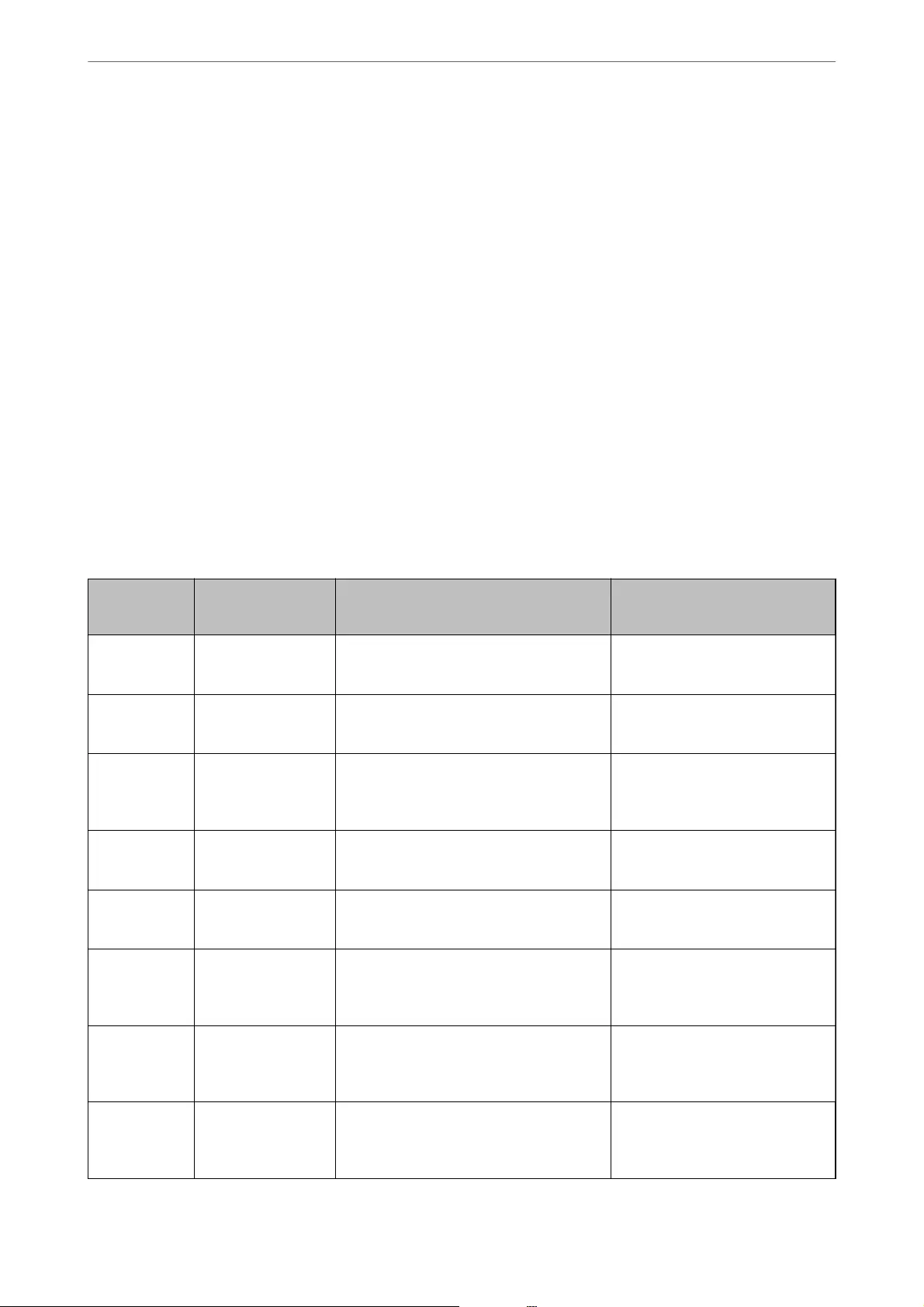
Help for Users in Indonesia
Contacts for information, support, and services are:
World Wide Web
http://www.epson.co.id
❏Information on product specications, drivers for download
❏Frequently Asked Questions (FAQ), Sales Enquiries, questions through e-mail
Epson Hotline
Phone: +62-1500-766
Fax: +62-21-808-66-799
Our Hotline team can help you with the following over the phone or fax:
❏Sales enquiries and product information
❏Techn ical support
Epson Service Center
Province Company Name Address Phone
E-mail
DKI JAKARTA ESS JAKARTA
MANGGADUA
Ruko Mall Mangga Dua No. 48 Jl. Arteri
Mangga Dua, Jakarta Utara - DKI JAKARTA
(+6221) 62301104
jkt-admin@epson-indonesia.co.id
NORTH
SUMATERA
ESC MEDAN Jl. Bambu 2 Komplek Graha Niaga Nomor
A-4, Medan - North Sumatera
(+6261) 42066090 / 42066091
mdn-adm@epson-indonesia.co.id
WEST JAWA ESC BANDUNG Jl. Cihampelas No. 48 A Bandung Jawa
Barat 40116
(+6222) 4207033
bdg-admin@epson-
indonesia.co.id
DI
YOGYAKARTA
ESC YOGYAKARTA YAP Square, Block A No. 6 Jl. C Simanjutak
Yogyakarta - DIY
(+62274) 581065
ygy-admin@epson-indonesia.co.id
EAST JAWA ESC SURABAYA Hitech Mall Lt. 2 Block A No. 24 Jl. Kusuma
Bangsa No. 116 - 118 Surabaya - JATIM
(+6231) 5355035
sby-admin@epson-indonesia.co.id
SOUTH
SULAWESI
ESC MAKASSAR Jl. Cendrawasih NO. 3A, kunjung mae,
mariso, MAKASSAR - SULSEL 90125
(+62411) 8911071
mksr-admin@epson-
indonesia.co.id
WEST
KALIMANTAN
ESC PONTIANAK Komp. A yani Sentra Bisnis G33, Jl. Ahmad
Yani - Pontianak Kalimantan Barat
(+62561) 735507 / 767049
pontianak-admin@epson-
indonesia.co.id
RIAU ESC PEKANBARU Jl. Tuanku Tambusai No.459A Pekanbaru
Riau
(+62761) 8524695
pkb-admin@epson-
indonesia.co.id
Where to Get Help
>
Contacting Epson Support
>
Help for Users in Indonesia
459
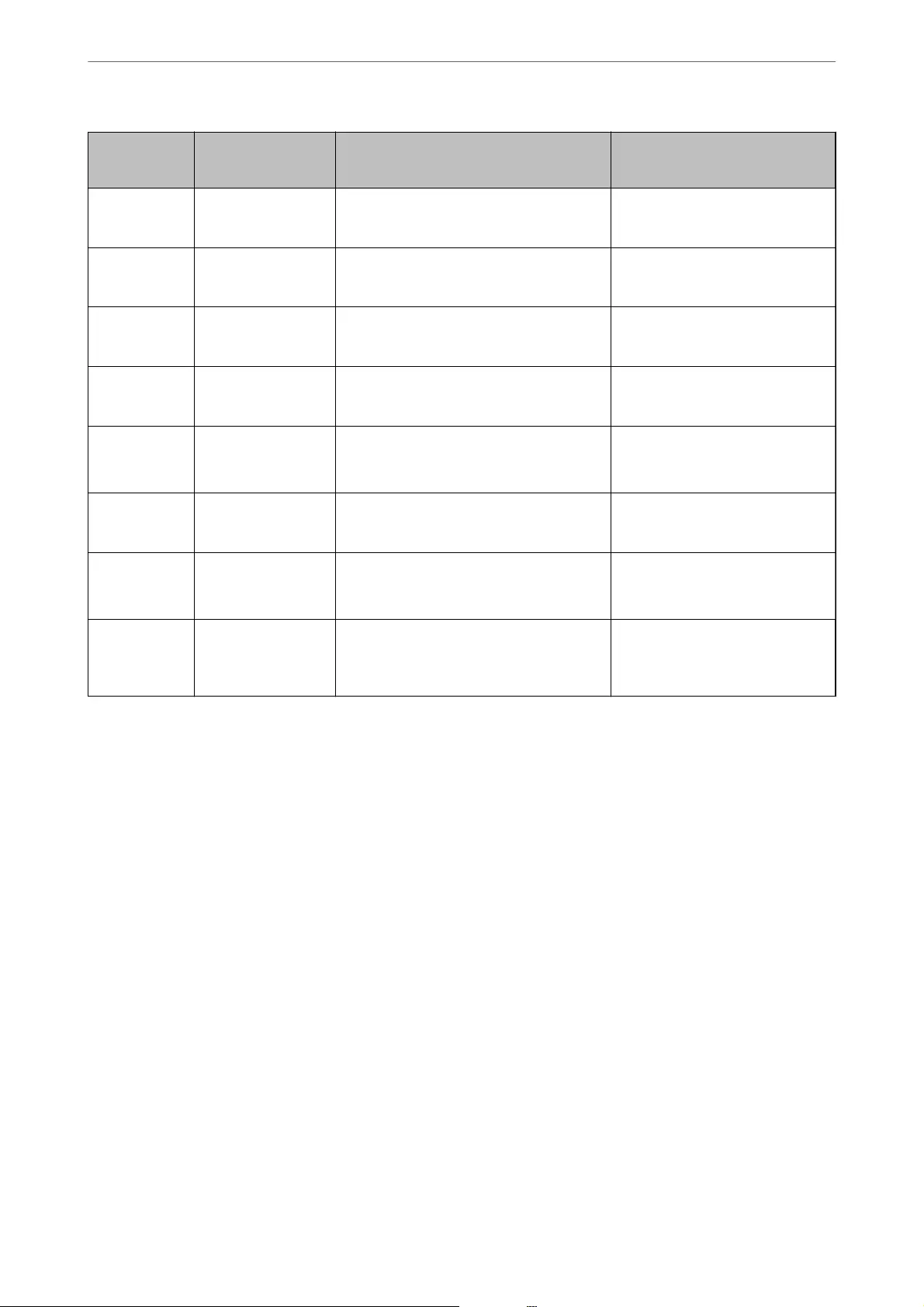
Province Company Name Address Phone
E-mail
DKI JAKARTA ESS JAKARTA
SUDIRMAN
Wisma Keiai Lt. 1 Jl. Jenderal Sudirman Kav.
3 Jakarta Pusat - DKI JAKARTA 10220
(+6221) 5724335
ess@epson-indonesia.co.id
EAST JAWA ESS SURABAYA Ruko Surya Inti Jl. Jawa No 2-4 Kav. 29
Surabaya - Jawa Timur
(+6231) 5014949
esssby@epson-indonesia.co.id
BANTEN ESS SERPONG Ruko Mall WTC Matahari No. 953, Serpong-
Banten
(+6221) 53167051 / 53167052
esstag@epson-indonesia.co.id
CENTRAL
JAWA
ESS SEMARANG Komplek Ruko Metro Plaza Block C20 Jl. MT
Haryono No 970 Semarang - JAWA TENGAH
(+6224) 8313807 / 8417935
esssmg@epson-indonesia.co.id
EAST
KALIMANTAN
ESC SAMARINDA Jl. KH. Wahid Hasyim (M. Yamin) Kelurahan
Sempaja Selatan Kecamatan Samarinda
UTARA - SAMARINDA - KALTIM
(+62541) 7272904
escsmd@epson-indonesia.co.id
SOUTH
SUMATERA
ESC PALEMBANG Jl. H.M Rasyid Nawawi No. 249 Kelurahan 9
Ilir Palembang Sumatera Selatan
(+62711) 311330
escplg@epson-indonesia.co.id
EAST JAVA ESC JEMBER JL. Panglima Besar Sudirman Ruko no.1D
Jember-Jawa Timur (Depan Balai Penelitian
& Pengolahan Kakao)
(+62331) 488373 / 486468
jmr-admin@epson-indonesia.co.id
NORTH
SULAWESI
ESC MANADO Tekno Megamall Lt LG 11 TK 21, Kawasan
Megamas Boulevard, Jl Piere Tendean,
Manado - SULUT 95111
(+62431) 8890996
MND-ADMIN@EPSON-
INDONESIA.CO.ID
For other cities not listed here, call the Hot Line: 08071137766.
Help for Users in Malaysia
Contacts for information, support, and services are:
World Wide Web
http://www.epson.com.my
❏Information on product specications, drivers for download
❏Frequently Asked Questions (FAQ), Sales Enquiries, questions through e-mail
Epson Call Centre
Phone: +60 1800-8-17349
❏Sales enquiries and product information
❏Product usage questions or problems
❏Enquiries on repair services and warranty
Head Oce
Phone: 603-56288288
Where to Get Help
>
Contacting Epson Support
>
Help for Users in Malaysia
460

Fax: 603-5628 8388/603-5621 2088
Help for Users in the Philippines
To obtain technical support as well as other aer sales services, users are welcome to contact the Epson Philippines
Corporation at the telephone, fax numbers and e-mail address below:
World Wide Web
http://www.epson.com.ph
Information on product specications, drivers for download, Frequently Asked Questions (FAQ), and E-mail
Enquiries are available.
Epson Philippines Customer Care
Toll Free: (PLDT) 1-800-1069-37766
Toll Free: (Digital) 1-800-3-0037766
Metro Manila: (+632)441-9030
Web Site: https://www.epson.com.ph/contact
E-mail: customercare@epc.epson.som.ph
Accessible 9am to 6pm, Monday through Saturday (Except public holidays)
Our Customer Care team can help you with the following over the phone:
❏Sales enquiries and product information
❏Product usage questions or problems
❏Enquiries on repair service and warranty
Epson Philippines Corporation
Trunk Line: +632-706-2609
Fax: +632-706-2663
Help for Users in Singapore
Sources of information, support, and services available from Epson Singapore are:
World Wide Web
http://www.epson.com.sg
Information on product specications, drivers for download, Frequently Asked Questions (FAQ), Sales Enquiries,
and Technical Support via e-mail are available.
Epson HelpDesk
Toll Free: 800-120-5564
Our HelpDesk team can help you with the following over the phone:
❏Sales enquiries and product information
Where to Get Help
>
Contacting Epson Support
>
Help for Users in Singapore
461

❏Product usage questions or problem troubleshooting
❏Enquiries on repair service and warranty
Help for Users in Thailand
Contacts for information, support, and services are:
World Wide Web
http://www.epson.co.th
Information on product specications, drivers for download, Frequently Asked Questions (FAQ), and e-mail are
available.
Epson Call Centre
Phone: 66-2685-9899
Email: support@eth.epson.co.th
Our Call Centre team can help you with the following over the phone:
❏Sales enquiries and product information
❏Product usage questions or problems
❏Enquiries on repair service and warranty
Help for Users in Vietnam
Contacts for information, support, and services are:
Epson Service Center
65 Truong Dinh Street, District 1, Hochiminh City, Vietnam.
Phone(Ho Chi Minh City): 84-8-3823-9239, 84-8-3825-6234
29 Tue Tinh, Quan Hai Ba Trung, Hanoi City, Vietnam
Phone(Hanoi City): 84-4-3978-4785, 84-4-3978-4775
Where to Get Help
>
Contacting Epson Support
>
Help for Users in Vietnam
462














